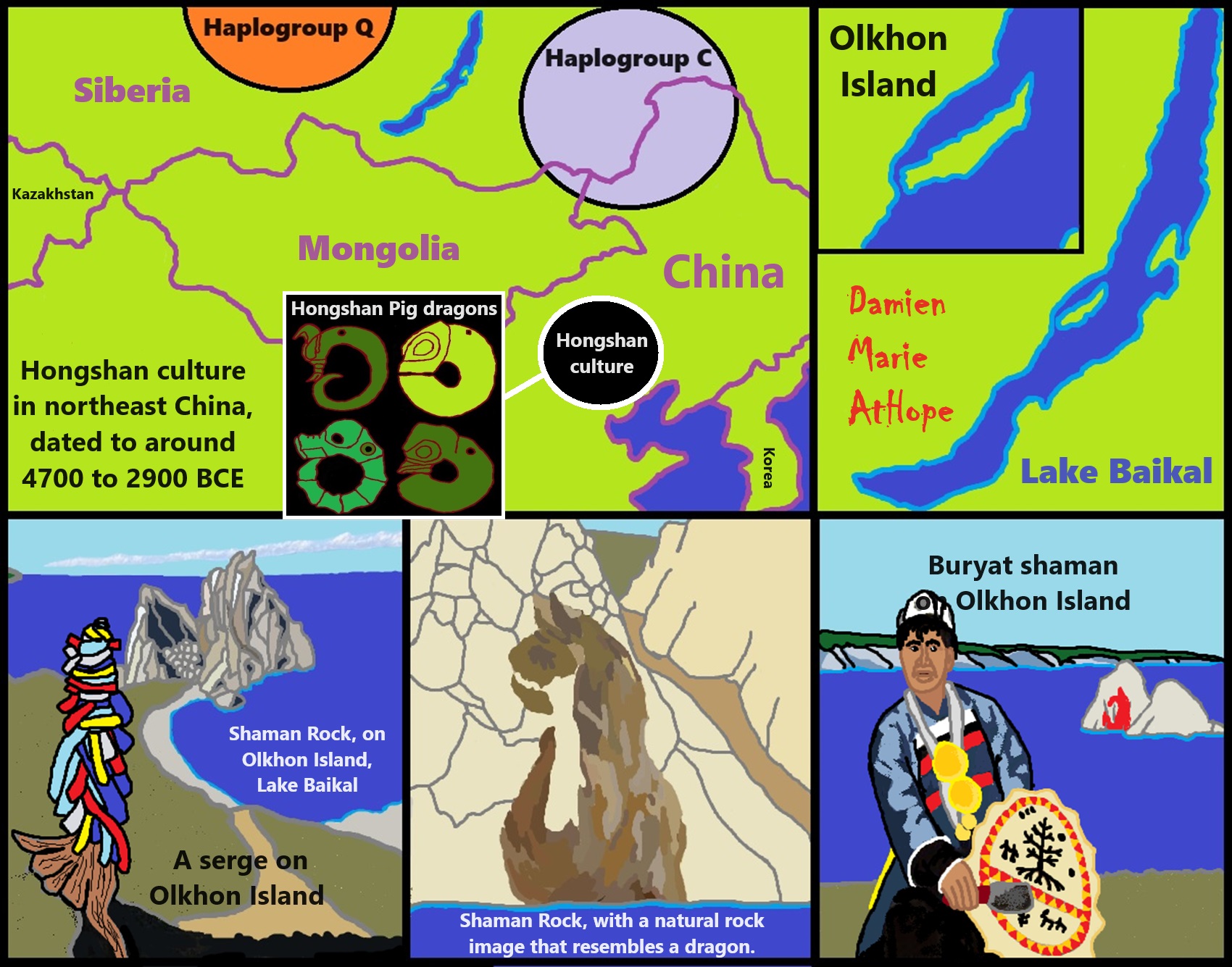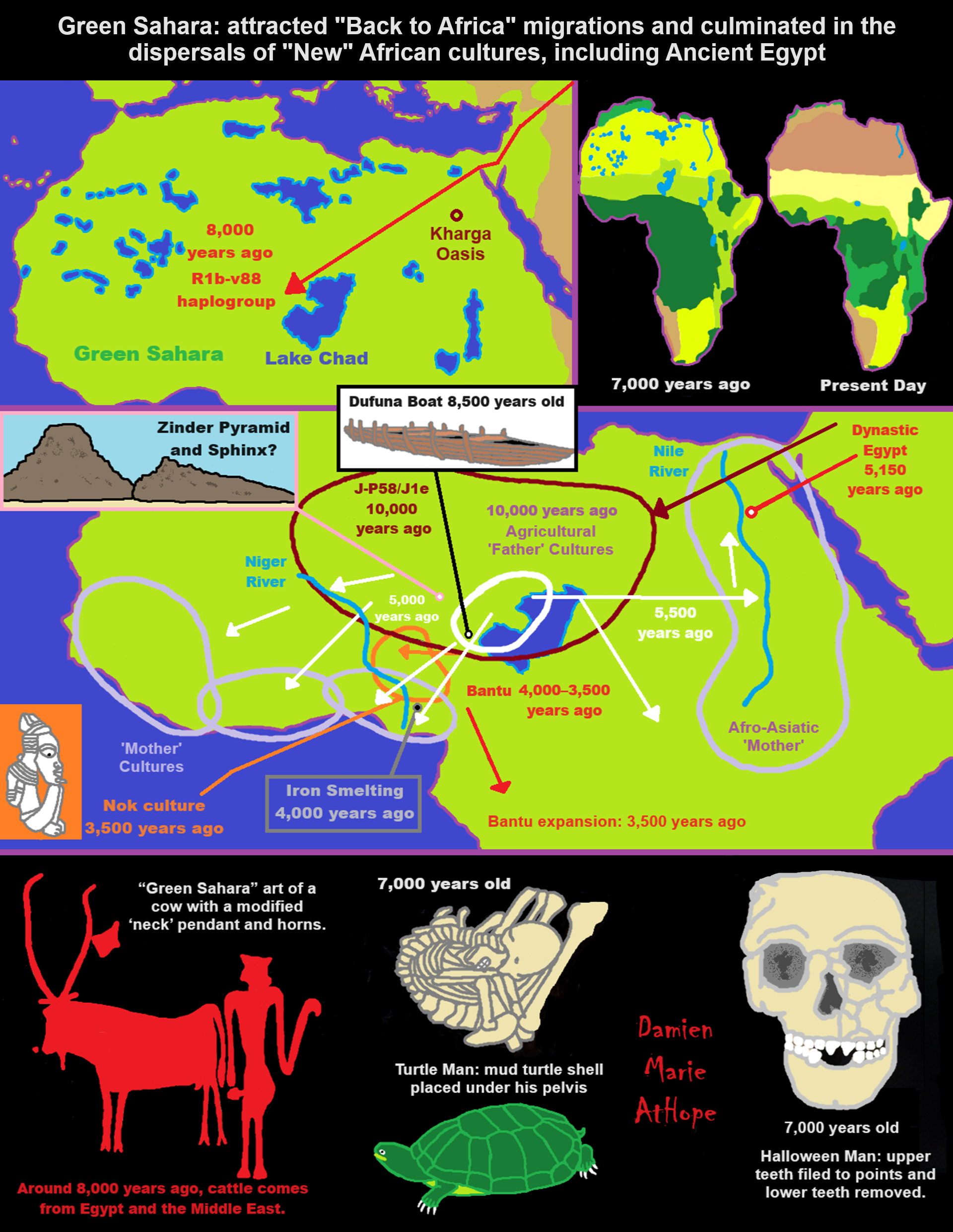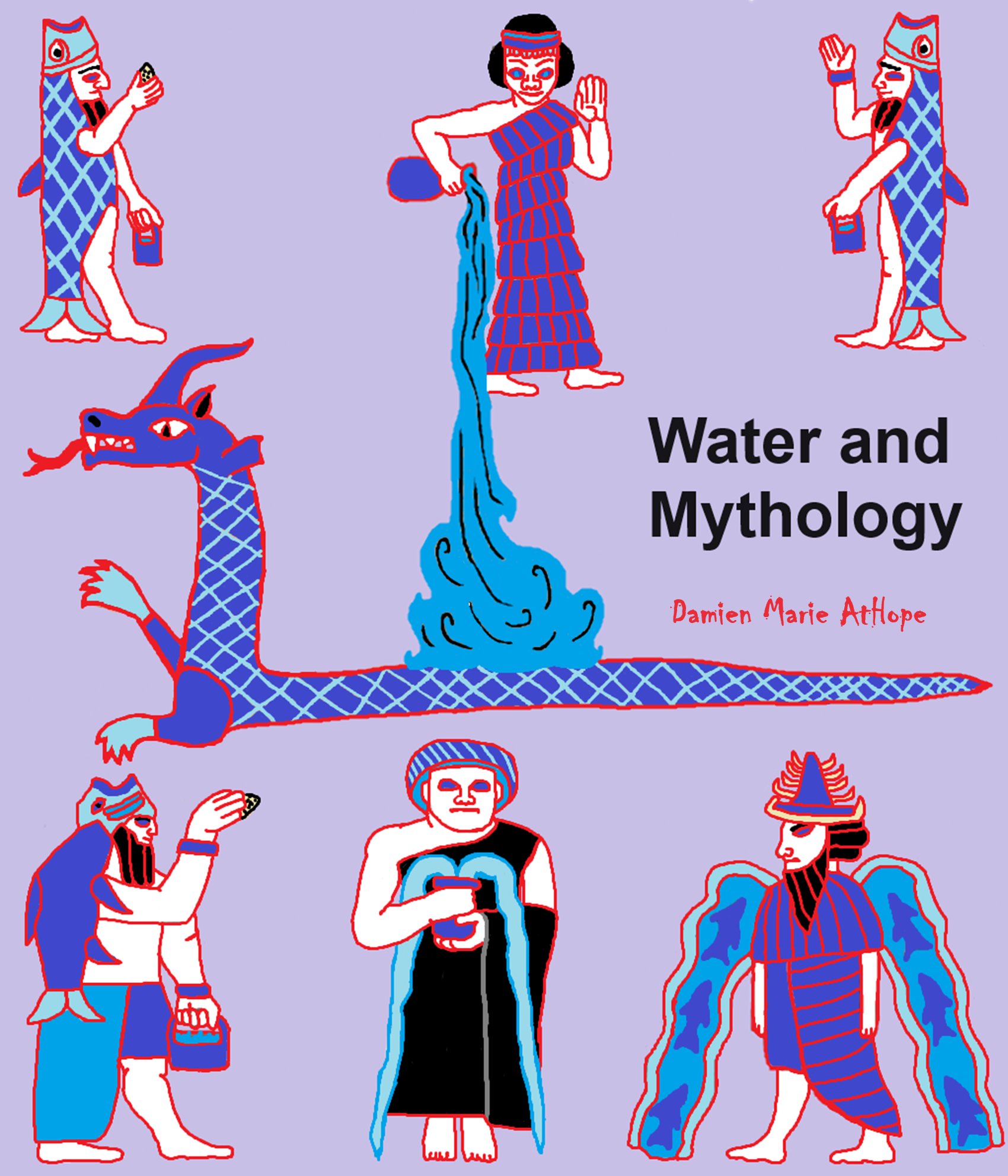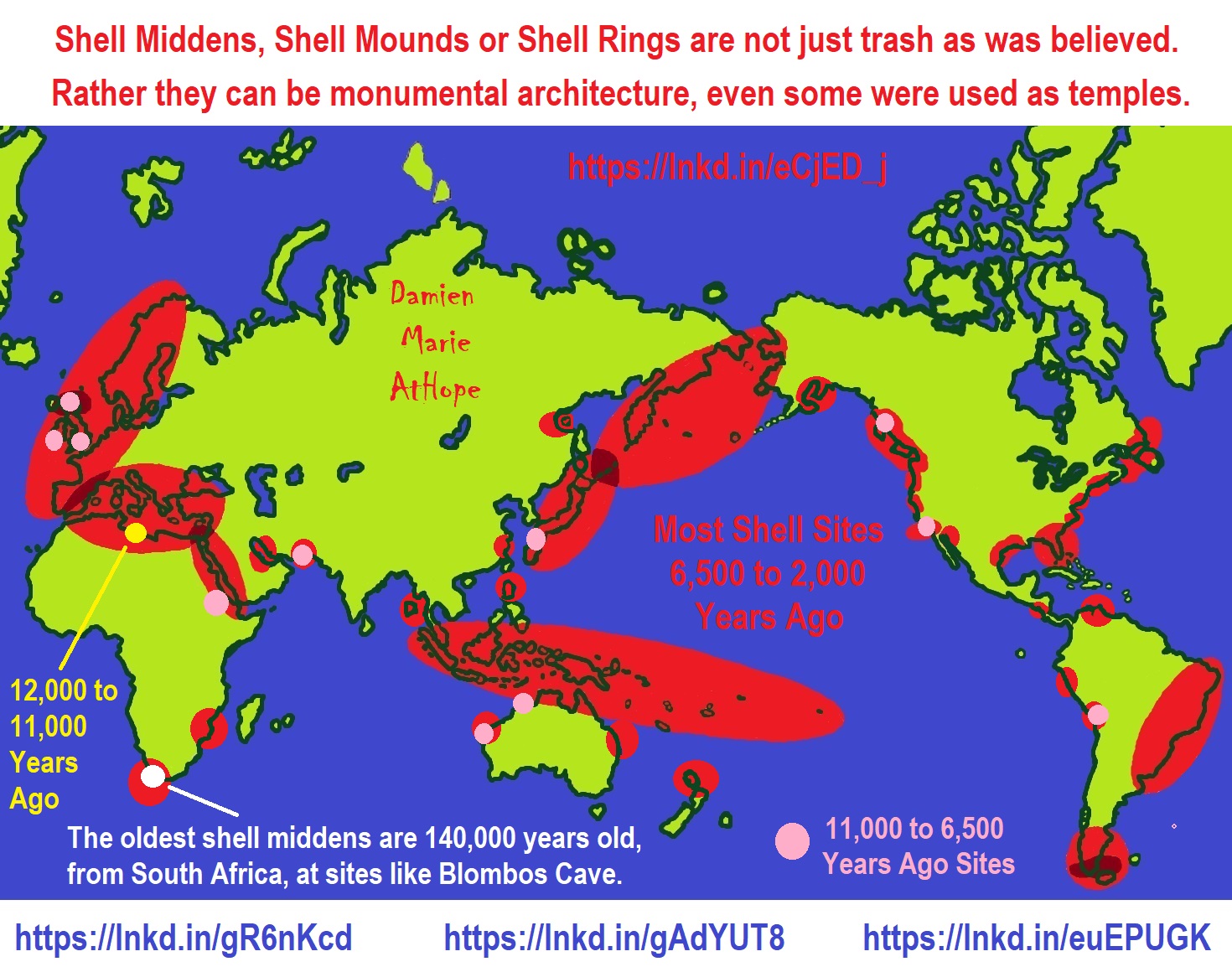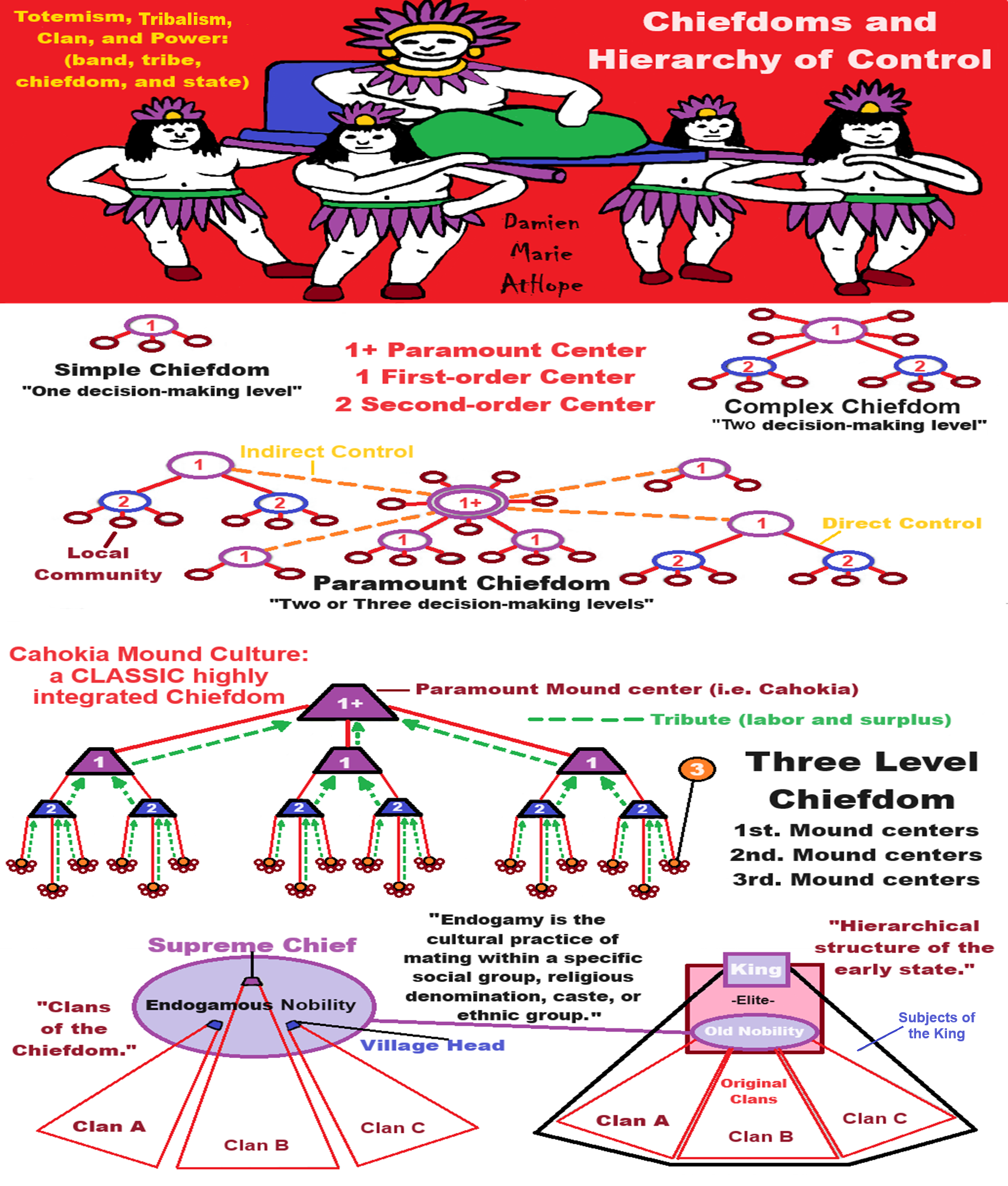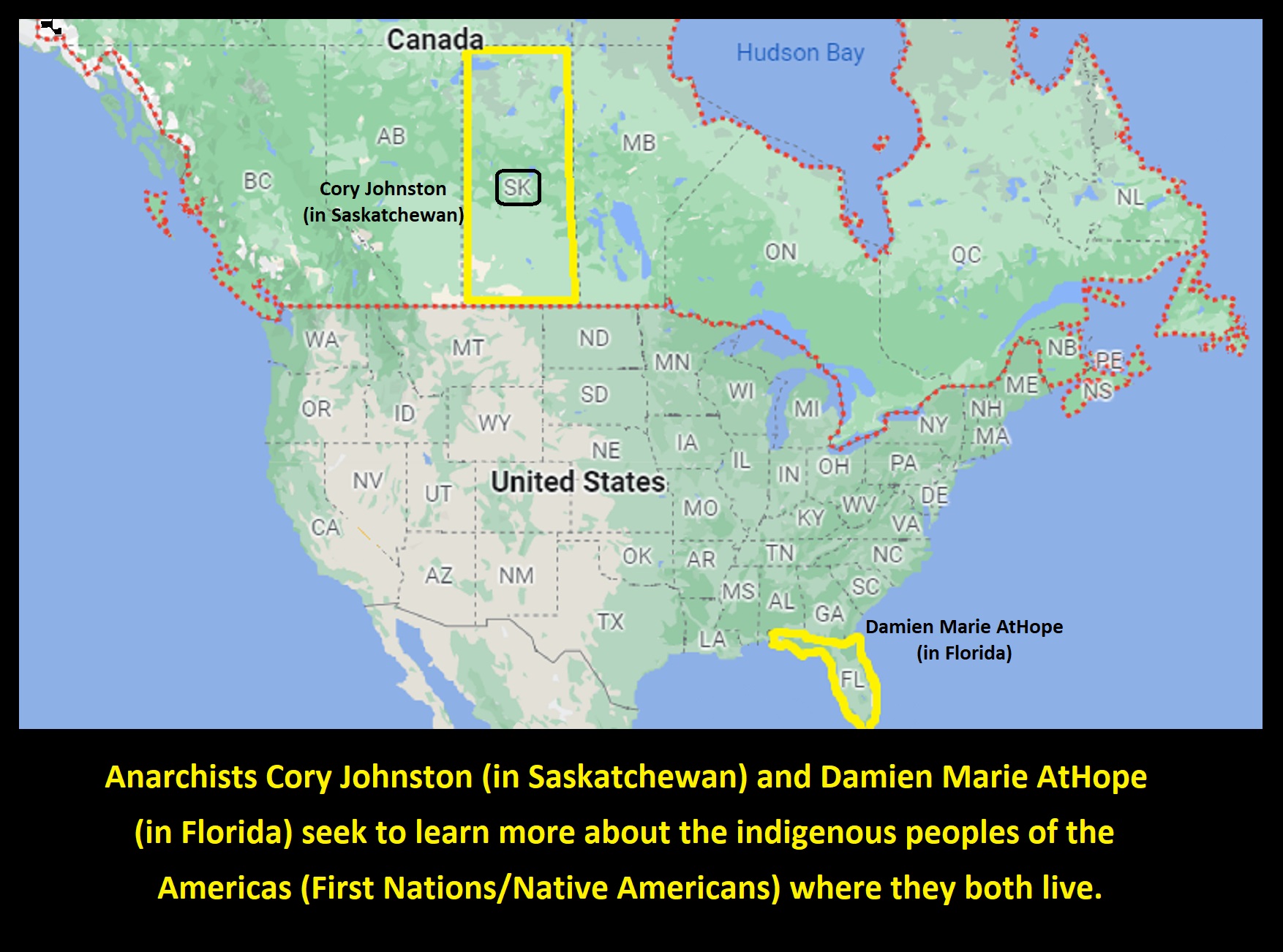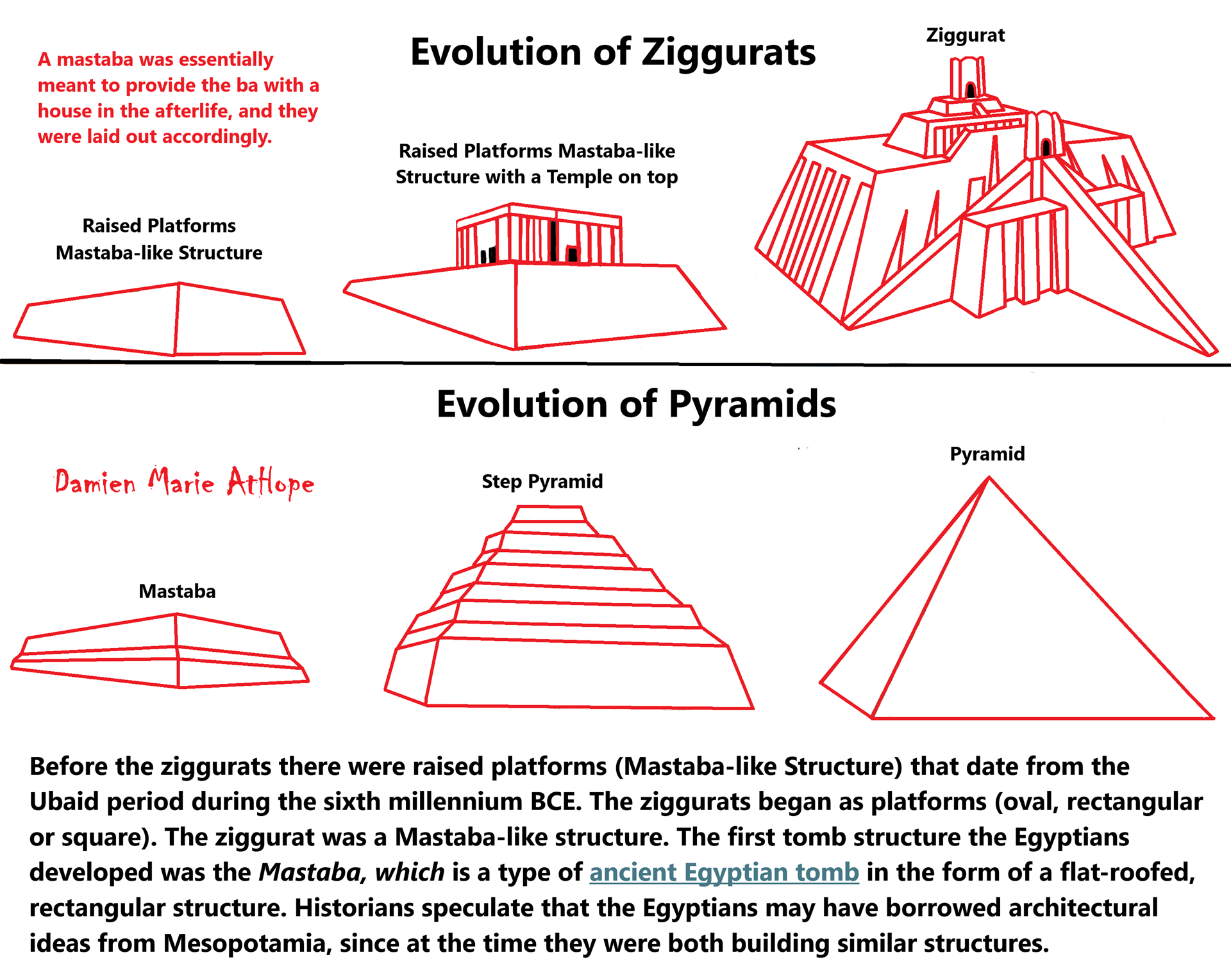
“Before the ziggurats there were raised platforms (Mastaba-like Structure) that date from the Ubaid period during the sixth millennium BCE. The ziggurats began as platforms (oval, rectangular, or square). The ziggurat was a Mastaba-like structure. The first tomb structure the Egyptians developed was the Mastaba, which is a type of ancient Egyptian tomb in the form of a flat-roofed, rectangular structure. Historians speculate that the Egyptians may have borrowed architectural ideas from Mesopotamia since, at the time, they were both building similar structures.” ref, ref
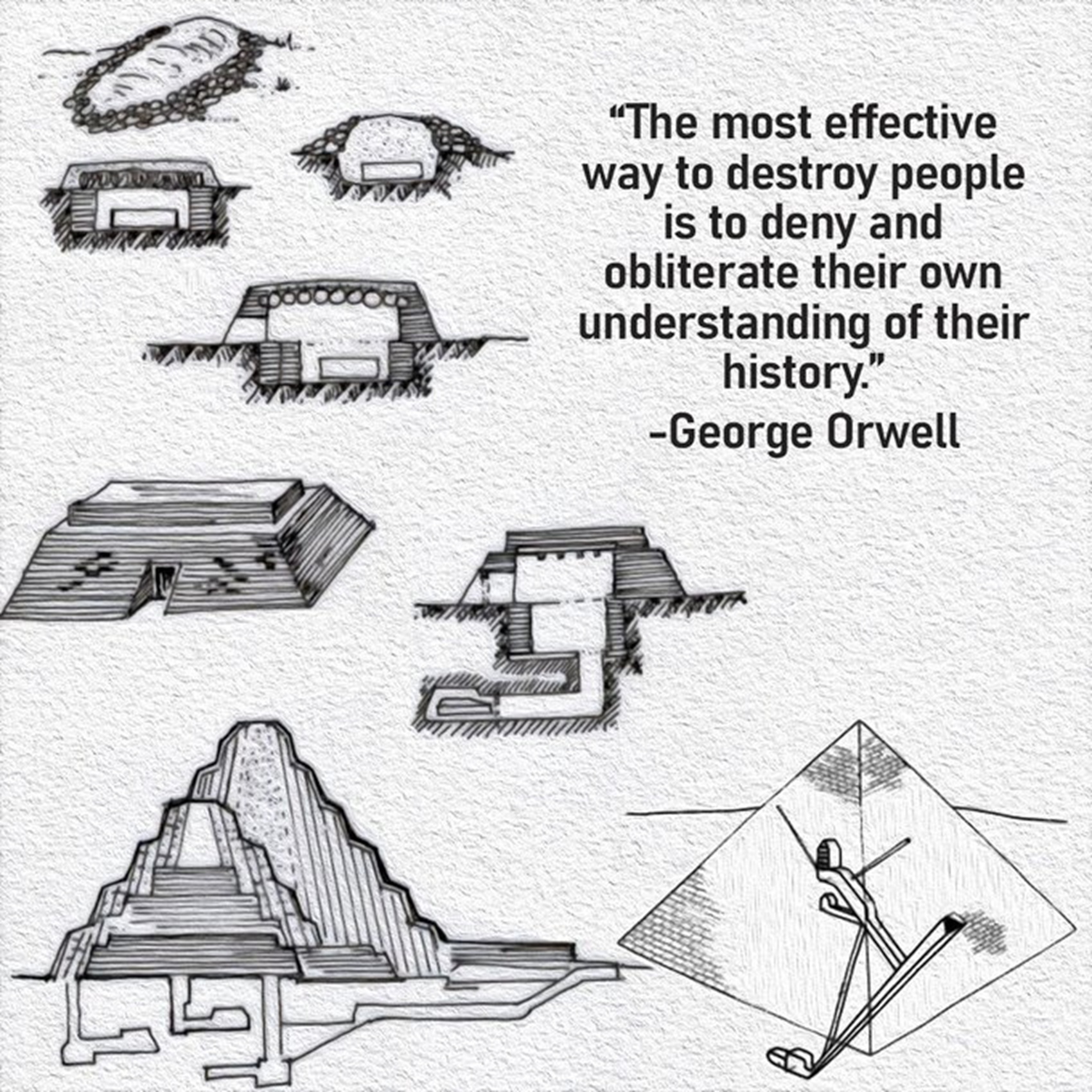
“A mastaba is a type of ancient Egyptian tomb in the form of a flat-roofed, rectangular structure with inward sloping sides, constructed out of mudbricks or limestone. These edifices marked the burial sites of many eminent Egyptians during Egypt’s Early Dynastic Period and Old Kingdom. Non-royal use of mastabas continued for over a thousand years. The Ancient Egyptian name was pr-Djt, meaning “house of stability,” “house of eternity,” or “eternal house.” The afterlife was centralized in the religion of ancient Egyptians. Their architecture reflects this, most prominently by the enormous amounts of time and labor involved in building tombs. Ancient Egyptians believed that the needs from the world of the living would be continued in the afterlife; it was therefore necessary to build tombs that would fulfill them, and be sturdy enough to last for an eternity. These needs would also have to be attended to by the living.” ref
“Starting in the Predynastic era (before 3100 BCE or around 5,100 years ago) and continuing into later dynasties, the ancient Egyptians developed increasingly complex and effective methods for preserving and protecting the bodies of the dead. They first buried their dead in pit graves dug from the sand with the body placed on a mat, usually along with some items believed to help them in the afterlife. The first tomb structure the Egyptians developed was the mastaba, composed of earthen bricks made from soil along the Nile. It provided better protection from scavenging animals and grave robbers. The origins of the mastaba can be seen in Tarkhan, where tombs would be split into two distinct portions. One side would contain a body, oriented in a north-south position, and the other would be open for the living to deliver offerings. As the remains were not in contact with the dry desert sand, natural mummification could not take place; therefore, the Egyptians devised a system of artificial mummification. Until at least the Old Period or First Intermediate Period, only high officials and royalty were buried in these mastabas.” ref
“The above-ground structure of a mastaba is rectangular in shape with inward-sloping sides and a flat roof. The exterior building materials were initially bricks made of the sun-dried mud readily available from the Nile River. Even after more durable materials such as stone came into use, the majority were built from mudbricks. Monumental mastabas, such as those at Saqqara, were often constructed out of limestone. Mastabas were often about four times as long as they were wide, and many rose to at least 10 meters (30 ft) in height. They were oriented north–south, which the Egyptians believed was essential for access to the afterlife. The roofs of the mastabas were of slatted wood or slabs of limestone, with skylights illuminating the tomb. The above-ground structure had space for a small offering chapel equipped with a false door. Priests and family members brought food and other offerings for the soul, or ba, of the deceased, which had to be maintained in order to continue to exist in the afterlife. The construction of mastabas was standardized, with several treatments being common for masonry.” ref
“Mastabas were highly decorated, both with paintings on the walls and ceilings, and carvings of organic elements such as palm trees out of limestone. Due to the spiritual significance of the color, it was preferable to construct mastabas from white limestone. If this was not available, the yellow limestone or mudbrick of the tomb would be whitewashed and plastered. Mastabas for royalty were especially extravagant on the exterior, meant to resemble a palace. The mastaba was the standard type of tomb in pre-dynastic and early dynastic Egypt for both the pharaoh and the social elite. The ancient city of Abydos was the location chosen for many of the cenotaphs. The royal cemetery was at Saqqara, overlooking the capital of early times, Memphis. Mastabas evolved over the early dynastic period (c. 3100–2686 BCE). During the 1st Dynasty, a mastaba was constructed simulating house plans of several rooms, a central one containing the sarcophagus and others surrounding it to receive the abundant funerary offerings. The whole was built in a shallow pit above which a brick superstructure covering a broad area.” ref
“The typical 2nd and 3rd Dynasty (c. 2686–2313) mastabas was the ‘stairway mastaba’, the tomb chamber of which sank deeper than before and was connected to the top with an inclined shaft and stairs. Many of the features of mastabas grew into those of the pyramids, indicating their importance as a transitory construction of tombs. This notably includes the exterior appearance of the tombs, as the sloped sides of the mastabas extended to form a pyramid. The first and most striking example of this was Djoser’s step pyramid, which combined many traditional features of mastabas with a more monumental stone construction. Even after pyramids became more prevalent for pharaohs in the 3rd and 4th Dynasties, members of the nobility continued to be buried in mastaba tombs. This is especially evident on the Giza Plateau, where at least 150 mastaba tombs have been constructed alongside the pyramids.” ref
“A ziggurat (/ˈzɪɡʊˌræt/; Cuneiform: 𒅆𒂍𒉪, Akkadian: ziqqurratum, D-stem of zaqārum ‘to protrude, to build high’, cognate with other Semitic languages like Hebrew zaqar (זָקַר) ‘protrude’) is a type of massive structure built in ancient Mesopotamia. It has the form of a terraced compound of successively receding stories or levels. Notable ziggurats include the Great Ziggurat of Ur near Nasiriyah, the Ziggurat of Aqar Quf near Baghdad, the no longer extant Etemenanki in Babylon, Chogha Zanbil in Khūzestān and Sialk. The Sumerians believed that the gods lived in the temple at the top of the ziggurats, so only priests and other highly-respected individuals could enter. Sumerian society offered these individuals such gifts as music, harvested produce, and the creation of devotional statues to entice them to live in the temple. The word ziggurat comes from ziqqurratum (height, pinnacle), in ancient Assyrian. From zaqārum, to be high up. The Ziggurat of Ur is a Neo-Sumerian ziggurat built by King Ur-Nammu, who dedicated it in honor of Nanna/Sîn in approximately the 21st century BCE during the Third Dynasty of Ur.” ref
“Ziggurats were built by ancient Sumerians, Akkadians, Elamites, Eblaites, and Babylonians for local religions. Each ziggurat was part of a temple complex with other buildings. Before the ziggurats there were raised platforms that date from the Ubaid period during the sixth millennium BCE. The ziggurats began as platforms (usually oval, rectangular or square). The ziggurat was a mastaba-like structure with a flat top. The sun-baked bricks made up the core of the ziggurat with facings of fired bricks on the outside. Each step was slightly smaller than the step below it. The facings were often glazed in different colors and may have had astrological significance. Kings sometimes had their names engraved on these glazed bricks. The number of floors ranged from two to seven.” ref
“Access to the shrine would have been by a series of ramps on one side of the ziggurat or by a spiral ramp from base to summit. The Mesopotamian ziggurats were not places for public worship or ceremonies. They were believed to be dwelling places for the gods, and each city had its own patron god. Only priests were permitted on the ziggurat or in the rooms at its base, and it was their responsibility to care for the gods and attend to their needs. The priests were very powerful members of Sumerian and Assyro-Babylonian society. One of the best-preserved ziggurats is Chogha Zanbil in western Iran. The Sialk ziggurat, in Kashan, Iran, is the oldest known ziggurat, dating to the early 3rd millennium BCE. Ziggurat designs ranged from simple bases upon which a temple sat, to marvels of mathematics and construction which spanned several terraced stories and were topped with a temple.” ref
“An example of a simple ziggurat is the White Temple of Uruk, in ancient Sumer. The ziggurat itself is the base on which the White Temple is set. Its purpose is to get the temple closer to the heavens, and provide access from the ground to it via steps. The Mesopotamians believed that these pyramid temples connected heaven and earth. In fact, the ziggurat at Babylon was known as Etemenanki, which means “House of the foundation of heaven and earth” in Sumerian. The date of its original construction is unknown, with suggested dates ranging from the fourteenth to the ninth century BCE, with textual evidence suggesting it existed in the second millennium. Unfortunately, not much of even the base is left of this massive structure, yet archeological findings and historical accounts put this tower at seven multicolored tiers, topped with a temple of exquisite proportions. The temple is thought to have been painted and maintained an indigo color, matching the tops of the tiers. It is known that there were three staircases leading to the temple, two of which (side flanked) were thought to have only ascended half the ziggurat’s height.” ref
“According to Herodotus, at the top of each ziggurat was a shrine, although none of these shrines has survived. Functionally, ziggurats offered a high place on which priests could escape rising water that annually inundated lowlands and occasionally flooded for hundreds of kilometres. They also offered security; since the shrine was accessible only by way of three stairways, a small number of guards could prevent non-priests from spying on the rituals at the shrine on top of the ziggurat, such as initiation rituals like the Eleusinian mysteries, cooking of sacrificial food and burning of sacrificial animals. Each ziggurat was part of a temple complex that included a courtyard, storage rooms, bathrooms, and living quarters, around which a city spread, as well as a place for the people to worship. It was also a sacred structure.” ref
“According to archaeologist Harriet Crawford,
It is usually assumed that the ziggurats supported a shrine, though the only evidence for this comes fromHerodotus, and physical evidence is non-existent … The likelihood of such a shrine ever being found is remote. Erosion has usually reduced the surviving ziggurats to a fraction of their original height, but textual evidence may yet provide more facts about the purpose of these shrines. In the present state of our knowledge it seems reasonable to adopt as a working hypothesis the suggestion that the ziggurats developed out of the earlier temples on platforms and that small shrines stood on the highest stages …” ref
“The biblical account of the Tower of Babel has been associated by modern scholars to the massive construction undertakings of the ziggurats of Mesopotamia, and in particular to the ziggurat of Etemenanki in Babylon in light of the Tower of Babel Stele describing its restoration by Nebuchadnezzar II. According to some historians, the design of Egyptian pyramids, especially the stepped designs of the oldest pyramids (Pyramid of Zoser at Saqqara, 2600 BCE or around 4,600 years ago), may have been an evolution from the ziggurats built in Mesopotamia. Others say the Pyramid of Zoser and the earliest Egyptian pyramids may have been derived locally from the bench-shaped mastaba tomb. A mound is a heaped pile of earth, gravel, sand, rocks, or debris. Most commonly, mounds are earthen formations such as hills and mountains, particularly if they appear artificial. A mound may be any rounded area of topographically higher elevation on any surface. Artificial mounds have been created for a variety of reasons throughout history, including habitation (see Tell and Terp), ceremonial (platform mound), burial (tumulus), and commemorative purposes (e.g. Kościuszko Mound).” ref, ref
“In the archaeology of the United States and Canada, a mound is a deliberately constructed elevated earthen structure or earthwork, intended for a range of potential uses. In European and Asian archaeology, the word “tumulus” may be used as a synonym for an artificial hill, particularly if the hill is related to particular burial customs. While the term “mound” may be applied to historic constructions, most mounds in the United States are pre-Columbian earthworks, built by Native American peoples. Native Americans built a variety of mounds, including flat-topped pyramids or cones known as platform mounds, rounded cones, and ridge or loaf-shaped mounds. Some mounds took on unusual shapes, such as the outline of cosmologically significant animals. These are known as effigy mounds. Some mounds, such as a few in Wisconsin, have rock formations, or petroforms within them, on them, or near them.” ref
“While these mounds are perhaps not as famous as burial mounds, like their European analogs, Native American mounds also have a variety of other uses. While some prehistoric cultures, like the Adena culture, used mounds preferentially for burial, others used mounds for other ritual and sacred acts, as well as for secular functions. The platform mounds of the Mississippian culture, for example, may have supported temples, the houses of chiefs, council houses, and may have also acted as a platform for public speaking. Other mounds would have been part of defensive walls to protect a certain area. The Hopewell culture used mounds as markers of complex astronomical alignments related to ceremonies. Mounds and related earthworks are the only significant monumental construction in pre-Columbian Eastern and Central North America. peoples. Mounds are given different names depending on which culture they strive from. They can be located all across the world in spots such as Asia, Europe and the Americas. “Mound builders” have more commonly been associated with the mounds in the Americas. They all have different meanings and sometimes are constructed as animals and can be clearly seen from aerial views.” ref
“A step pyramid or stepped pyramid is an architectural structure that uses flat platforms, or steps, receding from the ground up, to achieve a completed shape similar to a geometric pyramid. Step pyramids are structures that characterized several cultures throughout history in several locations throughout the world. These pyramids typically are large and made of several layers of stone. The term refers to pyramids of similar design that emerged separately from one another, as there are no firmly established connections between the different civilizations that built them:
Pyramids are found in Mesopotamia, Africa, Egypt, Europe, the Americas, Asia, and Oceania
“A pyramid (from Ancient Greek πυραμίς (puramís) ‘pyramid’) is a structure whose visible surfaces are triangular in broad outline and converge toward the top, making the appearance roughly a pyramid in the geometric sense. The base of a pyramid can be of any polygon shape, such as triangular or quadrilateral, and its lines either filled or step. A pyramid has the majority of its mass closer to the ground with less mass towards the pyramidion at the apex. This is due to the gradual decrease in the cross-sectional area along the vertical axis with increasing elevation. This offers a weight distribution that allowed early civilizations to create monumental structures. Civilizations in many parts of the world have built pyramids. The largest pyramid by volume is the Mesoamerican Great Pyramid of Cholula, in the Mexican state of Puebla. For millennia, the largest structures on Earth were pyramids—first the Red Pyramid in the Dashur Necropolis and then the Great Pyramid of Khufu, both in Egypt—the latter is the only extant example of the Seven Wonders of the Ancient World.” ref
“The most famous African pyramids are in Egypt — huge structures built of bricks or stones, primarily limestone, some of which are among the world’s largest constructions. They are shaped in reference to the sun’s rays. Most had a smoothed white limestone surface. Many of the facing stones have fallen or were removed and used for construction in Cairo. The capstone was usually made of limestone, granite, or basalt, and some were plated with electrum. Ancient Egyptians built pyramids from 2700 BCE until around 1700 BCE. The first pyramid was erected during the Third Dynasty by the Pharaoh Djoser and his architect Imhotep. This step pyramid consisted of six stacked mastabas. Early kings such as Snefru built pyramids, with subsequent kings adding to the number until the end of the Middle Kingdom. The age of the pyramids reached its zenith at Giza in 2575–2150 BCE.” ref
“The last king to build royal pyramids was Ahmose, with later kings hiding their tombs in the hills, such as those in the Valley of the Kings in Luxor’s West Bank. In Medinat Habu and Deir el-Medina, smaller pyramids were built by individuals. Smaller pyramids with steeper sides were built by the Nubians who ruled Egypt in the Late Period. The Great Pyramid of Giza is the largest in Egypt and one of the largest in the world. At 146.6 metres (481 ft) it was the tallest structure in the world until the Lincoln Cathedral was finished in 1311 CE. Its base covers an area of around 53,000 square metres (570,000 sq ft). The Great Pyramid is the only extant one of the Seven Wonders of the Ancient World. Ancient Egyptian pyramids were, in most cases, placed west of the river Nile because the divine pharaoh’s soul was meant to join with the sun during its descent before continuing with the sun in its eternal round. As of 2008, some 135 pyramids had been discovered in Egypt, most located near Cairo.” ref
“Andean cultures used pyramids in various architectural structures, such as the ones in Caral, Túcume, and Chavín de Huantar, constructed around the same time as early Egyptian pyramids. Several Mesoamerican cultures built pyramid-shaped structures. Mesoamerican pyramids were usually stepped, with temples on top, more similar to the Mesopotamian ziggurat than the Egyptian pyramid. The largest by volume is the Great Pyramid of Cholula, in the Mexican state of Puebla. Constructed from the 3rd century BCE to the 9th century CE, this pyramid is the world’s largest monument, and is still not fully excavated. The third largest pyramid in the world, the Pyramid of the Sun, at Teotihuacan, is also located in Mexico. An unusual pyramid with a circular plan survives at the site of Cuicuilco, now inside Mexico City and mostly covered with lava from an eruption of the Xitle Volcano in the 1st century BCE. Several circular stepped pyramids called Guachimontones survive in Teuchitlán, Jalisco.” ref
“Pyramids in Mexico were often used for human sacrifice. Harner stated that for the dedication of the Great Pyramid of Tenochtitlan in 1487, “one source states 20,000, another 72,344, and several give 80,400” as the number of humans sacrificed. Many pre-Columbian Native American societies of ancient North America built large pyramidal earth structures known as platform mounds. Among the largest and best-known of these structures is Monks Mound at the site of Cahokia in what became Illinois, completed around 1100 CE. It has a base larger than that of the Great Pyramid. Many mounds underwent repeated episodes of expansion. They are believed to have played a central role in the mound-building peoples’ religious life. Documented uses include semi-public chief‘s house platforms, public temple platforms, mortuary platforms, charnel house platforms, earth lodge/town house platforms, residence platforms, square ground and rotunda platforms, and dance platforms. Cultures that built substructure mounds include the Troyville culture, Coles Creek culture, Plaquemine culture, and Mississippian cultures.” ref
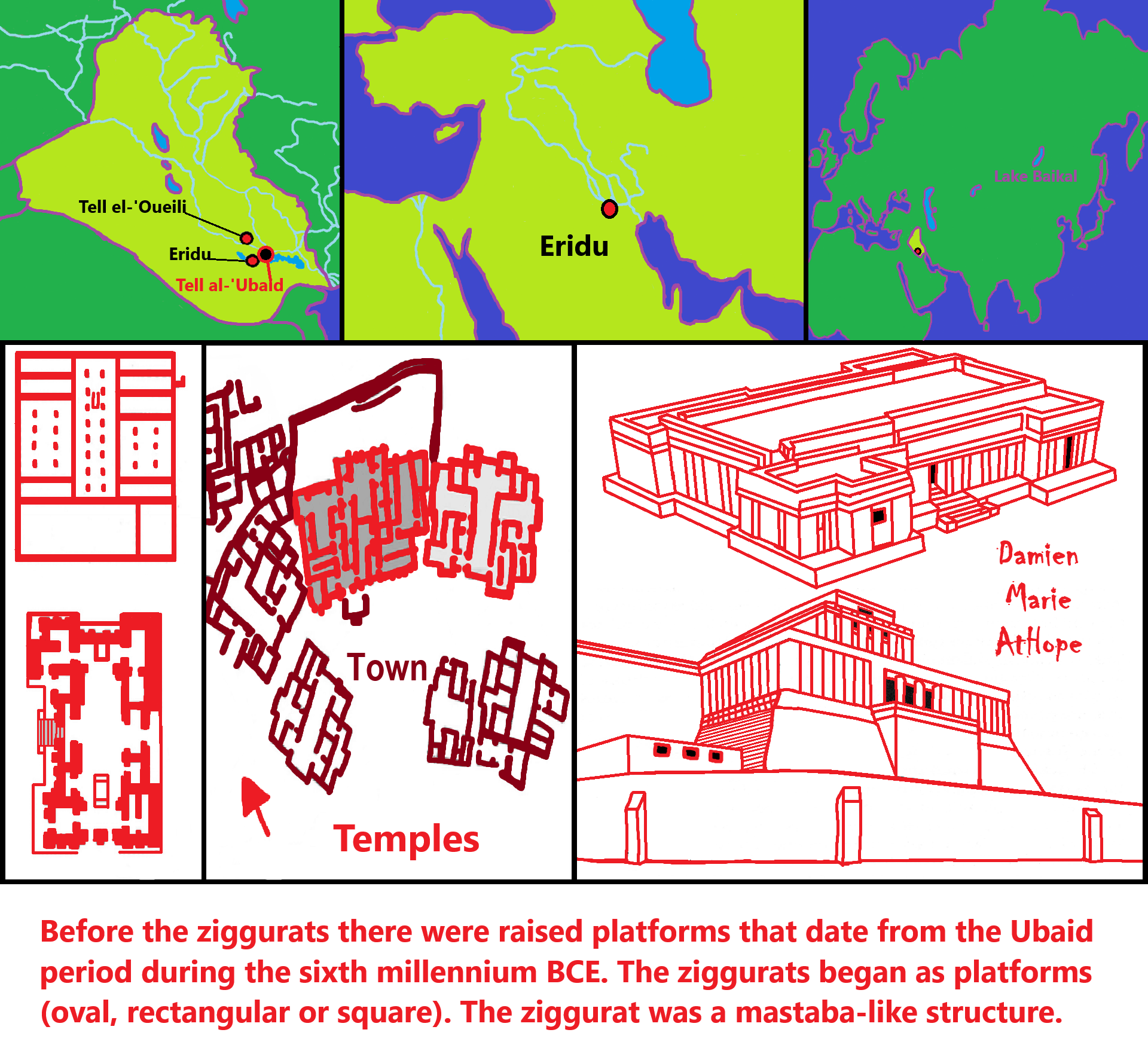
“Mesopotamian buildings of the Ubaid and Uruk periods (fifth–fourth millennia BCE). a: The reconstruction of a large tripartite house from Tell Oueili, Ubaid phase 0; b: Eridu, plan of the level VII ‘temple’; c: Part of the Tell Abada village.” ref
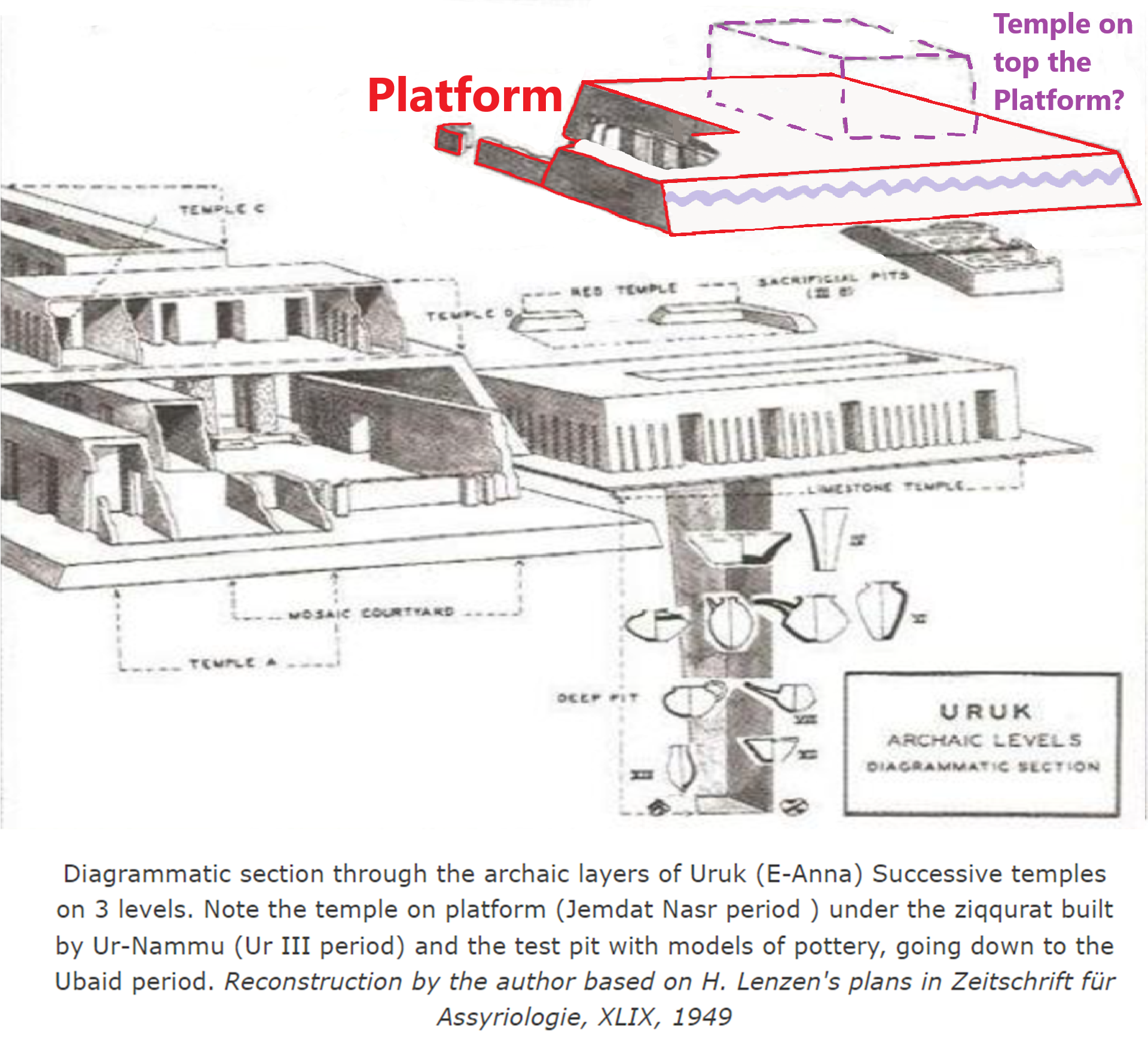
“Diagrammatic section through the archaic layers of Uruk (E-Anna) Successive temples on 3 levels. Reconstruction by the author based on H. Lenzen’s plans in Zeitschrift für Assyriologie, XLIX, 1949.” ref
“Before the ziggurats there were raised platforms that date from the Ubaid period during the sixth millennium BCE. The ziggurats began as platforms (usually oval, rectangular, or square). The ziggurat was a mastaba-like structure with a flat top. The sun-baked bricks made up the core of the ziggurat, with facings of fired bricks on the outside. Each step was slightly smaller than the step below it. The facings were often glazed in different colors and may have had astrological significance. Kings sometimes had their names engraved on these glazed bricks. The number of floors ranged from two to seven.” ref
“Tell el ‘Oueili provided the oldest archaeological levels known to date in Lower Mesopotamia, around 6200 BCE or around 8,200 years ago. The village societies inhabiting ‘Oueili, fully neolithized, will develop an art, an architecture and a craft production characteristic of the culture of Obeid. They master irrigation and cultivate cereals which they store in vast community granaries. They harvest reeds in the marshes, used in architecture. The inhabitants of ‘Oueili practice livestock breeding and fish abundantly. They know the technique of molded brick which allows them to build large houses. During the period, which lasts more than two millennia, until around 4000 BCE, a dominant class gradually emerges. The hierarchization of society is illustrated by the appearance of monumental architecture.” ref
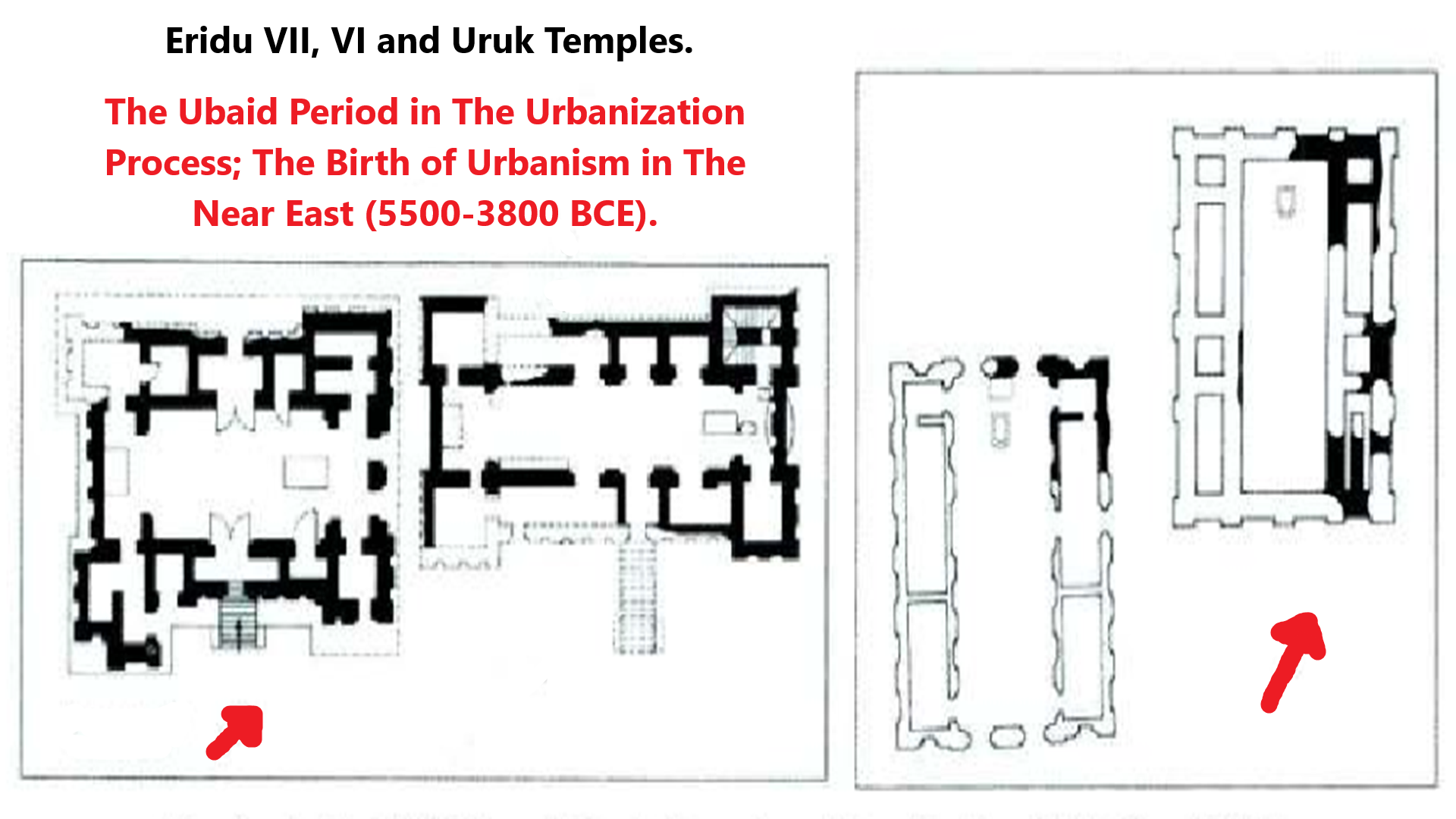
The Ubaid Period in The Urbanization Process; The Birth of Urbanism in The Near East (5500-3800 BCE)
The Ubaid culture, which takes its name from Tell-al Ubaid, plays a crucial role in the process of urbanization in the Near East. Surviving for more than 1500 years (5500-3800 BC), it was characterized by important social, economic, and political developments that influenced the development of urban polities in both the Near East and the East and Southeastern Anatolia Regions. With this culture, certain radical structural changes peculiar to complex societies, urban societies, such as political and economic centralization based on control over product, production, and labor organization with sealing practices, socio-economic differences, a high degree of economic specialization and technological development, indicate that a complex economy, and organized trade had begun to take place in the social, political and economical organizations of the societies of the Near East. This paper is concerned with enlightening the role of the Ubaid Culture in the development of urban societies in the Near East. With this aim, this culture will be analyzed from the viewpoint of those characteristics peculiar to urban societies mentioned above.” ref
“The Ubaid period (c. 5500–3700 BCE or around 7,500 to 5,700 years ago) is a prehistoric period of Mesopotamia. The name derives from Tell al-‘Ubaid where the earliest large excavation of Ubaid period material. In South Mesopotamia the period is the earliest known period on the alluvial plain although it is likely earlier periods exist obscured under the alluvium. In the south it has a very long duration between about 5500 and 3800 BCE when it is replaced by the Uruk period. In Northern Mesopotamia the period runs only between about 5300 and 4300 BCE. It is preceded by the Halaf period and the Halaf-Ubaid Transitional period and succeeded by the Late Chalcolithic period. The excavators of Eridu and Tell al-‘Ubaid found Ubaid pottery. The Eridu and Hajji Muhammed pottery styles were not distinct at all. Instead, they were part of the greater Ubaid phenomenon. The excavation at Tell el-‘Oueili in the 1980s revealed occupation layers that were older than those from Eridu. This discovery pushed back the date for the earliest human occupation of southern Mesopotamia. In the south, corresponding to the area that would later be known as Sumer, the entire Ubaid spans an immense period from ca. 6500 to 3800 BCE. It is here that the oldest known Ubaid site – Tell el-‘Oueili – was found. In southern Iraq, no archaeological site has yet yielded remains older than Ubaid, However, this might be more a result of the fact that such ancient settlements are now buried deep under alluvial sediments. This was the case, for example, of the site of Hadji Muhammed, which was discovered only by accident.” ref
“Humans could have lived south of Uruk as early as the eighth millennium BCE. This is much earlier than the oldest evidence of human occupation in this area. The oldest known site in southern Mesopotamia (Tell el-‘Oueili) dates to the Ubaid 0 period. Archaeobotanical research in the Ubaid 0 levels at ‘Oueili (6500-6000 BCE) has indicated the presence of Euphrates poplar and sea clubrush, both indicative of a wetland environment. As a result of changes in sea-level, the shoreline of the Persian Gulf during the Ubaid was different from that of today. At the beginning of the Ubaid, around 6500 BCE or around 8,500 years ago, the shoreline at Kuwait may have run slightly further south. During the subsequent 2.5 millennia, the shoreline moved further northward, up to the ancient city of Ur around 4000 BCE or around 6,000 years ago. Date palms were present in southern Mesopotamia since at least the eleventh millennium BCE, predating the earliest evidence for domesticated dates from Eridu by several millennia. Date palms require a perennial water source, again indicating that this period may have been wetter than today. Similarly, oak was present from the eighth millennium, but disappeared at around the same time that Ubaid material culture spread outward from southern Mesopotamia during the sixth millennium BCE. It has been suggested that acquisition of high-quality wood may have played a role in this expansion. Ubaid and Ubaid-like material culture has been found over an immense area. Ubaid ceramics have shown up from Turkey Mersin in the west to Tepe Ghabristan in the east, as well as from Norşuntepe, and Arslantepe in the north, to Dosariyah in the south along the Gulf coast of Saudi Arabia. In this area, researchers have discerned considerable regional variation, indicating that the Ubaid was not a monolithic culture through time and space.” ref
“Evidence for metallurgy comes from several sites in Upper Mesopotamia, all dating to the final stages of the Ubaid period. At Mersin, Level XVI (5000-4900 BCE), unalloyed copper pins and chisels were found. At southeastern Anatolian sites like Değirmentepe and Norşuntepe, metallurgical production was practiced during the Ubaid 3, as evidenced by furnaces, and related finds. At late fifth millennium Tell Nader , northern Iraq, kilns were excavated that may have been used for the production of both pottery and metal. The Ubaid period provides the first evidence for boating in the ancient Near East. Ceramic boat models have been recovered from numerous sites across Mesopotamia, from Zeidan and Tell Mashnaqa in modern-day northern Syria to Eridu and ‘Oueili in the south and Abada in the Hamrin. These models date from Ubaid 1-4 but become more common from Ubaid 3 onwards. The models indicate that different boat types may have been in use, including reed boats, and boats with masts. It has been noted that no evidence for boats has been recovered from Halaf sites in northern Mesopotamia, and that Ubaid 3, from which more boat models have been recovered, coincides with the expansion of the Ubaid towards the north and into the Persian Gulf. Stamp seals had been in use in Upper Mesopotamia since the 7th millennium BC. By the time of the Ubaid period, a wide range of motifs had developed, including geometric patterns and depictions of animals and occasional humans. The Ubaid period saw the first depictions of ibex-headed and bird-headed humans.” ref
“The most common burial practice during the Ubaid seems to have been primary inhumation; i.e. burial of the complete body. During Ubaid 4, some 80% (adults) and 94% (infants) of the burials consisted of primary inhumations. The dead were often accompanied by personal adornments such as beads, necklaces, and headdresses. Pots (presumably) containing foodstuffs were also common. Pieces of red ochre have also been recovered from graves. Burials have been excavated at many Ubaid sites, with exceptionally large numbers coming from Tell Abada (127 infant burials) and Eridu (193 burials). By the fifth millennium BC, children and adults were given differential treatment in death. The available evidence indicates that infants were primarily buried inside the settlement, often near larger, presumably more important dwellings, and often in pots. The association of children’s burials with larger buildings is well-illustrated at the sites of Tell Abada and Tepe Gawra. It has been suggested that this pattern of children’s burials near larger dwellings was related to increasing social differentiation between kin groups. Adults, on the other hand, were buried at the edge of the settlement in communal burial grounds in pit burials or inside clay boxes. Such burial grounds have, for example, been excavated at Eridu. These burial practices represent a clear break from those of the preceding Late Neolithic period. During the Late Neolithic, burials were often secondary and burial treatment was very diverse. The Ubaid witnessed a marked shift toward primary burial, less diverse burial customs, and less diversity in burial gifts. This shift has been interpreted as a reflection of changing perceptions of personhood.” ref
“Evidence for cranial modification, i.e. deliberate headshaping, among both men and women, has come from many archaeological sites throughout wider Mesopotamia. Where headshaping was detected, it was all of the same type, i.e. one- or two-band circumferential headshaping, which results in an elongated shape of the head. Different types of headshaping were practiced prior to and after the Ubaid period across the Near East, but it seems that the specific technique of circumferential headshaping may have originated in Iran, east of the area of Ubaid influence, and reached its peak during the Ubaid period. It has been interpreted as a marker for socio-cultural group affiliation during the Ubaid. Labrets and/or ear-spools were likewise recovered from many archaeological Ubaid sites across Mesopotamia and its border regions. In at least one case from southwestern Iran, a labret was found in situ in a burial, located at the mandible of the buried individual and with associated tooth wear indicating that it had been worn. Labrets were absent from Halaf sites in northern Mesopotamia, again indicating that they may have been important markers of socio-cultural identity during the Ubaid. Their use seems to have declined again during the Uruk period.” ref
“Ubaid culture is characterized by large unwalled village settlements, multi-roomed rectangular mud-brick houses and the appearance of the first temples of public architecture in Mesopotamia, with a growth of a two tier settlement hierarchy of centralized large sites of more than 10 hectares surrounded by smaller village sites of less than 1 hectare. Domestic equipment included a distinctive fine quality buff or greenish colored pottery decorated with geometric designs in brown or black paint. Tools such as sickles were often made of hard fired clay in the south, while in the north stone and sometimes metal were used. Villages thus contained specialised craftspeople, potters, weavers and metalworkers, although the bulk of the population were agricultural labourers, farmers and seasonal pastoralists. During the Ubaid Period (5000–4000 BC), the movement towards urbanization began. “Agriculture and animal husbandry [domestication] were widely practiced in sedentary communities”. There were also tribes that practiced domesticating animals as far north as Turkey, and as far south as the Zagros Mountains. The Ubaid period in the south was associated with intensive irrigated hydraulic agriculture, and the use of the plough, both introduced from the north, possibly through the earlier Choga Mami, Hadji Muhammed, and Samarra cultures.” ref
“The Ubaid period as a whole, based upon the analysis of grave goods, was one of increasingly polarized social stratification and decreasing egalitarianism. Bogucki describes this as a phase of “Trans-egalitarian” competitive households, in which some fall behind as a result of downward social mobility. Morton Fried and Elman Service have hypothesized that Ubaid culture saw the rise of an elite class of hereditary chieftains, perhaps heads of kin groups linked in some way to the administration of the temple shrines and their granaries, responsible for mediating intra-group conflict and maintaining social order. It would seem that various collective methods, perhaps instances of what Thorkild Jacobsen called primitive democracy, in which disputes were previously resolved through a council of one’s peers, were no longer sufficient for the needs of the local community. Ubaid culture originated in the south, but still has clear connections to earlier cultures in the region of middle Iraq. The appearance of the Ubaid folk has sometimes been linked to the so-called Sumerian problem, related to the origins of Sumerian civilisation. Whatever the ethnic origins of this group, this culture saw for the first time a clear tripartite social division between intensive subsistence peasant farmers, with crops and animals coming from the north, tent-dwelling nomadic pastoralists dependent upon their herds, and hunter-fisher folk of the Arabian littoral, living in reed huts.” ref
“Stein and Özbal describe the Near East oecumene that resulted from Ubaid expansion, contrasting it to the colonial expansionism of the later Uruk period. “A contextual analysis comparing different regions shows that the Ubaid expansion took place largely through the peaceful spread of an ideology, leading to the formation of numerous new indigenous identities that appropriated and transformed superficial elements of Ubaid material culture into locally distinct expressions.” There is some evidence of warfare during the Ubaid period although it is extremely rare. The “Burnt Village” at Tell Sabi Abyad could be suggestive of destruction during war but it could also have been due to other causes, such as wildfire or accident. Ritual burning is also possible since the bodies inside were already dead by the time they were burned. A mass grave at Tepe Gawra contained 24 bodies apparently buried without any funeral rituals, possibly indicating it was a mass grave from violence. Copper weapons were also present in the form of arrow heads and sling bullets, although these could have been used for other purpose; two clay pots recovered from the era have decorations showing arrows used for the purpose of hunting. A copper axe head was made in the late Ubaid period, which could have been a tool or a weapon. During the late Ubaid period, around 4500–4000 BCE or around 6,500 to 6,000 years ago, there was some increase in social polarization, with central houses in the settlements becoming bigger. But there were no real cities until the later Uruk period.” ref
“Tell al-‘Ubaid (Arabic: العبيد) is a low, relatively small tell (settlement mound) west of nearby Ur in southern Iraq‘s Dhi Qar Governorate. Most of the remains are from the Chalcolithic Ubaid period, for which Tell al-‘Ubaid is the type site, with an Early Dynastic temple and cemetery at the highest point. It was a cult center for the goddess Ninhursag. The excavated Early Dynastic temple of Ninḫursaĝ, A-Ane-pada, is located on the northern edge of the site. Finds included a copper framed frieze of limestone birds set in a black shale background. The temple was also worked on in the Ur III period. A cemetery was also found with 96 graves, mostly from the Early Dynastic Period. The lower level of the site featured large amounts of Ubaid pottery and associated kilns. Evidence for Ubaid period pottery manufacture has also been observed on the surface of the site. The size of the surface scatter indicates that pottery production was a specialized craft, and this confirms finds from other Ubaid sites like Eridu. The site also yielded a cemetery and some finds from the Jemdet Nasr period. The temple of Ninhursag at the summit was on a cleared oval similar to that at Khafajah. The wall surrounding the temple was built by Shulgi of the Ur III Empire.” ref
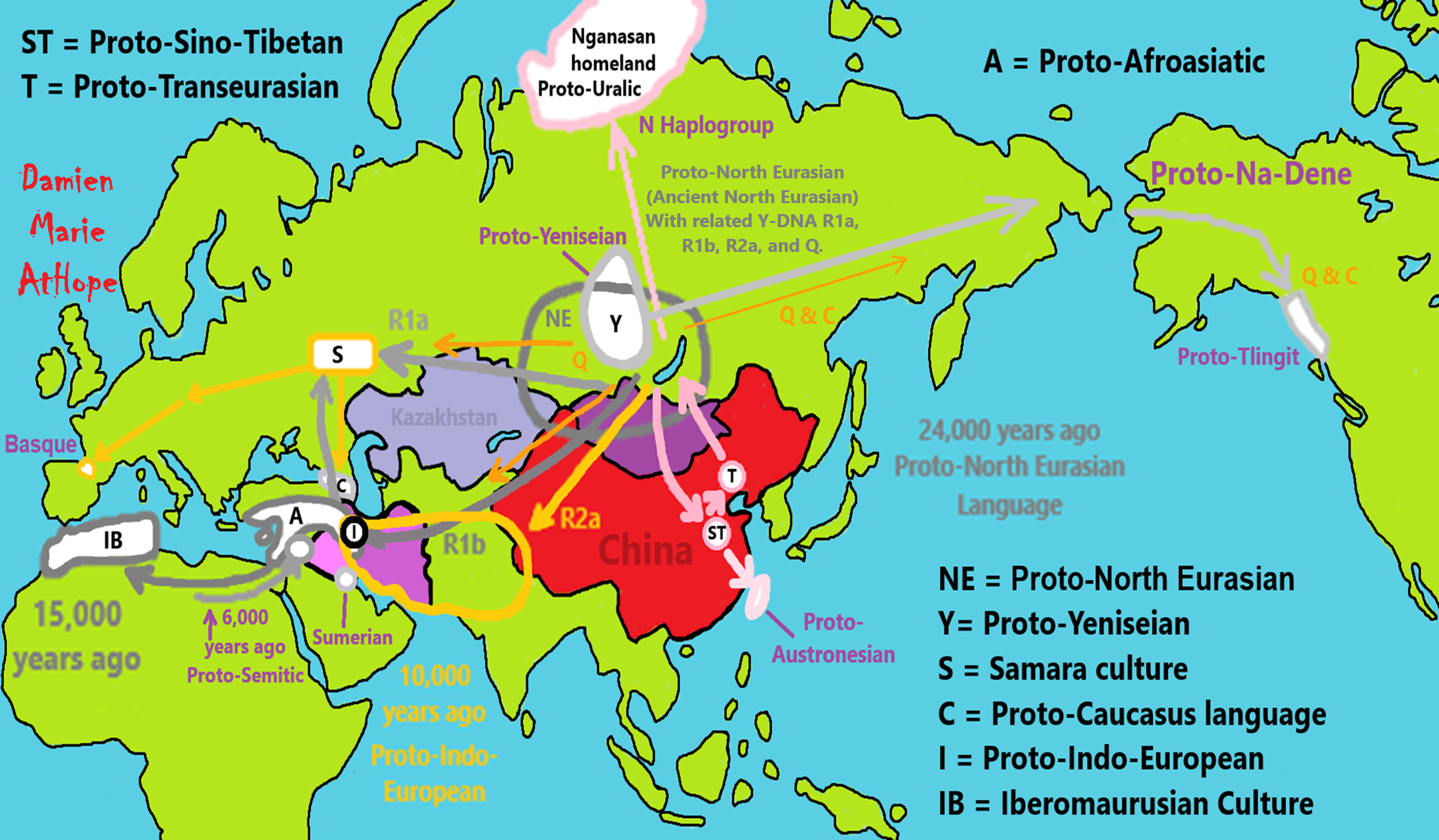
ref, ref, ref, ref, ref, ref, ref, ref, ref, ref, ref, ref, ref, ref, ref, ref, ref, ref, ref, ref, ref, ref, ref, ref, ref, ref, ref, ref, ref, ref, ref
This art above explains my thinking from my life of investigation
I am an anarchist (Social anarchism, Left-wing anarchism, or Socialist anarchism) trying to explain prehistory as I see it after studying it on my own starting 2006. Anarchists are for truth and believe in teaching the plain truth; misinformation is against this, and we would and should fight misinformation and disinformation.
I see anarchism as a social justice issue not limited to some political issue or monetary persuasion. People own themselves, have self/human rights, and deserve freedoms. All humanity is owed respect for its dignity; we are all born equal in dignity and human rights, and no plot of dirt we currently reside on changes this.
I fully enjoy the value (axiology) of archaeology (empirical evidence from fact or artifacts at a site) is knowledge (epistemology) of the past, adding to our anthropology (evidence from cultures both the present and past) intellectual (rational) assumptions of the likely reality of actual events from time past.
I am an Axiological Atheist, Philosopher & Autodidact Pre-Historical Writer/Researcher, Anti-theist, Anti-religionist, Anarcho Humanist, LGBTQI, Race, & Class equality. I am not an academic, I am a revolutionary sharing education and reason to inspire more deep thinking. I do value and appreciate Academics, Archaeologists, Anthropologists, and Historians as they provide us with great knowledge, informing us about our shared humanity.
I am a servant leader, as I serve the people, not myself, not my ego, and not some desire for money, but rather a caring teacher’s heart to help all I can with all I am. From such thoughtfulness may we all see the need for humanism and secularism, respecting all as helpful servant leaders assisting others as often as we can to navigate truth and the beauty of reality.
‘Reality’ ie. real/external world things, facts/evidence such as that confirmed by science, or events taken as a whole documented understanding of what occurred/is likely to have occurred; the accurate state of affairs. “Reason” is not from a mind devoid of “unreason” but rather demonstrates the potential ability to overcome bad thinking. An honest mind, enjoys just correction. Nothing is a justified true belief without valid or reliable reason and evidence; just as everything believed must be open to question, leaving nothing above challenge.
I don’t believe in gods or ghosts, and nor souls either. I don’t believe in heavens or hells, nor any supernatural anything. I don’t believe in Aliens, Bigfoot, nor Atlantis. I strive to follow reason and be a rationalist. Reason is my only master and may we all master reason. Thinking can be random, but reason is organized and sound in its Thinking. Right thinking is reason, right reason is logic, and right logic can be used in math and other scientific methods. I don’t see religious terms Animism, Totemism, Shamanism, or Paganism as primitive but original or core elements that are different parts of world views and their supernatural/non-natural beliefs or thinking.
I am inspired by philosophy, enlightened by archaeology, and grounded by science that religion claims, on the whole, along with their magical gods, are but dogmatic propaganda, myths, and lies. To me, religions can be summed up as conspiracy theories about reality, a reality mind you is only natural and devoid of magic anything. And to me, when people talk as if Atlantis is anything real, I stop taking them seriously. Like asking about the reality of Superman or Batman just because they seem to involve metropolitan cities in their stores. Or if Mother Goose actually lived in a shoe? You got to be kidding.
We are made great in our many acts of kindness, because we rise by helping each other.
NE = Proto-North Eurasian/Ancient North Eurasian/Mal’ta–Buret’ culture/Mal’ta Boy “MA-1” 24,000 years old burial
A = Proto-Afroasiatic/Afroasiatic
S = Samara culture
ST = Proto-Sino-Tibetan/Sino-Tibetan
T = Proto-Transeurasian/Altaic
C = Proto-Northwest Caucasus language/Northwest Caucasian/Languages of the Caucasus
I = Proto-Indo-European/Indo-European
IB = Iberomaurusian Culture/Capsian culture
Natufian culture (15,000–11,500 years ago, Syria, Lebanon, Jordan, the Sinai Peninsula, and the Negev desert)
Nganasan people/Nganasan language
Na-Dene languages/Dené–Yeniseian, Dené–Caucasian
Proto-Semitic/Semitic languages
24,000 years ago, Proto-North Eurasian Language (Ancient North Eurasian) migrations?
My thoughts:
Proto-North Eurasian Language (Ancient North Eurasian) With related Y-DNA R1a, R1b, R2a, and Q Haplogroups.
R1b 22,0000-15,000 years ago in the Middle east creates Proto-Afroasiatic languages moving into Africa around 15,000-10,000 years ago connecting with the Iberomaurusian Culture/Taforalt near the coasts of Morocco, Algeria, and Tunisia.
R2a 10,000 years ago in Iran brings/creates Proto-Indo-European language and also a possibility is R1a in Russia around 9,000 years ago may have had a version of Proto-Indo-European language.
Around 14,000-10,000 years ago??? Proto-North Eurasian Language goes to the Yellow River basin (eventually relating with the Yangshao culture) in China creates Proto-Sino-Tibetan language.
Proto-Sino-Tibetan language then moves to the West Liao River valley (eventually relating with the Hongshan culture) in China creating Proto-Transeurasian (Altaic) language around 9,000 years ago.
N Haplogroups 9,000 years ago with Proto-Transeurasian language possibly moves north to Lake Baikal. Then after living with Proto-North Eurasian Language 24,000-9,000 years ago?/Pre-Proto-Yeniseian language 9,000-7,000 years ago Q Haplogroups (eventually relating with the Ket language and the Ket people) until around 5,500 years ago, then N Haplogroups move north to the Taymyr Peninsula in North Siberia (Nganasan homeland) brings/creates the Proto-Uralic language.
Q Haplogroups with Proto-Yeniseian language /Proto-Na-Dene language likely emerge 8,000/7,000 years ago or so and migrates to the Middle East (either following R2a to Iraq or R1a to Russia (Samara culture) then south to Iraq creates the Sumerian language. It may have also created the Proto-Caucasian languages along the way. And Q Haplogroups with Proto-Yeniseian language to a migration to North America that relates to Na-Dené (and maybe including Haida) languages, of which the first branch was Proto-Tlingit language 5,000 years ago, in the Pacific Northwest.
Sino-Tibetan language then moves more east in China to the Hemudu culture pre-Austronesian culture, next moved to Taiwan creating the Proto-Austronesian language around 6,000-5,500 years ago.
R1b comes to Russia from the Middle East around 7,500 years ago, bringing a version of Proto-Indo-European languages to the (Samara culture), then Q Y-DNA with Proto-Yeniseian language moves south from the (Samara culture) and may have been the language that created the Proto-Caucasian language. And R1b from the (Samara culture) becomes the 4,200 years or so R1b associated with the Basques and Basque language it was taken with R1b, but language similarities with the Proto-Caucasian language implies language ties to Proto-Yeniseian language.
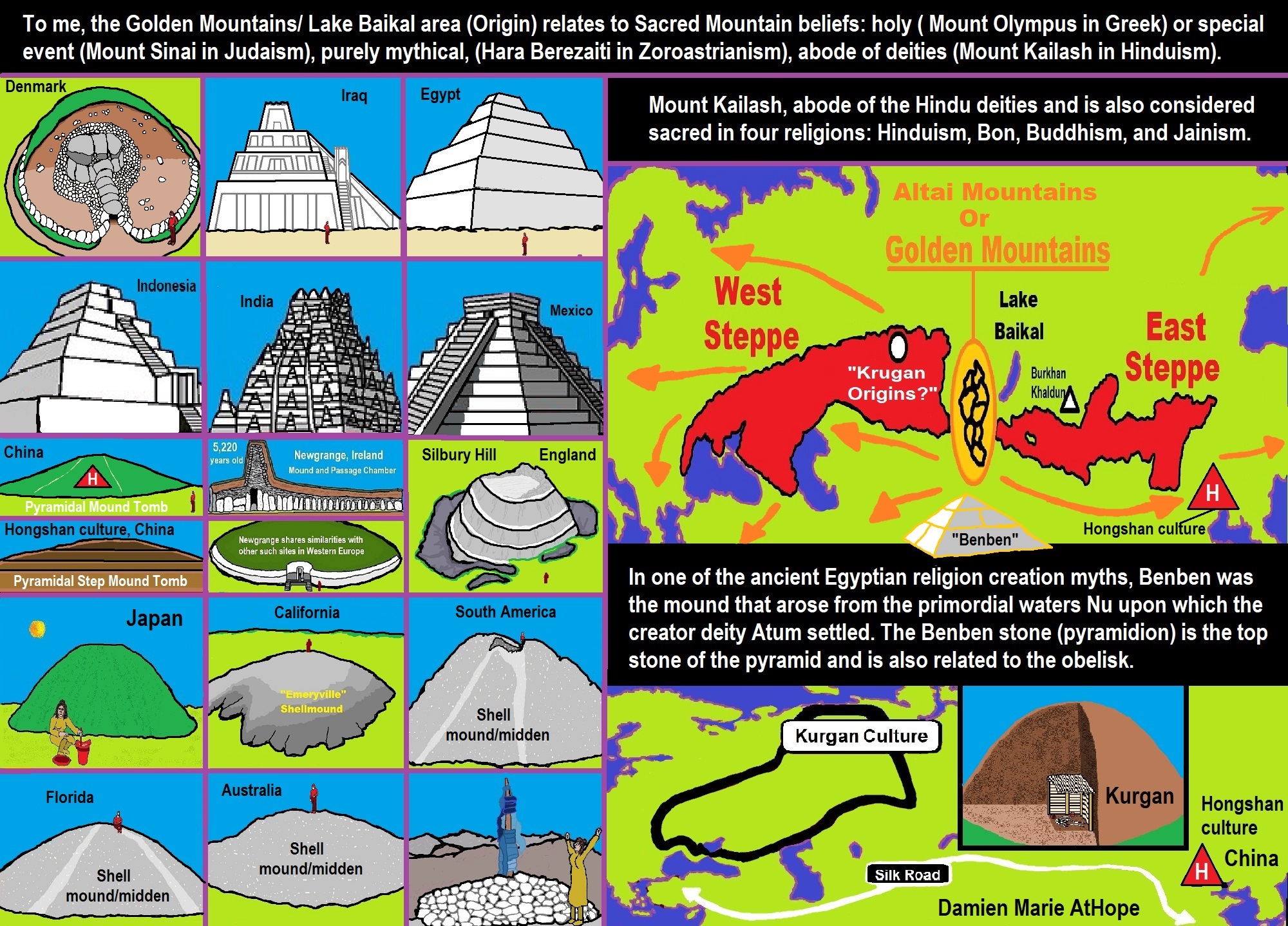
ref, ref, ref, ref, ref, ref, ref, ref, ref, ref, ref, ref, ref, ref, ref, ref, ref, ref, ref, ref, ref, ref, ref, ref
My Speculations are in Comparative Mythologies?
For instance, the mytheme of an ancient belief that is seemingly shared though changed and adapted, a fundamental generic unit of narrative structure seems to be shared a common relation with mountains/ancestors/gods or sacred animals with Sacred Mounds, Mountains, Kurgans, and Pyramids.
Sacred Mounds, Mountains, Kurgans, and Pyramids may hold deep Mythology connections?
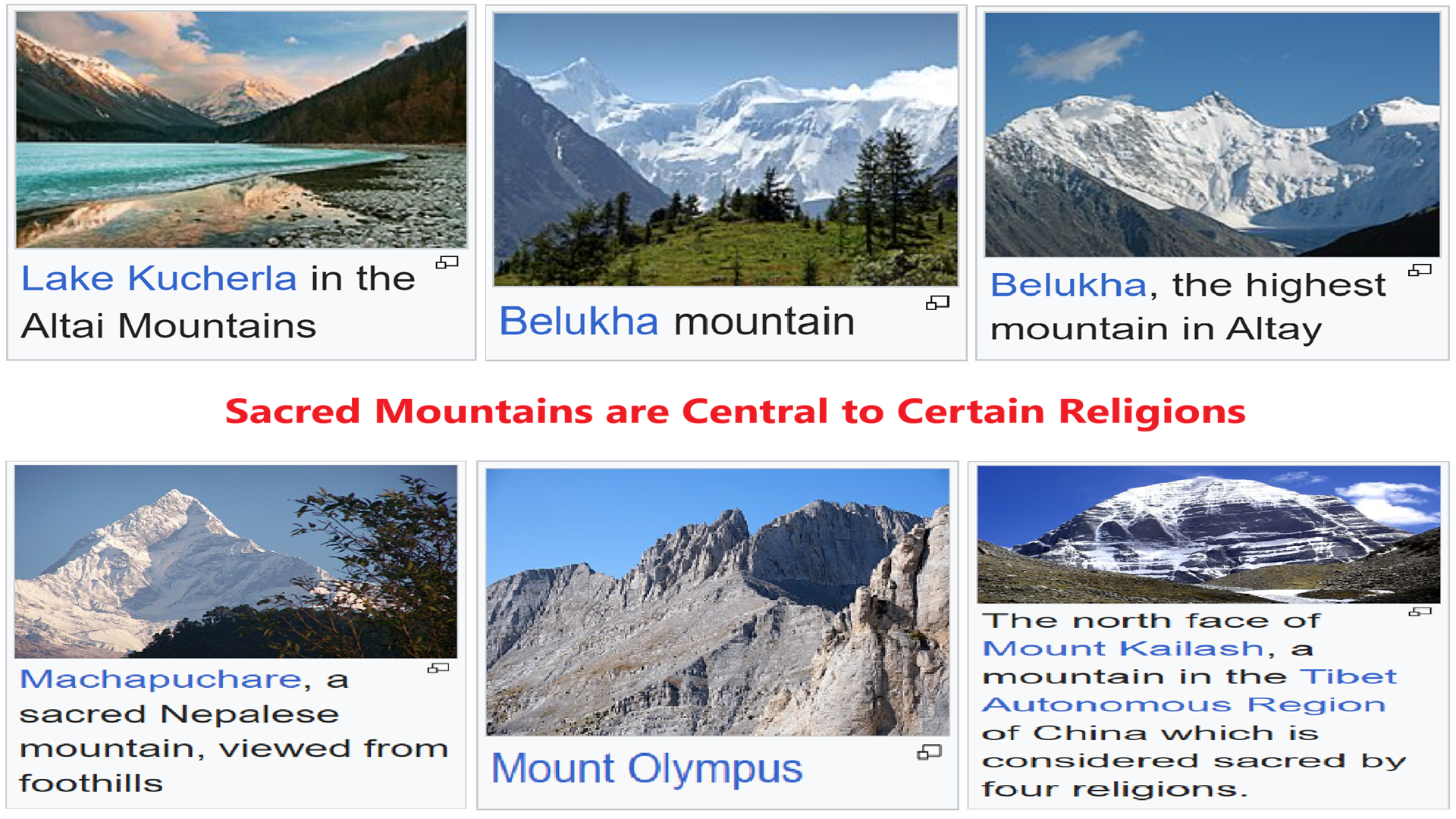
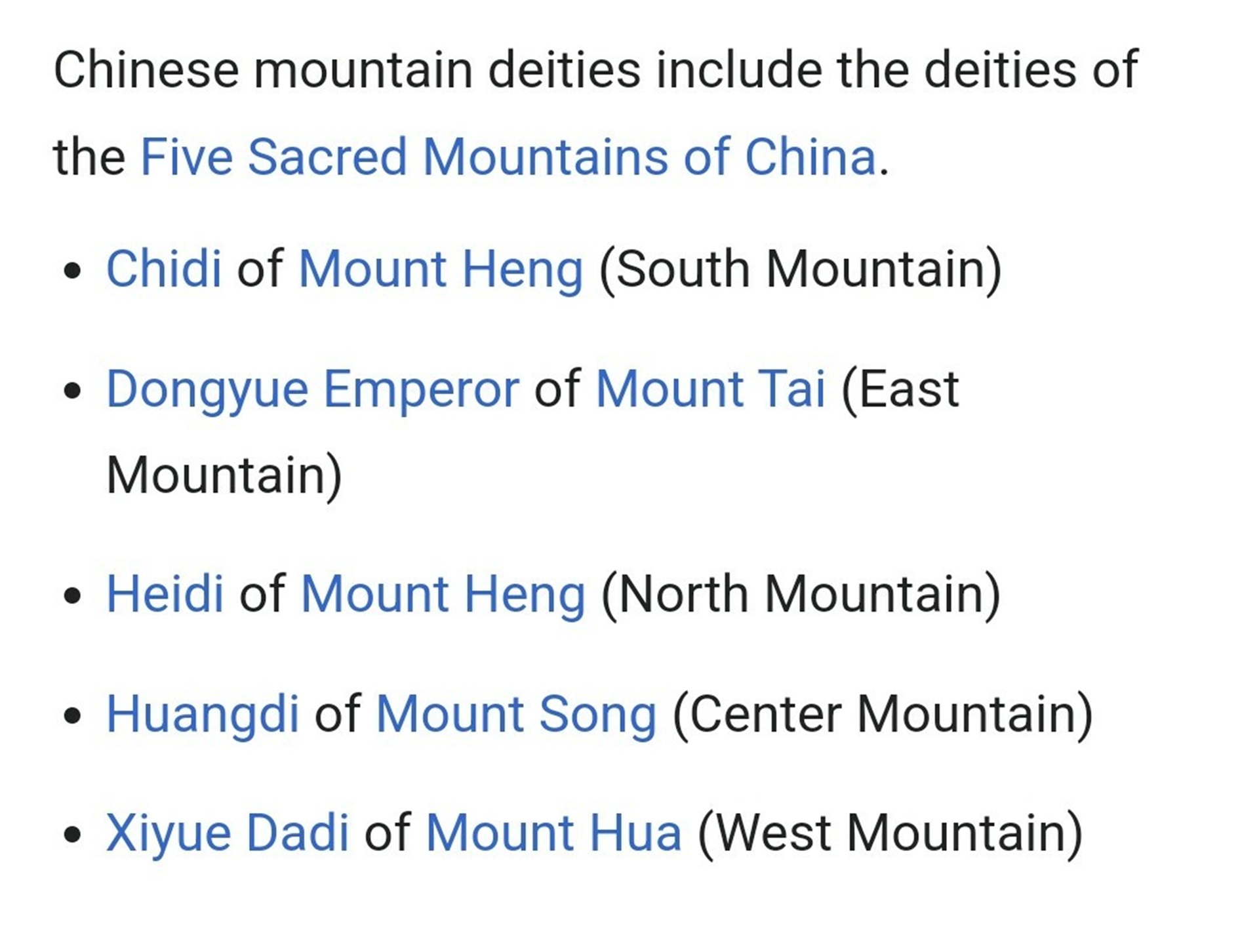
Mountain Gods
“Mountain Gods (山神) are Asian tutelary deities associated with mountains. They are related to landlord deities and tudigongs, and City Gods.” ref
“Artemis, Bà Chúa Xứ. Cybele, Cyllene (nymph), Dali, Konohanasakuya-hime, Kukurihime, Lelluri, Ma (Sumerian), Maia, Maria Cacao, Maria Makiling, Maria Sinukuan, Mẫu Thượng Ngàn, Ninhursag, Ninkurra, Oread, Parvati, Rhea, Saso, Skaði, Tenma, and Zana.” ref
“In Greek mythology, the Ourea (Ancient Greek: Οὔρεα, romanized: Oúrea, lit. ’mountains’, plural of Οὖρος, or ‘Oûros’) were the parthenogenetic offspring of Gaia (Earth), produced alongside Uranus (Sky), and Pontus (Sea).” ref
Why do I champion truth?
I don’t do it to offend but to educate. If others fear education, then maybe what they believe is fragile to the truth. My offering education for free is an example of my deep humanity. I explain the evolution of religion, starting in animism in southern Africa, then some people speads out of Afraca, one branch goes to western Europe evolving into totemism, and another goes to Siberia evolving into shamanism, Shamanism and totemism next mix in central Europe, and some people head to Lake Baikal in southern Siberia. It is from there that shamanism heads to Turkey, evolving into paganism.
Milky Way (mythology/axis mundi)
“Milky Way mythology is seen in Armenian, Australian Aboriginal, Americas, Eastern Asia, Egyptian, Finno-Ugric, Greek, Hungarian, Indian, Irish, Māori, Mesopotamian, San (Southern AFRICA), Roman, and Welsh.” ref
“There are many myths and legends about the origin of the Milky Way, the crowd of stars that makes a distinctive bright streak across the night sky. In Egyptian mythology, the Milky Way was considered a pool of cow’s milk. The Milky Way was deified as a fertility cow-goddess by the name of Bat (later on syncretized with the sky goddess Hathor). The astronomer Or Graur has suggested that the Egyptians may have seen the Milky Way as a celestial depiction of the sky goddess Nut. In Hungarian mythology, Csaba, the mythical son of Attila the Hun and ancestor of the Hungarians, is supposed to ride down the Milky Way when the Székelys (ethnic Hungarians living in Transylvania) are threatened. Thus the Milky Way is called “The Road of the Warriors” (lit. “Road of Armies”) Hungarian: Hadak Útja. The stars are sparks from their horseshoes.” ref
“In the Babylonian epic poem Enûma Eliš, the Milky Way is created from the severed tail of the primeval salt water dragoness Tiamat, set in the sky by Marduk, the Babylonian national god, after slaying her. This story was once thought to have been based on an older Sumerian version in which Tiamat is instead slain by Enlil of Nippur, but is now thought to be purely an invention of Babylonian propagandists with the intention to show Marduk as superior to the Sumerian deities. Another myth about Labbu is similarly interpreted. The San people in southern Africa say that long ago there were no stars and the night was pitch black. A girl of the ancient race, !Xwe-/na-ssho-!ke, who was lonely and wanted to visit other people, threw the embers from a fire into the sky and created the Milky Way.” ref
“To the Māori the Milky Way is the waka (canoe) of Tama-rereti. The front and back of the canoe are Orion and Scorpius, while the Southern Cross and the Pointers are the anchor and rope. According to legend, when Tama-rereti took his canoe out onto a lake, he found himself far from home as night was falling. There were no stars at this time and in the darkness the Taniwha would attack and eat people. So Tama-rereti sailed his canoe along the river that emptied into the heavens (to cause rain) and scattered shiny pebbles from the lakeshore into the sky. The sky god, Ranginui, was pleased by this action and placed the canoe into the sky as well as a reminder of how the stars were made.” ref
“The double spiral and the Milky Way: The traditions of some of the oldest known civilizations share the belief that the souls of men dwell, between one reincarnation and the next, in the center of the Milky Way. This idea was widespread not only in Neolithic Europe, but also and above all in the Americas, for example. among Indians of Honduras and Nicaragua, and in a large number of North American traditions, such as eg. those of the Pawnee and Cherokee [cf. Santillana-Dechend, Hamlet’s mill, pp. 287-288]. The Milky Way, in all these cultures, appears indissolubly connected to the symbolism of the double spiral and to the passage from this world to the “Other World.” ref
“According to the natives of North America, the “Spiral of Life” is a representation of the “Lodge of Dreams” (in all probability a denomination of the Milky Way), the place from which, according to the traditions, all the knowledge of those peoples comes. For the Maya hunab ku, the “Galactic Butterfly», is the primordial divinity above all the others and at the same time the center of the Milky Way: represented as a double spiral, it meant the balance of opposing forces, universal consciousness, but also the door to access other parallel dimensions.” ref
“At this point, it seems necessary to note, before moving on to another spiral symbol – and catapulting us for a moment to the present day – how, thanks to the most advanced scientific instruments, it has now been possible to observe how the Milky Way is formed by several branches a spiral of logarithmic type, with an inclination of 12 degrees. A spiral is called “logarithmic” or “growth” when, moving from a center outwards, its sections grow exponentially, according to that continuous geometric proportion, everywhere present in nature (e.g. in galaxies, swirls, eddies of water, sunflowers, succulents, shells, pine cones, etc.) is Plato considered “the deepest cosmic bond” is “the only resonance on which the world is founded». This ‘divine proportion’, also called the ‘Golden Section’, was codified in the famous “Fibonacci sequence” (from its discoverer, the mathematician Leonardo Pisano; 1175 c.ca – 1235), which develops in such a way that each number of the sequence is equivalent to the sum of the two preceding it.” ref
“Mixcoatl (Nahuatl languages: Mixcōhuātl, [miʃˈkoːwaːt͡ɬ] from mixtli [ˈmiʃt͡ɬi] “cloud” and cōātl [ˈkoːaːt͡ɬ] “serpent”), or Camaxtle [kaˈmaʃt͡ɬe] or Camaxtli, was the god of the hunt and identified with the Milky Way, the stars, and the heavens in several Mesoamerican cultures. He was the patron deity of the Otomi, the Chichimecs, and several groups that claimed descent from the Chichimecs. Under the name of Camaxtli, Mixcoatl was worshipped as the central deity of Huejotzingo and Tlaxcala.” ref
“The Incas not only identified constellations and individual stars, but they also assigned each a purpose . They believed that everything in and around our world was connected. The Inca flourished in the Andes Mountains in South America from the 12th to 15th centuries. They had a grand empire stretching from present-day Colombia to Chile. Worship was very important to them, and they had a complicated religion closely linked to astronomy . The Inca worshiped various Gods, including Viracocha (the creator), Inti (the sun), and Chuqui Illa, the God of Thunder. They also worshiped huacas, spirits that were believed to inhabit any remarkable phenomenon, including large boulders, trees, streams or waterfalls.” ref
“In general, the sky was very important to the Inca. Both the moon and sun were seen as gods and they built extravagant pillars and temples with great precision so that these “heavenly bodies”, like the sun, would pass over the structures or through windows on specific days, like the summer solstice. The most crucial events for the Inca generally involved the rising and setting of the sun, moon, and stars. Upon looking at the stars, the Inca noticed many animals and other representations from their day-to-day lives. The Inca worship of stars and dark constellations shows us that this culture believed everything around them was connected. The sky had a very special meaning in managing this civilization and impacted daily life.” ref
“Astronomy was very important for the Inca civilization, partly due to the importance of agriculture. Astronomy was used for agricultural purposes. Cusco, for example, lies on a radial plan, mimicking the sky and pointing to specific astronomical events on the horizon. Similarly to the ancient Egyptians, this was a horizon-based culture. They built carefully placed pillars on mountains and hills overlooking Cusco, so when the sun rose or set between these pillars, they knew they had to plant at a specific altitude. The Inca, however, not only studied individual stars but also grouped stars into constellations. Grouping these stars into constellations became very important to the Inca.” ref
“One star grouping, known as the Pleiades, was especially believed to be influential over the well-being of animals. Pleiades were not seen as a greater God to the Inca, but they rather saw it as a huaca to which shamans would make regular sacrifices. The second type of constellation could only be observed when there were no stars: they were the dark spots or blotches on the Milky Way. These dark blotches were considered as living (animate) animals. The animals were believed to live in the Milky Way, which they thought of as a river. The Inca were one of the few civilizations who were able to locate their constellations without the presence of stars. These dark constellations, in turn, made up the Inca zodiac.” ref
“Maya astronomy is the study of the Moon, planets, Milky Way, Sun, and astronomical phenomena by the Precolumbian Maya Civilization of Mesoamerica. The Classic Maya in particular developed some of the most accurate pre-telescope astronomy in the world, aided by their fully developed writing system and their positional numeral system, both of which are fully indigenous to Mesoamerica. The Classic Maya understood many astronomical phenomena: for example, their estimate of the length of the synodic month was more accurate than Ptolemy’s, and their calculation of the length of the tropical solar year was more accurate than that of the Spanish when the latter first arrived. Many temples from the Maya architecture have features oriented to celestial events.” ref
“Planting and harvesting, drought, rain and hurricane season, the eclipse season, and the relationship of the Milky Way to the horizon. The Milky Way appears as a hazy band of faint stars. It is the disc of our own galaxy, viewed edge-on from within it. It appears as a 10°-wide band of diffuse light passing all the way around the sky. It crosses the ecliptic at a high angle. Its most prominent feature is a large dust cloud that forms a dark rift in its southern and western part. There is no almanac in the codices that refers specifically to the Milky Way but there are references to it in almanacs concerned with other phenomena.” ref
Early Maya E Groups, the Milky Way, and Creation
“Prudence M. Rice proposes a “Milky Way / creation hypothesis” for the elongated eastern structures in early Maya E Groups: they were modeled on the Milky Way galaxy. These architectural arrangements, beginning in the Preclassic period (c. 900 BCE–CE 200) in the southern Maya Lowlands, were adopted from predecessors in the Early Preclassic neighboring Gulf Coast region. The widespread overall similarity of E Groups suggests a shared belief system centered on myths about creation, and many of the characters (e.g., Maize God) and events of creation in Maya myths are set in the Milky Way. The general north–south axial orientation of the eastern platform, frequently pivoted northeast–southwest, is proposed to be related to the rainy season position of the Milky Way overhead. E Groups were probably multifunctional ritual theaters, the eastern platforms serving as stages for nighttime performances of creation stories. Late modifications into a tripart edifice, with structures or superstructures in the center and at both ends, replicated the major asterisms of the visible galaxy and/or the creator gods.” ref
“Ever so long ago, the Breathmaker blew his breath toward the sky and created the Milky Way. This broad pathway in the night sky leads to the City of the West. There is where the souls of good Indians go when they die. Bad Indian souls stay in the ground where they are buried. When the Seminole Indians walk through the woods and step where a bad person has been buried, they become fearful. Even though the grave is covered with brush, they always seem to know that a bad person is buried there. The Seminoles say the Milky Way shines brightest following the death of one of their tribe. They believe this is so that the path to the City in the Sky will be lighted brightly for the traveling Seminole.” ref
“For a good Indian to be able to walk over the Milky Way, he must first be one whom everyone likes. He cannot be one who talks in an evil manner, or lies and steals. He must be brave at all times and an honour to the Seminoles. In the Seminole language, so-lo-pi he-ni means “spirit way” or “the Milky Way for human souls.” And if-i he-ni means “dog way” and is the sky-path for the souls of dogs and other animals that die. Spirits never return to earth from the City in the Sky. Seminoles do not believe that ghostly visitors ever come back and visit their people again. Along the Milky Way lives Rain and Rainbow. The Seminole word for Rainbow means stop-the-rain, and that is what the Rainbow does when it appears.” ref
“When the Sun is eclipsed, Seminoles say that toad-frog has come along and taken a bite out of the Sun. Toad-frog continues eating at the Sun until the Sun disappears. Seminole hunters shoot arrows at toad-frogs whenever they see one, preventing eclipses of the Sun or Moon. Seminole hunters like to make a loud clamour to scare the toad-frogs away when they do appear. Along the Milky Way is Big Dipper, which seems like a boat to the Seminoles. They say it is used to carry the souls of good Seminoles along the Milky Way to the City in the Sky. The Seminole tribe calls the Morning Star the Tomorrow Star, and the Evening Star is known to them as the Red Star.” ref
“The Maya Milky Way is the path to the Otherworld. The cross in the sky formed by the Milky Way and the ecliptic stretches out in all four directions.” ref
“A version of the tracks motif, the Milky Way, is viewed as the path re- resulting from a chase. This was found in a Tlingit raven myth.” ref
“The Lakota people refer to the Milky Way as “Wanaghi Tachanku.”Wanaghi Tachanku translates to “trail of the spirits.” ref
“The Hopi say their first home was in the Pleiades constellation, which they refer to as Chuhukon. The Cree Nation has legends that say their ancestors arrived on earth as spirits from the stars. Traditionally, the Zuni also believed they were related to a kind of Star People.” ref
Pleiades in folklore
“Nearly always imagined as a group of “seven sisters,” and their myths explain why there are only six. Seen in North Africa, the Middle East, Europe, the Americas, Asia, Oceania, and Subsaharan Africa. The Talmud (Berakhot 58b) suggests understanding ke’ me-ah as kimah (כימה as כמאה) “about one hundred” stars in the Pleiades star cluster. Like most astronomical figures in rabbinic writing, the Jewish sages pointed to this as having come from Mount Sinai.” ref
“The Mesopotamian cuneiform texts of the MUL.APIN, which were produced from the seventh century BC onwards, describe Pleiades leap rules for the intercalation of months. They refer to a time well before the creation of the surviving clay tablets, which have been copied several times, namely the 26th century BCE. This results from the astronomical dates explicitly given in the texts for the visibility of the Pleiades (Sumerian term MUL.MUL = “stars”) and the beginnings of the months. The two surviving Babylonian Pleiades leap rules are recorded in lines eight to eleven of the second clay tablet of the MUL.APIN series. Although the cuneiform characters of the beginnings of lines ten and eleven have not been completely preserved, they can be reconstructed relatively reliably and meaningfully. A normal year has twelve lunar months. A full year requires the intercalation of a thirteenth lunar month. According to this leap rule, seven synodical month have to be intercalated within the duration of a Metonic cycle, which has exactly nineteen solar years.” ref
“To the Bronze Age people of Europe, such as the Celts (and probably considerably earlier), the Pleiades were associated with mourning and with funerals, since at that time in history, on the cross-quarter day between the autumn equinox and the winter solstice (see Samhain, also Halloween or All Souls Day), which was a festival devoted to the remembrance of the dead, the cluster rose in the eastern sky as the Sun’s light faded in the evening. It was from this acronychal rising that the Pleiades became associated with tears and mourning. As a result of precession over the centuries, the Pleiades no longer marked the festival, but the association has nevertheless persisted, and may account for the significance of the Pleiades astrologically.” ref
“The visual narrative of the Twisted Gourd symbol as an ideogram was as a timeless and therefore enduring Snake-Mountain/cave-Cloud/lightning “born of the gods” origin story of hereditary rulership. The task of Andean, Mayan, and Puebloan visual arts in the context of Twisted Gourd symbolism was to show the everywhere-present liminal “misty” state of the creator gods that was co-identified with “living water” and the timeless misty place of the ancestors as the vital biography of hereditary rulers in a hierarchically organized society. The mythology of the first organized religion of the first hierarchically organized civilizations of the Americas as encoded in Twisted Gourd symbolism, begins and ends with the role of the cosmic Serpent as primordial mist (liminal space), whose omniscient spirit was embodied in the water cycle, the primary metaphor of which was the Milky Way-sky river of life.” ref
“That one metaphor was the basis of all storm mythology in relation to divinity, the materialized signs of which were wind, lightning, thunder, clouds, and seasonal water cycles. Out of the mists of the Serpent, the sun god materialized, which formed the basis of all light and heat, hence the igneous: aquatic paradigm as materialized by the cosmic Plumed Serpent and the supernatural lineages that extended from it that were embodied in the offices of a hierarchical social organization. It is also important to realize that in the omniscient, everywhere-present misty space of the cosmic Serpent, a space that it organized into sacred roads (directions) to serve the material world just as a developer would first lay out the grid of roads for a new community, the possibilities of the seeds of all life forms also resided.” ref
“One symbol from the Twisted Gourd symbol set that came to embody nearly as well as the Twisted Gourd symbol the unified concept of connections and transformation was the checkerboard pattern, one unit of which greatly elaborated its meaning in terms of the foundation of hereditary rulership (T594 glyph, see Maya Connection). The visual narrative of the Twisted Gourd symbol as an ideogram was as a timeless and therefore enduring Snake-Mountain/cave-Cloud/lightning “born of the gods” origin story of hereditary rulership. The task of Andean, Mayan, and Puebloan visual arts in the context of Twisted Gourd symbolism was to show the everywhere-present liminal “misty” state of the creator gods that was co-identified with “living water” and the timeless misty place of the ancestors as the vital biography of hereditary rulers in a hierarchically organized society.” ref
“The mythology of the first organized religion of the first hierarchically organized civilizations of the Americas as encoded in Twisted Gourd symbolism begins and ends with the role of the cosmic Serpent as primordial mist (liminal space), whose omniscient spirit was embodied in the water cycle, the primary metaphor of which was the Milky Way-sky river of life. That one metaphor was the basis of all storm mythology in relation to divinity, the materialized signs of which were wind, lightning, thunder, clouds, and seasonal water cycles. Out of the mists of the Serpent the sun god materialized, which formed the basis of all light and heat, hence the igneous: aquatic paradigm as materialized by the cosmic Plumed Serpent and the supernatural lineages that extended from it that were embodied in the offices of a hierarchical social organization.” ref
“It is also important to realize that in the omniscient, everywhere-present misty space of the cosmic Serpent, a space that it organized into sacred roads (directions) to serve the material world just as a developer would first lay out the grid of roads for a new community, the possibilities of the seeds of all life forms also resided. The checkerboard pattern was at once a symbol for the Milky Way-sky as the realm of the cosmic bicephalic Serpent and also the overarching concept of the place of dualism, wherein the liminal and material realms met in the Mountain/cave. In terms of an archetypal ordering principle the Mountain/cave had mirrored forms as houses in the Above, Middle, and Below, e.g., the axis mundi conceived as a vertically triadic centerpole linking three great houses along a “road.” Stories of the Hero/War Twins, the daily birth of the sun god from a cave in the east, clouds, lightning, wind, rivers, and the provision of seeds all referred to the backstory of the archetypal Mountain/cave as the centerplace of origin and the birth of the sun, when time began.” ref
“If the interpretative framework of the corpus of Cupisnique/Chavin-Moche and later Maya and Pueblo art had to be reduced to just two words, the words would be connections and transformation. The context of transformation through connections (tinkuy) is the vertically triadic upper, center, and lower worlds with its archetypal trinity of animal lords (I use the present tense because this system is still extant among modern Amerindian traditionalists, which includes the Puebloans of the American Southwest). The centerplace is the archetypal Mountain/cave surrounded by a water world of sky and ocean (sky-water, a unity), which is represented by the lower stepped triangle and the stepped fret of the Twisted Gourd, respectively. As spelled out in the main report, this was a system of “sacred directions,” i.e., an embodiment of gods, that extended to cardinal and intercardinal points from the centerplace.” ref
“Serpent-lightning is indicated by the serrated white space that ran over the mountain and between the mountain-cloud stepped triangles. In that context follows the integrated system of the sun-water cycle and the themes of fertility: sacrifice, ancestors, and regeneration to name a few. Transformation through connections that allowed reciprocity through fertility: sacrifice is the cosmological model of the water cycle that the three elements of the Twisted Gourd symbol represent. a twisted serpent-stepped mountain- stepped cloud motif. It is a fire: water rebus in both directions. The fretted serpent-lightning with the Mountain/cave forms the fire: water rebus along a horizontal axis, and the dark mountain: cloud forms the rebus in a vertical direction.” ref
“Also, the overhead cloud offers the solution to the fire: water paradox when the triadic cosmogram is read as a linear construct of the triadic cosmos from left to right. The “threeness” of the image with reference to serpent lightning is reiterated at least twice by the steps. In the Cupisnique/Chavin image on the lower left, we see a world divided between serpent and predator realms that are unified by blood/water, with the plant “cat’s claw,” a woody tropical vine that can snake its way 100 feet or more up a tree to reach sunlight, referencing the form of the serpent attached to feline claws and bird talons that produce blood. As always the serpent (water cycle) is there to establish the reciprocity between blood and water.” ref
In some expressions of shamanism it is believed that a shaman can travel back and forth between earth and heaven by using the Milky Way/Axis Mundi. In shamanism, it is a common belief that the Milky Way/Axis Mundi is the path souls take to reach heaven and become a star. Mounds, mountains/hills, and pyramids can also be connected with an axis mundi or “center of the world pole.”
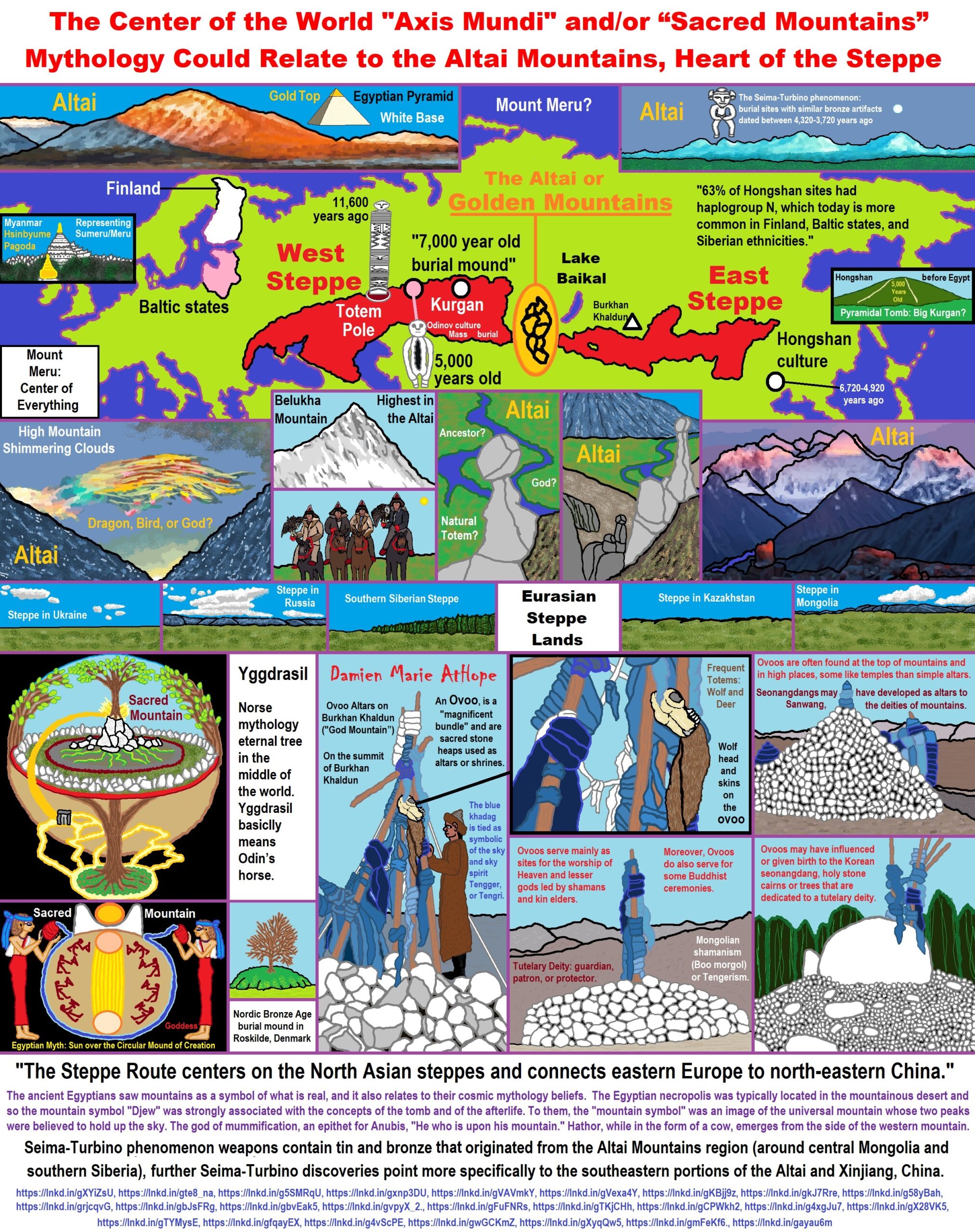
ref, ref, ref, ref, ref, ref, ref, ref, ref, ref, ref, ref, ref, ref, ref, ref, ref, ref, ref, ref, ref, ref, ref, ref, ref, ref, ref, ref, ref, ref, ref, ref, ref
Axis Mundi
“In astronomy, axis mundi is the Latin term for the axis of Earth between the celestial poles. In a geocentric coordinate system, this is the axis of rotation of the celestial sphere. Consequently, in ancient Greco-Roman astronomy, the axis mundi is the axis of rotation of the planetary spheres within the classical geocentric model of the cosmos. In 20th-century comparative mythology, the term axis mundi – also called the cosmic axis, world axis, world pillar, the center of the world, or world tree – has been greatly extended to refer to any mythological concept representing “the connection between Heaven and Earth” or the “higher and lower realms.” ref
“Mircea Eliade introduced the concept in the 1950s. Axis mundi closely relates to the mythological concept of the omphalos (navel) of the world or cosmos. Items adduced as examples of the axis mundi by comparative mythologists include plants (notably a tree but also other types of plants such as a vine or stalk), a mountain, a column of smoke or fire, or a product of human manufacture (such as a staff, a tower, a ladder, a staircase, a maypole, a cross, a steeple, a rope, a totem pole, a pillar, a spire). Its proximity to heaven may carry implications that are chiefly religious (pagoda, temple mount, minaret, church) or secular (obelisk, lighthouse, rocket, skyscraper). The image appears in religious and secular contexts. The axis mundi symbol may be found in cultures utilizing shamanic practices or animist belief systems, in major world religions, and in technologically advanced “urban centers”. In Mircea Eliade‘s opinion: “Every Microcosm, every inhabited region, has a Centre; that is to say, a place that is sacred above all.” ref
“There are multiple interpretations about the origin of the concept of the axis mundi. One psychological and sociological interpretation suggests that the symbol originates in a natural and universal psychological perception – i.e., that the particular spot that one occupies stands at “the center of the world”. This space serves as a microcosm of order because it is known and settled. Outside the boundaries of the microcosm lie foreign realms that – because they are unfamiliar or not ordered – represent chaos, death, or night. From the center, one may still venture in any of the four cardinal directions, make discoveries, and establish new centers as new realms become known and settled. The name of China — meaning “Middle Nation” (中国 pinyin: Zhōngguó) – is often interpreted as an expression of an ancient perception that the Chinese polity (or group of polities) occupied the center of the world, with other lands lying in various directions relative to it.” ref
“A second interpretation suggests that ancient symbols such as the axis mundi lie in a particular philosophical or metaphysical representation of a common and culturally shared philosophical concept, which is that of a natural reflection of the macrocosm (or existence at grand scale) in the microcosm (which consists of either an individual, community, or local environment that shares the same principles and structures as the macrocosm). In this metaphysical representation of the universe, mankind is placed into an existence that serves as a microcosm of the universe or the entire cosmic existence, and who – in order to achieve higher states of existence or liberation into the macrocosm – must gain necessary insights into universal principles that can be represented by his life or environment in the microcosm. In many religious and philosophical traditions around the world, mankind is seen as a sort of bridge between either: two worlds, the earthly and the heavenly (as in Hindu, and Taoist philosophical and theological systems); or three worlds, namely the earthly, heavenly, and the “sub-earthly” or “infra-earthly” (e.g., the underworld, as in the Ancient Greek, Incan, Mayan, and Ancient Egyptian religious systems). Spanning these philosophical systems is the belief that man traverses a sort of axis, or path, which can lead from man’s current central position in the intermediate realms into heavenly or sub-earthly realms. Thus, in this view, symbolic representations of a vertical axis represent a path of “ascent” or “descent” into other spiritual or material realms, and often capture a philosophy that considers human life to be a quest in which one develops insights or perfections in order to move beyond this current microcosmic realm and to engage with the grand macrocosmic order.” ref
“In other interpretations, an axis mundi is more broadly defined as a place of connection between heavenly and the earthly realms – often a mountain or other elevated site. Tall mountains are often regarded as sacred and some have shrines erected at the summit or base. Mount Kunlun fills a similar role in China. Mount Kailash is holy to Hinduism and several religions in Tibet. The Pitjantjatjara people in central Australia consider Uluru to be central to both their world and culture. The Teide volcano was for the Canarian aborigines (Guanches) a kind of axis mundi. In ancient Mesopotamia, the cultures of ancient Sumer and Babylon built tall platforms, or ziggurats, to elevate temples on the flat river plain. Hindu temples in India are often situated on high mountains – e.g., Amarnath, Tirupati, Vaishno Devi, etc. The pre-Columbian residents of Teotihuacán in Mexico erected huge pyramids, featuring staircases leading to heaven. These Amerindian temples were often placed on top of caves or subterranean springs, which were thought to be openings to the underworld. Jacob’s Ladder is an axis mundi image, as is the Temple Mount. For Christians, the Cross on Mount Calvary expresses this symbol. The Middle Kingdom, China, had a central mountain, Kunlun, known in Taoist literature as “the mountain at the middle of the world”. To “go into the mountains” meant to dedicate oneself to a spiritual life.” ref
“As the abstract concept of axis mundi is present in many cultural traditions and religious beliefs, it can be thought to exist in any number of locales at once. Mount Hermon was regarded as the axis mundi in Canaanite tradition, from where the sons of God are introduced descending in 1 Enoch 6:6. The ancient Armenians had a number of holy sites, the most important of which was Mount Ararat, which was thought to be the home of the gods as well as the center of the universe. Likewise, the ancient Greeks regarded several sites as places of Earth’s omphalos (navel) stone, notably the oracle at Delphi, while still maintaining a belief in a cosmic world tree and in Mount Olympus as the abode of the gods. Judaism has the Temple Mount; Christianity has the Mount of Olives and Calvary; and Islam has the Ka’aba (said to be the first building on Earth), as well as the Temple Mount (Dome of the Rock). In Hinduism, Mount Kailash is identified with the mythical Mount Meru and regarded as the home of Shiva; in Vajrayana Buddhism, Mount Kailash is recognized as the most sacred place where all the dragon currents converge and is regarded as the gateway to Shambhala. In Shinto, the Ise Shrine is the omphalos.” ref
“Sacred places can constitute world centers (omphaloi), with an altar or place of prayer as the axis. Altars, incense sticks, candles, and torches form the axis by sending a column of smoke, and prayer, toward heaven. It has been suggested by Romanian religious historian Mircea Eliade that architecture of sacred places often reflects this role: “Every temple or palace – and by extension, every sacred city or royal residence – is a Sacred Mountain, thus becoming a Centre.” Pagoda structures in Asian temples take the form of a stairway linking earth and heaven. A steeple in a church or a minaret in a mosque also serve as connections of earth and heaven. Structures such as the maypole, derived from the Saxons‘ Irminsul, and the totem pole among indigenous peoples of the Americas also represent world axes. The calumet, or sacred pipe, represents a column of smoke (the soul) rising from a world center. A mandala creates a world center within the boundaries of its two-dimensional space analogous to that created in three-dimensional space by a shrine. In the classical elements and the Vedic Pancha Bhoota, the axis mundi corresponds to Aether, the quintessence.” ref
“A common shamanic concept, and a universally told story, is that of the healer traversing the axis mundi to bring back knowledge from the other world. It may be seen in the stories from Odin and the World Ash Tree to the Garden of Eden and Jacob’s Ladder to Jack and the Beanstalk and Rapunzel. It is the essence of the journey described in The Divine Comedy by Dante Alighieri. The epic poem relates its hero’s descent and ascent through a series of spiral structures that take him through the core of the earth, from the depths of hell to celestial paradise. It is also a central tenet in the Southeastern Ceremonial Complex. Anyone or anything suspended on the axis between heaven and earth becomes a repository of potential knowledge. A special status accrues to the thing suspended: a serpent, a rod, a fruit, mistletoe. Derivations of this idea find form in the Rod of Asclepius, an emblem of the medical profession, and in the caduceus, an emblem of correspondence and commercial professions. The staff in these emblems represents the axis mundi, while the serpents act as guardians of, or guides to, knowledge.” ref
“Secular structures can also function as axes mundi. In Navajo culture, the hogan acts as a symbolic cosmic center. In some Asian cultures, houses were traditionally laid out in the form of a square oriented toward the four compass directions. A traditional home was oriented toward the sky through feng shui, a system of geomancy, just as a palace would be. Traditional Arab houses are also laid out as a square surrounding a central fountain that evokes a primordial garden paradise. Mircea Eliade noted that “the symbolism of the pillar in [European] peasant houses likewise derives from the ‘symbolic field’ of the axis mundi. In many archaic dwellings, the central pillar does in fact serve as a means of communication with the heavens, with the sky.” The nomadic peoples of Mongolia and the Americas more often lived in circular structures. The central pole of the tent still operated as an axis, but a fixed reference to the four compass points was avoided.” ref
“Plants often serve as images of the axis mundi. The image of the Cosmic Tree provides an axis symbol that unites three planes: sky (branches), earth (trunk), and underworld (roots). In some Pacific Island cultures, the banyan tree – of which the Bodhi tree is of the Sacred Fig variety – is the abode of ancestor spirits. In the Hindu religion, the banyan tree is considered sacred and is called ashwath vriksha (“Of all trees I am the banyan tree” – Bhagavad Gita). It represents eternal life because of its seemingly ever-expanding branches. The Bodhi tree is also the name given to the tree under which Gautama Siddhartha, the historical Buddha, sat on the night he attained enlightenment.” ref
“The Mesoamerican world tree connects the planes of the underworld and the sky with that of the terrestrial realm. The Yggdrasil, or World Ash, functions in much the same way in Norse mythology; it is the site where Odin found enlightenment. Other examples include Jievaras in Lithuanian mythology and Thor’s Oak in the myths of the pre-Christian Germanic peoples. The Tree of Life and the Tree of Knowledge of Good and Evil in Genesis present two aspects of the same image. Each is said to stand at the center of the paradise garden from which four rivers flow to nourish the whole world. Each tree confers a boon. Bamboo, the plant from which Asian calligraphy pens are made, represents knowledge and is regularly found on Asian college campuses. The Christmas tree, which can be traced in its origins back to pre-Christian European beliefs, represents an axis mundi. In Yoruba religion, oil palm is the axis mundi (though not necessarily a “world tree”) that Ọrunmila climbs to alternate between heaven and earth.” ref
“The human body can express the symbol of the world axis. Some of the more abstract Tree of Life representations, such as the sefirot in Kabbalism and the chakra system recognized by Hinduism and Buddhism, merge with the concept of the human body as a pillar between heaven and earth. Disciplines such as yoga and tai chi begin from the premise of the human body as axis mundi. The Buddha represents a world center in human form. Large statues of a meditating figure unite the human form with the symbolism of the temple and tower. Astrology in all its forms assumes a connection between human health and affairs and celestial-body orientation. World religions regard the body itself as a temple and prayer as a column uniting earth and heaven. The ancient Colossus of Rhodes combined the role of the human figure with those of portal and skyscraper. The Renaissance image known as the Vitruvian Man represented a symbolic and mathematical exploration of the human form as world axis.” ref
The Center of the World “Axis Mundi” and/or “Sacred Mountains” Mythology Could Relate to the Altai Mountains, Heart of the Steppe
“Golden Mountains of Altai is the name of the Altai and Katun Natural Reserves, Lake Teletskoye, Belukha Mountain, and the Ukok Plateau. The region represents the most complete sequence of altitudinal vegetation zones in central Siberia, from steppe, forest-steppe, mixed forest, subalpine vegetation to alpine vegetation”. The Altai region is made up of four primary sites and landscapes: Mount Belukha, the Ukok Plateau, the Katun River, and the Karakol Valley. Mount Beluka is regarded as a sacred site to Buddhists and the Burkhanist. Their myths surrounding this portion of the mountain range lent credence to their claim that it was the location of Shangri-la (Shambala). The Ukok Plateau is an ancient burial site of the early Siberian people. Moreover, a number of myths are connected to this portion of the Golden Mountains. For example, the plateau was thought to have been the Elysian fields. The Katun River is an important religious location to the Altaians where they (during celebrations) utilize ancient ecological knowledge to restore and maintain the river. The Karakol Valley is home of three indigenous villages where tourism is greatly managed. While the Golden Mountains of Altai are listed on the World Heritage List under natural criteria, it holds information about the nomadic Scythian culture. The permafrost in these mountains has preserved Scythian burial mounds. These frozen tombs, or kurgans, hold metal objects, pieces of gold, mummified bodies, tattooed bodies, sacrificed horses, wood/leather objects, clothes, textiles, etc. However, the Ukok Plateau (in the Altai Mountains) is a sacred site to the Altai people, so archeologists and scholars who are looking to excavate the site for human remains raise controversy.” ref
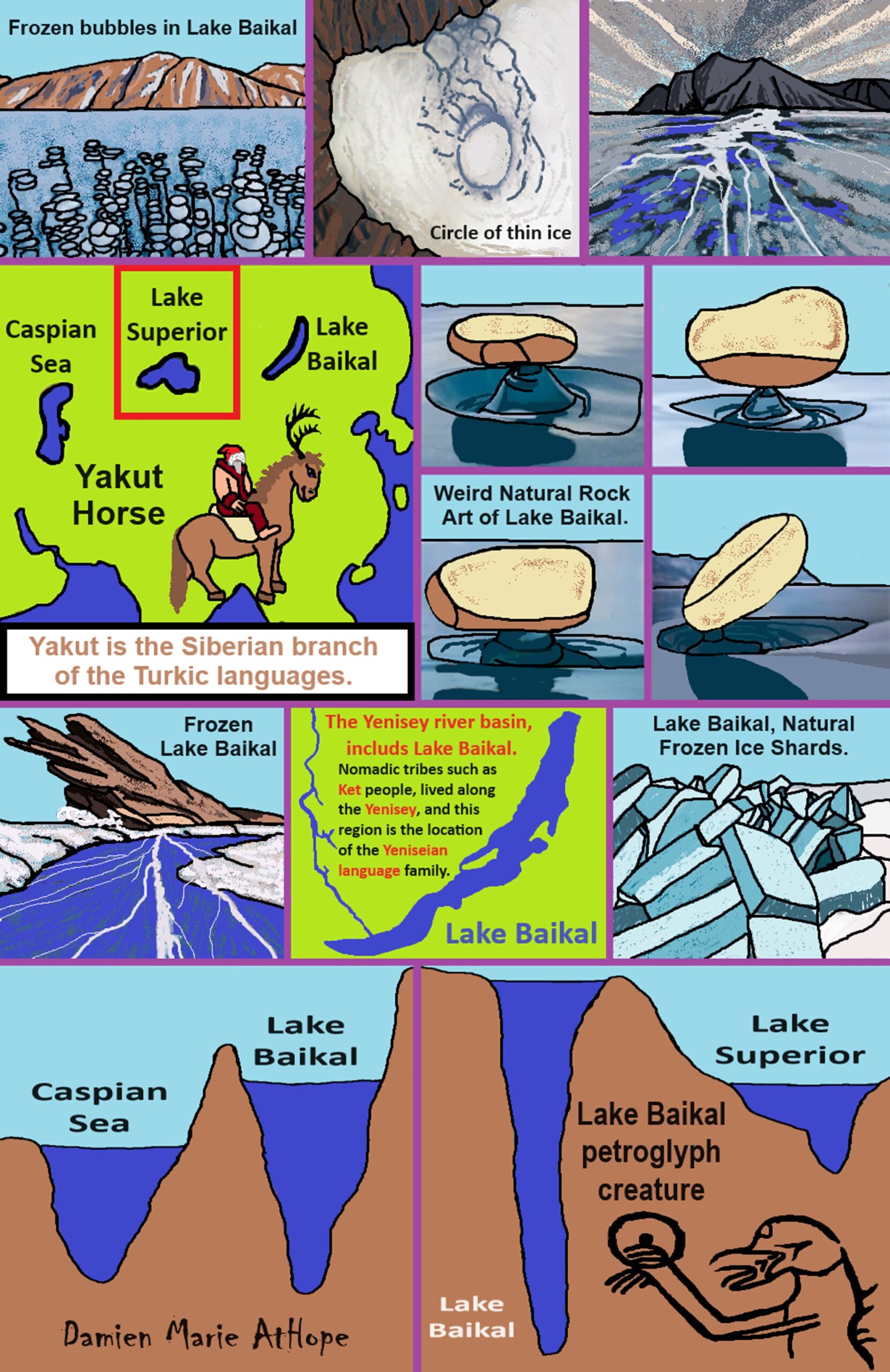
ref, ref, ref, ref, ref, ref, ref, ref, ref, ref, ref, ref, ref, ref
People reached Lake Baikal Siberia around 25,000 years ago. They (to Damien) were likely Animistic Shamanists who were also heavily totemistic as well. Being animistic thinkers they likely viewed amazing things in nature as a part of or related to something supernatural/spiritual (not just natural as explained by science): spirit-filled, a sprit-being relates to or with it, it is a sprit-being, it is a supernatural/spiritual creature, or it is a great spirit/tutelary deity/goddess-god. From there comes mythology and faith in things not seen but are believed to somehow relate or interact with this “real world” we know exists.
Both areas of Lake Baikal, one on the west side with Ancient North Eurasian culture and one on the east side with Ancient Northern East Asian culture (later to become: Ancient Northeast Asian culture) areas are the connected areas that (to Damien) are the origin ancestry religion area for many mythologies and religious ideas of the world by means of a few main migrations and many smaller ones leading to a distribution of religious ideas that even though are vast in distance are commonly related to and centering on Lake Baikal and its surrounding areas like the Amur region and Altai Mountains region.
To an Animistic Thinker: “Things are not just as they seem, they may have a spirit, or spirit energy relates to them”
To a Totemistic Thinker: “Things are not just as they seem, they may have a spirit, or spirit energy relates to them; they may have religio-cultural importance.”
“Lakes are often mysterious bodies of water, especially if they are very deep or surrounded by mountains. No wonder legends and mysteries thrive about them, including monsters that supposedly lurk in their bottomless depths.” ref
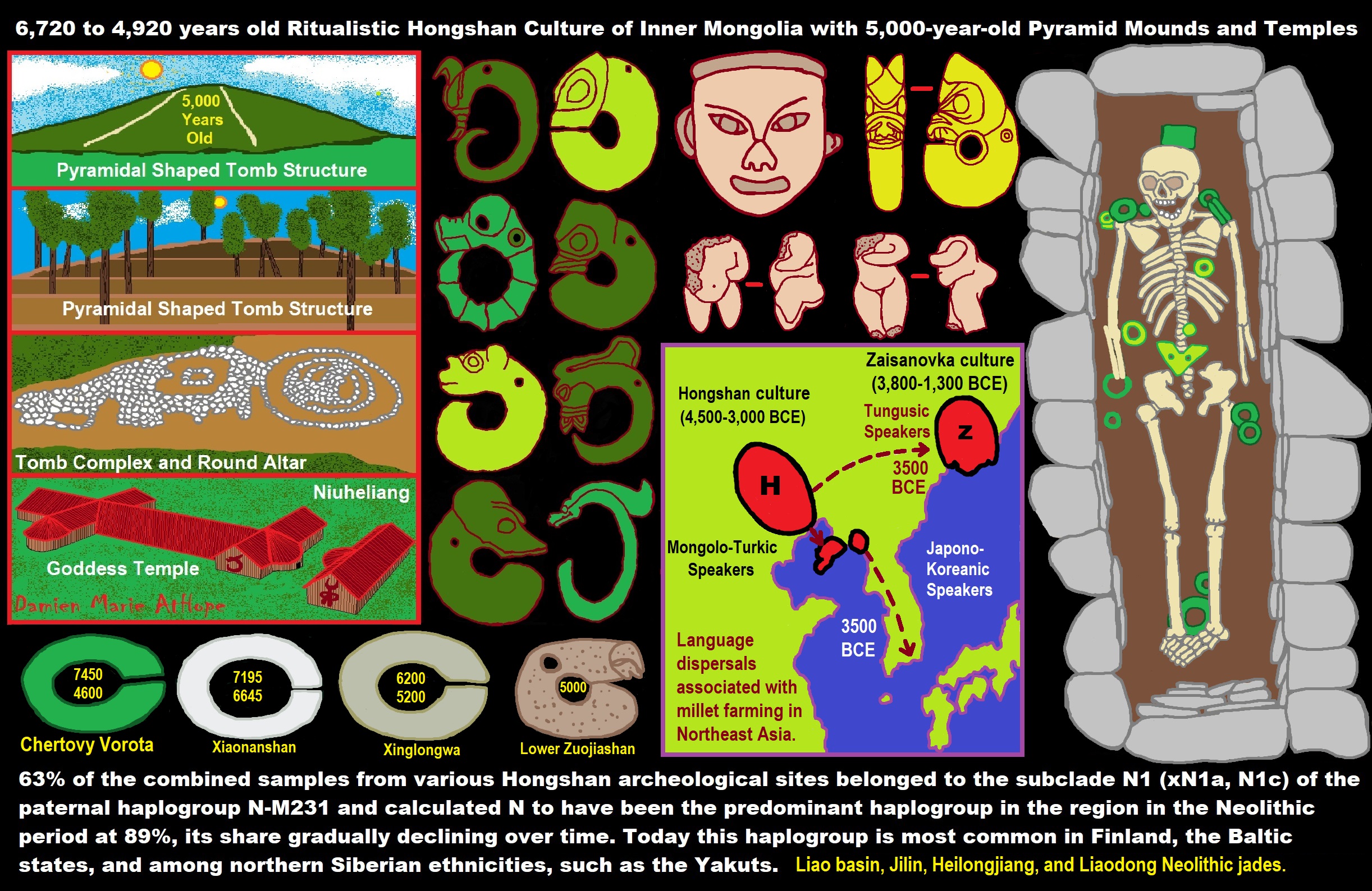
ref, ref, ref, ref, ref, ref, ref, ref, ref, ref, ref, ref, ref, ref, ref, ref, ref
- Millet agriculture dispersed from Northeast China to the Russian Far East: Integrating archaeology, genetics, and linguistics
- Language dispersals associated with millet farming in Neolithic Northeast Asia: “Hongshan Neolithic Culture”
- The Development of Complexity in Prehistoric Northern China: “Hongshan Neolithic Culture”
- Hongshan Neolithic Culture of China
- 5,000-year-old “Pyramid” Found in Inner Mongolia
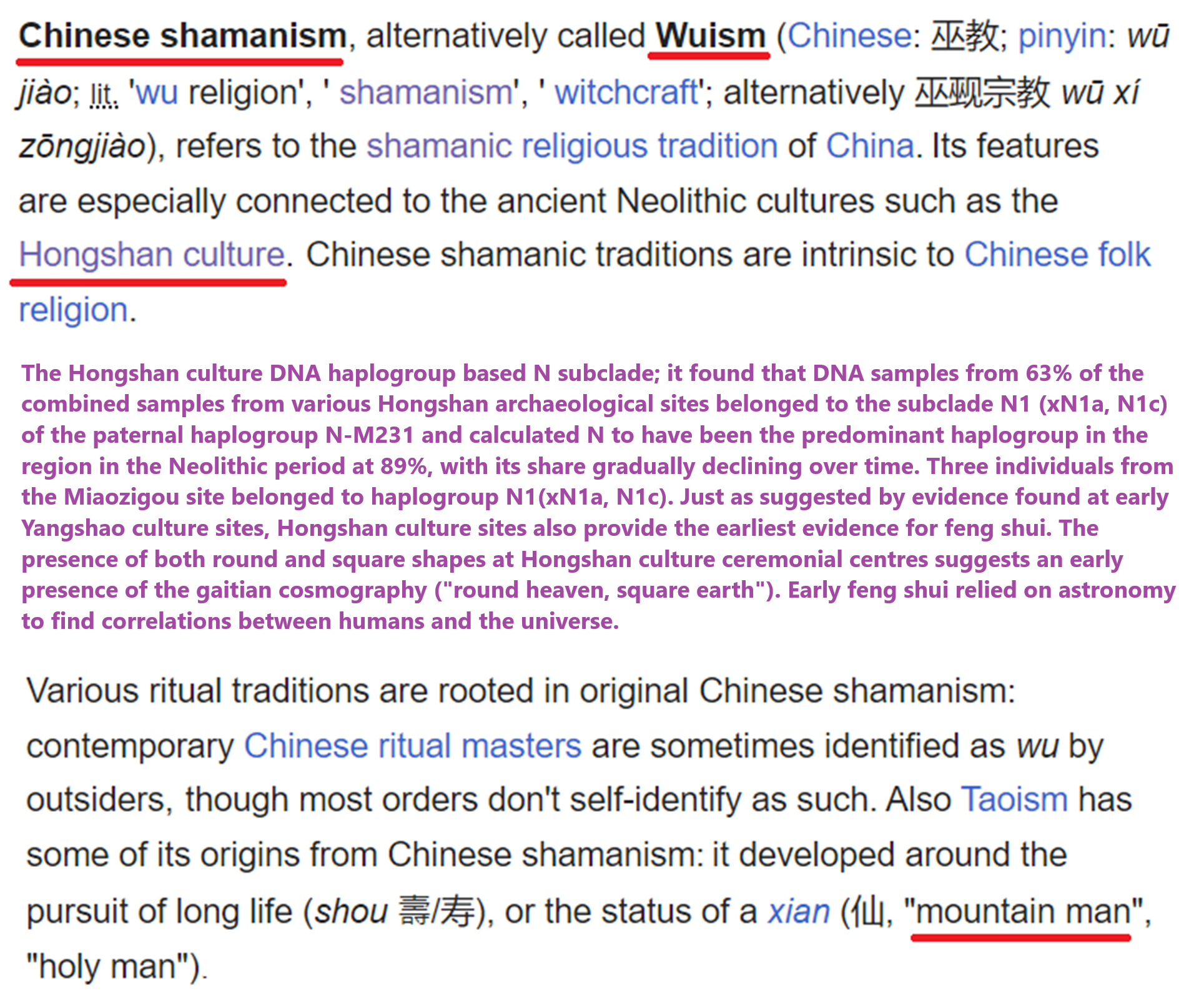
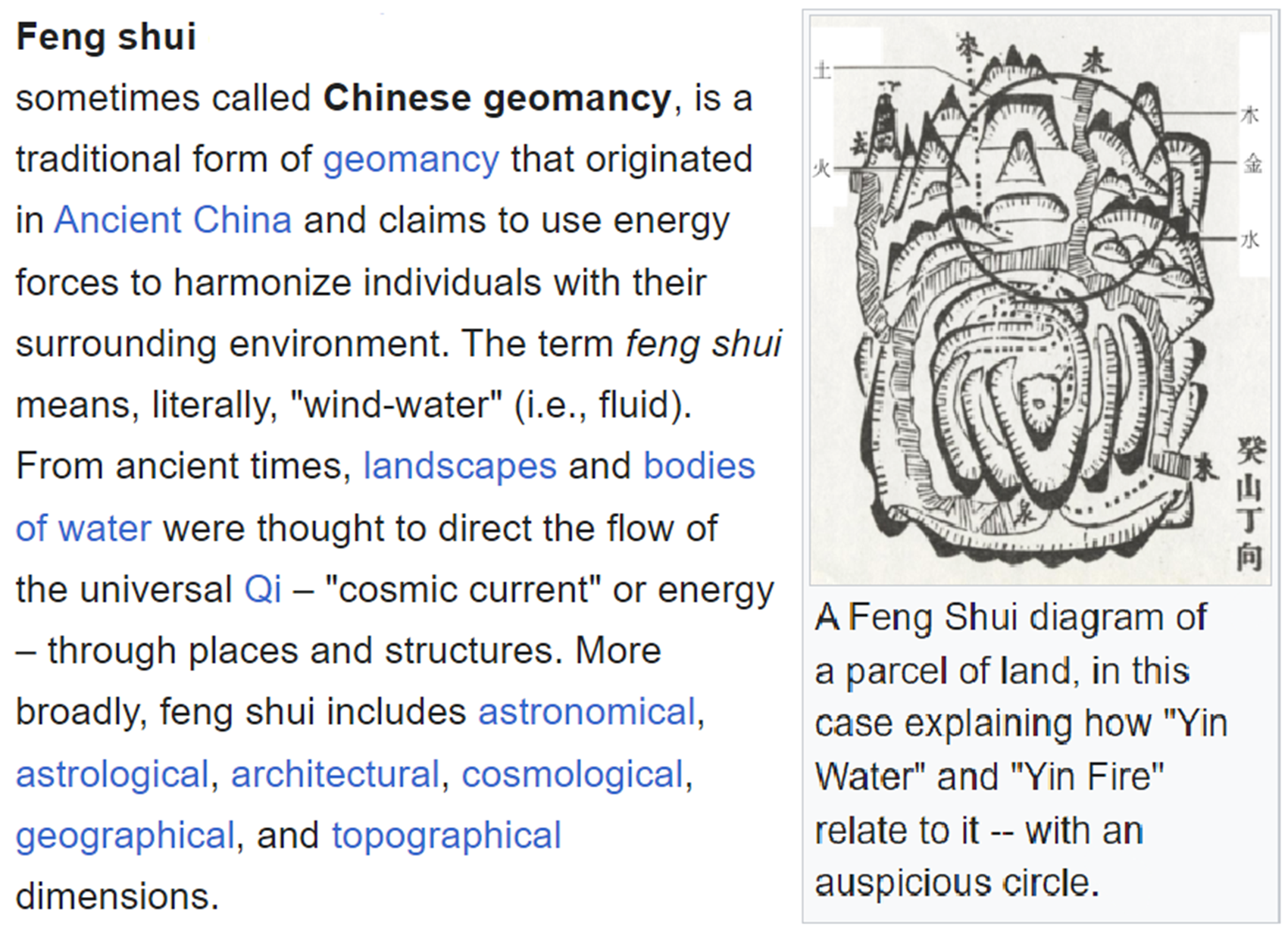
“The Yangshao and Hongshan cultures provide the earliest known evidence for the use of feng shui. Until the invention of the magnetic compass, feng shui relied on astronomy to find correlations between humans and the universe. In 4000 BCE, the doors of dwellings in Banpo were aligned with the asterism Yingshi just after the winter solstice—this sited the homes for solar gain. During the Zhou era, Yingshi was known as Ding and it was used to indicate the appropriate time to build a capital city, according to the Shijing. The late Yangshao site at Dadiwan (c. 3500–3000 BCE) includes a palace-like building (F901) at its center. The building faces south and borders a large plaza. It stands on a north–south axis with another building that apparently housed communal activities. Regional communities may have used the complex.” ref
“A grave at Puyang (around 4000 BCE) that contains mosaics— a Chinese star map of the Dragon and Tiger asterisms and Beidou (the Big Dipper, Ladle or Bushel)— is oriented along a north–south axis. The presence of both round and square shapes in the Puyang tomb, at Hongshan ceremonial centers and at the late Longshan settlement at Lutaigang, suggests that gaitian cosmography (heaven-round, earth-square) existed in Chinese society long before it appeared in the Zhoubi Suanjing. Cosmography that bears a resemblance to modern feng shui devices and formulas appears on a piece of jade unearthed at Hanshan and dated around 3000 BCE. Archaeologist Li Xueqin links the design to the liuren astrolabe, zhinan zhen and luopan.” ref
“Some of the foundations of feng shui go back more than 3,500 years before the invention of the magnetic compass. It originated in Chinese astronomy. Some current techniques can be traced to Neolithic China, while others were added later (most notably the Han dynasty, the Tang, the Song, and the Ming). Beginning with palatial structures at Erlitou, all capital cities of China followed rules of feng shui for their design and layout. During the Zhou era, the Kaogong ji (Chinese: 考工記; “Manual of Crafts”) codified these rules. The carpenter’s manual Lu ban jing (魯班經; “Lu ban’s manuscript”) codified rules for builders. Graves and tombs also followed rules of feng shui from Puyang to Mawangdui and beyond. From the earliest records, the structures of the graves and dwellings seem to have followed the same rules.” ref
“Feng shui views good and bad fortune as tangible elements that can be managed through predictable and consistent rules. This involves the management of qi, an imagined form of cosmic “energy.” In situating the local environment to maximize good qi, one can optimize their own good fortune. Feng shui holds that one’s external environment can affect one’s internal state. A goal of the practice is to achieve a “perfect spot”, a location and an axis in time that can help one achieve a state of shū fú (舒服) or harmony with the universe. Traditional feng shui is inherently a form of ancestor worship. Popular in farming communities for centuries, it was built on the idea that the ghosts of ancestors and other independent, intangible forces, both personal and impersonal, affected the material world, and that these forces needed to be placated through rites and suitable burial places. For a fee, a Feng shui practitioner would identify suitable locations for the living and the dead to achieve shū fú. The primary underlying value was material success for the living.” ref
“Traditional feng shui is an ancient system based upon the observation of heavenly time and earthly space. Literature, as well as archaeological evidence, provide some idea of the origins and nature of feng shui techniques. Aside from books, there is also a strong oral history. In many cases, masters have passed on their techniques only to selected students or relatives. Modern practitioners of feng shui draw from several branches in their own practices. The Form Branch is the oldest branch of feng shui. Qing Wuzi in the Han dynasty describes it in the Book of the Tomb and Guo Pu of the Jin dynasty follows up with a more complete description in The Book of Burial.” ref
“The Form branch was originally concerned with the location and orientation of tombs (Yin House feng shui), which was of great importance. The branch then progressed to the consideration of homes and other buildings (Yang House feng shui). The “form” in Form branch refers to the shape of the environment, such as mountains, rivers, plateaus, buildings, and general surroundings. It considers the five celestial animals (vermillion phoenix, azure dragon, white tiger, black turtle, and the yellow snake), the yin-yang concept and the traditional five elements (Wu Xing: wood, fire, earth, metal, and water). The Form branch analyzes the shape of the land and flow of the wind and water to find a place with ideal qi. It also considers the time of important events such as the birth of the resident and the building of the structure.” ref
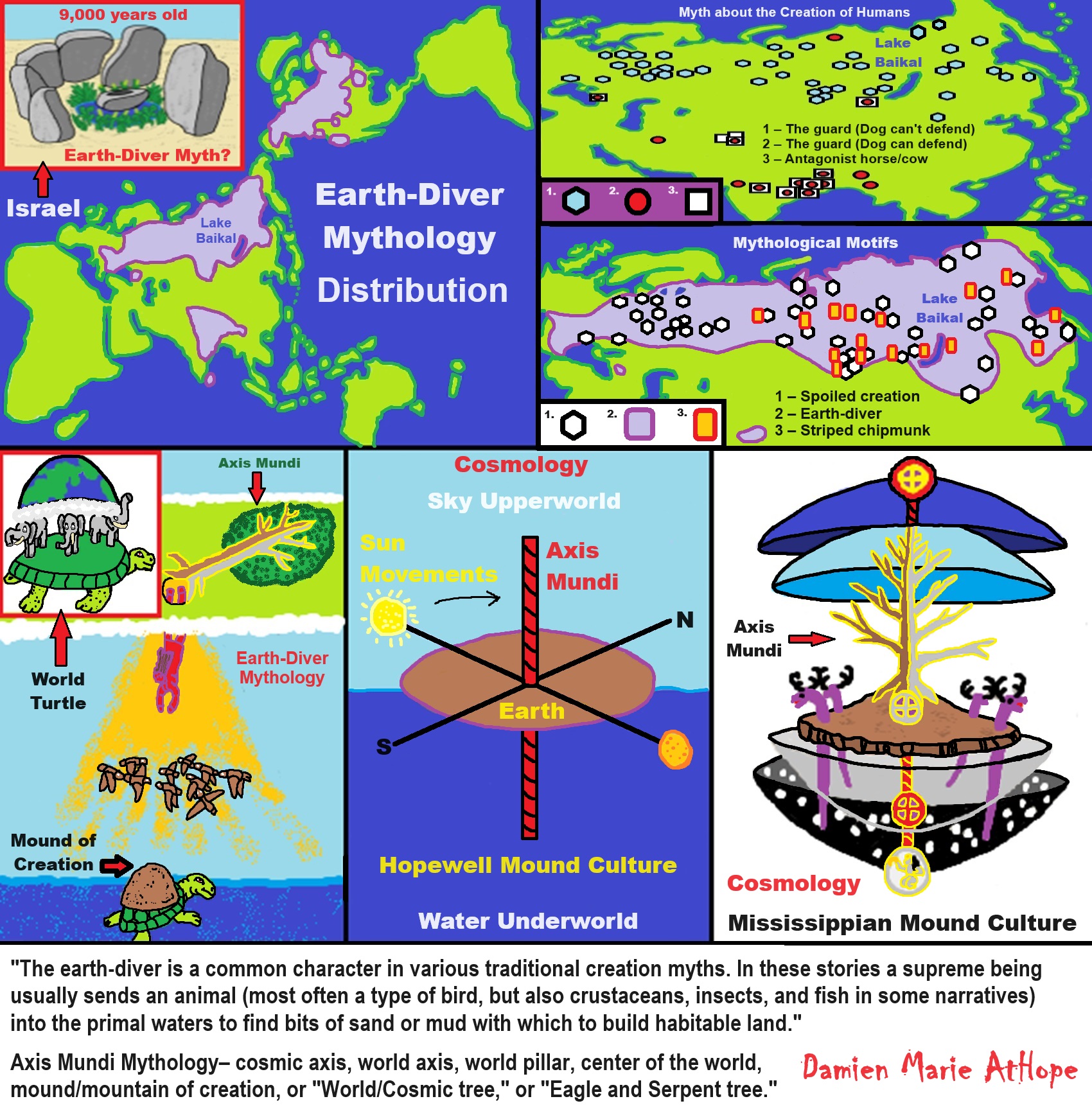
ref, ref, ref, ref, ref, ref, ref, ref, ref, ref, ref
“The earth-diver is a common character in various traditional creation myths. In these stories, a supreme being usually sends an animal (most often a type of bird, but also crustaceans, insects, and fish in some narratives) into the primal waters to find bits of sand or mud with which to build habitable land.” ref
Axis Mundi Mythology– cosmic axis, world axis, world pillar, center of the world, mound/mountain of creation, or “World/Cosmic tree,” or “Eagle and Serpent tree.” ref, ref
“The World Turtle, also called the Cosmic Turtle or the World-bearing Turtle, is a mytheme of a giant turtle (or tortoise) supporting or containing the world. It occurs in Hindu mythology, Chinese mythology, and the mythologies of some of the indigenous peoples of the Americas.” ref
“Chucalissa, Mississippian culture Mounds in Memphis, art shows all the elements involved in the Path of Souls death journey, a widely held belief system among the mound builders of America.” ref
“Interpretation of southeastern Native cosmology, showing the tripartite division of the world. The axis mundi is depicted as a tree or post connecting the fire symbol of this world, the sun symbol of the upper world, and the ‘swastika’ symbol of the lower world.” ref
“It should be remembered that the Mississippian culture that built Cahokia may have considered a cedar tree or a striped cedar pole to be a symbol of the Axis Mundi (also called the cosmic axis, world axis, world pillar, the center of the world, or world tree – has been greatly extended to refer to any mythological concept representing “the connection between Heaven and Earth” or the “higher and lower realms), the pillar connecting the above, middle, & below worlds, & around which the cosmos turns An American Yggdrasil (Norse tree of life). Some work has gone into reconstructing the woodhenge, and it is one of the sites around Cahokia that you can visit today. (The Solar Calendar of Woodhenge in Cahokia | Native America: Cities of the Sky).” – Vulpine Outlaw @Rad_Sherwoodism
“Items adduced as examples of the axis mundi by comparative mythologists include plants (notably a tree but also other types of plants such as a vine or stalk), a mountain, a column of smoke or fire, or a product of human manufacture (such as a staff, a tower, a ladder, a staircase, a maypole, a cross, a steeple, a rope, a totem pole, a pillar, a spire). Its proximity to heaven may carry implications that are chiefly religious (pagoda, temple mount, minaret, church) or secular (obelisk, lighthouse, rocket, skyscraper). The image appears in religious and secular contexts. The axis mundi symbol may be found in cultures utilizing shamanic practices or animist belief systems, in major world religions, and in technologically advanced “urban centers.” ref
Do we know what the symbols represent?
“Yes. It’s a bit more than I’d want to post on TwiX right now. It’s showing the 3-part universe, an upper, lower, and middle world, & the Milky Way is shown as well as Orion the Hand Constellation, Scorpius the ruler of the underworld, and Cygnus, the Judge. Also the main powers of the upper & lower worlds.” – Gregory L Little, Ed.D. @DrGregLittle2
Gregory L Little, Ed.D. BA/MS Psychology, Ed.D. Counseling/Ed. Psych Author since ’84 (70+ books/workbooks). Mound Builder Society: Be Kind; Respect Everything; Honor the Ancient Ones.
EVIDENCE FOR STEPPED PYRAMIDS OF SHELL IN THE WOODLAND PERIOD OF EASTERN NORTH AMERICA
FOLKLORE PARALLELS BETWEEN SIBERIA AND SOUTH ASIA AND THE MYTHOLOGY OF THE EURASIAN STEPPES*
“According to the myth about the origin of man recorded among the people of Eastern Europe and Siberia, the creator set a dog to guard the half-made human figures, but the antagonist bribed the guard and spoiled the creation, making humans vulnerable to disease. The creator told the dog to become the servant of man. Texts recorded in India (mostly among the Munda-speaking groups), the Dards of the Hindu Kush and the Abkhasians, though partly similar to the Northern Eurasian ones, do not share some important details: the antagonist is a horse, it tried to destroy man but a dog drove it away. In the Mongolian (more precisely, the Oirat) version, a cow acts instead of a horse, but in other respects, this variant is similar to the Abkhasian ones. Negative associations related to the horse are rather widespread
in Europe and Central Asia. Stories about the creation of man recorded in northern and southern Eurasia stemmed from the anthropogenic myth that was known to the Indo-Europeans of the Bronze Age. South Asia and the European–Siberian zone also share other tales, in particular the Earth-diver myth. Their analysis opens possibilities for reconstructing the early mythology of the inhabitants of the Eurasian steppe.” ref
Comparative Mythology
“Since the term ‘Ancient North Eurasian’ refers to a genetic bridge of connected mating networks, scholars of comparative mythology have argued that they probably shared myths and beliefs that could be reconstructed via the comparison of stories attested within cultures that were not in contact for millennia and stretched from the Pontic–Caspian steppe to the American continent. The mytheme of the dog guarding the Otherworld possibly stems from an older Ancient North Eurasian belief, as suggested by similar motifs found in Indo-European, Native American and Siberian mythology. In Siouan, Algonquian, Iroquoian, and in Central and South American beliefs, a fierce guard dog was located in the Milky Way, perceived as the path of souls in the afterlife, and getting past it was a test.” ref
“The Siberian Chukchi and Tungus believed in a guardian-of-the-afterlife dog and a spirit dog that would absorb the dead man’s soul and act as a guide in the afterlife. In Indo-European myths, the figure of the dog is embodied by Cerberus, Sarvarā, and Garmr. In Zoroastrianism, two four-eyed dogs guard the bridge to the afterlife called Chinvat Bridge. Anthony and Brown note that it might be one of the oldest mythemes recoverable through comparative mythology.” ref
“A second canid-related series of beliefs, myths and rituals connected dogs with healing rather than death. For instance, Ancient Near Eastern and Turkic–Kipchaq myths are prone to associate dogs with healing and generally categorised dogs as impure. A similar myth-pattern is assumed for the Eneolithic site of Botai in Kazakhstan, dated to 3500 BC, which might represent the dog as absorber of illness and guardian of the household against disease and evil. In Mesopotamia, the goddess Nintinugga, associated with healing, was accompanied or symbolized by dogs. Similar absorbent-puppy healing and sacrifice rituals were practiced in Greece and Italy, among the Hittites, again possibly influenced by Near Eastern traditions.” ref
Earth-diver myth
(creation myth or cosmogonic myth, which is a type of cosmogony,
a symbolic narrative of how the world began and how people first came to inhabit it.)
“The earth-diver is a common character in various traditional creation myths. In these stories, a supreme being usually sends an animal (most often a type of bird, but also crustaceans, insects, and fish in some narratives) into the primal waters to find bits of sand or mud with which to build habitable land. Some scholars interpret these myths psychologically while others interpret them cosmogonically. In both cases, emphasis is placed on beginnings emanating from the depths.” ref
“According to Gudmund Hatt and Tristram P. Coffin, Earth-diver myths are common in Native American folklore, among the following populations: Shoshone, Meskwaki, Blackfoot, Chipewyan, Newettee, Yokuts of California, Mandan, Hidatsa, Cheyenne, Arapaho, Ojibwe, Yuchi, and Cherokee. American anthropologist Gladys Reichard located the distribution of the motif across “all parts of North America”, save for “the extreme north, northeast, and southwest.” ref
“In a 1977 study, anthropologist Victor Barnouw surmised that the earth-diver motif appeared in “hunting-gathering societies“, mainly among northerly groups such as the Hare, Dogrib, Kaska, Beaver, Carrier, Chipewyan, Sarsi, Cree, and Montagnais. Similar tales are also found among the Chukchi and Yukaghir, the Tatars, and many Finno-Ugric traditions, as well as among the Buryat and the Samoyed. In addition, the earth-diver motif also exists in narratives from Eastern Europe, namely Romani, Romanian, Slavic (namely, Bulgarian, Polish, Ukrainian, and Belarusian), and Lithuanian mythological traditions.” ref
“The pattern of distribution of these stories suggest they have a common origin in the eastern Asiatic coastal region, spreading as peoples migrated west into Siberia and east to the North American continent. However, there are examples of this mytheme found well outside of this boreal distribution pattern, for example the West African Yoruba creation myth of Ọbatala and Oduduwa. Characteristic of many Native American myths, earth-diver creation stories begin as beings and potential forms linger asleep or suspended in the primordial realm. The earth-diver is among the first of them to awaken and lay the necessary groundwork by building suitable lands where the coming creation will be able to live. In many cases, these stories will describe a series of failed attempts to make land before the solution is found.” ref
“Among the indigenous peoples of the Americas, the earth-diver cosmogony is attested in Iroquois mythology: a female sky deity falls from the heavens, and certain animals, the beaver, the otter, the duck, and the muskrat dive in the waters to fetch mud to construct an island. In a similar story from the Seneca, people lived in a sky realm. One day, the chief’s daughter was afflicted with a mysterious illness, and the only cure recommended for her (revealed in a dream) was to lie beside a tree and to have it be dug up. The people do so, but a man complains that the tree was their livelihood, and kicks the girl through the hole. She ends up falling from the sky to a world of only water, but is rescued by waterfowl.” ref
“A turtle offers to bear her on its shell, but asked where would be a definitive dwelling place for her. They decide to create land, and the toad dives into the depths of the primal sea to get pieces of soil. The toad puts it on the turtle’s back, which grows larger with every deposit of soil. In another version from the Wyandot, the Wyandot lived in heaven. The daughter of the Big Chief (or Mighty Ruler) was sick, so the medicine man recommends that they dig up the wild apple tree that stands next to the Lodge of the Mighty Ruler, because the remedy is to be found on its roots.” ref
“However, as the tree has been dug out, the ground begins to sink away, and the treetops catch and carry down the sick daughter with it. As the girl falls from the skies, two swans rescue her on their backs. The birds decide to summon all the Swimmers and the Water Tribes. Many volunteer to dive into the Great Water to fetch bits of earth from the bottom of the sea, but only the toad (female, in the story) is the one successful.” ref
GENES AND MYTHS: ANCIENT MAL’TA DNA AND THE EARTH-DIVER MYTHOLOGICAL MOTIF
“Earth-Diver is one of the most widely-distributed and well-studied cosmological myths. Found in mostly Uralic-speaking Eastern Europe, in Siberia, in Munda-speaking Northeast India and North America, its action is set in post-diluvial times when a demiurge sends various creatures to bring a piece of mud from the bottom of the ocean. The first creature fails, but the second one succeeds. Importantly, it’s the least likely creature that succeeds, while the more obvious favorite fails. A loon is a much better diver than a duck but it’s the duck that succeeds. In the end, the demiurge blows the earth out of the tiny piece of mud and restores life on it. Depending on the region, the diving creatures are different – in Eurasia it’s waterfowl birds – loon and duck, in North America it’s amphibians such as turtle or frog, animals such as otter or beaver or waterbirds, in Northeast India and the American Southwest – it’s arthropods.” ref
“The Initial Stages of Evolution of Uralic-Speakers: Evidence from a Mythological Reconstruction (Proto-Uralic Cosmogonic Myth) have suggested that the Earth-Diver motif is the folkloric manifestation of a more comprehensive system of beliefs related to the experiences of a shamanic flight in Northern Eurasian and Amerindian cultures. Siberian shamans liken themselves to waterfowl birds flying between worlds in search of the soul of their patient and they manipulate waterfowl figurines during their shamanic seances. Remarkably, very similar figurines are found at the 24,000-year-old Mal’ta archaeological site in South Siberia (see one on the left made out of a mammoth tusk), and Napol’skikh, in his 1991 book as well as in a recent talk (see video in Russian, roughly from 11:40 on) proposed that the Mal’ta people possessed the “cult of a waterfowl” and told the Earth-Diver myth. This means that the Earth-Diver motif may go back to pre-LGM times.” ref
“Mal’ta has recently made headlines thanks to the sequencing of the genome of a 4-year-old boy found at this site. The DNA sample fell in-between West Eurasians and Amerindians, without any special connection to East Asians, and showed typical West Eurasian mtDNA and Y-DNA haplogroups, namely U and R, respectively. They are sister lineages of widely distributed in the Americas hg B (mtDNA) and hg Q (Y-DNA). It appears that, in pre-LGM times, Amerindians and West Eurasians formed a genetic continuum and that modern East Asians did not yet emerge as a distinct population. This finding may put the distribution of the Earth-Diver myth into a new perspective. Per Davidski’s request, German Dziebel adduce the map of the distribution of the Earth-Diver motif in Eurasia and North America (see the shaded areas on the left).” ref
“One should not expect a perfect fit between the distribution of myths and genes but the Earth-Diver distribution is rather clearly demarcated on a worldwide scale and does show continuity between West Eurasia and North America. The motif is notably absent from Western Europe – precisely the area that was covered with the glacier from 25,000 to 14,000 years ago – and from Beringia (Paleoasiatic peoples such as Chukchees and Koryaks as well as Eskimos don’t tell earth-diver stories), which may have been blocked by ice as well. Its presence in the Balkans is a due to relatively recent events such as Turkic and Avar migrations across the southern European steppe.” ref
“According to Napol’skikh’s motif phylogeny (on the left), the Earth-Diver myth has gone through 3 evolutionary stages – MNP-0, MNP-1 and MNP-2. At MNP-0, any creature (and any number of creatures) could become the demiurge’s helper as long as the least likely creature succeeded. At MNP-1, the plot crystallized around a pair of waterfowls in Siberia and Western North America and a pair of animals in Eastern North America. At MNP-3, one of the creatures dropped off and the demiurge used the help of only one helper. The “cladistics” of the myth is, therefore, rather simple: the dynamic and variable ancestral forms crystallize into progressively fewer characters.” ref
“As the detailed maps of motif and submotif distribution show, North America and Northern Eurasia share MNP-2 but then the rest of the variation is continent-specific. Eurasia has a number of clearly derived variants that are missing from the Americas, while America has a number variants not seen in Eurasia. Napol’skikh observes that stage MNP-0 is better represented in North America – the region that tends to have more archaic versions of the motif and more basal motif diversity (not just waterfowls, but animals, too; not just two creatures but many, etc.). Remarkably, the use of arthropods by the demiurge is a trait shared by Munda-speaking Northeast Indians (see the Berezkin map of Eurasia above) and the Muskogean-speaking Amerindians from the Southeast, both areas being the southernmost extremes of the Earth-Diver distribution. As the Mal’ta boy is re-writing the prehistory of Eurasia, opportunities are growing for cross-disciplinary integration that would tie together genes and culture into a coherent story.” ref
Folklore Parallels Between Siberia And South Asia And The Mythology Of The Eurasian Steppes
“According to the myth about the origin of man recorded among the people of Eastern Europe and Siberia, the creator set a dog to guard the half-made human figures, but the antagonist bribed the guard and spoiled the creation, making humans vulnerable to disease. The creator told the dog to become the servant of man. Texts recorded in India (mostly among the Munda-speaking groups), the Dards of the Hindu Kush and the Abkhasians, though partly similar to the Northern Eurasian ones, do not share some important details: the antagonist is a horse, it tried to destroy man but a dog drove it away. In the Mongolian (more precisely, the Oirat) version, a cow acts instead of a horse, but in other respects this variant is similar to the Abkhasian ones. Negative associations related to the horse are rather widespread in Europe and Central Asia. Stories about the creation of man recorded in northern and southern Eurasia stemmed from the anthropogenic myth that was known to the Indo-Europeans of the Bronze Age. South Asia and the European–Siberian zone also share other tales, in particular the Earth-diver myth. Their analysis opens possibilities for reconstructing the early mythology of the inhabitants of the Eurasian steppe.” ref
Diver-Myths
“Scientific evidence has shown that at one point parts of the earth that are now dry were covered by water. Many myths allude to this fact by imagining a world once covered by water. Many myths, called diver-myths (Long 188), consisted of a being diving into the water that covers the earth to retrieve some earth. The earth brought to the surface became the land we know today. Other stories had the mud brought to the surface in a different way, but many had the common element of some earth being brought to the surface of the water and growing until it became the Earth.” ref
“According to the Iroquois Native Americans water animals inhabited the Earth before there was land. When a Sky Woman fell from her home above they caught her and dove into the seas to bring up mud. This mud they spread onto the back of Big Turtle. There it began to grow until it became North America.” ref
“The Japanese creation myth painted a picture of a muddy ocean which covered the world at the beginning of time. A god and goddess, Izanagi and Izanami, became curious about what was beneath the ocean. Izanagi took his staff and threw it into the ocean. As he lifted it back up some lumps of earth fell off into the water. These became the islands of Japan. No being dove beneath the waters to find mud, but the element of earth being covered by water and a being bringing the earth up is there.” ref
“The creation myth of Christians and Jews does not tell of God diving into the water to bring up mud, but Genesis 1:2 says the Spirit of God was hovering over the waters. Therefore according to the Torah and Bible the Earth was once covered entirely by water.” ref
Power of Myths
“The most obvious function of myths is the explanation of facts, whether natural or cultural. One North American Indian (Abenaki) myth, for example, explains the origin of corn (maize): a lonely man meets a beautiful woman with long, fair hair; she promises to remain with him if he follows her instructions; she tells him in detail how to make a fire and, after he has done so, she orders him to drag her over the burned ground; as a result of these actions, he will see her silken hair (viz., the cornstalk) reappear, and thereafter he will have corn seeds for his use. Henceforth, whenever Abenaki Indians see corn (the woman’s hair), they know that she remembers them.” ref
“Obviously, a myth such as this one functions as an explanation, but the narrative form distinguishes it from a straightforward answer to an intellectual question about causes. The function of explanation and the narrative form go together, since the imaginative power of the myth lends credibility to the explanation and crystallizes it into a memorable and enduring form. Hence myths play an important part in many traditional systems of education. Many myths explain ritual and cultic customs. According to myths from the island of Ceram (in Indonesia), in the beginning life was not complete, or not yet “human”: vegetation and animals did not exist, and there was neither death nor sexuality. In a mysterious manner Hainuwele, a girl with extraordinary gift-bestowing powers, appeared.” ref
“The people killed her at the end of their great annual celebration, and her dismembered body was planted in the earth. Among the species that sprang up after this act of planting were tubers—the staple diet of the people telling the myth. With a certain circularity frequent in mythology, the myth validates the very cultic celebration mentioned in the myth. The cult can be understood as a commemoration of those first events. Hence, the myth can be said to validate life itself together with the cultic celebration. Comparable myths are told in a number of societies where the main means of food production is the cultivation of root crops; the myths reflect the fact that tubers must be cut up and buried in the earth for propagation to take place.” ref
“Ritual sacrifices are typical of traditional peasant cultures. In most cases such customs are related to mythical events. Among important themes are the necessity of death (e.g., the grain “dies” and is buried, only to yield a subsequent harvest), a society’s cyclic renewal of itself (e.g., New Year’s celebrations), and the significance of women and sexuality. New Year’s celebrations, often accompanied by a temporary abandonment of all rules, may be related to or justified by mythical themes concerning a return to chaos and a return of the dead.” ref
“In every mythological tradition one myth or cluster of myths tends to be central. The subject of the central mythology is often cosmogony (origin of the cosmos). In many of those ceremonies that each society has developed as a symbol of what is necessary to its well-being, references are made to the beginning of the world. Examples include the enthronements of kings, which in some traditions (as in Fiji or ancient India) are associated with a creation or re-creation of the world. Analogously, in ancient Mesopotamia the creation epic Enuma elish, which was read each New Year at Babylon, celebrated the progress of the cosmos from initial anarchy to government by the kingship of Marduk; hence the authority of earthly rulers, and of earthly monarchy in general, was implicitly supported and justified.” ref
“Ruling families in ancient civilizations frequently justified their position by invoking myths—for example, that they had divine origins. Examples are known from imperial China, pharaonic Egypt, the Hittite empire, Polynesia, the Inca empire, and India. Elites have also based their claims to privilege on myths. The French historian of ancient religion Georges Dumézil was the pioneer in suggesting that the priestly, warrior, and producing classes in ancient Indo-European societies regarded themselves as having been ordained to particular tasks by virtue of their mythological origins. And in every known cultural tradition there exists some mythological foundation that is referred to when defending marriage and funerary customs.” ref
“Creation myths play a significant role in healing the sick; they are recited (e.g., among the Navajo people of North America) when an individual’s world—that is to say, the person’s life—is in jeopardy. Thus, healing through recitation of a cosmogony is one example of the use of myth as a magical incantation. Another example is the case of Icelandic poets, who, in the singing of the episode in Old Norse mythology in which the god Odin wins for gods and humans the “mead of song” (a drink containing the power of poetic inspiration), can be said to be celebrating the origins of their own art and, hence, renewing it.” ref
“Modern science did not evolve in its entirety as a rebellion against myth, nor at its birth did it suddenly throw off the shackles of myth. In ancient Greece the naturalists of Ionia (western Asia Minor), long regarded as the originators of science, developed views of the universe that were in fact very close to the creation myths of their time. Those who laid the foundations of modern science, such as Nicholas of Cusa, Johannes Kepler, Isaac Newton, and Gottfried Leibniz, were absorbed by metaphysical problems of which the traditional, indeed mythological, character is evident. Among these problems were the nature of infinity and the question of the omnipotence of God. The influence of mythological views is seen in the English physician William Harvey’s association of the circulation of the blood with the planetary movements and Charles Darwin’s explanation of woman’s menstrual cycles by the tides of the ocean.” ref
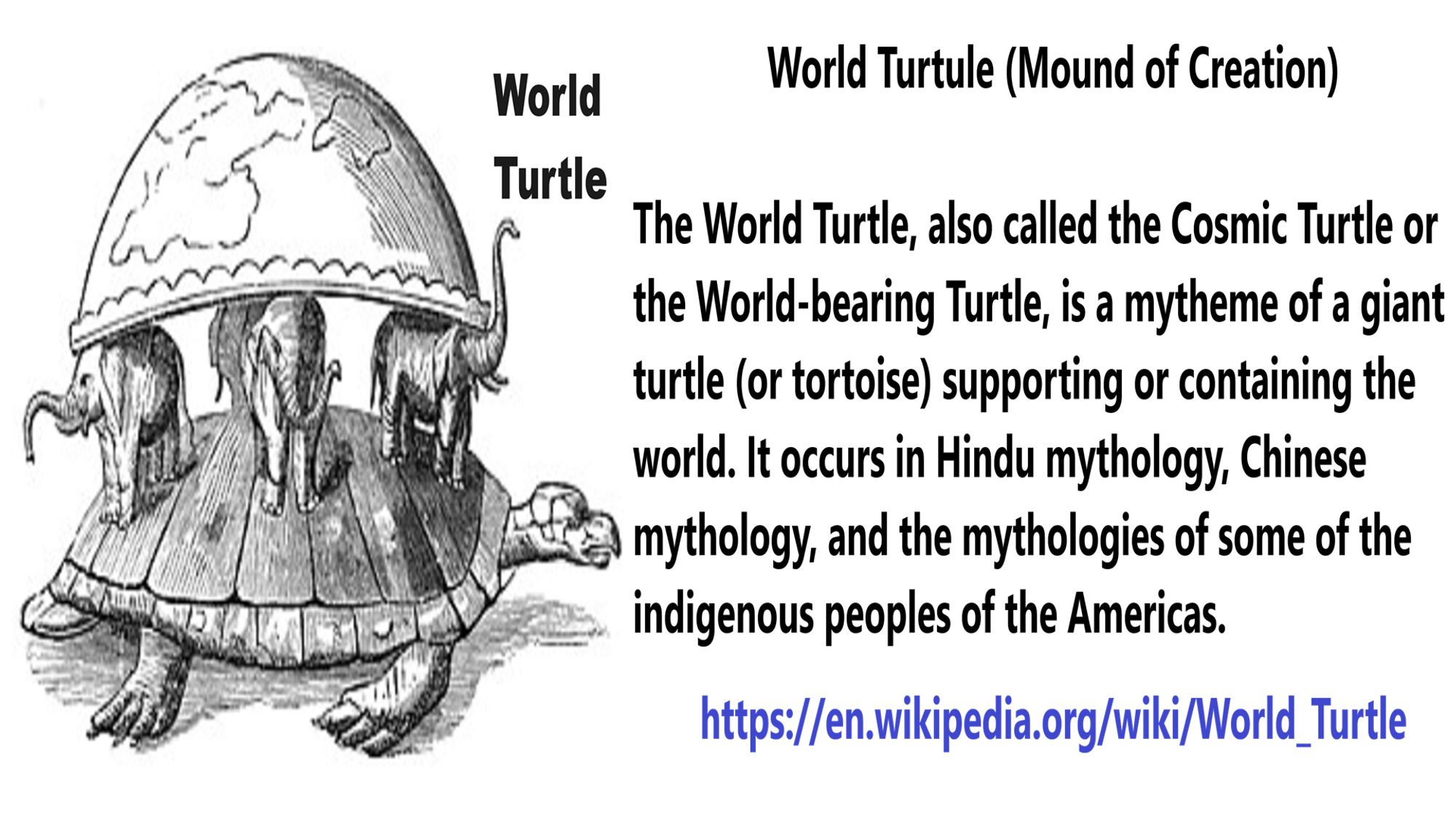
World Turtle (Mound of Creation)
“The World Turtle, also called the Cosmic Turtle or the World-bearing Turtle, is a mytheme of a giant turtle (or tortoise) supporting or containing the world. It occurs in Hindu mythology, Chinese mythology, and the mythologies of some of the indigenous peoples of the Americas.” ref
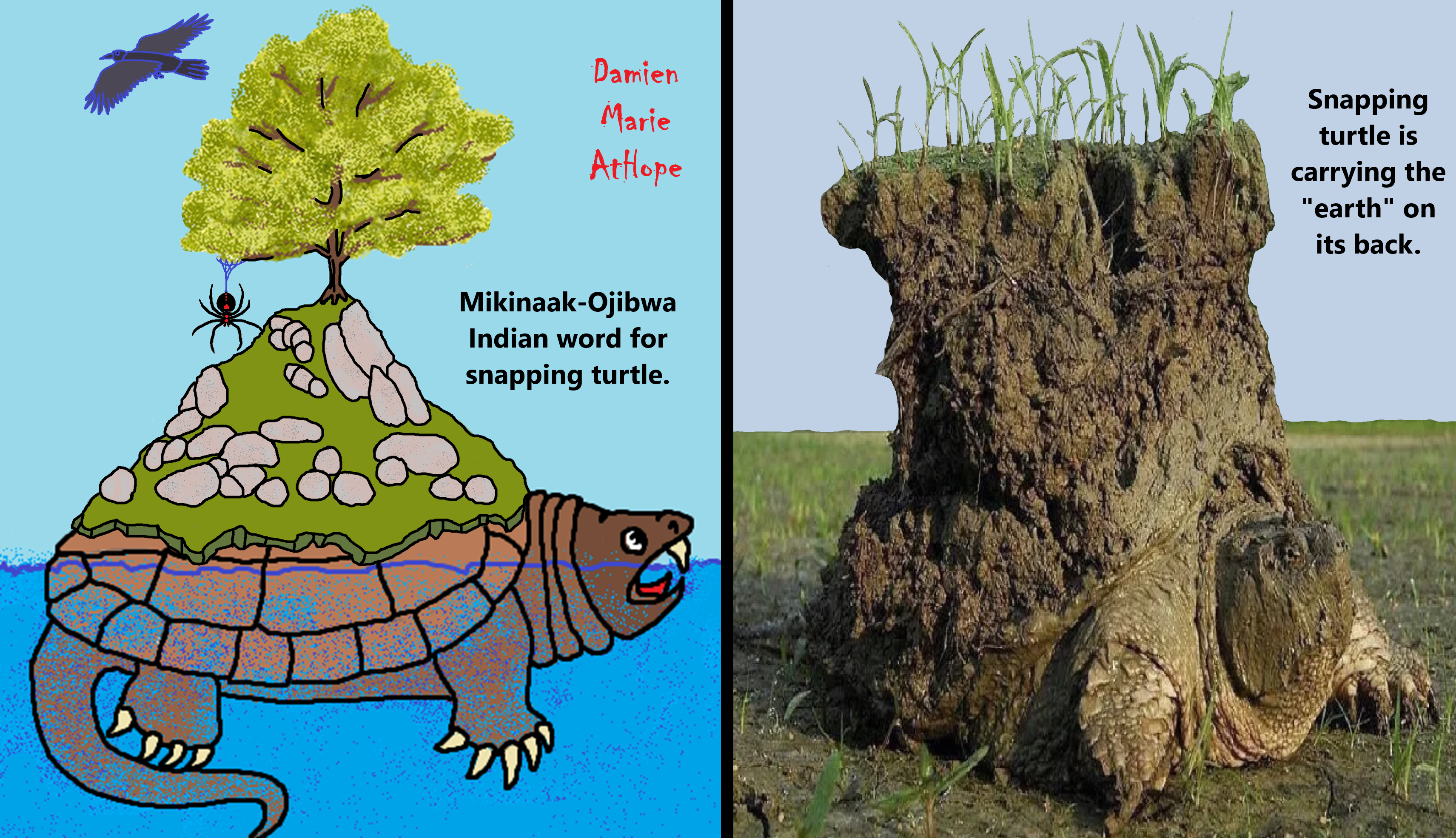
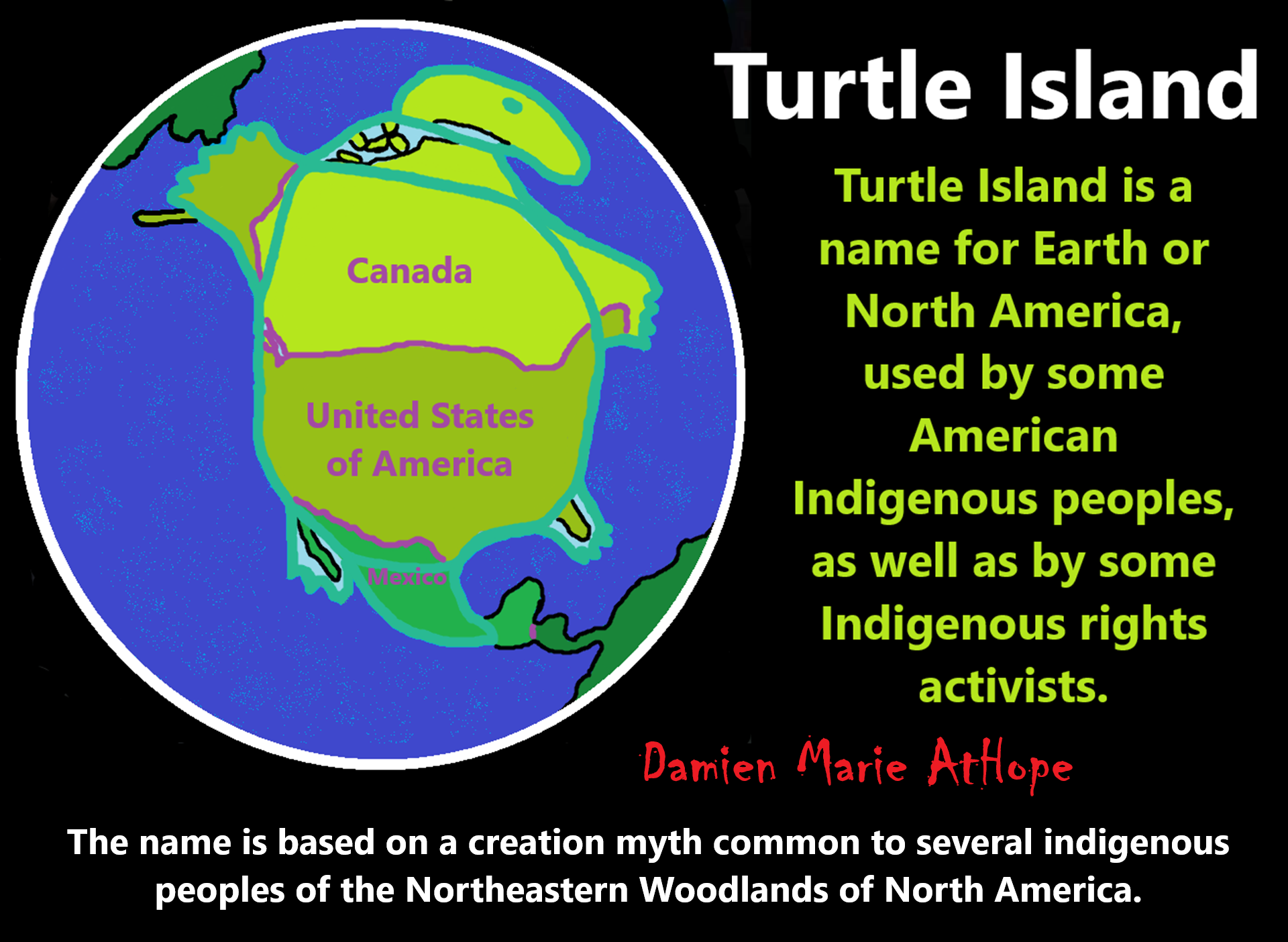
“Turtle Island is a name for Earth or North America, used by some American Indigenous peoples, as well as by some Indigenous rights activists. The name is based on a creation myth common to several indigenous peoples of the Northeastern Woodlands of North America.” ref
“Lenape mythology is the mythology of the Lenape people, an Indigenous peoples of the Northeastern Woodlands. The Lenape story of the “Great Turtle” was first recorded by Europeans between 1678 and 1680 by Jasper Danckaerts. The story is shared by other Northeastern Woodlands tribes, notably the Iroquois peoples. The Lenape believe that before creation there was nothing, an empty dark space. However, in this emptiness, there existed a spirit of their creator, Kishelamàkânk. Eventually in that emptiness, he fell asleep. While he slept, he dreamt of the world as we know it today, the Earth with mountains, forests, and animals. He also dreamt up man, and he saw the ceremonies man would perform. Then he woke up from his dream to the same nothingness he was living in before. Kishelamàkânk then started to create the Earth as he had dreamt it.” ref
“First, he created helper spirits, the Grandfathers of the North, East, and West, and the Grandmother of the South. Together, they created the Earth just as Kishelamàkânk had dreamt it. One of their final acts was creating a special tree. From the roots of this tree came the first man, and when the tree bent down and kissed the ground, woman sprang from it. All the animals and humans did their jobs on the Earth, until eventually a problem arose. There was a tooth of a giant bear that could give the owner magical powers, and the humans started to fight over it.” ref
“Eventually, the wars got so bad that people moved away, and made new tribes and new languages. Kishelamàkânk saw this fighting and decided to send down a spirit, Nanapush, to bring everyone back together. He went on top of a mountain and started the first Sacred Fire, which gave off a smoke that caused all the people of the world to come investigate what it was. When they all came, Nanapush created a pipe with a sumac branch and a soapstone bowl, and the creator gave him Tobacco to smoke with. Nanapush then told the people that whenever they fought with each other, to sit down and smoke tobacco in the pipe, and they would make decisions that were good for everyone.” ref
“The same bear tooth later caused a fight between two evil spirits, a giant toad and an evil snake. The toad was in charge of all the waters, and amidst the fighting he ate the tooth and the snake. The snake then proceeded to bite his side, releasing a great flood upon the Earth. Nanapush saw this destruction and began climbing a mountain to avoid the flood, all the while grabbing animals that he saw and sticking them in his sash. At the top of the mountain there was a cedar tree that he started to climb, and as he climbed he broke off limbs of the tree. When he got to the top of the tree, he pulled out his bow, played it and sang a song that made the waters stop. Nanapush then asked which animal he could put the rest of the animals on top of in the water. The turtle volunteered saying he’d float and they could all stay on him, and that’s why they call the land Turtle Island.” ref
“Nanapush then decided the turtle needed to be bigger for everyone to live on, so he asked the animals if one of them would dive down into the water to get some of the old Earth. The beaver tried first, but came up dead and Nanapush had to revive him. The loon tried second, but its attempt ended with the same fate. Lastly, the muskrat tried. He stayed down the longest, and came up dead as well, but he had some Earth on his nose that Nanapush put on the Turtles back. Because of his accomplishment, Nanapush told the muskrat he was blessed and his kind would always thrive in the land.” ref
“Nanapush then took out his bow and again sang, and the turtle started to grow. It kept growing, and Nanapush sent out animals to try to get to the edge to see how long it had grown. First, he sent the bear, and the bear returned in two days saying he had reached the end. Next, he sent out the deer, who came back in two weeks saying he had reached the end. Finally, he sent the wolf, and the wolf never returned because the land had gotten so big. Lenape tradition said wolves howl because call for their ancestor to come back home.” ref
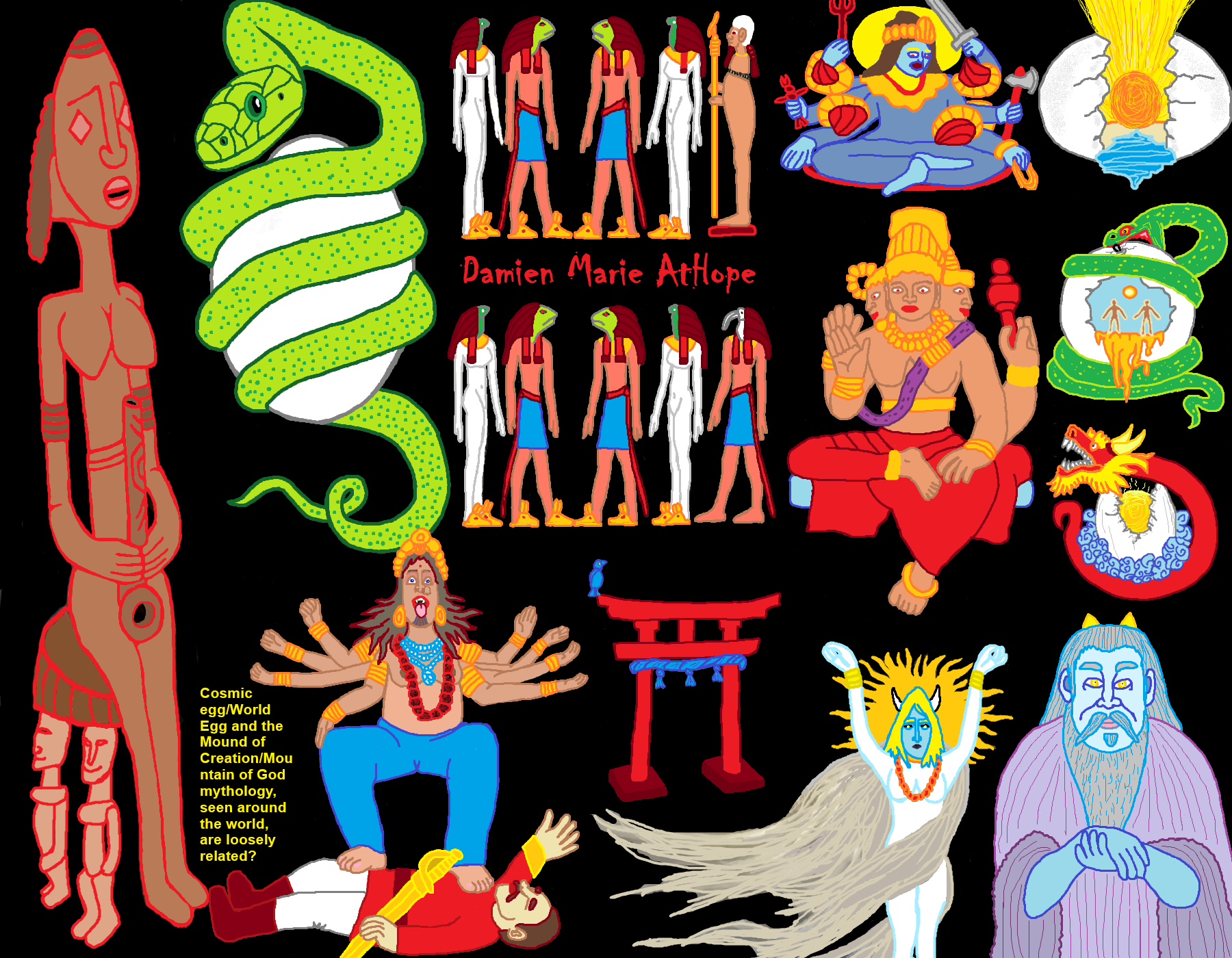
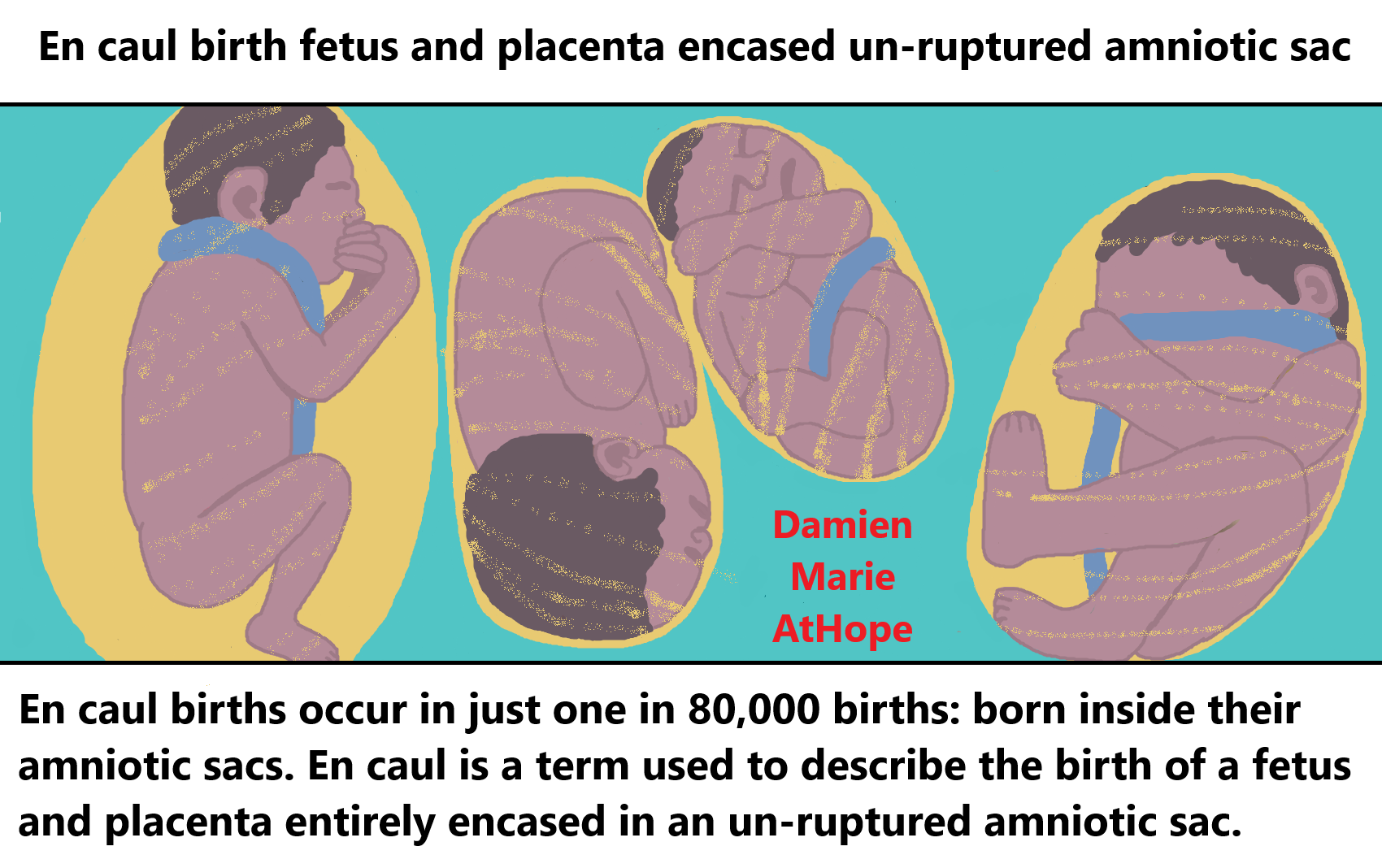
“En caul births occur in just one in 80,000 births: born inside their amniotic sacs. En caul is a term used to describe the birth of a fetus and placenta entirely encased in an un-ruptured amniotic sac.” ref
To me, this birth type relates to Cosmic Egg mythology.
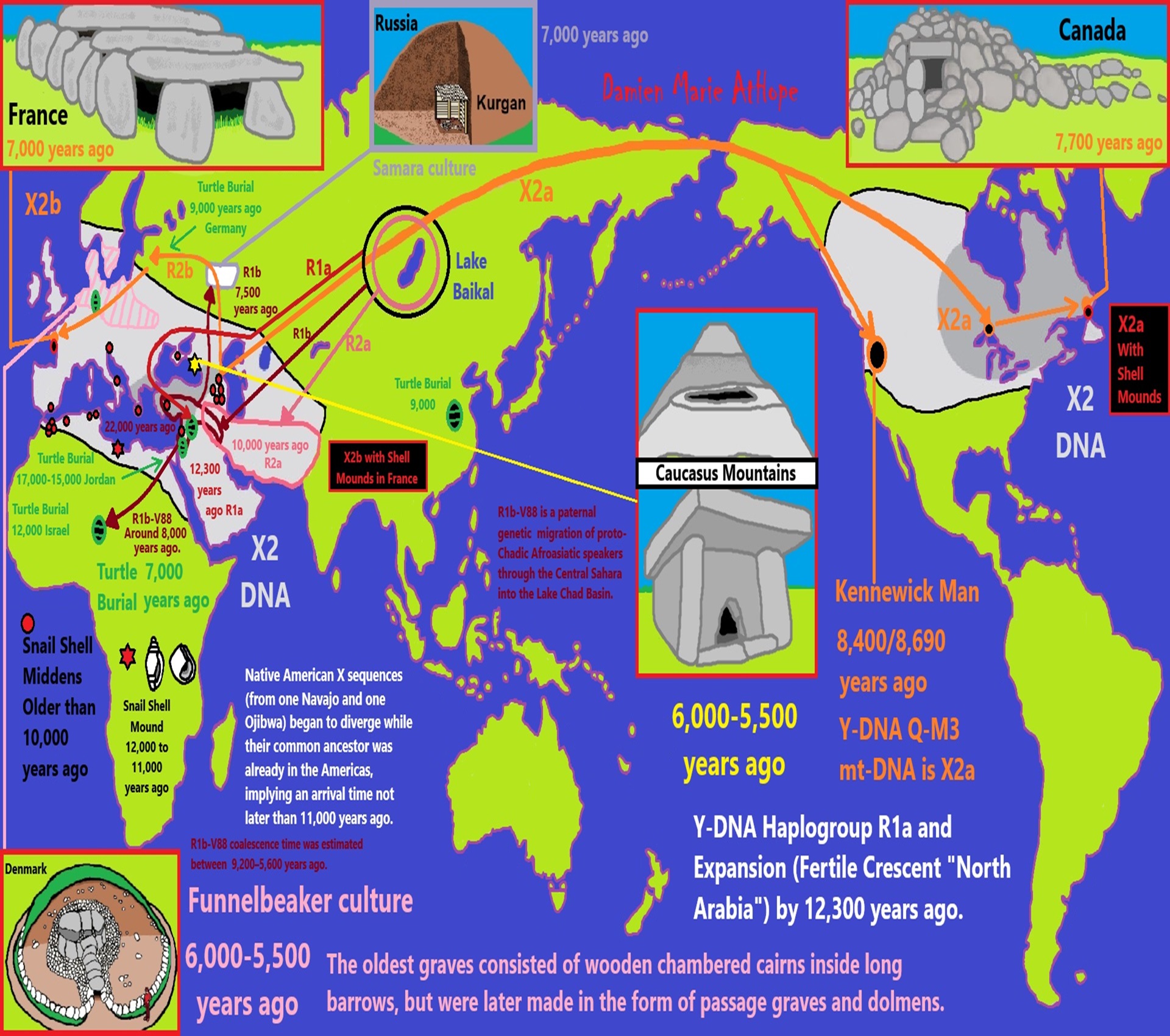
ref, ref, ref, ref, ref, ref, ref, ref, ref, ref, ref, ref, ref, ref, ref, ref, ref, ref, ref, ref, ref, ref, ref, ref, ref, ref, ref, ref, ref, ref, ref, ref, ref, ref, ref, ref, ref, ref, ref
Earth diver mythology or something similar??? Could be. In a way, snails are a kind of mound shape, thus similar to turtle shells, both may represent a mound of creation in the earth-diver myth. In Peru, there were snail shells, and snail shells are also used in the earth diver.
My thoughts on Dolmen origins and migrations, as well as Snail Shell Middens or Snail Burials/Turtle Shell Burials, and links from “Y-DNA R (R1a, R1b, and R2a)” migrations, maybe R2a leading to Proto-Indo-European, transferring it to R1b, taking it to the steppe 7,500 years ago.
Religion is a cultural product. So, it has been part of the human experience, similar to languages, from before we left Africa, spreading humanity across the world.
Turtle Mythology, to me, relates to Sacred Mountain/Mound of Creation beliefs (25,000-15,000 years old) starting in Siberia, then going to the Middle East, turning into Turtle mythology (by 17,000 to 15,000 years ago), then 12,000 years ago back to Siberia, the Americas.
36 turtles in Amazon art on rock walls
“Animals of the Serranía de la Lindosa: Exploring representation and categorization in the rock art and zooarchaeological remains of the Colombian Amazon. Animal representation in the artwork. The presence of processed ochre pigments throughout associated stratigraphy, dating from circa 12,000 to 500 years ago, suggests paintings may have been made since the late Pleistocene.” ref
“The Colombian Amazon contains one of the richest collections of rock art in the world. Adorning the rock outcrops of the Serranía de la Lindosa (from here on La Lindosa) (Fig. 1), Chiribiquete, and the Inírida River region, are vibrant ochre images of human figures, handprints, animals, plants, and geometric designs. As with many other rock art corpora worldwide, the motifs here encode and manifest critical information about how Indigenous communities interacted with their environment, and how they constructed, engaged with, and perpetuated their ritualized, socio-cultural worlds.” ref
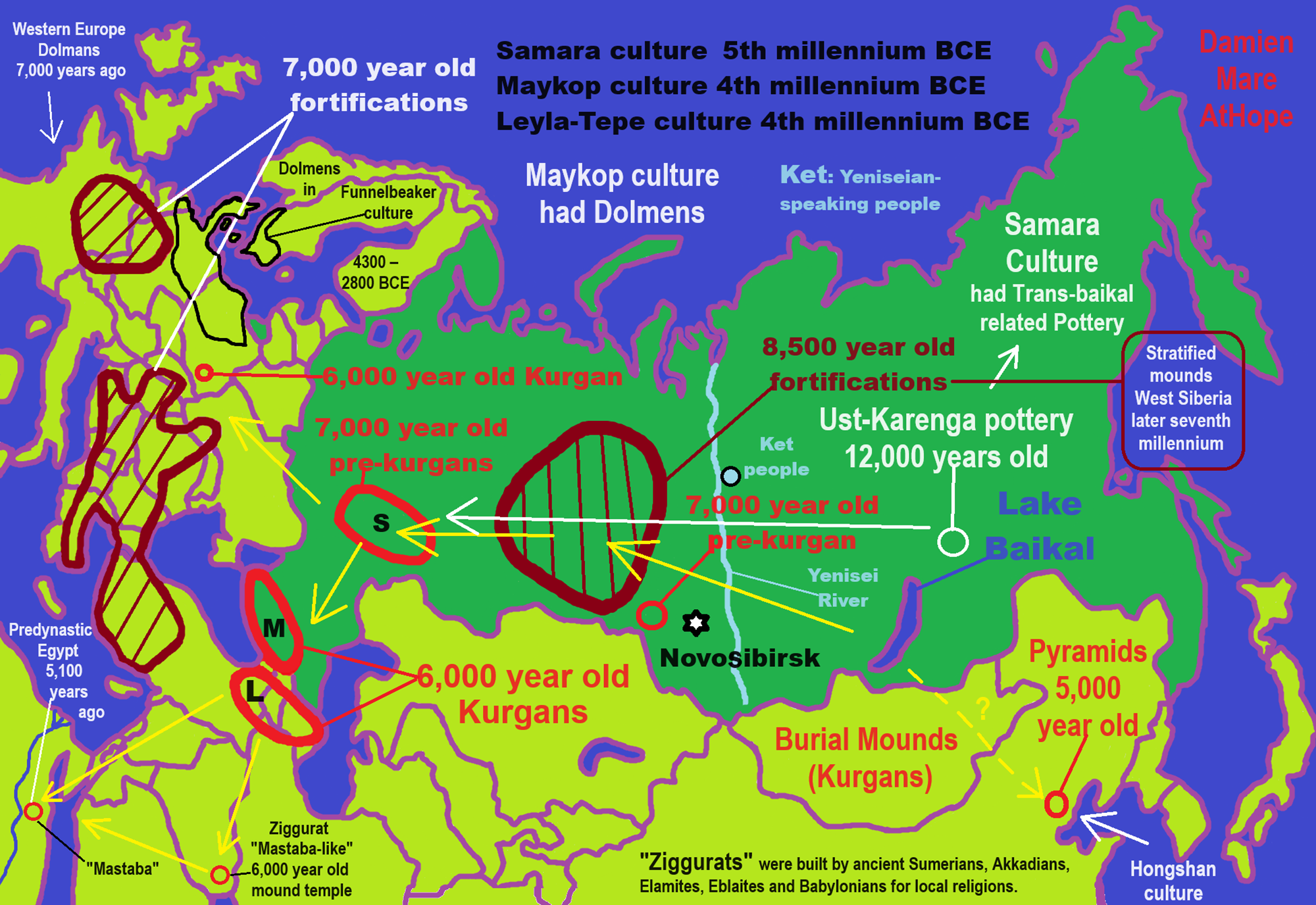
ref, ref, ref, ref, ref, ref, ref, ref, ref, ref, ref, ref, ref, ref, ref, ref, ref, ref, ref, ref, ref, ref, ref, ref, ref, ref, ref, ref
“The FORT Building Societies of Prehistoric Siberia” on YouTube
7,000-year-old Siberian warrior (found in a pre-kurgan Mound): more advanced than we supposed?
“Buried with stone axe and horn-tipped arrow, ancient human remains have archaeologists reshaping their assumptions. In a first for Siberia, a burial mound dating to the ‘New Stone Age’ has been unearthed in Novosibirsk region. In the mound were nine people, including women and children, discovered by archaeologists and students from Kemerovo State University. ‘In the lower layer, they discovered a man with a stone axe and a horn tipped arrow,’ said the university’s press service. ‘It is a fair assumption to say, as this fact proves, that the burial mounds emerged much earlier than the Bronze Age, in Neolithic times.” ref
“S” = Samara culture
“M” = Maykop culture
“L” = Leyla-Tepe culture
“The Samara culture is an Eneolithic (Copper Age) culture dating to the turn of the 5th millennium BCE, at the Samara Bend of the Volga River (modern Russia). The Samara culture is regarded as related to contemporaneous or subsequent prehistoric cultures of the Pontic–Caspian steppe, such as the Khvalynsk, Repin, and Yamna (or Yamnaya: part of the Kurgan hypothesis) cultures. The graves found are shallow pits for single individuals, but two or three individuals might be placed there. Some of the graves are covered with a stone cairn or a low earthen mound, the very first predecessor of the kurgan. The later, fully developed kurgan was a hill on which the deceased chief might ascend to the sky god.” ref
“The Maykop culture, c. 3700–3000 BCE, is a major Bronze Age archaeological culture in the western Caucasus region. According to genetic studies on ancient DNA published in 2018, the Maykop population came from the south, from Imereti, and was descended from the Chalcolithic farmers known as Darkveti-Meshoko who first colonized the north side of the Caucasus. Maykop is therefore the “ideal archaeological candidate for the founders of the Northwest Caucasian language family.” In the south, the Maykop culture bordered the approximately contemporaneous Kura–Araxes culture (3500—2200 BCE or around 5,500 to 4,200 years ago), which extends into the Armenian Plateau and apparently influenced it. To the north is the Yamna culture, including the Novotitarovskaya culture (3300—2700 BCE or around 5,300 to 4,700 years ago), which it overlaps in territorial extent. It is contemporaneous with the late Uruk period in Mesopotamia.” ref
“With the discovery of the Leyla-Tepe culture, some links were noted with the Maykop culture. The Leyla-Tepe culture is a culture of archaeological interest from the Chalcolithic era. Its population was distributed on the southern slopes of the Central Caucasus (modern Azerbaijan, Agdam District), from 4350 until 4000 BCE or around 6,350 to 6,000 years ago. Similar amphora burials in the South Caucasus are found in the Western Georgian Jar-Burial Culture. The culture has also been linked to the north Ubaid period monuments, in particular, with the settlements in the Eastern Anatolia Region. The settlement is of a typical Western-Asian variety, with the dwellings packed closely together and made of mud bricks with smoke outlets.” ref
“It has been suggested that the Leyla-Tepe were the founders of the Maykop culture. An expedition to Syria by the Russian Academy of Sciences revealed the similarity of the Maykop and Leyla-Tepe artifacts with those found recently while excavating the ancient city of Tel Khazneh I, from the 4th millennium BCE. In 2010, nearly 200 Bronze Age sites were reported stretching over 60 miles from the Kuban River to Nalchik, at an altitude of between 4,620 feet and 7,920 feet. They were all “visibly constructed according to the same architectural plan, with an oval courtyard in the center, and connected by roads.” ref
“The construction of artificial terrace complexes in the mountains is evidence of their sedentary living, high population density, and high levels of agricultural and technical skills. The terraces were built around the fourth millennium BCE. and all subsequent cultures used them for agricultural purposes. The vast majority of pottery found on the terraces are from the Maykop period, the rest from the Scythian and Alan period. The Maykop terraces are among the most ancient in the world, but they are little studied. The longevity of the terraces (more than 5000 years) points to a tradition of landscape engineering.” ref
“The Maikop Culture in the northern Caucasus was concurrent with the Kura-Araxes Culture in the south of the Caucasus and the Uruk period in Mesopotamia. The finds in the Maikop kurgan (tumulus) and other kurgans of the Maikop Culture are still regarded as unique to this day. More than 7000 objects of gold and some 1000 of silver are known. Nowhere else in the Early Bronze Age world of the second half of the 4th millennium BC has such a large number of exquisite gold and silver items come to light.” ref
“Based on Wang (2018), David W. Anthony (2019) notes that “the Maikop population was descended from the Eneolithic farmers [that] came from the south, probably from western Georgia [the Darkveti-Meshoko culture], and are the ideal archaeological candidate for the founders of the Northwest Caucasian language family.” He also notes that the Bronze Age Maykop individuals tested by Wang (2018) could not have contributed to the Yamnaya gene pool, Yamnaya being the archeological culture most likely connected to the spread of Indo-European languages. Wang (2018) further found that ‘Steppe Maykop’ (a population related to the Maykop culture) probably had a minor East Asian-related component, which was estimated at ~6.9% of their ancestry, relating them to Ancient North Eurasians (Upper Palaeolithic Siberians AG3, MA1) and Native Americans.” ref
“Its burial practices resemble the burial practices described in the Kurgan hypothesis of Marija Gimbutas, and it has been speculated that the Maykop culture may have contributed to the Yamnaya culture which is nowadays recognised as the ancestor of most Indo-European languages. According to a 2019 article by David Anthony,
Most Yamnaya genomes studied to date exhibit admixed EHG (Eastern Hunter Gatherer) & CHG (Caucasus Hunter Gatherer) ancestry with each in robust proportions, often with CHG ancestry higher than 50%… the Maikop culture (3600-3000 BC) is regarded in many scenarios as the likely source of the CHG that mixed with steppe EHG mating networks to create the Yamnaya genetic synthesis.” ref
“However, more detailed studies cast doubt on this scenario. The Maykop DNA contains quite a large admixture (30%–40%) of Anatolian Farmer ancestry. Anthony continues:
This mixture was too rich in Anatolian Farmer genes to have contributed much to the Yamnaya gene pool, which had only 10-18% Anatolian Farmer ancestry, and most of that arguably derived from the west, from Globular Amphorae and late Tripol’ye populations… This partial description of the genetic data, if it stands, suggests that Maikop was not the source of most of the CHG that amounts to half of Yamnaya ancestry. This is because CHG was already in the steppes long before Maikop.” ref
“According to J.P. Mallory, writing in 1987 before ancient DNA evidence became available:
… where the evidence for barrows is found, it is precisely in regions which later demonstrate the presence of non-Indo-European populations.” ref
“Anthony agrees that the Maykop culture people probably spoke languages which are ancestral to the Northwest Caucasian languages found in the same region today. Nonetheless, their culture seems to have influenced that of the early Indo-Europeans. Anthony writes:
I also accept the general consensus that the appearance of the hierarchical Maikop culture about 3600 BC had profound effects on pre-Yamnaya and early Yamnaya steppe cultures. Yamnaya metallurgy borrowed from the Maikop culture two-sided molds, tanged daggers, cast shaft hole axes with a single blade, and arsenical copper. Wheeled vehicles might have entered the steppes through Maikop, revolutionizing steppe economies and making Yamnaya pastoral nomadism possible after 3300 BCE.” ref
“According to Mariya Ivanova, the Maykop origins were on the Iranian Plateau:
Graves and settlements of the 5th millennium BC in North Caucasus attest to a material culture that was related to contemporaneous archaeological complexes in the northern and western Black Sea region. Yet it was replaced, suddenly as it seems, around the middle of the 4th millennium BC by a “high culture” whose origin is still quite unclear. This archaeological culture named after the great Maykop kurgan showed innovations in all areas which have no local archetypes and which cannot be assigned to the tradition of the Balkan-Anatolian Copper Age. The favoured theory of Russian researchers is a migration from the south originating in the Syro-Anatolian area, which is often mentioned in connection with the so-called “Uruk expansion”. However, serious doubts have arisen about a connection between Maykop and the Syro-Anatolian region. The foreign objects in the North Caucasus reveal no connection to the upper reaches of the Euphrates and Tigris or to the floodplains of Mesopotamia, but rather seem to have ties to the Iranian plateau and to South Central Asia. Recent excavations in the Southwest Caspian Sea region are enabling a new perspective about the interactions between the “Orient” and Continental Europe. On the one hand, it is becoming gradually apparent that a gigantic area of interaction evolved already in the early 4th millennium BCE which extended far beyond Mesopotamia; on the other hand, these findings relativise the traditional importance given to Mesopotamia, because innovations originating in Iran and Central Asia obviously spread throughout the Syro-Anatolian region independently thereof.” ref
“More recently, some very ancient kurgans have been discovered at Soyuqbulaq in Azerbaijan. These kurgans date to the beginning of the 4th millennium BCE, and belong to Leylatepe Culture. According to the excavators of these kurgans, there are some significant parallels between Soyugbulaq kurgans and the Maykop kurgans:
“Discovery of Soyugbulaq in 2004 and subsequent excavations provided substantial proof that the practice of kurgan burial was well established in the South Caucasus during the lateEneolithic[…] The Leylatepe Culture tribes migrated to the north in the mid-fourth millennium, BCE and played an important part in the rise of the Maikop Culture of the North Caucasus.” ref
“The Leyla-Tepe culture (Azerbaijani: Leylatəpə mədəniyyəti) of the South Caucasus belongs to the Chalcolithic era. It got its name from the site in the Agdam District of modern-day Azerbaijan. Its settlements were distributed on the southern slopes of Central Caucasus, from 3800 until 3200 BCE. The monument is a single period site without visible cultural changes. Four construction horizons had been identified, of which the upper one was almost completely destroyed by plowing; the lower level was not yet excavated. Few ash pits or refuse accumulations have been found. All buildings examined at the Leilatepe settlement are rectangular in plan. They were erected without foundation on the leveled ground surface. The walls were made of rectangular mud bricks laid evenly in horizontal rows with the use of mortar.” ref
“In the same area of the Aghdam District in the Karabakh valley, there are also some other sites belonging to Leyla-Tepe culture. They are Chinar-Tepe, Shomulu-Tepe (near Mirəşelli village), and Abdal-Aziz-Tepe. Aghdam District had been disputed in recent Nagorno-Karabakh wars. The Leyla-Tepe culture is also attested at Böyük Kəsik in the lower layers of this settlement. The inhabitants apparently buried their dead in ceramic vessels. Similar amphora burials in the South Caucasus are found in the Western Georgian Jar-burial culture, that is mostly of a much later date. Jar burials are attested in many parts of the world as early as 4500 BCE or around 6,500 years ago. The ancient Poylu II settlement was discovered in the Aghstafa District of modern day Azerbaijan during the construction of the Baku–Tbilisi–Ceyhan pipeline. The lowermost layer dates to the early fourth millennium BC, attesting a multilayer settlement of Leyla-Tepe culture.” ref
“Among the sites associated with this culture, the Soyugbulag kurgans or barrows are of special importance. The excavation of these kurgans, located in Kaspi Municipality, in central Georgia, demonstrated an unexpectedly early date of such structures on the territory of Azerbaijan. They were dated to the beginning of the 4th millennium BCE. The culture has also been linked to the north Ubaid period monuments, in particular, with the settlements in the Eastern Anatolia Region (Arslantepe, Coruchu-tepe, Tepechik, etc.). The settlement is of a typical Western-Asian variety, with the dwellings packed closely together and made of mud bricks with smoke outlets.” ref
“It has been suggested that the Leyla-Tepe were the founders of the Maykop culture. According to Catherine Marro (2022), Maykop/Majkop culture “is certainly connected with the Leyla Tepe complex.” An expedition to Syria by the Russian Academy of Sciences revealed the similarity of the Maykop and Leyla-Tepe artifacts with those found in 1988–2000 while excavating the ancient city of Tel Khazneh I, dating from the 4th millennium BCE. Leyla-Tepe pottery is very similar to the ‘Chaff-Faced Ware’ of the northern Syria and Mesopotamia. It is especially well attested at Amuq F phase. Similar pottery is also found at Kultepe, Azerbaijan. The important site of Galayeri, belonging to the Leyla-Tepe archaeological culture, was investigated by Najaf Museibli. It is located in the Qabala District of modern day Azerbaijan. The location is in the area of the Qabala International Airport, about 20km south from the city of Qabala (Gabala).” ref
“Structures consisting of clay layers are typical; no mud-brick walls have been detected at Galayeri. Almost all findings have Eastern Anatolian Chalcolithic characteristics. The closest analogs of the Galayeri clay constructions are found at Arslantepe/Melid VII in Temple C. The archaeological material of the Galayeri settlement is very similar to the finds at the settlements of Böyük Kəsik I, and Poylu II, as well as the Leyla Tepe site. Especially the ceramics are similar at all these sites. Small metal tools finds indicate the production of metal here 6 thousand years ago. Also, the remains of a very early potter’s wheel have been found. Radiocarbon dating indicates that Galayeri settlement goes back to the beginning of the 4th millennium BCE, which is also supported by the archaeological artifacts found at the settlement.” ref
“The development of Leyla-Tepe culture in the Caucasus marked the early appearance of extractive copper metallurgy. According to research published in 2017, this development that occurred in the second half of the 5th millennium BC preceded the appearance of metallurgy in Mesopotamia. In recent past, the development of copper metallurgy in the Caucasus was attributed to migrants from Uruk arriving around 4500 BCE, or perhaps rather to the pre-Uruk traditions, such as the late Ubaid period, and Ubaid-Uruk phases. Leyla-Tepe metalwork tradition was seen as very sophisticated right from the beginning, and it featured many bronze items. Later, the quality of metallurgy declined somewhat with the advent of the Kura–Araxes culture. Only during the latter stages of Kura–Araxes culture, there was again an improvement in quality.” ref
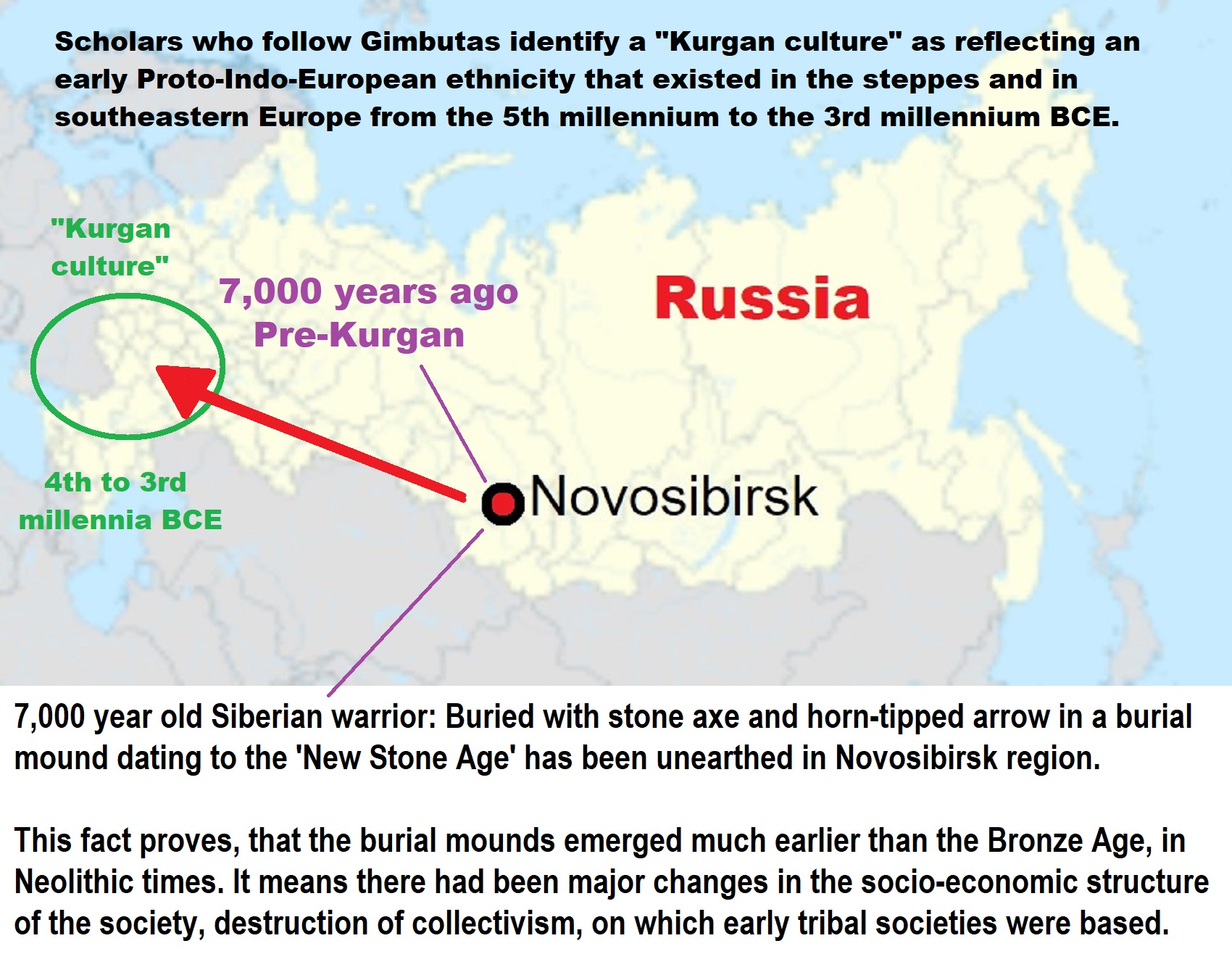
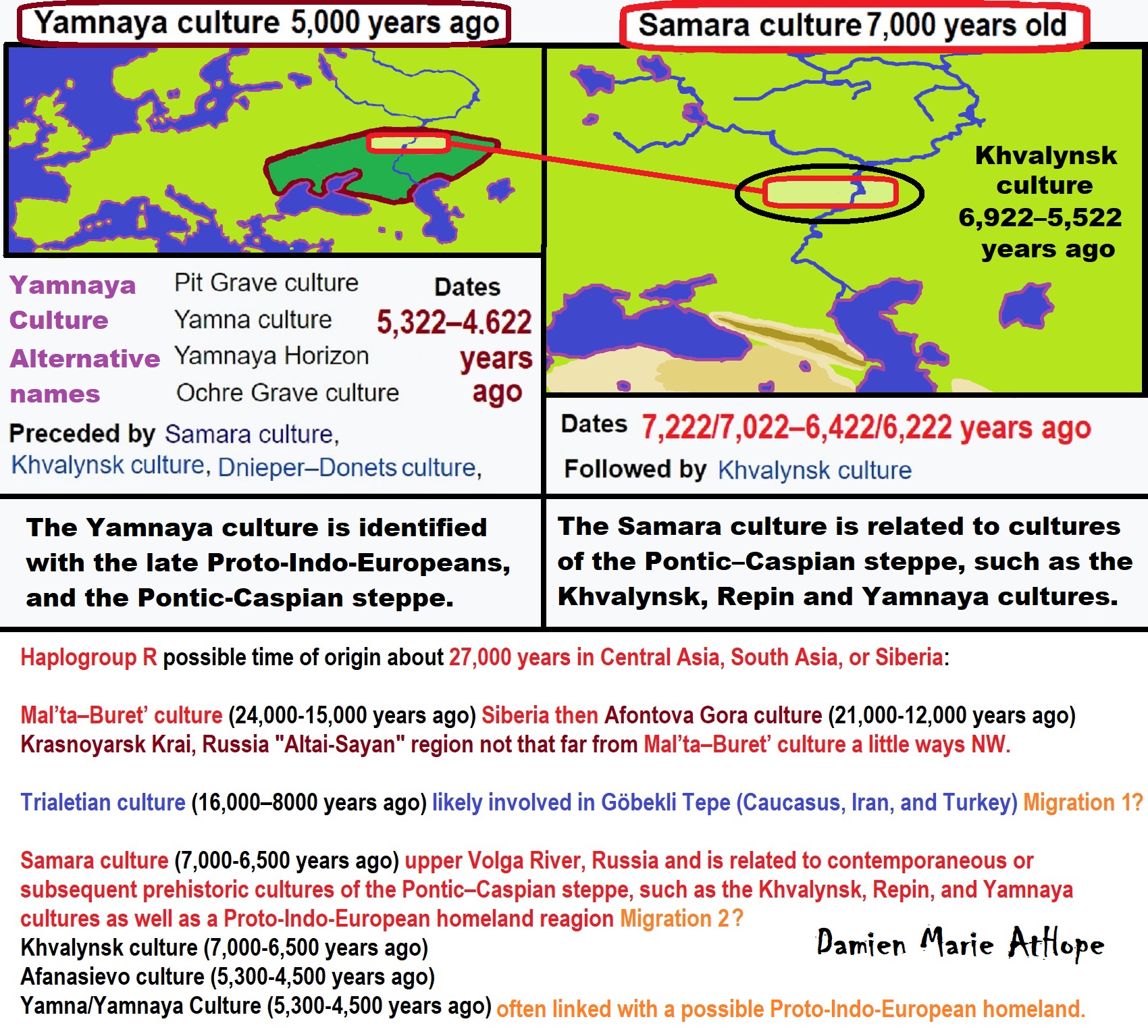
Samara culture with 7,000-year-old pre-kurgan Mounds
The Samara culture is an Eneolithic culture of the early 5th millennium BCE at the Samara bend region of the middle Volga, at the northern edge of the steppe zone. The later stages of the Samara culture are contemporaneous with its successor culture in the region, the early Khvalynsk culture (4700–3800 BCE or 6,700 to 5,800 years ago)-(with the first full Kurgans). Khvalynsk evidences the further development of the kurgan. It began in the Samara with individual graves or small groups sometimes under stone. A male sample carried Y-haplogroup R1b1a1a and mitochondrial haplogroup U5a1d.” ref
“The culture is characterized by the remains of animal sacrifice, which occur over most of the sites. There is no indisputable evidence of riding, but there were horse burials, the earliest in the Old World. Typically the head and hooves of cattle, sheep, and horses are placed in shallow bowls over the human grave, smothered with ochre. Some have seen the beginning of the horse sacrifice in these remains, but this interpretation has not been more definitely substantiated. It is known that the Indo-Europeans sacrificed both animals and people, like many other cultures. “Some of the graves are covered with a stone cairn or a low earthen mound, the very first predecessor of the kurgan. The later, fully developed kurgan was a hill on which the deceased chief might ascend to the sky god, but whether these early mounds had that significance is unknown.” ref
“Although there are disparities in the wealth of the Khvalynsk grave goods, there seems to be no special marker for the chief. This deficit does not exclude the possibility of a chief. In the later kurgans, one finds that the kurgan is exclusively reserved for a chief and his retinue, with ordinary people excluded. This development of the Khvalynsk culture suggests a growing disparity of wealth, which in turn implies a growth in the wealth of the whole community and an increase in population. The explosion of the kurgan culture out of its western steppe homeland must be associated with an expansion of population. The causes of this success and expansion remain obscure.” ref
“Recent genetic studies have shown that males of the Khvalynsk culture carried primarily the paternal haplogroup R1b, although a few samples of R1a, I2a2, Q1a and J have been detected. They belonged to the Western Steppe Herder (WSH) cluster, which is a mixture of Eastern Hunter-Gatherer (EHG) and Caucasian Hunter-Gatherer (CHG) ancestry. This admixture appears to have happened on the eastern Pontic–Caspian steppe starting around 5,000 BCE. Mathieson et al. (2015, 2018) found in three Eneolithic males buried near Khvalynsk between 5,200 and 4,000 BCE the Y-haplogroups R1b1a and R1a1, and the mt-haplogroups H2a1, U5a1i, and Q1a and a subclade of U4.” ref
“Among the later 3,300 – 2,600 BCE or 5,300 to 4,600 years ago Yamnaya culture (Who is related to the main Kurgans hypothesis) are , males carry exclusively R1b and I2. (yamnaya) is a Russian adjective that means ‘related to pits (yama)’, as these people used to bury their dead in tumuli (kurgans) containing simple pit chambers. The people of the Yamnaya culture lived primarily as nomads, with a chiefdom system and wheeled carts and wagons that allowed them to manage large herds. They are also closely connected to Final Neolithic cultures, which later spread throughout Europe and Central Asia. According to the widely-accepted Kurgan hypothesis of Marija Gimbutas, the people that produced the Yamnaya culture spoke a stage of the Proto-Indo-European language, which later spread eastwards and westwards as part of the Indo-European migrations.” ref
“Archaeologists discover ancient 5,000-year-old jade dragon in stone tomb at largest known burial mountain in Mongolia. The 5,000-year-old jade dragon is believed to be linked to the Hongshan culture.” ref
“2,800-year-old burial mound with sacrifices unearthed in Siberia is eerily similar to Scythian graves. The sacrifices could be an early form of a Scythian burial tradition that lasted for hundreds of years.” ref
“A fresh look at the Kurgan hypothesis explores the possible link between North American First Nations and Indo-European cultures.” ref
“The theory was supported by two key lines of cultural evidence. The first line of evidence focused on so called “kurgans,” which were a type of earthen mound, functioning as burial chambers. The locations of known kurgan sites formed a recognizable cultural pattern across a vast swath of Europe and Asia. This widespread cultural artifact indicated a prevalence of cultural influence across a geographically diverse area. Notably, the excavation of said mounds yielded a wealth of datable material which enabled archaeologists to pin the mounds to a specific period, around six to eight thousand years ago. According to most prevalent archaeological timelines, this date precedes other megalithic constructions or advanced societies, thus the hypothesis has had a significant impact on Indo-European studies.” ref
“The second line of evidence was built on linguistic evidence. The Kurgan hypothesis postulates that the people of this early Kurgan culture in the steppes north of the Black Sea were quite possibly the earliest speakers of a proposed mother language – “the Proto-Indo-European language (PIE),” which went on to spread across Europe and the Indian subcontinent, eventually evolving into the Romance, Hellenic, Germanic, Celtic, Balto-Slavic, Indo-Iranian, and Armenian language groups.” ref
“On the one hand, linguists had been identifying hundreds of words that were obviously related to one another across languages. On the other hand, unlike earthen mounds, words themselves tend to be difficult to tie to a specific location. There were some words that stood out though; words that appeared in the Proto-Indo-European lexicon, but that also implied geographic limitations. Such words tended to be tied to physical botanical or zoological species with specific known ranges, such as animals like “bear” and “seal,” and plants including “oak.” Conversely, the Proto-Indo-European did not include words for “palm tree” or “lion.” The inclusion of bears and seals and the conspicuous lack of other animals, like lions or elephants began to indicate a climatic pattern. It soon became apparent that the original PIE homeland must have been somewhere in a temperate climate, within the range of the named species. Notably, the PIE also included “snow.” The geographic location of the PIE homeland was somewhere with bears, oak trees, and snow.” ref
“Another of these more geographically specific words was “lox.” Anyone who has visited New York City can tell you that lox is a favorite bagel topping consisting of smoked salmon. It is easy to trace the etymology of lox into English from the German word ‘lachs,’ (meaning “salmon”), brought to the new world by immigrants. Many of the nineteenth century linguists were fluent in German and ‘lachs’ was among one of the many words on their lists with continent-spanning similarities. The etymological similarities of lox were well attested across the Asian and European language groups.” ref
THE PRIMEVAL MOUND
“The mastabas of the early dynasties had within them a development of the primeval mound, the place of original creation in Zep Tepi, the First Time, an embryonic stepped structure, concealed inside the internal fabric of the building. It was almost inevitable, therefore, that later generations should express their creative spirit in a shape of pure force, colossal but surging upwards, resting with absolute confidence on the earth, immovable but expressing that reaching out for the firmament — and beyond it, to the realm of the Imperishable Stars — which is so typical of the spirit of early Egypt.” ref
“It would have been more extraordinary, perhaps, if the Egyptians had not produced so perfect a shape as the pyramid, at this particular point in their development. That they did so sets the final seal on their achievement; after that expression of creative energy it was only to be expected that decline would inevitably follow. It was not a performance that could ever be repeated, nor one that could even be sustained; indeed, it may be argued that it could not be matched.” ref
“The pyramid, the supreme artefact of the age which was now approaching, represented in stone the summation of all that early Egypt was seeking to express. In every aspect of life, particularly those which touched the king in any way, the early builders of the Egyptian state were attempting to reconcile the cosmic with the human, to identify their society with concepts which otherwise defied articulation.” ref
“The Egyptians possessed an exceptional ability to synthesize complex propositions and penetrating perceptions in symbol and in expressions of the form and content of buildings. Often such synthesis was occluded. An example, which is pertinent to the origins of the Step Pyramid, is the terraced mound, whose origin lies in the little pile of sand raised above a Badarian grave. The mound signifies the Primeval Hill, the mound of creation on which the creator god settled himself when it first appeared above or out of the waters of the Abyss, on which he performed the first acts which inaugurated the cycle of creation itself.” ref
“The most spectacular manifestations of the terraced mound are the Step Pyramid and its companions in other parts of the Valley. The terraced mound would have had a powerful mystical appeal both to Imhotep and to his master. By means of it, Netjerykhet is able to mount to the stars; also it permits the king to fulfil the role of the creator god on his mound, in the perpetual renewal of the life of Egypt, which the whole complex at Saqqara encompasses.” ref
“The terraced mound evidently meant something of profound importance to the powers of the Third Dynasty and, so far as we can judge, particularly to them. Their successors of the Fourth Dynasty began at once to break away from the stepped form in the experimental structures which King Sneferu developed at Dahshur and Maidum, which achieved their consummation in the pyramids which his successors raised on the plateau at Giza.” ref
“There is a still more numinous form of the terraced mound, from much earlier times which is, in a quite literal sense, even more occult. Hidden in the core of the brick-enclosed rubble superstructures of several of the large First Dynasty mastabas at Saqqara is buried, as though waiting for its ultimate liberation or rebirth in the soaring terraces of the Third Dynasty pyramids. The terraced mound is to be found in all periods of Egyptian history, even in the latest, most decadent days. It is one of the most enduring and persistent images developed by the genius of the Egyptian creative spirit.” ref
“Some might see elements in the Netjerykhet complex as the last flowering of the ‘Mesopotamian connection’ in Egypt. The great wall, running for a total length of over one and a half miles, is recessed in a way reminiscent of the recessing of mastaba tombs which are in turn derived from Mesopotamian precedents. This similarity with the exterior of a mastaba is in line with the monument’s rich and complex symbols, and it probably deliberately recalls the earlier structure.” ref

ref, ref, ref, ref, ref, ref, ref, ref, ref, ref, ref, ref
Masseboth similar but much smaller than a European Menhir, dates to around 13,000-11,000 years ago in the Near East. Kurgan a burial mound over a timber burial chamber, dates to around 7,000/6,000 years ago. Dolmen a single-chamber ritual megalith, dates to around 7,000/6,000 years ago. Ziggurat a multi-platform temple around 4,900 years ago. Pyramid a multi-platform tomb, dates to around 4,700 years ago. #3 is a Step Pyramid (or proto pyramid) for the burial of Pharaoh Djoser it went through several revisions and redevelopments. First are three layers of Mastaba “house of eternity” a flat-roofed rectangular structure, then two step pyramid one on top the other, showing the evolution of ideas.
Is there a connection between Dolmans/Kurgans and Ziggurats/Pyramids?
Ziggurat “Step Pyramid-like” mound
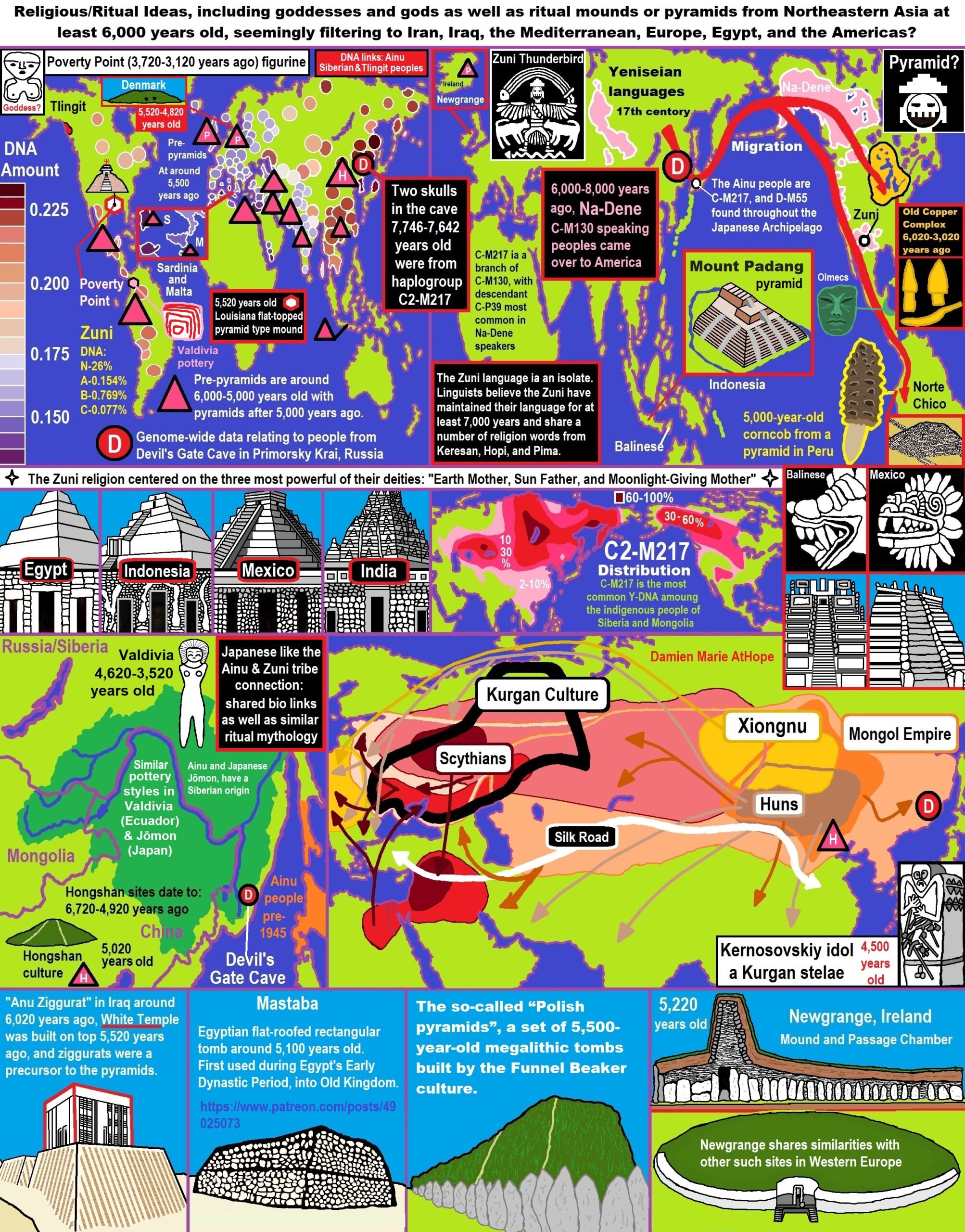
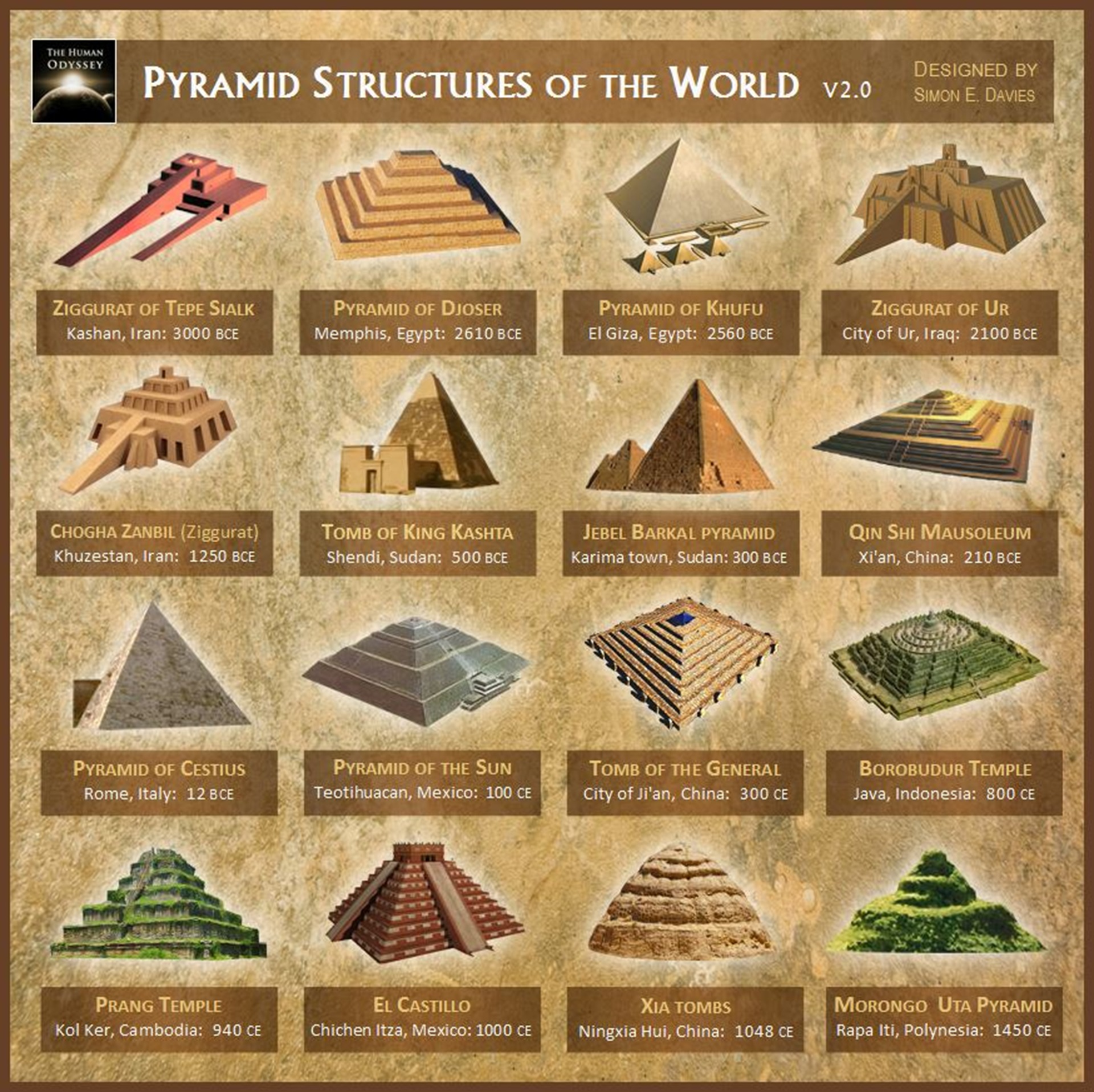
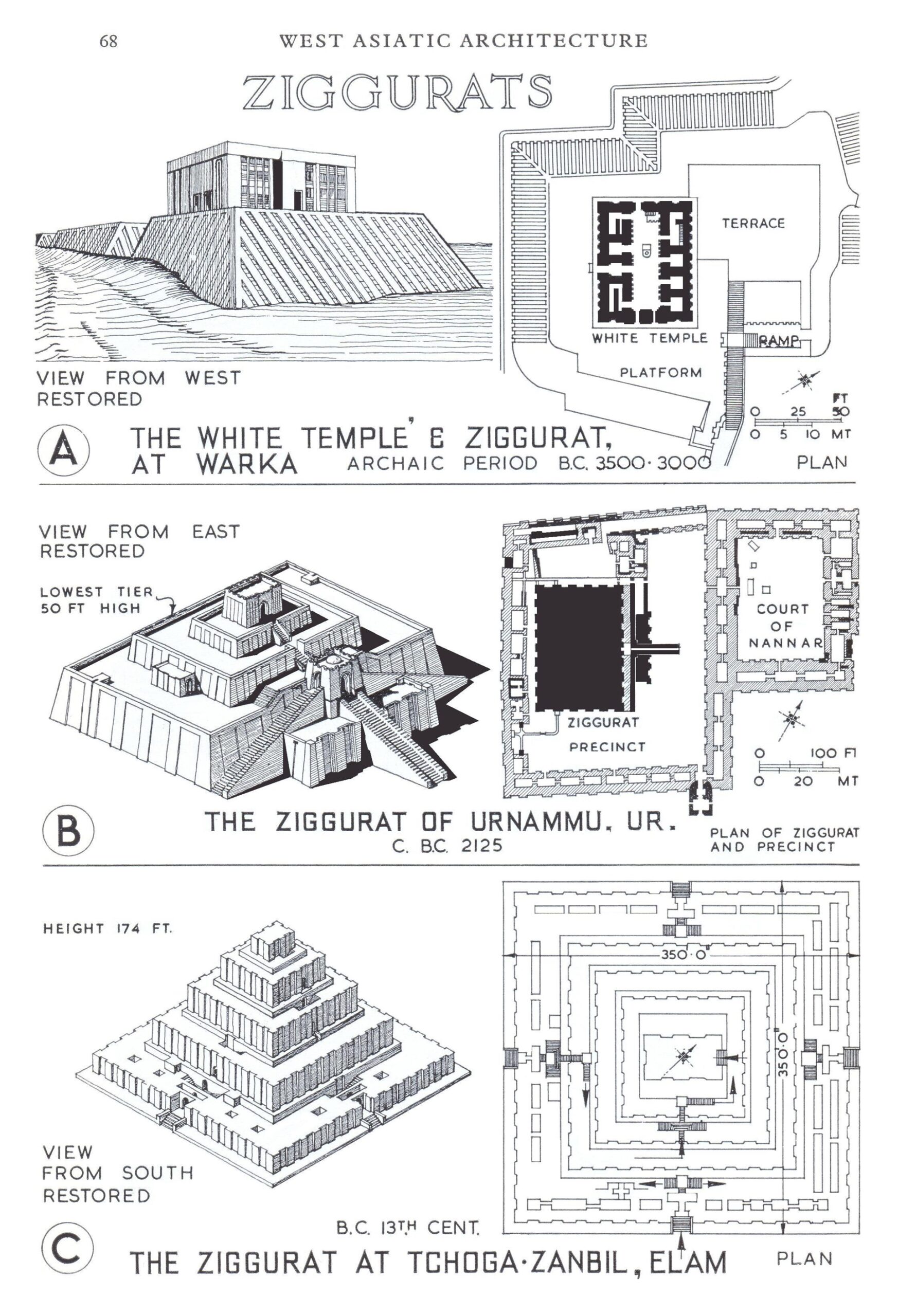
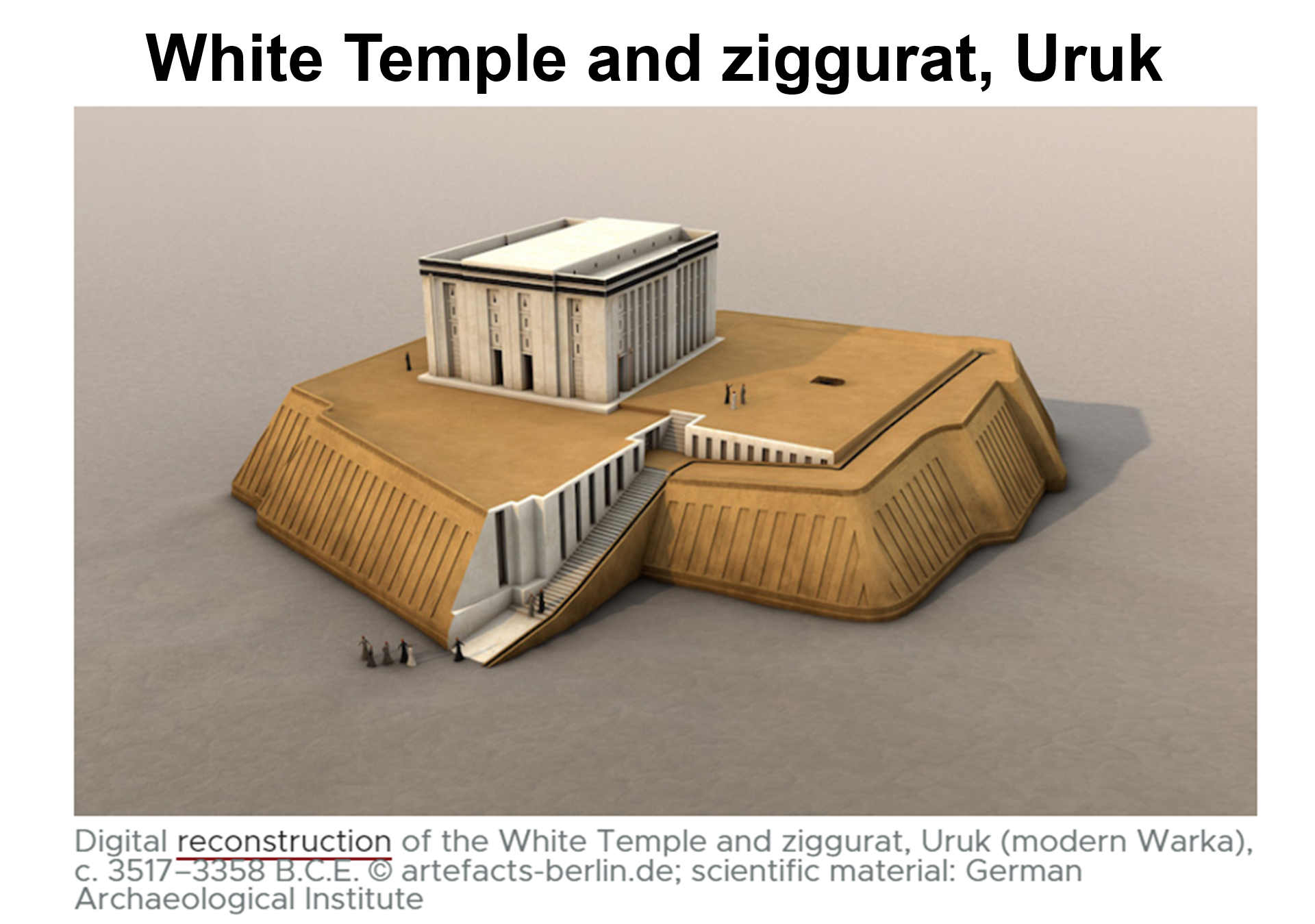
White Temple and ziggurat, Uruk
“Anu ziggurat and White Temple at Uruk. The original pyramidal structure, the “Anu Ziggurat”, dates to the Sumerians around 4000 BCE or around 6,000 years ago, and the White Temple was built on top of it circa 3500 BCE or around 5,500 years ago.” ref
“Within Uruk, the greatest monument was the Anu Ziggurat on which the White Temple was built. Dating to the late 4th millennium BCE (the Late Uruk Period, or Uruk III) and dedicated to the sky god Anu, this temple would have towered well above (approximately 40 feet) the flat plain of Uruk, and been visible from a great distance—even over the defensive walls of the city. Ziggurats were not only a visual focal point of the city, they were a symbolic one, as well—they were at the heart of the theocratic political system (a theocracy is a type of government where a god is recognized as the ruler, and the state officials operate on the god’s behalf). So, seeing the ziggurat towering above the city, one made a visual connection to the god or goddess honored there, but also recognized that deity’s political authority. Excavators of the White Temple estimate that it would have taken 1500 laborers working on average ten hours per day for about five years to build the last major revetment (stone facing) of its massive underlying terrace (the open areas surrounding the White Temple at the top of the ziggurat).” ref
“Although religious belief may have inspired participation in such a project, no doubt some sort of force (corvée labor—unpaid labor coerced by the state/slavery) was involved as well. The White temple was rectangular, measuring 17.5 x 22.3 meters and, at its corners, oriented to the cardinal points. It is a typical Uruk “high temple (Hochtempel)” type with a tripartite plan: a long rectangular central hall with rooms on either side (plan). The White Temple had three entrances, none of which faced the ziggurat ramp directly. Visitors would have needed to walk around the temple, appreciating its bright façade and the powerful view, and likely gained access to the interior in a “bent axis” approach (where one would have to turn 90 degrees to face the altar), a typical arrangement for Ancient Near Eastern temples.” ref
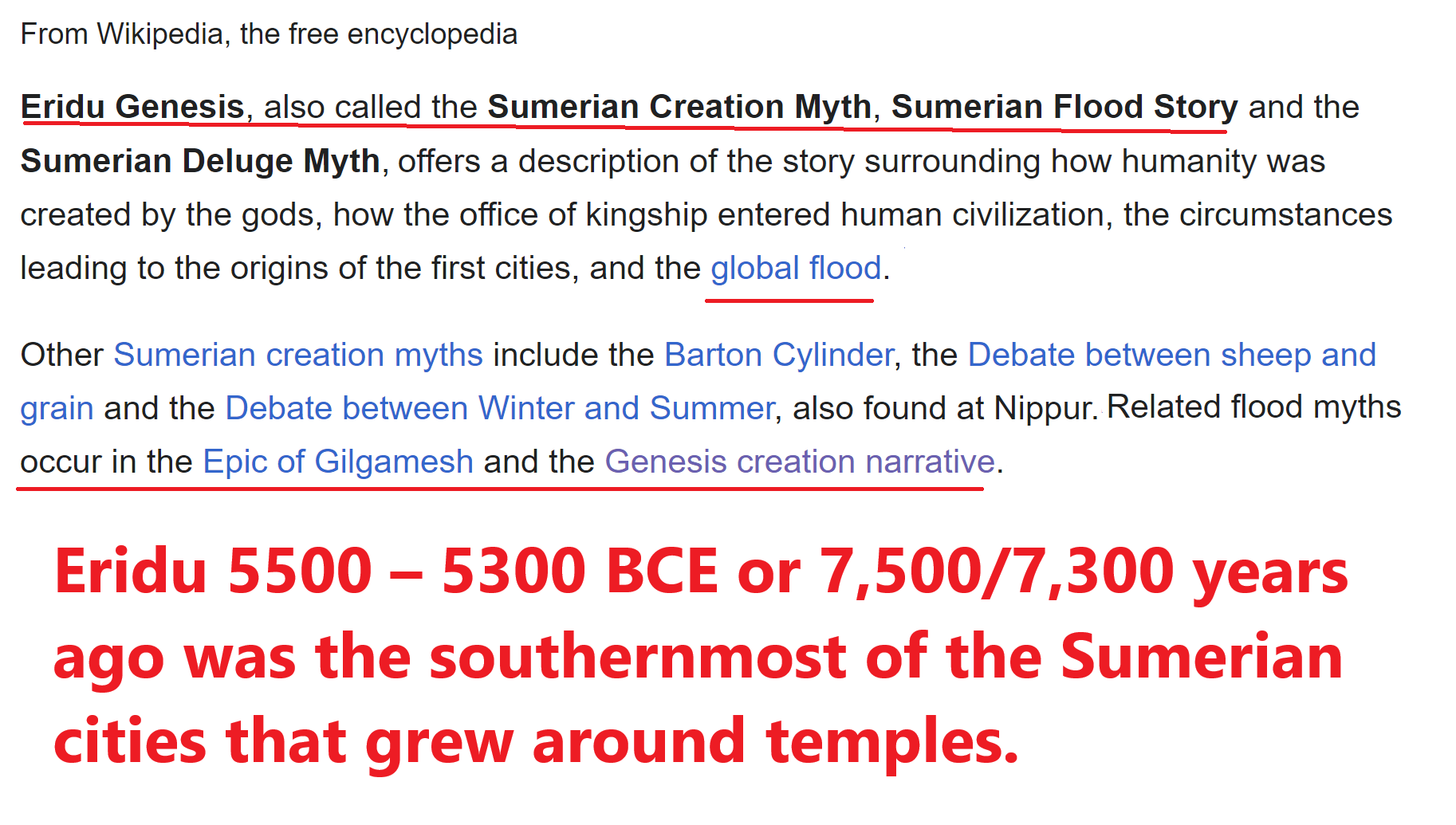
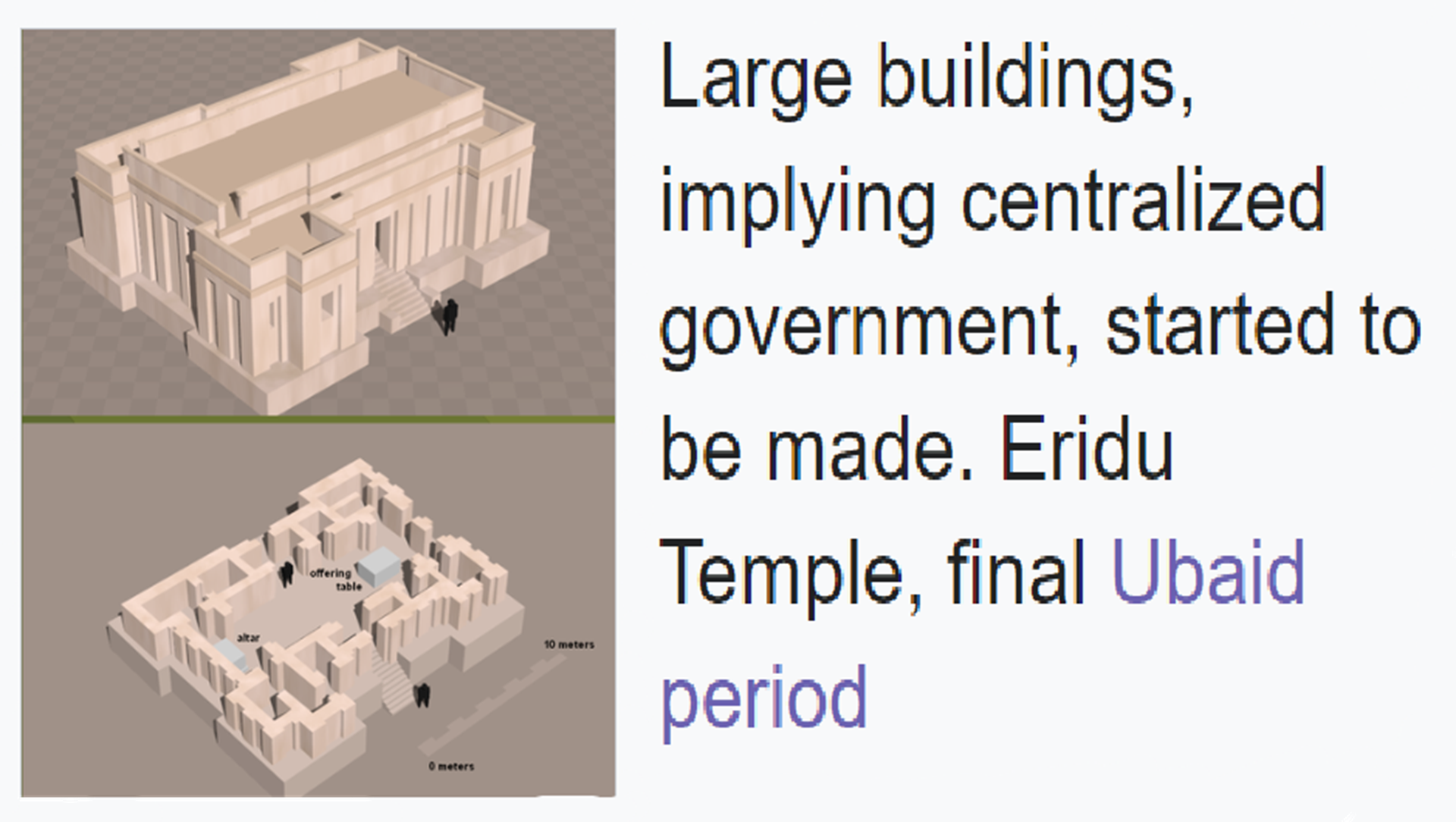
“Eridu 5500 – 5300 BCE or 7,500/7,300 years ago was the southernmost of the Sumerian cities that grew around temples. The city gods of Eridu were Enki and his consort Damkina. 5000–4500 BCE or around 7,000 to 6,500 years ago, in Early Ubaid, No structures were found. 4500–4000 BCE or 6,500 to 6,000 years ago, Ubaid period, size 4.5×12.6, the First platform.” ref
“Eridu was a Sumerian city located at Tell Abu Shahrain an archaeological site in Lower Mesopotamia. It is located in Dhi Qar Governorate, Iraq, near the modern city of Basra. Eridu is traditionally considered the earliest city in southern Mesopotamia based on the Sumerian King List. Located 12 kilometers southwest of the ancient site of Ur, Eridu was the southernmost of a conglomeration of Sumerian cities that grew around temples, almost in sight of one another. The city gods of Eridu were Enki and his consort Damkina. Enki, later known as Ea, was considered to have founded the city. His temple was called E-Abzu, as Enki was believed to live in Abzu, an aquifer from which all life was thought to stem. According to Sumerian temple hymns, another name for the temple of Ea/Enki was called Esira (Esirra).” ref
“… The temple is constructed with gold and lapis lazuli, Its foundation on the nether-sea (apsu) is filled in. By the river of Sippar (Euphrates) it stands. O Apsu pure place of propriety, Esira, may thy king stand within thee. …” At nearby Ur there was a temple of Ishtar of Eridu (built by Lagash‘s ruler Ur-Baba) and a sanctuary of Inanna of Eridu (built by Ur III ruler Ur-Nammu). Ur-Nammu also recorded building a temple of Ishtar of Eridu at Ur which is assumed to have been a rebuild. One of the religious quarters of Babylon, containing the temple called the Esagila as well as the temple of Annunitum, among others, was also named Eridu. Large buildings, implying a centralized government, started to be made. Eridu Temple, final Ubaid period.” ref
5000–4500 BCE or around 7,000 to 6,500 years ago, Early Ubaid, No structures were found.
Temple and ziggurat at Eridu
“The urban nucleus of Eridu was Enki‘s temple, called House of the Aquifer, which in later history was called House of the Waters (Cuneiform: 𒂍𒇉, E₂.LAGAB×HAL; Sumerian: e₂-engur; Akkadian: bītu engurru). The name refers to Enki’s realm. His consort Ninhursag had a nearby temple at Ubaid. During the Ur III period Ur-Nammu had a ziggurat built over the remains of previous temples. Aside from Enmerkar of Uruk (as mentioned in the Aratta epics), several later historical Sumerian kings are said in inscriptions found here to have worked on or renewed the e-abzu temple, including Elili of Ur; Ur-Nammu, Shulgi and Amar-Sin of Ur-III, and Nur-Adad of Larsa.” ref
“Eridu is one of the earliest settlements in the region, founded c. 5400 BCE or around 7,400 years ago during the early Ubaid period, at that time close to the Persian Gulf near the mouth of the Euphrates, although in modern times it is about 90 miles inland. Excavation has shown that the city was founded on a virgin sand dune site with no previous habitation. According to the excavators, construction of the Ur III ziggurat and associated buildings was preceded by the destruction of preceding construction and its use as leveling fill, so no remains from that time were found. At a small mound 1 kilometer north of Eridu, two Early Dynastic III palaces were found, with an enclosure wall. The palaces measured 45 meters by 65 meters with 2.6 meter wide walls and were constructed in the standard Early Dynastic period method of plano-convex bricks laid in a herringbone fashion.” ref
“Twelve neolithic clay tokens, the precursor to Proto-cuneiform, were found in the Ubaid levels of the site. Eighteen superimposed mudbrick temples at the site underlie the unfinished ziggurat of Amar-Sin (c. 2047–2039 BCE or around 4,047 to 4,039 years ago). Levels XIX to VI were from the Ubaid period, and Levels V to I were dated to the Uruk period. Significant habitation was found from the Uruk period with “non-secular” buildings being found in soundings. Uruk finds included decorative terracotta cones topped with copper, copper nails topped with gold, a pair of basalt stone lion statues, columns several meters in diameter coated with cones and gypsum, and extensive Uruk period pottery. Occupation increased in the Early Dynastic period with a monumental 100 meter by 100 meter palace being constructed. An inscription of Elulu, a ruler of the First Dynasty of Ur (c. 2600 BCE or around 4,600 years ago), was found at Eridu. On a statue of the Early Dynastic ruler of Lagash named Entemena (c. 2400 BCE or around 4,400 years ago), it reads, “he built Ab-zupasira for Enki, king of Eridu …” ref
“The bright star Canopus was known to the ancient Mesopotamians and represented the city of Eridu in the Three Stars Each Babylonian star catalogues and later around 1100 BCE or around 3,100 years ago on the MUL.APIN tablets. Canopus was called MUL.NUNKI by the Babylonians, which translates as “star of the city of Eridu”. From most southern city of Mesopotamia, Eridu, there is a good view to the south, so that about 6000 years ago due to the precession of the Earth’s axis the first rising of the star Canopus in Mesopotamia could be observed only from there at the southern meridian at midnight. In the city of Ur this was the case only 60 years later. In the flood myth tablet found in Ur, how Eridu and Alulim were chosen by gods as first city and first priest-king is described. In Sumerian mythology, Eridu was the home of the Abzu temple of the god Enki, the Sumerian counterpart of the Akkadian god Ea, god of deep waters, wisdom and magic.” ref
“Like all the Sumerian and Babylonian gods, Enki/Ea began as a local god who, according to the later cosmology, came to share the rule of the cosmos with Anu and Enlil. His kingdom was the sweet waters that lay below earth (Sumerian ab=water; zu=far). The stories of Inanna, goddess of Uruk, describe how she had to go to Eridu in order to receive the gifts of civilization. At first Enki, the god of Eridu, attempted to retrieve these sources of his power but later willingly accepted that Uruk now was the center of the land. Alulim King of Sumer King of Eridu. The Uruk List of Kings and Sages (ULKS) version of the SKL pairs him up with an apkallu (an apkallu was a sage in Sumerian literature and religion—the first apkallu was named Adapa, and he was paired up with Alulim; additionally, Adapa has been compared with the Biblical figure Adam).” ref
Damien thinks the “Mound of Creation” mythology ((Axis Mundi) is a “myth” reason for mounds/pyramids.
Think ancient Hunter-Gathers were unskilled and primitive? Well, think again, because they were downright amazing! CHECK OUT THIS VIDEO: Primitive Technology: Woven bark fiber
Damien thinks Egypt and Sumerian mounds are connected and evolved somewhat related but different. A similar situation happened, to me, in the Americas. North started in mounds that later evolved into something Pryamid like. This is matched by Mesoamerica. Mounds later evolved into Pryamids. In Peru, Pryamids and mounds may have been transferred together or mounds quickly evolved into Pryamids.
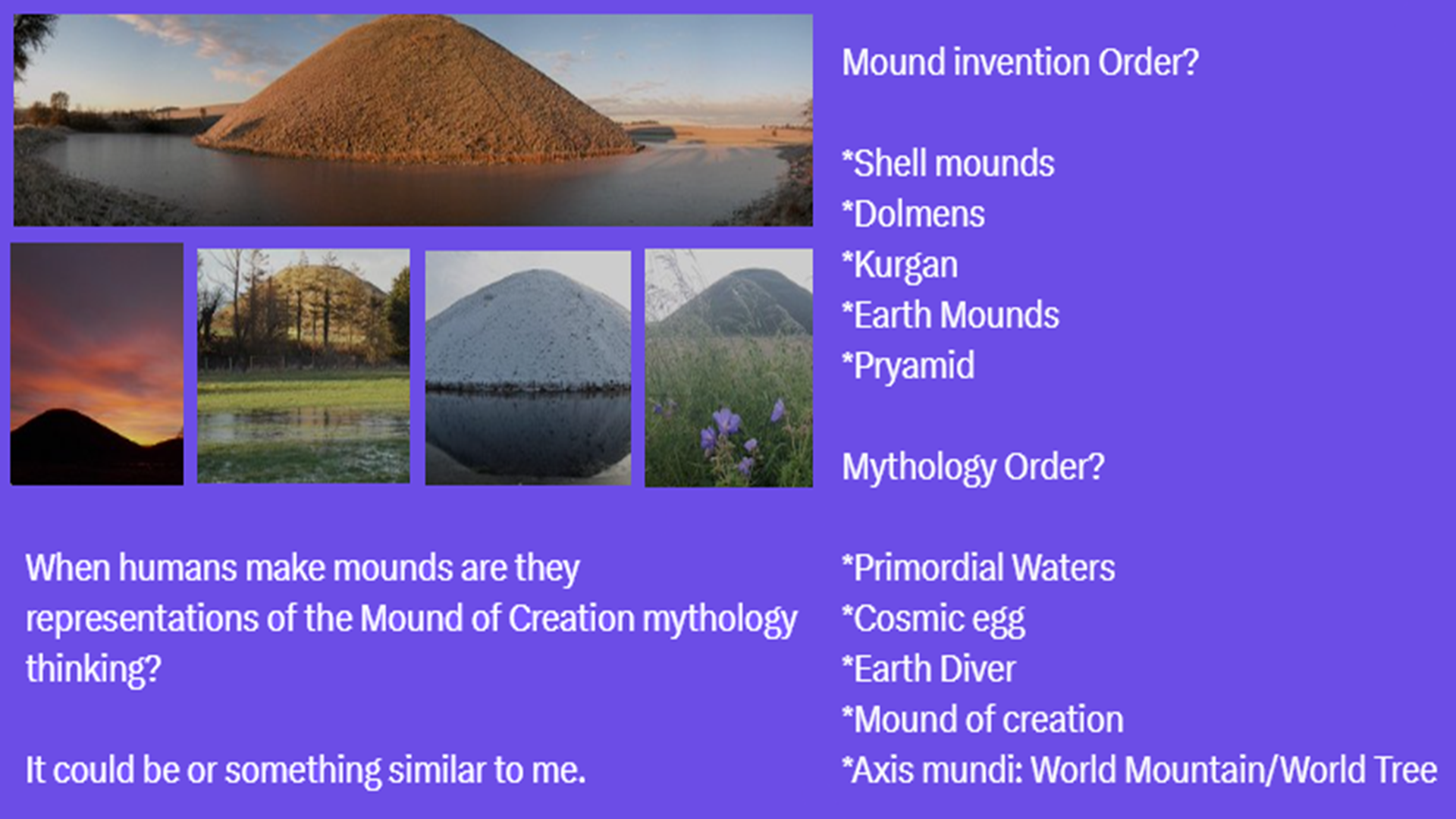
I am rather sure about the Mound order but not sure about the order of the mythology as mounds can be set in time by archaeology. To me, mounds relate mainly to the “Mound of Creation,” primeval mound/hill/mountain (that emerges out of water) or the “Axis Mundi” thinking: cosmic axis, world axis, world pillar, the center of the world, World tree, Sacred Mountain/World Mountain, etc. “(such as Mount Olympus in Greek mythology) or are related to famous events (like Mount Sinai in Judaism and descendant religions or Mount Kailash, Mount Meru in Hinduism). In some cases, the sacred mountain is purely mythical, like the Hara Berezaiti in Zoroastrianism. Mount Kailash is believed to be the abode of the deities Shiva and Parvati, and is considered sacred in four religions: Hinduism, Bon, Buddhism, and Jainism. Volcanoes, such as Mount Etna in Italy, were also considered sacred; Mount Etna is believed to have been the home of Vulcan, the Roman god of fire and the forge.” ref
I explain how all mounds shared similar myths and world views thus this is why so many seem similar. I explain how Ancient Egypt, Sumerians, and Hinduism all have something similar to a Mound of Creation, and what the Shell mounds/Kurgans/Dolmens/Earth Mounds/Pyramids relate. In Siberia/Americas it is more related to Earth Diver myths, but they also have animals build a Mound of Creation. Also, many Connect to the Axis mundi which can and often does relate to a world mountain/mound of creation.
Creation Myth
“A creation myth or cosmogonic myth is a type of cosmogony, a symbolic narrative of how the world began and how people first came to inhabit it. While in popular usage the term myth often refers to false or fanciful stories, members of cultures often ascribe varying degrees of truth to their creation myths. In the society in which it is told, a creation myth is usually regarded as conveying profound truths – metaphorically, symbolically, historically, or literally. They are commonly, although not always, considered cosmogonical myths – that is, they describe the ordering of the cosmos from a state of chaos or amorphousness.” ref
“Creation myths often share several features. They often are considered sacred accounts and can be found in nearly all known religious traditions. They are all stories with a plot and characters who are either deities, human-like figures, or animals, who often speak and transform easily. They are often set in a dim and nonspecific past that historian of religion Mircea Eliade termed in illo tempore (‘at that time’). Creation myths address questions deeply meaningful to the society that shares them, revealing their central worldview and the framework for the self-identity of the culture and individual in a universal context. Creation myths develop in oral traditions and therefore typically have multiple versions; found throughout human culture, they are the most common form of myth.” ref
“Creation myth definitions from modern references:
- A “symbolic narrative of the beginning of the world as understood in a particular tradition and community. Creation myths are of central importance for the valuation of the world, for the orientation of humans in the universe, and for the basic patterns of life and culture.”
- “Creation myths tell us how things began. All cultures have creation myths; they are our primary myths, the first stage in what might be called the psychic life of the species. As cultures, we identify ourselves through the collective dreams we call creation myths, or cosmogonies. … Creation myths explain in metaphorical terms our sense of who we are in the context of the world, and in so doing they reveal our real priorities, as well as our real prejudices. Our images of creation say a great deal about who we are.”
- A “philosophical and theological elaboration of the primal myth of creation within a religious community. The term myth here refers to the imaginative expression in narrative form of what is experienced or apprehended as basic reality … The term creation refers to the beginning of things, whether by the will and act of a transcendent being, by emanation from some ultimate source, or in any other way.” ref
“Religion professor Mircea Eliade defined the word myth in terms of creation:
Myth narrates a sacred history; it relates an event that took place in primordial Time, the fabled time of the “beginnings.” In other words, myth tells how, through the deeds of Supernatural Beings, a reality came into existence, be it the whole of reality, the Cosmos, or only a fragment of reality – an island, a species of plant, a particular kind of human behavior, an institution.” ref
“Creation myths have been around since ancient history and have served important societal roles. Over 100 “distinct” ones have been discovered. All creation myths are in one sense etiological because they attempt to explain how the world formed and where humanity came from. Myths attempt to explain the unknown and sometimes teach a lesson. Ethnologists and anthropologists who study origin myths say that in the modern context theologians try to discern humanity’s meaning from revealed truths and scientists investigate cosmology with the tools of empiricism and rationality, but creation myths define human reality in very different terms.” ref
“In the past, historians of religion and other students of myth thought of such stories as forms of primitive or early-stage science or religion and analyzed them in a literal or logical sense. Today, however, they are seen as symbolic narratives which must be understood in terms of their own cultural context. Charles Long writes: “The beings referred to in the myth – gods, animals, plants – are forms of power grasped existentially. The myths should not be understood as attempts to work out a rational explanation of deity.” ref
“While creation myths are not literal explications, they do serve to define an orientation of humanity in the world in terms of a birth story. They provide the basis of a worldview that reaffirms and guides how people relate to the natural world, to any assumed spiritual world, and to each other. A creation myth acts as a cornerstone for distinguishing primary reality from relative reality, the origin and nature of being from non-being. In this sense cosmogonic myths serve as a philosophy of life – but one expressed and conveyed through symbol rather than through systematic reason. And in this sense they go beyond etiological myths (which explain specific features in religious rites, natural phenomena, or cultural life). Creation myths also help to orient human beings in the world, giving them a sense of their place in the world and the regard that they must have for humans and nature.” ref
“Historian David Christian has summarised issues common to multiple creation myths:
How did everything begin? This is the first question faced by any creation myth and … answering it remains tricky. … Each beginning seems to presuppose an earlier beginning. … Instead of meeting a single starting point, we encounter an infinity of them, each of which poses the same problem. … There are no entirely satisfactory solutions to this dilemma. What we have to find is not a solution but some way of dealing with the mystery …. And we have to do so using words. The words we reach for, from God to gravity, are inadequate to the task. So we have to use language poetically or symbolically; and such language, whether used by a scientist, a poet, or a shaman, can easily be misunderstood.” ref
“Mythologists have applied various schemes to classify creation myths found throughout human cultures. Eliade and his colleague Charles Long developed a classification based on some common motifs that reappear in stories the world over. The classification identifies five basic types:
Brahmā, the Hindu deva of creation, emerges from a lotus risen from the navel of Viṣņu, who lies with Lakshmi on the serpent Ananta Shesha.” ref
- Creation ex nihilo in which the creation is through the thought, word, dream, or bodily secretions of a divine being.
- Earth-diver creation in which a diver, usually a bird or amphibian sent by a creator, plunges to the seabed through a primordial ocean to bring up sand or mud which develops into a terrestrial world.
- Emergence myths in which progenitors pass through a series of worlds and metamorphoses until reaching the present world.
- Creation by the dismemberment of a primordial being.
- Creation by the splitting or ordering of a primordial unity such as the cracking of a cosmic egg or a bringing order from chaos.” ref
“Marta Weigle further developed and refined this typology to highlight nine themes, adding elements such as deus faber, a creation crafted by a deity, creation from the work of two creators working together or against each other, creation from sacrifice and creation from division/conjugation, accretion/conjunction, or secretion.” ref
“An alternative system based on six recurring narrative themes was designed by Raymond Van Over:
- Primeval abyss, an infinite expanse of waters or space
- Originator deity which is awakened or an eternal entity within the abyss
- Originator deity poised above the abyss
- Cosmic egg or embryo
- Originator deity creating life through sound or word
- Life generating from the corpse or dismembered parts of an originator deity.” ref
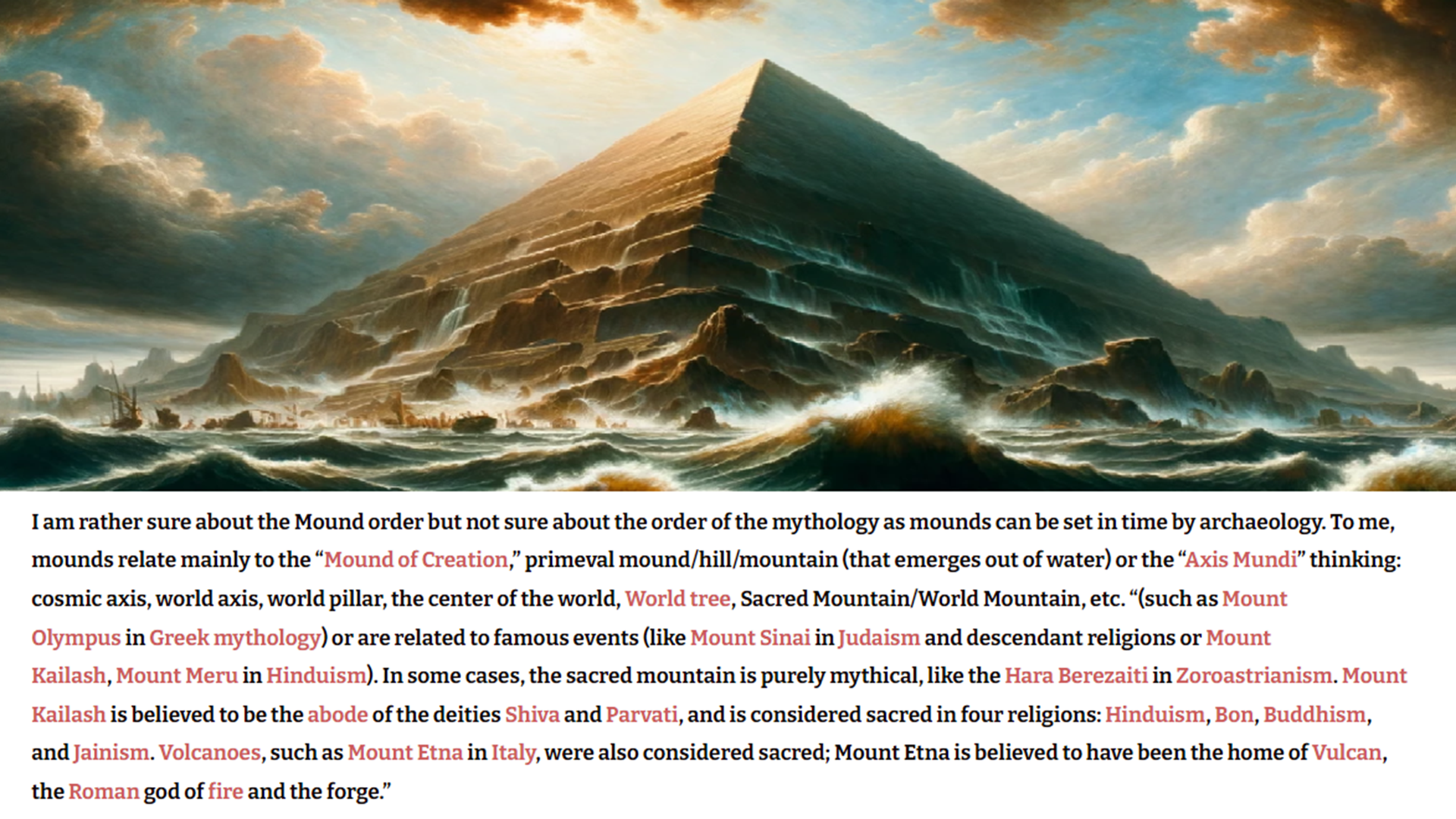
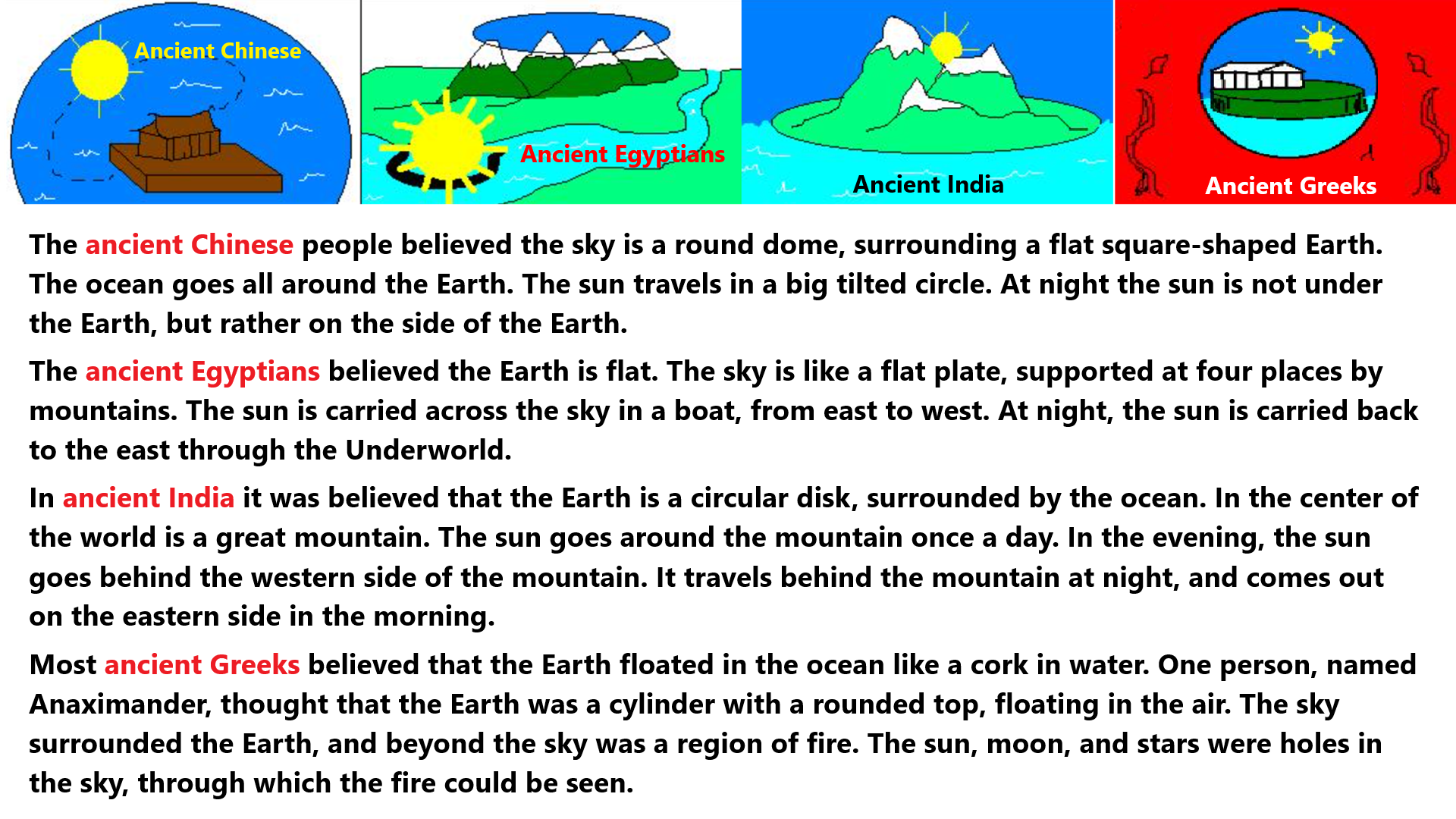
Flat Earth Mythology (a kind of square base for a mound/pyramid)?
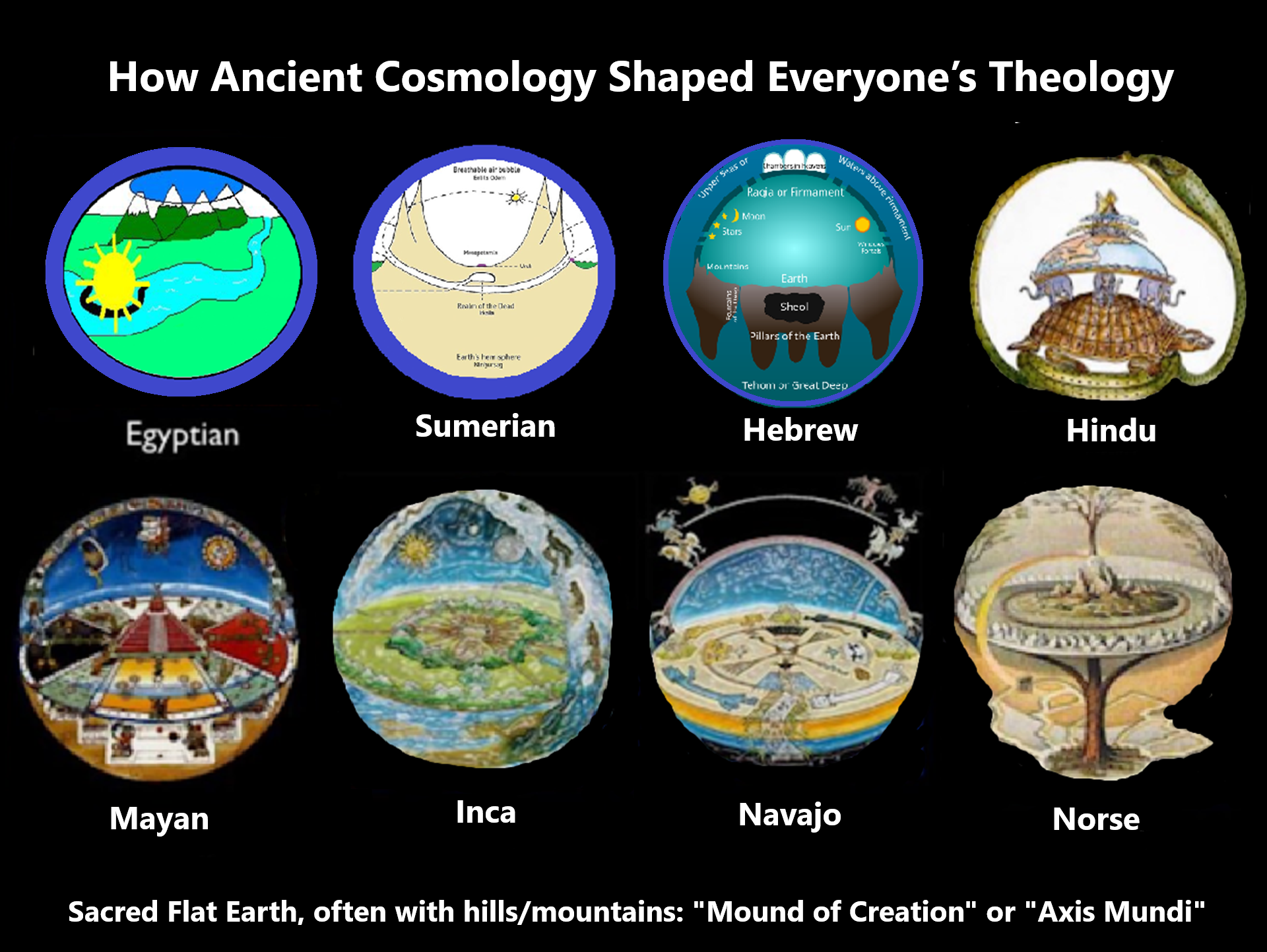
Ancient Cosmology Shaped Everyone’s Theology
Sacred Flat Earth, often with hills/mountains: “Mound of Creation” or “Axis Mundi.”
“Cosmology in the ancient Near East (ANE) refers to the plurality of cosmological beliefs in the Ancient Near East, covering the period from the 4th millennium BCE to the formation of the Macedonian Empire by Alexander the Great in the second half of the 1st millennium BCE. These beliefs include the Mesopotamian cosmologies from Babylonia, Sumer, and Akkad; the Levantine or West Semitic cosmologies from Ugarit and ancient Israel and Judah (the biblical cosmology); the Egyptian cosmology from Ancient Egypt; and the Anatolian cosmologies from the Hittites. This system of cosmology went on to have a profound influence on views in early Greek cosmology, later Jewish cosmology, patristic cosmology, and Islamic cosmology (including Quranic cosmology). Until the modern era, variations of ancient near eastern cosmology survived with Hellenistic cosmology as the main competing system. Ancient near eastern cosmology can be divided into its cosmography, the physical structure and features of the cosmos; and cosmogony, the creation myths that describe the origins of the cosmos in the texts and traditions of the ancient near eastern world. The cosmos and the gods were also related, as cosmic bodies like heaven, earth, the stars were believed to be and/or personified as gods, and the sizes of the gods were frequently described as being of cosmic proportions.” ref
Cosmography
“Ancient Near Eastern civilizations held to a fairly uniform conception of cosmography. This cosmography remained remarkably stable in the context of the expansiveness and longevity of the ancient Near East, but changes were also to occur. Widely held components of ancient near eastern cosmography included:
- a flat earth and a solid heaven (firmament), both of which are disk-shaped
- a primordial cosmic ocean. When the firmament is created, it separates the cosmic ocean into two bodies of water:
- the heavenly upper waters located on top of the firmament, which act as a source of rain
- the lower waters that the earth is above and that the earth rests on; they act as the source of rivers, springs, and other earthly bodies of water
- the region above the upper waters, namely the abode of the gods
- the netherworld, the furthest region in the direction downwards, below the lower waters.” ref
“Keyser, categorizing ancient near eastern cosmology as belonging to a larger and more cross-cultural set of cosmologies he describes as a “cradle cosmology,” offers a longer list of shared features. Some cosmographical features have been misattributed to Mesopotamian cosmologies, including the idea that ziggurats represented cosmic objects reaching up to heaven or the idea of a dome- or vault-shaped (as opposed to a flat) firmament. Another controversy concerns if the ancient near eastern cosmography was purely observational or phenomenological. However, a number of lines of evidence, including descriptions from the cosmological texts themselves, presumptions of this cosmography in non-cosmological texts (like incantations), anthropological studies of contemporary primitive cosmologies, and cognitive expectations that humans construct mental models to explain observation, support that the ancient near eastern cosmography was not phenomenological.” ref
Cosmogony
“Ancient near eastern cosmogony also included a number of common features that are present in most if not all creation myths from the ancient near east. Widespread features included:
- Creatio ex materia from a primordial state of chaos; that is, the organization of the world from pre-existing, unordered and unformed (hence chaotic) elements, represented by a primordial body of water
- the presence of a divine creator
- the Chaoskampf motif: a cosmic battle between the protagonist and a primordial sea monster
- the separation of undifferentiated elements (to create heaven and earth)
- the creation of mankind.” ref
“Lisman uses the broader category of “Beginnings” to encompass three separate though inter-related categories: the beginning of the cosmos (cosmogony), the beginning of the gods (theogony), and the beginning of humankind (anthropogeny). There is evidence that Mesopotamian creation myths reached as far as Pre-Islamic Arabia.” ref
Overview of the whole cosmos
“The Mesopotamian cosmos can be imagined along a vertical axis, with parallel planes of existence layered above each other. The uppermost plane of existence was heaven, being the residence of the god of the sky Anu. Immediately below heaven was the atmosphere. The atmosphere extended from the bottom of heaven (or the lowermost firmament) to the ground. This region was inhabited by Enlil, who was also the king of the gods in Sumerian mythology. The cosmic ocean below the ground was the next plane of existence, and this was the domain of the sibling deities Enki and Ninhursag. The lowest plane of existence was the underworld. Other deities inhabited these planes of existence even if they did not reign over them, such as the sun and moon gods. In later Babylonian accounts, the god Marduk alone ascends to the top rank of the pantheon and rules over all domains of the cosmos. The three-tiered cosmos (sky-earth-underworld) is found in Egyptian artwork on coffin lids and burial chambers.” ref
“A variety of terms or phrases were used to refer to the cosmos as a whole, acting as rough equivalents to contemporary terms like “cosmos” or “universe”. This included phrases like “heaven and earth” or “heaven and underworld”. Terms like “all” or “totality” similarly connoted the entire universe. These motifs are found in temple hymns and royal inscriptions located in temples. The temples symbolized cosmic structures that reached heaven at their height and the underworld at their depths/foundations. Surviving evidence does not specify the exact physical bounds of the cosmos or what lies beyond the region described in the texts.” ref
Three Heavens and Earths
“In Mesopotamian cosmology, heaven and earth both had a tripartite structure: a Lower Heaven/Earth, a Middle Heaven/Earth, and an Upper Heaven/Earth. The Upper Earth was where humans existed. Middle Earth, corresponding to the Abzu (primeval underworldly ocean), was the residence of the god Enki. Lower Earth, the Mesopotamian underworld, was where the 600 Anunnaki gods lived, associated with the land of the dead ruled by Nergal. As for the heavens: the highest level was populated by 300 Igigi (great gods), the middle heaven belonged to the Igigi and also contained Marduk’s throne, and the lower heaven was where the stars and constellations were inscribed into. The extent of the Babylonian universe therefore corresponded to a total of six layers spanning across heaven and Earth. Notions of the plurality of heaven and earth are no later than the 2nd millennium BC and may be elaborations of earlier and simpler cosmographies.” ref
“One text (KAR 307) describes the cosmos in the following manner, with each of the three floors of heaven being made of a different type of stone:
30 “The Upper Heavens are Luludānītu stone. They belong to Anu. He (i.e. Marduk) settled the 300 Igigū (gods) inside. 31 The Middle Heavens are Saggilmud stone. They belong to the Igīgū (gods). Bēl (i.e. Marduk) sat on the high throne within, 32 the lapis lazuli sanctuary. And made a lamp? of electrum shine inside (it). 33 The Lower Heavens are jasper. They belong to the stars. He drew the constellations of the gods on them. 34 In the … …. of the Upper Earth, he lay down the spirits of mankind. 35 [In the …] of the Middle earth, he settled Ea, his father. 36 […..] . He did not let the rebellion be forgotten. 37 [In the … of the Lowe]r earth, he shut inside 600 Anunnaki. 38 […….] … […. in]side jasper.” ref
“Another text (AO 8196) offers a slightly different arrangement, with the Igigi in the upper heaven instead of the middle heaven, and with Bel placed in the middle heaven. Both agree on the placement of the stars in the lower heaven. Exodus 24:9–10 identifies the floor of heaven as being like sapphire, which may correspond to the blue lapis lazuli floor in KAR 307, chosen potentially for its correspondence to the visible color of the sky. One hypothesis holds that the belief that the firmament is made of stone (or a metal, such as iron in Egyptian texts) arises from the observation that meteorites, which are composed of this substance, fall from the firmament.” ref
Seven heavens and earths
“Some texts describe seven heavens and seven earths, but within the Mesopotamian context, this is likely to refer to a totality of the cosmos with some sort of magical or numerological significance, as opposed to a description of the structural number of heavens and Earth. Israelite texts do not mention the notion of seven heavens or earths.” ref
Unity of the cosmos
“Mythical bonds, akin to ropes or cables, played the role of cohesively holding the entire world and all its layers of heaven and Earth together. These are sometimes called the “bonds of heaven and earth”. They can be referred to with terminology like durmāhu (typically referring to a strong rope made of reeds), markaṣu (referring to a rope or cable, of a boat, for example), or ṣerretu (lead-rope passed through an animals nose). A deity can hold these ropes as a symbol of their authority, such as the goddess Ishtar “who holds the connecting link of all heaven and earth (or netherworld)”. This motif extended to descriptions of great cities like Babylon which was called the “bond of [all] the lands,” or Nippur which was “bond of heaven and earth,” and some temples as well.” ref
Center of the cosmos
“The idea of a center to the cosmos played a role in elevating the status of whichever place was chosen as the cosmic center and in reflecting beliefs of the finite and closed nature of the cosmos. Babylon was described as the center of the Babylonian cosmos. In parallel, Jerusalem became “the navel of the earth” (Ezekiel 38:12). The finite nature of the cosmos was also suggested to the ancients by the periodic and regular movements of the heavenly bodies in the visible vicinity of the Earth.” ref
Firmament: Firmament
“The firmament was believed to be a solid boundary above the Earth, separating it from the upper or celestial waters. In the Book of Genesis, it is called the raqia. In ancient Egyptian texts, and from texts across the Near East generally, the firmament was described as having special doors or gateways on the eastern and western horizons to allow for the passage of heavenly bodies during their daily journeys. These were known as the windows of heaven or the gates of heaven. Canaanite text describe Baal as exerting his control over the world by controlling the passage of rainwater through the heavenly windows in the firmament. In Egyptian texts particularly, these gates also served as conduits between the earthly and heavenly realms for which righteous people could ascend. The gateways could be blocked by gates to prevent entry by the deceased as well. As such, funerary texts included prayers enlisting the help of the gods to enable the safe ascent of the dead. Ascent to the celestial realm could also be done by a celestial ladder made by the gods. Multiple stories exist in Mesopotamian texts whereby certain figures ascend to the celestial realm and are given the secrets of the gods.” ref
“Four different Egyptian models of the firmament and/or the heavenly realm are known. One model was that it was the shape of a bird: the firmament above represented the underside of a flying falcon, with the sun and moon representing its eyes, and its flapping causing the wind that humans experience. The second was a cow, as per the Book of the Heavenly Cow. The cosmos is a giant celestial cow represented by the goddess Nut or Hathor. The cow consumed the sun in the evening and rebirthed it in the next morning. The third is a celestial woman, also represented by Nut. The heavenly bodies would travel across her body from east to west. The midriff of Nut was supported by Shu (the air god) and Geb (the earth god) lay outstretched between the arms and feet of Nut. Nut consumes the celestial bodies from the west and gives birth to them again in the following morning. The stars are inscribed across the belly of Nut and one needs to identify with one of them, or a constellation, in order to join them after death. The fourth model was a flat (or slightly convex) celestial plane which, depending on the text, was thought to be supported in various ways: by pillars, staves, scepters, or mountains at the extreme ends of the Earth. The four supports give rise to the motif of the “four corners of the world.” ref
Earth: Flat Earth, Topography of the earth
“The ancient near eastern earth was a single-continent disk resting on a body of water sometimes compared to a raft. An aerial view of the cosmography of the earth is pictorially elucidated by the Babylonian Map of the World. Here, the city Babylon is near the Earth’s center and it is on the Euphrates river. Other kingdoms and cities surround it. The north is covered by an enormous mountain range, akin to a wall. This mountain range was traversed in some hero myths, such as the Epic of Gilgamesh where Gilgamesh travels past it to an area only accessible by gods and other great heroes. The furthest and most remote parts of the earth were believed to be inhabited by fantastic creatures. In the Babylonian Map, the world continent is surrounded by a bitter salt-water Ocean (called marratu, or “salt-sea”) akin to Oceanus described by the poetry of Homer and Hesiod in early Greek cosmology, as well as the statement in the Bilingual Creation of the World by Marduk that Marduk created the first dry land surrounded by a cosmic sea. Egyptian cosmology appears to have also shared this view, as one of the words used for sea, shen-wer, means “great encircler”. World-encircling oceans are also found in the Fara tablet VAT 12772 from the 3rd millennium BC and the Myth of Etana.” ref
Four corners of the earth (Four Mountains)
“A common honorific that many kings and rulers ascribed to themselves was that they were the rulers of the four quarters (or corners) of the Earth. For example, Hammurabi (ca. 1810–1750 BCE or around 3,810 to 3,750 years ago) received the title of “King of Sumer and Akkad, King of the Four Quarters of the World”. Monarchs of the Assyrian empire, like Ashurbanipal, also took on this title. (Although the title implies a square or rectangular shape, in this case, it is taken to refer to the four quadrants of a circle, which is joined at the world’s center.) Likewise, the ‘four corners’ motif would also appear in some biblical texts, such as Isaiah 11:12.” ref
Cosmic mountain
Further information: Sacred mountains, Mashu, Axis mundi, and World tree
“According to iconographic and literary evidence, the cosmic mountain, known as Mashu in the Epic of Gilgamesh, was thought to be located at or extend to both the westernmost and easternmost points of the earth, where the sun could rise and set respectively. As such, the model may be called a bi-polar model of diurnal solar movement. The gates for the rising and setting of the sun were also located at Mashu. Some accounts have Mashu as a tree growing at the center of the earth with roots descending into the underworld and a peak reaching to heaven. The cosmic mountain is also found in Egyptian cosmology, as Pyramid Text 1040c says that the mountain ranges on the eastern and western sides of the Nile act as the “two supports of the sky.” In the Baal Cycle, two cosmic mountains exist at the horizon acting as the point through which the sun rises from and sets into the underworld (Mot). The tradition of the twin cosmic mountains may also lie behind Zechariah 6:1.” ref
Heavenly bodies
Sun
“The sun god (represented by the god Utu in Sumerian texts or Shamash in Akkadian texts) rises in the day and passes over the earth. Then, the sun god falls beneath the earth in the night and comes to a resting point. This resting point is sometimes localized to a designated structure, such as the chamber within a house in the Old Babylonian Prayer to the Gods of the Night. To complete the cycle, the sun comes out in the next morning. Likewise, the moon was thought to rest in the same facility when it was not visible. A similar system was maintained in Egyptian cosmology, where the sun travelled beneath the surface of the earth through the underworld (known among ancient Egyptians as Duat) to rise from the same eastern location each day. These images result from anthropomorphizing the sun and other astral bodies also conceived as gods. For the sun to exit beneath the earth, it had to cross the solid firmament: this was thought possible by the existence of opening ways or corridors in the firmament (variously illustrated as doors, windows or gates) that could temporarily open and close to allow astral bodies to pass across them. The firmament was conceived as a gateway, with the entry/exit point as the gates; other opening and closing mechanisms were also imagined in the firmament like bolts, bars, latches, and keys. During the sun’s movement beneath the earth, into the netherworld, the sun would cease to flare. This enabled the netherworld to remain dark. But when it rose, it would flare up and again emit light.” ref
“This model of the course of the sun had an inconsistency that later models evolved to address. The issue was to understand how, if the sun came to a resting point beneath the earth, could it also travel beneath the earth the same distance under it that it was observed to cross during the day above it such that it would rise periodically from the east. One solution that some texts arrived at was to reject the idea that the sun had a resting point. Instead, it remained unceasing in its course. Overall, the sun god’s activities in night according to Sumerian and Akkadian texts proceeds according to a regular and systematic series of events: (1) The western door of heaven opens (2) The sun passes through the door into the interior of heaven (3) Light falls below the western horizon (4) The sun engages in certain activities in the netherworld like judging the dead (5) The sun enters a house, called the White House (6) The sun god eats the evening meal (7) The sun god sleeps in the chamber agrun (8) The sun emerges from the chamber (9) The eastern door opens and the sun passes through as it rises. In many ancient near eastern cultures, the underworld had a prominent place in descriptions of the sun journey, where the sun would carry out various roles including judgement related to the dead.” ref
“In legend, many hero journeys followed the daily course of the sun god. These have been attributed to Gilgamesh, Odysseus, the Argonauts, Heracles and, in later periods, Alexander the Great. In the Epic of Gilgamesh, Gilgamesh reaches the cosmic mountain Mashu, which is either two mountains or a single twin-peaked mountain. Mashu acts as the sun-gate, from where the sun and sets in its path to and from the netherworld. In some texts, the mountain is called the mountain of sunrise and sunset. According to the Epic:
The name of the mountain was Mashu. When [he] arrived at Mount Mashu, which daily guards the rising [of the sun,] – their tops [abut] the fabric of the heavens, their bases reach down to Hades – there were scorpion-men guarding its gate, whose terror was dread and glance was death, whose radiance was terrifying, enveloping the uplands – at both sunrise and sunset they guard the sun…” ref
“Other texts describing the relationship between the sun and the cosmic mountain reads:
O Shamash, when you come forth from the great mountain, When you come forth from the great mountain, the mountain of the deep, When you come forth from the holy hill where destinies are ordained, When you [come forth] from the back of heaven to the junction point of heaven and earth… A number of additional texts share descriptions like these.” ref
Moon
“Mesopotamians believed the moon to be a manifestation of the moon god, known as Nanna in Sumerian texts or Sîn in Akkadian texts, a high god of the pantheon, subject to cultic devotion, and father of the sun god Shamash and the Venus god Inanna. The path of the moon in the night sky and its lunar phases were also of interest. At first, Mesopotamia had no common calendar, but around 2000 BCE, the semi-lunar calendar of the Sumerian center of Nippur became increasingly prevalent. Hence, the moon god was responsible for ordering perceivable time. The lunar calendar was divided into twelve months of thirty days each. New months were marked by the appearance of the moon after a phase of invisibility.” ref
“The Enuma Elish creation myth describes Marduk as arranging the paths of the stars and then spends considerable space on Marduk’s ordering of the moon:
12 He made Nannaru (=the moon-god) appear (and) entrusted the night to him. 13 He assigned him as the jewel of the night to determine the days. 14 Month by month without cease, he marked (him) with a crown: 15 “At the beginning of the month, while rising over the land, 16 you shine with horns to reveal six days. 17 On the seventh day, (your) disc shall be halved. 18 On the fifteenth day, in the middle of each month, you shall stand in opposition. 19 As soon as Šamaš (= the sun-god) sees you on the horizon, 20 reach properly your full measure and form yourself back. 21 At the day of disappearance, approach the path of Šamaš. 22 [… 3]0. day you shall stand in conjunction. You shall be equal to Šamaš.” ref
“The ideal course of the moon was thought to form one month every thirty days. However, the precise lunar month is 29.53 days, leading to variations that made the lunar month counted as 29 or 30 days in practice. The mismatch between the predictions and reality of the course of the moon gave rise to the idea that the moon could act according to its expected course as a good omen or deviate from it as a bad omen. In the 2nd millennium BCE, Mesopotamian scholars composed the Enūma Anu Enlil, a collection of at least seventy tablets concerned with omens. The first fourteen (1–14) relate to the appearance of the moon, and the next eight (15–22) deal with lunar eclipses. The moon was also assigned other functions, such as providing illumination during the night, and already in this period, had a known influence on the tides. During the day when the moon was not visible, it was thought that the moon descended beneath the flat disk of the earth and, like the sun, underwent a voyage through the underworld. The cosmic voyage and motion of the moon also allowed it to exert influence over the world; this belief naturally allowed for the practice of divination to arise.” ref
Stars and planets
Further information: Classical planet
“Mesopotamian cosmology would differ from the practice of astronomy in terms of terminology: for astronomers, the word “firmament” was not used but instead “sky” to describe the domain in which the heavenly affairs were visible. The stars were located on the firmament. The earliest texts attribute to Anu, Enlil, and Enki (Ea) the ordering of perceivable time by creating and ordering the courses of the stars. Later, according to the Enuma Elish, the stars were arranged by Marduk into constellations representing the images of the gods. The year was fixed by organizing the year into twelve months, and by assigning (the rising of) three stars to each of the twelve months. The moon and zenith were also created. Other phenomena introduced by Marduk included the lunar phases and lunar scheme, the precise paths that the stars would take as they rose and set, the stations of the planets, and more.” ref
“Another account of the creation of the heavenly bodies is offered in the Babyloniaca of Berossus, where Bel (Marduk) creates stars, sun, moon, and the five (known) planets; the planets here do not help guide the calendar (a lack of concern for the planets also shared in the Book of the Courses of the Heavenly Luminaries, a subsection of 1 Enoch). Concern for the establishment of the calendar by the creation of heavenly bodies as visible signs is shared in at least seven other Mesopotamian texts. A Sumerian inscription of Kudur-Mabuk, for example, reads “The reliable god, who interchanges day and night, who establishes the month, and keeps the year intact.” Another example is to be found in the Exaltation of Inanna. The word “star” (mul in Sumerian; kakkabu in Akkadian) was inclusive to all celestial bodies, stars, constellations, and planets. A more specific term for planets existed however (udu.idim in Sumerian; bibbu in Akkadian, literally “wild sheep”) to distinguish them from other stars (of which they were a subcategory): unlike the stars thought to be fixed into their location, the planets were observed to move.” ref
“By the 3rd millennium BCE, the planet Venus was identified as the astral form of the goddess Inanna (or Ishtar), and motifs such as the morning and evening star were applied to her. Jupiter became Marduk (hence the name “Marduk Star”, also called Nibiru), Mercury was the “jumping one” (in reference to its comparatively fast motion and low visibility) associated with the gods Ninurta and Nabu, and Mars was the god of pestilence Nergal and thought to portend evil and death. Saturn was also sinister. The most obvious characteristic of the stars were their luminosity and their study for the purposes of divination, solving calendrical calculations, and predictions of the appearances of planets, led to the discovery of their periodic motion. From 600 BC onwards, the relative periodicity between them began to be studied.” ref
Upper waters
Main article: Cosmic ocean
“Above the firmament was a large, cosmic body of water which may be referred to as the cosmic ocean or celestial waters. In the Tablet of Shamash, the throne of the sun god Shamash is depicted as resting above the cosmic ocean. The waters are above the solid firmament that covers the sky. In the Enuma Elish, the upper waters represented the waters of Tiamat, contained by Tiamat’s stretched out skin. Canaanite mythology in the Baal Cycle describes the supreme god Baal as enthroned above the freshwater ocean. Egyptian texts depict the sun god sailing across these upper waters. Some also convey that this body of water is the heavenly equivalent of the Nile River.” ref
Lower waters
“Both Babylonian and Israelite texts describe one of the divisions of the cosmos as the underworldly ocean. In Babylonian texts, this is coincided with the region/god Abzu. In Sumerian mythology, this realm was created by Enki. It was also where Enki lived and ruled over. Due to the connection with Enki, the lower waters were associated with wisdom and incantational secret knowledge. In Egyptian mythology, the personification of this subterranean body of water was instead Nu. The notion of a cosmic body of water below the Earth was inferred from the realization that much water used for irrigation came from under the ground, from springs, and that springs were not limited to any one part of the world. Therefore, a cosmic body of water acting as a common source for the water coming out of all these springs was conceived.” ref
Underworld
Main articles: Ancient Mesopotamian underworld and Egyptian underworld
“The Underworld/Netherworld (kur or erṣetu in Sumerian) is the lowest region in the direction downwards, below even Abzu (the primeval ocean/lower waters). It is geographically parallel with the plane of human existence, but was so low that both demons and gods could not descend to it. One of its names was “Earth of No Return”. It was, however, inhabited by beings such as ghosts, demons, and local gods. The land was depicted as dark and distant: this is because it was the opposite of the human world and so did not have light, water, fields, and so forth. According to KAR 307, line 37, Bel cast 600 Annunaki into the underworld. They were locked away there, unable to escape, analogous to the enemies of Zeus who were confined to the underworld (Tartarus) after their rebellion during the Titanomachy. During and after the Kassite period, Annunaki were largely depicted as underworld deities; a hymn to Nergal praises him as the “Controller of the underworld, Supervisor of the 600”. In Canaanite religion, the underworld was personified as the god Mot. In Egyptian mythology, the underworld was known as Duat and was ruled by Osiris, the god of the afterlife. It was also the region where the sun (manifested by the god Ra) made its journey from west (where it sets) to the east (from where it would rise again the next morning).” ref
Origins of the cosmos
“The world was thought to be created ex materia. That is, out of pre-existing, and unformed, eternal matter. This is in contrast to the later notion of creation ex nihilo, which asserts that all the matter of the universe was created out of nothing. The primeval substance had always existed, was unformed, divine, and was envisioned as an immense, cosmic, chaotic mass of water or ocean (a representation that still existed in the time of Ovid). In the Mesopotamian theogonic process, the gods would be ultimately generated from this primeval matter, although a distinct process is found in the Hebrew Bible where God is initially distinct from the primeval matter. For the cosmos and the gods to ultimately emerge from this formless cosmic ocean, the idea emerged that it had to be separated into distinct parts and therefore be formed or organized. This event can be imagined of as the beginning of time. Furthermore, the process of the creation of the cosmos is coincident or equivalent to the beginning of the creation of new gods.” ref
“In the 3rd millennium BCE, the goddess Nammu was the one and singular representation of the original cosmic ocean in Mesopotamian cosmology. From the 2nd millennium BCE onwards, this cosmic ocean came to be represented by two gods, Tiamat and Abzu who would be separated from each other to mark the cosmic beginning. The Ugaritic god Yam from the Baal Cycle may also represent the primeval ocean. Sumerian and Akkadian sources understand the matter of the primordial universe out of which the cosmos emerges in different ways. Sumerian thought distinguished between the inanimate matter that the cosmos was made of and the animate and living matter that permeated the gods and went on to be transmitted to humans. In Akkadian sources, the cosmos is originally alive and animate, but the deaths of Abzu (male deity of the fresh waters) and Tiamat (female sea goddess) give rise to inanimate matter, and all inanimate matter is derived from the dead remains of these deities.” ref
Origins of the gods
“The core Mesopotamian myth to explain the gods’ origins begins with the primeval ocean, personified by Nammu, containing Father Sky and Mother Earth within her. In the god-list TCL XV 10, Nammu is called ‘the mother, who gave birth to heaven and earth’. The conception of Nammu as mother of Sky-Earth is first attested in the Ur III period (early 2nd millennium BCE), though it may go back to an earlier Akkadian era. Earlier in the 3rd millennium BCE, Sky and Earth were the starting point with little apparent question about their own origins. The representation of Sky as male and Earth as female may come from the analogy between the generative power of the male sperm and the rain that comes from the sky, which respectively fertilize the female to give rise to newborn life or the Earth to give rise to vegetation. In the desert-dweller milieu, life depended on pastureland.” ref
“Sky and Earth are in a union. Because they are the opposite sex, they inevitably reproduce and their offspring are successive pairs or generations of gods known as the Enki-Ninki deities. The name comes from Enki and Ninki (“Lord and Lady Earth”) being the first pair in all versions of the story. The only other consistent feature is that Enlil and Ninlil are the last pair. In each pair, one member is male (indicated by the En- prefix) and the other is female (indicated by the Nin- prefix). The birth of Enlil results in the separation of heaven and earth as well as the division of the primordial ocean into the upper and lower waters. Sky, now Anu, can mate with other deities after being separated from Earth: he mates with his mother Nammu to give birth to Enki (different from the earlier Enki) who takes dominion over the lower waters. The siblings Enlil and Ninlil mate to give birth to Nanna (also known as Sin), the moon god, and Ninurta, the warrior god. Nanna fathers Utu (known as Shamash in Akkadian texts), the sun god, and Inanna (Venus). By this point, the main features of the cosmos had been created/born. A variation of this myth existed in Egyptian cosmology. Here, the primordial ocean is given by the god Nu. The creation act neither takes its materials from Nu, unlike in Mesopotamian cosmology, nor is Nu eliminated by the creation act.” ref
Separation of heaven and earth
“3rd millennium BCE texts speak of the cosmic marriage or union of Heaven and Earth. Only one towards the end of this era, the Song of the hoe, mentions their separation. By contrast, 2nd millennium texts entirely shift in focus to their separation. The tradition spread into Sumerian, Akkadian, Phoenician, Egyptian, and early Greek mythology. The cause of the separation involves either the agency of Enlil or takes place as a spontaneous act. One recovered Hittite text states that there was a time when they “severed the heaven from the earth with a cleaver”, and an Egyptian text refers to “when the sky was separated from the earth” (Pyramid Text 1208c). OIP 99 113 ii and 136 iii says Enlil separated Earth from Sky and separated Sky from Earth. Enkig and Ninmah 1–2 also says Sky and Earth were separated in the beginning. The introduction of Gilgamesh, Enkidu, and the Netherworld says that heaven is carried off from the earth by the sky god Anu to become the possession of the wind god Enlil. Several other sources also present this idea.” ref
“There are two strands of Mesopotamian creation myths regarding the original separation of the heavens and earth. The first, older one, is evinced from texts in the Sumerian language from the 3rd millennium BC and the first half of the 2nd millennium BCE. In these sources, the heavens and Earth are separated from an original solid mass. In the younger tradition from Akkadian texts, such as the Enuma Elish, the separation occurs from an original water mass. The former usually has the leading gods of the Sumerian pantheon, the King of Heaven Anu and the King of Earth Enlil, separating the mass over a time-frame of “long days and nights”, similar to the total timeframe of the Genesis creation narrative (six days and nights). The Sumerian texts do not mention the creation of the cosmic waters, but it may be surmised that water was one of the primordial elements.” ref
Stretching out the heavens
“The idiom of the heavens and earth being stretched out plays both a cultic and cosmic role in the Hebrew Bible where it appears repeatedly in the Book of Isaiah (40:22; 42:5; 44:24; 45:12; 48:13; 51:13, 16), with related expressions in the Book of Job (26:7) and the Psalms (104:2). One example reads “The one who stretched out the heavens like a curtain / And who spread them out like a tent to dwell in” (Is 40:22). The idiom is used in these texts to identify the creative element of Yahweh‘s activities and the expansion of the heavens signifies its vastness, acting as Yahweh’s celestial shrine. In Psalmic tradition, the “stretching” of the heavens is analogous to the stretching out of a tent. The Hebrew verb for the “stretching” of the heavens is also the regular verb for “pitching” a tent. The heavens, in other words, may be depicted as a cosmic tent (a motif found in many ancient cultures). This finds architectural analogy in descriptions of the tabernacle, which is itself a heavenly archetype, over which a tent is supposed to have been spread. The phrase is frequently followed by an expression that God sits enthroned above and ruling the world, paralleling descriptions of God being seated in the Holy of Holies of the Tabernacle where he is stated to exercise rule over Israel. Biblical references to stretching the heavens typically occur in conjunction with statements that God made or laid the foundations of the earth.” ref
“Similar expressions may be found elsewhere in the ancient near east. A text from the 2nd millennium BC, the Ludlul Bēl Nēmeqi, says “Wherever the earth is laid, and the heavens are stretched out”, though the text does not identify the creator of the cosmos. The Enuma Elish also describes the phenomena, in IV.137–140:
137 He split her into two like a dried fish: 138 One half of her he set up and stretched out as the heavens. 139 He stretched the skin and appointed a watch. 140 With the instruction not to let her waters escape. In this text, Marduk takes the body of Tiamat, who he has killed, and stretches out Tiamat’s skin to create the firmamental heavens which, in turn, comes to play the role of preventing the cosmic waters above the firmament from escaping and being unleashed onto the earth. Whereas the Masoretic Text of the Hebrew Bible states that Yahweh stretched heaven like a curtain in Psalm 104:2, the equivalent passage in the Septuagint instead uses the analogy of stretching out like “skin”, which could represent a relic of Babylonian cosmology from the Enuma Elish. Nevertheless, the Hebrew Bible never identifies the material out of which the firmament was stretched. Numerous theories about what the firmament was made of sprung up across ancient cultures.” ref
Origins of humanity
“Many stories emerged to explain the creation of humanity and the birth of civilization. Earlier Sumerian language texts from the 3rd and 2nd millennia BC can be divided into two traditions: those from the cities of Nippur or Eridu. The Nippur tradition asserts that Heaven (An) and Earth (Ki) were coupled in a cosmic marriage. After they are separated by Enlil, Ki receives semen from An and gives rise to the gods, animals, and man. The Eridu tradition says that Enki, the offspring of An and Namma (in this tradition, the freshwater goddess) is the one who creates everything. Periodical relations between Enki and Ninhursaga (in this tradition, the personification of Earth) gives rise to vegetation. With the help of Namma, Enki creates man from clay. A famous work of the Eridu tradition is Eridu Genesis.” ref
“A minority tradition in Sumerian texts, distinct from Nippur and Eridu traditions, is known from KAR 4, where the blood of a slaughtered deity is used to create humanity for the purpose of making them build temples for the gods. Later Akkadian language tradition can be divided into various minor cosmogonies, cosmogonies of significant texts like Enuma Elish and Epic of Atrahasis, and finally the Dynasty of Dunnum placed in its own category. In the Atrahasis Epic, the Anunnaki gods force the Igigi gods to do their labor. However, the Igigi became fed up with this work and rebel. To solve the problem, Enlil and Mami create humanity by mixing the blood of gods with clay, who in the stead of the Igigi are assigned the gods’ work. In the Enuma Elish, divine blood alone is used to make man.” ref
Main texts
“The Hebrew Bible, especially in the Genesis creation narrative, undergirds known beliefs about biblical cosmology in ancient Israel and Judah. From Mesopotamia, cosmological evidence has fragmentarily survived in cuneiform literature especially in the Sumerian and Akkadian languages, like the Enuma Elish. Cosmogonic information has been sourced from Enki-Ninki god lists. Cosmogonic prologues preface texts falling in the genre of the Sumerian and Akkadian disputation poems, as well as individual works like the Song of the hoe, Gilgamesh, Enkidu, and the Netherworld, and Lugalbanda I. Evidence is also available in Ugaritic (Ritual Theogony of the Gracious Gods) and Hittite (Song of Emergence) sources. Egyptian papyri and inscriptions, like the Memphite Theology, and later works such as the Babyloniaca of Berossus, offer additional evidence. A less abundant source are pictorial/iconographic representations, especially the Babylonian Map of the World. Limitations of these types of texts (papyri, cuneiform, etc) is that the majority are administrative and economic in their nature, saying little about cosmology. Detailed descriptions are unknown before the first millennium BCE. As such, reconstructions from that time depend on gleaning information from surviving creation myths and etiologies.” ref
Enuma Elish
“The Enuma Elish is the most famous Mesopotamian creation story and was widely known in among learned circles across Mesopotamia, influencing both art and ritual. It is also the only complete cosmogony, whereas others must be reconstructed from disparate sources. The story was, in many ways, an original work, and as such is not a general representative of ancient near eastern or even Babylonian cosmology as a whole, and its survival as the most complete creation account appears to be a product of it having been composed in the milieu of Babylonian literature that happened to survive and get discovered in the present day. On the other hand, recent evidence suggests that after its composition, it played an important role in Babylonian scribal education. The story is preserved foremost in seven clay tablets discovered from the Library of Ashurbanipal in Nineveh. The creation myth seeks to describes how the god Marduk created the world from the body of the sea monster Tiamat after defeating her in battle, after which Marduk ascends to the top of the heavenly pantheon. The Enuma Elish is one of a broader set of near eastern traditions describing the cosmic battle between the storm and sea gods, but only Israelite cosmogonies share with it the act of creation that follows the storm gods victory.” ref
“The following is a synopsis of the account. The primordial universe is alive and animate, made of Abzu, commonly identified as a male deity of the fresh waters, and Tiamat, the female sea goddess of salt waters. The waters mingle to create the next generations of deities. However, the younger gods are noisy and this noise eventually incenses Abzu so much that he tries to kill them. In trying to do so, however, he is killed by Ea (Akkadian equivalent of the Sumerian Enki). This eventually leads to a battle between Tiamat and the son of Ea, Marduk. Marduk kills Tiamat and fashions the cosmos, including the heavens and Earth, from Tiamat’s corpse. Tiamat’s breasts are used to make the mountains and Tiamat’s eyes are used to open the sources of the Tigris and Euphrates rivers. Parts of the watery body were used to create parts of the world including its wind, rain, mist, and rivers. Marduk forms the heavenly bodies including the sun, moon, and stars to produce periodic astral activity that is the basis for the calendar, before finally setting up the cosmic capital at Babylon. Marduk attains universal kingship and the Tablet of Destinies. Tiamat’s helper Kingu is also slain, and his life force is used to animate the first human beings.” ref
“The Enuma Elish is in continuity with other texts like the Myth of Anzû, the Labbu Myth, and KAR 6. In both the Enuma Elish and the Myth of Anzu, a dragon (Anzu or Tiamat) steals the Tablet of Destinies from Enlil, the chief god and in response, the chief god looks for someone to slay the dragon. Then, in both stories, a champion among the gods is chosen to fight the dragon (Ninurta or Marduk) after two or three others before them reject the offer to fight. The champion wins, after which he is acclaimed and given many names. The Enuma Elish may have also drawn from the myth of the Ninurta and the dragon Kur. The dragon is formerly responsible for holding up the primordial waters. Upon being killed, the waters begin to rise; this problem is solved by Ninurta heaping stones upon them until the waters are held back. One of the most significant differences between the Enuma Elish and earlier creation myths is in its exaltation of Marduk as the highest god. In prior myths, Ea was the chief god and creator of mankind.” ref
Genesis creation narrative
Main article: Genesis creation narrative
“The Genesis creation narrative, composed perhaps in the 7th or 6th century BC, spans Gen 1:1–2:3 and covers a one-week (seven-day) period. In each of the first three days there is an act of division: day one divides the darkness from light, day two the “waters above” from the “waters below”, and day three the sea from the land. In each of the next three days, these divisions are populated: day four populates the darkness and light with “greater light” (Sun), “lesser light” (Moon), and stars; day five populates seas and skies with fish and fowl; and finally land-based creatures and mankind populate the land. According to Victor Hamilton, most scholars agree that the choice of “greater light” and “lesser light”, rather than the more explicit “Sun” and “Moon”, is anti-mythological rhetoric intended to contradict widespread contemporary beliefs that the Sun and the Moon were deities themselves. In 1895, Hermann Gunkel related this narrative to the Enuma Elish via an etymological relationship between Tiamat and təhôm (“the deep” or “the abyss”) and a sharing of the Chaoskampf motif. Today, another view rejects these connections and groups the Genesis creation narrative with other West Semitic cosmologies like those of Ugarit.” ref
More biblical cosmogonies
“Other prominent biblical cosmogonies include Psalm 74:12–17; Psalm 89:6–13; and Job 26:7–13, with a variety of additional briefer passages expounding on subsections of these lengthier passages (like Isaiah 51:9–10). Like traditions from Babylon, Egypt, Anatolia, Canaan, and the Levant, these cosmogonies describe a cosmic battle (on the part of Yahweh in the biblical versions) with a sea god (named Leviathan, Rahab) but only with Babylonian versions like the Enuma Elish is the victory against the sea god followed by an act of creation. The seemingly well-known cosmogony proceeded as follows: Yahweh fights and subdues the sea god while portrayed as holding a weapon and fighting with meteorological forces; the Sea that previously covered the earth is forced to make way for dry land and parts of it are confined behind the seashore, in the clouds, and into storehouses below the earth; Mount Zaphon is established and a temple for Yahweh is erected; finally, Yahweh is enthroned above all the gods.” ref
“An alternative cosmogony appears in the doxologies of Amos (4:13; 5:8; 9:5–6). Instead of the earth being already covered by a primal sea, the earth is originally in a dry state, and only later is the sea stretched over it. No cosmic battle takes place. The winds and mountains, which elsewhere primordially exist, in this account are both created. Like some passages in Deutero-Isaiah, these doxologies appear to present a view of creation ex-nihilo. These cosmogonies are relatively mythologized compared to the Genesis cosmogony. In addition, the Genesis cosmogony differs by describing the separation of the upper and lower waters by the creation of a firmament, whereas here, they are typically assembled into clouds. The closest cosmogony to Genesis is the one in Psalm 104.” ref
Babyloniaca of Berossus
Main article: Babyloniaca (Berossus)
“The first book of the Babyloniaca of the Babylonian priest Berossus, composed in the third century BC, offers a variant (or, perhaps, an interpretation) of the cosmogony of the Enuma Elish. This work is not extant but survives in later quotations and abridgements. Berossus’ account begins with a primeval ocean. Unlike in the Enuma Elish, where sea monsters are generated for combat with other gods, in Berossus’ account, they emerge by spontaneous generation and are described in a different manner to the 11 monsters of the Enuma Elish, as it expands beyond the purely mythical creatures of that account in a potential case of influence from Greek zoology. The fragments of Berossus by Syncellus and the Armenian of how he described his cosmogony are as follows:
Syncellus: There was a time, he says, when everything was [darkness and] water and that in it fabulous beings with peculiar forms came to life. For men with two wings were born and some with four wings and two faces, having one body and two heads, male and female, and double genitalia, male and female … [a list of monstrous beings follows]. Over all these a woman ruled named Omorka. This means in Chaldaean Thalatth, in Greek, it is translated as ‘Sea’ (Thalassa) … When everything was arranged in this way, Belos rose up and split the woman in two. Of one half of her he made earth, of the other half sky; and he destroyed all creatures in her … For when everything was moist, and creatures had come into being in it, this god took off his own head and the other gods mixed the blood that flowed out with earth and formed men.” ref
“For this reason, they are intelligent and share in divine wisdom. Belos, whom they translate as Zeus, cut the darkness in half and separated earth and sky from each other, and ordered the universe. The creatures could not endure the power of the light and were destroyed. When Belos saw the land empty and barren, he ordered one of the gods to cut off his own head and to mix the blood that flowed out with earth and to form men and wild animals that were capable of enduring the air. Belos also completed the stars, the sun, the moon, and the five planets. Alexander Polyhistor says that Berossus asserts these things in his first book. Syncellus: They say that in the beginning, all was water, which was called Sea (Thalassa). Bel made this one by assigning a place to each, and he surrounded Babylon with a wall.” ref
“Armenian: All, he said, was from the start water, which was called Sea. And Bel placed limits on them (the waters) and assigned a place to each, allocated their lands, and fortified Babylon with an enclosing wall. The conclusion of the account states that Belus then created the stars, sun, moon, and five planets. The account of Berossus agrees largely with the Enuma Elish, such as its reference to the splitting of the woman whose halves are used to create heaven and earth, but also contain a number of differences, such as the statement about allegorical exegesis, the self-decapitation of Belus in order to create humans, and the statement that it is the divine blood which has made humans intelligent. Some debate has ensued about which elements of these may or may not go back to the original account of Berossus. Some of the information Berossus got for his account of the creation myth may have come from the Enuma Elish and the Babylonian Dynastic Chronicle.” ref
Other cosmogonies
“Additional minor texts also present varying cosmogonical details. The Bilingual Creation of the World by Marduk describes the construction of Earth as a raft over the cosmic waters by Marduk. An Akkadian text called The Worm describes a series of creation events: first Heaven creates Earth, Earth creates the Rivers, and eventually, the worm is created at the end of the series and it goes to live in the root of the tooth that is removed during surgery.” ref
Influence
“Copies from the Sippar Library indicate the Enuma Elish was copied into Seleucid times. One Hellenistic-era Babylonian priest, Berossus, wrote a Greek text about Mesopotamian traditions called the Babyloniaca (History of Babylon). The text survives mainly in fragments, especially by quotations in Eusebius in the fourth-century. The first book contains an account of Babylonian cosmology and, though concise, contains a number of echoes of the Enuma Elish. The creation account of Berossus is attributed to the divine messenger Oannes in the period after the global flood and is derivative of the Enuma Elish but also has significant variants to it. Babylonian cosmology also received treatments by the lost works of Alexander Polyhistor and Abydenus. The last known evidence for reception of the Enuma Elish is in the writings of Damascius (462–538), who had a well-informed source. As such, some learned circles in late antiquity continued to know the Enuma Elish. Echoes of Mesopotamian cosmology continue into the 11th century.” ref
Early Greek cosmology: Early Greek cosmology
Early Greek cosmology was closely related to the broader domain of ancient Near Eastern cosmology, reflected 8th century BC works like the Theogony of Hesiod and the works of Homer, and prior to the emergence of an independent and systematic Hellenistic system of cosmology that was represented by figures such as Aristotle and the astronomer Ptolemy, starting with the Ionian School of philosophy at the city of Miletus from the 6th to 4th centuries BC. In early Greek cosmology, the Earth was conceived of as being flat, encircled by a cosmic ocean known as Oceanus, and that heaven was a solid firmament held above the Earth by pillars. Many believe that a Hurro-Hittite work from the 13th century BCE, the Song of Emergence (CTH 344), was directly used by Hesiod on the basis of extensive similarities between their accounts. The notion of heaven and earth originally being in unity followed by their separation continues to be attested in later Greek cosmological texts, such as in the descriptions of Orphic cosmology according to the Wise Melanippe of Euripides in the 5th century BC and the Argonautica by Apollonius of Rhodes in the 3rd century BCE, as well as in other and still later Greek accounts, such as the writings of Diodorus Siculus in the 1st century BCE.” ref
Zoroastrian cosmology: Zoroastrian cosmology
“The earliest Zoroastrian sources describe a tripartite sky, with an upper heaven where the sun exists, a middle heaven where the moon exists, and a lower heaven where the stars exist and are fixed. Significant work has been done on comparing this cosmography to ones present in Mesopotamian, Greek, and Indian parallels. In light of evidence which has emerged in recent decades, the present view is that this idea entered into Zoroastrian thought through Mesopotamian channels of influence. Another influence is that the name that one of the planets took on in Middle Persian literature, Kēwān (for Saturn), was derived from the Akkadian language.” ref
Jewish cosmology: Jewish cosmology
“Mesopotamian cosmology, especially as it manifested in the biblical Genesis creation narrative, exerted continued substantial influence on Jewish cosmology, especially as it is described in the rabbinic literature. Not all influence appears to have been mediated through the Bible. The dome-shaped firmament was described in Hebrew as a kippah, which has been related to its Akkadian cognate kippatšamê, though the latter only refers to flat objects. The Jewish belief in the seven heavens, as it is absent from the Hebrew Bible, has often been interpreted as being taken from early interactions with Mesopotamian cosmologies.” ref
Christian cosmology: Hexaemeron
“Christian texts were familiar with ancient Near Eastern cosmology insofar as it had shaped the Genesis creation narrative. A genre of literature emerged among Jews and Christians dedicated to the composition of texts commenting precisely on this narrative to understand the cosmos and its origins: these works are called Hexaemeron. The first extant example is the De opificio mundi (“On the Creation of the World”) by the first-century Jewish philosopher Philo of Alexandria. Philo preferred an allegorical form of exegesis, in line with that of the School of Alexandria, and so was partial to a Hellenistic cosmology as opposed to an ancient near eastern one. In the late fourth century, the Hexaemeral genre was revived and popularized by the Hexaemeron of Basil of Caesarea, who composed his Hexaemeron in 378, which subsequently inspired numerous works including among Basil’s own contemporaries. Basil was much more literal in his interpretation than Philo, closer instead to the exegesis of the School of Antioch. Christian authors would heavily dispute the correct degree of literal or allegorical exegesis in future writings. Among Syrian authors, Jacob of Serugh was the first to produce his own Hexaemeron in the early sixth century, and he was followed later by Jacob of Edessa‘s Hexaemeron in the first years of the eighth century. The most literal approach was that of the Christian Topography by Cosmas Indicopleustes, which presented a cosmography very similar to the traditional Mesopotamian one, but in turn, John Philoponus wrote a harsh rebuttal to Cosmas in his own De opificio mundi. Syrian Christian texts also shared topographical features like the cosmic ocean surrounding the earth.” ref
“Cosmographies were described in works other than those of the Hexaemeral genre. For example, in the genre of novels, the Alexander Romance would portray a mythologized picture of the journeys and conquests of Alexander the Great, ultimately inspired by the Epic of Gilgamesh. The influence is evident in the texts cosmography, as Alexander reaches an outer ocean circumscribing the Earth which cannot be passed. Both in the Alexander Romance, and in later texts like the Syriac Alexander Legend (Neshana), Alexander journeys to the ends of the Earth which is surrounded by an ocean. Unlike in the story of Gilgamesh, however, this ocean is an unpassable boundary that marks the extent to which Alexander can go. The Neshana also aligns with a Mesopotamian cosmography in its description of the path of the sun: as the sun sets in the west, it passes through a gateway in the firmament, cycles to the other side of the earth, and rises in the east in its passage through another celestial gateway. Alexander, like Gilgamesh, follows the path of the sun during his journey. These elements of Alexander’s journey are also described as part of the journey of Dhu al-Qarnayn in the Quran. Gilgamesh’s journey takes him to a great cosmic mountain Mashu; likewise, Alexander reaches a cosmic mountain known as Musas. The cosmography depicted in this text greatly resembles that outlined by the Babylonian Map of the World.” ref
Quranic cosmology: Quranic cosmology
“The Quran conceives of the primary elements of the ancient near eastern cosmography, such as the division of the cosmos into the heavens and the Earth, a solid firmament, upper waters, a flat Earth, and seven heavens. As with rabbinic cosmology, however, these elements were not directly transmitted from ancient near eastern civilization. Instead, work in the field of Quranic studies has identified the primary historical context for the reception of these ideas to have been in the Christian and Jewish cosmologies of late antiquity. This conception of the cosmos was carried on into the traditionalist cosmologies that were held in the caliphate, though with a few nuances that appear to have emerged.” ref
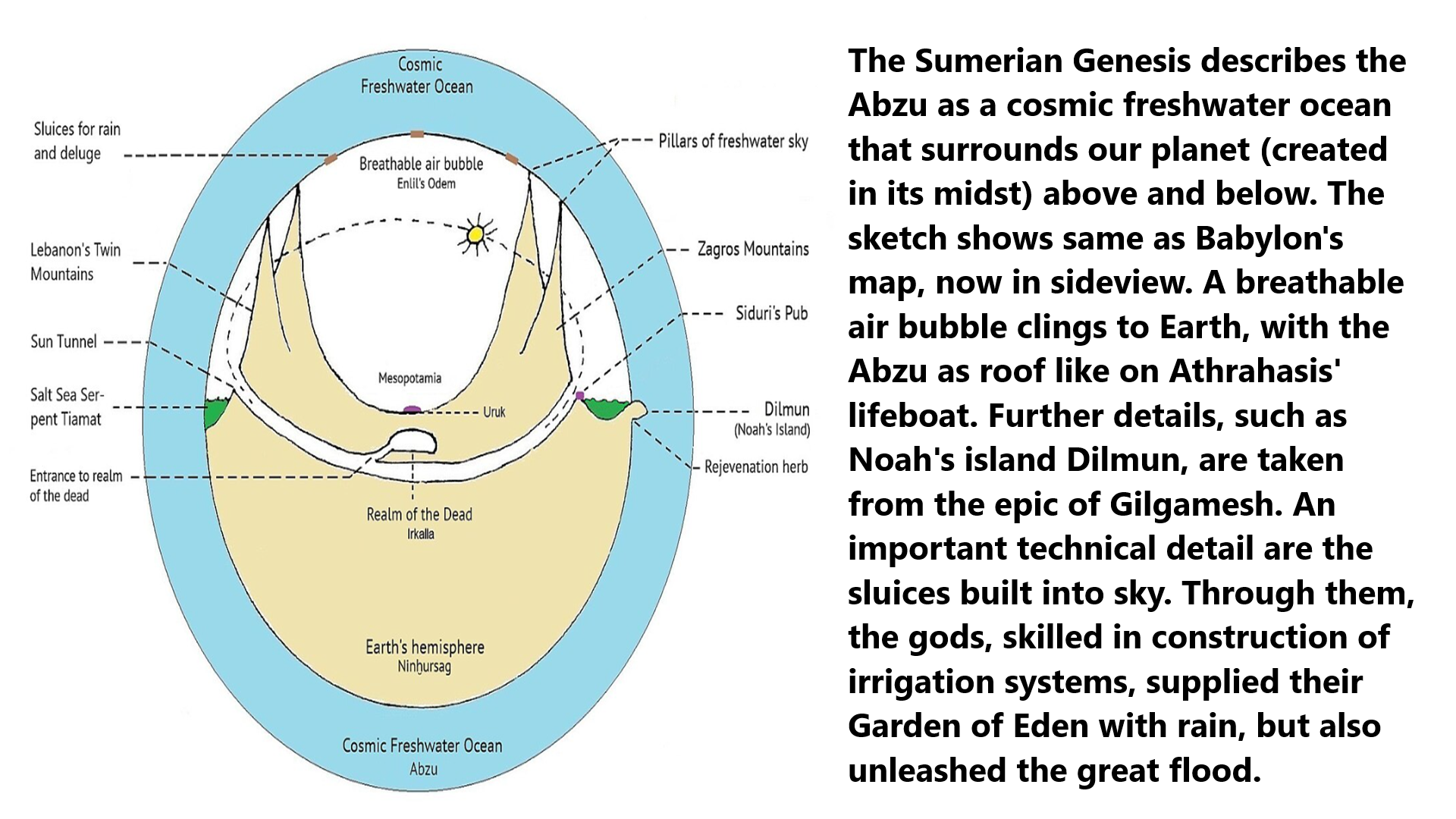
“The Sumerian Genesis describes the Abzu as a cosmic freshwater ocean that surrounds our planet (created in its midst) above and below. The sketch shows the same as Babylon’s map, now in side view. A breathable air bubble clings to Earth, with the Abzu as roof like on Athrahasis’ lifeboat. Further details, such as Noah’s island Dilmun, are taken from the epic of Gilgamesh. An important technical detail are the sluices built into sky. Through them, the gods, skilled in construction of irrigation systems, supplied their Garden of Eden with rain, but also unleashed the great flood.” ref
“Enki, “Lord of the Earth,” but “Ki” means “earth,” and there are theories that ki in this name has another origin, possibly king of unknown meaning, or “kur” meaning “mound.” The Eridu site demonstrated Enki’s existence more than 6,500 years ago.” ref
“Enki (Sumerian: 𒀭𒂗𒆠 DEN-KI) is the Sumerian god of water, knowledge (gestú), crafts (gašam), and creation (nudimmud), and one of the Anunnaki. He was later known as Ea (Akkadian: 𒀭𒂍𒀀) or Ae in Akkadian (Assyrian–Babylonian) religion, and is identified by some scholars with Ia in Canaanite religion. The name was rendered Aos in Greek sources (e.g. Damascius). He was originally the patron god of the city of Eridu, but later the influence of his cult spread throughout Mesopotamia and to the Canaanites, Hittites, and Hurrians. He was associated with the southern band of constellations called stars of Ea, but also with the constellation AŠ-IKU, the Field (Square of Pegasus). Beginning around the second millennium BCE, he was sometimes referred to in writing by the numeric ideogram for “40”, occasionally referred to as his “sacred number.” The planet Mercury, associated with Babylonian Nabu (the son of Marduk) was, in Sumerian times, identified with Enki, as was the star Canopus.” ref
“Many myths about Enki have been collected from various sites, stretching from Southern Iraq to the Levantine coast. He is mentioned in the earliest extant cuneiform inscriptions throughout the region and was prominent from the third millennium down to the Hellenistic period. The exact meaning of Enki’s name is uncertain: the common translation is “Lord of the Earth.” The Sumerian En is translated as a title equivalent to “lord” and was originally a title given to the High Priest. Ki means “earth”, but there are theories that ki in this name has another origin, possibly kig of unknown meaning, or kur meaning “mound”. The name Ea is allegedly Hurrian in origin while others claim that his name ‘Ea’ is possibly of Semitic origin and may be a derivation from the West-Semitic root *hyy meaning “life” in this case used for “spring”, “running water”. In Sumerian E-A means “the house of water”, and it has been suggested that this was originally the name for the shrine to the god at Eridu.” ref
“It has also been suggested that the original non-anthropomorphic divinity at Eridu was not Enki but Abzu. The emergence of Enki as the divine lover of Ninhursag, and the divine battle between the younger Igigi divinities and Abzu, saw the Abzu, the underground waters of the Aquifer, becoming the place in which the foundations of the temple were built. With some Sumerian deity names as Enlil there are variations like Elil. En means “Lord” and E means “temple”. It is likely that E-A is the Sumerian short form for “Lord of Water,” as Enki is a god of water. Ab in Abzu also means water. The main temple to Enki was called E-abzu, meaning “abzu temple” (also E-en-gur-a, meaning “house of the subterranean waters”), a ziggurat temple surrounded by Euphratean marshlands near the ancient Persian Gulf coastline at Eridu. It was the first temple known to have been built in Southern Iraq.” ref
“Four separate excavations at the site of Eridu have demonstrated the existence of a shrine dating back to the earliest Ubaid period, more than 6,500 years ago. Over the following 4,500 years, the temple was expanded 18 times, until it was abandoned during the Persian period. On this basis Thorkild Jacobsen has hypothesized that the original deity of the temple was Abzu, with his attributes later being taken by Enki over time. P. Steinkeller believes that, during the earliest period, Enki had a subordinate position to a goddess (possibly Ninhursag), taking the role of divine consort or high priest, later taking priority. The Enki temple had at its entrance a pool of fresh water, and excavation has found numerous carp bones, suggesting collective feasts. Carp are shown in the twin water flows running into the later God Enki, suggesting continuity of these features over a very long period. These features were found at all subsequent Sumerian temples, suggesting that this temple established the pattern for all subsequent Sumerian temples. “All rules laid down at Eridu were faithfully observed.” ref
“Enki was the keeper of the divine powers called Me, the gifts of civilization. He is often shown with the horned crown of divinity. On the Adda Seal, Enki is depicted with two streams of water flowing into each of his shoulders: one the Tigris, the other the Euphrates. Alongside him are two trees, symbolizing the male and female aspects of nature. He is shown wearing a flounced skirt and a cone-shaped hat. An eagle descends from above to land upon his outstretched right arm. This portrayal reflects Enki’s role as the god of water, life, and replenishment. Considered the master shaper of the world, god of wisdom and of all magic, Enki was characterized as the lord of the Abzu (Apsu in Akkadian), the freshwater sea or groundwater located within the earth. In the later Babylonian epic Enûma Eliš, Abzu, the “begetter of the gods”, is inert and sleepy but finds his peace disturbed by the younger gods, so sets out to destroy them.” ref
“His grandson Enki, chosen to represent the younger gods, puts a spell on Abzu “casting him into a deep sleep”, thereby confining him deep underground. Enki subsequently sets up his home “in the depths of the Abzu.” Enki thus takes on all of the functions of the Abzu, including his fertilising powers as lord of the waters and lord of semen. Early royal inscriptions from the third millennium BCE mention “the reeds of Enki”. Reeds were an important local building material, used for baskets and containers, and collected outside the city walls, where the dead or sick were often carried. This links Enki to the Kur, or underworld of Sumerian mythology. In another even older tradition, Nammu, the goddess of the primeval creative matter and the mother-goddess portrayed as having “given birth to the great gods,” was the mother of Enki, and as the watery creative force, was said to preexist Ea-Enki. Benito states “With Enki it is an interesting change of gender symbolism, the fertilising agent is also water, Sumerian “a” or “Ab” which also means “semen”. In one evocative passage in a Sumerian hymn, Enki stands at the empty riverbeds and fills them with his ‘water.” ref
Creation of life and sickness
“The cosmogenic myth common in Sumer was that of the hieros gamos, a sacred marriage where divine principles in the form of dualistic opposites came together as male and female to give birth to the cosmos. In the epic Enki and Ninhursag, Enki, as lord of Ab or fresh water, is living with his wife in the paradise of Dilmun where:
The land of Dilmun is a pure place, the land of Dilmun is a clean place,
The land of Dilmun is a clean place, the land of Dilmun is a bright place;
He who is alone laid himself down in Dilmun,
The place, after Enki is clean, that place is bright.
“Despite being a place where “the raven uttered no cries” and “the lion killed not, the wolf snatched not the lamb, unknown was the kid-killing dog, unknown was the grain devouring boar”, Dilmun had no water and Enki heard the cries of its goddess, Ninsikil, and orders the sun-god Utu to bring fresh water from the Earth for Dilmun. As a result,
Her City Drinks the Water of Abundance,
Dilmun Drinks the Water of Abundance,
Her wells of bitter water, behold they are become wells of good water,
Her fields and farms produced crops and grain,
Her city, behold it has become the house of the banks and quays of the land.” ref
“Dilmun was identified with Bahrain, whose name in Arabic means “two seas”, where the fresh waters of the Arabian aquifer mingle with the salt waters of the Persian Gulf. This mingling of waters was known in Sumerian as Nammu, and was identified as the mother of Enki. The subsequent tale, with similarities to the Biblical story of the forbidden fruit, repeats the story of how fresh water brings life to a barren land. Enki, the Water-Lord then “caused to flow the ‘water of the heart” and having fertilised his consort Ninhursag, also known as Ki or Earth, after “Nine days being her nine months, the months of ‘womanhood’… like good butter, Nintu, the mother of the land, …like good butter, gave birth to Ninsar, (Lady Greenery)”. When Ninhursag left him, as Water-Lord he came upon Ninsar (Lady Greenery). Not knowing her to be his daughter, and because she reminds him of his absent consort, Enki then seduces and has intercourse with her. Ninsar then gave birth to Ninkurra (Lady Fruitfulness or Lady Pasture), and leaves Enki alone again. A second time, Enki, in his loneliness finds and seduces Ninkurra, and from the union Ninkurra gave birth to Uttu (weaver or spider, the weaver of the web of life).” ref
“A third time Enki succumbs to temptation, and attempts seduction of Uttu. Upset about Enki’s reputation, Uttu consults Ninhursag, who, upset at the promiscuous wayward nature of her spouse, advises Uttu to avoid the riverbanks, the places likely to be affected by flooding, the home of Enki. In another version of this myth, Ninhursag takes Enki’s semen from Uttu’s womb and plants it in the earth where eight plants rapidly germinate. With his two-faced servant and steward Isimud, “Enki, in the swampland, in the swampland lies stretched out, ‘What is this (plant), what is this (plant).’ His messenger Isimud, answers him; ‘My king, this is the tree-plant’, he says to him. He cuts it off for him and he (Enki) eats it”. And so, despite warnings, Enki consumes the other seven fruit. Consuming his own semen, he falls pregnant (ill with swellings) in his jaw, his teeth, his mouth, his hip, his throat, his limbs, his side and his rib. The gods are at a loss to know what to do; chagrined they “sit in the dust”. As Enki lacks a birth canal through which to give birth, he seems to be dying with swellings. The fox then asks Enlil, King of the Gods, “If I bring Ninhursag before thee, what shall be my reward?” Ninhursag’s sacred fox then fetches the goddess.” ref
“Ninhursag relents and takes Enki’s Ab (water, or semen) into her body, and gives birth to gods of healing of each part of the body: Abu for the jaw, Nanshe for the throat, Nintul for the hip, Ninsutu for the tooth, Ninkasi for the mouth, Dazimua for the side, Enshagag for the limbs. The last one, Ninti (Lady Rib), is also a pun on Lady Life, a title of Ninhursag herself. The story thus symbolically reflects the way in which life is brought forth through the addition of water to the land, and once it grows, water is required to bring plants to fruit. It also counsels balance and responsibility, nothing to excess. Ninti, the title of Ninhursag, also means “the mother of all living” and was a title later given to the Hurrian goddess Kheba. This is also the title given in the Bible to Eve, the Hebrew and Aramaic Ḥawwah (חוה), who was made from the rib of Adam, in a strange reflection of the Sumerian myth, in which Adam – not Enki – walks in the Garden of Paradise.” ref
Making of man
“After six generations of gods, in the Babylonian Enûma Eliš, in the seventh generation, (Akkadian “shapattu” or sabath), the younger Igigi gods, the sons and daughters of Enlil and Ninlil, go on strike and refuse their duties of keeping creation working. Abzu, god of fresh water, co-creator of the cosmos, threatens to destroy the world with his waters, and the gods gather in terror. Enki promises to help and puts Abzu to sleep, confining him in irrigation canals and places him in the Kur, beneath his city of Eridu. But the universe is still threatened, as Tiamat, angry at the imprisonment of Abzu and at the prompting of her son and vizier Kingu, decides to take back creation herself. The gods gather again in terror and turn to Enki for help, but Enki – who harnessed Abzu, Tiamat’s consort, for irrigation – refuses to get involved. The gods then seek help elsewhere, and the patriarchal Enlil, their father, god of Nippur, promises to solve the problem if they make him King of the Gods. In the Babylonian tale, Enlil’s role is taken by Marduk, Enki’s son, and in the Assyrian version it is Ashur.” ref
“After dispatching Tiamat with the “arrows of his winds” down her throat and constructing the heavens with the arch of her ribs, Enlil places her tail in the sky as the Milky Way, and her crying eyes become the source of the Tigris and Euphrates. But there is still the problem of “who will keep the cosmos working”. Enki, who might have otherwise come to their aid, is lying in a deep sleep and fails to hear their cries. His mother Nammu (creatrix also of Abzu and Tiamat) “brings the tears of the gods” before Enki and says
Oh my son, arise from thy bed, from thy (slumber), work what is wise,
Fashion servants for the Gods, may they produce their (bread?).” ref
“Enki then advises that they create a servant of the gods, humankind, out of clay and blood. Against Enki’s wish, the gods decide to slay Kingu, and Enki finally consents to use Kingu’s blood to make the first human, with whom Enki always later has a close relationship, the first of the seven sages, seven wise men or “Abgallu” (ab = water, gal = great, lu = man), also known as Adapa. Enki assembles a team of divinities to help him, creating a host of “good and princely fashioners”. He tells his mother:
Oh my mother, the creature whose name thou has uttered, it exists,
Bind upon it the (will?) of the Gods;
Mix the heart of clay that is over the Abyss,
The good and princely fashioners will thicken the clay
Thou, do thou bring the limbs into existence;
Ninmah (Ninhursag, his wife and consort) will work above thee
(Nintu?) (goddess of birth) will stand by thy fashioning;
Oh my mother, decree thou its (the new born’s) fate.” ref
Adapa, the first man fashioned, later goes and acts as the advisor to the King of Eridu, when in the Sumerian King-List, the me of “kingship descends on Eridu.” Samuel Noah Kramer believes that behind this myth of Enki’s confinement of Abzu lies an older one of the struggle between Enki and the Dragon Kur (the underworld). The Atrahasis-Epos has it that Enlil requested from Nammu the creation of humans. And Nammu told him that with the help of Enki (her son) she can create humans in the image of gods.” ref
Uniter of languages
“In the Sumerian epic entitled Enmerkar and the Lord of Aratta, in a speech of Enmerkar, an introductory spell appears, recounting Enki having had mankind communicate in one language (following Jay Crisostomo 2019); or, in other accounts, it is a hymn imploring Enki to do so. In either case, Enki “facilitated the debates between [the two kings] by allowing the world to speak one language,” the presumed superior language of the tablet, i.e. Sumerian.” ref
“Jay Crisostomo’s 2019 translation, based on the recent work of C. Mittermayer is:
At that time, as there was no snake, as there was no scorpion,
as there was no hyena, as there was no lion,
as there was no dog or wolf, as there was no fear or trembling
— as humans had no rival.
It was then that the lands of Subur [and] Hamazi,
the distinctly-tongued, Sumer, the great mountain, the essence of nobility,
Akkad, the land possessing the befitting,
and the land of Martu, lying in safety
— the totality of heaven and earth, the well-guarded people, [all] proclaimed Enlil in a single language.
Enki, the lord of abundance and true word,
the lord chosen in wisdom who watches over the land,
the expert of all the gods, the chosen in wisdom,
the lord of Eridu, [Enki] placed an alteration of the language in their mouths.” ref
“The speech of humanity is one.
S.N. Kramer’s 1940 translation is as follows:
Once upon a time there was no snake, there was no scorpion,
There was no hyena, there was no lion,
There was no wild dog, no wolf,
There was no fear, no terror,
Man had no rival.
In those days, the lands of Subur (and) Hamazi,
Harmony-tongued Sumer, the great land of the decrees of princeship,
Uri, the land having all that is appropriate,
The land Martu, resting in security,
The whole universe, the people in unison
To Enlil in one tongue [spoke].
(Then) Enki, the lord of abundance (whose) commands are trustworthy,
The lord of wisdom, who understands the land,
The leader of the gods,
Endowed with wisdom, the lord of Eridu
Changed the speech in their mouths, [brought] contention into it,
Into the speech of man that (until then) had been one.” ref
The deluge
Main article: Eridu Genesis
“In the Sumerian version of the flood myth, the causes of the flood and the reasons for the hero’s survival are unknown due to the fact that the beginning of the tablet describing the story has been destroyed. Nonetheless, Kramer has stated that it can probably be reasonably inferred that the hero Ziusudra survives due to Enki’s aid because that is what happens in the later Akkadian and Babylonian versions of the story.” ref
“In the later Legend of Atrahasis, Enlil, the King of the Gods, sets out to eliminate humanity, whose noise is disturbing his rest. He successively sends drought, famine and plague to eliminate humanity, but Enki thwarts his half-brother’s plans by teaching Atrahasis how to counter these threats. Each time, Atrahasis asks the population to abandon worship of all gods except the one responsible for the calamity, and this seems to shame them into relenting. Humans, however, proliferate a fourth time. Enraged, Enlil convenes a Council of Deities and gets them to promise not to tell humankind that he plans their total annihilation. Enki does not tell Atrahasis directly, but speaks to him in secret via a reed wall. He instructs Atrahasis to build a boat in order to rescue his family and other living creatures from the coming deluge. After the seven-day deluge, the flood hero frees a swallow, a raven, and a dove in an effort to find if the flood waters have receded. Upon landing, a sacrifice is made to the gods. Enlil is angry his will has been thwarted yet again, and Enki is named as the culprit. Enki explains that Enlil is unfair to punish the guiltless, and the gods institute measures to ensure that humanity does not become too populous in the future. This is one of the oldest of the surviving Middle Eastern deluge myths.” ref
Enki and Inanna
“The myth Enki and Inanna tells the story of how the young goddess of the É-anna temple of Uruk feasts with her father Enki. The two deities participate in a drinking competition; then, Enki, thoroughly inebriated, gives Inanna all of the mes. The next morning, when Enki awakes with a hangover, he asks his servant Isimud for the mes, only to be informed that he has given them to Inanna. Upset, he sends Galla to recover them. Inanna sails away in the boat of heaven and arrives safely back at the quay of Uruk. Eventually, Enki admits his defeat and accepts a peace treaty with Uruk. Politically, this myth would seem to indicate events of an early period when political authority passed from Enki’s city of Eridu to Inanna’s city of Uruk.” ref
“In the myth of Inanna’s Descent, Inanna, in order to console her grieving sister Ereshkigal, who is mourning the death of her husband Gugalana (gu ‘bull’, gal ‘big’, ana ‘sky/heaven’), slain by Gilgamesh and Enkidu, sets out to visit her sister. Inanna tells her servant Ninshubur (‘Lady Evening’, a reference to Inanna’s role as the evening star) to get help from Anu, Enlil or Enki if she does not return in three days. After Inanna has not come back, Ninshubur approaches Anu, only to be told that he knows the goddess’s strength and her ability to take care of herself. While Enlil tells Ninshubur he is busy running the cosmos, Enki immediately expresses concern and dispatches his Galla (Galaturra or Kurgarra, sexless beings created from the dirt from beneath the god’s finger-nails) to recover the young goddess. These beings may be the origin of the Greco-Roman Galli, androgynous beings of the third sex who played an important part in early religious rituals.” ref
“In the story, Inanna and Shukaletuda, Shukaletuda, the gardener, set by Enki to care for the date palm he had created, finds Inanna sleeping under the palm tree and rapes the goddess in her sleep. Awaking, she discovers that she has been violated and seeks to punish the miscreant. Shukaletuda seeks protection from Enki, whom Bottéro believes to be his father. In classic Enkian fashion, the father advises Shukaletuda to hide in the city where Inanna will not be able to find him. Enki, as the protector of whoever comes to seek his help, and as the empowerer of Inanna, here challenges the young impetuous goddess to control her anger so as to be better able to function as a great judge. Eventually, after cooling her anger, she too seeks the help of Enki, as spokesperson of the “assembly of the gods”, the Igigi and the Anunnaki. After she presents her case, Enki sees that justice needs to be done and promises help, delivering knowledge of where the miscreant is hiding.” ref
“Enki and later Ea were apparently depicted, sometimes, as a man covered with the skin of a fish, and this representation, as likewise the name of his temple E-apsu, “house of the watery deep”, points decidedly to his original character as a god of the waters (see Oannes). Around the excavation of the 18 shrines found on the spot, thousands of carp bones were found, consumed possibly in feasts to the god. Of his cult at Eridu, which goes back to the oldest period of Mesopotamian history, nothing definite is known except that his temple was also associated with Ninhursag’s temple which was called Esaggila, “the lofty head house” (E, house, sag, head, ila, high; or Akkadian goddess = Ila), a name shared with Marduk’s temple in Babylon, pointing to a staged tower or ziggurat (as with the temple of Enlil at Nippur, which was known as E-kur (kur, hill)), and that incantations, involving ceremonial rites in which water as a sacred element played a prominent part, formed a feature of his worship. This seems also implicated in the epic of the hieros gamos or sacred marriage of Enki and Ninhursag (above), which seems an etiological myth of the fertilisation of the dry ground by the coming of irrigation water (from Sumerian a, ab, water or semen).” ref
“The early inscriptions of Urukagina, in fact, go so far as to suggest that the divine pair, Enki and Ninki, were the progenitors of seven pairs of gods, including Enki as god of Eridu, Enlil of Nippur, and Su’en (or Sin) of Ur, and were themselves the children of An (sky, heaven) and Ki (earth). The pool of the Abzu at the front of his temple was adopted also at the temple to Nanna (Akkadian Sin) the Moon, at Ur, and spread from there throughout the Middle East. It is believed to remain today as the sacred pool at Mosques or as the holy water font in Catholic or Eastern Orthodox churches. Whether Eridu at one time also played an important political role in Sumerian affairs is not certain, though not improbable. At all events the prominence of “Ea” led, as in the case of Nippur, to the survival of Eridu as a sacred city, long after it had ceased to have any significance as a political center. Myths in which Ea figures prominently have been found in Assurbanipal‘s library, and in the Hattusas archive in Hittite Anatolia. As Ea, Enki had a wide influence outside of Sumer, being equated with El (at Ugarit) and possibly Yah (at Ebla) in the Canaanite ‘ilhm pantheon.” ref
“He is also found in Hurrian and Hittite mythology as a god of contracts, and is particularly favorable to humankind. It has been suggested that etymologically the name Ea comes from the term *hyy (life), referring to Enki’s waters as life-giving. Enki/Ea is essentially a god of civilization, wisdom, and culture. He was also the creator and protector of man, and of the world in general. Traces of this version of Ea appear in the Marduk epic, celebrating the achievements of this god and the close connection between the Ea cult at Eridu and that of Marduk. The correlation between the two rises from two other important connections: (1) that the name of Marduk’s sanctuary at Babylon bears the same name, Esaggila, as that of a temple in Eridu, and (2) that Marduk is generally termed the son of Ea, who derives his powers from the voluntary abdication of the father in favor of his son. Accordingly, the incantations originally composed for the Ea cult were re-edited by the priests of Babylon and adapted to the worship of Marduk, and, similarly, the hymns to Marduk betray traces of the transfer to Marduk of attributes which originally belonged to Ea.” ref
“It is, however, as the third figure in the triad (the two other members of which were Anu and Enlil) that Ea acquires his permanent place in the pantheon. To him was assigned the control of the watery element, and in this capacity he becomes the shar apsi; i.e. king of the Apsu or “the abyss”. The Apsu was figured as the abyss of water beneath the earth, and since the gathering place of the dead, known as Aralu, was situated near the confines of the Apsu, he was also designated as En -Ki; i.e. “lord of that which is below”, in contrast to Anu, who was the lord of the “above” or the heavens. The cult of Ea extended throughout Babylonia and Assyria. We find temples and shrines erected in his honour, e.g. at Nippur, Girsu, Ur, Babylon, Sippar, and Nineveh, and the numerous epithets given to him, as well as the various forms under which the god appears, alike bear witness to the popularity which he enjoyed from the earliest to the latest period of Babylonian-Assyrian history. The consort of Ea, known as Ninhursag, Ki, Uriash Damkina, “lady of that which is below”, or Damgalnunna, “big lady of the waters”, originally was fully equal with Ea, but in more patriarchal Assyrian and Neo-Babylonian times plays a part merely in association with her lord. Generally, however, Enki seems to be a reflection of pre-patriarchal times, in which relations between the sexes were characterized by a situation of greater gender equality. In his character, he prefers persuasion to conflict, which he seeks to avoid if possible.” ref
Ea and West Semitic deities
“In 1964, a team of Italian archaeologists under the direction of Paolo Matthiae of the University of Rome La Sapienza performed a series of excavations of material from the third-millennium BCE city of Ebla. Much of the written material found in these digs was later translated by Giovanni Pettinato. Among other conclusions, he found a tendency among the inhabitants of Ebla, after the reign of Sargon of Akkad, to replace the name of El, king of the gods of the Canaanite pantheon (found in names such as Mikael and Ishmael), with Ia (Mikaia, Ishmaia). Jean Bottéro (1952) and others suggested that Ia, in this case, is a West Semitic (Canaanite) way of pronouncing the Akkadian name Ea. Scholars largely reject the theory identifying this Ia with the Israelite theonym YHWH, while explaining how it might have been misinterpreted. Ia has also been compared by William Hallo with the Ugaritic god Yamm (“Sea”), (also called Judge Nahar, or Judge River) whose earlier name in at least one ancient source was Yaw or Ya’a. Ea was also known as Dagon and Uanna (Grecised Oannes), the first of the Seven Sages.” ref
“Atra-Hasis (Akkadian: 𒀜𒊏𒄩𒋀, romanized: Atra-ḫasīs) is an 18th-century BCE Akkadian epic, recorded in various versions on clay tablets, named for its protagonist, Atrahasis (‘exceedingly wise’). The Atra-Hasis tablets include both a cosmological creation myth and one of three surviving Babylonian flood myths. The name “Atra-Hasis” also appears, as a king of Shuruppak on the Euphrates in the times before a flood, on one of the Sumerian King Lists. The oldest known copy of the epic tradition concerning Atrahasis can be dated by colophon (scribal identification) to the reign of Hammurabi’s great-grandson, Ammi-Saduqa (1646–1626 BCE). However, various Old Babylonian dialect fragments exist, and the epic continued to be copied into the first millennium BCE.” ref
“The story of Atrahasis also exists in a later Assyrian dialect version, first rediscovered in the Library of Ashurbanipal, though its translations have been uncertain due to the artifact being in fragmentary condition and containing ambiguous words. Nonetheless, its fragments were first assembled and translated by George Smith as The Chaldean Account of Genesis, the hero of which had his name corrected to Atra-Hasis by Heinrich Zimmern in 1899. In 1965, Wilfred G. Lambert and Alan Millard published many additional texts belonging to the epic, including an Old Babylonian copy (written c. 1650 BCE) which is the most complete recension of the tale to have survived. These new texts greatly increased knowledge of the epic and were the basis for Lambert and Millard’s first English translation of the Atrahasis epic in something approaching entirety. A further fragment was recovered in Ugarit.” ref
Myths and facts
The epos of Atra-Hasis contains the creation myth of Anu, Enlil, and Enki—the pantheon of oldest known gods (dingirs; Sumerian: 𒀭, lit. ’divines’). Also called Anunnaki and Igigi, they seem to have been united in an organization similar to that which existed in Greece between Zeus – as ‘pure spirit or air’ the leading party – and the groups round Poseidon (ocean) and Hades (earth). It is not unlikely that the story refers to the era of the Neolithic Revolution, when Homo sapiens, evolving in form of small hordes of hunter-gatherers, began to establish political inter-group organizations, in order to be able to erect impressive monuments such as those at Göbekli Tepe (so K. Schmidt’s thesis), developing agriculture and transforming Mesopotamians steppe into the blooming landscape that went down in myths of mankind as Garden of Eden.” ref
Overview
“In the main, the epic reports on a conflict between some of the first Sumerian gods and draws on the earlier myth of the separation of air and earth (‘above’ and ‘below’) in the midst of the cosmic freshwater primordial ocean to clarify their relationship. Enlil represents the leading party in the council of gods; the party of Anunnaki around Anu belongs more to the upper heaven, and that of Igigi around Enki more to that below the earth (half) sphere. All three parties are bound by the Tablet of Destinies, which Enlil is the only one to possess. In the Sumerian myths, its bestowed on him by the earth mother goddess Ninḫursanga herself (cf. Anzu myth).” ref
“It gives him power over the other parties of gods, because only he, as the chief strategist of the divine tribal alliance and ruler of the universe has the ability to transform present circumstances back into their original state – thereby redefining the course of fate. As a permanent legal document the tablet was provided with a seal, a sign mechanically applied by means of a special technique, which in ancient Mesopotamia was regarded as a symbol of a contract. Contracts have been directly related to tribute payments to be made: often parts of the food produced, but generally assistance in battlel or abour, such as the construction of mighty irrigation channels in the epic of Atra-Hasis. As far as the male groups of gods were concerned, the separate task of reproduction fell to the seven divine wombs, the shassuratu presided over by Ninḫursanga (Mami).” ref
“The plot of the epic follows a simple pattern:
- There is an organisation of at least three male parties of gods; they seem to specialise in different areas (‘thinkers and workers’)
- The gods doing hardest farm lab are dissatisfied and rise up against Enlil (master of the universe).
- With help of divine women the victorious party arranges the production of a first pair of humans who, with all their descendants, are to serve all the gods as labour slaves (sacrificing mass) for eternity.
- As result of the unrestrained multiplication of the workers, an overpopulation crisis breaks out, which the upper gods try to get under control, among others by triggering a global flooding to wash humanity as a whole off the face of mother earth.” ref
“As is well known, this genocidal project failed. The reason for this divine misadventure was not so much the human’s shipbuilding skills (Noah’s Ark), but the quarrelling between the gods. Finally, they seal their fate as well as that of mankind by agreeing on a utopian method to regulate the reproduction of their creatures to a bearable level. Two aspects of Athra-Hasis were adopted in the Epic of Gilgamesh around 1200 BC: the primal scene of the 7-day lasted mating of an rebel with a temple prostitute (Enkidu’s domestication) and the devastating deluge. Obviously, the authors of Old Testament also referred to the epic, so we know former as Adam and Eve‘s creation and latter as the Flood unleashed by the omnipotent but, in this case, again, failing god YHWH. The God-fearing priest Atraḫasis (the only one to survive the attempted delation with his wife and sons, ensuring continued existence of artificially constructed menkind) appears there as Noah.” ref
Tablet 1
“The epos taking place according to its incipit, “When the gods had to work like humans (inuma ilu awilum = when the gods were humans)”, there was a quarrel between the upper Anunnaki and the Igigu, the lower gods. While the latter had the task of ensuring the supply of the land through construction of irrigation canals, for which they must dig out the beds of big rivers, the Anunnaki ruled from above – presumably watching over the implementation of their plans and dividing the fruits of this great civilising project as they saw fit. After 40 years, however, the lesser gods rebelled and refused to do strenuous labor. At night, they surrounded the dwelling place of Enlil, who was considered the main god of Sumerian civilisation, the creator of air and earth in the midst of the cosmic ocean.” ref
“Enlil was surprised and called for Anu and Enki. Nusku, one of the sons and Enlil’s ambassador here, tried to negotiate with the rebellious party, but was unsuccessful. Enlil, who also was the benevolent, wise leader of all the gods, did’nt want a battle with the risk of serious injuries and deaths, and to avoid this he came up with the idea of starting to produce humans from a sacrifice to do the hard labor instead of the rebellious gods. He asked Mami – leader of the 7 goddess wombs – to do this. Mami declared that she could only fulfill this request with Enki’s assistance. Enki, agreeing, advised the assembly of all gods that they should first cleanse themselves for everything else.” ref
“They do. On the fifteenth day of this project, he cut up Geshtu-E (‘ear’ or ‘wisdom’; ‘a god who had intelligence’) into pieces and instructed the gods to wash themselves thoroughly with the spilt blood. He then began to create the first human being, so-called Widimmu, to the sound of drums. For this, he took clay from the soil of the steppe (Mami was regarded as the primordial mother earth, so the divine wombs come into play here), which he mixed with some of the flesh and blood. Finally, he added a touch of cosmic water and brought the creature into its living form. When it awoke, Mami approached, handed it a carrying basket and taught it to work for the gods from then on.” ref
“(There is a gap in the tablet here in which it could have been described how Widimmu suffered from the loneliness of his working day and nothing the gods advised him to do was able to restore his zest for life. So the gods may have decided to give him a wife to cheer him up. Where she came from remains open due to the missing passage – there may have been a similarly conceived act of creation. However, this assumption would conflict with the Mosaic version of the events in the Garden of Eden, according to which the woman was made from a surgically amputated body part of Adam who had been put into deep narcotic sleep for this purpose, with the argument “It is not good that the man should be alone; therefore let Us make a woman (Eve) who fit to him and do help.” Gen. 2.18)” ref
“To complete the construction of humans in the optimal way, Mami encouraged the young couple to celebrate a seven day feast in honor of Isthar, the goddess of war and sexuality.* Both obeyed. After 9 months, the land of the gods gave birth to its first human child, whose purpose of existence was similar to that of his parents.” ref
“(* Cf. Gilgamesh epic: there, too, the gods arranged a seven-day sexual act to pacify a kind of cold war. Protagonists are Enkidu: an almost invincible, rebellious animal-man also created from clay, and the female temple servant Shamkat, endowed with all advantages necessary for that purpose. Enkidu, who had previously destroyed so many animal traps with his fierce group of relatives, fell into this new type of trap. After having sex for 7 days, he was ‘weakened’: the herd of animals he had been leading fled into the steppe in horror. He was shocked of his separation, but Shamkat tried to comfort him: “Don’t grieve; you have knowledge now, just like the gods!” See also Adam’s and Eve’s enjoyment of the Fruit of the Tree of Knowledge, in Eden.)” ref
“1200 years later, humans had multiplied to such an extent that they disturbed the gods with their noise. Enlil was annoyed and decided that Namtar, his god of underworld, should carry off most of humans with frost fever – a great extinction began. Enki, probably worried that he would end up having to work again himself, approached his faithful priest Atraḫasis and advised him to do following: The other gods should no longer be worshipped, but only Namtar. This flattered the god of deadly diseases so much that as soon as he had begun his pandemic work, he ceased to eliminate people.” ref
“Tablet II is about the unstoppable increase in overpopulation. After another 1200 years there were many more humans, they roamed around like roaring herds of cattle. Because the gods in upper part of heaven could no longer even sleep, Enlil sent Adad and, again 1200 years later, the fertility goddess Nisaba to devastate the land with storms and dry up the harvests. Enki – dwelling in the lower part of the sky – told his priest Atraḫasis what to do about it each time: Only Adad and Nisaba should sacrifice, and the other gods should left to starve. The pious priest acted according to this divine advice; Adad and Nisaba were so ashamed of this undeserved favor that they abandoned their endeavor. Enlil now completely enraged against Enki and decreed that a mighty flood should consume all of humanity. In addition, he made Enki swear before the Anunnaki that he would not speak another word to humans; he then began to consult with the assembled gods about the exact date and duration of the deluge to be unleashed.” ref
“(Enki in his relation to Enlil can be seen to have parallels to Prometheus rebelling against Zeus. Zeus was also originally the wise leader of a political organization (primeval Athens), in which the double party of Titans Prometheus and Epimetheus embodied the inferior gods. According to the story, Zeus’ character changed after a period of flourishing civilisation: he became stingy and unjust. In any case, these are the arguments Prometheus used to justify his uprising against ‘heaven’. Zeus solved this revolt by producing Pandora as Epimentheus’ fatal wedding gift. Similarly to Prometheus, Enki defies the orders of the upper gods, who now harbor genocidal intentions against the humans, and proves to be the benefactor of these creatures who were only created as labor slaves to pacify the rebellion of the lower gods around Enki.)” ref
“Tablet III contains the flood myth. Well informed with all details, Enki went to his priest’s reed hut, but waited until Atraḫasis began to lie down to sleep. Then, speaking cunningly to the hut’s wall so as not to breach the contract, Enki told ‘it’ what to do: ‘Separate yourself from your house, build a ship, spurn your possessions, save your life.’ The ship should be cube-shaped and also be watertight from above with a roof “like Abzu” itself. Atraḫasis should not tell anyone about the coming flood, take a large supply of food with him (including live birds and even fish, as the poet added with humorous irony), and keep an eye on the hourglass for seven days from the start of the catastrophe. So the priest ‘Extremely Wise‘ hurriedly left his belongings under a pretense and began building the ship. He invited his neighbors and relatives to help and unscrupulous promised that the reward would soon rain richly from the sky. The deadline was pressing, so he organised a big party to attract more workers. He himself was unable to eat during the lavish feast, so nauseous was he with fear of the impending punishment of the gods.” ref
“When Adad gathered the clouds and the winds began to roar from all ends of the world, Atraḫasis and a few selected humans (at least one woman, the master’s sons too) climbed into the ship and sealed its entrance hatch from inside with earth pitch. The ark swirled like a pot on the waves of the mighty flood thundering down from the open floodgates of the cosmic primordial ocean. And how furious Enlil was at his foiled plan to destroy mankind! – The other gods, however, suffered from hunger, as they were unable to find any more humans to feed them in the midst of the raging chaos. They cry at the immense destruction.” ref
“A few lines are missing here again, but these can be added according to the Epic of Gilgamesh: After the ark is stranded high up on Mount Nisir, Uta-napišti (the name of Atraḫasis in the Epic of Gilgamesh) sends out three birds – presumably at daily intervals: a dove, a swallow, and a raven. The raven, which was the least able to fly, did not return, so Utanpištim knew that the land – probably still hidden from his own view under thick clouds – was accessible again.” ref
“Atraḫasis descended from his ark and began to offer a food sacrifice to all the gods indiscriminately with a zeal eager to serve. How happy the gods were who had been starving for so long! As if they were flies lured by the scent, they swarmed in from all sides to the altar’s fire and began to feast to their hearts’ – for which they later endowed Anthrahais-Noah with their immortality in gratitude and settled him with his wife on the island of Dilmun on the distant edge of the world (see Gilgamesh flood myth).” ref
“Enlil, however, who as a wise ruler was responsible for the welfare of this great civilization, was still furious with Enki, the culprit whose treachery had once again enabled some humans to survive the genocide what was planned this time. Enki, however, as always never at a loss for creative ideas, devised a way that he hoped would finally solve the problem caused by the quarreling gods themselves. He decreed that from now on the humans would be familiarised with suffering and death from birth, that there would be barren and untouchable women and that their lifespan would be severely limited from the outset (in biblical terms to 120 years), in the hope that their reproduction would be regulated in future. With this promise that the gods would have sufficient living space of their own on earth for all time, Enlil could be content and make peace with Enki.” ref
Alterations and adaptations
“In later versions of the flood story, contained in the Epic of Gilgamesh and the Eridu Genesis, the hero is not named Atra-Hasis. In Gilgamesh, the name of the flood hero is Utnapishtim, who is said to be the son of Ubara-Tutu, king of Shuruppak: “Gilgamesh spoke to Utnapishtim, the Faraway… O man of Shuruppak, son of Ubara-Tutu.” Many available tablets comprising the Sumerian King Lists support the lineage of the flood hero given in Gilgamesh by omitting a king named Shuruppak as a historical ruler of Shuruppak, implying a belief that the flood story took place after or during the rule of Ubara-Tutu. In the Epic of Gilgamesh, first recorded in the 17th century BCE (i.e., the Old Babylonian Empire), the hero is named Ziusudra, who also appears in the Instructions of Shuruppak as the son of the eponymous Shuruppak, who himself is called the son of Ubara-Tutu. The “Sumerian King Lists” also make no mention of Atra-Hasis, Utnapishtim, or Ziusudra. Tablet “WB 62”, however, provides a different chronology: Atra-Hasis is listed as a ruler of Shuruppak and a “gudug” priest, preceded by his father Shuruppak, who is, in turn, preceded by his father Ubara-Tutu, as in “The Instructions of Shuruppak”. This tablet is unique in that it mentions both Shuruppak and Atra-Hasis.” ref
Gilgamesh and the flood myth
“Subsequent versions of the flood myth in the Ancient Near East evidently alter (omit and/or editorially change) information about the flood and the flood hero found in the original Atra-Hasis story. In particular, a lost, intermediate version of the Atra-Hasis flood myth seems to have been paraphrased or copied in a late edition of the Epic of Gilgamesh (Tablet XI). This modern addition of Gilgamesh, known as the ‘standard version’, is traditionally associated with the Babylonian scribe Sîn-lēqi-unninni (circa 1300–1000 BCE), though some minor changes may have been made since his time. Regarding the editorial changes to the Atra-Hasis text in Gilgamesh, Jeffrey H. Tigay comments: “The dropping of individual lines between others which are preserved, but are not synonymous with them, appears to be a more deliberate editorial act. These lines share a common theme, the hunger and thirst of the gods during the flood.” ref
Alterations
“Examples of alterations to the Atra-Hasis story in Gilgamesh include:
- Omitting information, for example:
- The hero being at a banquet when the storm and flood begins: “He invited his people…to a banquet… He sent his family on board. They ate, and drank. But he [Atrahasis] was in and out. He could not sit, could not crouch, for his heart was broken and he was vomiting gall.”
- “She was surfeited with grief and thirsted for beer.”
- “From hunger they were suffering cramps.”
- Editorial changes, for example:
- “Like dragonflies they have filled the river” was changed to “Like the spawn of fishes, they fill the sea.”
- Weakening of anthropomorphic descriptions of the gods, for example:
“Genesis creation: suggests creatio ex nihilo (‘creation from nothing’), God creates light (day 1); the sky (day 2); the earth, seas, and vegetation (day 3); the sun and moon (day 4); animals of the air and sea (day 5); and land animals and humans (day 6). Genesis 1: verse 1:1 consists of seven words, verse 1:2 has fourteen, and 2:1–3 has 35 words (5×7); Elohim is mentioned 35 times, “heaven/firmament” and “earth” 21 times each. Genesis 1 and 2, “In the beginning when God created the heavens and the earth, the earth was a formless void …” This translation suggests that earth, in some way, already existed when God began his creative activity. The inchoate (just begun and so not fully formed or developed) earth and the heavens in the sense of the air/wind were already in existence in Gen.” ref

The Babylonian Universe Newly Interpreted
“Few studies in ancient cosmology can more entertain or instruct the investigator of to-day than a careful comparison of the seven diagrams published as correct pictures of the Babylonian universe in the works named below. No two of the seven agree. Moreover, the first represents the Zodiac as at a vast distance above the sphere of the fixed stars, a proceeding which at the start disarranges all ordinary astronomic ideas. Equally unpicturable in my imagination is the seventh of the series, the world sketched by Radau. Again and again have I tried to construct it in thought, but every time have failed. Even Jensen in his great work gives us for “the place of the Convocation of the Gods” (Du-azag), only a pitch-dark cavern in the thin crust of his sea-filled hemispherical earth, and has no place for Hades but another cavern located in the same thin crust and oddly enough far above the cave of the gods. Surely there is a call for new attempts to think the thoughts of these ancient Semites after them.” ref
“The circulation of Earth’s atmosphere and oceans would be very simple, and straightforward if it were not for the planet’s shape and rotation. That revolutionary idea that the Earth was essentially a rotating sphere did not appear until the sixteenth century CE. Earlier ideas had been that the Earth was flat surrounded by a dome or spheres that held the Sun, Moon, the known planets, and stars. Later it was more generally recognized that the Earth was a globe, surrounded by those spheres. The origins of many of these ideas are lost in the depths of time, but here are some of the highlights.” ref
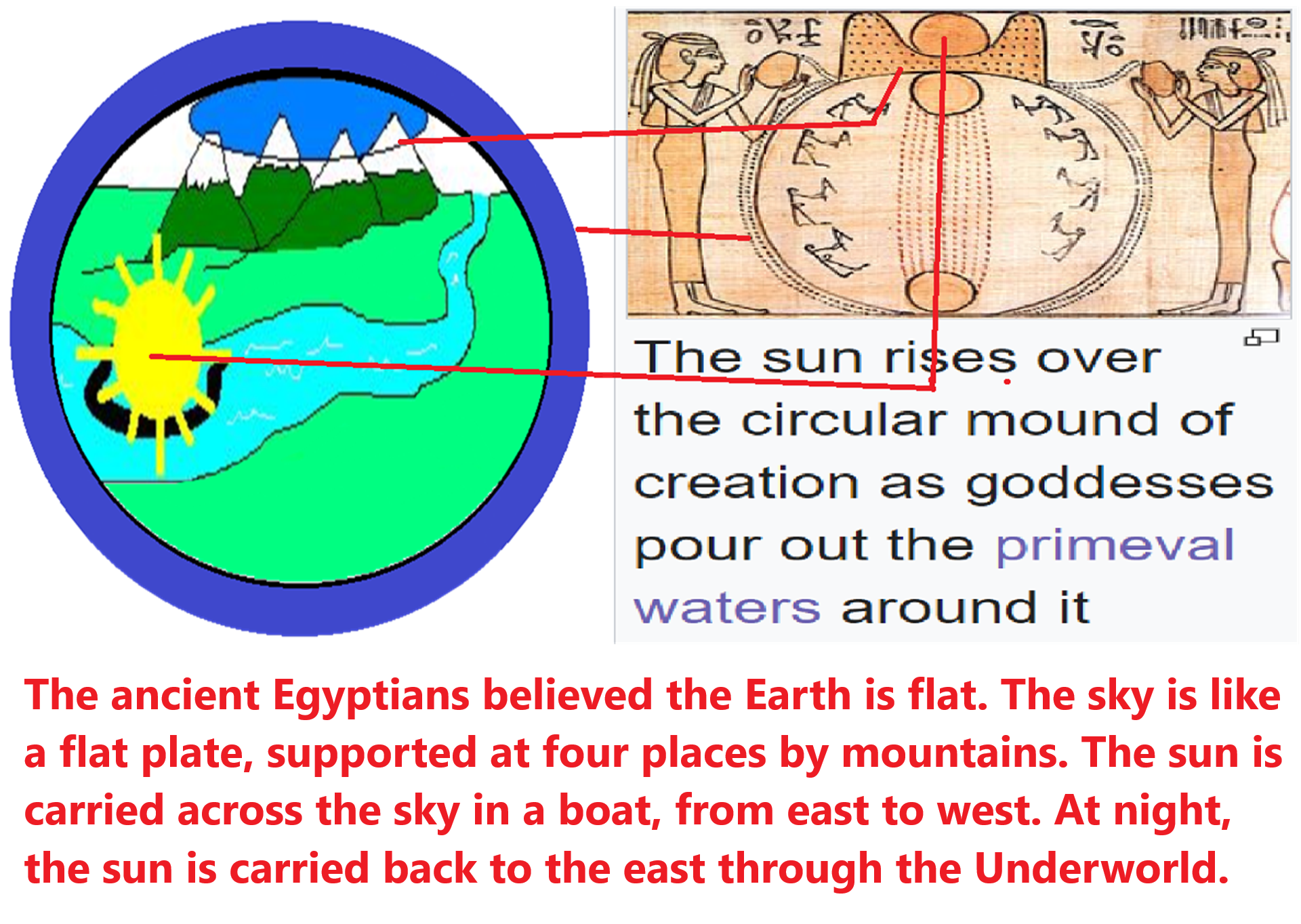
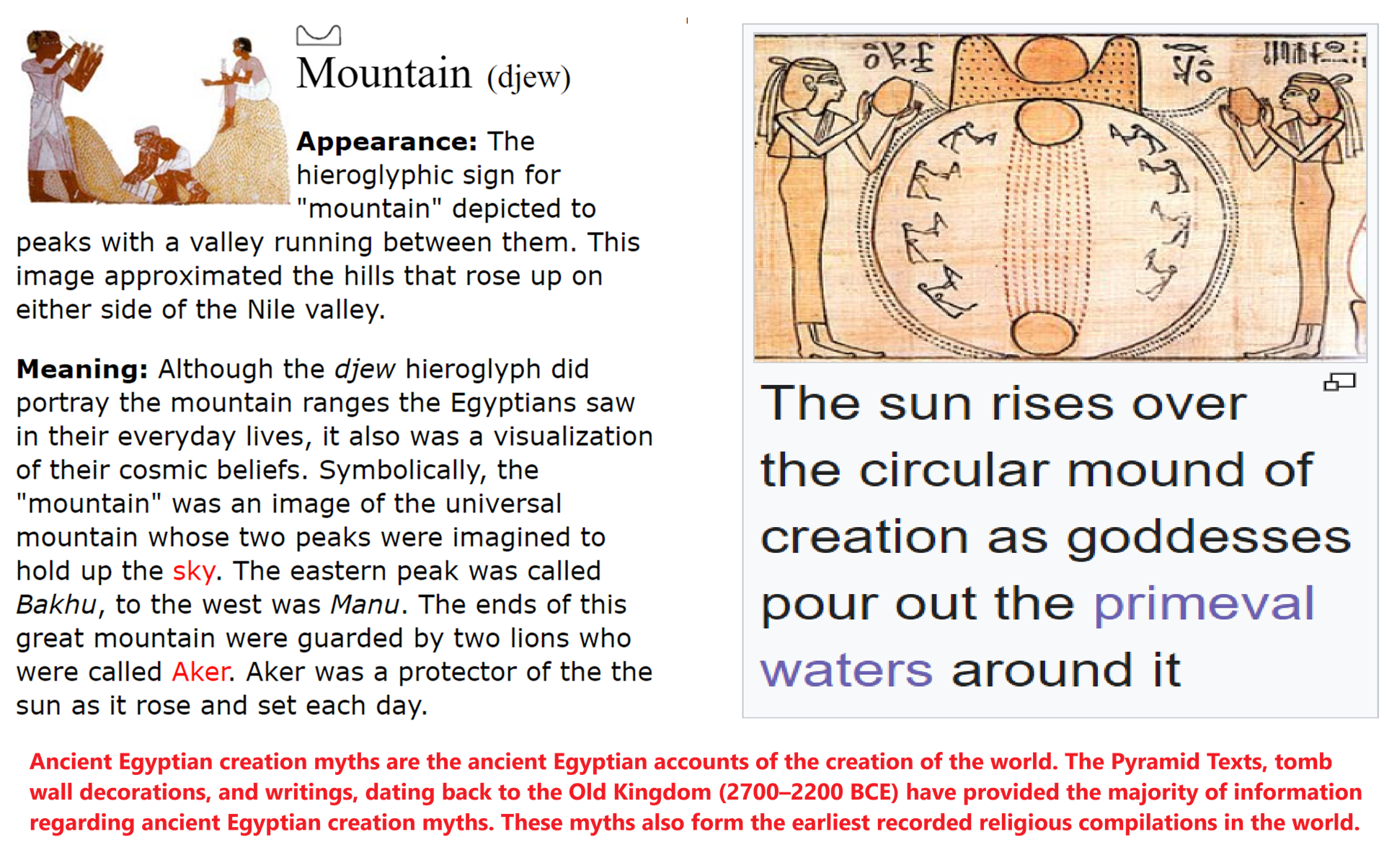
“Although the djew hieroglyph did portray the mountain ranges the Egyptians also saw it symbolically, two peaks imagined to hold up the sky, or a circular mound of creation.” ref, ref
Mountain (djew)
“Appearance: The hieroglyphic sign for “mountain” depicted to peaks with a valley running between them. This image approximated the hills that rose up on either side of the Nile valley. Meaning: Although the djew hieroglyph did portray the mountain ranges the Egyptians saw in their everyday lives, it also was a visualization of their cosmic beliefs. Symbolically, the “mountain” was an image of the universal mountain whose two peaks were imagined to hold up the sky. The eastern peak was called Bakhu, to the west was Manu. The ends of this great mountain were guarded by two lions who were called Aker. Aker was a protector of the the sun as it rose and set each day.” ref
“The Egyptian necropolis was typically located in the mountainous desert and so the djew was also closely associated with the concepts of the tomb and of the afterlife. The god of mummification, Anubis bore the epithet, “He who is upon his mountain.” Hathor, the “Mistress of the Necropolis”, while in the form of a cow, was often shown emerging from the side of the western mountain. In painted scenes, the concept of a “hill” or “heap” of such things as grain are often expressed representationally with the djew sign. The use of the hieroglyphic shape is an effective tool to convey not only the shape but the of such large heaps of grain. A variation of the hieroglyph showing a range of three peaks was used to portray the concept of “foreign land.” ref
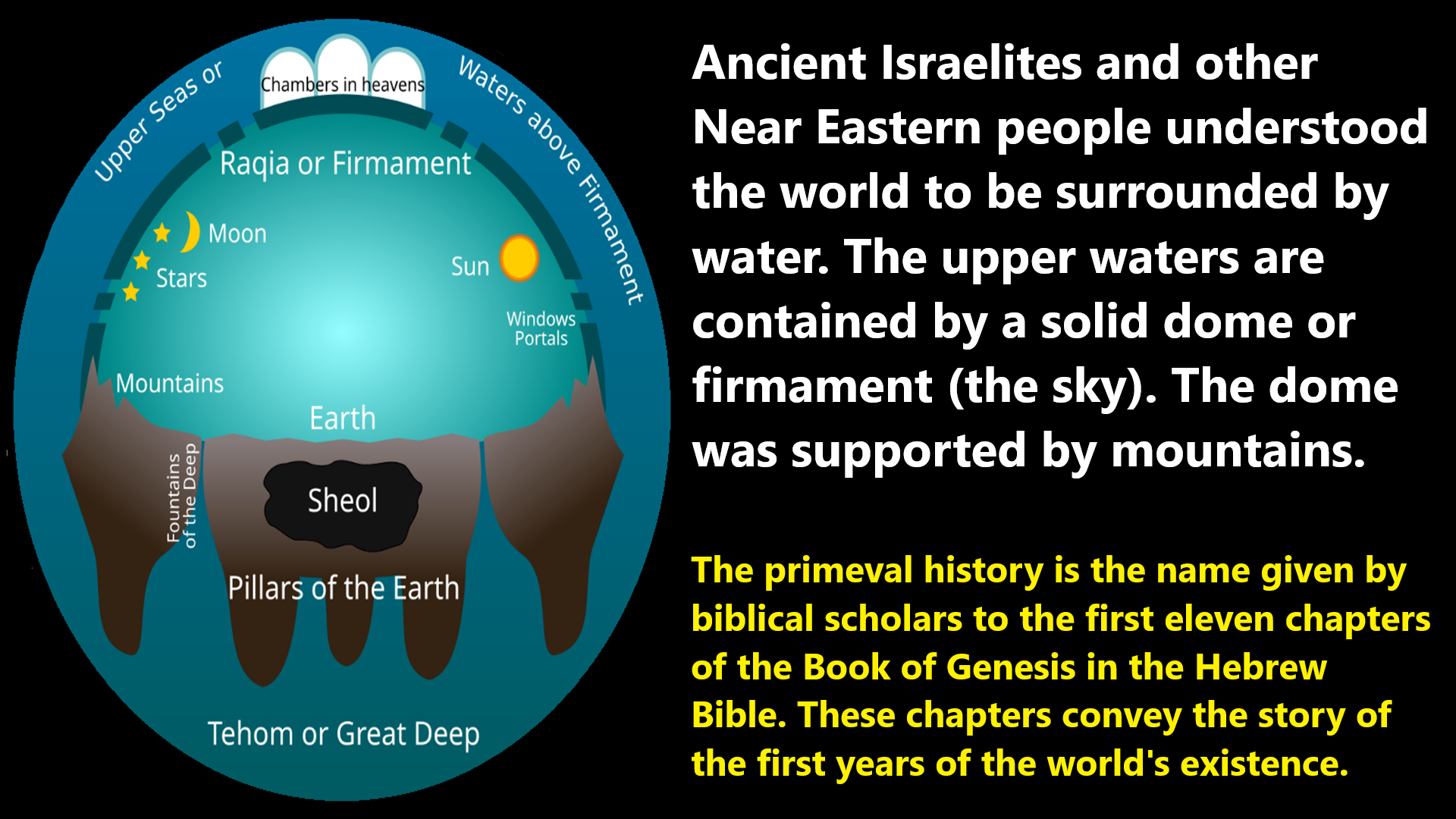
“The primeval history is the name given by biblical scholars to the first eleven chapters of the Book of Genesis in the Hebrew Bible. These chapters convey the story of the first years of the world’s existence.
“The body of material tells how God created the world and all its beings and placed the first man and woman (Adam and Eve) in his Garden of Eden, how the first couple were expelled from God’s presence, of the first murder which followed, and God’s decision to destroy the world and save only the righteous Noah and his sons; a new humanity then descended from these sons and spread throughout the world, but, although the new world was as sinful as the old, God resolved never again to destroy the world by flood, and the history ended with Terah, the father of Abraham, from whom descended God’s chosen people.” ref
“The primeval history is generally considered to have been completed along with the rest of the Book of Genesis in the 5th century BCE, but a sizeable minority of scholars have dated it to the 3rd century BCE, pointing to discontinuities between the contents of the work and other parts of the Hebrew Bible. Biblical scholars John Day and David Toshio Tsumura argue that Genesis 1:1 describes the initial creation of the universe, the former writing: “Since the inchoate earth and the heavens in the sense of the air/wind were already in existence in Gen. 1:2, it is most natural to assume that Gen. 1:1 refers to God’s creative act in making them.” Other scholars such as R. N. Whybray, Christine Hayes, Michael Coogan, Cynthia Chapman, and John H. Walton argue that Genesis 1:1 describes the creation of an ordered universe out of preexisting, chaotic material.” ref
“The word “created” translates the Hebrew bara’, a word used only for God’s creative activity; people do not engage in bara’. Walton argues that bara’ does not necessarily refer to the creation of matter. In the ancient Near East, “to create” meant assigning roles and functions. The bara’ which God performs in Genesis 1 concerns bringing “heaven and earth” from chaos into ordered existence. Day disputes Walton’s functional interpretation of the creation narrative. Day argues that material creation is the “only natural way of taking the text” and that this interpretation was the only one for most of history. Most interpreters consider the phrase “heaven and earth” to be a merism meaning the entire cosmos. Genesis 1:2 describes the earth as “formless and void”. This phrase is a translation of the Hebrew tohu wa-bohu (תֹהוּ וָבֹהוּ). Tohu by itself means “emptiness, futility.” ref
“It is used to describe the desert wilderness. Bohu has no known meaning, although it appears to be related to the Arabic word bahiya (“to be empty”), and was apparently coined to rhyme with and reinforce tohu. The phrase appears also in Jeremiah 4:23 where the prophet warns Israel that rebellion against God will lead to the return of darkness and chaos, “as if the earth had been ‘uncreated’.” Verse 2 continues, “darkness was upon the face of the deep“. The word deep translates the Hebrew təhôm (תְהוֹם), a primordial ocean. Darkness and təhôm are two further elements of chaos in addition to tohu wa-bohu. In Enuma Elish, the watery deep is personified as the goddess Tiamat, the enemy of Marduk. In Genesis, however, there is no such personification. The elements of chaos are not seen as evil but as indications that God has not begun his creative work.” ref
“Verse 2 concludes with, “And the ruach of God [Elohim] moved upon the face of the waters.” There are several options for translating the Hebrew word ruach (רוּחַ). It could mean “breath,” “wind,” or “spirit” in different contexts. The traditional translation is “spirit of God.” In the Hebrew Bible, the spirit of God is understood to be an extension of God’s power. The term is analogous to saying the “hand of the Lord” (2 Kings 3:15). Historically, Christian theologians supported “spirit” as it provided biblical support for the presence of the Holy Spirit, the third person of the Trinity, at creation. Other interpreters argue for translating ruach as “wind.” For example, the NRSV renders it “wind from God”. Likewise, the word elohim can sometimes function as a superlative adjective (such as “mighty” or “great”). The phrase ruach elohim may therefore mean “great wind.” The connection between wind and watery chaos is also seen in the Genesis flood narrative, where God uses wind to make the waters subside in Genesis 8:1.” ref
“In Enuma Elish, the storm god Marduk defeats Tiamat with his wind. While stories of a cosmic battle prior to creation were familiar to ancient Israelites (see above), there is no such battle in Genesis 1 though the text includes the primeval ocean and references to God’s wind. Instead, Genesis 1 depicts a single God whose power is uncontested and who brings order out of chaos. Creation by speech is not found in Mesopotamian mythology, but it is present in some ancient Egyptian creation myths. While some Egyptian accounts have a god creating the world by sneezing or masturbating, the Memphite Theology has Ptah created by speech.” ref
“In Genesis, creative acts begin with speech and are finalized with naming. This has parallels in other ancient Near Eastern cultures. In the Memphite Theology, the creator god names everything. Similarly, Enuma Elish begins when heaven, earth, and the gods were unnamed. Walton writes, “In this way of thinking, things did not exist unless they were named.” According to biblical scholar Nahum Sarna, this similarity is “wholly superficial” because in other ancient narratives, creation by speech involves magic:
The pronouncement of the right word, like the performance of the right magical actions, is able to, or rather, inevitably must, actualize the potentialities which are inherent in the inert matter. In other words, it implies a mystic bond uniting matter to its manipulator … Worlds apart is the Genesis concept of creation by divine fiat. Notice how the Bible passes over in absolute silence the nature of the matter—if any—upon which the divine word acted creatively. Its presence or absence is of no importance, for there is no tie between it and God. “Let there be!” or, as the Psalmist echoed it, “He spoke and it was so,” [Psalm 33:9] refers not to the utterance of the magic word, but to the expression of the omnipotent, sovereign, unchallengeable will of the absolute, transcendent God to whom all nature is completely subservient.” ref
Second day (1:6–8)
“6 And God said: ‘Let there be a firmament in the midst of the waters, and let it divide the waters from the waters.’ 7 And God made the firmament, and divided the waters which were under the firmament from the waters which were above the firmament; and it was so. 8 And God called the firmament Heaven. And there was evening, and there was morning, a second day. On day two, God creates the firmament (rāqîa), which is named šamayim (‘sky’ or ‘heaven’), to divide the waters. Water was a “primal generative force” in pagan mythologies. In Genesis, however, the primeval ocean possesses no powers and is completely at God’s command. Rāqîa is derived from rāqa’, the verb used for the act of beating metal into thin plates. Ancient people throughout the world believed the sky was solid, and the firmament in Genesis 1 was understood to be a solid dome.” ref
“In ancient near eastern cosmology, the earth is a flat disc surrounded by the waters above and the waters below. The firmament is a solid dome that rests on mountains at the edges of the earth. It is transparent, allowing men to see the blue of the waters above with “windows” to allow rain to fall. The sun, moon, and stars are underneath the firmament. Deep within the earth is the underworld or Sheol. The earth is supported by pillars sunk into the waters below. The waters above are the source of precipitation, so the function of the rāqîa was to control or regulate the weather. In the Genesis flood narrative, “all the fountains of the great deep burst forth” from the waters beneath the earth and from the “windows” of the sky.” ref
Third day (1:9–13)
“And God said: ‘Let the waters under the heaven be gathered together unto one place, and let the dry land appear.’ And it was so. 10 And God called the dry land Earth, and the gathering together of the waters called He Seas; and God saw that it was good. 11 And God said: ‘Let the earth put forth grass, herb yielding seed, and fruit-tree bearing fruit after its kind, wherein is the seed thereof, upon the earth.’ And it was so. 12 And the earth brought forth grass, herb yielding seed after its kind, and tree bearing fruit, wherein is the seed thereof, after its kind; and God saw that it was good. 13 And there was evening, and there was morning, a third day. By the end of the third day God has created a foundational environment of light, heavens, seas and earth.” ref
“God does not create or make trees and plants, but instead commands the earth to produce them. The underlying theological meaning seems to be that God has given the previously barren earth the ability to produce vegetation, and it now does so at his command. “According to (one’s) kind” appears to look forward to the laws found later in the Pentateuch, which lay great stress on holiness through separation. In the first three days, God set up time, climate, and vegetation, all necessary for the proper functioning of the cosmos. For ancient peoples living in an agrarian society, climatic or agricultural disasters could cause widespread suffering through famine. Nevertheless, Genesis 1 describes God’s original creation as “good”—the natural world was not originally a threat to human survival. The three levels of the cosmos are next populated in the same order in which they were created—heavens, sea, earth.” ref
Eridu Genesis
“Eridu Genesis, also called the Sumerian Creation Myth, Sumerian Flood Story, and the Sumerian Deluge Myth, offers a description of the story surrounding how humanity was created by the gods, how the office of kingship entered human civilization, the circumstances leading to the origins of the first cities, and the global flood. Other Sumerian creation myths include the Barton Cylinder, the Debate between sheep and grain and the Debate between Winter and Summer, also found at Nippur. Related flood myths occur in the Epic of Gilgamesh and the Genesis creation narrative.” ref
“The story is known from three fragments representing different versions of the narrative. One is a tablet excavated from the ancient Sumerian city known as Nippur. This tablet was discovered during the Expedition of the University of Pennsylvania in 1893, and the creation story was recognized by Arno Poebel in 1912. It is written in the Sumerian language and is dated to around 1600 BCE. The second fragment is from Ur, also written in Sumerian and from the same time period. The third is a bilingual Sumerian-Akkadian fragment from the Library of Ashurbanipal ca. 600. In 2018, a new fragment of the Eridu Genesis story was published.” ref
Synopsis
“The first 36 lines of the primary tablet from Nippur are lost, although they can be inferred to have discussed the creation of man and animals, and likely spoke about the dissolute existence of mankind prior to civilization (as is indicated by the fragment from Ur). The surviving portion begins with a monologue from Nintur, the goddess who birthed mankind, where she calls humans from a vagrant existence as nomads to build cities, temples, and become both sedentary and civilized. After the monologue, there is another missing section that only resumes after another 36 lines, and at this point humans are still in a nomadic state; the missing section may have spoken of an initial unsuccessful attempt by humans to establish civilization. When the text resumes, Nintur is still planning on providing kingship and organization to humans. Then, the first cities are named (beginning with Eridu, whose leadership Nintur placed under Nudimmud), then Badtibira, Larak, Sippar, and finally Shuruppak.” ref
“The cities were established as distributional (not monetary) economies. Another lacuna (missing section) of 34 lines proceeds. The fragment from the library of Ashurbanipal, as well as independent evidence from the Sumerian King List, suggests this section included the naming of more cities and their rulers. What occurs next is a statement that humans began to make noises that annoyed the gods: Enlil, in particular, was entirely unable to sleep due to humanity and made the radical decision to deal with this by destroying humanity with a flood. The god Enki informs one human, Ziusudra (likely a priest), of this decision and advises him to build a boat to save both himself and one couple of every living creature. Ziusudra builds the boat, boards it with his family and the animals, and the gods unleash the flood, although the exact phrasing is unclear as another lacuna appears in this section. Mankind and the rest of life survives, and again, the text breaks off.” ref
Flood myth In Eridu Genesis
“Before the missing section, the gods have decided to send a flood to destroy humanity. Enki, god of the underworld sea of fresh water and the equivalent of Babylonian Ea, warns Ziusudra, the ruler of Shuruppak, to build a large boat, though the directions for the boat are also lost. When the tablet resumes, it describes the flood. A terrible storm rages for seven days and nights. “The huge boat had been tossed about on the great waters.” Then Utu (Sun) appears, and Ziusudra opens a window, prostrates himself, and sacrifices an ox and a sheep. After another break, the text resumes with the flood apparently over, and Ziusudra prostrating himself before An (Sky) and Enlil (Lordbreath), who give him “breath eternal” for “preserving the animals and the seed of mankind”. The remainder is lost.” ref
“The Epic of Ziusudra adds an element at lines 258–261 not found in other versions, that after the river flood “king Ziusudra … they caused to dwell in the land of the country of Dilmun, the place where the sun rises”. In this version of the story, Ziusudra’s boat floats down the Euphrates river into the Persian Gulf (rather than up onto a mountain, or up-stream to Kish). The Sumerian word KUR in line 140 of the Gilgamesh flood myth was interpreted to mean “mountain” in Akkadian, although in Sumerian, KUR means “mountain” but also “land”, especially a foreign country, as well as “the Underworld.” ref
Historical context
“Some modern scholars believe the Sumerian deluge story corresponds to localized river flooding at Shuruppak (modern Tell Fara, Iraq) and various other cities as far north as Kish, as revealed by a layer of riverine sediments, radiocarbon dated to c. 2900 BCE, which interrupt the continuity of settlement. Polychrome pottery from the Jemdet Nasr period (c. 3000–2900 BCE) was discovered immediately below this Shuruppak flood stratum. None of the predynastic antediluvian rulers have been verified as historical by archaeological excavations, epigraphical inscriptions, or otherwise, but the Sumerians purported them to have lived in the mythical era before the great deluge.” ref
Mesopotamian (and Egyptian) myths and the primeval history
“Numerous Mesopotamian myths (and one Egyptian myth) are reflected in the primeval history. The myth of Atrahasis, for example, was the first to record a Great Flood, and may lie behind the story of Noah’s flood. The following table sets out the myths behind the various Biblical tropes.” ref
| Bible story | Mesopotamian (Egyptian) myth |
| Genesis creation narrative: Genesis 1 | Enuma Elish, the Babylonian creation myth, has a very similar opening to Genesis 1, refers to such entities as the “Deep” (Hebrew Tehom), arrives at a cosmology very similar to the one in Genesis 1:6, and shows a similar concern for reckoning time through the creation of heavenly bodies. God’s creation of mankind in his image also recalls Mesopotamian myths, as does man’s sovereignty over nature. In addition, the way God creates through the spoken word in Genesis 1 mirrors the Egyptian Memphite Theology in which the god Ptah creates the world through speech. |
| Genesis creation narrative: Genesis 2 | The Atrahasis epic tells how the gods created mankind from dust |
| Garden of Eden | The god and goddess Enki and Ninhursag enjoyed a Tree of Life; the serpent in Genesis recalls the god Apsu in the Enuma Elish. |
| Cain and Abel | Cain and Abel are paralleled by the gods Dumuzi and Enkimdu |
| Genealogies | The Sumerian King List, like the list of the descendants of Cain, explains the origin of the elements of civilisation. Enoch, seventh in the line of Adam and taken by God, mirrors the king Enmerduranki and the sage Utuabzu, also seventh in their lines, taken to dwell with the gods. |
| Genesis flood narrative | The great deluge is told in a number of versions beginning in the early 2nd millennium; like the later Genesis myth, they tell how humanity survives through one hero and his family. |
| Tower of Babel (Genesis 11) | While there is no Mesopotamian myth associated with the Tower of Babel, there is scholarly agreement that Babylonian ziggurats, or tower-temples, lie behind this story. |
Creation, destruction, and re-creation
“The history tells how God creates a world which is good (each action within Genesis 1 ends with God marking it as good), and how evil contaminates it through disobedience (the Eden story) and violence (Cain and Abel). The Genesis creation narrative marks the start of the Biblical chronology, the elaborate system of markers, both hidden and overt, marking off a fictive 4000-year history of the world. From Creation to Abraham, time is calculated by adding the ages of the Patriarchs when their first child is born. It seems possible that the period of the Flood is not meant to be included in the count – for example, Shem, born 100 years before the Flood, “begot” his first son two years after it, which should make him 102, but Genesis 11:10–11 specifies that he is only 100, suggesting that time has been suspended. The period from the birth of Shem’s third son Arpachshad (in the second year after the Flood) to Abraham’s migration to Canaan is 365 years, mirroring Enoch’s life-span of 365 years, the number of days in a year. There are 10 Patriarchs between Adam and the Flood and 10 between the Flood and Abraham – the Septuagint adds an extra ancestor so that the second group is 10 from the Flood to Terah. Noah and Terah each have three sons, of whom the first in each case is the most important.” ref
Similar to Earth Diver/Mound of Creation
Northwest Indians’ Creation of the World
“Stories relating to the creation of the world varied from nation to nation: The Klamath believed that Kemush, Old Man of the Ancients, had sprung from the ashes of the northern lights and made the world at the call of the Morning Star. At first, Kaila, the earth, had been flat and bare. Then Kemush planted the grass and roots and trees. He added the ducks, geese, deer, fox, sheep and bear. But Maidu, the Indian, was not yet created. Kemush, with his daughter, Evening Sky, went to the Place of the Dark. For five nights he danced in a great circle with the spirits of the dark. The spirits were without number, like the leaves on the trees. But when Shel, the sun, called to the world, the spirits became dry bones.” ref
“On the fifth day, when the sun was new, Kemush rose and put the dry bones into a sack. Then as he followed the trail of Shel, the sun, to the edge of the world, he threw away the bones. He threw them away two by two. To Kta-iti, place of steepness, he threw two. To Kuyani Shaiks, the crawfish trail, to Molaiksi, steepness of snow, and to Kakasam Yama, mountain of the great blue heron, to each he threw two bones. Thus people were created. The dry bones became Maidu, the Indian; Aikspala, the people of the chipmunks; and last of all, Maklaks, the Klamath Indian.” ref
“Then Kemush followed the trail of Shel, the sun, climbing higher and higher. At the top of the trail he built his lodge. Here still lives Kemush, Old Man of the Ancients, with his daughter, Evening Sky, and Wanaka, the sun halo. The Hat Creek indians tell of how Silver-Fox climbed down from the sky to the water below and made a small island on which to stay. After a night of ceremony and rituals, Silver-Fox sat on the island and pushed with his foot, stretching out the earth in all directions, first to the east, then to the north, then to the west, and last to the south. For five nights he repeated this until the world became as large as it is today. Then Silver-Fox made trees and springs and animals.” ref
“The Indian Tribes of the Pacific Northwest believed that the earth was controlled by many gods. While the idea of a supreme diety varied from nation to nation there was a general attitude that there were no friendly gods. The indians, therefore, felt powerless against the gods who made the earth and the forces of nature which he could not understand. In the tragedies of the forest he saw the weaker, smaller creatures escape the larger ones only by cunnings. Thus, in order to escape the anger of the gods, he too must be cunning. The crafty animals became his earth gods and in time, his helpers. Coyote, the weakest but craftiest of all the animals, became, on the coast, “the chief of all animals.” Fox ranked second.” ref
“The mountains were the home of supernatural beings and considered sacred. Avalanches and volcanic eruptions on Takhoma, “the White Mountain,” now called Mt. Rainier, were caused by tomatoes, and nothing could tempt an Indian to climb high above the snow line. Takhoma was associated with mystery and danger. Tatoosh, the Thunder Bird, lived in the mountains. He shook the mountains with the flapping of his wings, and the flashing of his eye was the lightning. In order to soften his anger, his picture is painted everywhere.” ref
“Often, he is represented by a single eye which is woven or painted on their possessions. The earliest legends were stories of how the world was created, the origin of the races, the discovery of fire, the salmon, and those relating to the physical features of the country. Many of the early myths and legends give animals the same abilities as man. Later on, the stories began to show traces of the white man’s religion and customs.” ref
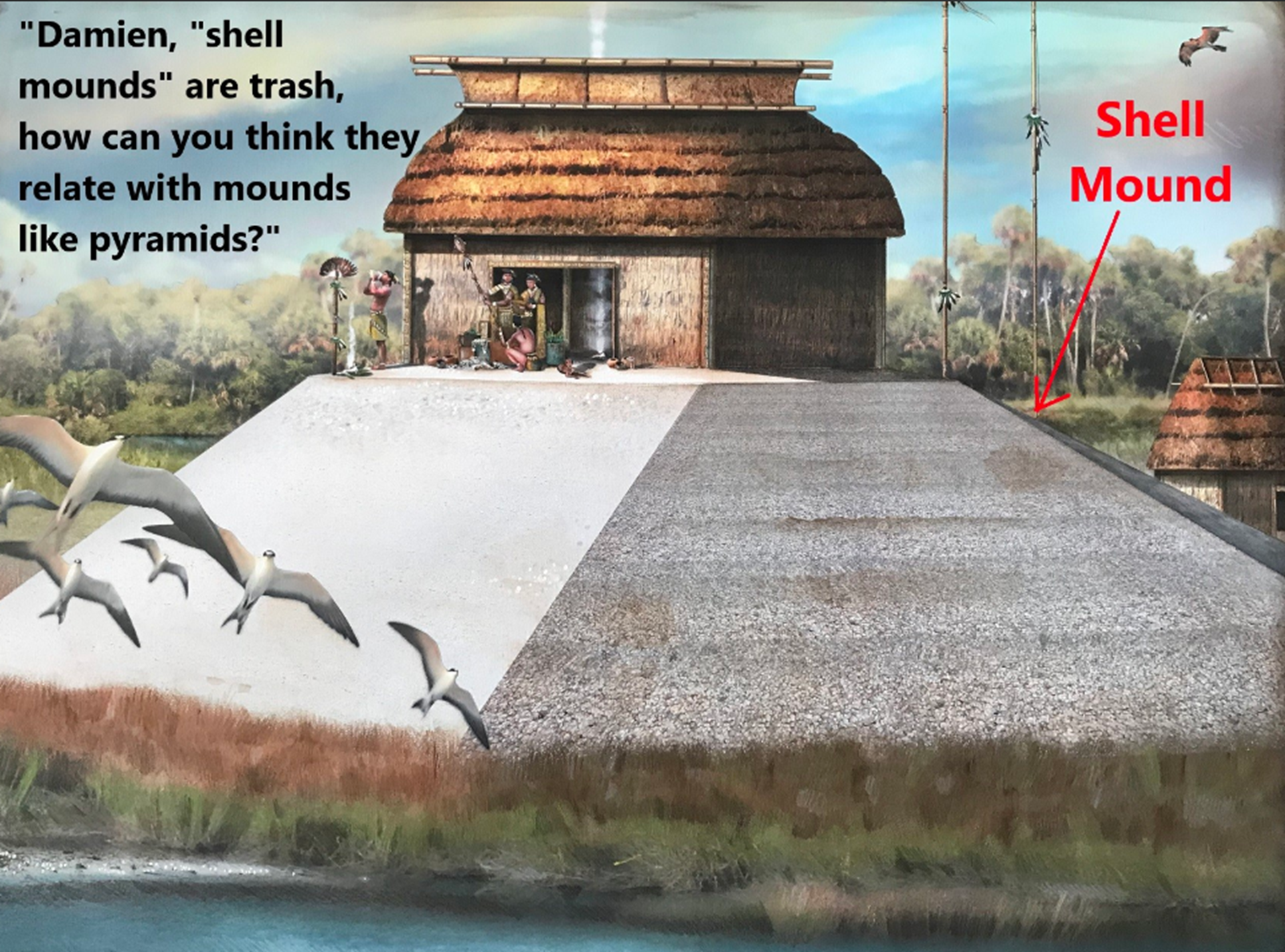
“Damien, “shell mounds” are trash, how can you think they relate with mounds like pyramids?”
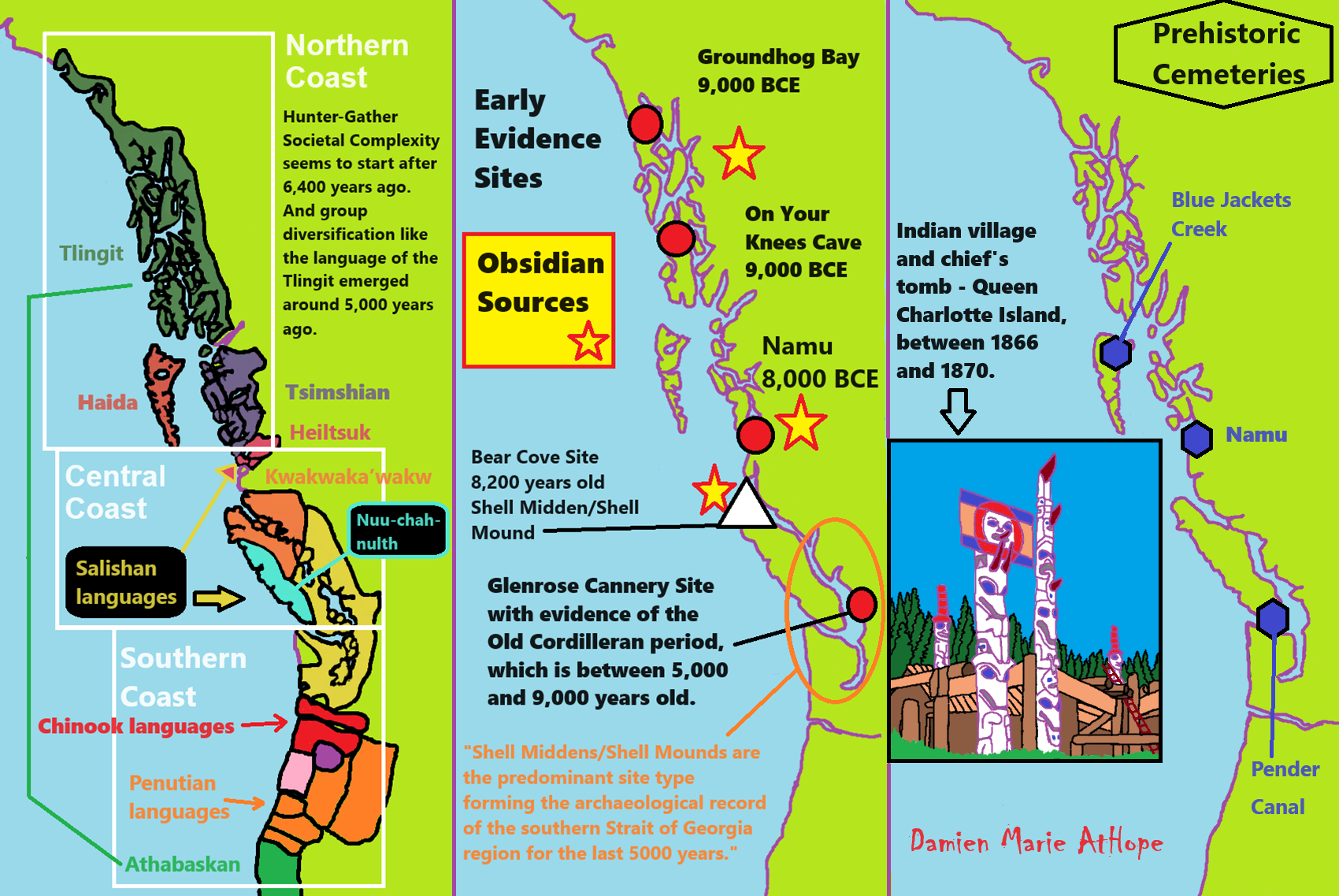
ref, ref, ref, ref, ref, ref, ref, ref, ref, ref, ref, ref, ref, ref, ref, ref, ref, ref, ref
Heiltsuk language (Heiltsuk, also known as Bella Bella, not be confused with Salish-speaking Nuxalk peoples, called Bella Coola)
Athabaskan languages (part of the Na-Dené: Athabaskan–Eyak–Tlingit)
Blue Jackets Creek archaeological site
Pander Canal archaeological site
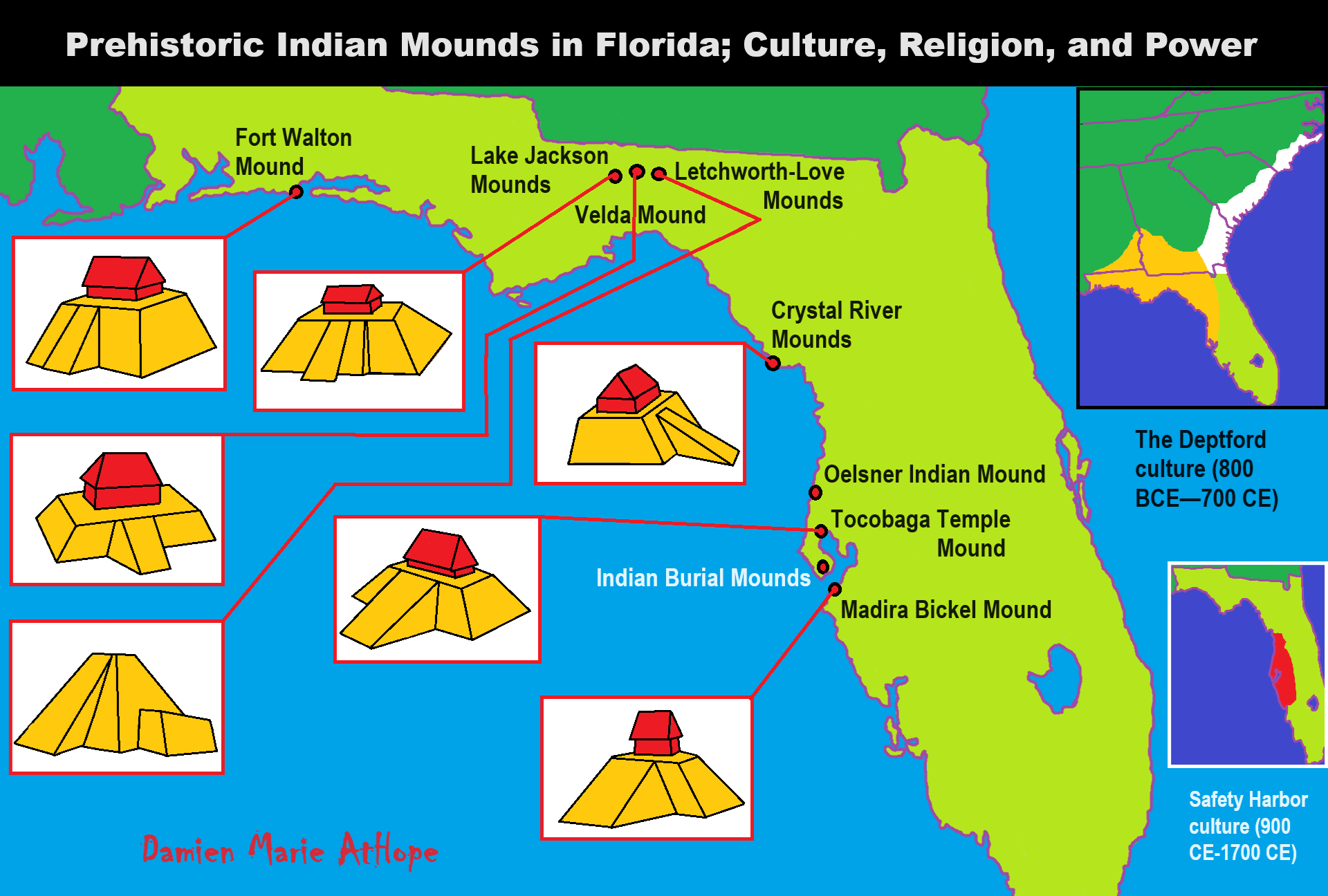
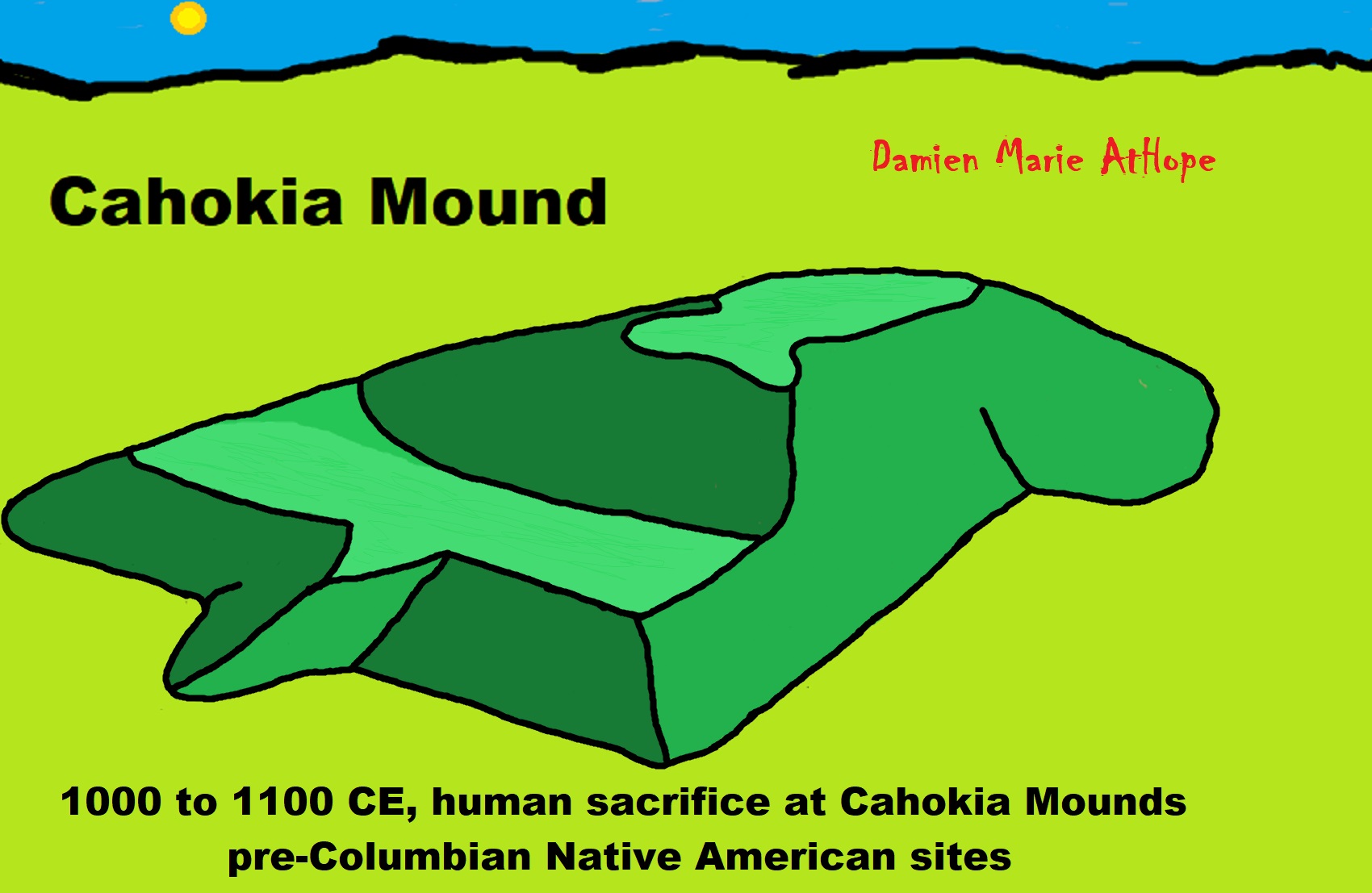
Pic ref
1000 to 1100 CE, human sacrifice Cahokia Mounds a pre-Columbian Native American site
Consider Watching: “Inside the Secret Mounds Of Pre-Historic America” on YouTube: Link
Consider Watching: “The Myth of the Mound Builders” on YouTube: Link
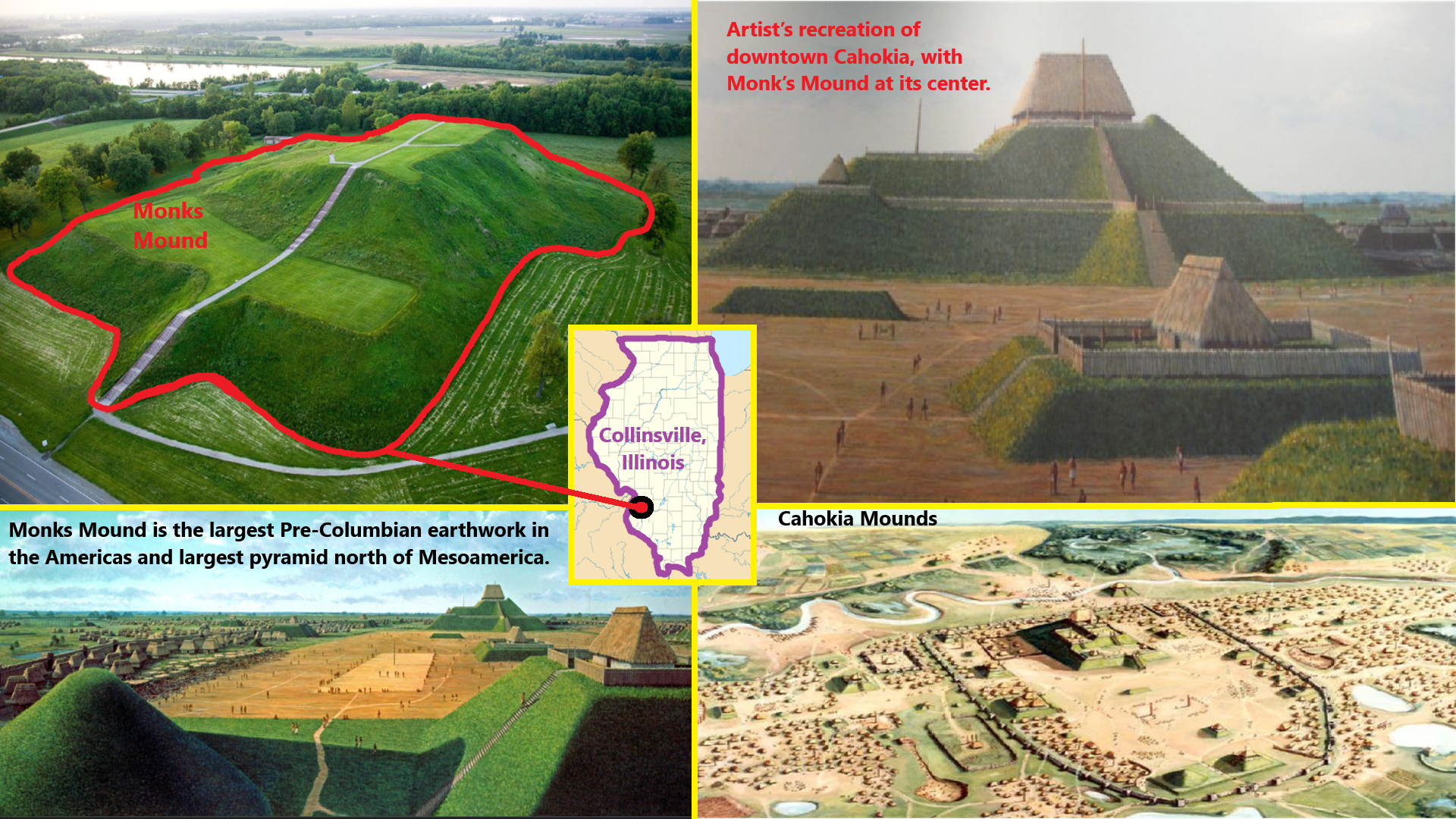
Your content goes here. Edit or remove this text inline or in the module Content settings. You can also style every aspect of this content in the module Design settings and even apply custom CSS to this text in the module Advanced settings.
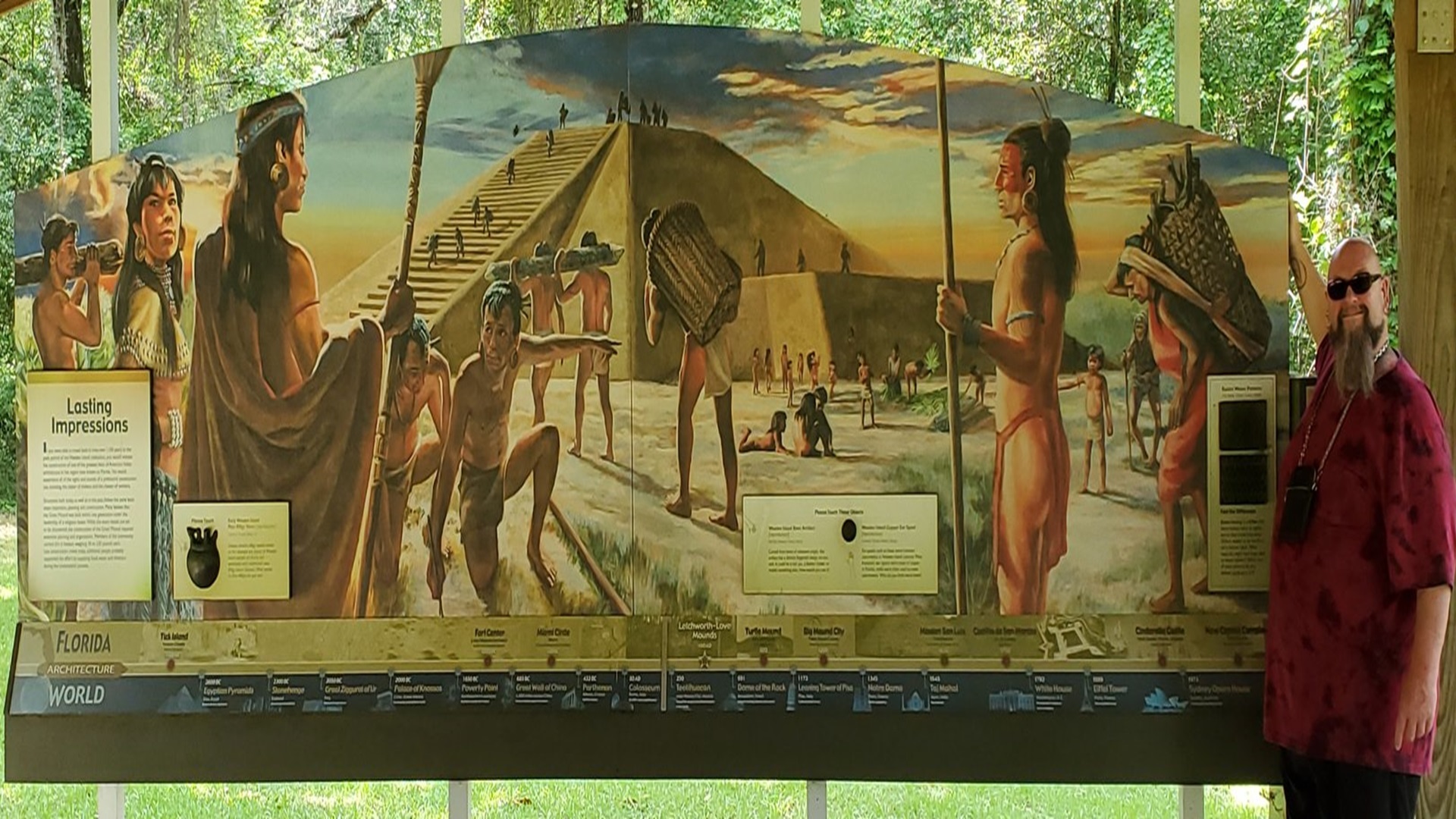
Letchworth-Love Mounds site photo by Shayna Marie AtHope
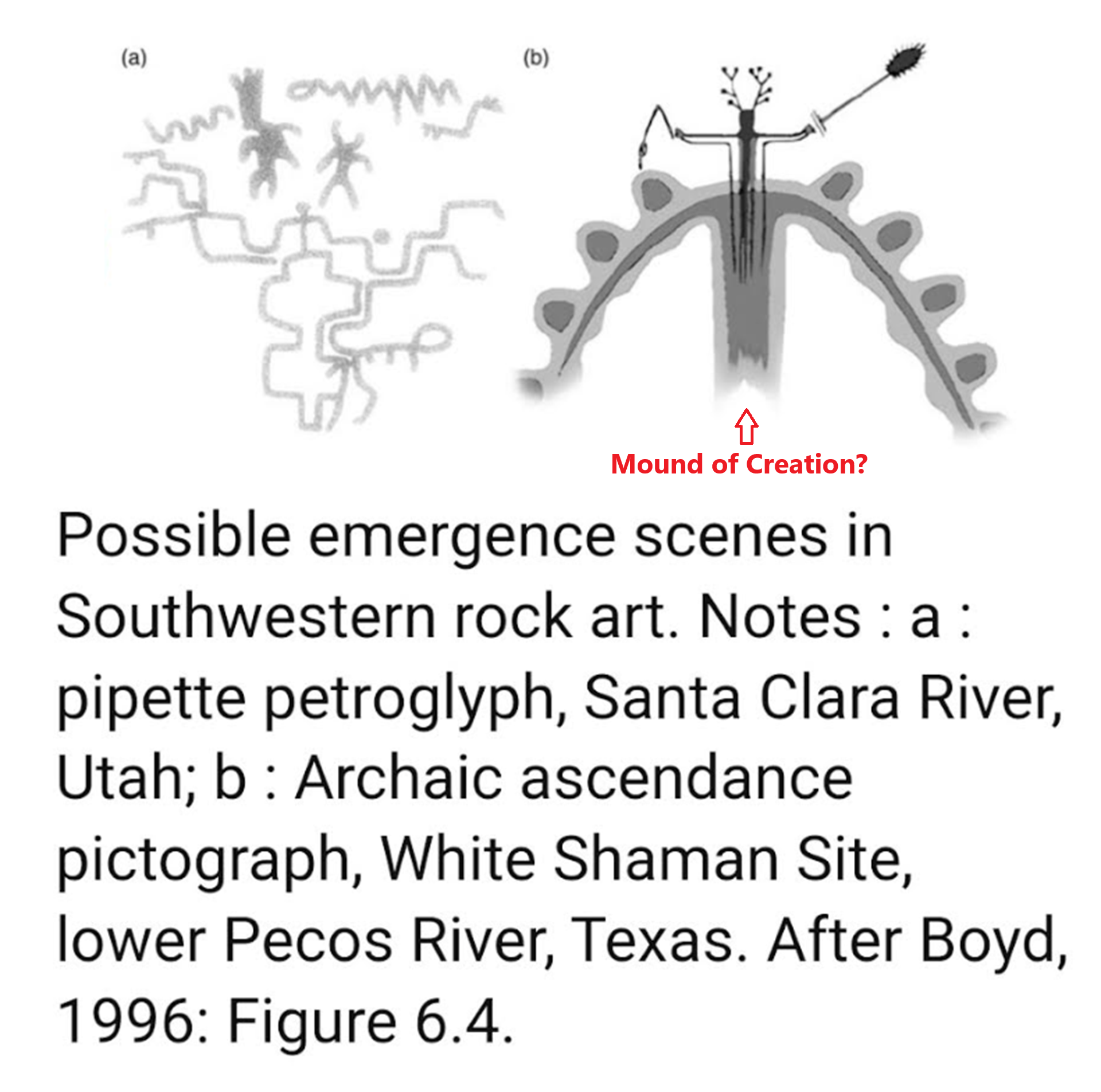
“Don’t forget models from the non-human animal world. Termite nests would have been among the first architecture that early hominins observed.” – John Hoopes @KUHoopes
My response: Thanks that is a good point. I am trying to make the understanding simple so that undereducated people see the similarities, so they see the human in the myths. So they see it like me: religion is a cultural product humans created, recreated, and evolved into the religions we have now.
“Yes, very much so. Humans drew their models from nature.” – John Hoopes @KUHoopes
My response: I totally agree.
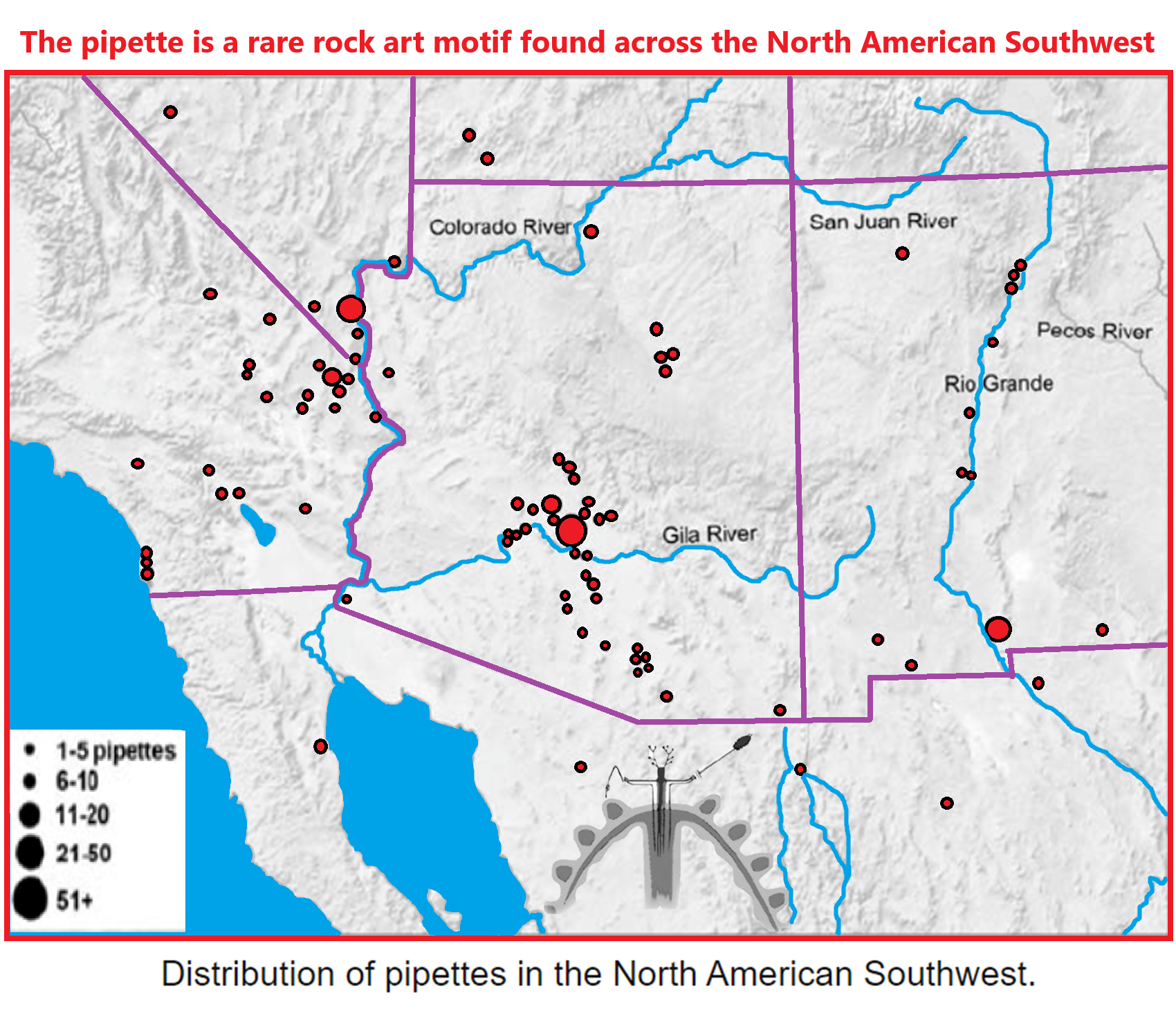
“Possible emergence scenes in Southwestern rock art: Archaic ascendance pictograph, White Shaman Site, lower Pecos River, Texas.” ref
“The pipette is a rare rock art motif found across the North American Southwest but seldom depicted in other media. We address landscape and archaeological contexts, associated imagery, material correlates, and ethnography to provide an interpretative hypothesis that accounts for the motif’s widespread, cross-cultural use. We argue that pipettes represent a tiered cosmos and axis mundi, at times with portrayals of emergence and transcendence. The pipette’s compartmentalization signifies the conceptual metaphor ‘the cosmos is comprised of containers’, a concept embedded in Uto-Aztecan languages with Mesoamerican antecedents. The motif’s distribution across the North American Southwest demonstrates that it was a key religious symbol that accompanied the adoption of Mesoamerican-like religious beliefs and practices beginning in the eighth century or before. Prehistoric iconography – whether we understand it or not – references thought and ideas that were important enough to memorialize. Despite difficulties inherent to interpretation, archaeology would be remiss not to take advantage of the enduring iconological record. We demonstrate that careful, concentrated, and multidimensional approaches to understanding prehistoric symbolism can provide valuable and credible insight into cultures that otherwise could not speak for themselves.” ref
“Abya Yala (from the Kuna language: ‘Abiayala‘, meaning “mature land”) is a neologism used by some indigenous peoples of the Americas to refer to the American continent. The term is used by some indigenous organisations, institutions, and movements as a symbol of identity and respect for the land one inhabits. The increasing usage of the term can be viewed in the context of decolonization, as it serves to create an understanding that “land and discourse, territorio y palabra, cannot be disjointed” and a geography in which a struggle for sovereignty and resistance occurs on an everyday basis for Indigenous communities.The name, which translates to “land in its full maturity”, “land of lifeblood”, or “noble land that welcomes all” originates from the Guna people who once inhabited a region spanning from the northern coast of Colombia to the Darién Gap, and now live on the Caribbean coast of Panama, in the Comarca of Guna Yala. The term is Pre-Columbian. A similar term referring to the northern part of the continent is Turtle Island, which is used by several Northeastern Woodland Native American tribes, especially the Haudenosaunee or Iroquois Confederacy, for part of the continent.” ref
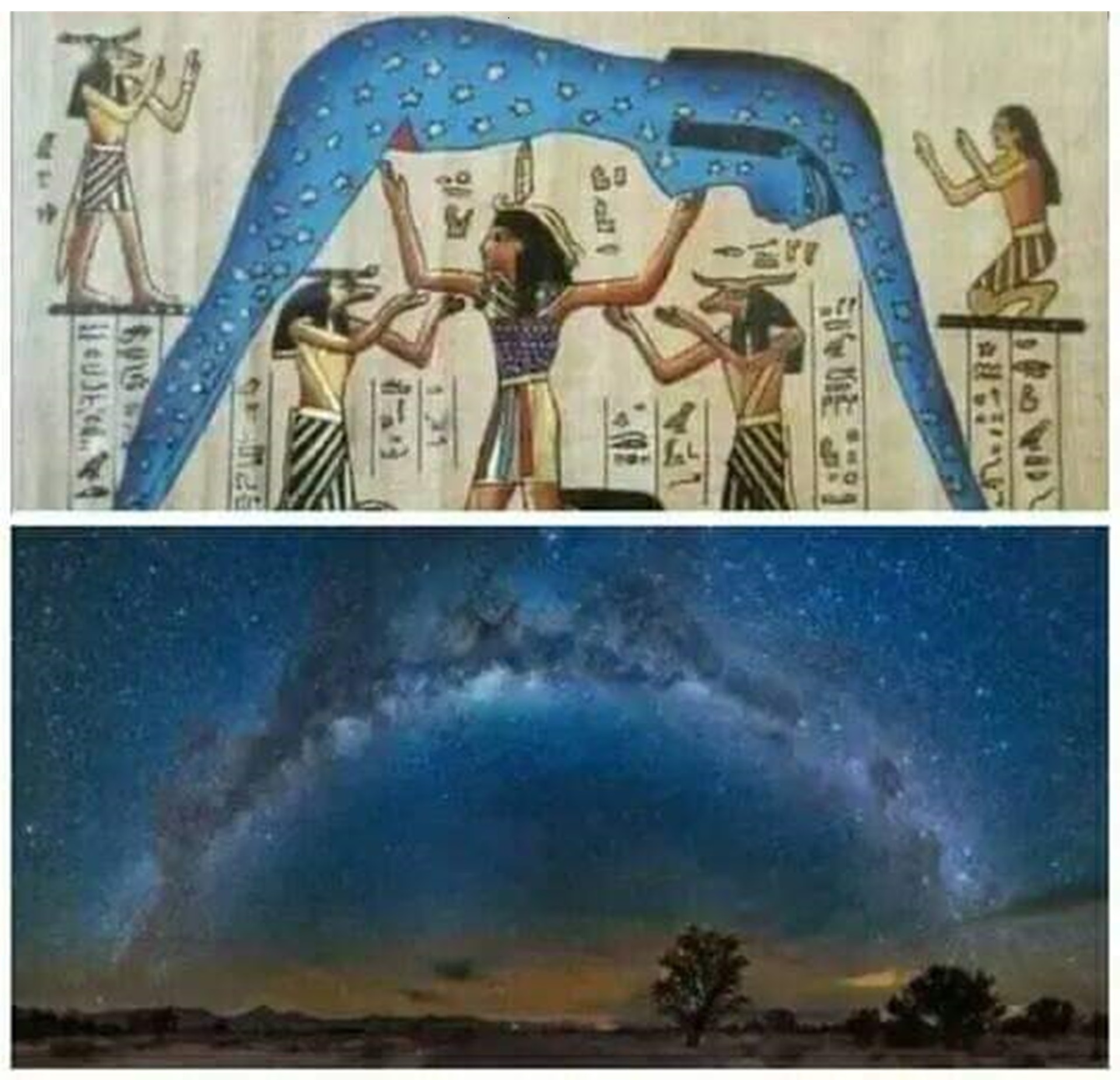
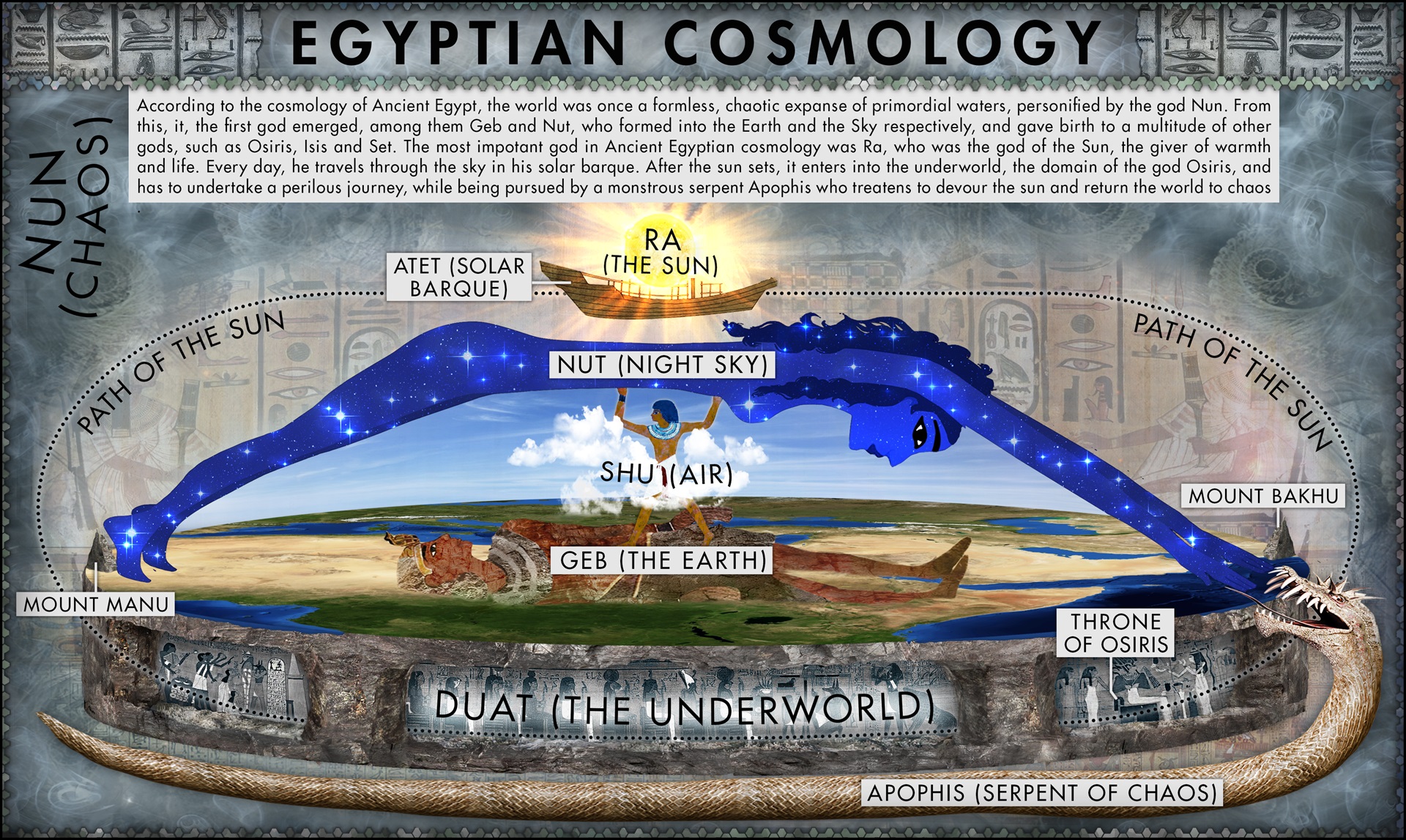
How Ancient Egyptians Understood the World
“In ancient Egypt, the answers revolved around the relationship between Heaven and Earth – the intersection between the worlds of the gods and people. Rather than there being one central story or idea about the nature of life and our world, as highlighted by Ludwig Maximilian Universität Egyptologist Regine Schulz, the beliefs of ancient Egyptians changed through time. From texts written on the walls of pyramids during the Old Kingdom, around 4,500 to 4,350 years ago, for example, archaeologists have discerned that ancient Egyptians thought of the sky as the home of the gods and a place relevant to the afterlife. Gods often traversed this space in boats, a reflection of the ancient Egyptians’ reliance on the Nile for transport, food, and life.” ref
“In fact, much of what ancient Egyptians observed around them informed their understanding of the universe. The sun is so prominent in the Egyptian sky that it’s no wonder than ancient Egyptians developed sets of beliefs about the bright orb. The way the sun seemed to move from east to west reflected the journey of life from birth to death, with the sun god Re entering the underworld each night as the sun sunk below the horizon. The belief evolved over time, with the sun god making a harrowing 12-hour journey through the underworld only to repeat the entire process over again the next day. Other deities were involved in the process, too. The god Nut, some traditions held, gave birth to the sun each day and swallowed the sun each evening as the ball moved through the starfield of her body at night.” ref
“Re was hardly the only god that was importance to ancient Egyptians or their view of the world, though. Over time, ancient Egyptians developed a view of what the universe was like before the origin of the world. They envisioned a set of eight deities – four frog-headed, four serpent-headed – that represented water, darkness, and other facets of the universe during a time of “nothingness.” From there, they believed, the eight created an egg that would hatch the god who would create the world and everything in it – with some variations to the story depending on when and where it was being recounted.” ref
“Gods that sprung forth from the world’s creation weren’t just distant characters. The gods of ancient Egypt were believed to be interested and involved in the lives of people’s daily lives. Bastet, associated with cats, was a female god concerned with the home, fertility, and women’s secrets. Anubis was concerned with the afterlife, mummification, and lost souls, often depicted as a dog or a jackal. The god Thoth was often represented by ibis and oversaw writing, wisdom, and the moon. And that’s just to name a few. But what allowed all of these deities to assist people was the god Heka – the ancient Egyptian personification of magic. Heka ran through everything and allowed the gods to go about their tasks, as well as for humans to connect to the gods. Life on Earth and the world of the gods were not separate, but were intertwined.” ref
“Ancient Egyptian creation myths are the ancient Egyptian accounts of the creation of the world. The Pyramid Texts, tomb wall decorations, and writings, dating back to the Old Kingdom (c. 2700–2200 BCE or around 4,700 to 4,200 years ago) have provided the majority of information regarding ancient Egyptian creation myths. These myths also form the earliest recorded religious compilations in the world. The ancient Egyptians had many creator gods and associated legends. Thus, the world or more specifically Egypt was created in diverse ways according to different parts of ancient Egypt. Some versions of the myth indicate spitting, others masturbation, as the act of creation.” ref
“The earliest god, Ra and/or Atum (both being creator/sun gods), emerged from a chaotic state of the world and gave rise to Shu (air) and Tefnut (moisture), from whose union came Geb (earth) and Nut (sky), who in turn created Osiris, Isis, Set, and Nephthys. An extension to this basic framework was the Osiris myth involving Osiris, his consort Isis, and their son Horus. The murder of Osiris by Set, and the resulting struggle for power, won by Horus, provided a powerful narrative linking the ancient Egyptian ideology of kingship with the creation of the cosmos. In all of these myths, the world was said to have emerged from an infinite, lifeless sea when the sun rose for the first time, in a distant period known as zp tpj (sometimes transcribed as Zep Tepi), “the first occasion.” ref
“Different myths attributed the creation to different gods: the set of eight primordial deities called the Ogdoad, the contemplative deity Ptah, and the mysterious, transcendent god Amun. While these differing cosmogonies competed to some extent, in other ways they were complementary, as different aspects of the Egyptian understanding of creation. The different myths have some elements in common. They all held that the world had arisen out of the lifeless waters of chaos, called Nu. They also included a pyramid-shaped mound, called the benben, which was the first thing to emerge from the waters. These elements were likely inspired by the flooding of the Nile River each year; the receding floodwaters left fertile soil in their wake, and the Egyptians may have equated this with the emergence of life from the primeval chaos. The imagery of the pyramidal mound derived from the highest mounds of earth emerging as the river receded.” ref
“The sun was also closely associated with creation, and it was said to have first risen from the mound, as the general sun-god Ra or as the god Khepri, who represented the newly-risen sun. There were many versions of the sun’s emergence, and it was said to have emerged directly from the mound or from a lotus flower that grew from the mound, in the form of a heron, falcon, scarab beetle, or human child. Another common element of Egyptian cosmogonies is the familiar figure of the cosmic egg, a substitute for the primeval waters or the primeval mound. One variant of the cosmic egg version teaches that the sun god, as primeval power, emerged from the primeval mound, which stood in the chaos of the primeval sea. The different creation accounts were each associated with the cult of a particular god in one of the major cities of Egypt: Hermopolis, Heliopolis, Memphis, and Thebes. To some degree, these myths represent competing theologies, but they also represent different aspects of the process of creation.” ref
Hermopolis
“The creation myth promulgated in the city of Hermopolis focused on the nature of the universe before the creation of the world. The inherent qualities of the primeval waters were represented by a set of eight gods, called the Ogdoad. The goddess Naunet and her male counterpart Nu represented the stagnant primeval water itself; Huh and his counterpart Hauhet represented the water’s infinite extent; Kek and Kauket personified the darkness present within it; and Amun and Amaunet represented its hidden and unknowable nature, in contrast to the tangible world of the living. The primeval waters were themselves part of the creation process, therefore, the deities representing them could be seen as creator gods. According to the myth, the eight gods were originally divided into male and female groups. They were symbolically depicted as aquatic creatures because they dwelt within the water: the males were represented as frogs, and the females were represented as snakes. These two groups eventually converged, resulting in a great upheaval, which produced the pyramidal mound. From it emerged the sun, which rose into the sky to light the world.” ref
Heliopolis
“In Heliopolis, the creation was attributed to Atum, a deity closely associated with Ra, who was said to have existed in the waters of Nu as an inert potential being. Atum was a self-engendered god, the source of all the elements and forces in the world, and the Heliopolitan myth described the process by which he “evolved” from a single being into this multiplicity of elements. The process began when Atum appeared on the mound and gave rise to the air god Shu and his sister Tefnut, whose existence represented the emergence of space amid the waters. To explain how Atum did this, the myth uses the metaphor of masturbation, with the hand he used in this act representing the female principle inherent within him. He is also said to have “sneezed” and “spat” to produce Shu and Tefnut, a metaphor that arose from puns on their names. Next, Shu and Tefnut coupled to produce the earth god Geb and the sky goddess Nut, who defined the limits of the world. Geb and Nut in turn gave rise to four children, who represented the forces of life: Osiris, god of fertility and regeneration; Isis, goddess of motherhood; Set, the god of chaos; and Nephthys, the goddess of protection. The myth thus represented the process by which life was made possible. These nine gods were grouped theologically as the Ennead, but the eight lesser gods, and all other things in the world, were ultimately seen as extensions of Atum.” ref
Memphis
“The Memphite version of creation centered on Ptah, who was the patron god of craftsmen. As such, he represented the craftsman’s ability to envision a finished product, and shape raw materials to create that product. The Memphite theology said that Ptah similarly created the world. This, unlike the other Egyptian creations, was not a physical but an intellectual creation by the Word and the Mind of God. The ideas developed within Ptah’s heart (regarded by the Egyptians as the seat of human thought) were given form when he named them with his tongue. By speaking these names, Ptah produced the gods and all other things. The Memphite creation myth coexisted with that of Heliopolis, as Ptah’s creative thought and speech were believed to have caused the formation of Atum and the Ennead. Ptah was also associated with Tatjenen, the god who personified the pyramidal mound.” ref
Thebes
“Theban theology claimed that Amun was not merely a member of the Ogdoad, but the hidden force behind all things. There is a conflation of all notions of creation into the personality of Amun, a synthesis which emphasizes how Amun transcends all other deities in his being “beyond the sky and deeper than the underworld”. One Theban myth likened Amun’s act of creation to the call of a goose, which broke the stillness of the primeval waters and caused the Ogdoad and Ennead to form. Amun was separate from the world, his true nature was concealed even from the other gods. At the same time, however, because he was the ultimate source of creation, all the gods, including the other creators, were merely aspects of Amun. Amun eventually became the supreme god of the Egyptian pantheon because of this belief. Amun is synonymous with the growth of Thebes as a major religious capital. But it is the columned halls, obelisks, colossal statues, wall reliefs, and hieroglyphic inscriptions of the Theban temples that we look to gain the true impression of Amun’s superiority. Thebes was thought of as the location of the emergence of the primeval mound at the beginning of time.” ref
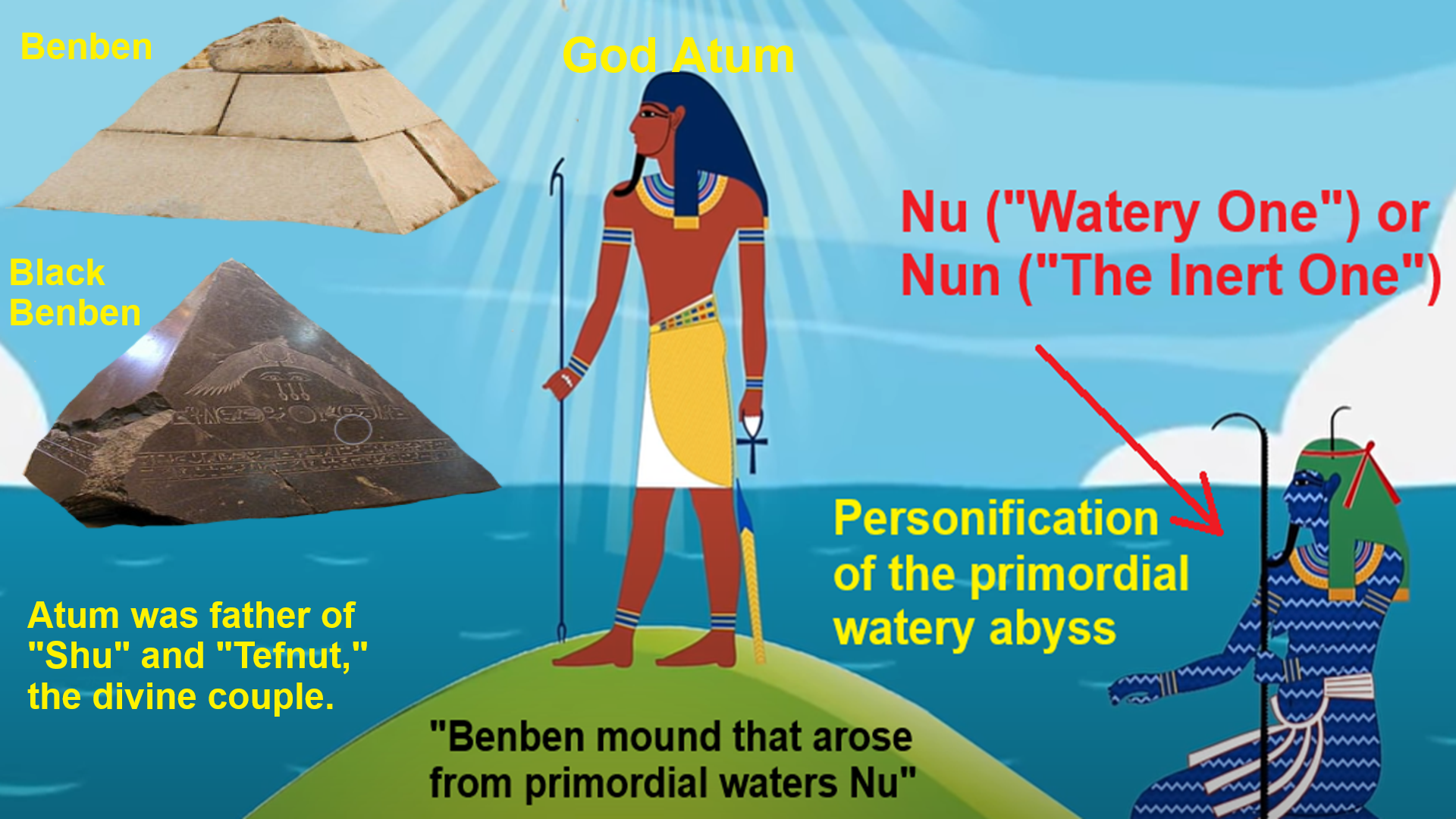
“In the creation myth of the Heliopolitan form of ancient Egyptian religion, Benben was the mound that arose from the primordial waters Nu upon which the creator deity Atum settled. The Benben stone (pyramidion) is the top stone of the pyramid.” ref
Mound of Creation
“Ancient Egyptian temples were not just homes for the gods, they were also replicas of the universe at the moment of creation.” ref
A Model of the Universe
“Ancient Egyptian temples were not just homes for the gods, they were also replicas of the universe at the moment of creation. In Egyptian mythology, the universe emerged from a vast cosmic ocean of nothingness. For countless eons, the creator-sun god Atum had drifted asleep in this primordial sea which the Egyptians called Nun. Eventually, the creator god awoke and willed a small island to emerge from out of the cosmic sea. From atop this hill, which the Egyptians called the mound of the “First Event,” Atum proceeded to call all things into existence starting with the male god Shu (the air) and the goddess Tefnut (moisture). Next came a third generation of deities in the form of the male earth god Geb and the sky goddess Nut. After further generations, every feature of nature was born, each with a god or goddess to govern it.” ref
“Egyptian temples were replicas of this early universe with inner sanctuaries representing the primeval hill. As visitors moved from the outer courts, through the hypostyle hall and into the holy of holies, the floor level gradually rose while the ceilings became lower. It also became darker as the open roofed courts and the hypostyle halls with their clerestory windows gave way to dark inner chambers with just one small light shaft in the inner chapel to illuminate the god’s cult statue. This confined and shadowy atmosphere transported the visitors privileged enough to see the god in his home back to the very beginning of time—but just a few priests and Pharaoh himself could enter this holy of holies. Within this sacred model of space and time, a hypostyle hall mimicked a thicket of papyrus reeds that grew in the swampy edges of the primeval mound.” ref
“Ancient Egypt’s still-buried ‘Mound of Creation’ an extremely well-preserved tomb at Saqqara near Cairo. It belonged to a high priest called Wahtye, and is more than 4,000 years old.” ref
Akhilandeshwari and the Lingam: (pillar-like “mound” symbol of Shiva, pseudo-Male Sex-Organ, made of stone, metal, gem, wood, or clay) – “Mound of Creation-like”
“One of the main forms of the Hindu Goddess Adi Parashakti. The goddess’s name is split into three components. “Akhila” means the universe, “Anda” means cosmic egg, and “Ishwari” means the divine mother. Therefore, Goddess, the divine mother who protects the entire universe in her womb (cosmic egg).” ref
“Once Parvati mocked Shiva‘s penance for the betterment of the world. Shiva wanted to condemn her act and directed her to go to the Earth from Mount Kailash (Shiva’s abode) to do penance. Parvati in the form of Akhilandeshwari as per Shiva’s wish found the Jambu forest to conduct her penance. She made a lingam out of the water from the Kaveri river, (also called as Ponni River) under the Venn Naaval tree (the Venn Naaval tree on top of the saint Jambu) and commenced her worship.” ref
“The lingam of the Shaivism tradition is a short cylindrical pillar-like symbol of Shiva, made of stone, metal, gem, wood, clay or precious stones. It is often represented within a disc-shaped platform, the yoni – its feminine counterpart, consisting of a flat element, horizontal compared to the vertical lingam, and designed to allow liquid offerings to drain away for collection.” ref
“The lingam is known as Appu Lingam (Water Lingam). Shiva at last appeared in front of Akhilandeshwari and taught her Shiva Gnana. Akhilandeshwari took Upadesa (lessons) facing East from Shiva, who stood facing west. Just because of this till today during Uchi Kala Puja (Around Noon), the priest of Akhilandeshwari’s temple dresses up like a woman, goes to the sanctum of Jambukeswara Shiva and offers prayers and performs puja to Shiva and Kamadhenu (Cow deity). It is believed that Akhilandeshwari comes in the form of a priest to worship Shiva and the temple cow as Kamadhenu. Thiruvanaikovil is one of the temples where Akhilandeshwari is worshipped as a form of Adi Parashakti.” ref
“Another legend surrounds the Jambukeswarar Temple. Two attendants of Shiva, namely Malyavan and Pushpadanta always quarrelled with each other over one thing or the other. During a quarrel, Malyavan cursed Pushpadanta to become an elephant and the latter cursed the former to become a spider in their next births. The elephant and the spider arrived at Thiruvanaikovil and found the Appu Lingam under the Venn Naaval tree in the Jambu forest. Thus, the animals started their worship of Shiva. The elephant collected water from the nearby Kaveri River and performed abhishekam (ablution) to the lingam. The spider constructed a web to prevent dust, dry leaves and direct sunlight from falling on the lingam. One day, The elephant saw the web over the lingam. It thought there was dust on the lingam and destroyed the web. It later collected water and performed abhishekam again. This went on every day. One day, the spider was angry over the overall destruction of its webs, crawled into the trunk of the elephant and bit the elephant to death. The spider died during the act. Moved by the deep devotion of the two, Shiva appeared and gave moksha (liberation) to the elephant and the spider, who were his attendants in their past lives.” ref
“There’s also another story. After the creation of the heaven, earth and the sky, Brahma created a woman (sometimes identified as Saraswati). Unfortunately, Brahma fell in love with the woman. Due to his lust for the woman, Brahma could not do his duty properly. The woman wanted to get away from the lust of Brahma and tried to move away, but a head of Brahma sprouted wherever she went. Brahma now had 5 heads. The woman went to Shiva and asked for help. Shiva agreed and went to Brahma. Shiva took the form of Bhairava, flung his trident and cut off the 5th head of Brahma, leaving only 4 heads.” ref
“Brahma then repented for his actions and decided to do penance. Moved by his deep devotion, Shiva and Parvati appeared dressed as Parvati and Shiva respectively. When Brahma opened his eyes, he could not recognize them and tell who was who. Brahma later asked for repentance and Shiva agreed as he and Parvati appeared again in their true form. Hence, till the present, the event is recreated in a procession where the procession deities of Shiva and Parvati are dressed and vice versa and carried through all the five outer parts (prakaras) of the temple which is celebrated as Pancha-Prakara Vizha.” ref

“The lingam is an emblem of generative and destructive power. While rooted in representations of the male sexual organ, the lingam is regarded as the “outward symbol” of the “formless Reality”, the symbolization of merging of the ‘primordial matter’ (Prakṛti) with the ‘pure consciousness’ (Purusha) in transcendental context. The lingam-yoni iconography symbolizes the merging of microcosmos and macrocosmos, the divine eternal process of creation and regeneration, and the union of the feminine and the masculine that recreates all of existence. The lingam is typically the primary murti or devotional image in Hindu temples dedicated to Shiva, also found in smaller shrines, or as self-manifested natural objects.” ref
“Some lingams are miniaturized and they are carried on one’s person, such as by Lingayats in a necklace. These are called chala-lingams. The Hindu temple design manuals recommend geometric ratios for the linga, the sanctum and the various architectural features of the temple according to certain mathematical rules it considers perfect and sacred. Anthropologist Christopher John Fuller states that although most sculpted images (murtis) are anthropomorphic or theriomorphic, the aniconic Shiva Linga is an important exception. To some Shaivites the lingam symbolizes the axis of the universe.” ref
“The sexualization is criticized by Stella Kramrisch and Moriz Winternitz who opines that the lingam in the Shiva tradition is “only a symbol of the productive and creative principle of nature as embodied in Shiva”, and it has no historical trace in any obscene phallic cult. Shaiva philosophical texts and spiritual interpretations, “deny that the linga is a phallus.” To the Shaivites, a linga is neither a phallus nor do they practice the worship of erotic penis-vulva, rather the linga-yoni is a symbol of cosmic mysteries, the creative powers and the metaphor for the spiritual truths of their faith.” ref
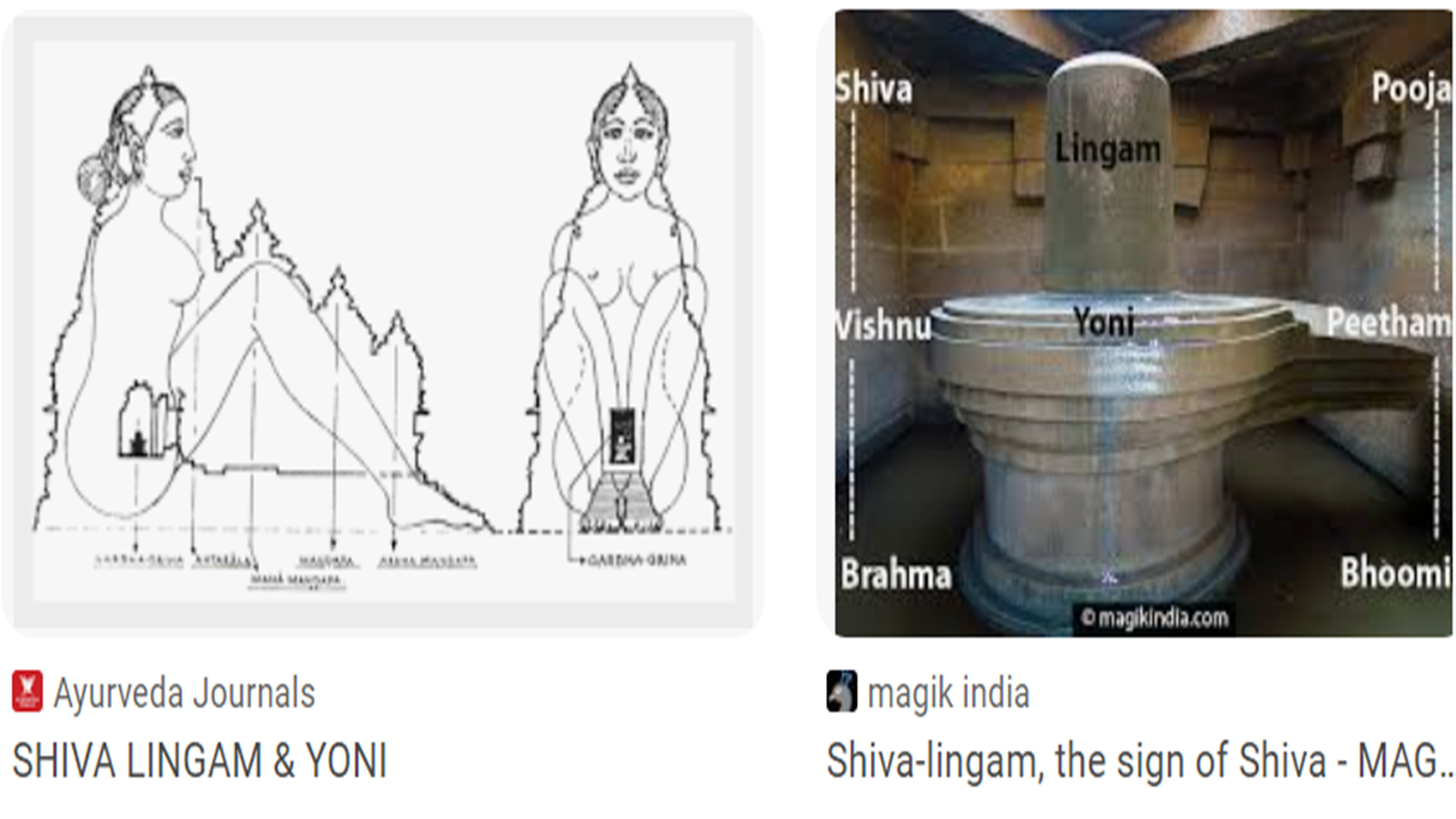
Lingam and Yoni meaning in Hinduism
“A Shiva temple, and by extension the whole world, is the yoni of the Goddess. The entrance to the is the leaf-shaped through within the temple, which envelopes Shiva’s linga. The Goddess thus draws Shiva’s phallus into the world. The tip of the leaf-shaped through always points to the north, suggesting that Shiva is lying on the ground facing the north. That the Goddess is always visualized as sitting on the top of Shiva is indicative of her proactive role in making Shiva interact with the world. Water is poured on the symbol of Shiva and collected in the symbol of Shakti with aim of drawing the energy of Shiva’s fire into samsara. This highly erotic imagery is highly typical for Tantra. The marriage of Shiva and Shakti transforms both God and Goddess. When she steps on Shiva, Shakti is Kali, nature wild and untamed. Shiva is consciousness that is indifferent. When they marry, Kali becomes Gauri, nature that is nurturing and fertile. Shiva becomes Shankara, consciousness that is attentive. Just as devotees pour water on Shiva to draw his attention towards them, they offer clothes to Shakti when they visit her shrine. They want to see her not as the naked and bloodthirsty Kali but as the maternal Gauri.” ref
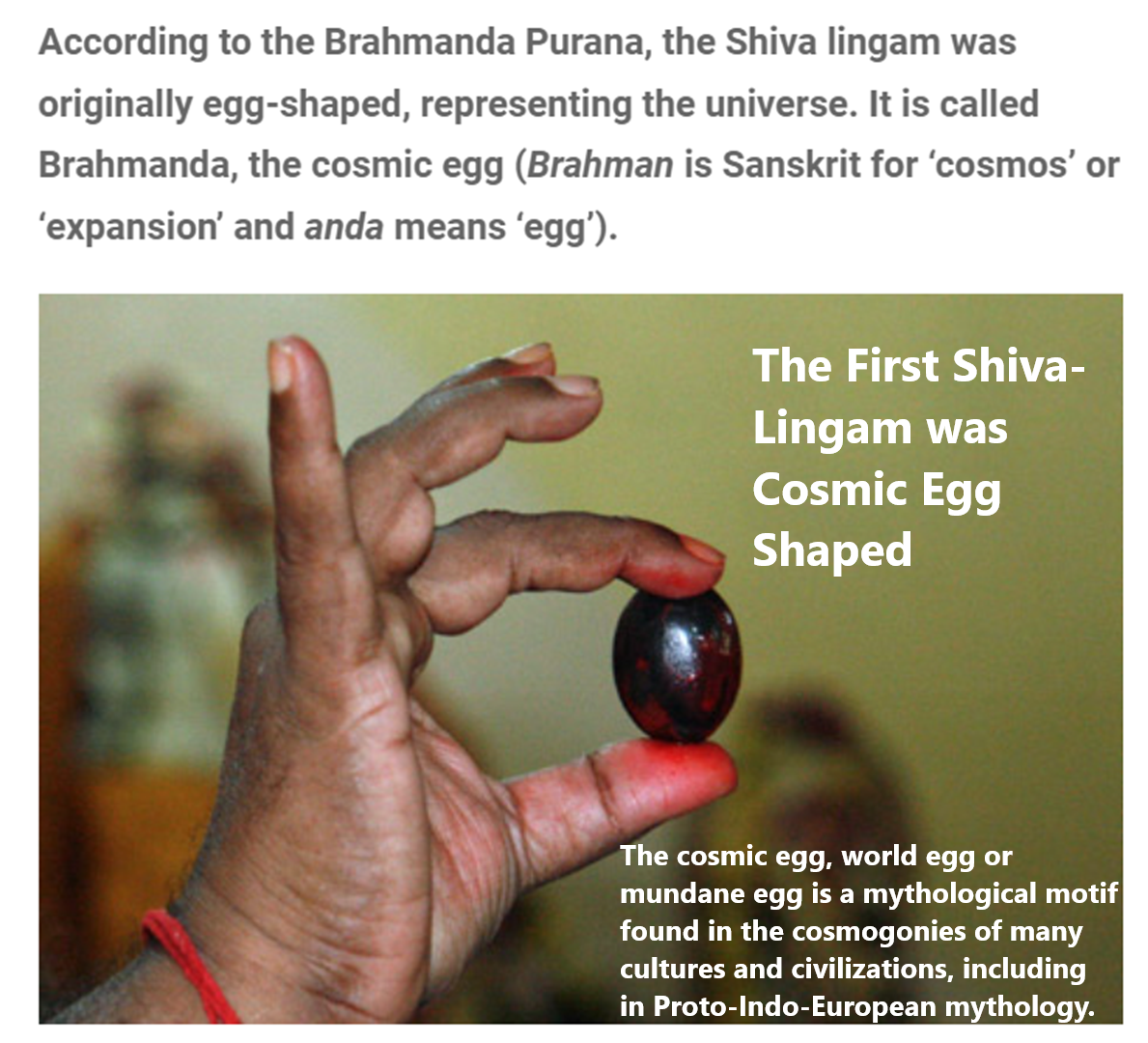
“The First Shiva-Lingam was Cosmic Egg Shaped.” ref, ref
“The cosmic egg, world egg or mundane egg is a mythological motif found in the cosmogonies of many cultures and civilizations, including in Proto-Indo-European mythology. Typically, there is an egg which, upon “hatching”, either gives rise to the universe itself or gives rise to a primordial being who, in turn, creates the universe. The egg is sometimes lain on the primordial waters of the Earth. Typically, the upper half of the egg, or its outer shell, becomes the heaven (firmament) and the lower half, or the inner yolk, becomes the Earth. The motif likely stems from simple elements of an egg, including its ability to offer nourishment and give rise to new life, as is reflected by the Latin proverb omne vivum ex ovo (‘all life comes from an egg’). The term “cosmic egg” is also used in the modern study of cosmology in the context of emergent Universe scenarios.” ref
“A hymn to Ninkasi states that while this goddess was raised by Ninhursag, her parents were Ninti and Enki. Ninti and Ninkasi occur near each other in a document from the Fara period. The relation between Ninti and Enki is also attested in the god list An = Anum, where she is equated with his spouse Damkina. The masculine equivalent of her name, Enti, is also given as an alternate name of Enki, though in other contexts dEN.TI was instead a logographic representation of the name of Ebiḫ, a mountain god presumed to represent Hamrin Mountains.” ref
“Ebiḫ (Ebih) was a Mesopotamian god presumed to represent the Hamrin Mountains. It has been suggested that while such an approach was not the norm in Mesopotamian religion, no difference existed between the deity and the associated location in his case. It is possible that he was depicted either in a non-anthropomorphic or only partially anthropomorphic form. He appears in theophoric names from the Diyala area, Nuzi and Mari from between the Early Dynastic and Old Babylonian periods, and in later Middle Assyrian ones from Assyria. He was also actively venerated in Assur in the Neo-Assyrian period, and appears in a number of royal Tākultu rituals both as a mountain and as a personified deity.”
“The defeat of Ebiḫ at the hands of the goddess Inanna is described in the myth Inanna and Ebiḫ. Various interpretations of the narrative have been advanced, with individual authors seeing it as royal propaganda of the Akkadian empire, as a critique of its conquests, or as a narrative focused on typical literary motifs, lacking political undertones. Possible references to Ebiḫ’s defeat have been identified in other literary compositions, in god lists, and on cylinder seals.” Known from the god list An = Anum (tablet IV, line 23) and its Old Babylonian forerunner, might have been related to the Ebiḫ myth due to its similarity to a presumed variant name of the mountain god, Enti.” ref
Lugaldukuga “primeval deity” and “prime mover” (Mound of Creation?)
“His name means “lord of the holy mound (the Duku)” in Sumerian. The Duku was regarded as the place where Enlil determined destinies for other deities. It was also believed to be the dwelling of his ancestors. The word has two possible meanings, as the sign du could refer to both a hill and to a brick platform. According to Wilfred G. Lambert, it is possible that they could be interpreted as the cosmic location and its physical representation in Enlil’s Ekur temple complex in Nippur.” ref
Du-Ku
“Du-Ku or dul-kug is a Sumerian word for a sacred place. According to Wasilewska et al., du-ku translates as “holy hill”, “holy mound” […E-dul-kug… (House which is the holy mound), or “great mountain. According to the University of Pennsylvania online dictionary of Sumerian and Akkadian languages, du-ku is actually du6-ku3, with du6 being defined as a mound or ruin mound, and ku3 as either ritually pure or shining: it is used in the texts on the Univ. of Oxford site as “shining”. There is no mention of nor association with the term “holy”, and instead it represents a cultic and cosmic place. The location is otherwise alluded to in sacred texts as a specifically identified place of godly judgement. The hill was the location for ritual offerings to Sumerian god(s) Nungal and the Anunna dwell upon the holy hill in a text written from Gilgamesh.” ref
Sumerian tablet of Ereshkigal
“… Enlil on the shore, where he kept watch over the “Du-Ku, the Holy Mound of Creation,” and Mother Ki, (sometimes Antu, sometimes Ninhursag) his eyes gleaming with fond laughter. But why did they leave the safety of the Duku, the mound of creation, why did they go beyond the Waters of Mother Nammu.” ref
“Ninhursag (also Ninhursaga) is the Sumerian Mother Goddess and one of the oldest and most important in the Mesopotamian Pantheon. She replaced the earlier Mother Goddess, Nammu (also known as Namma) whose worship is attested as early as Dynastic III (2600-2334 BCE) of the Early Dynastic Period (2900-2334 BCE).” ref
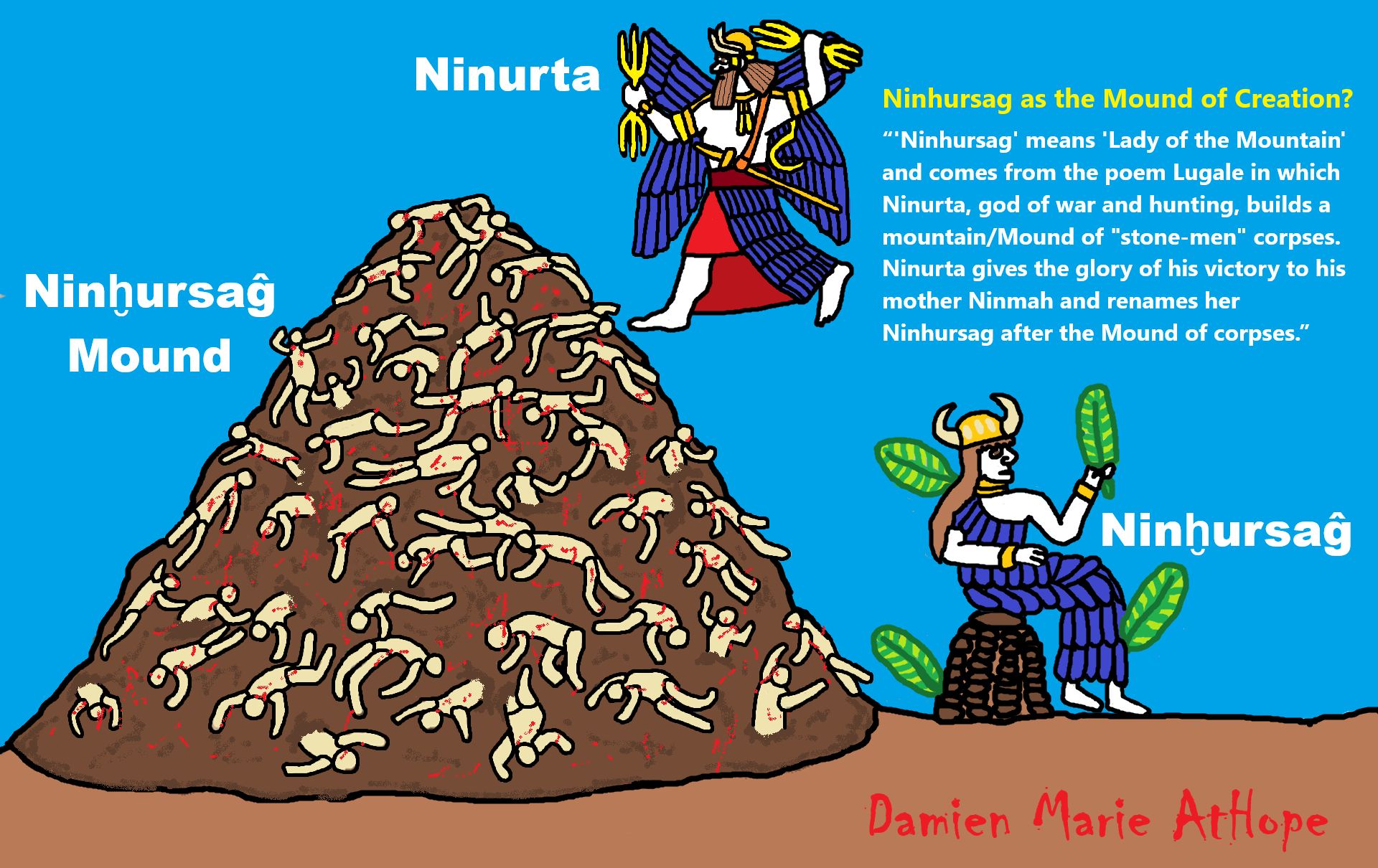
Ninhursag as the Mound of Creation?
“’Ninhursag’ means ‘Lady of the Mountain’ and comes from the poem Lugale in which Ninurta, god of war and hunting, builds a mountain/Mound of “stone-men” corpses. Ninurta gives the glory of his victory to his mother Ninmah (‘Magnificent Queen’) and renames her Ninhursag after the Mound of corpses.” ref
Tell al-‘Ubaid
“Most of the remains are from the Chalcolithic Ubaid period (c. 5500–3700 BCE) is a prehistoric period of Mesopotamia. for which Tell al-‘Ubaid is the type site, with an Early Dynastic temple and cemetery at the highest point. It was a cult center for the goddess Ninhursag.” ref
Mountains in Sumerian Creation Myths
“Near Nippur’s most important temple, Ekur (lit. “mountain house”), they unearthed a cache of clay tablets, which date as far back as the 3rd millennium BCE. They are humanity’s earliest extant written records. One of the tablets contains a creation myth, the so-called Debate between Sheep and Grain. It begins with a mountain: “On the mountain of heaven and earth, Anu spawned the Annunaki gods.” In fact, “mountain” (ḫur-saĝ) is the very first word on the tablet and could be the oldest written word.” ref
“Early in the story, heaven and earth are fused together in a site described as the mountain (ḫur-saĝ) of the supreme sky god Anu. On the slopes of the primordial mountain, primitive man existed, naked and feeding on grasses like cattle. Little else existed, so Anu created the other, lesser gods and goddesses — the Annunaki —, who in turn created sheep and grain for food. Unsatisfied, the gods “sent down” sheep and grain “from the Holy Mound” to “mankind as sustenance.” ref
“There is more to the story than this. But the opening lines of the clay tablet are important because they are the earliest extant textual references linking mountains with gods and fertility. And there are more from the same period. In another Sumerian creation story, Enki and Ninhursag, a certain Mount Dilmun (kur dilmun) is described as a paradise. Indeed, the fertility goddess Ninhursag’s name literally means “lady of the sacred mountain.” ref
“It should be noted here that the god Enki, with whom Ninhursag bears children, is the god of water. In yet another Sumerian story, Debate Between Winter and Summer, the god Enlil copulates with a mountain (hur-saj) and impregnates it “with Summer and Winter, the plenitude and life of the Land.” Mountains also figure prominently in The Epic of Gilgamesh, especially when the eponymous hero seeks Utnapishtim — the Noah-like figure who has learned the secret of eternal life. To get to Utnapishtim, Gilgamesh passes through the terrible Mount Mashu, where he encounters a series of tests, before coming upon a lush, bejeweled garden paradise.” ref
“The mountains are, thus, also safe harbor. Whether the Sumerian creation myths directly influenced Abrahamic traditions or share a common source with them is moot. But in the world’s oldest textual sources, ones that predate all other extant writing, mountains are the abodes of the gods and associated with abundance, life, sustenance, fertility, and paradise.” ref
“An inscribed door socket was found at an unexcavated mound on the Adaim river near where it meets the Tigris river, Khara’ib Ghdairife. It read “Manistusu, king of Kis, builder of the temple of the goddess Ninhursaga in HA.A KI. In another myth involving her son, Ninurta’s Exploits, the titular god goes out to conquer the mountain land to the north of Babylonia, and piles the bodies of its stony kings into a great burial mound. He then dedicates this mountain to his mother, once Ninmah, now renamed Ninhursag after the mound.” ref
Think of Watching: “Ninhursag – The Mother Goddess of Mesopotamian Mythology: Link
Think of Watching: “Ninhursag: The Mother Goddess (Mesopotamian Mythology Explained): Link
Ninhursag | Mother Goddess, Sumerian, Creation
“Ninhursag, in Mesopotamian religion, city goddess of Adab and of Kish in the northern herding regions; she was the goddess of the stony, rocky ground, the hursag.” ref
“Ninhursag had a documented role in Sumerian kingship ideology. The first known royal votive gift, recovered from Kiš, was donated by a king referring to himself as ‘beloved son of Ninḫursaĝa’. Votive objects dedicated to her Diĝirmaḫ name were recovered in Adab, dating to the Early Dynastic Period. Ninhursag could also be understood not simply as affiliated with mountains, but as a personification of mountain (or earth) as well.” ref

Cipactli “Earth Monster” (a like of Mound of Creation?)
“In Aztec cosmology, the crocodile symbolized the earth floating in the primeval waters. Cipactli was a primeval sea monster, part crocodilian, part fish, and part toad or frog, with indefinite gender.” ref
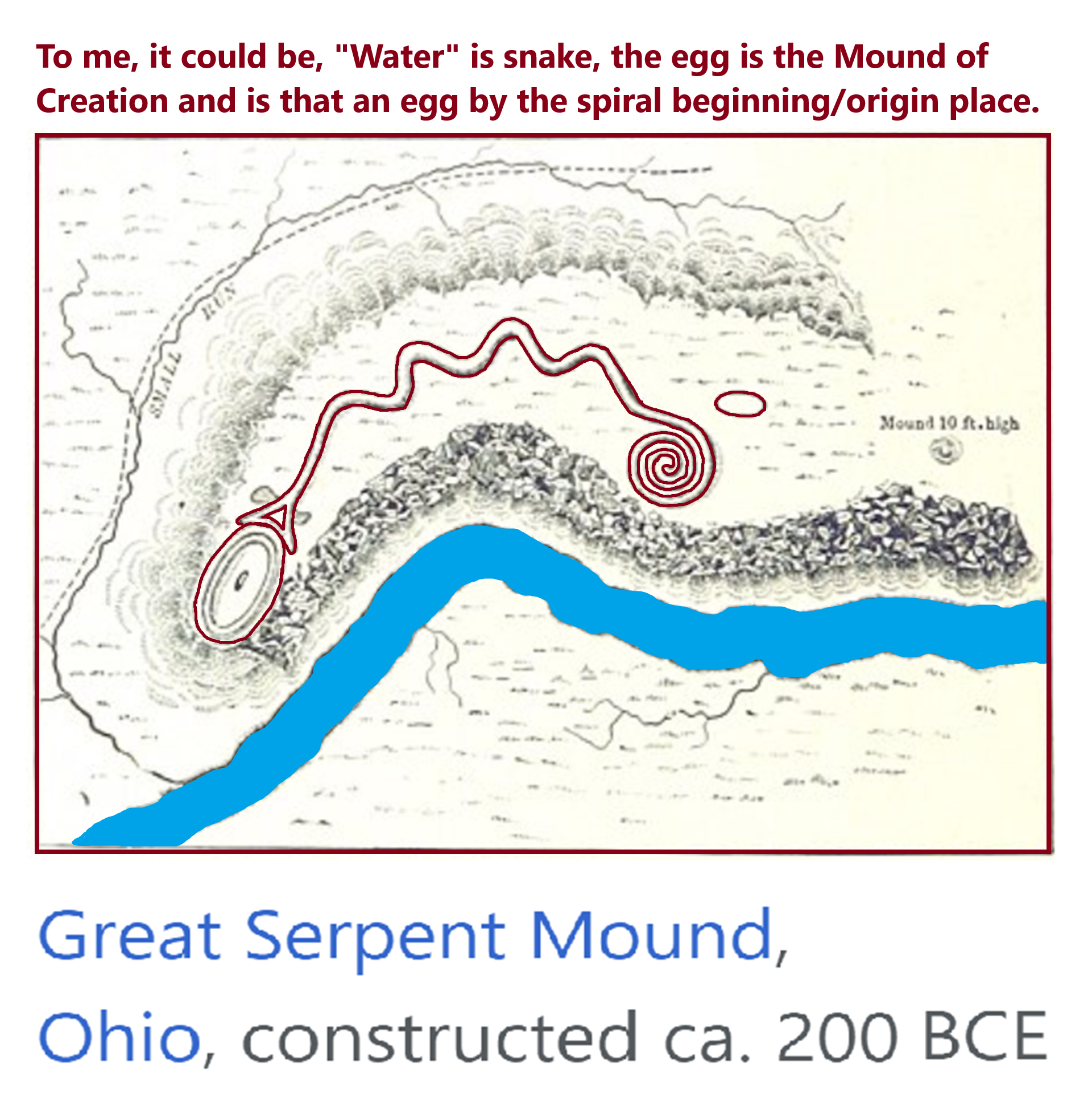
To me, it could be, “Water” is snake, the egg is the Mound of Creation and is that an egg by the spiral beginning/origin place.
“An effigy mound is a raised pile of earth built in the shape of a stylized animal, symbol, religious figure, human, or other figure. The Effigy Moundbuilder culture is primarily associated with the years 550–1200 CE during the Late Woodland Period, although radiocarbon dating has placed the origin of certain mounds as far back as 320 BCE or around 2,320 years ago. Effigy mounds were constructed in many Native American cultures. Scholars believe they were primarily for religious purposes, although some also fulfilled a burial mound function. The builders of the effigy mounds are usually referred to as the Mound Builders. Over 3200 animal-shaped effigy mounds have been identified by the Wisconsin Historical Society in the upper midwest. Native North American effigy mounds have been compared to the large-scale geoglyphs such as the Nazca Lines of Peru.” ref
“The Ho-Chunk suggest that effigy mounds were used as places of refuge as well as burial. Some archaeologists today believe that the mounds were built by particular clans or groups to honor their representative animal. Some believe that the animal shape is the clan or extended family of the person or person’s buried in the mound. Others believe that the mounds were burial sites for everyday people, while still others believe that the depicted animal might be somehow responsible for transitioning the deceased into the next world. The mounds may also indicate hunting and gathering territories of different groups. Other evidence suggests that effigy mounds were used for all manner of rites and ceremonies, from birth ceremonies to funeral rites.” ref
“Common shapes for effigy mounds include birds, bear, deer, bison, lynx, panther, turtles, and water spirits. These are somewhat arbitrary names given to the mound shapes by archaeologists who were simply looking for words that would help them classify the mounds. These shapes were most likely chosen for their particular religious or spiritual significance. The earliest mounds are ‘conical’; they are essentially bumps of earth – the simplest and arguably the most intuitive kind of burial. Successive conicals likely evolved into linear mounds. Bird mounds likely came next as modifying a linear mound to make a bird mound required only the addition of a head and a tail. From there many different animal forms emerged. These often expressed a kind of abstract elongation. Hochunk ancestors naturally buried their dead next to lakes and rivers, and on hillsides.” ref
“In mythology, creation or cosmogonic myths are narratives describing the beginning of the universe or cosmos. Some methods of the creation of the universe in mythology include:
- the will or action of a supreme being or beings,
- the process of metamorphosis,
- the copulation of female and male deities,
- from chaos,
- or via a cosmic egg.” ref
“Creation myths may be etiological, attempting to provide explanations for the origin of the universe. For instance, Eridu Genesis, the oldest known creation myth, contains an account of the creation of the world in which the universe was created out of a primeval sea (Abzu). Creation myths vary, but they may share similar deities or symbols. For instance, the ruler of the gods in Greek mythology, Zeus, is similar to the ruler of the gods in Roman mythology, Jupiter.” ref
“Another example is the ruler of the gods in Tagalog mythology, Bathala, who is similar to various rulers of certain pantheons within Philippine mythology such as the Bisaya’s Kaptan. In the humanities, the distinction between cosmogony and cosmology is blurred. For example, in theology, the cosmological argument for the existence of God (pre-cosmic cosmogonic bearer of personhood) is an appeal to ideas concerning the origin of the universe and is thus cosmogonical. Some religious cosmogonies have an impersonal first cause (for example Taoism).” ref
“In the beginning, there was a period of Chaos, when air, water, and matter were combined in a formless mixture. On this floated a Cosmic Egg, from which arose Gaea (Earth) and Uranus (Sky). These deities created the earth and its creatures and the Sun, Moon, and Stars. Thus, the Greeks accounted for creation. In the beginning, there were Holy People, supernatural and sacred, who lived below ground in 12 lower worlds. A great flood underground forced the Holy People to crawl to the surface of the earth through a hollow reed, where they created the world. Changing Woman gave birth to the Hero Twins, called “Monster Slayer” and “Child of the Waters” who had many adventures. Earth Surface People, mortals, were created, and First Man and First Woman were formed from ears of white and yellow corn. Thus, the Navajo accounted for creation.” ref
“Among the most basic questions raised by human beings are those of origins. How did the human species arise? How was the Earth created? What about the sun? The moon? The stars? Why do we have night and day? Why do people die? No human society lacks answers to such questions. While these answers vary greatly in detail, they are, for primitive peoples as a whole, similar in their basic form: people and the world exist because they were brought into being by a series of creative acts. Moreover, this creation is usually regarded as the work of supernatural beings or forces. The accounts of the ways in which these supernatural agents formed the earth and peopled it are known as origin myths. Until the rise of modern science, origin myths provided the only kinds of answers possible to such questions. Thus, myths embody the state and limitation of human thought about origins for more than 99% of human history.” ref
“The ex nihilo (from nothing) myth, for instance, emphasizes creation from the mind of the Creator (e.g., Yahweh/God/Allah) or creation from the words of the Creator (e.g., the Polynesian Io). The creation from chaos myth tells of creation from undifferentiated material such as cosmic eggs (e.g., the Dogon world egg). The world parents myth—creation from the sacrifice of the world parent(s) (e.g., the Chinese Pangu, the Indian Purusha, the Norse Ymir) often involves the separation of the two world parents, representing Earth and Heaven (e.g., the Polynesian Papa and Rangu, the Mesopotamian Apsu and Tiamat, the Egyptian Geb and Nut). In the earth diver myth an animal dives into the primordial waters to find soil that becomes Earth. This type is particularly prevalent among Native American tribes of the east (e.g., the Iroquoians). In the emergence-type myth, the people emerge from the World Mother (Earth). The birth metaphor is evident here. This myth type is almost exclusively southwestern Native American (e.g., Dine, Hopi), and in it goddesses play significant roles.” ref
Greek Creation Myth
“In the beginning, there was an empty darkness. The only thing in this void was Nyx, a bird with black wings. With the wind, she laid a golden egg, and for ages, she sat upon this egg. Finally, life began to stir in the egg, and out of it rose Eros, the god of love. One half of the shell rose into the air and became the sky and the other became the Earth. Eros named the sky Uranus and the Earth he named Gaia. Then, Eros made them fall in love.” ref
“The golden egg is a Hindu Creation myth that centers around how the Earth came to be. The egg brought life to Earth through rituals called Yajnas. A Yajna is a ritual performed in front of a sacred fire. There are devotions, sacrifices, and offerings involved in these rituals.” ref
“Svayambhu (Sanskrit: स्वयम्भू, romanized: Svayambhū, lit. ‘self-born’) is a Sanskrit word that means “self-born”, “self-manifested”, “self-existing”, or “that that is created by its own accord”. Various deities and entities featured in Hindu literature and tradition are regarded to be svayambhu, such as Brahman in the Upanishads, and the Trimurti of Brahma, Vishnu, and Shiva, and Manu in the Puranas. According to the Brahmanas, the Brahman, the Ultimate Reality, is described to be svayambhu and the cause of all life and the universe. The Manusmriti describes the creation of Brahma from the Svayambhu, applied as a term to denote Brahman. The mind of Brahman is stated to have produced the golden, germinal substance that created the Hiranyagarbha, the primordial egg, from which the creator deity manifested.” ref
“Hiranyagarbha (Sanskrit: हिरण्यगर्भ, lit. ‘golden womb’, IAST: Hiraṇyagarbha, poetically translated as ‘universal womb’) is the source of the creation of the universe or the manifested cosmos in Vedic philosophy. It finds mention in one hymn of the Rigveda (RV 10.121), known as the Hiraṇyagarbha Sūkta, suggesting a single creator deity (verse 8: yo deveṣv ādhi devā eka āsīt, Griffith: “He is the God of gods, and none beside him.”), identified in the hymn as Prajāpati. The concept of the “golden womb” is first mentioned in the Vishvakarma Sūkta (RV 10.82.5,6) which picturized the “primeval womb” as being rested set upon the navel of Vishvakarman. This imagery was later transferred to Vishnu and Surya. In classical Purāṇic Hinduism, Hiraṇyagarbha is the term used in the Vedanta for the “creator”. Hiraṇyagarbha is also Brahmā, so called because it is said he was born in a golden egg (Manu Smṛti 1.9), while the Mahābhārata calls it the Manifest.” ref
“Some Egyptologists (specifically Jan Bergman, Terence Duquesne or Richard H. Wilkinson) have stated that Geb was associated with a mythological divine creator goose who had laid a world egg from which the sun and/or the world had sprung. This theory is assumed to be incorrect and to be a result of confusing the divine name “Geb” with that of a Whitefronted Goose (Anser albifrons), also called originally gb(b): “lame one, stumbled. Geb was the Egyptian god of the Earth and a mythological member of the Ennead of Heliopolis. He could also be considered a father of snakes. It was believed in ancient Egypt that Geb’s laughter created earthquakes and that he allowed crops to grow.” ref
“Thoth was sometimes said to take the place of the Primeval Goose and be the creator of the world and all other gods.” ref
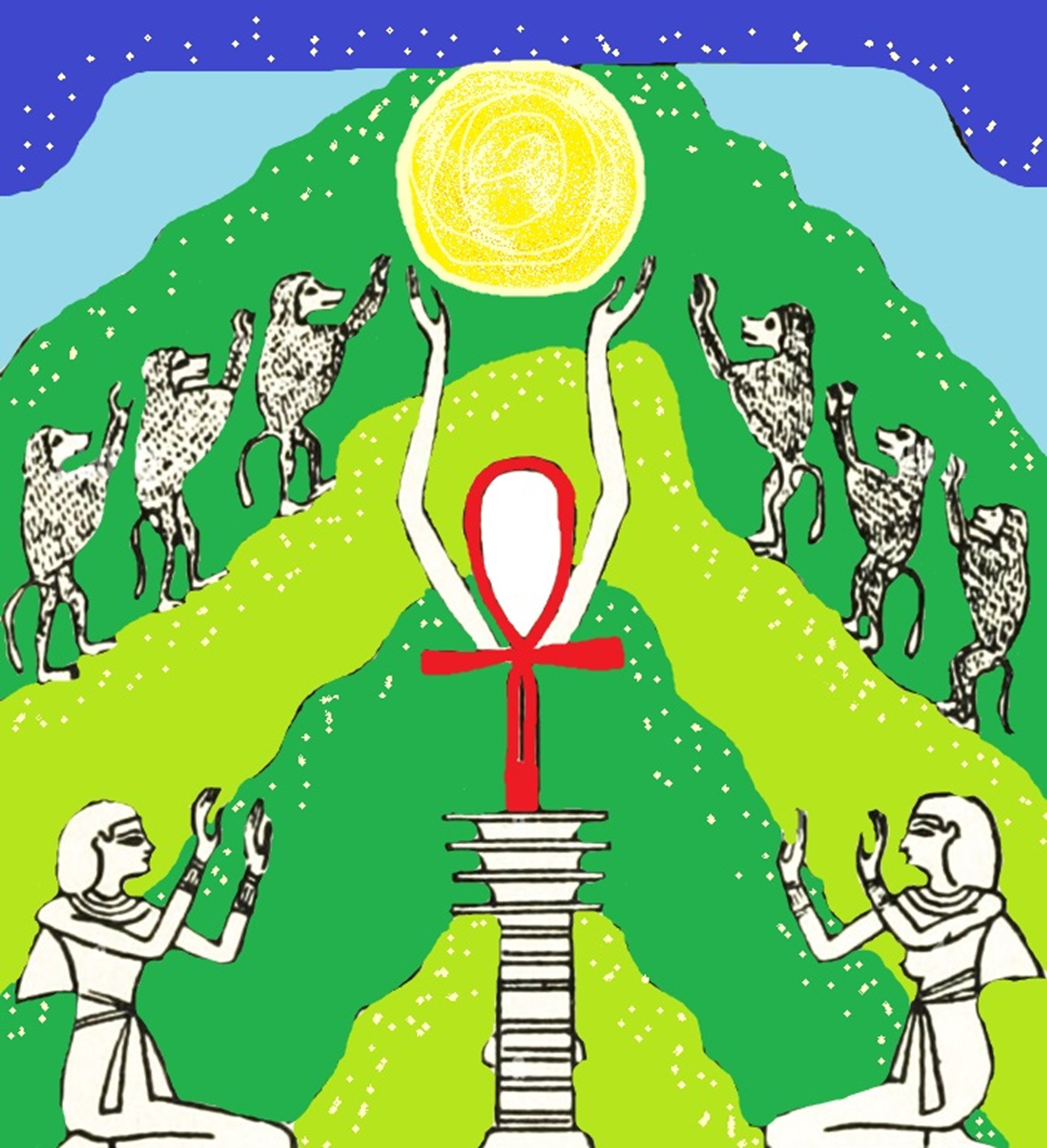
I added some art to the pic above.
“In the Mythology of all races, figures with the heads of hawks or Baboons Greet the Sun jackals, who were also Over the celestial pillar, the celestial tree, called the souls 01 the east, are described as saluting the sun every morning, some scholars have attempted to see in this allusions to the cries with which the animals of the wilderness seem joyfully to hail the rising sun. However, the autocephalous ba-boons who, according to the Egyptian view, like-wise welcome the sun, thus with prayers and hymns at his rising, also bid him farewell at his setting.” ref
Atum – Sun god who once was an egg
“Atum (/ɑ.tum/, Egyptian: jtm(w) or tm(w), reconstructed [jaˈtaːmuw]; Coptic ⲁⲧⲟⲩⲙ Atoum), sometimes rendered as Atem, Temu, or Tem, is the primordial God in Egyptian mythology from whom all else arose. He created himself and is the father of Shu and Tefnut, the divine couple, who are the ancestors of the other Egyptian deities. Atum is also closely associated with the evening sun. As a primordial god and as the evening sun, Atum has chthonic and underworld connections. Atum was relevant to the ancient Egyptians throughout most of Egypt’s history. He is believed to have been present in ideology as early as predynastic times, becoming even more prevalent during the Old Kingdom and continuing to be worshiped through the Middle and New Kingdom, though he becomes overshadowed by Re around this time. Atum is one of the most important and frequently mentioned deities from earliest times, as evidenced by his prominence in the Pyramid Texts, where he is sometimes syncretized with Ra to form Ra-Atum, and is portrayed as both a creator and father to the king throughout the collection of spells. Several writings contradict how Atum was brought into existence. According to the Heliopolitan view, Atum originally existed in his egg within the primeval waters, being born during the primordial flood, becoming the source of everything that was created after him. The Memphites (priests of Memphis), on the other hand, believed that Ptah created Atum in a more intellectual way, using his speech and thought, as told on the Shabaka Stone. In the Heliopolitan creation myth, Atum was considered to be the first god, having created himself, sitting on a mound (benben) (or identified with the mound itself), and rose from the primordial waters (Nu). Early myths state that Atum created the god Shu and goddess Tefnut by spitting them out of his mouth. One text debates that Atum did not create Shu and Tefnut by spitting them out of his mouth by means of saliva and semen, but rather by Atum’s lips. Another writing describes Shu and Tefnut being birthed by Atum’s hand. That same writing states that Atum’s hand is the title of the god’s wife based on her Heliopolitan beginning. Other myths state Atum created by masturbation, with the hand he used in this act that may be interpreted as the female principle inherent within him due to the fact that the word for hand in Egyptian is feminine (ḏr.t) and identified with goddesses such as Hathor or Iusaaset. Yet other interpretations state that he made union with his shadow. In the Old Kingdom, the Egyptians believed that Atum lifted the dead king’s soul from his pyramid to the starry heavens. He was also a solar deity, associated with the primary sun god Ra. Atum was linked specifically with the evening sun, while Ra, or the closely linked god Khepri were connected with the sun at morning and midday. In the Coffin Texts, Atum has a vital conversation with Osiris in which he describes the end of the universe as a time in which everything will cease to exist with the exception of the elements of the primordial waters, stating that after millions of years he and Osiris would be the only ones to survive the end of time as serpents. He claims that he will destroy everything he created in the beginning of existence and bring it back to Nu, the primeval waters, thus describing the belief that the gods and goddesses would one day cease to exist outside of the primeval waters. In the Book of the Dead, which was still current in the Graeco-Roman period, the sun god Atum is said to have ascended from chaos-waters with the appearance of a snake, the animal renewing itself every morning. Atum is the god of pre-existence and post-existence. In the binary solar cycle, the serpentine Atum is contrasted with the scarab-headed god Khepri—the young sun god, whose name is derived from the Egyptian ḫpr “to come into existence”. Khepri-Atum encompassed sunrise and sunset, thus reflecting the entire cycle of morning and evening.” ref
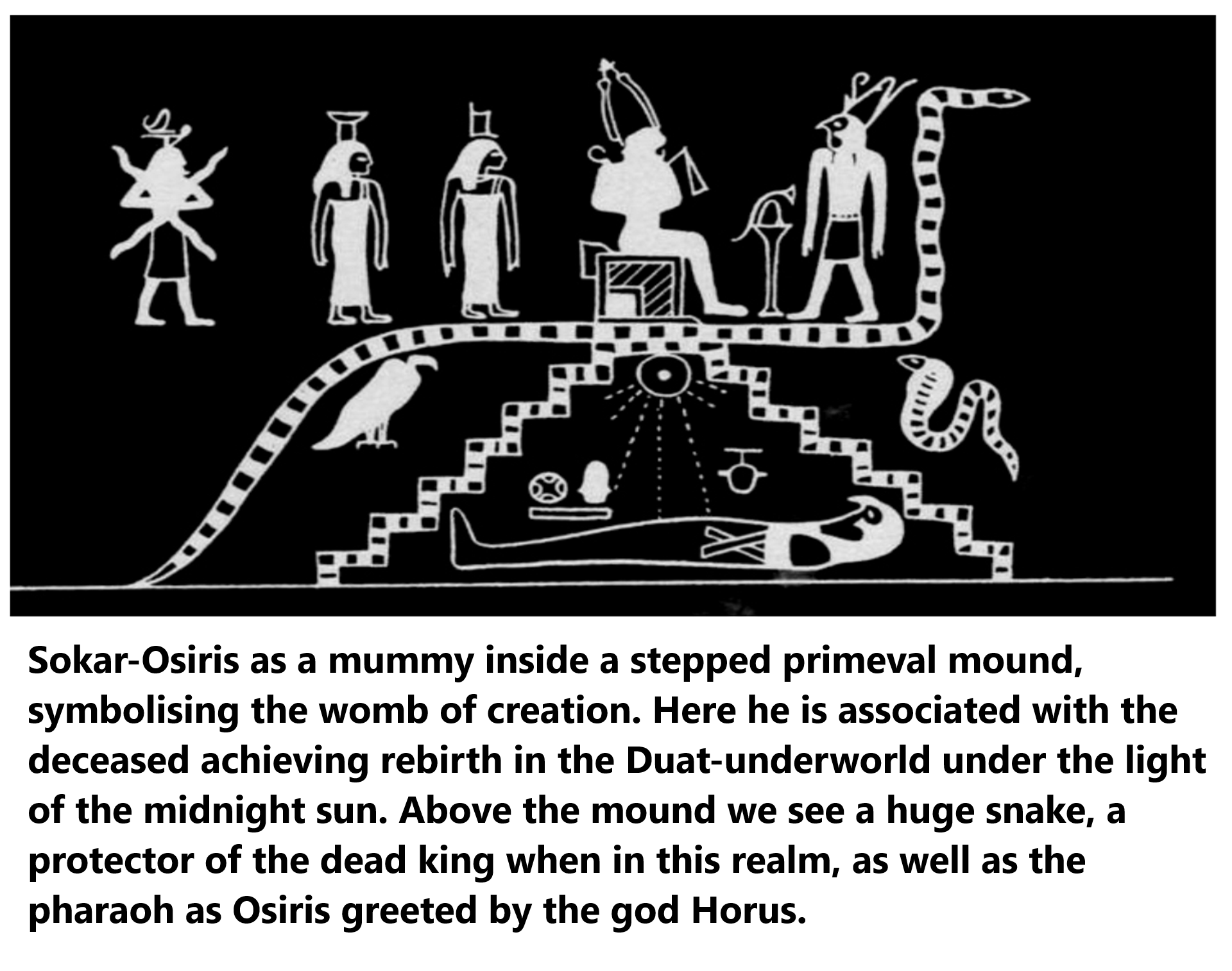
“Sokar-Osiris is a mummy inside a stepped primeval mound, symbolizing the womb of creation. Here, he is associated with the deceased achieving rebirth in the Duat-underworld under the light of the midnight sun. Above the mound we see a huge snake, a protector of the dead king when in this realm, as well as the pharaoh as Osiris greeted by the god Horus.” ref
Book of the Dead chapter 149
“The composition designated ‘chapter 149’ by Lepsius, from its position in the Ptolemaic Period papyrus of Iufankh, presents a numbered series of fourteen ‘mounds’ in the underworld. Each mound is addressed with reference to its inhabitants or landscape, and the encounter is used to empower the deceased: in this way, each potential obstacle to new life is converted into empowerment of the deceased. Most of the fourteen parts of chapter 149 occur for the first time in the Eighteenth Dynasty, and are only known from this chapter; some parts recur as separate compositions in the Book of the Dead, some already occur in the Middle Kingdom (about 2025-1700 BCE) among the funerary compositions written on the sides of coffins (the ‘Coffin Texts’), and one section echoing one of the compositions inscribed on the walls within the Old Kingdom (about 2686-2181 BCE) pyramids (‘Pyramid Texts’).” ref
“O this mound of the West, where one lives on cakes and fine vegetables, Unwind your headcloths at my approach, just as for the Eldest God among you. May he bind my bones and make my limbs firm. Bring me Ihy, lord of hearts, to have my bones built, to establish the Great Crown of Atum. Make firm my head for me, O Nehebkau, fill and make firm the balance. Rule over the gods, Min, the builder. O this mound of spirits, on which there is no sailing, which bears the spirits, while the flame is an engulfing fire. O gods who are in that mound of spirits, your faces downwards, sacred in your mounds, pure in your bindings. This is what you are commanded to do for me by Osiris for eternity. I am the great one of the Red Crown at the fore of the spirits, who brings the Two Lands and all their people to life, by the flame of its mouth, who rescues Ra from Aapep. O he who dominates the secret mound, O this tall and mighty mountain that is in the underworld on which sky and earth alight, measuring 300 rods in length and 10 rods in width, with a serpent on it called Shooter of Two Knives,
measuring 70 cubits in its circuit, living on cutting down spirits and damned in the underworld. I stand in your stronghold, so that the sailing may be smooth, for I have seen the way past you. I am the united one, I am the male: cover your head.
I am well: I am the great in power, my eyes are given to me, and I am transfigured. What is this, going on its belly, your strength at your mountain? Look at me, I have gone against you; your strength is with me. I am the one who raises strength. I have come and taken the earth gods for Ra. I have rested in the evening, at the circling of this sky. You are in your chains. This is the order for you from the beginnings.” ref
Earth Lodge?
“A number of major Mississippian culture mound centers have identified earth lodges, either beneath (i.e. preceding) mound construction or as a mound-top building. Sequential constructions, collapses, and rebuilding of earth lodges seems to be part of the mechanism of construction for certain mounds (including the mound at Town Creek Indian Mound and some of the mounds at the Ocmulgee National Monument).” ref
Jacawitz (Mountain of Creation?)
“Jacawitz, a mountain god of the Maya. The word jacawitz means “mountain” in lowland Maya and “fire mountain” in highland Maya. In the Cholan languages, jacawitz means “first mountain”, linking the god with the first mountain of creation. The temple of Jacawitz at the Kʼicheʼ capital of Qʼumarkaj was one of the three tallest buildings in the City, a large mound south, stonework stripped away making its original form uncertain, although a 19th-century plan of the city recorded it as a pyramid.” ref
Inca Mountain Mythology
“When the two Amarus died, they turned into the chain of mountains that are located in valle del Mantaro, Peru. Paryaqaqa was victorious, Huallallo, angered, turned into a devourer of humans, blaming them for his disgrace. Viracocha watching these atrocities, punished both Paryaqaqa and Huallallo for their cruelties turning both gods into snow mountains. A representation that the Incas gave to Illapa was that of a warrior formed by stars in the celestial world. His rites took place in the highest mountains, because they believed that Illapa lived in them. Mallku (Spirits of the mountains) was a deity that represents the spirit and strength of the mountains. Mama Pacha (Mother nature or Mother Earth; a.k.a. Pachamama) was considered a sacred being by the andean cosmology. She is the mother of the hills and men.” ref
The Incan mythic Creation of the World
“According to the Inca religion, the world was created by Viracocha, the Creator, when he rose out of Lake Titicaca. In a different version, Manco Cápac and Mama Ocllo the son and daughter of the sun god Inti and the moon goddess Mama Killa. Were raised out of Lake Titicaca (or a cave near Pacaritambo, depending on who you talk to), and taught the arts of civilization – farming, building, weaving, cooking, etc. They were then sent to find the perfect place to start a new civilization. Manco Cápac was given a golden rod, and instructed by Inti that where this rod sank into the ground with a single blow, that would be the place to build the new Inca capital.” ref
“In Greek mythology, the Ourea (Ancient Greek: Οὔρεα, romanized: Oúrea
“OUREA – Greek Primordial Gods of the Mountains (Roman Montes): THE OUREA were the primordial gods (protogenoi) of the mountains. Each mountain was believed to have its own ancient deity. Mountains were depicted in classical art as old, bearded men partially emerged from between a pair of crags.” ref
LIST OF OUREA (MOUNTAIN-GODS)
- AITNA (Etna) The volcano of Sikelia (Sicily) and its goddess.
- ATHOS A mountain of Thrake (Thrace) (north of Greece) and its god.
- HELIKON (Helicon) A mountain of Boiotia (Boeotia) (central Greece) and its god. He entered a singing contest with the neighbouring Mount Kithairon (Cithaeron).
- KITHAIRON (Cithaeron) A mountain of Boiotia (Boeotia) (central Greece) and its god. He entered a singing contest with the neighbouring Mount Helikon (Helicon)..
- NYSOS (Nysus) A mythical mountain and its god. He was the nurse of the god Dionysos.
- OLYMPOS (Olympus) A mountain in Thessalia (Thessaly) (northern Greece) and its god. Olympos was the home of the gods.
- OLYMPOS (Olympus) A mountain of Phrygia (in Anatolia) and its god.
- OREIOS (Oreus) The mountain-god of Mount Othrys in Malis (central Greece).
- PARNES A mountain between Boiotia (Boeotia) and Attika (Attica) (central Greece) and its god.
- TMOLOS (Tmolus) A mountain of Lydia (in Anatolia) and its god. He was the judge of a musical contest between Apollon and Pan.” ref
“Lugaldukuga (Sumerian: “lord of the holy mound”) was a Mesopotamian god primarily understood as a theogonic figure. He is best attested as the father of Enlil, the head of the Mesopotamian pantheon, though other traditions about the parentage of the latter also existed, and no references to him in this role are known from before the Kassite period. Sometimes he could also be described as his grandfather instead. He was envisioned as a no longer active and as an inhabitant of the underworld. He could be equated with other deities of similar character, such as Enmesharra. It is not known which part of Mesopotamia he originated in, though references to him are known from texts from both Babylonia and Assyria. The name Lugaldukuga could also function as an epithet of the god Ea, who was not regarded as Enlil’s father.” ref
“Lugaldukuga was understood as a primeval deity. Such figures were generally regarded as ancient and no longer active (unlike the regular gods) by the Mesopotamians. Wilfred G. Lambert proposed that Lugaldukuga was originally understood as a “prime mover” in the local theology of a presently unknown small settlement, and only came to be incorporated into major scholarly works at a later date. His name means “lord of the holy mound (the Duku)” in Sumerian. The Duku was regarded as the place where Enlil determined destinies for other deities. It was also believed to be the dwelling of his ancestors. The word has two possible meanings, as the sign du could refer to both a hill and to a brick platform. According to Wilfred G. Lambert, it is possible that they could be interpreted as the cosmic location and its physical representation in Enlil’s Ekur temple complex in Nippur.” ref
“The Goddess Mound, a permanent place for worship and celebration of the female deity.” – Cristina Biaggi, Ph.D.
“Cristina Biaggi’s Goddess Mound will be both a sacred place in itself and a long overdue link to the sacred earthworks that were on this continent long before Europeans arrived. It will be a tribute to matrilineal cultures that honored women and men, sky and earth, spirit and nature; an honoring of the past – and a path to the future.” – Gloria Steinem/Co-founder of Ms. Magazine, writer, lecturer, editor, and feminist activist” ref
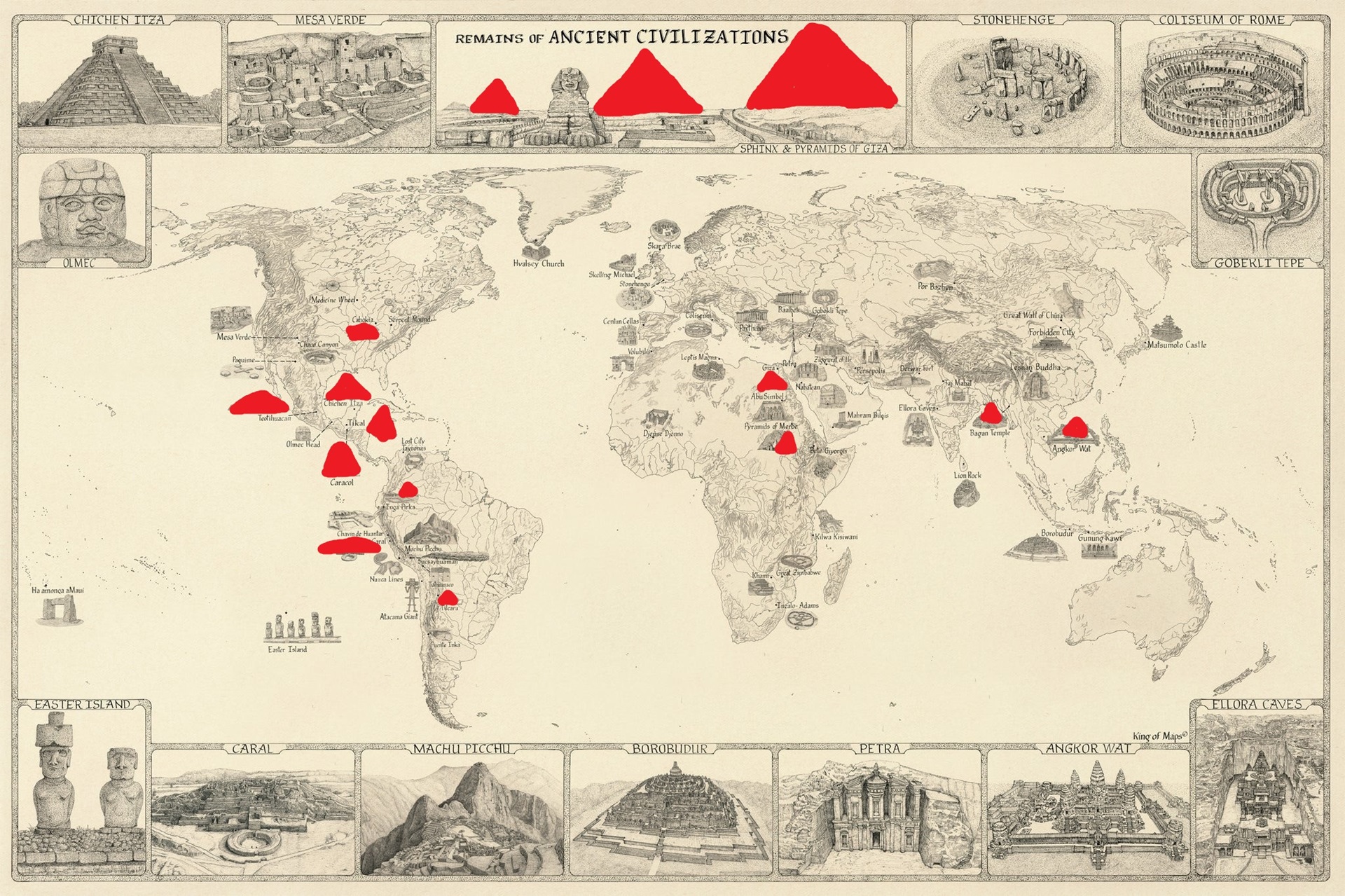
BIRTH OF Inequality and Oppression Hierarchy
“During the fourth millennium BCE the cultural development already perceptible during the Ubaid period proceeded at a quicker pace, and the Sumerian civilization finally blossomed. The new villages, like the old ones, were situated on river banks, but they tended to cluster around those Ubaid period settlements, which were both the abodes of the great gods upon whom all prosperity depended and the centers of sizeable agricultural communities. Technical improvements generated a large surplus of food that could be stored, redistributed, or exchanged for imported raw materials and luxuries, while other inventions – such as the potter’s wheel and the casting of copper alloys – opened the era of industrial production. This went on for three or four centuries, but towards the end of the millennium, the effects of desiccation started to be felt in southern Mesopotamia.” ref
“Many villages disappeared, their inhabitants regrouping themselves within and around the larger centers, which rapidly grew to the size of towns. To extend the areas of cultivable land artificial irrigation was developed, but the enormous common effort required to dig and maintain big canals and the need for an equitable distribution of water considerably reinforced the authority of the traditional town chiefs, the high priests. This, together with the scarcity of fertile land, led to the concentration of power and wealth in a few hands and in a few places, it would seem, turned into the first city-states of ancient Sumer, with their fortified cities and well-defined territories, with their population of priests, scribes, architects, artists, overseers, merchants, factory workers, soldiers and peasants and their religious rulers or war leaders. But there is little doubt that the people responsible for the urbanization of southern Mesopotamia were closely related to, or had been absorbed by, the Ubaidians, for there is no clear-cut break between the Ubaid culture and the Uruk culture and no sign of armed invasion and destruction.” ref
“On all the sites excavated, such as Eridu, Uruk, and Ur, the new temples are built over old ones, on the same plans and with the same materials, and the distinctive Uruk ware – a wheelmade, mass-produced, unpainted but sometimes highly polished buff, grey or red pottery, which in some of its forms seems to copy the metal vessels now used by the wealthy – very slowly replaces the Ubaid ware. As for the other elements of the Uruk and Jemdat Nasr cultures (cylinder-seals, cone-mosaic wall decoration, reliefs and sculptures in the round, temples on high terraces), they either derive from older Mesopotamian models or can be credited to the inventiveness of local artists and architects. We are therefore confronted here not with a civilization imported ready-made, but with the final stages of an evolution that had begun with the foundation of Eridu and possibly even earlier in northern Iraq.” ref
“The site which gave its name to that period is Uruk (biblical Erech, modern Warka), whose large and impressive ruins lie in a non-desert area about half-way between Baghdad and Basrah, not far from the small town of Samawa. It is one of the most important sites of the Near East, the city of Uruk was born of the coalescence of two towns 800 meters apart: Kullaba, devoted to the sky-god An (or Anu), the supreme god of the Mesopotamians, and E-Anna (‘House of Heaven’), the main abode of the love goddess Inanna (called Ishtar by the Semites). In the center of E-Anna, can still be seen the remains of a mud-brick stage tower (ziqqurat) built by the Sumerian king Ur-Nammu (c. 2112 – 2095 BCE) over a large temple raised on a platform and dating to the Jemdat Nasr period 3100 to 2900 BCE. It is in this area that the German archaeologists, who since 1912 have been digging on and off at Warka for about fifty years, have unearthed at least seven adjacent or superimposed temples and various other cultic installations dating to the second half of the Uruk period. It is also there that they sunk a twenty meter deep well reaching the virgin soil and obtained a stratigraphic section of the site, apparently founded during the Ubaid period.” ref
“The archaic temples of Uruk were very similar in plan to those of the Ubaid period at Eridu already described: the buttressed façade, the long cella surrounded by small rooms, the doors on the long side testify to the persistence of architectural traditions as well, probably, as of belief and cult. In E-Anna, they were arranged in pairs, dedicated not only to Inanna but also to her lover, the fertility-god Dumuzi.” ref
“(“Dumuzid the Shepherd”) In addition to being the god of shepherds, Dumuzid was also an agricultural deity associated with the growth of plants. Dumuzid was also listed as an early king of Uruk, where he was said to have come from the nearby village of Kuara and to have been the consort of the goddess Inanna. In the poem “Inanna Prefers the Farmer” (ETCSL 4.0.8.3.3) begins with a rather playful conversation between Inanna and her brother Utu, who incrementally reveals to her that it is time for her to marry. Dumuzid comes to court her, along with a farmer named Enkimdu. At first, Inanna prefers the farmer, but Utu and Dumuzid gradually persuade her that Dumuzid is the better choice for a husband, arguing that, for every gift the farmer can give to her, the shepherd can give her something even better. In the end, Inanna marries Dumuzid. The shepherd and the farmer reconcile their differences, offering each other gifts. Samuel Noah Kramer compares the myth to the Biblical story of Cain and Abel because both accounts center around a farmer and a shepherd competing for divine favor and, in both stories, the deity in question ultimately chooses the shepherd.” ref
“Particularly remarkable were the lowermost levels with their enormous temples – one of them, built on limestone foundations, measured 87 by 33 meters – and their extraordinary ‘mosaic building’. The latter consisted of a large courtyard extending between two sanctuaries, with a raised portico of eight massive mud-brick columns, three meters in diameter, arranged in two rows. The side walls of the courtyard, the columns themselves and the platform on which they rested were entirely clad in a colored pattern of geometrical design formed by the flat end of terracotta cones, seven to ten centimeters long, which had been painted in black, red or white and then stuck into the mud plaster. This original and very effective type of decoration was widely used during the Uruk and Jemdat Nasr periods, and loose clay cones can still be picked up by the thousand in the ruins of Warka. The color, when preserved, has lost its brightness, but little effort is required to imagine what a fresh cone-mosaic facade must have looked like in the glaring oriental sunlight. This taste for color is also manifest in the use of wall painting.” ref
“One of the archaic temples of E-Anna, the so-called ‘Red Temple’, owes its name to the pink wash which covered its walls, and at Tell ‘Uqair, eighty kilometres south of Baghdad, the Iraqis excavated in 1940 a temple of the Uruk period decorated with frescoes which, when discovered, were ‘as bright as the day they were applied’: human figures, unfortunately damaged, formed a procession, and two crouching leopards guarded the throne of an unknown god. All these temples, it must be noted, rested on low brick platforms, as did the temples of the Ubaid period at Eridu; but with time the platform became higher, tending to be more important in size than the building itself. Here in all probability is the origin of the ziqqurat, the stage-tower topped by a shrine so typical of the Mesopotamian civilization in historical times. This evolution is illustrated by the Anu temple of Uruk, where six temples built in succession were finally included in a truly monumental platform rising some fifteen metres above the plain. At the top of this platform are the amazingly well-preserved remains of a sanctuary dating to the late Uruk period, the so-called ‘White Temple‘, and to stand between these walls, at the very place where officiated, five thousand years ago, the priests of the sky-god, is an experience which no visitor will easily forget.” ref
“Domestic architecture is poorly represented in southern Iraq, but we may catch a glimpse of it on other, distant sites – for the Uruk culture progressively spread throughout Mesopotamia and covered roughly the same area as the Ubaid culture. Near Erbil, for instance, at Tell Qalinj Agha,6 two large residential quarters were separated by a main street, 2 to 3 metres wide, intersected by smaller streets at a right angle, and the same regular plan can be seen at Habuba Kabira, on the great bend of the Euphrates, a city which covered not less than 22 hectares and was surrounded by a wall with square towers.7 In both places the houses, carefully built of oblong bricks, consisted of three buildings of two to four spacious rooms each, around a large hall or courtyard. The magnificence of the Uruk temples and the near-luxurious aspect of private houses tend to dwarf the other forms of art. Yet the seal impressions of the Uruk period are little masterpieces. At that time the stamp-seal of earlier periods was almost entirely superseded by the cylinder-seal.” ref
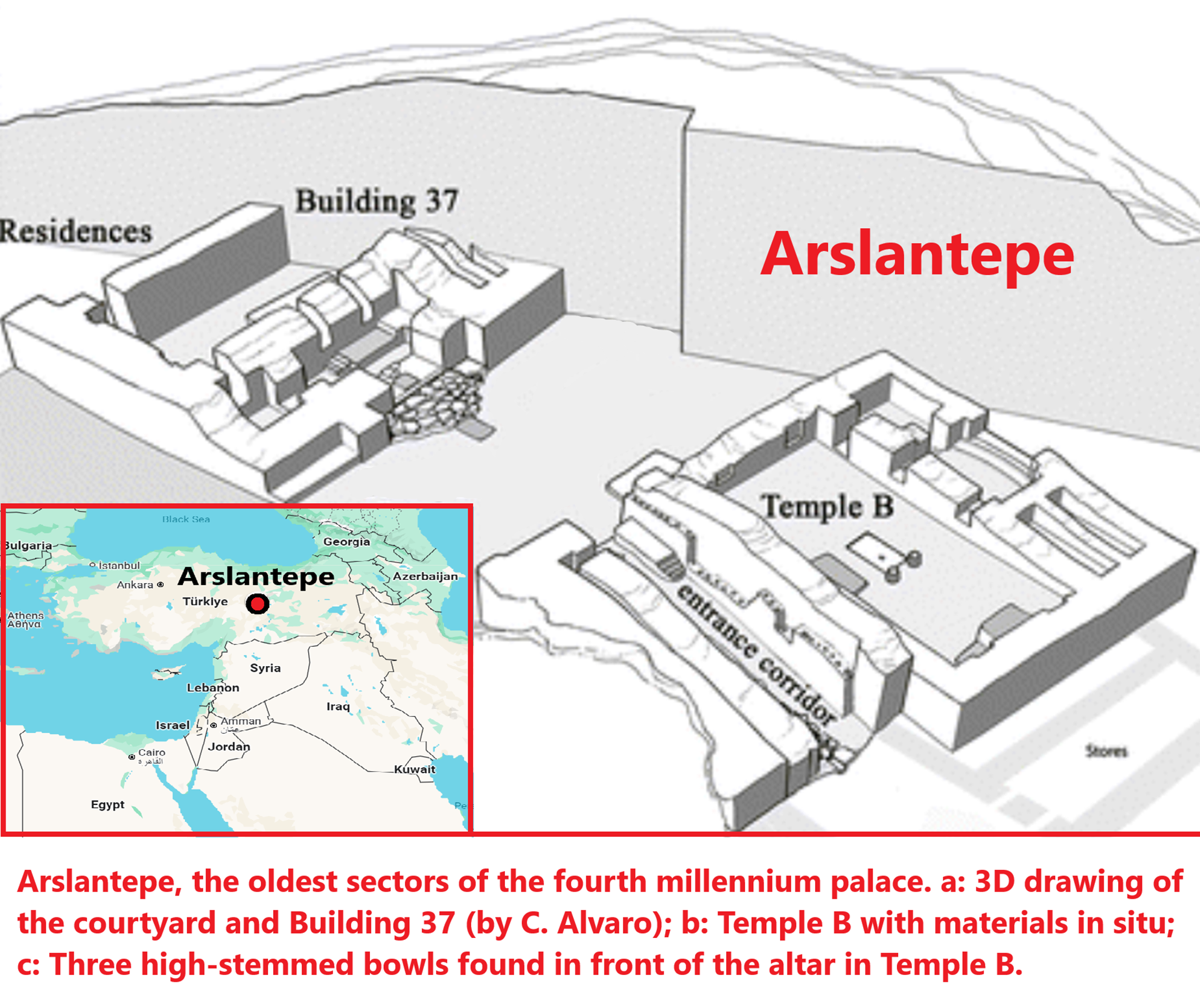
“Arslantepe, the oldest sectors of the fourth-millennium palace. a: 3D drawing of the courtyard and Building 37 (by C. Alvaro); b: Temple B with materials in situ; c: Three high-stemmed bowls found in front of the altar in Temple B.” ref
“Arslantepe Mound is a 30-metre-tall archaeological tell located in the Malatya plain, 15 km south-west of the Euphrates River. Archaeological evidence from the site testifies to its occupation from at least the 6th millennium BCE up until the Medieval period. The earliest layers belong to the Late Chalcolithic 1-2 periods, contemporary to Early Uruk in Southern Mesopotamia (4300-3900 BCE or around 6,300 to 5,900 years ago), and are characterized by adobe houses. The most prominent and flourishing period of the site was in the Late Chalcolithic 5 period, during which the so-called palace complex was constructed. Considerable evidence also testifies to the Early Bronze Age period, most prominently identified by the Royal Tomb complex. The archaeological stratigraphy then extends to the Middle and Late Bronze Ages and Hittite periods, including Neo-Hittite levels. The site illustrates the processes which led to the emergence of a State society in the Near East and a sophisticated bureaucratic system that predates writing. Exceptional metal objects and weapons have been excavated at the site, among them the earliest swords so far known in the world, which suggests the beginning of forms of organized combat as the prerogative of an elite, who -at Arslantepe- exhibited them as instruments of their new political power.” ref
“In Greek mythology, the Ourea (Ancient Greek: Οὔρεα, romanized: Oúrea
“OUREA – Greek Primordial Gods of the Mountains (Roman Montes): THE OUREA were the primordial gods (protogenoi) of the mountains. Each mountain was believed to have its own ancient deity. Mountains were depicted in classical art as old, bearded men partially emerged from between a pair of crags.” ref
LIST OF OUREA (MOUNTAIN-GODS)
- AITNA (Etna) The volcano of Sikelia (Sicily) and its goddess.
- ATHOS A mountain of Thrake (Thrace) (north of Greece) and its god.
- HELIKON (Helicon) A mountain of Boiotia (Boeotia) (central Greece) and its god. He entered a singing contest with the neighbouring Mount Kithairon (Cithaeron).
- KITHAIRON (Cithaeron) A mountain of Boiotia (Boeotia) (central Greece) and its god. He entered a singing contest with the neighbouring Mount Helikon (Helicon)..
- NYSOS (Nysus) A mythical mountain and its god. He was the nurse of the god Dionysos.
- OLYMPOS (Olympus) A mountain in Thessalia (Thessaly) (northern Greece) and its god. Olympos was the home of the gods.
- OLYMPOS (Olympus) A mountain of Phrygia (in Anatolia) and its god.
- OREIOS (Oreus) The mountain-god of Mount Othrys in Malis (central Greece).
- PARNES A mountain between Boiotia (Boeotia) and Attika (Attica) (central Greece) and its god.
- TMOLOS (Tmolus) A mountain of Lydia (in Anatolia) and its god. He was the judge of a musical contest between Apollon and Pan.” ref
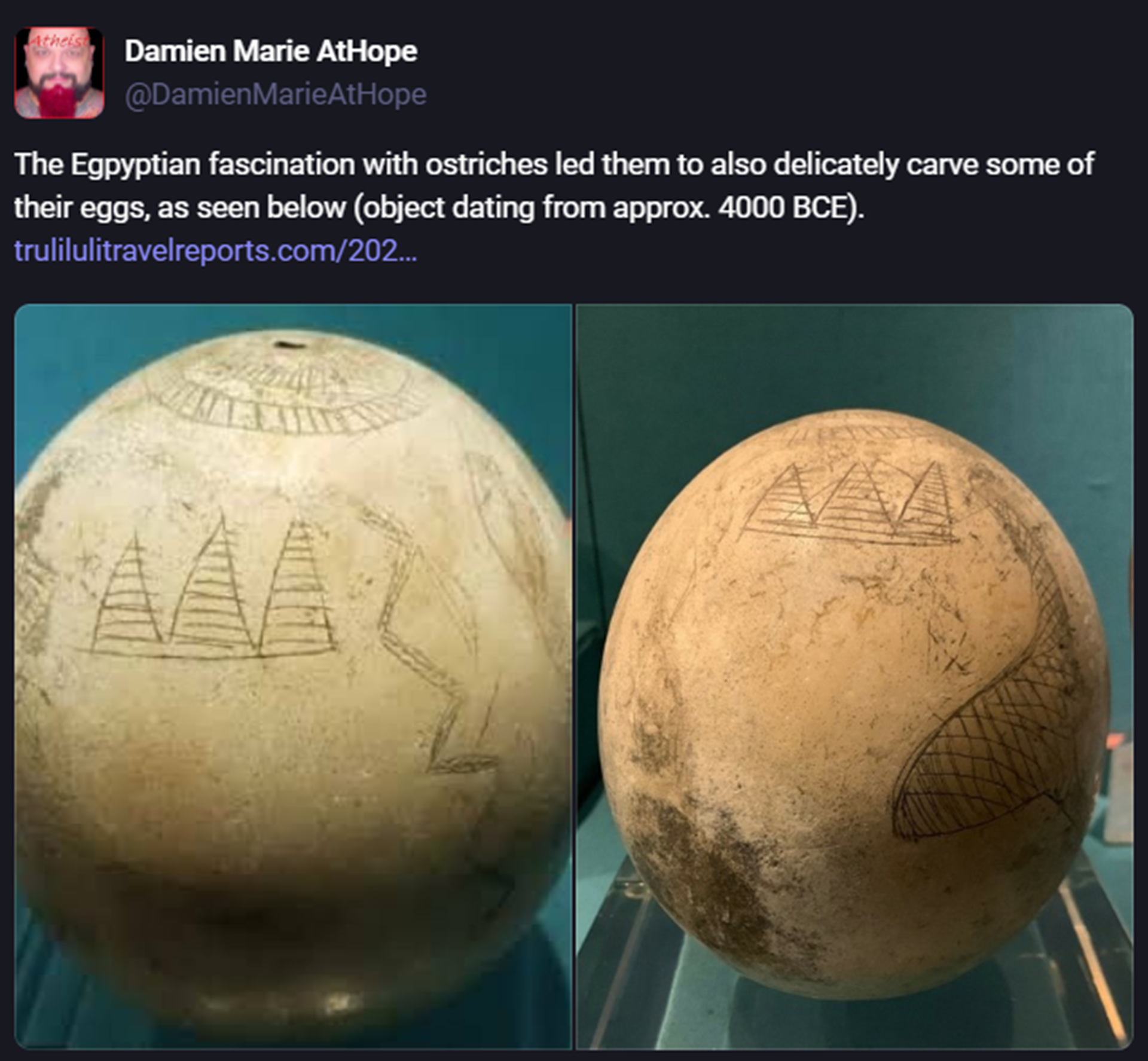
“The Egyptian fascination with ostriches led them to also delicately carve some of their eggs.” ref
“Does a 7000 year old ostrich eggshell held at the Nubian Museum depict a drawing of ancient Egyptian pyramids? If so, when was the drawing drawn? There is a conspiracy theory on the internet that a 7000-year-old ostrich eggshell held at the Nubian Museum depicts a drawing of ancient Egyptian pyramids.” ref
“Does A “Mysterious” Ostrich Egg Prove the Pyramids are thousands of years older – NO.” ref
The Pyramids at Giza are exactly as Old as we think they are
“There are multiple lines of evidence for the age of The Pyramids i.e. built during the 4th Dynasty, roughly 2613 to 2494 BC. There are masons/work crew marks on the stones in hieroglyphs. Hieroglyphs were only invented at roughly 3000BC and were not standardized until the 3rd Dynasty, ergo The Pyramids can’t be older than the 3rd Dynasty. We have administrative records about the construction. There of course are historical records that back this up too, I won’t go into details, the Wikipedia Page is pretty good if you want more – https://en.wikipedia.org/wiki/Great_Pyramid_of_Giza and of course carbon dating. It is true that limestone and granite, what The Pyramids are made of, can’t be carbon dated because they have no carbon, the material needed for carbon dating. So how did we, archaeologists, carbon date The Pyramids? The mortar between the stones is how. Ash and charcoal was mixed into the mortar and ash and charcoal are basically nothing but carbon. So it is very much possible to carbon date The Pyramids.
“In fact, there have been two big carbon dating projects on The Pyramids in the 1980s and 1990s. They were funded by wealthy donors looking to prove they were much older… that found they are exactly as old as we though they were. I am guessing the funders were not happy too. But the reasoning is important here, if the funders had every reason to try and prove their pet theory, that The Pyramids are much older, and couldn’t, then you can be sure that no one is going to be able to. These were billionaires with resources that archaeologists could only dream of. Over 450 samples were taken between the two projects, the Great Pyramid at Giza had ~50 samples alone. I can’t tell you how much over kill it is to run 50 samples on a single building with only one phase of construction. It most cases, we only run a handful of dates on most archaeological excavations, if any. These samples were tested at three different labs to ensure there were no errors – they all got the same results. You can read the paper where the full results were published here – https://www.cambridge.org/core/journals/radiocarbon/article/radiocarbon-dates-of-old-and-middle-kingdom-monuments-in-egypt/A967302ADD527BFEB9226457682C0B4A. Contrary to what those tweets, blog posts, etc. say, The Pyramids have been carbon dated, a lot, like way too much.
The Egg was Not Dated
“The original blogger that started this all actual says in the comments of her post that the source of the carbon dating of the egg was … not scientific and did not cite the source when someone asked for it. “My info on carbon dating was not a scientific source, so I don’t think it would be helpful to you.” We know the egg was not carbon-dated because the egg was excavated in 1909-10 before carbon dating was invented in the late 1940s. You can read the excavation report here – https://sfdas.com/IMG/pdf/5_-firth_c._m._the_archaeological_survey_of_nubia_1909-1910.pdf. There is even a photo of the grave it came from in this paper on Ostrich Eggs in Ancient Egypt- https://www.researchgate.net/publication/343510437_Ostrich_Eggs_of_Predynastic_Egypt (really interesting stuff, I would recommend reading it). Furthermore, carbon dating is a destructive process. You have to destroy part of the egg to be able to date it, and Ostrich Eggs are hard to date. It is so hard to date that it usually requires 5-10 grams of the egg to be destroyed to get a good carbon date. There is no large sample section taken out of the egg, so we know it was not dated later, after carbon dating was invented.” ref
“However, the date is real, it is 7000ish years old. The date of the egg comes from the associated artifacts found in the grave. This is actually the most common method of dating in archaeology. If we know when one type of artifact was made, we can then date all the other artifacts found with it. The egg was found in a grave whose artifacts are about 7000 years old so we know it is that old. However, if we are confident of the age of The Pyramids, really confident on this point (hundreds of carbon dates + ton of other evidence), and confident of the age of the egg, it means the image on the egg can’t be The Pyramids. Also, there are ten* pyramids at Giza, not three, so there is that really obvious reason why they can’t be the same too.” ref
So, what is the Image on the Egg?
“We don’t know. The design style at that time was heavily geometric, so it could just be a geometric design with no meaning. It could actually be pyramids – small p, as in something shaped like a pyramid, maybe tents? mountains? hills? This is the fun part of archaeology: a bit of a hypothesis about what it might be. We have eliminated it so that it could represent the Pyramids at Giza, but beyond that, there is a whole range of possibilities, so feel free to make your own guess. (Mountains???).” ref
Pyramidology?
“Pyramidology (or pyramidism) refers to various religious or pseudoscientific speculations regarding pyramids, most often the Giza pyramid complex and the Great Pyramid of Giza in Egypt. Some “pyramidologists” also concern themselves with the monumental structures of pre-Columbian America (such as Teotihuacan, the Mesoamerican Maya civilization, and the Inca of the South American Andes), and the temples of Southeast Asia.” ref
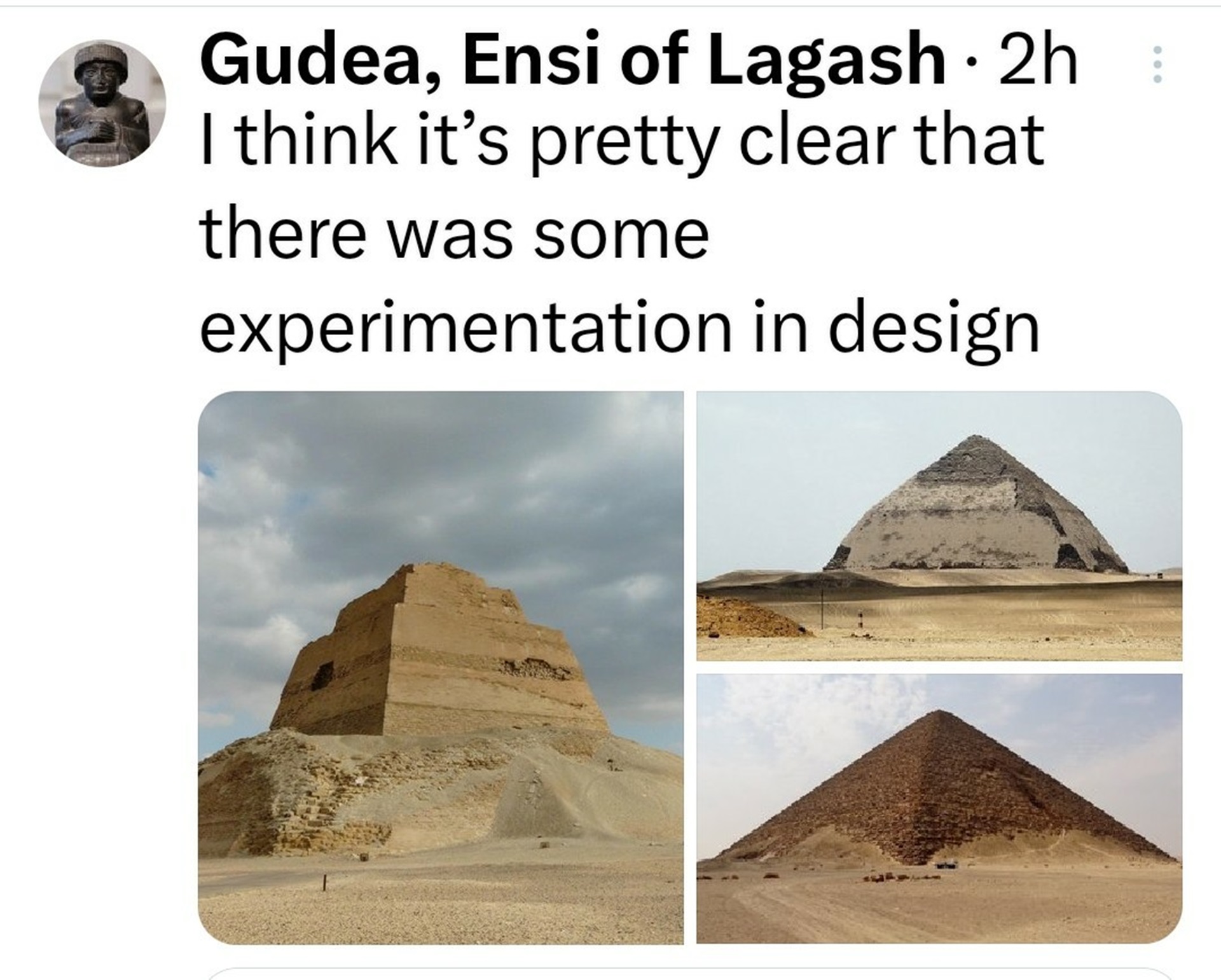
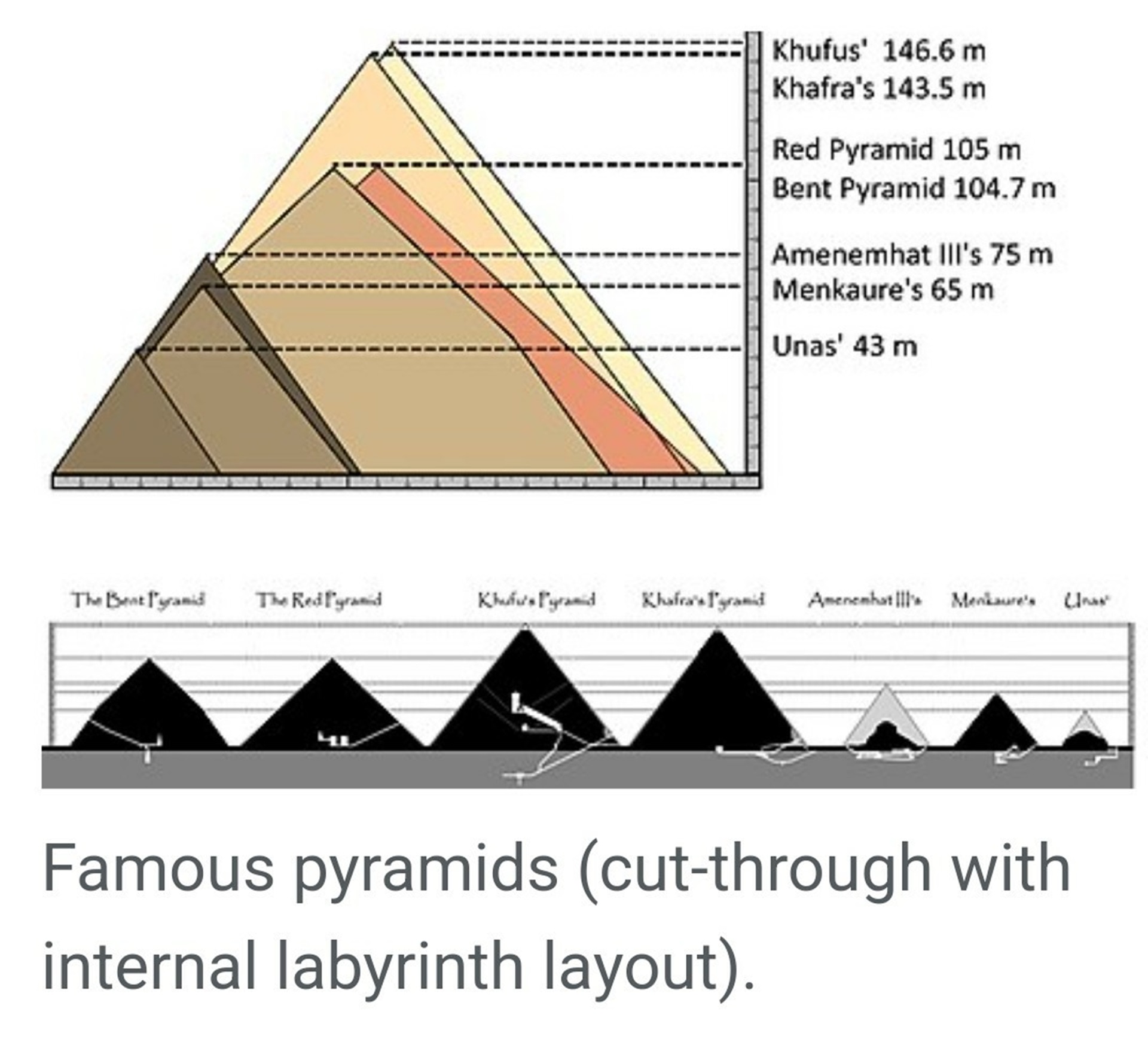
ref
Egyptian pyramids?
“The Egyptian pyramids sources cite at least 118 identified “Egyptian” pyramids.” ref
Ancient Egyptian Deities?
“The first written evidence of deities in Egypt comes from the Early Dynastic Period (c. 3100–2686 BCE or around 5,100 to 4,686 years ago). Deities must have emerged sometime in the preceding Predynastic Period (before 3100 BCE) and grown out of prehistoric religious beliefs. Predynastic artwork depicts a variety of animal and human figures. Some of these images, such as stars and cattle, are reminiscent of important features of Egyptian religion in later times, but in most cases, there is not enough evidence to say whether the images are connected with deities.” ref
“Tatenen (also Ta-tenen, Tatjenen, Tathenen, Tanen, Tenen, Tanenu, and Tanuu) was the deity of the primordial mound in ancient Egyptian religion. His name means “risen land” or “exalted earth”, as well as referring to the silt of the Nile. As a primeval chthonic deity, Tatenen was identified with creation. Both feminine and masculine, he was an androgynous protector of nature from the Memphis area (then known as Men-nefer), the ancient capital of the Inebu-hedj nome in Lower Egypt. Tatenen represented the Earth and was born in the moment it rose from the watery chaos, analogous to the primeval mound of the benben and mastaba and the later pyramids. He was seen as the source of “food and viands, divine offers, all good things”, as his realms were the deep regions beneath the earth “from which everything emerges”, specifically including plants, vegetables, and minerals.” ref
“In the Third Intermediate Period hymn, The Great Hymn of Khnum, he is identified with the creator god Khnum, who created “all that is” on his potter’s wheel. This fortuity granted him the titles of both “creator and mother who gave birth to all gods” and “father of all the gods.” He also personified Egypt (due to his associations with rebirth and the Nile) and was an aspect of the earth-god Geb, as a source of artistic inspiration, as well as assisting the dead in their journey to the afterlife. He is first attested in the inscriptions that mostly appear on coffins during the First Intermediate Period and Middle Kingdom.” ref
“In those inscriptions his name appears as Tanenu or Tanuu, ‘the inert land’, a name which characterizes him as a deity of the primeval condition of the earth. Middle Kingdom texts provide the first examples of the form Tatenen. With a staff, Tatenen repelled the evil serpent Apep from the Primeval Mound. He also had a magical mace dedicated to the falcon, venerated as “The Great White of the Earth Creator.” In one interpretation, Tatenen brought the Djed-pillars of stability to the country, although this is more commonly attributed to Ptah.” ref
“Tatenen’s ambiguous portrayal may be a result of his being merged with Ptah. He was most commonly depicted in human form, sometimes with green skin, usually seated with a pharaonic beard, wearing either an Atef-crown (as Ptah-Sokar) or, more commonly, a pair of ram’s horns surmounted by a sun disk and two tall feathers. As Tanenu or Tanuu, obviously a chthonic deity, he carried two snakes on his head. He was both feminine and masculine because of his status as a primeval, creator deity. Some depictions show Tatenen with a green complexion (face and arms), as he had connections to fertility and a chthonic association with plants.” ref
“In the Pyramid Texts, e.g. Utterances 587 and 600, Atum himself is at times referred to as “mound.” It was said to have turned into a small pyramid, located in Heliopolis (Egyptian: Annu or Iunu), within which Atum was said to dwell. Other cities developed their own myths of the primeval mound. At Memphis, the god Tatenen, an earth god and the origin of “all things in the shape of food and viands, divine offers, all good things,” was the personification of the primeval mound.” ref
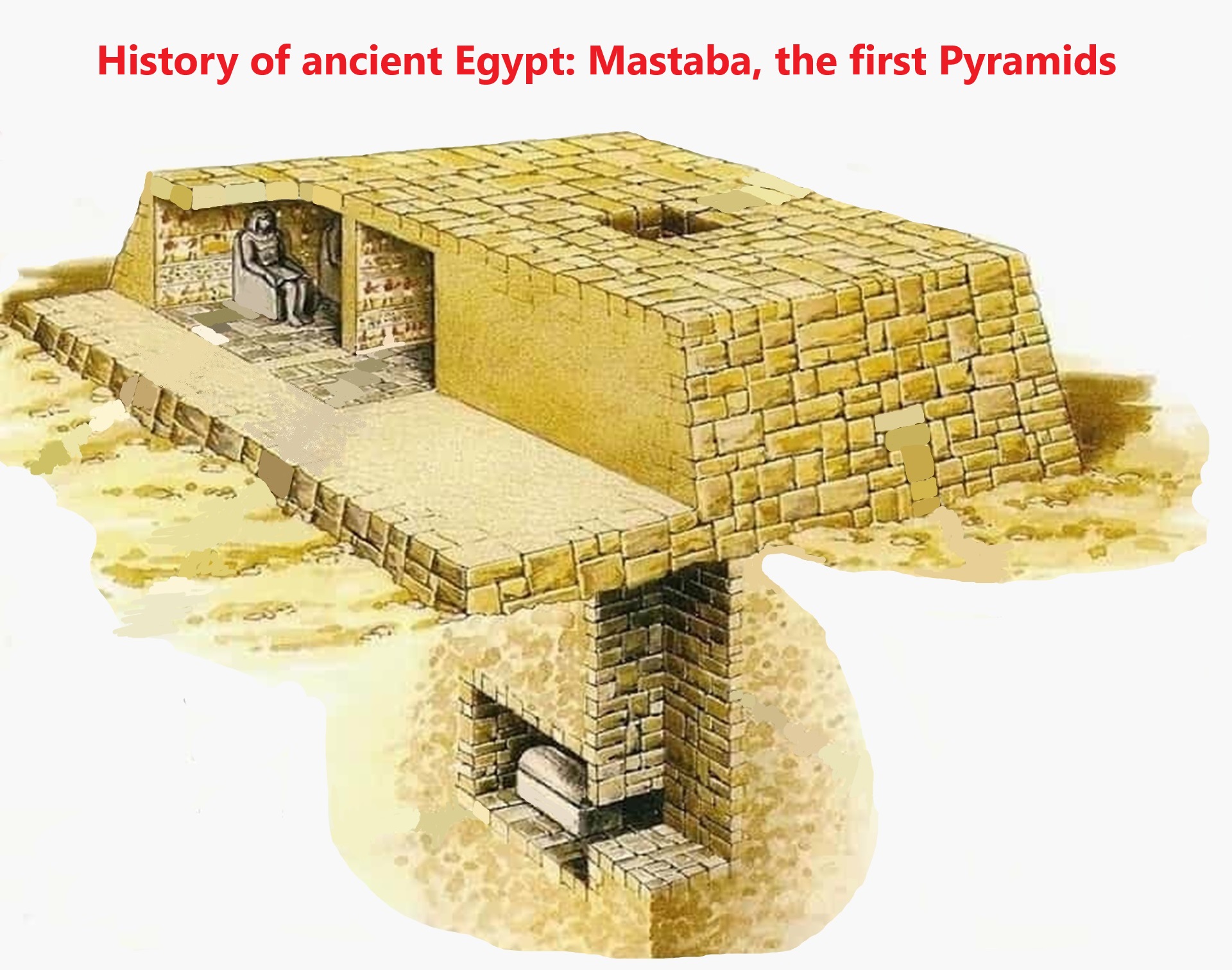
History of ancient Egypt: Mastaba, the first Pyramids
THE PRIMEVAL MOUND AND THE MASTABA
“The mastabas of the early dynasties contained within them a development of the primeval mound, the place of original creation in Zep Tepi, the First Time, an embryonic stepped structure concealed inside the building’s internal fabric.” ref
“It was almost inevitable, therefore, that later generations should express their creative spirit in a shape of pure force, colossal but surging upwards, resting with absolute confidence on the earth, immovable but expressing that reaching out for the firmament — and beyond it, to the realm of the Imperishable Stars — which is so typical of the spirit of early Egypt. It would have been more extraordinary, perhaps, if the Egyptians had not produced so perfect a shape as the pyramid, at this particular point in their development. That they did so sets the final seal on their achievement; after that expression of creative energy it was only to be expected that decline would inevitably follow. It was not a performance that could ever be repeated, nor one that could even be sustained; indeed, it may be argued that it could not be matched.” ref
“The pyramid, the supreme artifact of the age which was now approaching, represented in stone the summation of all that early Egypt was seeking to express. In every aspect of life, particularly those which touched the king in any way, the early builders of the Egyptian state were attempting to reconcile the cosmic with the human, to identify their society with concepts which otherwise defied articulation. The Egyptians possessed an exceptional ability to synthesize complex propositions and penetrating perceptions in symbol and in expressions of the form and content of buildings. Often, such synthesis was occluded. An example, which is pertinent to the origins of the Step Pyramid, is the terraced mound, whose origin lies in the little pile of sand raised above a Badarian grave. The mound signifies the Primeval Hill, the mound of creation on which the creator god settled himself when it first appeared above or out of the waters of the Abyss, on which he performed the first acts which inaugurated the cycle of creation itself.” ref
“The most spectacular manifestations of the terraced mound are the Step Pyramid and its companions in other parts of the Valley. The terraced mound would have had a powerful mystical appeal both to Imhotep and to his master. By means of it, Netjerykhet is able to mount to the stars; also it permits the king to fulfil the role of the creator god on his mound, in the perpetual renewal of the life of Egypt, which the whole complex at Saqqara encompasses. The terraced mound evidently meant something of profound importance to the powers of the Third Dynasty and, so far as we can judge, particularly to them. Their successors of the Fourth Dynasty began at once to break away from the stepped form in the experimental structures which King Sneferu developed at Dahshur and Maidum, which achieved their consummation in the pyramids which his successors raised on the plateau at Giza.” ref
“There is a still more numinous form of the terraced mound, from much earlier times which is, in a quite literal sense, even more occult. Hidden in the core of the brick-enclosed rubble superstructures of several of the large First Dynasty mastabas at Saqqara is buried, as though waiting for its ultimate liberation or rebirth in the soaring terraces of the Third Dynasty pyramids. The terraced mound is to be found in all periods of Egyptian history, even in the latest, most decadent days. It is one of the most enduring and persistent images developed by the genius of the Egyptian creative spirit. Some might see elements in the Netjerykhet complex as the last flowering of the ‘Mesopotamian connection’ in Egypt. The great wall, running for a total length of over one and a half miles, is recessed in a way reminiscent of the recessing of mastaba tombs which are in turn derived from Mesopotamian precedents. This similarity with the exterior of a mastaba is in line with the monument’s rich and complex symbols, and it probably deliberately recalls the earlier structure.” ref
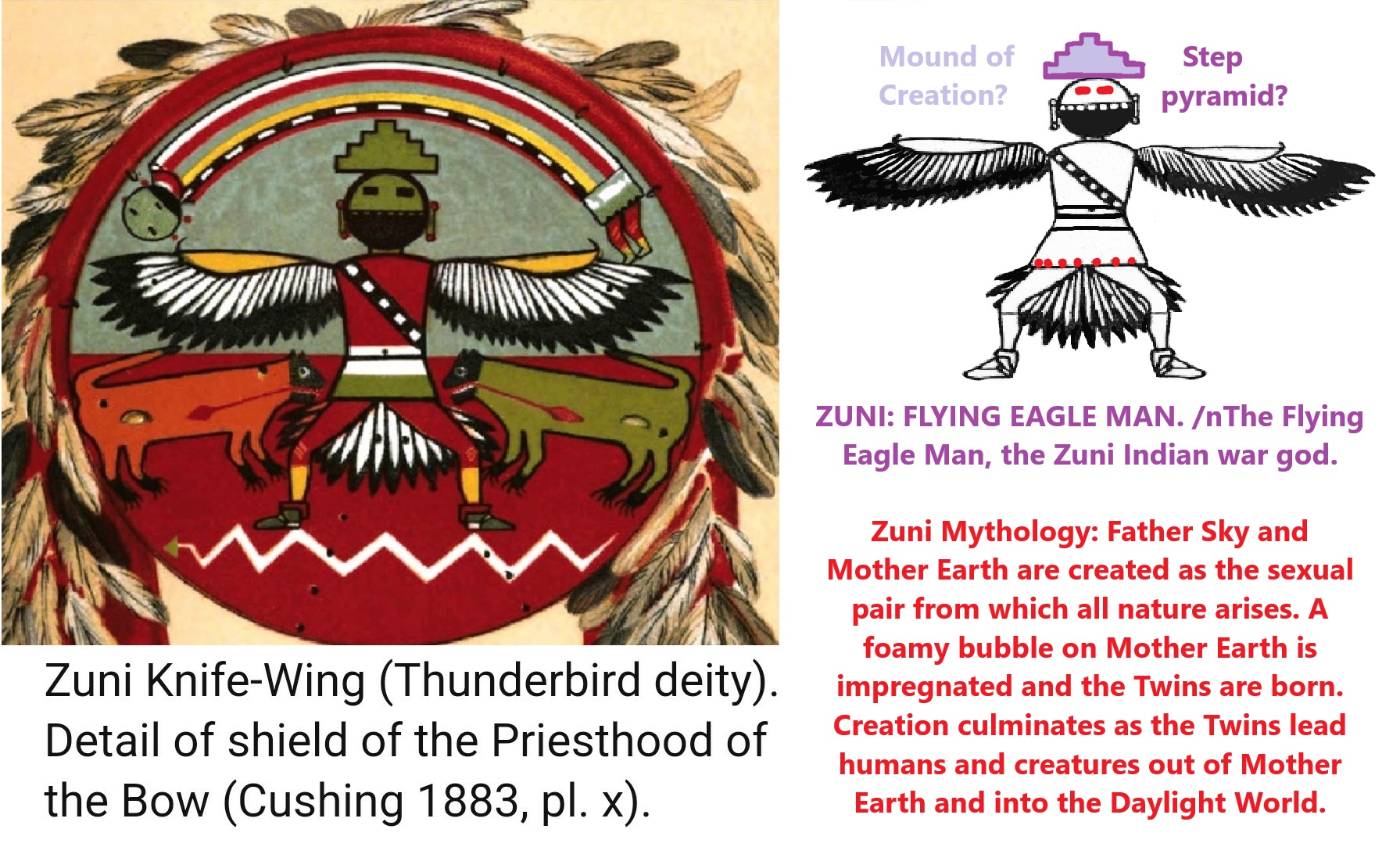
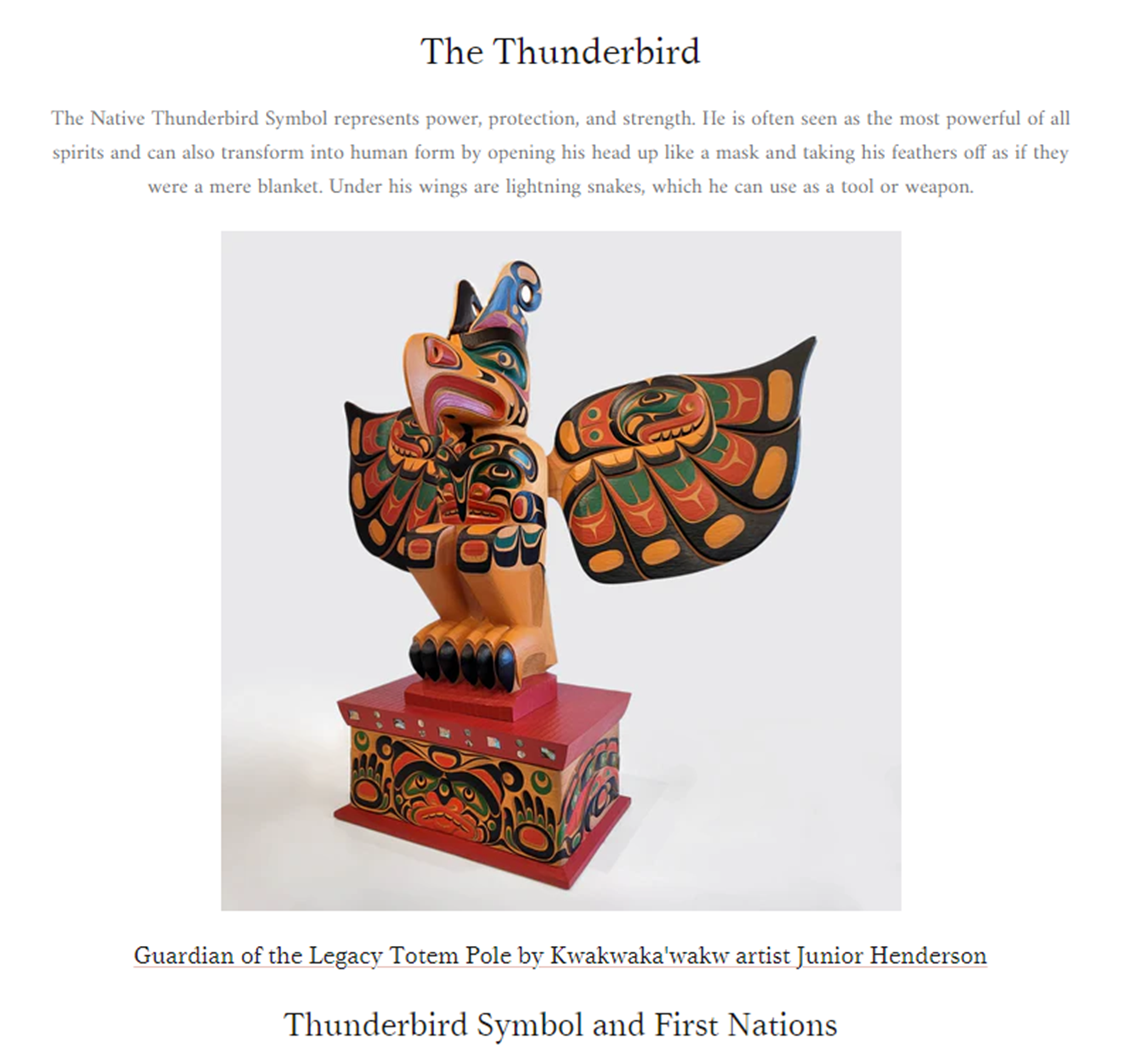
Thunderbird Symbol and First Nations
“The Thunderbird is a mythical creature that is said to be the dominating force of all-natural activity. Located in the Pacific North Western Mountains, the Thunderbird creates booms of thunder by flapping his wings and shoots bolts of lightning from his eyes, when hunters got too close to his home. By creating rainstorms he waters the earth, making it possible for vegetation to grow. He is said to be so large that his wingspan is as large as two canoes, and that he could easily carry a killer whale out of the water with his talons. Only the most powerful and successful chiefs and families use the Thunderbird in their crest. He resembles the Eagle but is distinguished by the two curved horns or Plumage on his head. Long ago Northwest Coast people pleaded to the Thunderbird for help in times of food shortage, and he helped, but in return requested that from then on he only be depicted at the top of a totem pole with his wings stretched out. That is the reason the Thunderbird appears at the top of so many Northwest Coast totem poles.” ref
“The story of the Thunderbird: The Great Chief (Namoquayalis-“the only one”) lived on the highest mountain, called Klaskis, near Cape Cook on the west coast of Vancouver Island. At one time a great flood threatened to engulf the world. Then lightning flashed four times, and a Thunderbird appeared before the Great Chief, transformed himself into a human being, and came to the rescue of the Great Chief. The Great Chief then asked the Thunderbird to go look around the land for any survivors of the flood. After completing his search, the Thunderbird returned and told the Great Chief that he had found some human survivors. So the Great Chief then told the Thunderbird to go and invite these people to come and witness a Thunderbird dance. This dance and the Thunderbird privileges have been passed down from generation to generation of the Great Chief’s family.” ref
Thunderbird (mythology)
“The thunderbird is a mythological bird-like spirit in North American indigenous peoples’ history and culture. It is considered a supernatural being of power and strength. It is frequently depicted in the art, songs, and oral histories of many Pacific Northwest Coast cultures, but is also found in various forms among some peoples of the American Southwest, US East Coast, Great Lakes, and Great Plains.Similar beings appear in mythologies the world over. Examples include the Chinese thunder-god Leigong, the Hindu Garuda, and the African lightning bird. Archaeologically, sites containing depictions of thunderbirds have been found dating to the past 4,000 years. Petroglyphs of thunderbirds are found near Twin Bluffs, Wisconsin. They are in a shelter that was probably used c. 250 BCE to 1500.” ref
“Koryaks are an Indigenous people of the Russian Far East, who live immediately north of the Kamchatka Peninsula in Kamchatka Krai and inhabit the coastlands of the Bering Sea. The cultural borders of the Koryaks include Tigilsk in the south and the Anadyr basin in the north. The Koryaks are culturally similar to the Chukchis of extreme northeast Siberia. The Koryak language and Alutor (which is often regarded as a dialect of Koryak), are linguistically close to the Chukchi language. All of these languages are members of the Chukotko-Kamchatkan language family. They are more distantly related to the Itelmens on the Kamchatka Peninsula. All of these peoples and other, unrelated minorities in and around Kamchatka are known collectively as Kamchadals.” ref
“Koryaks believe in a Supreme Being whom they call by various names: ŋajŋənen (Universe/World), ineɣitelʔən (Supervisor), ɣət͡ɕɣoletənvəlʔən (Master-of-the-Upper-World), ɣət͡ɕɣolʔən (One-on-High), etc. He is considered to reside in Heaven with his family and when he wishes to punish mankind for immoral acts, he falls asleep and thus leaves man vulnerable to unsuccessful hunting and other ills. Koryak mythology centers on the supernatural shaman Quikil (Big-Raven), who was created by the Supreme Being as the first man and protector of the Koryak. Big Raven myths are also found in Southeast Alaska in the Tlingit culture, and among the Haida, Tsimshian, and other natives of the Pacific Northwest Coast Amerindians.” ref
“The thunderbird myth and motif is prevalent among Algonquian peoples in the Northeast, i.e., Eastern Canada (Ontario, Quebec, and eastward) and Northeastern United States, and the Iroquois peoples (surrounding the Great Lakes). The discussion of the Northeast region has included Algonquian-speaking people in the Lakes-bordering U.S. Midwest states (e.g., Ojibwe in Minnesota). In Algonquian mythology, the thunderbird controls the upper world while the underworld is governed by the underwater panther or Great Horned Serpent. The thunderbird creates not just thunder (with its wing-flapping) but lightning bolts, which it casts at the underworld creatures. Thunderbird in this tradition may be depicted as a spreadeagled bird (wings horizontal head in profile), but also quite common with the head facing forward, thus presenting an X-shaped appearance overall (see under §Iconography below).” ref
“The Ojibwe version of the myth states that the thunderbirds were created by Nanabozho to fight the underwater spirits. Thunderbirds also punished humans who broke moral rules. The thunderbirds lived in the four directions and arrived with the other birds in the springtime. In the fall, they migrated south after the end of the underwater spirits’ most dangerous season. The Menominee of Northern Wisconsin tell of a great mountain that floats in the western sky on which dwell the thunderbirds. They control the rain and hail, and delight in fighting and deeds of greatness. They are the enemies of the great horned snakes (the Misikinubik) and have prevented these from overrunning the earth and devouring humankind. They are messengers of the Great Sun himself.” ref
“The thunderbird motif is also seen in Siouan-speaking peoples, which include tribes traditionally occupying areas around the Great Lakes. Ho-Chunk tradition states that a man who has a vision of a thunderbird during a solitary fast will become a war chief of the people. Ethnographer George Amos Dorsey transcribed a tale from the Arikaras with the title The Boy who befriended the Thunderbirds and the Serpent: a boy named Antelope-Carrier finds a nest with four young thunderbirds; their mother comes and tells the human boy that a two-headed Serpent comes out of the lake to eat the young. In Algonquian images, an X-shaped thunderbird is often used to depict the thunderbird with its wings alongside its body and the head facing forwards instead of in profile. The depiction may be stylized and simplified. A headless X-shaped thunderbird was found on an Ojibwe midewiwin disc dating to 1250–1400 CE. In an 18th-century manuscript (a “daybook” ledger) written by the namesake grandson of Governor Matthew Mayhew, the thunderbird pictograms varies from “recognizable birds to simply an incised X.” ref
Thunderbird and Whale
“Thunderbird and Whale” is an Indigenous myth belonging to the mythological traditions of a number of tribes from the American Pacific Northwest. The myth of the epic struggle between Thunderbird and Whale is found in common among different language/cultural groups of the Indigenous peoples of the Pacific Northwest Coast of America, and seems to be uniquely localized to this area. It is also the major archetypal motif in carvings and painted art, particularly among the natives along the outlying coasts of Vancouver Island, e.g., the Kwakiutl (Kwakwakaʼwakw) or the Nootka (Nuu-chah-nulth) people. In one of many variant versions of the myth, the sound of the whale dropping into the sea is the source of thunder. A young boy of a Vancouver Island people, the Comox, was fascinated by the sound of thunder, and heard it from behind a point of land. He crossed that point, following the sound of thunder, and discovered the spectacle of the Thunderbird seizing and dropping the whale. The Thunderbird saw the boy, and told him that the story was now his, and he had the right to wear the Thunderbird mask and wings at the potlatch.” ref
‘A Sculpted Land’: Wisconsin’s Effigy Mounds Connected People To Spirits
“And similar to modern tombstones that reveal the family name of the deceased, Rosebrough said these effigy mounds function in much the same way. “These are saying Bear clan, Thunderbird clan, Hawk clan, Pigeon clan,” she said. “They’re telling you about the person inside, that they’re an important person, and that they belong to an important family.” People who were buried in effigy mounds were more likely to have the mound to themselves. They’re also less likely to have broken bones or serious injury. That’s a shift from people buried in conical mounds, where up to 50 could be buried in one location. Not all effigy mounds that were excavated before the sites were protected had evidence of human remains, but that could be because the bones have since disintegrated. Skenandore said at least 75 percent of the mounds that have been excavated in Wisconsin and beyond contain human remains.” ref
“Tlaltecuhtli (Classical Nahuatl Tlāltēuctli, Nahuatl pronunciation: [t͡ɬaːl.teːkʷ.t͡ɬi]) is a pre-Columbian Mesoamerican deity worshipped primarily by the Mexica (Aztec) people. Sometimes referred to as the “earth monster,” Tlaltecuhtli’s dismembered body was the basis for the world in the Aztec creation story of the fifth and final cosmos. In carvings, Tlaltecuhtli is often depicted as an anthropomorphic being with splayed arms and legs. Considered the source of all living things, she had to be kept sated by human sacrifices which would ensure the continued order of the world.” ref
“According to a source, in the creation of the Earth, the gods did not tire of admiring the liquid world, no oscillations, no movements, so Tezcatlipoca and Quetzalcoatl thought that the newly created world should be inhabited. And for this, they made Tlalcihuatl, ‘Lady of the earth’, come down from heaven, and Tlaltecuhtli, ‘Lord of the earth’, would be her consort. Tezcatlipoca and Quetzalcoatl create the Earth from the body of Cipactli, a giant alligator/crocodile self-created in the Omeyocan. Tlaltecuhtli is known from several post-conquest manuscripts that surveyed Mexica mythology and belief systems, such as the Histoyre du méchique, Florentine Codex, and Codex Bodley, both compiled in the sixteenth century.” ref
“Tlaltecuhtli is typically depicted as a squatting toad-like creature with massive claws, a gaping mouth, and crocodile skin, which represented the surface of the earth. In carvings, her mouth is often shown with a river of blood flowing from it or a flint knife between her teeth, a reference to the human blood she thirsted for. Her elbows and knees are often adorned with human skulls, and she sometimes appears with multiple mouths full of sharp teeth all over her body. In some images, she wears a skirt made of human bones and a star border, a symbol of her primordial sacrifice. Many sculptures of Tlaltecuhtli were meant only for the gods and were not intended to be seen by humans. She was often carved onto the bottom of sculptures where they made contact with the earth, or on the undersides of stone boxes called cuauhxicalli (“eagle box”), which held the sacrificial hearts she was so partial to.
“In reference to her mythological function as the support of the earth, Tlaltecuhtli was sometimes carved onto the cornerstones of temples, such as the pyramid platform at El Tajin. Tlaltecuhtli’s importance in the Mexica pantheon is demonstrated by her inclusion in major works of art. A representation of the goddess can be found on each side of the 1503 CE Coronation Stone of the Aztec ruler Moctezuma II, alongside the glyphs for fire and water — traditional symbols of war. Historian Mary Miller even suggests that Tlaltecuhtli may be the face in the center of the famous Aztec Calendar Stone (Piedra del Sol), where she symbolizes the end of the 5th and final Aztec cosmos.” ref
“According to Alfonso Caso, there were four earth gods — Tlaltecuhtli, Coatlicue, Cihuacoatl, and Tlazolteotl.
In the Mexica creation story, Tlaltecuhtli is described as a sea monster (sometimes called Cipactli) who dwelled in the ocean after the fourth Great Flood. She was an embodiment of the chaos that raged before creation. One day, the gods Quetzalcoatl and Tezcatlipoca descended from the heavens in the form of serpents and found the monstrous Tlaltecuhtli (Cipactli) sitting on top of the ocean with giant fangs, crocodile skin, and gnashing teeth calling for flesh to feast on. The two gods decided that the fifth cosmos could not prosper with such a horrible creature roaming the world, and so they set out to destroy her. To attract her, Tezcatlipoca used his foot as bait, and Tlaltecuhtli ate it. In the fight that followed, Tezcatlipoca lost his foot and Tlaltecuhtli lost her lower jaw, taking away her ability to sink below the surface of the water. After a long struggle, Tezcatlipoca and Quetzalcoatl managed to rip her body in two — from the upper half came the sky, and from the lower came the earth. She remained alive, however, and demanded human blood as repayment for her sacrifice.” ref
“The other gods were angered to hear of Tlaltecuhtli’s treatment and decreed that the various parts of her dismembered body would become the features of the new world. Her skin became grasses and small flowers, her hair the trees and herbs, her eyes the springs and wells, her nose the hills and valleys, her shoulders the mountains, and her mouth the caves and rivers. According to a source, all the deities of the earth are female, except the advocation of Tezcatlipoca, which is Tepeyollotl, ‘heart of the hill’, and Tlaltecuthli, ‘lord earth’, which the latter is formed by the center of the body of Cipactli, which is It owes its other name, Tlalticpaque, ‘lord of the world’. Tlaltecuhtli meets Coatlicue as a consort as the devourer, and Coatlicue as the one who gives continuous birth to new beings, men and animals.” ref
“Since Tlaltecuhtli’s body was transformed into the geographical features, the Mexica attributed strange sounds from the earth as either the screams of Tlaltecuhtli in her dismembered agony, or her calls for human blood to feed her. As a source of life, it was thought necessary to appease Tlaltecuhtli with blood sacrifices, especially human hearts. The Aztecs believed that Tlatlecuhtli’s insatiable appetite had to be satisfied, or the goddess would cease her nourishment of the earth, and crops would fail. The Mexica believe Tlaltecuhtli to swallow the sun between her massive jaws at dusk, and regurgitate it the next morning at dawn. The fear that this cycle could be interrupted, like during solar eclipses, was often the cause of uneasiness and increased ritual sacrifice. Tlaltecuhtli’s connection to the sun ensured that she was included in the prayers offered to Tezcatlipoca before Aztec military campaigns. Finally, because of Tlatlecuhtli’s association with fertility, midwives called on her aid during difficult births—when an “infant warrior” threatened to kill the mother during labor.” ref
“One of the largest modern debates surrounding Tlaltecuhtli is over the deity’s gender. In English, “tlal-” translates to “earth,” and “tecuhtli” is usually rendered “lord.” However, “teuctli” (like most words in Nahuatl) has no gender, despite normally being used to describe men or male gods. There are notable exceptions—for example, the goddesses Ilamatecuhtli and Chalmecatecuhtli. In the Huehuetlahtolli collected by Horacio Carochi in the early 17th century (known as The Bancroft Dialogues), it is clear that “tēuctli” does not mean “lord” or “señor.” Those are just approximations to the genderless Nahuatl title. A better rendering is “esteemed personage” or “noble.” In fact, in The Bancroft Dialogues, older women are addressed as “notēcuiyo” or “my noble” several times.” ref
“While Tlaltecuhtli’s name may be interpreted as masculine, the deity is most often depicted with female characteristics and clothing. According to Miller, “Tlaltecuhtli literally means ‘Earth Lord,’ but most Aztec representations clearly depict this creature as female, and despite the expected male gender of the name, some sources call Tlaltecuhtli a goddess. [She is] usually in a hocker, or birth-giving squat, with head flung backwards and her mouth of flint blades open.” Other scholars, like Alfonso Caso, interpret this pose as a male Tlaltecuhtli crouching under the earth with his mouth wide open, waiting to devour the dead. While Tlaltecuhtli is usually portrayed as female, some depictions are clearly male (though these distinctions may at times arise from the Spanish-language gendering process). H.B. Nicholson writes, “most of the available evidence suggests that… the earth monster in the mamazouhticac position was conceived to be female and depicted wearing the costume proper to that sex. A male aspect of that deity was also recognized and occasionally represented in appropriate garb—but was apparently quite subordinate to the more fundamental and pervasive female conception.” ref
“This ambiguity has prompted some scholars to argue that Tlaltecuhtli may have possessed a dual gender like several other Mesoamerican primordial deities. In Bernardino Sahagún’s Florentine Codex, for example, Tlaltecuhtli is invoked as in tonan in tota —”our mother, our father”—and the deity is described as both a god and a goddess. Rather than signal hermaphroditism or androgyny, archaeologist Leonardo Lopez Lujan suggests that these varying embodiments are a testament to the deity’s importance in the Mexica pantheon.” ref
“In 2006, a massive monolith of Tlaltecuhtli was discovered in an excavation at the Templo Mayor in Tenochtitlan (modern-day Mexico City). The sculpture measures approximately 13.1 x 11.8 feet (4 x 3.6 meters) and weighs nearly 12 tons, making it one of the largest Aztec monoliths ever discovered—larger even than the Calendar Stone. The sculpture, carved in a block of pink andesite, presents the goddess in her typical squatting position and is vividly painted in red, white, black, and blue. The stone was found by archaeologists broken into 4 pieces. Reassembled, Tlaltecuhtli’s skull and bones skirt, and the river of blood flowing from her mouth, can be seen. Though most renderings of Tlaltecuhtli were placed face down, this monolith was found face up. Clutched in her lower right claw is the year glyph for 10 rabbit (1502 CE). Lopez Lujan noted that according to the surviving codices, 1502 was the year that one of the empire’s most feared rulers, Ahuitzotl, was laid to rest. Just below this monument, Offering 126 was found, a huge dedicatory deposit containing 12 thousand objects.” ref
“In Aztec mythology, Tepēyōllōtl (Nahuatl pronunciation: [ˈtepeːˈjoːlːoːt͡ɬ]; “heart of the mountains”; also Tepeyollotli) was the god of darkened caves, earthquakes, echoes and jaguars. He is the god of the Eighth Hour of the Night, and is depicted as a jaguar leaping towards the Sun. In the calendar, Tepeyollotl rules over both the third day, Calli (house), and the third trecena, 1-Mazatl (deer). The word is derived as a compound of the Nahuatl words tepētl (“mountain”), and yōllōtl (“heart” or “interior”). Tepeyollotl is usually depicted as cross-eyed holding the typical white staff with green feathers. Sometimes Tezcatlipoca wore Tepeyollotl for an animal skin or disguise to trick other gods into not knowing who he was.” ref
“Tlālōcān (Nahuatl pronunciation: [t͡ɬaːˈloːkaːn̥]; “place of Tlāloc“) is described in several Aztec codices as a paradise, ruled over by the rain deity Tlāloc and his consort Chalchiuhtlicue. It absorbed those who died through drowning or lightning, or as a consequence of diseases associated with the rain deity. Tlālōcān has also been recognized in certain wall paintings of the much earlier Teotihuacan culture. Among modern Nahua-speaking peoples of the Gulf Coast, Tlālōcān survives as an all-encompassing concept embracing the subterranean world and its denizens. Tlālōcān is also the first level of the upper worlds, or the Aztecs’ Thirteen Heavens, that has four compartments according to the mythic cosmographies of the Nahuatl-speaking peoples of pre-Columbian central Mexico, noted particularly in Conquest-era accounts of Aztec mythology.” ref
“To the Aztec there were thirteen levels of the Upper Worlds, and nine of the Underworld; in the conception of the Afterlife the manner of a person’s death determined which of these layers would be their destination after dying. As the place of Tlālōc, 9th Lord of the Night, Tlālōcān was also reckoned as the 9th level of the Underworld, which in the interpretation by Eduard Seler was the uppermost underworld in the east. As a destination in the Afterlife, the levels of heaven were reserved mostly for those who had died violent deaths, and Tlālōcān was reserved for those who had drowned or had otherwise been killed by manifestations of water, such as by flood, by diseases associated with water, or in storms by strikes of lightning. It was also the destination after death for others considered to be in Tlālōc’s charge, most notably the physically deformed.” ref
“Many different gods are said to inhabit this location, them being: Meztli, moon goddess (Moon), Tlazolteotl, goddess of lust and illicit affairs, patron of sexual incontinence, adultery, sex, passions, carnality and moral transgression, Tiacapan, one of the goddesses of sex, Ixcuina, one of the goddesses of sex, Tecotzin or Teicu, one of the goddesses of sex, Tlaloc, god of thunder, rain and the earth. In this layer he pierces the “clouds’ bellies” to make them rain, Ehecatl, god of the wind. In this layer he blows the clouds with his breath (breezes) to make them move, The Ehecatotontli, gods of the breezes, Mictlanpachecatl, god of the north wind, Cihuatecayotl, god of the west wind, Tlalocayotl, god of the east wind, Huitztlampaehecatl, god of the south wind.” ref
“In areas of contemporary Mexico, such as in the Sierra Norte de Puebla region, some communities continue to incorporate the concept of Tlālōcān as a netherworld and shamanic destination in their modern religious practices. As described by Knab, shamanic entry into Tlālōcān, always achieved during dreams and often with the objective of curing a patient, is via underground waterways, commonly a whirlpool (“the water was whirling there and it took me in and down into the darkness around and around”). Upon awakening, the shaman-dreamer will recount, to the audience during a curing-session, the itinerary traveled in Tlālōcān; to which will be added (only when instructing a trainee or in speaking to other practicing shamans, never to an audience of general public) a description of the itinerary in term of numerically counted rivers, highways, and hills: as counted in series of 14, “There are thus thirteen of each type of feature located between the center and the edges of the underworld and one of each type (p. 120) of feature located in the center of the underworld.” ref
“Here is a description of the sections of Tlālōcān, as arranged in cardinal directions :-
- In the North “are the ehecatagat, the lord of the winds, and the miquitagat, the lord of death. They are the ones that care for souls for the first year after death. Both of the lords live in great caves. … there are two caves, one on top of the other, and … death lives in the lowest realm. The dead enter the underworld from the cemetery, where the lord death and his minions keep their souls. The role of the lord of the winds is to seek out more souls on the surface of the earth with which to populate the regions of the dead.”
- “From the cave of the winds in the northern reaches of t[l]alocan issue the mal aires or evil winds, the feared ahmo cualli ehecat[l], the sombra de muerte or shadow of death, the miquicihual, and the miquiehecat[l], the nortes, ‘the winds of death’.” “The cave of the winds … is where the lord of the winds resides with his various assistants who guard the cooking pots [“According to numerous tales, the assistants are toads who keep the pots.” (p. 163, n. 4:9)] where the ingredients for storms are kept, the winds, mists, rains, thunder, and lightning. Other assistants of the lord of winds are the quautiomeh or lightning bolts, the thunderclaps or popocameh, and the smoke ones, who make the miquipopoca or smoke of death that issues forth onto the surface of the earth, in t[l]alticpac, along with the winds of death.”
- In the South “is a spring of boiling water shrouded in mist and clouds. This spring is found in the depths of a cave illuminated by the fires of the popocameh. In the depths of this boiling spring, … lives … a giant worm, the cuiluhuexi. The cuiluhuexi eats the earth and fashions the caverns … Its fiery breath and boiling saliva eat away the earth as it crawls beneath the surface.”
- In the East “is the place known as apan, the waters … . Apan is a great lake or sea in the underworld that is united in its depths with all the waters of the surface of the world. In its depths live atagat and acihuat[l], the lord and lady of the waters. The acihuat[l] is often identified with the llorona or weeping woman {“in the Telleriano-Remensis and the Tonalamatl Aubin, her eyes are filled with tears”} of folklore, who … is always found near sources of water weeping”. … In the depths of apan are cities …, and … souls – once they have passed out of the north at the end of the first year of death – seek out … this region.”
- In the West “is actually a cave inhabited only by truly dangerous women such as miquicihuauh, ‘death woman,’ and the ehecacihuauh, ‘wind woman’.” “the women from this side of the underworld … went in search of the souls of men, especially lascivious men who couple with various women. They would also take the souls of women waiting on the paths, in the gardens, or in the fields for their illicit lovers.” ref
“Tláloc (Classical Nahuatl: Tláloc [ˈtɬaːlok]) is the god of rain in Aztec religion. He was also a deity of earthly fertility and water, worshipped as a giver of life and sustenance. This came to be due to many rituals, and sacrifices that were held in his name. He was feared, but not maliciously, for his power over hail, thunder, lightning, and even rain. He is also associated with caves, springs, and mountains, most specifically the sacred mountain where he was believed to reside. Cerro Tláloc is very important in understanding how rituals surrounding this deity played out. His followers were one of the oldest and most universal in ancient Mexico. There are many different representations of Tláloc, and there are many different offerings given to him. Tláloc is often represented through iconography of butterflies, jaguars, and serpents. The Mexican marigold, Tagetes lucida, known to the Nahua as cempohualxochitl, was another important symbol of the god, and was burned as a ritual incense in native religious ceremonies.” ref
“Although the name Tláloc is specifically Nahuatl, worship of a storm god, associated with mountaintop shrines and with life-giving rain, is as at least as old as Teotihuacan. It was likely adopted from the Maya god Chaac, perhaps ultimately derived from an earlier Olmec precursor. Chaac (also spelled Chac or, in Classic Mayan, Chaahk [t͡ʃaːhk]) is the name of the Maya god of rain, thunder, and lightning. With his lightning axe, Chaac strikes the clouds, causing them to produce thunder and rain. Chaac corresponds to Tlaloc among the Aztecs. Like other Maya gods, Chaac is both one and manifold. Four Chaacs are based in the cardinal directions and wear the directional colors. East, where the sunrise is, is red, North, mid-day zenith, is represented by white, West is represented by black for the sunset, and South is represented by yellow. There is a fifth color which is associate with the center point, and that is green.” ref, ref
“The rain deity is a patron of agriculture. A well-known myth in which the Chaacs (or related Rain and Lightning deities) have an important role to play is about the opening of the mountain in which the maize was hidden. In Tzotzil mythology, the rain deity also figures as the father of nubile women representing maize and vegetables. In some versions of the Qʼeqchiʼ myth of Sun and Moon, the rain deity Choc (or Chocl) ‘Cloud’ is the brother of Sun; together they defeat their aged adoptive mother and her lover. Later, Chaac commits adultery with his brother’s wife and is duly punished; his tears of agony give origin to the rain. Versions of this myth show the rain deity Chac in his war-like fury, pursuing the fleeing Sun and Moon, and attacking them with his lightning bolts.” ref
“In some mythologies, it is believed that water and clouds are formed within the Earth in caves and cenotes and then carried into the sky by deities such as Chaac. Classic period Maya sources also suggest that Chaac was the god who opened the mountain containing maize, using his lightning axe, K’awiil. Tláloc was mainly worshiped at Teotihuacan, while his big rituals were held on Cerro Tláloc. An underground Tláloc shrine has been found at Teotihuacan which shows many offerings left for this deity.” ref, ref
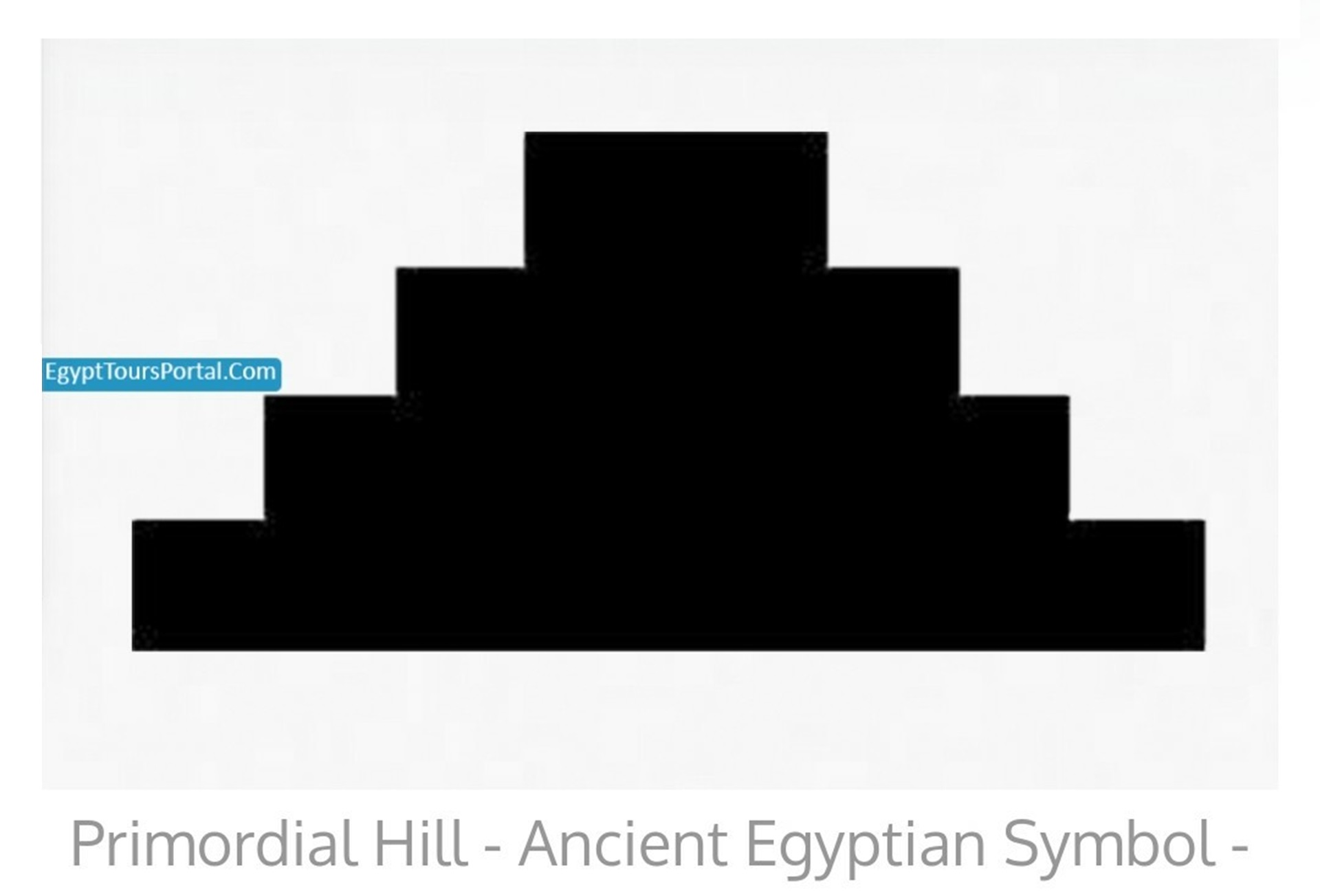
STEP Pyramid of Djoser (Mound of Creation?)

It is the first Egyptian Pyramid to be built.
“The pyramid of Djoser, sometimes called the Step Pyramid of Djoser, is an archaeological site in the Saqqara necropolis, Egypt, northwest of the ruins of Memphis. It is the first pyramid to be built. The 6-tier, 4-sided structure is the earliest colossal stone building in Egypt. It was built in the 27th century BCE during the Third Dynasty for the burial of Pharaoh Djoser. The pyramid is the central feature of a vast mortuary complex in an enormous courtyard surrounded by ceremonial structures and decorations. The pyramid went through several revisions and redevelopments of the original plan. The pyramid originally stood 62.5 m (205 ft) tall, with a base of 109 m × 121 m (358 ft × 397 ft), and was clad in polished white limestone. The step pyramid (or proto-pyramid) was considered to be the earliest large-scale cut stone construction made by man as of 1997, although the nearby enclosure wall “Gisr el-Mudir” is suggested by some Egyptologists to predate the complex, and the South American pyramids at Caral are contemporary.” ref
“Djoser was the first or second king of the 3rd Dynasty (c. 2670–2650 BCE) of the Old Kingdom of Egypt (c. 2686 – c. 2125 BCE). He is believed to have ruled for 19 years or, if the 19 years were biennial taxation years, 38 years. He reigned long enough to allow the grandiose plan for his pyramid to be realized in his lifetime. Djoser is best known for his innovative tomb, which dominates the Saqqara landscape. In this tomb, he is referred to by his Horus name Netjerikhet; Djoser is a name given by New Kingdom visitors more than a thousand years later. Djoser’s step pyramid is astounding in its departure from previous architecture. It sets several important precedents, perhaps the most important of which is its status as the first monumental structure made of stone. The social implications of such a large and carefully sculpted stone structure are staggering. The process of building such a structure would be far more labor-intensive than previous monuments of mud-brick.” ref
“This suggests that the state, and therefore the royal government, had a new level of control of resources, both material and human. Also, from this point on, kings of the Old Kingdom are buried in the North, rather than at Abydos. Although the plan of Djoser’s pyramid complex is different from later complexes, many elements persist, and the step pyramid sets the stage for later pyramids of the 4th, 5th, and 6th Dynasties, including the great pyramids of Giza. Though the Dynastic Egyptians themselves did not credit him as such, most Egyptologists credit Djoser’s vizier Imhotep with the design and construction of the complex. This is based on the presence of his statue in the funerary complex of Djoser, his title of “overseer of sculptors and painters,” and a comment made by the 3rd century BCE historian Manetho claiming Imhotep was the “inventor of building in stone.” ref
“Djoser’s Pyramid draws ideas from several precedents. The most relevant precedent is found at Saqqara mastaba 3038 (c. 2900 BCE). The substructure lay in a 4 m (13 ft) deep rectangular pit, and had mudbrick walls rising to 6 m (20 ft). Three sides were extended and built out to create eight shallow steps rising at an angle of 49°. This would have been an elongated step pyramid if the remaining side had not been left uncovered. In another parallel to Djoser’s complex, to complete this mastaba complex a niched enclosure wall was erected. In the early stages (M1 to M3) the structure had the form of a mastaba before alterations (P1 to P2) were made to create its step pyramidal form. In the first stage (M1), the mastaba had a square plan 63 m (207 ft; 120 cu) in length that rose to a height of 8.4 m (28 ft; 16 cu).” ref
“This was built from a core of limestone blocks arranged in horizontal beds and bound with yellow or red clay. A 2.6 m (9 ft; 5 cu) thick casing of fine white Tura limestone was applied to the core arranged in the same horizontal manner. The outer blocks were inclined to ~82°, and the top of the mastaba likely had a slightly convex shape. A second casing of fine white limestone was applied to this which increased the mastaba’s base length to 71.5 m (235 ft; 136 cu) square (M2). The casing was 4.2 m (14 ft; 8 cu) thick at the base and 3.4 m (11 ft; 6.5 cu) thick at the peak, which was 0.65 m (2 ft; 1 cu) lower than the initial mastaba height. The outer blocks of this second coat also had a steeper incline at ~76°. The mastaba was then extended 8.4 m (28 ft; 16 cu) east to cover a series of eleven shafts 33 m (108 ft; 63 cu) deep that ended in passages that led west to the burial chambers of members of Djoser’s family.” ref
“This extension was built from locally sourced limestone rubble and cased by 1.5 m (5 ft; 3 cu) thick limestone coating that formed an extension of M2. The mastaba had a new, rectangular ground plan 71.5 m (235 ft; 136 cu) by 79.5 m (261 ft; 152 cu). At this stage the mastaba still peaked at 8.4 m (28 ft; 16 cu) in height, too short to be seen from outside the 10.5 m (34 ft; 20 cu) high enclosure wall. Egyptologists are split on the motivations behind the conception of the pyramidal form that the mastaba was converted into. Lauer believed that the alteration was made to have the tomb visible from Memphis. The fact of the mastaba’s square plan led Rainer Stadelmann, however, to suggest that it was never the intended final form and that it was planned to be a pyramid from the outset. The conversion (P1) encased the mastaba (M3), extending its length by 5.76 m (19 ft; 11 cu) on each axis, giving it a base length of 85.5 m (281 ft; 163 cu) by 77 m (253 ft; 147 cu). The alteration from mastaba to pyramid came with a shift in construction.” ref
“The builders used larger and better quality, roughly dressed limestone blocks – but instead of horizontal beds, they built successive inclined accretion layers 2–3 m (6.6–9.8 ft) thick. These leaned on each other from opposite ends, providing greater stability and preventing a collapse. The whole was then cased in fine white limestone with a layer of packing in between. This phase of the pyramid had four steps that rose to a height of 42 m (138 ft; 80 cu). The decision was then made to expand the pyramid north and west from four to six steps (P1′) which was then finished with a final layer of limestone casing (P2) that gave the pyramid its final form. On completion, the step pyramid had a base length of 109 m (358 ft; 208 cu) by 121 m (397 ft; 231 cu) that rose to a height of 60–62.5 m (197–205 ft; 115–119 cu) and occupied a volume of 330,400 m3 (11,670,000 cu ft). Much of the rock for the pyramid was likely quarried from the construction of the great trench. It is widely accepted that ramps would have been used to raise heavy stones to construct the pyramid, and many plausible models have been suggested. For transport, apparatuses like rollers were used in which the heavy stone could be placed and then rolled.” ref
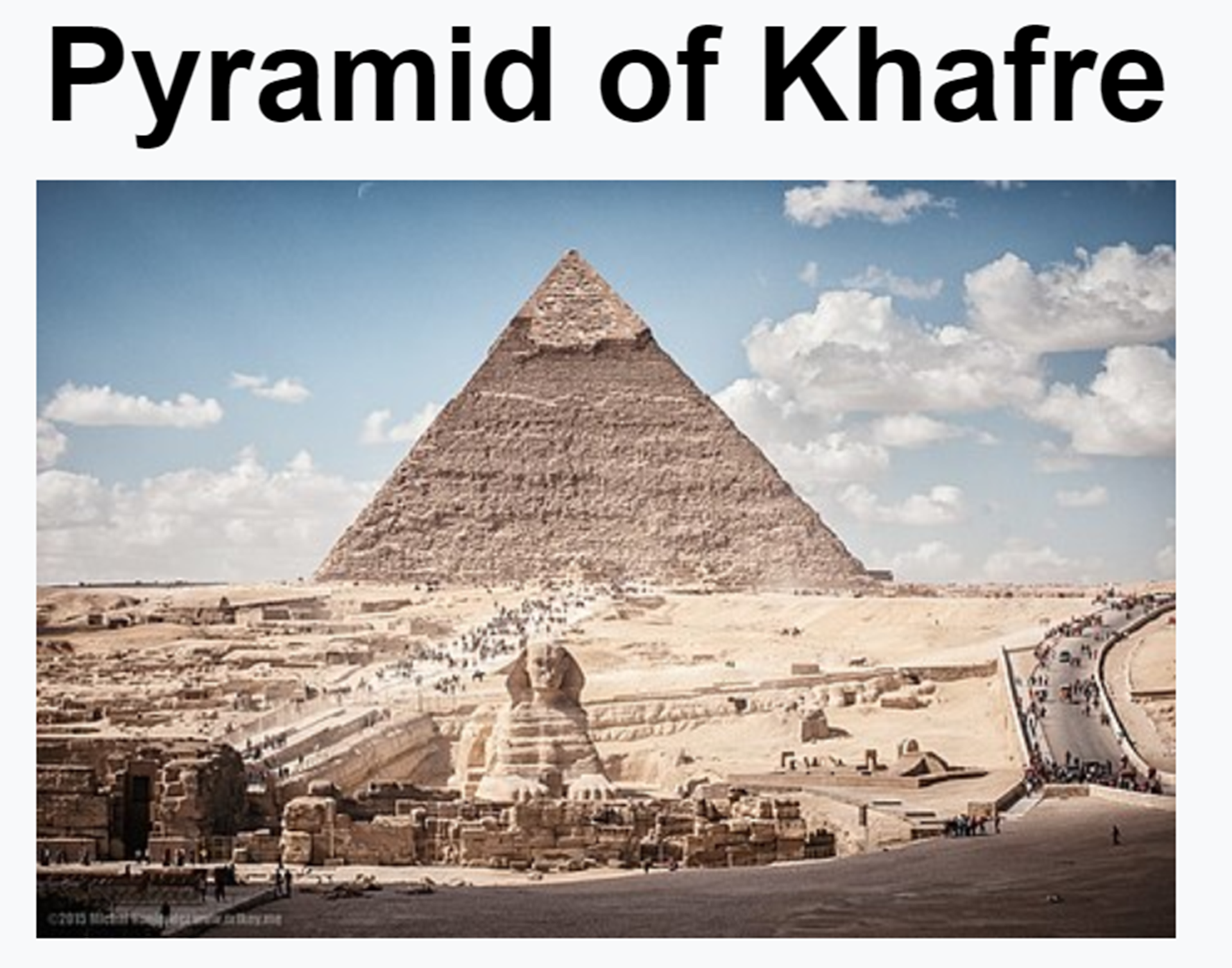
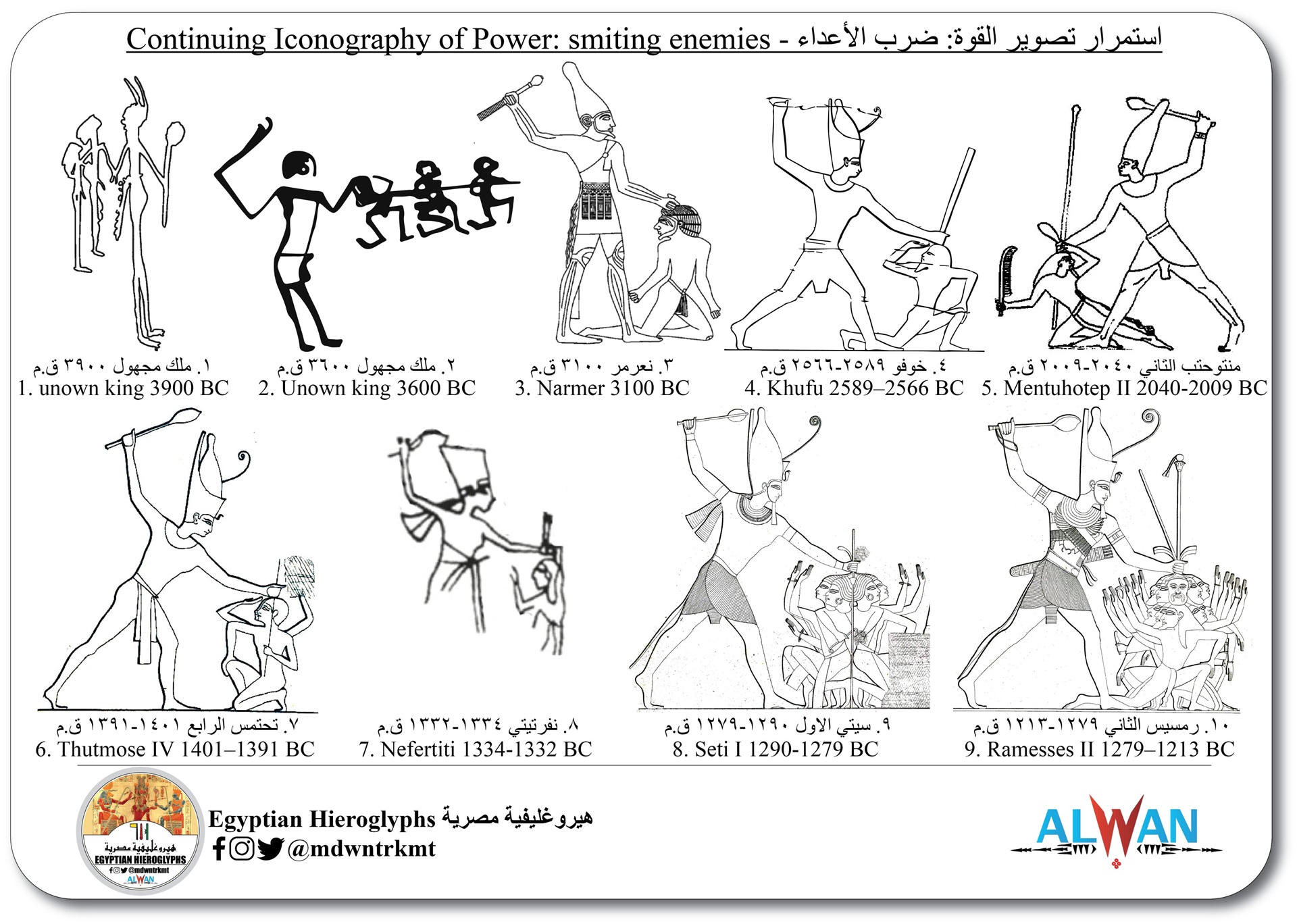
It is hierarchy oppression from the earliest proto-kings (powerful chieftains?).
Continuing Iconography of Power: smiting enemies
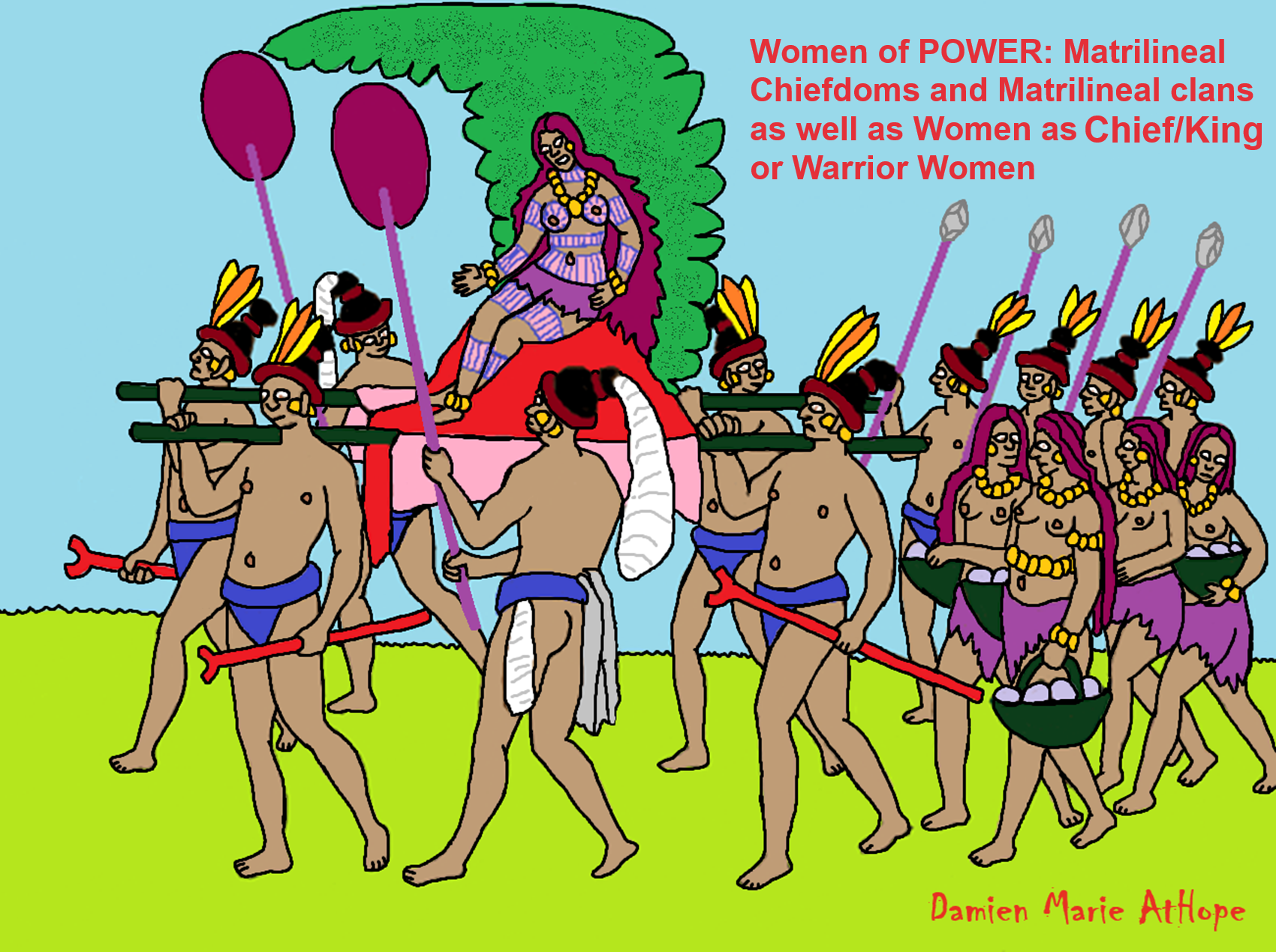
(List of matrilineal or matrilocal societies) “Matrilineal means kinship is passed down through the maternal line, the mother’s lineage, which can involve the inheritance of property and titles.” ref, ref
Chiefdoms are powers that are often believed to mobilize due to surplus labor, food, and prestige items. However, I see it as a cultural package that started with hunter-gather/fisher-foragers in west Siberia with the switch from a Matrilineal society to a patrilineal society from 8,000 to 7,000 years ago and from there spread this new war and powerful male thinking, but some Matrilineal societies changed to the war and power modal as well but kept being female-centered. I often talk as if they were completely wiped out by male clans, but not all were, and some became as horrible as male clans. One such major transfer of such ideas, which I think relates to the Tlingit (Matrilineal Na-Dene language connected to patrilineal Yeniseian languages such as the Ket People of Siberia with mostly to Y-DNA haplogroup Q-M242 linking Tlingit and South America) of the Pacific Northwest Coast of North America, were a Slaveholding, matrilineal clan chiefdom. And like 90% of South America shares their DNA and also, to me, likely somewhat influenced all Mesoamerican cultures and Moundbuilding cultures that had “Big Men/Big Women” pre/proto-chiefdoms, chiefdoms, and then clan monarchs: Kings/Empresses.
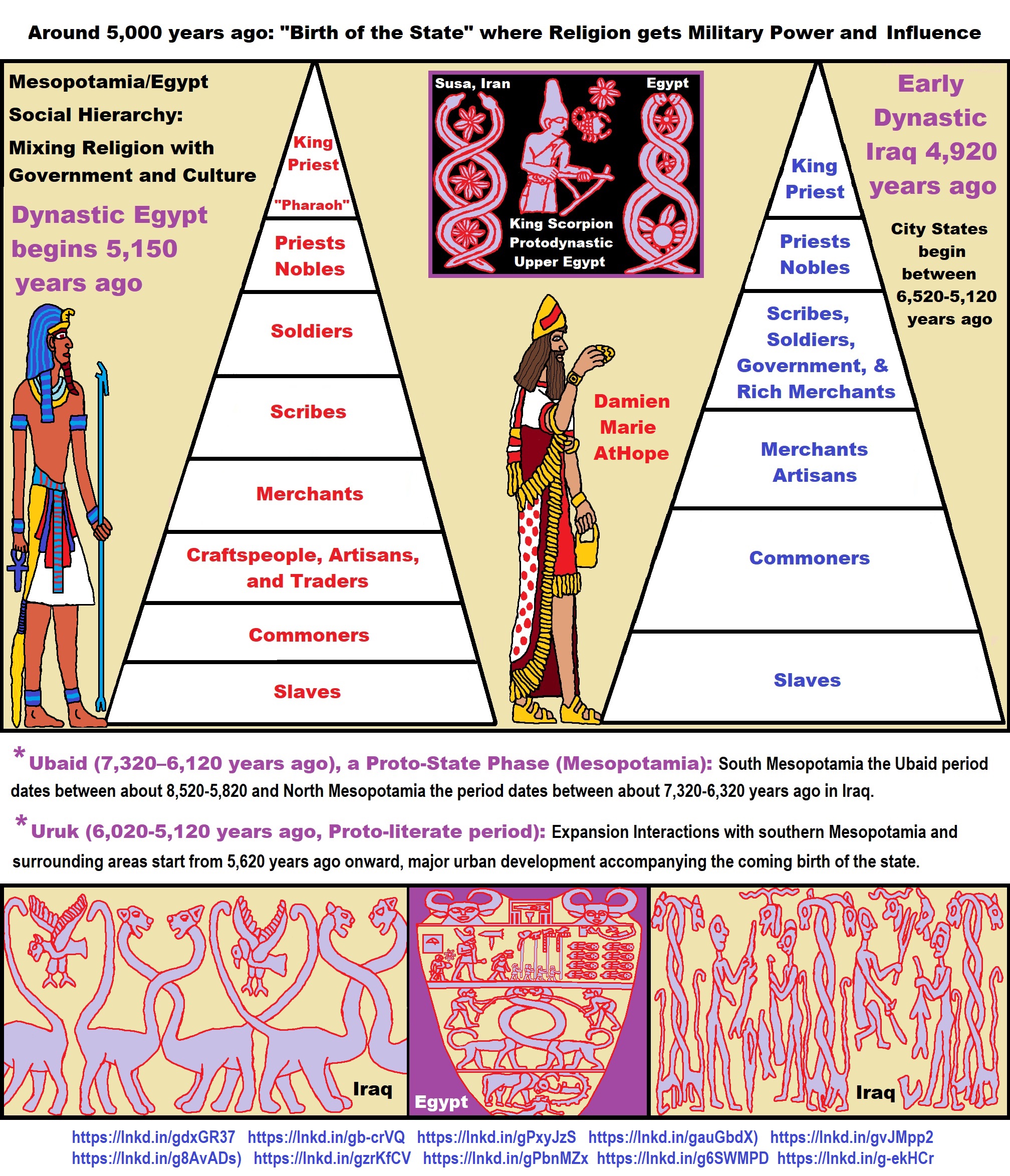
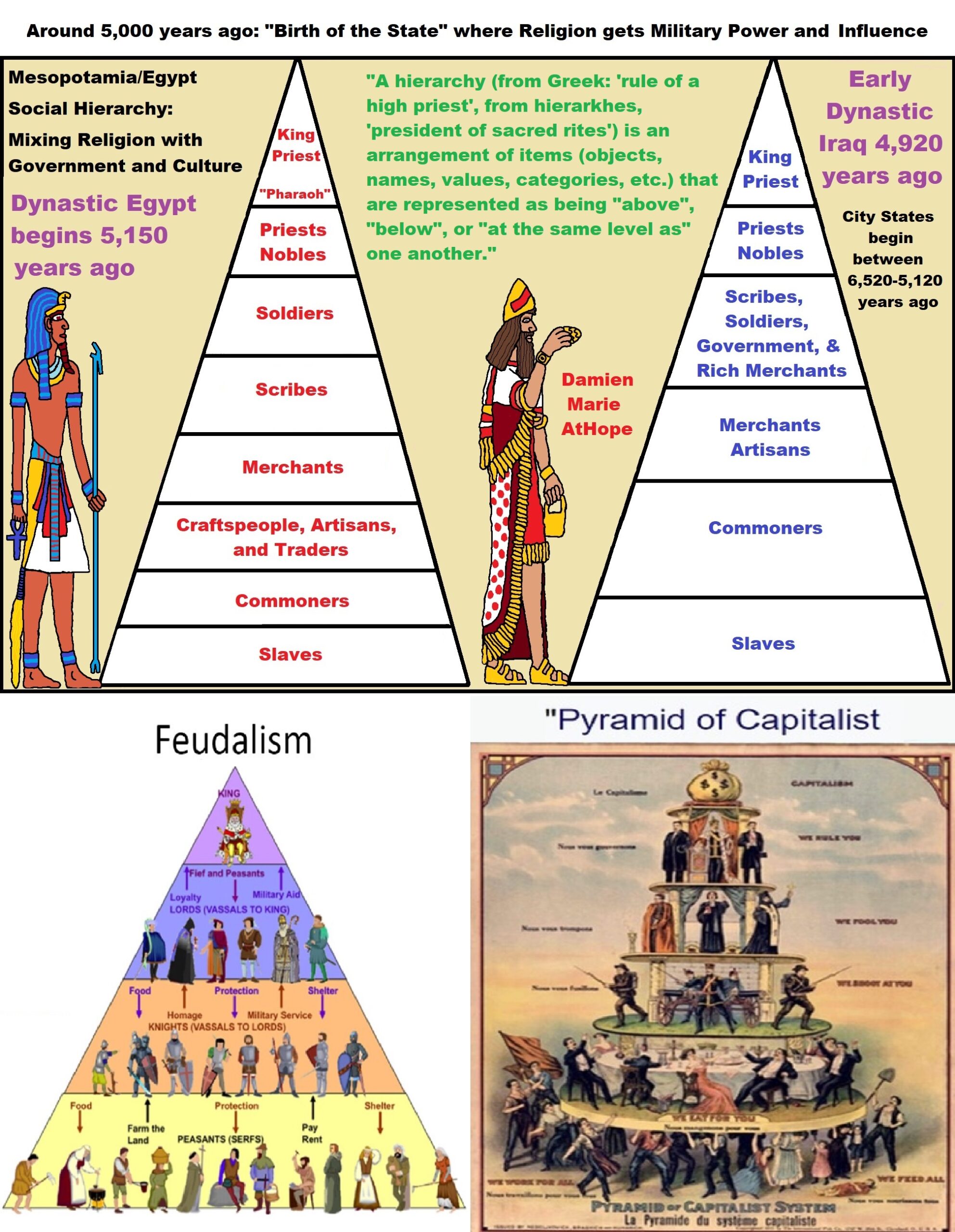
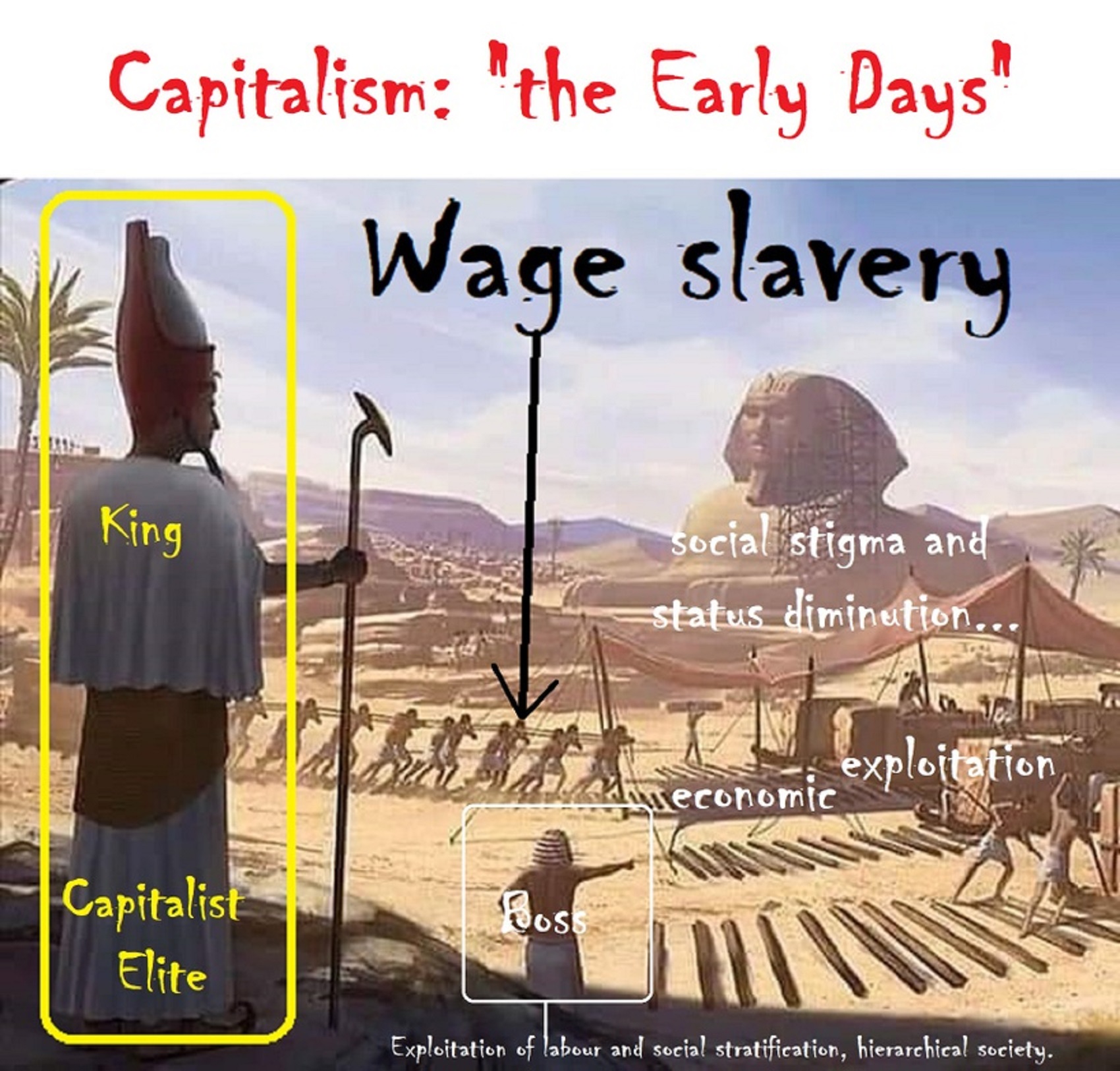

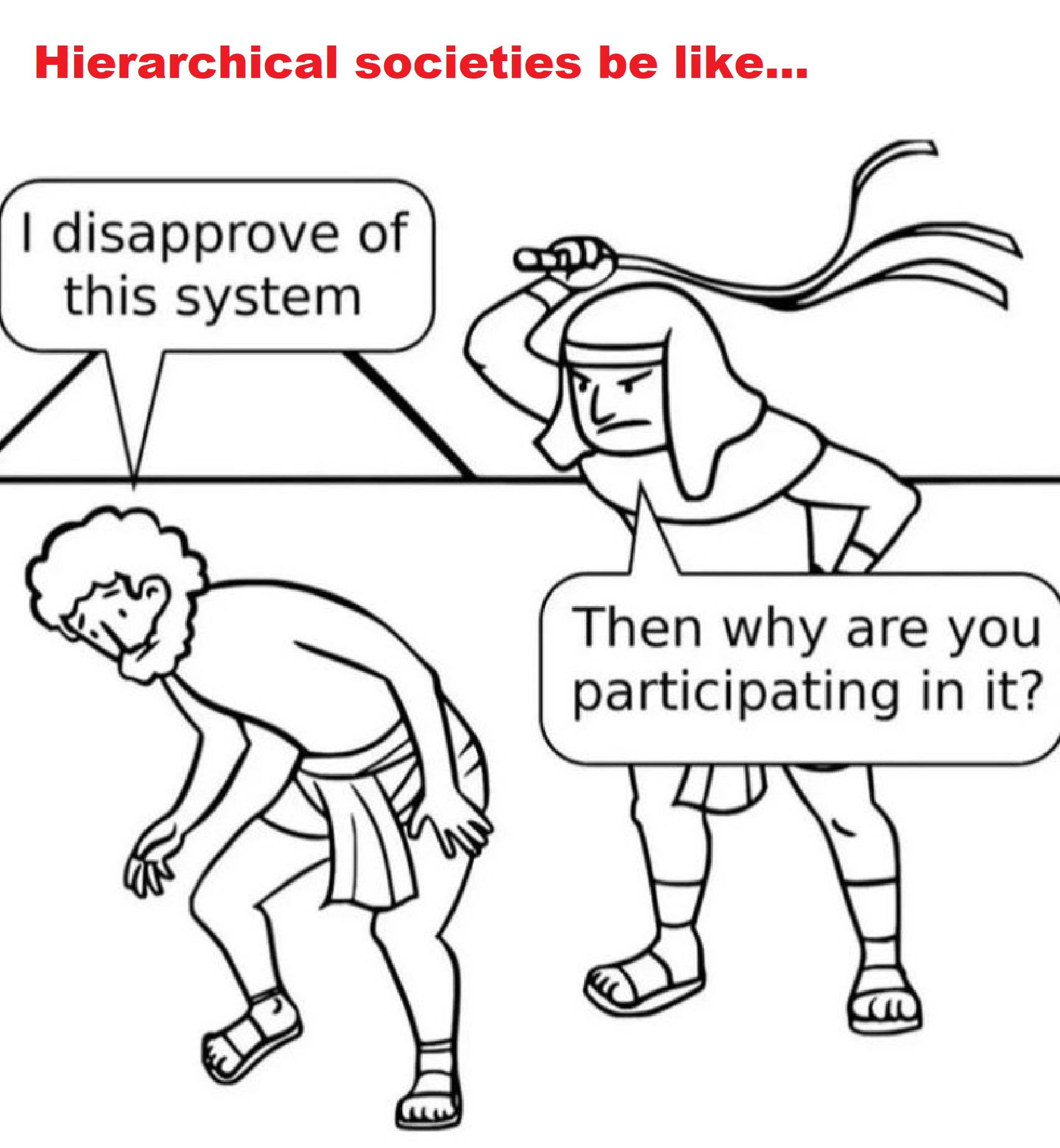

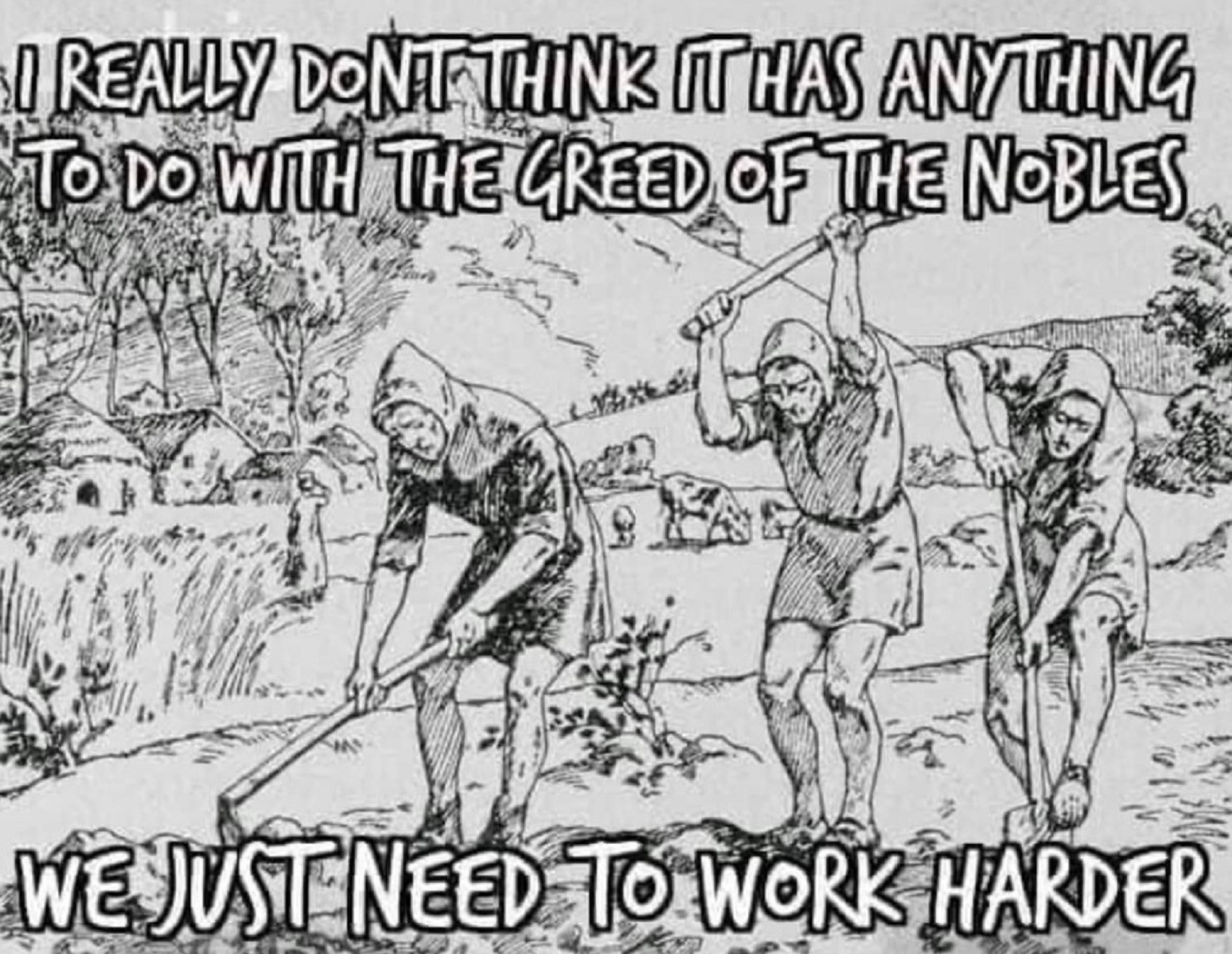

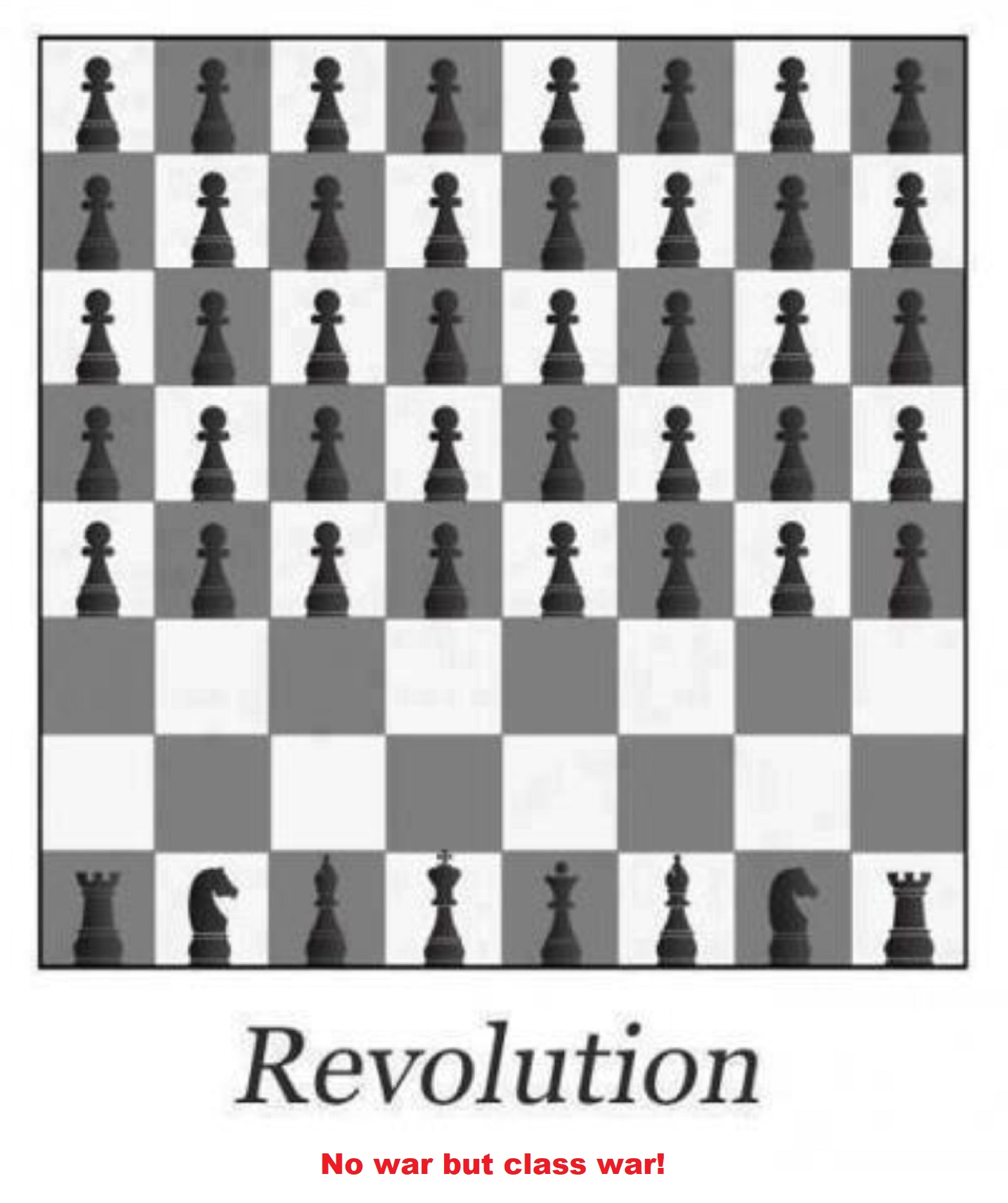
Hopewell Mound Builder culture (200 BCE–500 CE)
“The Hopewell inherited from their Adena Mound Building culture (500 BCE–100 CE) forebears an incipient social stratification.” ref
“These cultures likely accorded certain families a special place of privilege. Some scholars suggest that these societies were marked by the emergence of “big-men/women”, leaders whose influence depended on their skill at persuasion in important matters such as trade and religion. They also perhaps augmented their influence by cultivating reciprocal obligations with other important community members. The emergence of “big-men/women” was a step toward the development of these societies into highly structured and stratified chiefdoms.” ref
On the Significance of Matrilineal Chiefship
” UNDER the term chiefship as here used we include only that civil office in which the incumbent is the head of a family and has under his rule a band of families, a tribe, or a nation. Such chiefs are, for example, the band chiefs of the north and east Algonkian, the chiefs of the households of the Nootka, of the households or matrilineal “families” of the Iroquois; the tribal head chiefs of the Nootka, Coast, and Delt Salish, Tsimshian, etc., and the kings of the Natchez, man African states, modern European nations, etc. The first essential fact we have to note about this office is that universally it is the prerogative of an adult male. Occasionally, it is held by a child, the functions of pending the child chief’s maturity, being exercise warmer” or regent. Occasionally also, which is more the office is held by a female. A child holds office those peoples with whom the chiefship has become hereditary, and the heir presumptive may not be A woman holds office only where the office is strictly a given family, and when no eligible male heir is near enough in blood to be considered acceptable in a closely related female who can be expected soon son and so perpetuate the chiefship through the descent.” ref
“An example of the type of situation which gave rise to the installation of queens even among so-called “primitive” folk may
well be noted at length at this point, in part because of certain remarkable features which will interest us more in a moment. In the year 1660 the Piscottoways (Ganawagas, Conoys) of Maryland applied to the governor of the province for ratification of their choice of an “emperor,” and to his inquiry as to their customs relative to succession they replied that the office went, on the death of an incumbent, to his brother, “and for want of such, to a sister’s son,” and stated that in such wise the office had descended from their first emperor-who had been some one come to rule over them from the eastern Shore of Maryland-for thirteen generations, without interruption, until the time of the emperor Kittamaqund who preceded the emperor just deceased.” ref
“Kittamaqund had died without having brother or sister, (and, presum without a sister’s son) to succeed him, and took it upon him, therefore, to appoint his daughter to be “queen.” The perejected this appointment, however, as contrary to tribal custom and chose as emperor, Weghucasso, who was descended “from of the brothers, which one, they knew not, of the first emperor “And Weghucasso at his death appointed to be king some descendant of one of the first kings.” This appointee was Jan Wizous, which in their language signifies a true king [they] would not suffer us to call him Towzin, which is the they give to the sons of their kings who by their custom ar to succeed in rule, but his brothers, or the sons of his sisters.” To avoid possible misconceptions it is perhaps at this point to consider a practice prevailing among
Kwakiutl of British Columbia.” ref
“For them Boas patrilineal inheritance is the rule for certain circumstances the annual or winter ceremonies of the secret societies, such as that of master-of-ceremonies, those of caretaker of the drum, of the batons, of the eagle-down, etc. Civil privileges also are sometimes so inherited but much the larger number of these are given by a father to his son-in-law expressly in trust for the donor’s grandson. Hill-Tout has noted for the not-distant Siciatl that the chiefship, a civil “privilege” on the Northwest Coast, maybe so inherited, or bestowed; regularly it goes to the eldest son of a chief but where there is no son the son-in-law will succeed,5 as a consequence of which in the third generation the reigning chief will be the grandson of the chief whose son-in-law succeeded, the chiefship, thereby descending in the direct line of succession just as if the daughter herself had actually succeeded to the office and exercised its functions. It has been suggested that the practice of the southern Kwakiutl indicates an adaptation of a former patrilineal inheritance to concepts diffused from the tribes farther up the coast with whom all privileges and property including the privilege of chiefship descend matrilineally.” ref
“However, it has also been pointed out that the kinship terms of the Kwakiutl correspond to a loose organization in which relationship is reckoned bilaterally, as is the case with the closely related Nootka. For the Nootka Sapir has shown that privileges are inherited through both the male and female lines, with a preference for the male line, the inheritance of privileges being in a measure conditioned by the fact that privileges are not only personally owned but also definitely associated with the local group among whom they originate. More data, especially on the inheritance of the particular of chiefship, is desirable, but it seems evident that the Kwa represent simply a people reckoning bilaterally, but who, like peoples whose developing institution of chiefship has not be affected by the influence of a matrilineal kinship reckoning, the develop a patrilineal inheritance of office.” ref
“Rather than an indication of influences from the northern tribes and an addition to the idea of a matrilineal reckoning, the peculiar Kwa inheritance practice we have noted is simply an indication of Kwakiutl concern that privileges, in general, should descend patrilineally. And, in case a chief only has daughters, the Kw, like the Society, with the son-in-law arrangement, are able to the chiefship in the direct line of descent and, at the same, avoid having a woman chief or queen. We may now confine ourselves to the actual chiefship. Typically, though not always, it is cor the mother-sib. Despite the fact that with many whom the sib, and, specifically, the mother-sib, is a institution-such as the Iroquois, the Haida, etc.-this does not include the concept of even a fictitious kin its members, it yet remains obvious that sib member
patrilineally or matrilineally reckoned, is acquired the blood relationship to a father or a mother member obvious, and is perhaps superfluous to observe, also, whether transmitted matrilineally or patrilineally inherited by virtue of actual blood relationship cumbent of the office.” ref
“But a matrilineal reckoning for an which is universally the prerogative of a male and his male cessors appears as a noteworthy phenomenon, particularly of the fact that different types of inheritance reckonings for ent prerogatives, privileges, things, relationships, etc. contained within the same cultural considered in connection with the processes by which chiefship undoubtedly evolved. Definitely, instituted chiefship is itself an office which cannot be placed too far back in social evolution; and the concept and practice of the inheritance of the office exclusively within some one family of the group of families concerned must be placed reltively later, in that obviously intermediary developments remain on record as the existing practice of many peoples-though very definite records of this gradual evolution for any one people are hardly available. This evolution of the concept of ban and higher chiefships as hereditary within a given family and even as with many peoples, through an inflexible rule of picture took place of course concurrently with the of concepts of the inheritance of other things such ship, real, and personal property, songs, names, other office, etc.” ref
The Real Mound Builders of North America: matrilineal chiefdom
Mississippian Chiefdoms
“Although groups speaking several different languages produced Mississippian societies, they shared many cultural traits. The most spectacular features of these societies were the temple- and burial-mound centers they constructed. The largest such site is at Cahokia in what is now Collinsville, Illinois, just east of St. Louis, Missouri; the village area extended for six miles along the Illinois River, contained eighty-five temple and burial mounds, and sustained a population perhaps as high as seventy-five thousand persons. Being master farmers allowed the Mississippians to develop such large societies, although most chiefdoms were much smaller than Cahokia. All Mississippian sites utilized maize or corn as a primary staple and supplemented it with other plants and meats.” ref
“Chiefdoms. Mississippian societies are called chiefdoms because they were governed by small groups of elites or even by a single individual, called a paramount chief. Commoners and outlying satellite villages paid tributes of corn, deer meat, animal skins, and prestige items to the principal town. In some cases new towns joined a chiefdom by military conquest. The labor of commoners built the mounds and suggests that elites held the power to assemble large bodies of people to do their bidding. Leadership passed through hereditary lines in at least some of these chiefdoms, but high status was most likely based upon command of spiritual forces. The general population recognized the large amounts of power that leaders manipulated and honored them with positions of prestige. Matrilineal kinship characterized Mississippian culture, and female paramount chiefs greeted Spanish expeditions, such as the “Lady of Cofitachequi” from the chiefdom of Cofitachequi in present-day South Carolina who welcomed Hernando de Soto in the 1540s.” ref
“Decline. Mississippian chiefdoms still existed in the mid 1500s when de Soto and others traveled through the Southeast, but just a century later, the mound sites were abandoned. Because of this timing, scholars looked to the de Soto campaign as the cause of this phenomenon. It is probable that some of de Soto’s men, or maybe the horses and pigs that accompanied them, carried diseases to which the Indians had no immunity. Pandemics may have wiped the Mississippians from the map, replacing them with refugee groups of survivors who banded together for protection but lacked the numbers to maintain the mounds. Many Mississippian sites became vacant before European contact, however, which suggests that local reasons contributed to abandonment. Perhaps Mississippians overused their resources, depleting the soil for corn and cutting down trees necessary for their buildings and fires. Possibly, climatic changes resulted in drought or a shorter growing season, thus reducing the food supply. Political conflict and war between chiefdoms could have weakened some to the point of being unsustainable. Likely, all of the above factors contributed to the abandonment of the mound sites. The Choctaws, Creeks, Chickasaws, Cherokees, and Seminoles descended from the Mississippian peoples and held many traits in common with their ancestors.” ref
“Although the first people entered what is now the Mississippi about 12,000 years ago, the earliest major phase of earthen mound construction in this area did not begin until some 2100 years ago. Mounds continued to be built sporadically for another 1800 years, or until around 1700 CE. Archeologists, the scientist who study the evidence of past human lifeways, classify moundbuilding Indians of the Southeast into three major chronological/cultural divisions: the Archaic, the Woodland, and the Mississippian traditions. To date, no mounds of the Archaic period (7000 to 1000 BCE) have been positively identified in Mississippi; the mounds described herein all date to the last two cultural periods.” ref
“The Middle Woodland period (100 BCE to 200 CE) was the first era of widespread mound construction in Mississippi. Middle Woodland peoples were primarily hunters and gatherers who occupied semipermanent or permanent settlements. Some mounds of this period were built to bury important members of local tribal groups. These burial mounds were rounded, dome-shaped structures that generally range from about three to 18 feet high, with diameters from 50 to 100 feet. Distinctive artifacts obtained through long-distance trade were sometimes placed with those buried in the mounds. The construction of burial mounds declined after the Middle Woodland, and only a few were built during the Late Woodland period (circa 400 to 1000 CE). Woodland burial mounds can be visited at the Boyd, Bynum, and Pharr sites and at Chewalla Lake in Holy Springs National Forest. (The Chewalla Mound is not included in this itinerary because it is not listed in the National Register of Historic Places).” ref
“The Mississippian period (1000 to 1700 CE) saw a resurgence of mound building across much of the southeastern United States. Most Mississippian mounds are rectangular, flat-topped earthen platforms upon which temples or residences of chiefs were erected. These buildings were constructed of wooden posts covered with mud plaster and had thatched roofs. Mississippian platform mounds range in height from eight to almost 60 feet and are from 60 to as much as 770 feet in width at the base. Mississippian period mounds can be seen at the Winterville, Jaketown, Pocahontas, Emerald, Grand Village, Owl Creek, and Bear Creek sites.” ref
“Mississippian period mound sites mark centers of social and political authority. They are indicators of a way of life more complex than that of the Woodland and earlier periods. In contrast to the relatively simple, egalitarian tribal organization of most societies of the Woodland period, regional Mississippian populations were typically organized into chiefdoms–territorial groups with hereditary, elite leadership classes. Across the Southeast, the chiefdom system of political organization arose as a means of managing increased social complexity caused by steady population growth. This population growth was sustained by agriculture (corn, beans, and squash)–a revolutionary new means of subsistence that became an economic mainstay during the Mississippian period.” ref
“Mound construction was once again in decline by the time the first Europeans came to this region in the 1500s. Shortly thereafter, epidemic diseases introduced by early European explorers decimated native populations across the Southeast, causing catastrophic societal disruption. As a result, by the time sustained contact with European colonists began about 1700 CE, the long tradition of mound building had nearly ended.” ref
Ancient Colombian chiefdoms
“Chiefdoms in Central America were small groups who developed unique art forms in order to distinguish themselves and compete with one another. c. 500 B.C.E.–1600 C.E.” ref
Tribe versus Chiefdom in Lower Central America
“Abstract: It has commonly been argued that chiefdoms were the dominant form of prehispanic political organization in Lower Central America. Reexamination of the data base, however, reveals that tribal forms of organization were also present in Lower Central America at the time of Spanish contact and before. The salient characteristics of both tribes and chiefdoms are discussed, and criteria for identifying tribes and chiefdoms in the archaeological record are outlined. Data from the Central Provinces of Panama and the Gulf of Nicoya are then examined in light of these criteria. We argue that while a chiefdom form of organization prevailed in Panama, the Gulf of Nicoya was occupied by tribal groups immediately prior to contact with the Spanish.” ref
“The customs and social systems of South American peoples are closely and naturally related to the environments in which they live. These environmental relationships are mediated by the systems of technology that the people use to exploit their resources. Four basic types of social and cultural organization of South American peoples emerge from the archaeological and historical records: (1) central Andean irrigation civilizations, (2) chiefdoms of the northern Andes and the circum-Caribbean, (3) tropical-forest farming villages, and (4) nomadic hunters and gatherers. Each type developed in its own fashion during thousands of years, and since the 16th century each has made a distinctive adjustment to the impact of European civilization. The original migrants to the New World had no knowledge of the domestication of plants or animals, with the exception of dogs, which were used in hunting. Recent discoveries in Mexico indicate that agriculture was independently discovered in the New World in roughly the same era that it was established in the Middle East (about 7000–8000 BCE) and that New World civilizations were built on an indigenous agricultural base.” ref
“The evidence on early hunting and gathering peoples in Peru is still sparse. It is not yet possible to reconstruct social patterns, since most of the remains consist only of shellfish middens and small, widely scattered campsites along the coast. It was a period of thousands of years’ duration, however, toward the end of which some knowledge of plant domestication reached the Peruvian coast. The next major era is set off by incipient agriculture and also is characterized by the remains of small, hamlet-type communities along the Pacific Ocean near river mouths, where the alluvial soil was able to support crops. Technology remained simple, irrigation was not practiced, and population remained small.” ref
“After the passage of 1,000 years or so, marked developments appear in the archaeological record. These include many new crops, irrigation ditches that extended the arable area and controlled the supply of water, more and larger communities that attest to a growing population, and important temple mounds that formed the symbolic centres of theocratic government controlled by a priestly class. The formative era saw the development of the basic technologies and life-styles that were to become elaborated into even more complex cultural forms and state institutions. The emergence of city-states and empires in the central Andes is the result of local cultural-ecological adjustments of this sort, based on an irrigation agriculture that supported growing populations and necessitated controls in the hands of priests and nobles, with a warrior class subservient to the state.” ref
Subsistence Economy and Chiefdom Emergence in the Muisca Area
“ABSTRACT: Muisca societies located in the central mountains of Colombia impressed early Spanish arrivals in the sixteenth century with the power and level of respect commanded by their chiefs and the quality and variety of the crafts their artisans produced, sometimes from raw materials obtained from other regions. Early Spanish accounts especially emphasize the “advanced” economic development of Muisca societies, with what seemed to European eyes especially well-organized and flourishing trade and dense populations that were well-provisioned despite the fairly cold, wet, high-elevation zone they inhabited. As several regional chiefdoms in northern South America have been studied archaeologically, it has often turned out that their subsistence and craft economies do not involve very high degrees of trade, tribute, or household interdependence. This emerging pattern contrasts with sixteenth-century descriptions of the Muisca.” ref
“The archaeological evidence of Muisca societies has provided at best only incomplete confirmation of the descriptions in historical sources, particularly in regard to the development of local, regional, and supra-regional patterns of economic interdependence and the importance of such an economy to the emergence of chiefly power. One aspect of economic interdependence specifically discussed in the historical sources, however, has been subject to very little archaeological investigation. This is the agricultural exploitation of warmer low-elevation zones located quite close to some of the principal Muisca chiefly centers. In these areas higher temperatures led to greater productivity as well as protection from the frosts that were a constant risk to agriculture in the Muisca heartland. There are detailed sixteenth-century historical accounts of the importance of these resources for sustaining the very high population densities of the Muisca heartland, high densities fully attested to by both historical and archaeological information.” ref
“Under the supervision of Dr. Robert D. Drennan, Pedro Argüello will carry out a systematic regional survey of some 100 sq km in the Tena region on the slopes leading down from the western edge of the Muisca heartland toward the valley of the Magdalena River. The Tena region, which ranges from 2200 m above sea level down to about 700 m, is specifically mentioned in sixteenth-century documents as a major source of agricultural produce for the Bogotá chiefdom. If its agricultural resources were increasingly intensively exploited as Muisca chiefdoms emerged and developed and population levels in the high-elevation Muisca heartland grew, this will be reflected in changing patterns of distribution of human occupation in the Tena region. Such a result would provide stronger support for the historical accounts of one of the economic foundations of Muisca chiefly power than has been forthcoming from archaeological investigations of other aspects of Muisca economy. It would help to explain the relatively late but extremely rapid development of the Muisca chiefdoms and to position these societies properly in comparative analysis of the pathways toward the consolidation of political power in general.” ref
“The societies of the Muisca area in the eastern highlands of Colombia were described by early Spanish conquerors as among the richest and most highly developed societies they encountered in northern South America. Chiefs were rich and powerful, and controlled regional populations engaged in well-organized intensive agricultural production to sustain quite high population densities. Archaeological evidence tends to agree that these societies developed vigorously during the last few hundred years before the sixteenth-century arrival of the Spanish, but evidence available to date provides conflicting views about their earlier trajectories of development. In several ways archaeological evidence has failed to convincingly substantiate sixteenth-century written accounts. One aspect of Muisca demography and agricultural production is described in these accounts in particular detail. It involves the expansion by Muisca populations from the high-elevation Bogotá Savannah down the slopes toward the Magdalena River at the expense of Panche people who had previously occupied the zone. The driving force behind this expansion was said to be the need to increase and intensify agricultural production in the warmer Tena region in order to sustain burgeoning populations in the Bogotá Savannah.” ref
“The archaeological research confirmed that Muisca people did, in fact, live in the Tena region, not only in the last few hundred years before the Spanish Conquest but in much earlier times as well. The history of this occupation goes back at least 2400 years to the initial period of sedentary farming. During the earliest occupation of the Tena region—during the Herrera period (400 BCE–800 CE)—the majority of the population lived in widely scattered dispersed farmsteads, although a cluster of occupation more like a nucleated village also occurred. This settlement pattern continued in similar form during the next period—Early Muisca (800–1200 CE)—during which the region witnessed quite substantial population growth. During the last prehispanic period—Late Muisca (1200–1550 CE)—a combination of dispersed farmsteads and nucleated villages persisted, but in sharp contrast to the implications of the sixteenth-century accounts, population actually decreased somewhat, making the Tena region extremely unusual among the demographic patterns for the Muisca area at this time.” ref
“The region’s inhabitants, like those of earlier periods, were Muisca farmers living there year-round, and practicing relatively extensive agriculture. There is no sign of a major influx of seasonal occupation by people whose permanent residences were in the higher-elevation Bogotá Savannah. Nor is there indication of more intensive agricultural production. These results question literal interpretations of sixteenth-century written accounts of late Muisca expansion beyond the Altiplano Cundiboyacense and of the intensive and organized exploitation of the agricultural resources of adjacent lower-elevation zones as a source of chiefly wealth and power. They thus add to our knowledge of the variety of pathways followed in the development of very early complex societies, in which the foundations of much modern human social organization were constructed.” ref
Chiefdoms in northern South America
“Abstract: The multiple and varied trajectories of chiefdom development in northern South America (and adjacent Central America) offer a rich opportunity for evaluating generalizations about the processes of chiefdom development. Sequences of the south coast of Ecuador, the Alto Magdalena, Calima, the Muisca region, Barinas, and the Tairona region are well enough documented to attempt to use in this way. Although centralized, hierarchical societies develop in all these regions, there are many differences in the character of centralization and hierarchy and in the pacing of the development, and none of the traditionally proposed forces of social change is entirely adequate to account for these cases. Attention to the role played by competition between aspiring chiefs and their factions offers promise for more satisfactory generalizations that could be evaluated through further comparative study.” ref
Precolumbian Chiefdom Settlements with Stone Spheres of the Diquís
“The property includes four archaeological sites located in the Diquís Delta in southern Costa Rica, which are considered unique examples of the complex social, economic, and political systems of the period CE 500–1500. They contain artificial mounds, paved areas, burial sites, and, most significantly, a collection of stone spheres between 0.7 m and 2.57 m in diameter, whose meaning, use, and production remain largely a mystery. The spheres are distinctive for their perfection, number, size and density, and placement in original locations. Their preservation from the looting that befell the vast majority of archaeological sites in Costa Rica has been attributed to the thick layers of sediment that kept them buried for centuries.” ref
“Four archaeological sites (Finca 6, Batambal, El Silencio, and Grijalba-2) located in the Diquís Delta in southern Costa Rica illustrates a collection of unique stone spheres located in chiefdom settlement structures of the Precolumbian period. The four sites represent different settlement structures of chiefdom societies (500-1500 CE) containing artificial mounds, paved areas, and burial sites. Special objects of wonder and admiration are the distinctive Diquís stone spheres, which are rare in their perfection of large-sized (up to 2.57m diameter) spherical structures but are also distinct for their number and location in their original positions within residential areas.” ref
“The Precolumbian Chiefdom Settlements with Stone Spheres of the Diquís illustrate the physical evidence of the complex political, social, and productive structures of the Precolumbian hierarchical societies. The chiefdoms which inhabited the Diquís Delta created hierarchical settlements expressing the division of different levels of power centers, presented by the different serial components. Likewise, the exceptional stone spheres, which continue to leave researchers speculating about the method and tools of their production, represent an exceptional testimony to the artistic traditions and craft capabilities of these Precolumbian societies.” ref
https://sites.santafe.edu/~bowles/SimpleChiefdoms.ppt
Elite Status and Gender: Women Leaders in Chiefdom Societies of the Southeastern U.S.
“ABSTRACT: This dissertation presents an ethnohistorical study of women chiefs in the Southeastern United States. Women chiefs were a recurring feature of Southeastern chiefdom societies at and following European contact. Knowledge of how and why women filled these public roles helps explain how chiefdom societies were organized, their political structure, and how gender roles were defined. Chiefdom structure, political economy, and chiefly succession are examined to provided a framework for understanding how chiefdoms operate and how chiefs come to power. Ethnohistoric data are presented and analyzed, supporting the conclusion that women chiefs were present at the very dawn of European contact, even when there were high ranking men available to fill the office. Women sometimes served as regents, usually for an immature child, but some of the women identified as regents were actually chiefs. Women chiefs are present because their elite status takes precedence over their gender. Chiefly offices may not necessarily be gendered male or female, since women accessed them regularly. This analysis shows that elite status, personal ability, and strong support from a faction are needed for both women and men to become chiefs, regardless of gender. Women chiefs were present in both matrilineal and patrilineal societies, so the form of kinship reckoning is not a critical or limiting variable for determining the likelihood of women chiefs being present. The most salient variable is the presence of ascribed, elite statuses that women can access. Therefore, the innate structure of chiefdom societies themselves makes it likely that women chiefs will be present. Baseline comparative data from chiefdom societies having women chiefs from outside the U.S.–Tonga and Taíno –are used to generate a hypothesis about the presence of women chiefs.” ref
Paramount Chief
“A paramount chief is the English-language designation for the highest-level political leader in a regional or local polity or country administered politically with a chief-based system. This term is used occasionally in anthropological and archaeological theory to refer to the rulers of multiple chiefdoms or the rulers of exceptionally powerful chiefdoms that have subordinated others. Paramount chiefs were identified by English-speakers as existing in Native American confederacies and regional chiefdoms, such as the Powhatan Confederacy and Piscataway Native Americans encountered by European colonists in the Chesapeake Bay region of North America. During the Victoria era, paramount chief was a formal title created by British colonial administrators in the British Empire and applied in Britain’s colonies in Asia and Africa. They used it as a substitute for the word “king” to ensure that only the British monarch held that title. Since the title “chief” was already used in terms of district and town administrators, the addition of “paramount” was made so as to distinguish between the ruling monarch and the local aristocracy.” ref
In Asia
“Khan, alternately spelled lowercase as khan and sometimes spelled as Han, Xan, Ke-Han, Turkic: khān, Mongolian: qāān, Chinese: 可汗 or 汗, kehan or han) is an originally Central Asian title for a sovereign or military ruler, first used by medieval Turko-Mongol nomadic tribes living to the north of China. ‘Khan’ is first seen as a title in the Xianbei confederation for their chief between 283 and 289 and was used as a state title by the Rouran confederation. It was subsequently adopted by the Göktürks before Turkic peoples and the Mongols brought it to the rest of Asia. In the middle of the sixth century it was known as “Kagan – King of the Turks” to the Persians. It now has many equivalent meanings such as commander, leader, or ruler. The most famous khan was the Great Khan of Mongols: Genghis Khan. Another famous Manchu khan was Nurhachi.” ref
“Sabah, Malaysian Borneo, Huguan Siou is the paramount leader for the Kadazandusun Murut indigenous community in Sabah. The current and the second Huguan Siou is Joseph Pairin Kitingan. The office is near sacred and can be left vacant if no one is deemed worthy to hold the title.” ref
In Oceania
“New Zealand, Ariki Nui of Ngati Tuwharetoa, a Māori tribe in the central North Island – a hereditary chieftainship which still has great influence. In the 1850s the Māori King Movement resulted in the election of a Waikato chief as Māori King.” ref
“Cook Islands, the paramount chief of the Cook Islands was an ariki of the Makea Nui dynasty, a chiefdom of the Te Au O Tonga tribe in Rarotonga, the Kingdom of Rarotonga was established in 1858 and ended in 1888.” ref
“Fiji, during the October–December 1987 secession agitation on one island, known as the Republic of Rotuma, led by Henry Gibson (remained in New Zealand), his style was Gagaj Sau Lagfatmaro, rendered as Paramount chief or King of the Molmahao Clan. NB: This title was not recognized by the Rotuma Island Council as the titles Gagaja and Sau have never been used together. The closest thing to a paramount chief is the position of Fakpure, currently belonging to the district chief (gagaj ‘es itu’u) of Noa’tau. The British Sovereign was recognized as “Paramount Chief“, even after the country became a republic on 7 October 1987; however, this was not an office of state.” ref
“Polynesia, Rapa Nui (Easter Island) paramount chief or king, the ariki henua or ariki mau*. Samoa, paramount titles in the fa’amatai chiefly system include; Malietoa, Mata’afa, Tupua Tamasese, and Tuimaleali’ifano. American Samoa, paramount chief titles in the fa’amatai chiefly system include; Tui Manu’a, Le’iato.” ref
In Africa
“Eastern African paramount chieftainships and titles, Kenya: Title since 1904 of the former laibon of all the Maasai in Kenya (not in Tanzania), Kenya: Title held by supreme ruler Lago Ogom, after the advent of British colonial rule in Northern Kenya. Sudan: In South Sudan, the title of the chief responsible for a payam (district) elected by the chiefs of each buma (village). The Paramount Chief works with the government-appointed Payam Director, both of whom report to a county Commissioner.” ref
“West African paramount chieftains and their countries, Cameroon: Charles Atangana, Nigeria: Ladapo Ademola, Sierra Leone: Bai Bureh, and Ghana: Otumfuo Nana Osei Tutu II.” ref
“Southern African paramount chieftainships and titles,
- Kgôsi
- In present Lesotho since it emerged as a polity in 1822, a British protectorate as Basutoland since 12 March 1868 (11 August 1871 – 18 March 1884 Annexed to Cape Colony as Basutoland territory, then as a separate colony, as one of the High Commission Territories). The title changed to king on 4 October 1966, which was the date of the country’s independence from the British Empire.
- In Namibia
- In Swaziland the term paramount chief was imposed by the British government over Swazi royal objections in 1903, was never recognized by the Swazi royalty, and was changed to “king” in English upon independence in 1968. The SiSwati name for the office is Ngwenyama, a ceremonial term for “lion.”
- In South Africa
- Khosikulu of the vhaVenda; after the people’s split, (only?) of the haMphaphuli
- title Inkosi Enkhulu of the Xhosa people’s following polities: amaGcaleka, amaMbalu, amaRharhabe, amaNdlambe, imiDushane, imiQhayi, amaGasela, amaGwali, amaHleke, imiDange, amaNtinde, amaGqunukhwebe
- title Inkosi Enkhulu of the amaBhaca (until 1830 called abakwaZelemu)
- title Inkosi Enkhulu of the amaKhonjwayo (currently ruled by Dumisani Gwadiso)
- title Inkosi Enkhulu of the amaMpondo, currently ruled by Ndamase NDAMASE (West) and Jongilanga Sigcau (East) .
- title Inkosi Enkhulu of the amaMpondomise
- title Inkosi Enkhulu of the abaThembu, currently ruled by Buyelekhaya Zwelinbanzi Dalindyebo.
- title Inkosi Enkhulu of the Nhlangwini, currently ruled by Melizwe Dlamini” ref
Former chiefdoms in North America
“A Chiefdom of Ameca, C Cahokia polity, Casqui, Chiefdoms of Hispaniola, and Coosa chiefdom, G Guale, J Jaega, M Mocoso, O Ocute, P Pohoy, S Saturiwa, T Tacatacuru, Tocobaga, U Utinahica, Uzita (Florida).”
Chiefdoms and Chieftaincy in the Americas
“Much has been learned about the ways chiefdoms were organized, their origins, and their ultimate fates from poring over historical accounts, sifting through archaeological sites, and observing contemporary peoples. This book, which focuses on the Americas, includes general statements on the development of chiefdoms (Elsa Redmond, Robert Carniero, and Pita Kelekna) and case studies of groups in South America (Elsa Redmond, Charles Spencer, William Sturtevant, Neil Whitehead, and Doris Kurella), the Caribbean (William Keegan and coauthors), and the United States (Winifred Creamer and Jonathan Haas, Helen Rountree and Randolph Turner, and Jerald Milanich).” ref
“These authors concentrate on the societies that gave rise to chiefdoms and the process of chiefdom formation. Redmond introduces chieftaincy to cover short-term leadership achieved by especially capable and charismatic people within the context of essentially autonomous villages. A chieftain is like a Melanesian big man, but without the latter’s geographical and cultural connotations. Chieftains exercise some control over their fellow villagers, the scope and duration of their authority are determined by the exigencies of various situations, and their reputation and influence extend to neighboring settlements. A chieftaincy is thus a society with recognized leaders, but their influence is short-lived, limited, and tied to particular circumstances. In contrast, chiefdoms are kin-based societies with social hierarchies headed by permanent chiefs, who inherit their positions of authority over the inhabitants of multiple villages. Chieftaincies came and went over time; only some of them developed into full-blown chiefdoms.” ref
“Whatever the merits of new sociopolitical categories, classification systems reveal nothing about the processes behind cultural change. What is really of interest are the circumstances that led to the crystallization of situationally advantageous leadership positions and intervillage alliances to form institutionalized social hierarchies, including chiefs, and permanent ties among dominant and subordinate villages. Carneiro refers to this transformation as the “flashpoint,” which is appropriate considering its likely suddenness. It makes considerable sense to argue that under the right conditions politically autonomous villages with presumptive leadership positions—Redmond’s chieftaincies—developed into multicommunity societies with fixed chiefly positions embedded within kin-based social hierarchies. But just what combination of circumstances gave rise to chiefdoms? Carneiro argues that whatever factors were behind chiefdom formation, they were few in number. Separate explanations are not needed in all of the many places where these societies arose. His position is arguably the most important and provocative point in this book. It is a challenge to look for ultimate causes, rather than being content with an uninterpretable hotchpotch of context-specific details.” ref
“Simplifying greatly, most scenarios for chiefdom origins invoke either warfare or economic relations, especially the role of chiefs as managers of critical resources or as major players in exchanges of highly coveted prestige goods. Contributors to this book emphasize the part played by warfare in chiefdom development. These societies arose in places where there was little chance of flight to escape severe endemic warfare. This position is argued strongly by Carneiro in an elaboration of his thirty-year-old environmental circumscription and warfare model. In short, the first chief was a highly successful and influential war leader who was determined to hold onto his position of dominance in the affairs of multiple villages located in places where the pressure on resources and harrassment by enemies could not be relieved by movement elsewhere.” ref
The Origin of State Societies in South America
“Abstract: The earliest states developed in the central Andean highlands and along the central Pacific coast of western South America. The consensus in the archaeological literature is that state societies first developed in the central Andes in the early part of the first millennium CE. A minority opinion holds that first-generation states developed as early as the late second millennium BCE in the same area. The Andean region constitutes one of a few areas of first-generation state development in the world. This area, therefore, represents an important case study for the comparative analysis of state formation. This article outlines the arguments for state formation in South America, presents the evidence, analyzes the underlying assumptions about these arguments, and assesses the South American data in terms of contemporary anthropological theory of state evolution.” ref
MATRILINY AND PATRILINY BETWEEN COHABITATION EQUILIBRIUM AND MODERNITY IN THE CAMEROON GRASSFIELDS
“ABSTRACT: The paper explores the principles in the kinship structure of the cluster of speakers of the Ring Group of Grassfield Bantu, who are at once matrilineal and patrilineal, living in the south-western edge of the western Cameroon highlands. Although operating in an inverted mirror image, the seemingly opposed kinship structures have a common logic where the basic kinship unit is residential (household). There is an attempt to strike a balance between descent groups without constituting double descent, and women occupy positions that stress symmetry rather than subordination, although there is patriarchy. The impact of modernity on matriliny in a context of generalized patriliny is also examined with the conclusion that the drift towards “patrilineal” practices does not imply a change of system but implies adaptations that leave the system unmodified.” ref
Traditional leaders in Zambia shift gender norms and strengthen women’s land rights
How community-level dialogues uprooted harmful gender norms that hinder women’s rights to land.
“Across much of Africa, land is not allocated and inherited under statutory law but through customary practices rooted in kinship. In patrilineal systems, land belongs to men’s families and is inherited through the paternal line. In Zambia, many ethnic groups follow a matrilineal system, where women own land and pass it down the maternal line. But ownership does not necessarily translate into access, use and control of land. Even in matrilineal societies, social and gender norms undermine women’s decision-making power. Traditionally – regardless of patrilineal or matrilineal systems − men have authority over household resources, including land − so when it comes to land rights, women are left out.In Zambia’s customary systems chiefs and their advisors – known as indunas – and village headpersons allocate land. These customary leaders are usually men and, as custodians of tradition and culture, heavily influence whether harmful gender norms and practices persist or change.” ref
“A woman headperson in the Nyamphande chiefdom addressed a pressing form of gender-based violence related to land: the use of traditional funeral rites to deny widows’ access to their deceased spouse’s land. Indunas and village headpersons who participated in the dialogues encouraged men in their communities to include their wives in land documentation. And the indunas led by example, committing to share their own land with their wives and children, both boys and girls. Induna Jacob Phiri, from Mnukwa chiefdom, was the first to share his land after the first dialogue session, saying “My wife had access to my land and planted crops of her own choice, but I never thought about what could happen to her if I died. I knew I needed to act while I was still alive, so I gave her a portion of land to be her own. After that, I felt empowered to tell people in my village to do the same.” ref
“Not all indunas embrace change. Despite promising shifts in behaviors and gender norms, many indunas did not support change − taking a backseat or even attempting to block and discourage those willing to drive it forward. Although bringing together indunas from different chiefdoms intended to foster collaboration, the pilot initiative found that individual action by the indunas was much more successful than collective action. Some of the indunas resisted changes in social norms, and it is important to invest more time in supporting the indunas and headpersons to have a deeper understanding of existing gender norms that should be changed before moving to planning and implementation. Change starts with community. The pilot showed that shifting harmful gender norms at the community level is crucial in supporting women to access land rights. Given their role in regulating local culture and advising the traditional authority on land administration, customary leaders like indunas and village headpersons are a key entry point for that shift. Change can be slow. But spaces for dialogue, critical reflection, and support for action-planning enabled the indunas to not only change their own beliefs, but also begin to see their role and their communities in a different light.” ref
Powhatan Complex paramount chiefdom (male) or, more rarely, a (female)
“The Powhatan were a matrilineal society, so his right to be chief was inherited from his mother.” ref
“The Powhatan people are Native Americans who belong to member tribes of the Powhatan Confederacy, or Tsenacommacah. They are Algonquian peoples whose historic territories were in eastern Virginia, and their Powhatan language is an Eastern Algonquian language. All of Virginia’s Native peoples practiced agriculture. Powhatans made offerings and prayed at sunrise. Although, they also prayed and made offerings to specific gods, who were believed to be in control of the harvest. They used the land differently, and their religion was a Native one. Significantly, one of the major duties of Powhatan priests was controlling the weather. Various tribes each held some individual powers locally, and each had a chief known as a weroance (male) or, more rarely, a weroansqua (female), meaning “commander. As early as the era of John Smith, the individual tribes of this grouping were recognized by English colonists as falling under the greater authority of the centralized power led by the chiefdom of Powhatan (c. 1545 – c. 1618), whose proper name was Wahunsenacawh or (in 17th century English spelling) Wahunsunacock.” ref
“In 1607, when the first permanent English colonial settlement in North America was founded at Jamestown, he ruled primarily from Werowocomoco, which was located on the northern shore of the York River. This site of Werowocomoco was rediscovered in the early 21st century; it was central to the tribes of the Confederacy. The improvements discovered at the site during archaeological research have confirmed that Powhatan had a paramount chiefdom over the other tribes in the power hierarchy. Anthropologist Robert L. Carneiro in his The Chiefdom: Precursor of the State. The Transition to Statehood in the New World (1981), deeply explores the political structure of the chiefdom and confederacy. Powhatan (and his several successors) ruled what is called a complex chiefdom, referred to by scholars as the Powhatan Paramount Chiefdom. Research work continues at Werowocomoco and elsewhere that deepens understanding of the Powhatan world. Wahunsenacawh had inherited control over six tribes but dominated more than 30 by 1607 when the English settlers established their Virginia Colony at Jamestown. The original six tribes under Wahunsenacawh were: the Powhatan (proper), the Arrohateck, the Appamattuck, the Pamunkey, the Mattaponi, and the Chiskiack.” ref
“He added the Kecoughtan to his fold by 1598. Some other affiliated groups included the Rappahannock, Moraughtacund, Weyanoak, Paspahegh, Quiyoughcohannock, Warraskoyack, and Nansemond. Another closely related tribe of the same language group was the Chickahominy, but they managed to preserve their autonomy from the Powhatan Paramount Chiefdom. The Accawmacke, located on the Eastern Shore across the Chesapeake Bay, were nominally tributary to the Powhatan Chiefdom but enjoyed autonomy under their own Paramount Chief or “Emperor”, Debedeavon (aka “The Laughing King”). Half a million Native Americans were living in the Allegheny Mountains around the year 1600. 30,000 of those 500,000 lived in the Chesapeake region under Powhatan’s rule, by 1677 only five percent of his population remained. The huge jump in deaths was caused by exposure and contact with Europeans. In his Notes on the State of Virginia (1781–82), Thomas Jefferson estimated that the Powhatan Confederacy occupied about 8,000 square miles (20,000 km2) of territory, with a population of about 8,000 people, of whom 2400 were warriors. Later scholars estimated the total population of the paramountcy as 15,000.” ref
“Powhatan (died April 1618, Virginia [U.S.]) was a North American Indian leader, father of Pocahontas. He presided over the Powhatan empire at the time the English established the Jamestown Colony (1607). Powhatan had inherited rulership of an empire of six tribes from his father. After succeeding his father, Powhatan brought about two dozen other tribes into the empire that was named for him; at the peak of his power, he is estimated to have ruled between 13,000 and 34,000 people. Powhatan was an astute and energetic ruler, but he was also noted as being strict and occasionally cruel toward his subjects. In the Algonquian language of his people, his title as emperor was mamanatowick, and his territory was known as Tsenacommacah. Each tribe within the Powhatan empire had its own chief, or weroance, and Powhatan ruled as the chief of these chiefs.” ref
“English colonists established a settlement, known as Jamestown, on an uninhabited peninsula within his territory in 1607. The Powhatan empire at the time of the colonists’ arrival essentially covered present-day eastern Virginia, extending from the Potomac River to the Great Dismal Swamp, and its capital was at the village of Werowocomoco. Powhatan initially acted ambivalently toward the English settlement, sometimes ordering or permitting attacks against the colonists while at other times trading tribal food for sought-after English goods such as metal tools. During the colony’s early years, he appears to have viewed the English as potential allies against his own enemies—namely, the Monacan, Mannahoac, and Massawomeck tribes to the north and west. In his trading and negotiation with the colony in those years, the English were generally represented by John Smith, with whom Powhatan played a cat-and-mouse game as each side assessed the other’s capabilities and intentions.” ref
“Among the Algonquian-speaking Virginia Indians, succession to the status of chief, or weroance, was matrilineal, meaning that Wahunsonacock must have been the son of a sister of a Powhatan weroance, taking his place as chief on the death of his uncle. Despite his status, Wahunsonacock’s childhood likely was no different from other boys; until he was about five, he went to the gardens, marshes, and forests with his mother, probably practicing archery, with her encouragement, on any creature that moved there. As an adolescent, having proved himself a proficient hunter, he endured the huskanaw ritual initiating him into manhood, after which he returned to his family and joined the ranks of the tribe’s warriors and hunters. His status as an heir to the rank of chief probably made him a cockarouse, or member of his uncle’s council.” ref
“Powhatan’s given name was Wahunsenacawh, also spelled Wahunsunacock. Little of his early life is known apart from what we can assume. We know that he came to power in the town of Powhatan, which was located near present-day Richmond. As a boy he would have aided his mother in tasks like farming and gathering useful plants. As a teenager, he would undergo a coming-of-age ritual called a huskanaw. Now considered an adult, he would have joined the other men in hunting, and might have also served as a member of the chief’s council due to his high rank. At an unknown age, he became the weroance, or chief, of Powhatan. In order to become a weroance in a matrilineal, or female-based system of inheritance, he could have been the son of the previous weroance’s sister. The new weroance of the Powhatan people would expand his political influence using several methods. One such method was force. Warfare was an expected and frequent reality of life in Powhatan’s time, and all men would have been trained as warriors.” ref
Proto-Oceanic Society was Matrilineal
“This article considers the distribution of matrilineality in the daughters of Proto Oceanic (POc) society and asserts that this distribution is most conveniently explained by Per Hage’s (1998) suggestion that POc society/Ancestral Lapita society may have been matrilineal. Proto Oceanic was the Austronesian interstage ancestral to all the Austronesian languages in Oceania with the exception of two—the Western Micronesian languages Palauan (Palau Island) and Chamorro (Mariana Islands). POc speakers were the bearers of Early Western Lapita culture which appears in the archaeological record in the Bismarck Archipelago between 3400 and 3300 years ago.” ref
Matrilineality and the Melanesian Origin of Polynesian Y Chromosomes
“Linguists and archaeologists are in general agreement that the Austronesian languages originated in Southeast Asia on or near Taiwan around 3000 b.c. and that Austronesian-speakers dispersed through Island Southeast Asia, reaching Melanesia by 1450 b.c. and Western Polynesia by 950 BCE. This model is supported by genetic data showing a predominantly Asian origin of Polynesian mitochondrial DNA (mtDNA). Recently, however, Kayser et al. (2000) have shown a Melanesian origin of Polynesian Y chromosomes favoring a Slow Boat to Polynesia model with substantial population interaction components in relation to indigenous non-Austronesian (Papuan) populations in Melanesia. Our hypothesis is that the predominance of maternally transmitted mtDNA of Asian origin and the significant presence of paternally transmitted Y chromosomes of Melanesian origin in Polynesian ancestry can be accounted for as an effect of matrilocal residence and matrilineal descent in ProtoOceanic society.” ref
“For present purposes matrilineal descent groups are lineages or clans in which membership is traced exclusively through female links to a founding ancestor. In matrilocal residence a married couple lives “with or near the female matrilineal kinsmen of the wife”. In a matrilineal chiefdom, as hypothesized for Proto-Oceanic, a man is succeeded by his sister’s son. In a patrilineal descent, group membership is traced exclusively through male links to a founding ancestor, and a man is succeeded by his son. In patrilocal residence a married couple lives “with or near the male patrilineal kinsmen of the husband.” In a cognatic descent group membership is traced through either male or female links. Double descent (not to be confused with cognatic descent) refers to the presence of both matrilineal and patrilineal descent groups in the same society.” ref
There are three lineages of Polynesian mtDNA. The predominant lineage, accounting for 90–95% of Polynesian mtDNA, is a haplotype possessing a 9-base-pair intergenic deletion shared with Asian populations. The greater diversity of this haplotype in Indonesia, the Philippines, and Taiwan implies an Asian origin and an eastward expansion of Austronesian-speakers into Polynesia. A second haplotype, accounting for 3.5% of Polynesian mtDNA, is also found in Melanesia, in Vanuatu and in coastal New Guinea. Kayser et al. (2000) have discovered three haplotypes (lineages) of Polynesian Y chromosomes. The dominant haplotype, DYS 390.3del/RPS4Y711T, accounts for 82% of Cook Island, 70% of Western Samoan, 26% of Coastal Papua New Guinean, and 9–12% of Indonesian Y chromosomes. This haplotype is not found in any other Southeast Asian or Asian population.” ref
“It originated in Melanesia an estimated 11,500 years ago, long before the intrusion of Austronesian-speakers into Melanesia about 3,500 years ago. A second haplotype, M122C/M9G, is infrequent in Polynesia, accounting for 7.1–10.7% of Polynesian Y chromosomes, but frequent in East and Southeast Asia. It probably originated in Asia on the order of 11,000 years ago. Kayser et al. conclude from the Y-chromosome data that the express-train model should be replaced by a slow-boat model in which the Austronesian-speaking (Oceanic) ancestors of the Polynesians moved slowly across Melanesia, “mixing extensively” with indigenous non-Austronesian-speaking (Papuan) populations, leaving behind their genes and “incorporating” many Melanesian non-Austronesian genes. This model is consistent with cultural and archaeological evidence of Austronesian–non-Austronesian interaction and with the linguistic “pause” in the spread of the Austronesian languages between the arrival of the Lapita archaeological culture in 1450 BCE and about 1100 BCE.” ref
“On general comparative grounds, some century or centuries of change would seem to be required to account for the common linguistic innovations that mark all Austronesian Oceanic languages (and no other [living] Austronesian languages) matrilocal residence and matrilineal descent in proto-oceanic society Kayser et al.’s model does not specify the type of “intermixing” between Austronesian- and non-Austronesian-speaking populations in Melanesia, but we suggest that it took place in the framework of matrilocal residence and matrilineal descent in Proto-Oceanic society. By “Proto-Oceanic” we mean the language at the end point of its common development in the Bismarcks before the various incremental and abrupt dispersals that led to more localized varieties of speech. By “Proto-Oceanic society” we mean, formally, what can be reconstructed, linguistically, about the social vocabulary of Proto-Oceanic-speakers and what we infer from that about their society.” ref
By “Lapita society” the archaeologists mean what was surely the same community and what can be inferred about it through archaeology, comparative ethnography, and comparative linguistics. Proto-Oceanic (Lapita) society was a sophisticated maritime and horticultural society of Austronesian origin that developed in the region of the Bismarck Archipelago in western Melanesia around 1500 BCE. The society was based on an extensive voyaging and exchange network. By 1100 to 1200 BCE daughter societies were expanding eastward, arriving in the Fiji-Tonga-Samoa area by 950 BCE. After a “long pause” in Western Polynesia of as much as 1,000 years, as evidenced by numerous innovations in ProtoPolynesian, colonization resumed, reaching all islands in Eastern Polynesia by 1000 BCE.” ref
Trobriander people
“Trobriander, any of the Melanesian people of the Kiriwina (Trobriand) Islands, lying off eastern New Guinea. Subsistence is based on yams and other vegetables, domesticated pigs, and fish. Storage houses for yams and the chief’s house stand in the middle of the village, surrounded by dwellings arranged in circles. Each hut is occupied by a single family. Trobrianders are divided into totemic clans, the members of which trace their descent matrilineally (i.e., from a common ancestor through the female line). The village is the major social unit; members make their gardens together under the guidance of a garden magician, perform ceremonies, and travel together on trading expeditions. Each village has a headman, and high-ranking headmen, or chiefs, may have authority over several villages.” ref
“Wealth is extremely important as a sign of power and the means of exercising it. The Trobrianders are noted for their elaborate intertribal trading system, the kula (q.v.), which was described in the anthropological classic Argonauts of the Western Pacific (1922) by Bronisław Malinowski. Red shell necklaces are traded between permanent trading partners in a clockwise direction around a ring of islands; white shell bracelets are traded counterclockwise. Large seagoing dugout canoes are constructed for the interisland trading expeditions.” ref
Daughter Preference and Contraceptive-use in Matrilineal Tribal Societies in Meghalaya, India
“Abstract: Although son preference in patrilineal society is an established fact, daughter preference in matrilineal society is not thoroughly examined. Very few studies have been carried out on the issue. This paper attempts to explore the daughter preference and contraceptive-use in matrilineal tribal societies in Meghalaya, India. Data from the National Family Health Survey 1998-1999 have been used in this study because, among the large-scale surveys, only this dataset allows identification of matrilineal sample. Mean, percentage, and standard deviation are computed in the present study. Further, the data have been cross-tabulated, and logistic regression has been run through SPSS (version 15). Among the ever-married matrilineal women, 17% desired more sons than daughters but 18.2% desired more daughters than sons. About 11% of ever-married women could achieve their desired sex composition of children. However, a very striking finding suggests that, even after achieving desired sex composition of children, as high as 61.8% of women were still not using contraception mainly because of programme factors while one-fourth were still depending on temporary methods. The rest 13.2% adopted terminal method of contraception, which calls for immediate attention of planners. With the increase in the number of sons but without daughter, contraceptive-use drastically decreased. The most desired sex composition of children seems to be two daughters and a son. Absence of daughter with increase in the total number of sons increased the desire for additional children. Every woman with two or more sons but without daughter wanted the next child to be a daughter. Thus, there are ample evidences to draw the conclusion that there is, in fact, a daughter preference in the matrilineal tribal societies in Meghalaya, India. Policy-makers may, thus, target the women who have achieved fertility and should ensure that daughter preference does not lead to the negligence to sons.” ref

The Need for Social Justice is nothing new.
“Nanshe (Sumerian c. 4,000 to 3,100 BCE; also known as Protoliterate period) was a Mesopotamian goddess in various contexts associated with social justice and social welfare.” ref
Damien does not make art to demonstrate Damien’s highest skill as an artist. No, Damien’s art is Damien’s favorite way to do activism. Damien makes art for reason and evidence, not if Damien thinks people will think it is trying to just be artistic. Damien wants to help make a difference in the world, and Damien’s art helps in this.
But is Atlantis real?
No. Atlantis (an allegory: “face story” interpreted to reveal a hidden meaning) can’t be found any more than one can locate the Jolly Green Giant that is said to watch over frozen vegetables. Lol
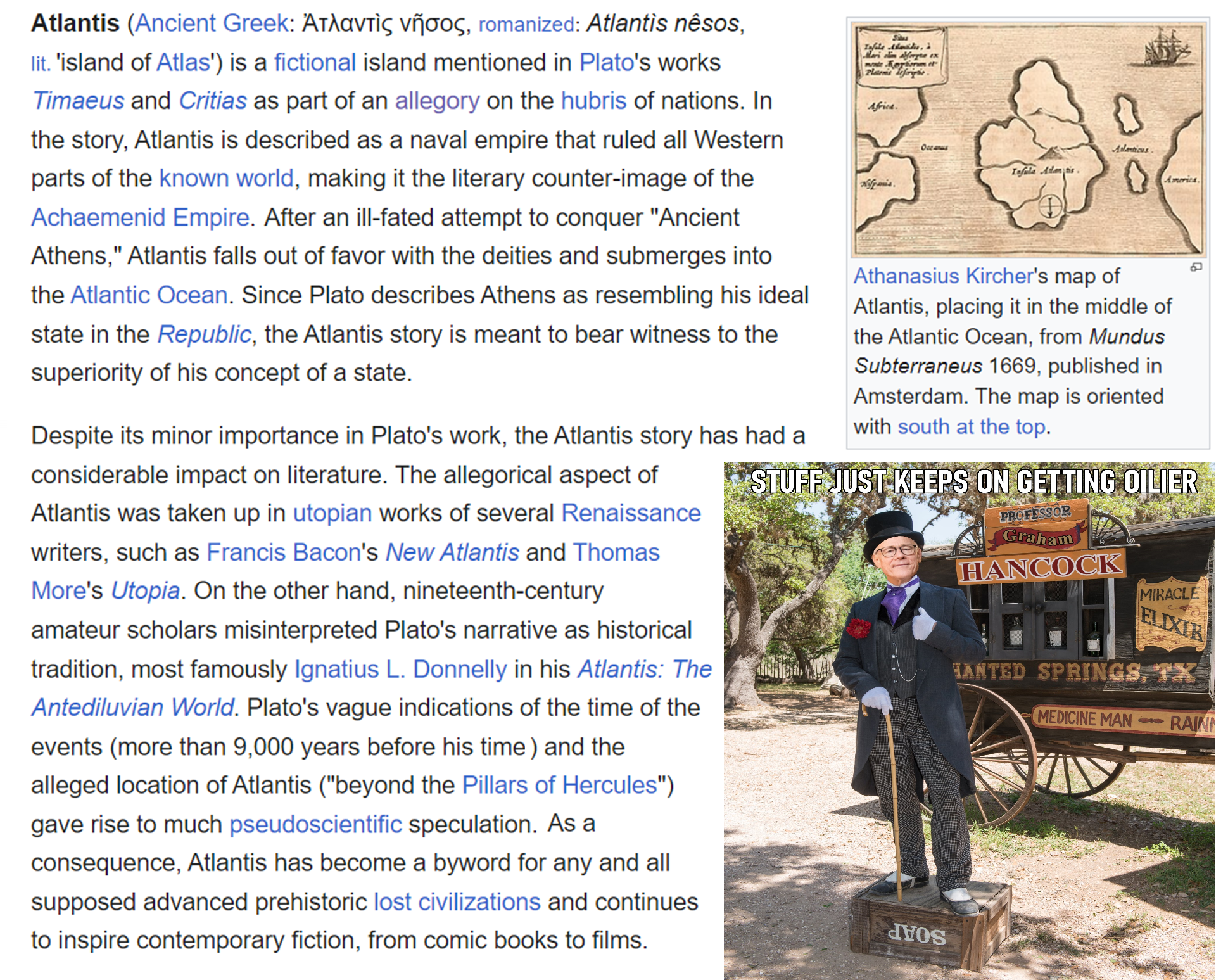

May Reason Set You Free
There are a lot of truly great things said by anarchists in history, and also some deeply vile things, too, from not supporting Women’s rights to Anti-Semitism. There are those who also reject those supporting women’s rights as well as fight anti-Semitism. This is why I push reason as my only master, not anarchist thinking, though anarchism, to me, should see all humans everywhere as equal in dignity and rights.
We—Cory and Damien—are following the greatness that can be found in anarchist thinking.
As an Anarchist Educator, Damien strives to teach the plain truth. Damien does not support violence as my method to change. Rather, I choose education that builds Enlightenment and Empowerment. I champion Dignity and Equality. We rise by helping each other. What is the price of a tear? What is the cost of a smile? How can we see clearly when others pay the cost of our indifference and fear? We should help people in need. Why is that so hard for some people? Rich Ghouls must End. Damien wants “billionaires” to stop being a thing. Tax then into equality. To Damien, there is no debate, Capitalism is unethical. Moreover, as an Anarchist Educator, Damien knows violence is not the way to inspire lasting positive change. But we are not limited to violence, we have education, one of the most lasting and powerful ways to improve the world. We empower the world by championing Truth and its supporters.
Anarchism and Education
“Various alternatives to education and their problems have been proposed by anarchists which have gone from alternative education systems and environments, self-education, advocacy of youth and children rights, and freethought activism.” ref
“Historical accounts of anarchist educational experiments to explore how their pedagogical practices, organization, and content constituted a radical alternative to mainstream forms of educational provision in different historical periods.” ref
“The Ferrer school was an early 20th century libertarian school inspired by the anarchist pedagogy of Francisco Ferrer. He was a proponent of rationalist, secular education that emphasized reason, dignity, self-reliance, and scientific observation. The Ferrer movement’s philosophy had two distinct tendencies: non-didactic freedom from dogma and the more didactic fostering of counter-hegemonic beliefs. Towards non-didactic freedom from dogma, and fulfilled the child-centered tradition.” ref
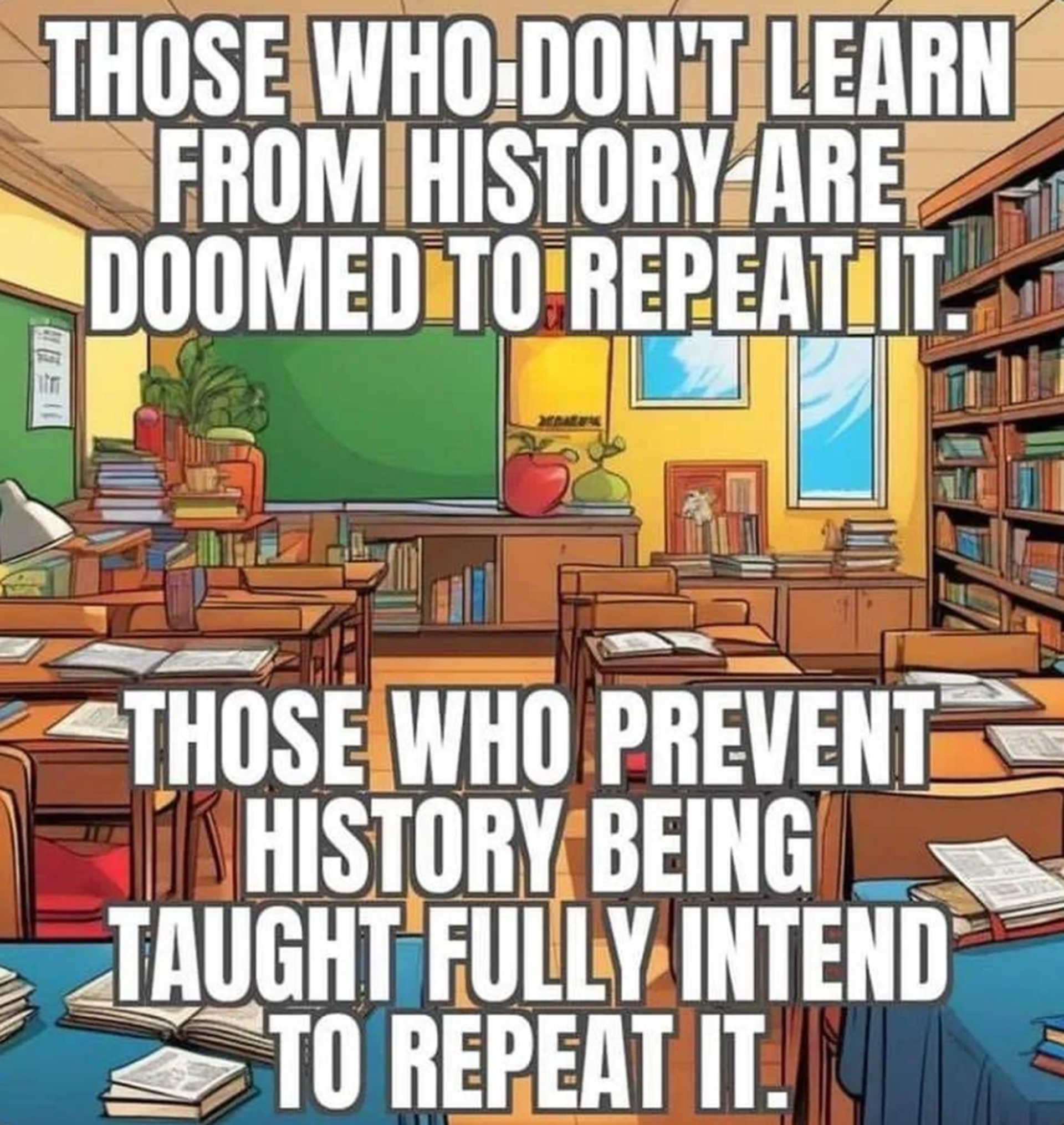
Teach Real History: all our lives depend on it.
Damien sees lies about history as crimes against humanity. And we all must help humanity by addressing “any and all” who make harmful lies about history.
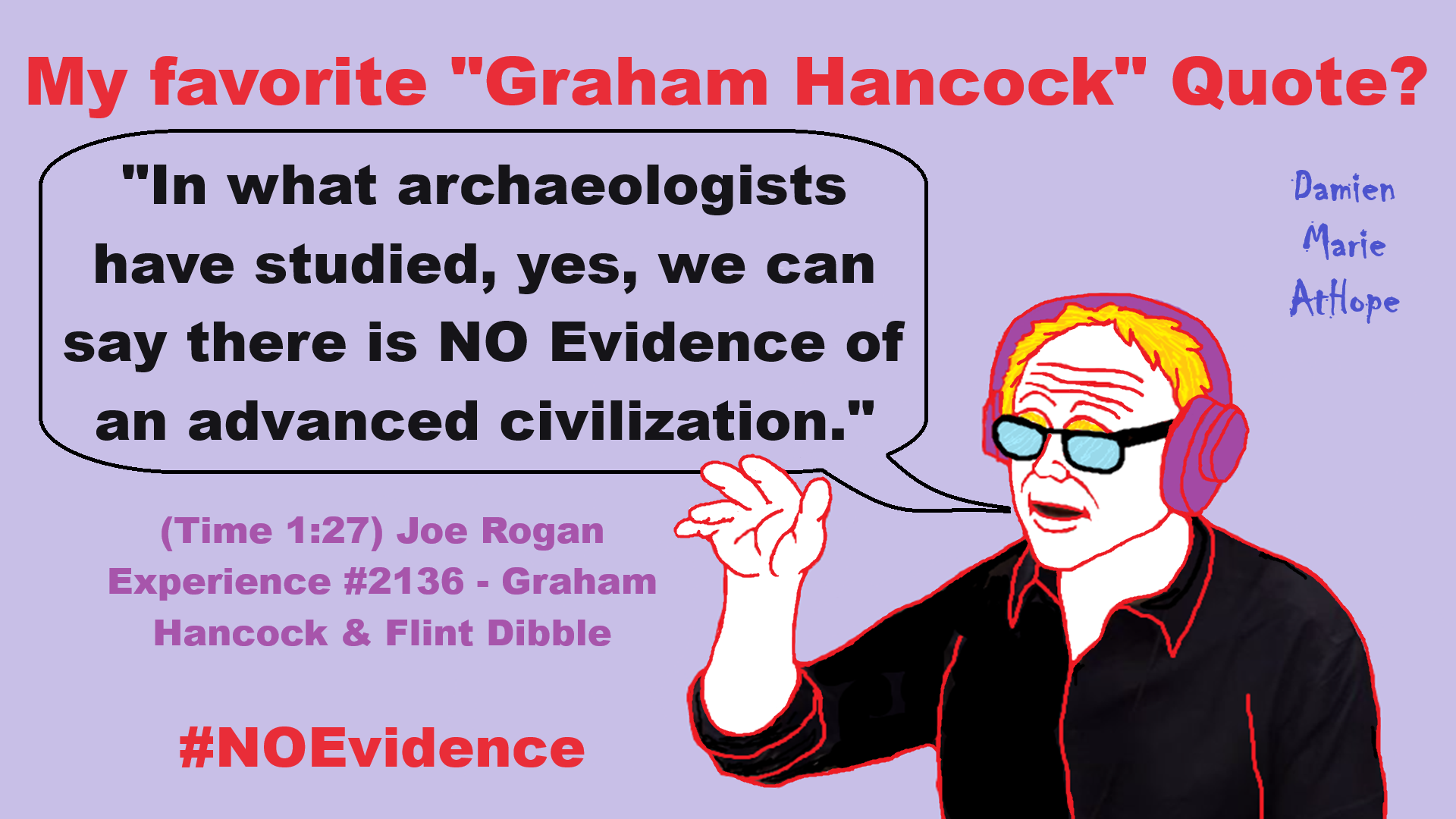
My favorite “Graham Hancock” Quote?
“In what archaeologists have studied, yes, we can say there is NO Evidence of an advanced civilization.” – (Time 1:27) Joe Rogan Experience #2136 – Graham Hancock & Flint Dibble
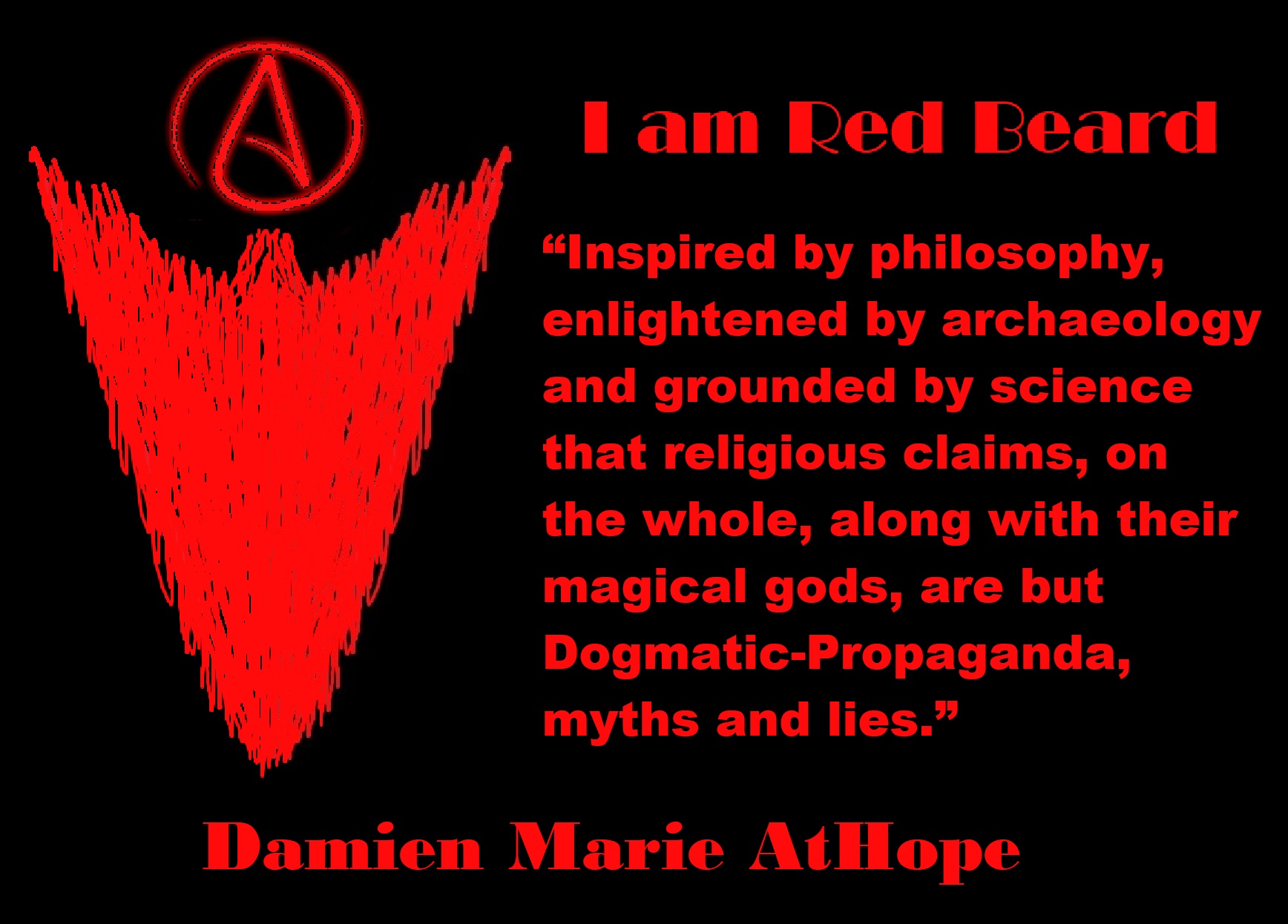
People don’t commonly teach religious history, even that of their own claimed religion. No, rather they teach a limited “pro their religion” history of their religion from a religious perspective favorable to the religion of choice.
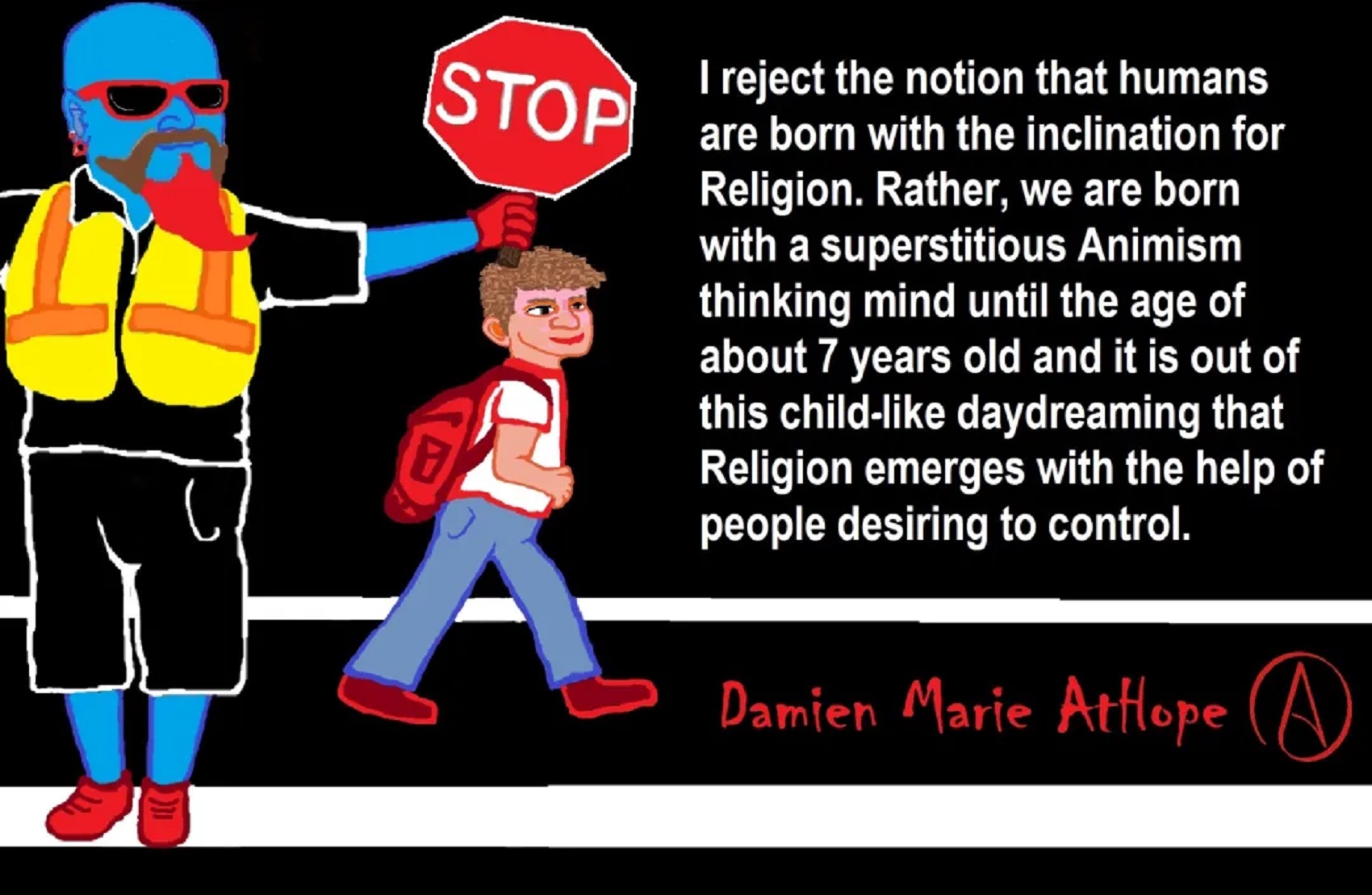
Do you truly think “Religious Belief” is only a matter of some personal choice?
Do you not see how coercive one’s world of choice is limited to the obvious hereditary belief, in most religious choices available to the child of religious parents or caregivers? Religion is more commonly like a family, culture, society, etc. available belief that limits the belief choices of the child and that is when “Religious Belief” is not only a matter of some personal choice and when it becomes hereditary faith, not because of the quality of its alleged facts or proposed truths but because everyone else important to the child believes similarly so they do as well simply mimicking authority beliefs handed to them. Because children are raised in religion rather than being presented all possible choices but rather one limited dogmatic brand of “Religious Belief” where children only have a choice of following the belief as instructed, and then personally claim the faith hereditary belief seen in the confirming to the belief they have held themselves all their lives. This is obvious in statements asked and answered by children claiming a faith they barely understand but they do understand that their family believes “this or that” faith, so they feel obligated to believe it too. While I do agree that “Religious Belief” should only be a matter of some personal choice, it rarely is… End Hereditary Religion!
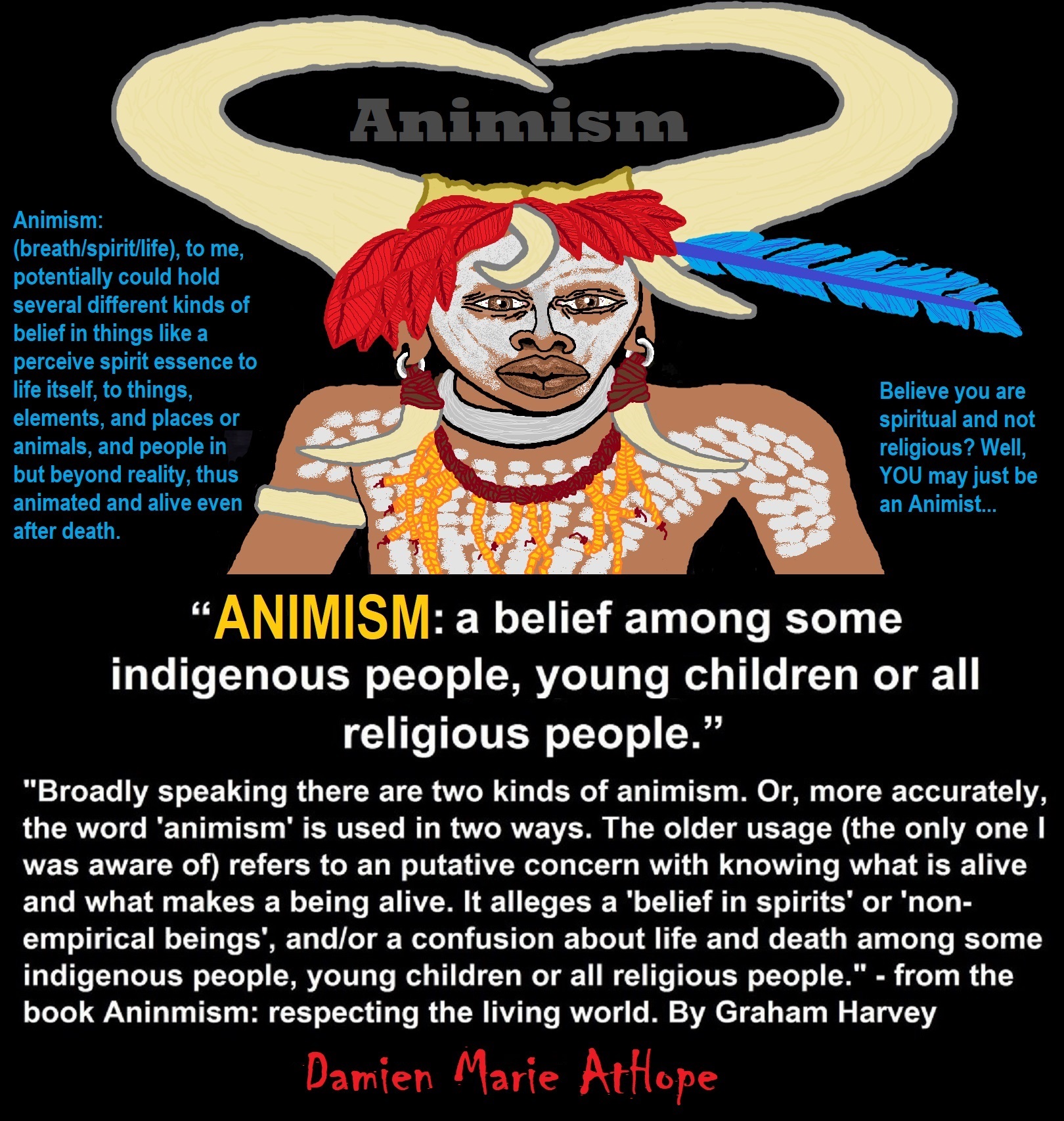
Animism: Respecting the Living World by Graham Harvey
“How have human cultures engaged with and thought about animals, plants, rocks, clouds, and other elements in their natural surroundings? Do animals and other natural objects have a spirit or soul? What is their relationship to humans? In this new study, Graham Harvey explores current and past animistic beliefs and practices of Native Americans, Maori, Aboriginal Australians, and eco-pagans. He considers the varieties of animism found in these cultures as well as their shared desire to live respectfully within larger natural communities. Drawing on his extensive casework, Harvey also considers the linguistic, performative, ecological, and activist implications of these different animisms.” ref
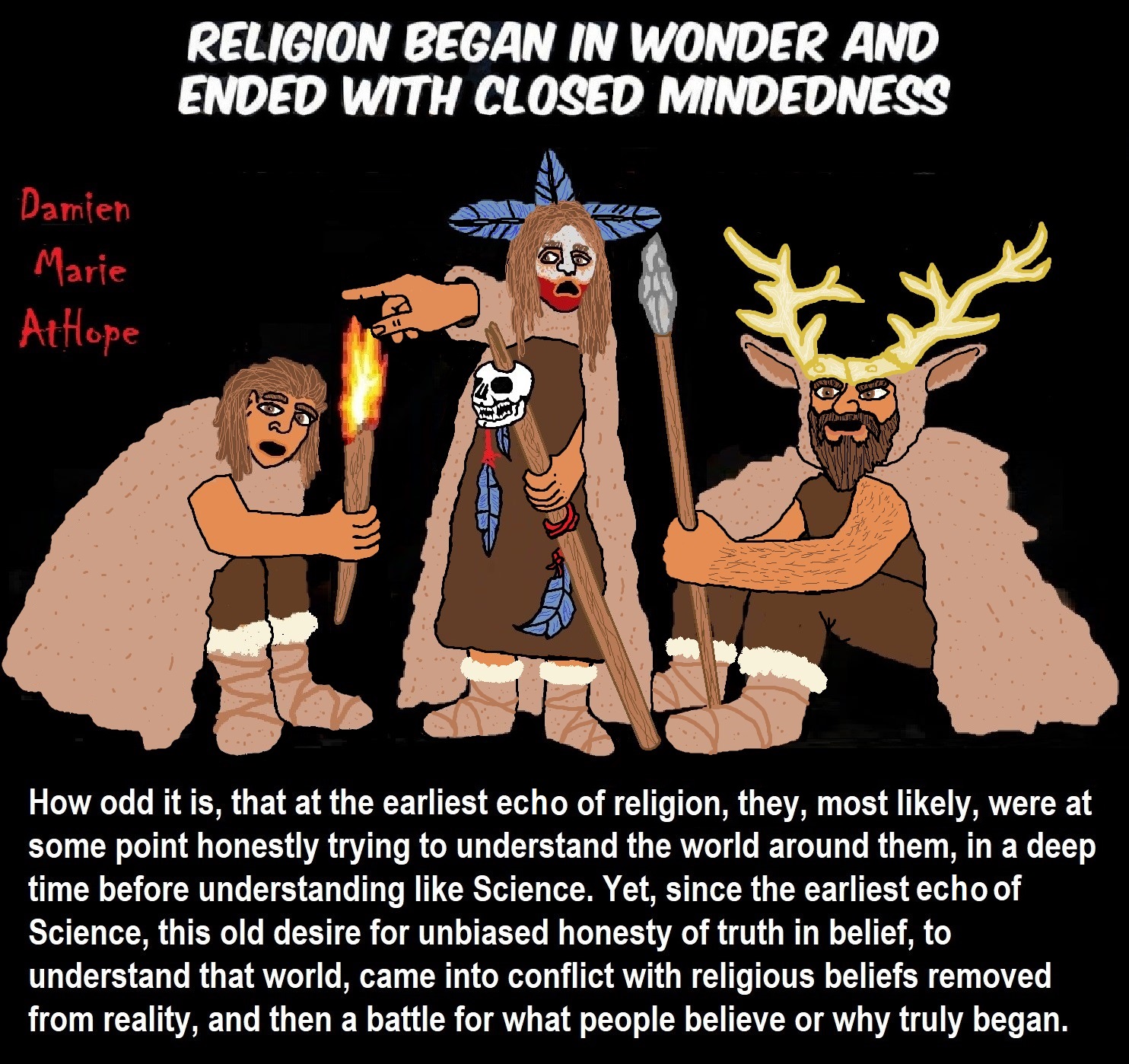
We are like believing machines we vacuum up ideas, like Velcro sticks to almost everything. We accumulate beliefs that we allow to negatively influence our lives, often without realizing it. Our willingness must be to alter skewed beliefs that impend our balance or reason, which allows us to achieve new positive thinking and accurate outcomes.
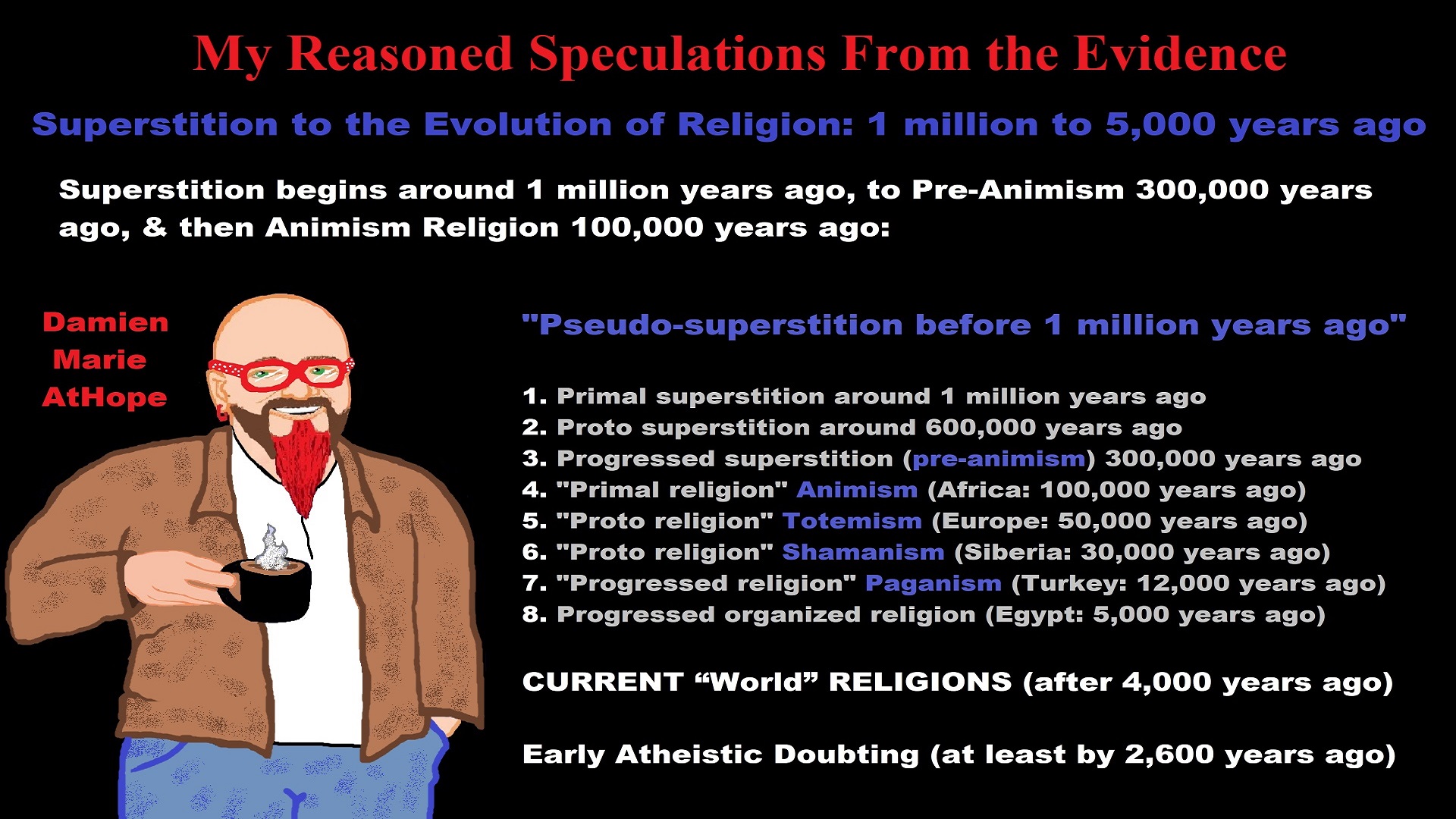
My thoughts on Religion Evolution with external links for more info:
- (Pre-Animism Africa mainly, but also Europe, and Asia at least 300,000 years ago), (Pre-Animism – Oxford Dictionaries)
- (Animism Africa around 100,000 years ago), (Animism – Britannica.com)
- (Totemism Europe around 50,000 years ago), (Totemism – Anthropology)
- (Shamanism Siberia around 30,000 years ago), (Shamanism – Britannica.com)
- (Paganism Turkey around 12,000 years ago), (Paganism – BBC Religion)
- (Progressed Organized Religion “Institutional Religion” Egypt around 5,000 years ago), (Ancient Egyptian Religion – Britannica.com)
- (CURRENT “World” RELIGIONS after 4,000 years ago) (Origin of Major Religions – Sacred Texts)
- (Early Atheistic Doubting at least by 2,600 years ago) (History of Atheism – Wikipedia)
“Religion is an Evolved Product” and Yes, Religion is Like Fear Given Wings…
Atheists talk about gods and religions for the same reason doctors talk about cancer, they are looking for a cure, or a firefighter talks about fires because they burn people and they care to stop them. We atheists too often feel a need to help the victims of mental slavery, held in the bondage that is the false beliefs of gods and the conspiracy theories of reality found in religions.
Understanding Religion Evolution:
- Pre-Animism (at least 300,000 years ago)
- Animism (Africa: 100,000 years ago)
- Totemism (Europe: 50,000 years ago)
- Shamanism (Siberia: 30,000 years ago)
- Paganism (Turkey: 12,000 years ago)
- Progressed organized religion (Egypt: 5,000 years ago), (Egypt, the First Dynasty 5,150 years ago)
- CURRENT “World” RELIGIONS (after 4,000 years ago)
- Early Atheistic Doubting (at least by 2,600 years ago)
“An Archaeological/Anthropological Understanding of Religion Evolution”
It seems ancient peoples had to survived amazing threats in a “dangerous universe (by superstition perceived as good and evil),” and human “immorality or imperfection of the soul” which was thought to affect the still living, leading to ancestor worship. This ancestor worship presumably led to the belief in supernatural beings, and then some of these were turned into the belief in gods. This feeble myth called gods were just a human conceived “made from nothing into something over and over, changing, again and again, taking on more as they evolve, all the while they are thought to be special,” but it is just supernatural animistic spirit-belief perceived as sacred.
Quick Evolution of Religion?
Pre-Animism (at least 300,000 years ago) pre-religion is a beginning that evolves into later Animism. So, Religion as we think of it, to me, all starts in a general way with Animism (Africa: 100,000 years ago) (theoretical belief in supernatural powers/spirits), then this is physically expressed in or with Totemism (Europe: 50,000 years ago) (theoretical belief in mythical relationship with powers/spirits through a totem item), which then enlists a full-time specific person to do this worship and believed interacting Shamanism (Siberia/Russia: 30,000 years ago) (theoretical belief in access and influence with spirits through ritual), and then there is the further employment of myths and gods added to all the above giving you Paganism (Turkey: 12,000 years ago) (often a lot more nature-based than most current top world religions, thus hinting to their close link to more ancient religious thinking it stems from). My hypothesis is expressed with an explanation of the building of a theatrical house (modern religions development). Progressed organized religion (Egypt: 5,000 years ago) with CURRENT “World” RELIGIONS (after 4,000 years ago).
Historically, in large city-state societies (such as Egypt or Iraq) starting around 5,000 years ago culminated to make religion something kind of new, a sociocultural-governmental-religious monarchy, where all or at least many of the people of such large city-state societies seem familiar with and committed to the existence of “religion” as the integrated life identity package of control dynamics with a fixed closed magical doctrine, but this juggernaut integrated religion identity package of Dogmatic-Propaganda certainly did not exist or if developed to an extent it was highly limited in most smaller prehistoric societies as they seem to lack most of the strong control dynamics with a fixed closed magical doctrine (magical beliefs could be at times be added or removed). Many people just want to see developed religious dynamics everywhere even if it is not. Instead, all that is found is largely fragments until the domestication of religion.
Religions, as we think of them today, are a new fad, even if they go back to around 6,000 years in the timeline of human existence, this amounts to almost nothing when seen in the long slow evolution of religion at least around 70,000 years ago with one of the oldest ritual worship. Stone Snake of South Africa: “first human worship” 70,000 years ago. This message of how religion and gods among them are clearly a man-made thing that was developed slowly as it was invented and then implemented peace by peace discrediting them all. Which seems to be a simple point some are just not grasping how devastating to any claims of truth when we can see the lie clearly in the archeological sites.
I wish people fought as hard for the actual values as they fight for the group/clan names political or otherwise they think support values. Every amount spent on war is theft to children in need of food or the homeless kept from shelter.
Here are several of my blog posts on history:
- To Find Truth You Must First Look
- (Magdalenian/Iberomaurusian) Connections to the First Paganists of the early Neolithic Near East Dating from around 17,000 to 12,000 Years Ago
- Natufians: an Ancient People at the Origins of Agriculture and Sedentary Life
- Possible Clan Leader/Special “MALE” Ancestor Totem Poles At Least 13,500 years ago?
- Jewish People with DNA at least 13,200 years old, Judaism, and the Origins of Some of its Ideas
- Baltic Reindeer Hunters: Swiderian, Lyngby, Ahrensburgian, and Krasnosillya cultures 12,020 to 11,020 years ago are evidence of powerful migratory waves during the last 13,000 years and a genetic link to Saami and the Finno-Ugric peoples.
- The Rise of Inequality: patriarchy and state hierarchy inequality
- Fertile Crescent 12,500 – 9,500 Years Ago: fertility and death cult belief system?
- 12,400 – 11,700 Years Ago – Kortik Tepe (Turkey) Pre/early-Agriculture Cultic Ritualism
- Ritualistic Bird Symbolism at Gobekli Tepe and its “Ancestor Cult”
- Male-Homosexual (female-like) / Trans-woman (female) Seated Figurine from Gobekli Tepe
- Could a 12,000-year-old Bull Geoglyph at Göbekli Tepe relate to older Bull and Female Art 25,000 years ago and Later Goddess and the Bull cults like Catal Huyuk?
- Sedentism and the Creation of goddesses around 12,000 years ago as well as male gods after 7,000 years ago.
- Alcohol, where Agriculture and Religion Become one? Such as Gobekli Tepe’s Ritualistic use of Grain as Food and Ritual Drink
- Neolithic Ritual Sites with T-Pillars and other Cultic Pillars
- Paganism: Goddesses around 12,000 years ago then Male Gods after 7,000 years ago
- First Patriarchy: Split of Women’s Status around 12,000 years ago & First Hierarchy: fall of Women’s Status around 5,000 years ago.
- Natufians: an Ancient People at the Origins of Agriculture and Sedentary Life
- J DNA and the Spread of Agricultural Religion (paganism)
- Paganism: an approximately 12,000-year-old belief system
- Paganism 12,000 years old: related to “Anarchism and Socialism” (Pre-Capitalism)
- Shaman burial in Israel 12,000 years ago and the Shamanism Phenomena
- Need to Mythicized: gods and goddesses
- 12,000 – 7,000 Years Ago – Paleo-Indian Culture (The Americas)
- 12,000 – 2,000 Years Ago – Indigenous-Scandinavians (Nordic)
- Norse did not wear helmets with horns?
- Pre-Pottery Neolithic Skull Cult around 11,500 to 8,400 Years Ago?
- 10,400 – 10,100 Years Ago, in Turkey the Nevail Cori Religious Settlement
- 9,000-6,500 Years Old Submerged Pre-Pottery/Pottery Neolithic Ritual Settlements off Israel’s Coast
- Catal Huyuk “first religious designed city” around 9,500 to 7,700 years ago (Turkey)
- Cultic Hunting at Catal Huyuk “first religious designed city”
- Special Items and Art as well as Special Elite Burials at Catal Huyuk
- New Rituals and Violence with the appearance of Pottery and People?
- Haplogroup N and its related Uralic Languages and Cultures
- Ainu people, Sámi people, Native Americans, the Ancient North Eurasians, and Paganistic-Shamanism with Totemism
- Ideas, Technology and People from Turkey, Europe, to China and Back again 9,000 to 5,000 years ago?
- First Pottery of Europe and the Related Cultures
- 9,000 years old Neolithic Artifacts Judean Desert and Hills Israel
- 9,000-7,000 years-old Sex and Death Rituals: Cult Sites in Israel, Jordan, and the Sinai
- 9,000-8500 year old Horned Female shaman Bad Dürrenberg Germany
- Neolithic Jewelry and the Spread of Farming in Europe Emerging out of West Turkey
- 8,600-year-old Tortoise Shells in Neolithic graves in central China have Early Writing and Shamanism
- Swing of the Mace: the rise of Elite, Forced Authority, and Inequality begin to Emerge 8,500 years ago?
- Migrations and Changing Europeans Beginning around 8,000 Years Ago
- My “Steppe-Anatolian-Kurgan hypothesis” 8,000/7,000 years ago
- Around 8,000-year-old Shared Idea of the Mistress of Animals, “Ritual” Motif
- Pre-Columbian Red-Paint (red ochre) Maritime Archaic Culture 8,000-3,000 years ago
- 7,522-6,522 years ago Linear Pottery culture which I think relates to Arcane Capitalism’s origins
- Arcane Capitalism: Primitive socialism, Primitive capital, Private ownership, Means of production, Market capitalism, Class discrimination, and Petite bourgeoisie (smaller capitalists)
- 7,500-4,750 years old Ritualistic Cucuteni-Trypillian culture of Moldova, Romania, and Ukraine
- Roots of a changing early society 7,200-6,700 years ago Jordan and Israel
- Agriculture religion (Paganism) with farming reached Britain between about 7,000 to 6,500 or so years ago and seemingly expressed in things like Western Europe’s Long Barrows
- My Thoughts on Possible Migrations of “R” DNA and Proto-Indo-European?
- “Millet” Spreading from China 7,022 years ago to Europe and related Language may have Spread with it leading to Proto-Indo-European
- Proto-Indo-European (PIE), ancestor of Indo-European languages: DNA, Society, Language, and Mythology
- The Dnieper–Donets culture and Asian varieties of Millet from China to the Black Sea region of Europe by 7,022 years ago
- Kurgan 6,000 years ago/dolmens 7,000 years ago: funeral, ritual, and other?
- 7,020 to 6,020-year-old Proto-Indo-European Homeland of Urheimat or proposed home of their Language and Religion
- Ancient Megaliths: Kurgan, Ziggurat, Pyramid, Menhir, Trilithon, Dolman, Kromlech, and Kromlech of Trilithons
- The Mytheme of Ancient North Eurasian Sacred-Dog belief and similar motifs are found in Indo-European, Native American, and Siberian comparative mythology
- Elite Power Accumulation: Ancient Trade, Tokens, Writing, Wealth, Merchants, and Priest-Kings
- Sacred Mounds, Mountains, Kurgans, and Pyramids may hold deep connections?
- Between 7,000-5,000 Years ago, rise of unequal hierarchy elite, leading to a “birth of the State” or worship of power, strong new sexism, oppression of non-elites, and the fall of Women’s equal status
- Paganism 7,000-5,000 years old: related to “Anarchism and Socialism” (Capitalism) (World War 0) Elite & their slaves
- Hell and Underworld mythologies starting maybe as far back as 7,000 to 5,000 years ago with the Proto-Indo-Europeans?
- The First Expression of the Male God around 7,000 years ago?
- White (light complexion skin) Bigotry and Sexism started 7,000 years ago?
- Around 7,000-year-old Shared Idea of the Divine Bird (Tutelary and/or Trickster spirit/deity), “Ritual” Motif
- Nekhbet an Ancient Egyptian Vulture Goddess and Tutelary Deity
- 6,720 to 4,920 years old Ritualistic Hongshan Culture of Inner Mongolia with 5,000-year-old Pyramid Mounds and Temples
- First proto-king in the Balkans, Varna culture around 6,500 years ago?
- 6,500–5,800 years ago in Israel Late Chalcolithic (Copper Age) Period in the Southern Levant Seems to Express Northern Levant Migrations, Cultural and Religious Transfer
- KING OF BEASTS: Master of Animals “Ritual” Motif, around 6,000 years old or older…
- Around 6000-year-old Shared Idea of the Solid Wheel & the Spoked Wheel-Shaped Ritual Motif
- “The Ghassulian Star,” a mysterious 6,000-year-old mural from Jordan; a Proto-Star of Ishtar, Star of Inanna or Star of Venus?
- Religious/Ritual Ideas, including goddesses and gods as well as ritual mounds or pyramids from Northeastern Asia at least 6,000 years old, seemingly filtering to Iran, Iraq, the Mediterranean, Europe, Egypt, and the Americas?
- Maykop (5,720–5,020 years ago) Caucasus region Bronze Age culture-related to Copper Age farmers from the south, influenced by the Ubaid period and Leyla-Tepe culture, as well as influencing the Kura-Araxes culture
- 5-600-year-old Tomb, Mummy, and First Bearded Male Figurine in a Grave
- Kura-Araxes Cultural 5,520 to 4,470 years old DNA traces to the Canaanites, Arabs, and Jews
- Minoan/Cretan (Keftiu) Civilization and Religion around 5,520 to 3,120 years ago
- Evolution Of Science at least by 5,500 years ago
- 5,500 Years old birth of the State, the rise of Hierarchy, and the fall of Women’s status
- “Jiroft culture” 5,100 – 4,200 years ago and the History of Iran
- Stonehenge: Paganistic Burial and Astrological Ritual Complex, England (5,100-3,600 years ago)
- Around 5,000-year-old Shared Idea of the “Tree of Life” Ritual Motif
- Complex rituals for elite, seen from China to Egypt, at least by 5,000 years ago
- Around 5,000 years ago: “Birth of the State” where Religion gets Military Power and Influence
- The Center of the World “Axis Mundi” and/or “Sacred Mountains” Mythology Could Relate to the Altai Mountains, Heart of the Steppe
- Progressed organized religion starts, an approximately 5,000-year-old belief system
- China’s Civilization between 5,000-3,000 years ago, was a time of war and class struggle, violent transition from free clans to a Slave or Elite society
- Origin of Logics is Naturalistic Observation at least by around 5,000 years ago.
- Paganism 5,000 years old: progressed organized religion and the state: related to “Anarchism and Socialism” (Kings and the Rise of the State)
- Ziggurats (multi-platform temples: 4,900 years old) to Pyramids (multi-platform tombs: 4,700 years old)
- Did a 4,520–4,420-year-old Volcano In Turkey Inspire the Bible God?
- Finland’s Horned Shaman and Pre-Horned-God at least 4,500 years ago?
- 4,000-year-Old Dolmens in Israel: A Connected Dolmen Religious Phenomenon?
- Creation myths: From chaos, Ex nihilo, Earth-diver, Emergence, World egg, and World parent
- Bronze Age “Ritual” connections of the Bell Beaker culture with the Corded Ware/Single Grave culture, which were related to the Yamnaya culture and Proto-Indo-European Languages/Religions
- Low Gods (Earth/ Tutelary deity), High Gods (Sky/Supreme deity), and Moralistic Gods (Deity enforcement/divine order)
- The exchange of people, ideas, and material-culture including, to me, the new god (Sky Father) and goddess (Earth Mother) religion between the Cucuteni-Trypillians and others which is then spread far and wide
- Koryaks: Indigenous People of the Russian Far East and Big Raven myths also found in Tlingit, Haida, Tsimshian, and other Indigenous People of North America
- 42 Principles Of Maat (Egyptian Goddess of the justice) around 4,400 years ago, 2000 Years Before Ten Commandments
- “Happy Easter” Well Happy Eostre/Ishter
- 4,320-3,820 years old “Shimao” (North China) site with Totemistic-Shamanistic Paganism and a Stepped Pyramid
- 4,250 to 3,400 Year old Stonehenge from Russia: Arkaim?
- 4,100-year-old beaker with medicinal & flowering plants in a grave of a woman in Scotland
- Early European Farmer ancestry, Kelif el Boroud people with the Cardial Ware culture, and the Bell Beaker culture Paganists too, spread into North Africa, then to the Canary Islands off West Africa
- Flood Accounts: Gilgamesh epic (4,100 years ago) Noah in Genesis (2,600 years ago)
- Paganism 4,000 years old: related to “Anarchism and Socialism” (First Moralistic gods, then the Origin time of Monotheism)
- When was the beginning: TIMELINE OF CURRENT RELIGIONS, which start around 4,000 years ago.
- Early Religions Thought to Express Proto-Monotheistic Systems around 4,000 years ago
- Kultepe? An archaeological site with a 4,000 years old women’s rights document.
- Single God Religions (Monotheism) = “Man-o-theism” started around 4,000 years ago with the Great Sky Spirit/God Tiān (天)?
- Confucianism’s Tiān (Shangdi god 4,000 years old): Supernaturalism, Pantheism or Theism?
- Yes, Your Male God is Ridiculous
- Mythology, a Lunar Deity is a Goddess or God of the Moon
- Sacred Land, Hills, and Mountains: Sami Mythology (Paganistic Shamanism)
- Horse Worship/Sacrifice: mythical union of Ruling Elite/Kingship and the Horse
- The Amorite/Amurru people’s God Amurru “Lord of the Steppe”, relates to the Origins of the Bible God?
- Bronze Age Exotic Trade Routes Spread Quite Far as well as Spread Religious Ideas with Them
- Sami and the Northern Indigenous Peoples Landscape, Language, and its Connection to Religion
- Prototype of Ancient Analemmatic Sundials around 3,900-3,150 years ago and a Possible Solar Connection to gods?
- Judaism is around 3,450 or 3,250 years old. (“Paleo-Hebrew” 3,000 years ago and Torah 2,500 years ago)
- The Weakening of Ancient Trade and the Strengthening of Religions around 3000 years ago?
- Are you aware that there are religions that worship women gods, explain now religion tears women down?
- Animistic, Totemistic, and Paganistic Superstition Origins of bible god and the bible’s Religion.
- Myths and Folklore: “Trickster gods and goddesses”
- Jews, Judaism, and the Origins of Some of its Ideas
- An Old Branch of Religion Still Giving Fruit: Sacred Trees
- Dating the BIBLE: naming names and telling times (written less than 3,000 years ago, provable to 2,200 years ago)
- Did a Volcano Inspire the bible god?
- Dené–Yeniseian language, Old Copper Complex, and Pre-Columbian Mound Builders?
- No “dinosaurs and humans didn’t exist together just because some think they are in the bible itself”
- Sacred Shit and Sacred Animals?
- Everyone Killed in the Bible Flood? “Nephilim” (giants)?
- Hey, Damien dude, I have a question for you regarding “the bible” Exodus.
- Archaeology Disproves the Bible
- Bible Battle, Just More, Bible Babble
- The Jericho Conquest lie?
- Canaanites and Israelites?
- Accurate Account on how did Christianity Began?
- Let’s talk about Christianity.
- So the 10 commandments isn’t anything to go by either right?
- Misinformed christian
- Debunking Jesus?
- Paulism vs Jesus
- Ok, you seem confused so let’s talk about Buddhism.
- Unacknowledged Buddhism: Gods, Savior, Demons, Rebirth, Heavens, Hells, and Terrorism
- His Foolishness The Dalai Lama
- Yin and Yang is sexist with an ORIGIN around 2,300 years ago?
- I Believe Archaeology, not Myths & Why Not, as the Religious Myths Already Violate Reason!
- Archaeological, Scientific, & Philosophic evidence shows the god myth is man-made nonsense.
- Aquatic Ape Theory/Hypothesis? As Always, Just Pseudoscience.
- Ancient Aliens Conspiracy Theorists are Pseudohistorians
- The Pseudohistoric and Pseudoscientific claims about “Bakoni Ruins” of South Africa
- Why do people think Religion is much more than supernaturalism and superstitionism?
- Religion is an Evolved Product
- Was the Value of Ancient Women Different?
- 1000 to 1100 CE, human sacrifice Cahokia Mounds a pre-Columbian Native American site
- Feminist atheists as far back as the 1800s?
- Promoting Religion as Real is Mentally Harmful to a Flourishing Humanity
- Screw All Religions and Their Toxic lies, they are all fraud
- Forget Religions’ Unfounded Myths, I Have Substantiated “Archaeology Facts.”
- Religion Dispersal throughout the World
- I Hate Religion Just as I Hate all Pseudoscience
- Exposing Scientology, Eckankar, Wicca and Other Nonsense?
- Main deity or religious belief systems
- Quit Trying to Invent Your God From the Scraps of Science.
- Archaeological, Scientific, & Philosophic evidence shows the god myth is man-made nonsense.
- Ancient Alien Conspiracy Theorists: Misunderstanding, Rhetoric, Misinformation, Fabrications, and Lies
- Misinformation, Distortion, and Pseudoscience in Talking with a Christian Creationist
- Judging the Lack of Goodness in Gods, Even the Norse God Odin
- Challenging the Belief in God-like Aliens and Gods in General
- A Challenge to Christian use of Torture Devices?
- Yes, Hinduism is a Religion
- Trump is One of the Most Reactionary Forces of Far-right Christian Extremism
- Was the Bull Head a Symbol of God? Yes!
- Primate Death Rituals
- Christian – “God and Christianity are objectively true”
- Australopithecus afarensis Death Ritual?
- You Claim Global Warming is a Hoax?
- Doubter of Science and Defamer of Atheists?
- I think that sounds like the Bible?
- History of the Antifa (“anti-fascist”) Movements
- Indianapolis Anti-Blasphemy Laws #Free Soheil Rally
- Damien, you repeat the golden rule in so many forms then you say religion is dogmatic?
- Science is a Trustable Methodology whereas Faith is not Trustable at all!
- Was I ever a believer, before I was an atheist?
- Atheists rise in reason
- Mistrust of science?
- Open to Talking About the Definition of ‘God’? But first, we address Faith.
- ‘United Monarchy’ full of splendor and power – Saul, David, and Solomon? Most likely not.
- Is there EXODUS ARCHAEOLOGY? The short answer is “no.”
- Lacking Proof of Bigfoots, Unicorns, and Gods is Just a Lack of Research?
- Religion and Politics: Faith Beliefs vs. Rational Thinking
- Hammer of Truth that lying pig RELIGION: challenged by an archaeologist
- “The Hammer of Truth” -ontology question- What do You Mean by That?
- Navigation of a bad argument: Ad Hominem vs. Attack
- Why is it Often Claimed that Gods have a Gender?
- Why are basically all monotheistic religions ones that have a male god?
- Shifting through the Claims in support of Faith
- Dear Mr. AtHope, The 20th Century is an Indictment of Secularism and a Failed Atheist Century
- An Understanding of the Worldwide Statistics and Dynamics of Terrorist Incidents and Suicide Attacks
- Intoxication and Evolution? Addressing and Assessing the “Stoned Ape” or “Drunken Monkey” Theories as Catalysts in Human Evolution
- Sacred Menstrual cloth? Inanna’s knot, Isis knot, and maybe Ma’at’s feather?
- Damien, why don’t the Hebrews accept the bible stories?
- Dealing with a Troll and Arguing Over Word Meaning
- Knowledge without Belief? Justified beliefs or disbeliefs worthy of Knowledge?
- Afrocentrism and African Religions
- Crecganford @crecganford offers history & stories of the people, places, gods, & culture
- Empiricism-Denier?
I am not an academic. I am a revolutionary that teaches in public, in places like social media, and in the streets. I am not a leader by some title given but from my commanding leadership style of simply to start teaching everywhere to everyone, all manner of positive education.
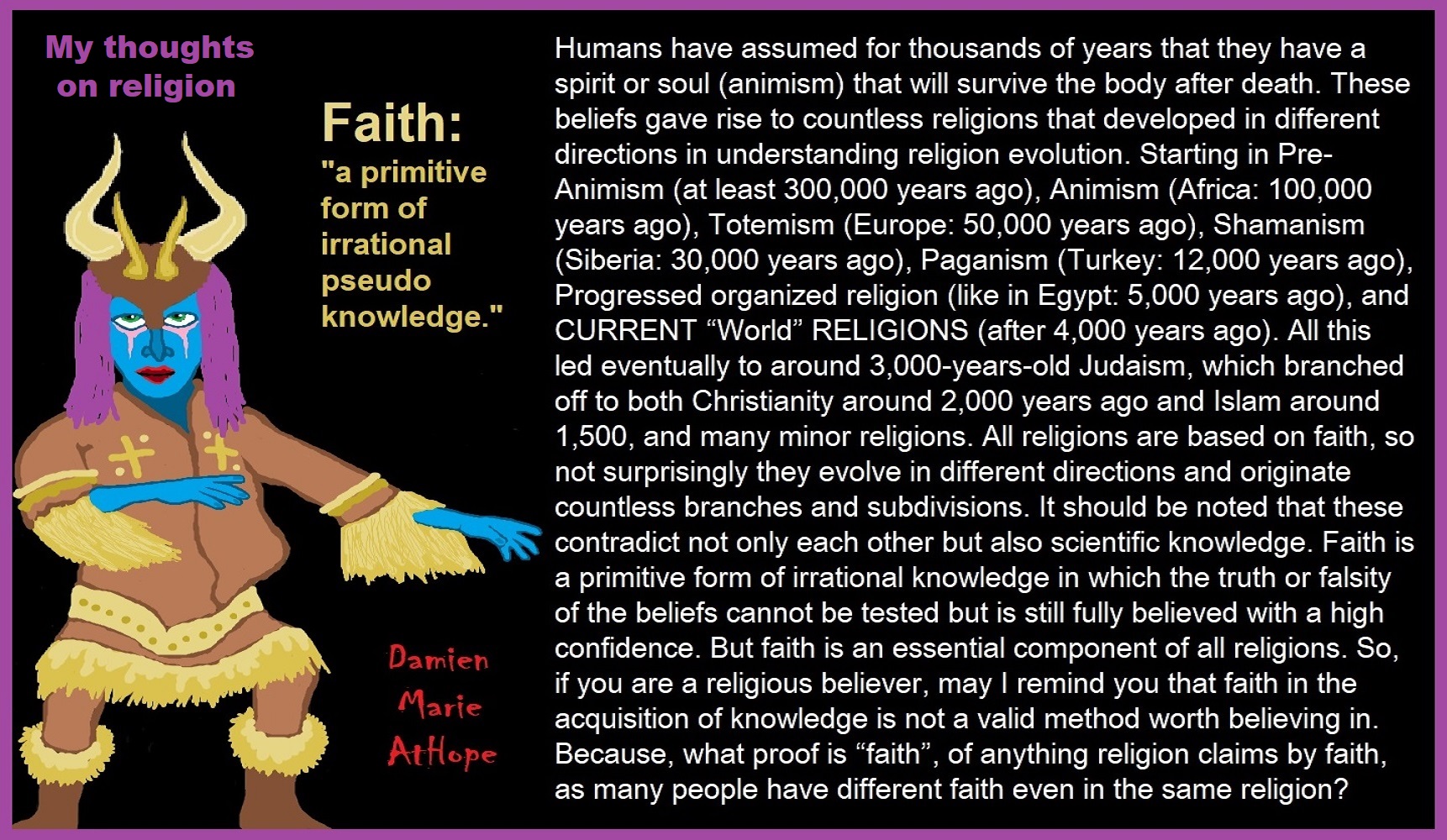

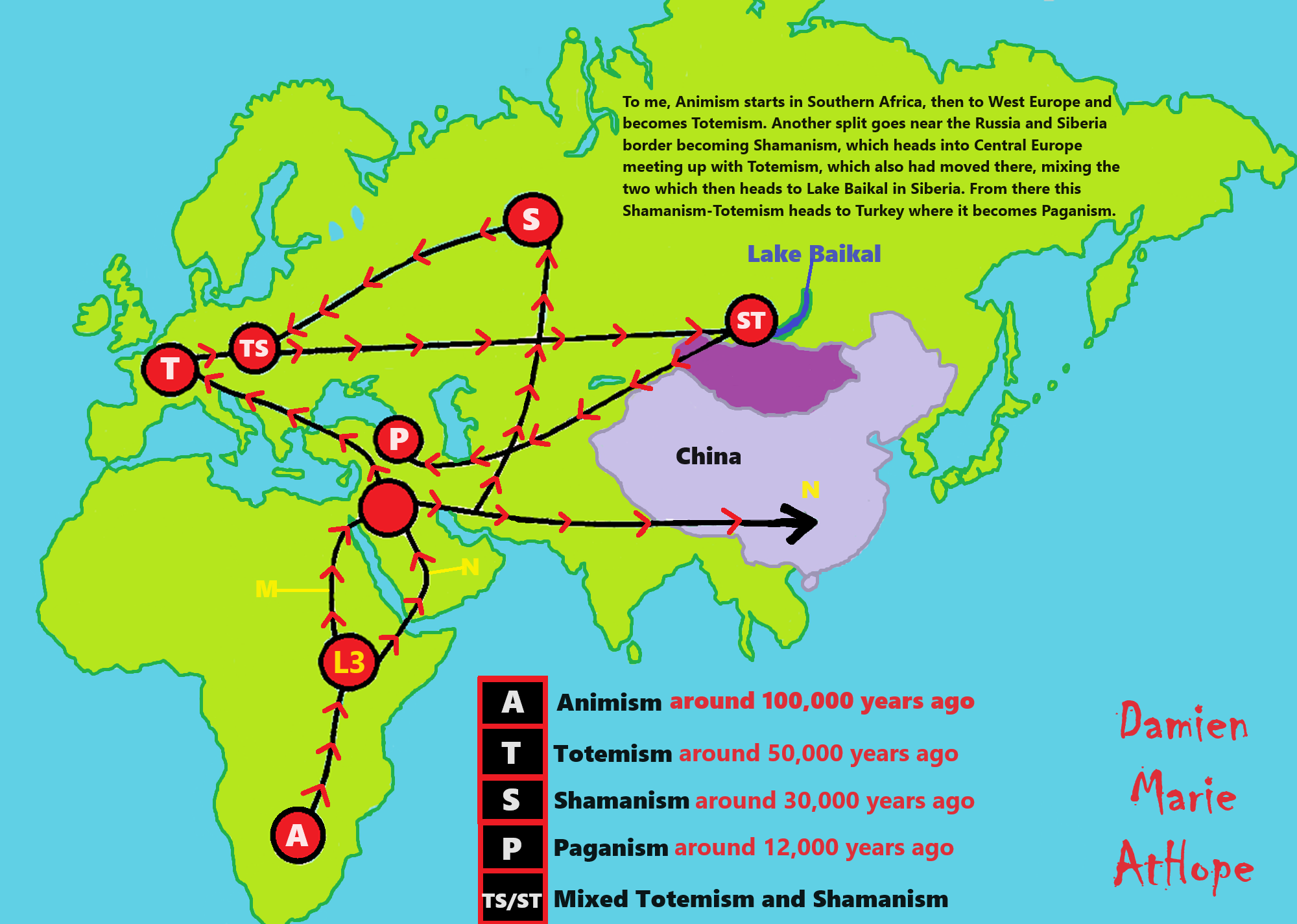
To me, Animism starts in Southern Africa, then to West Europe, and becomes Totemism. Another split goes near the Russia and Siberia border becoming Shamanism, which heads into Central Europe meeting up with Totemism, which also had moved there, mixing the two which then heads to Lake Baikal in Siberia. From there this Shamanism-Totemism heads to Turkey where it becomes Paganism.
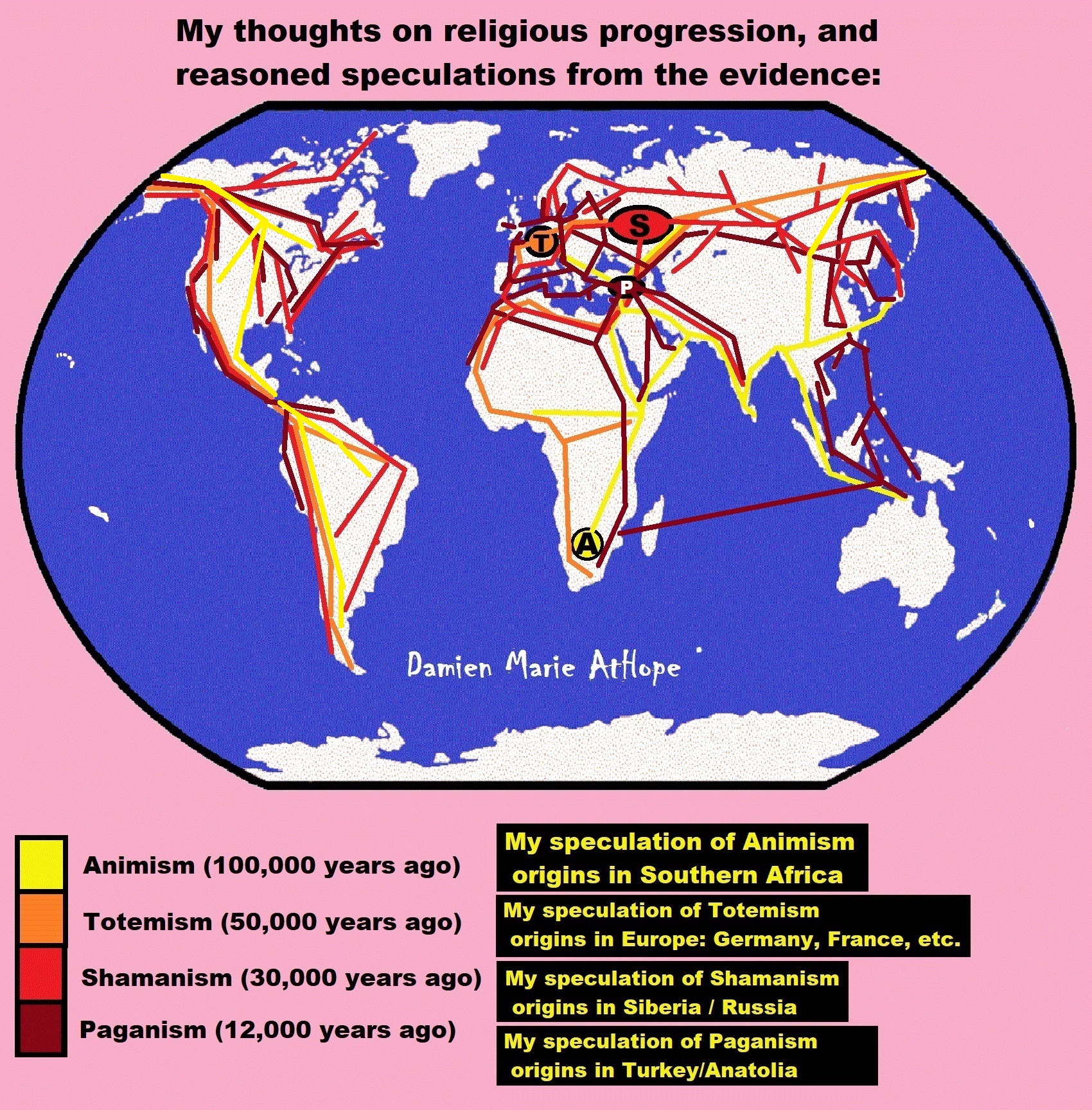
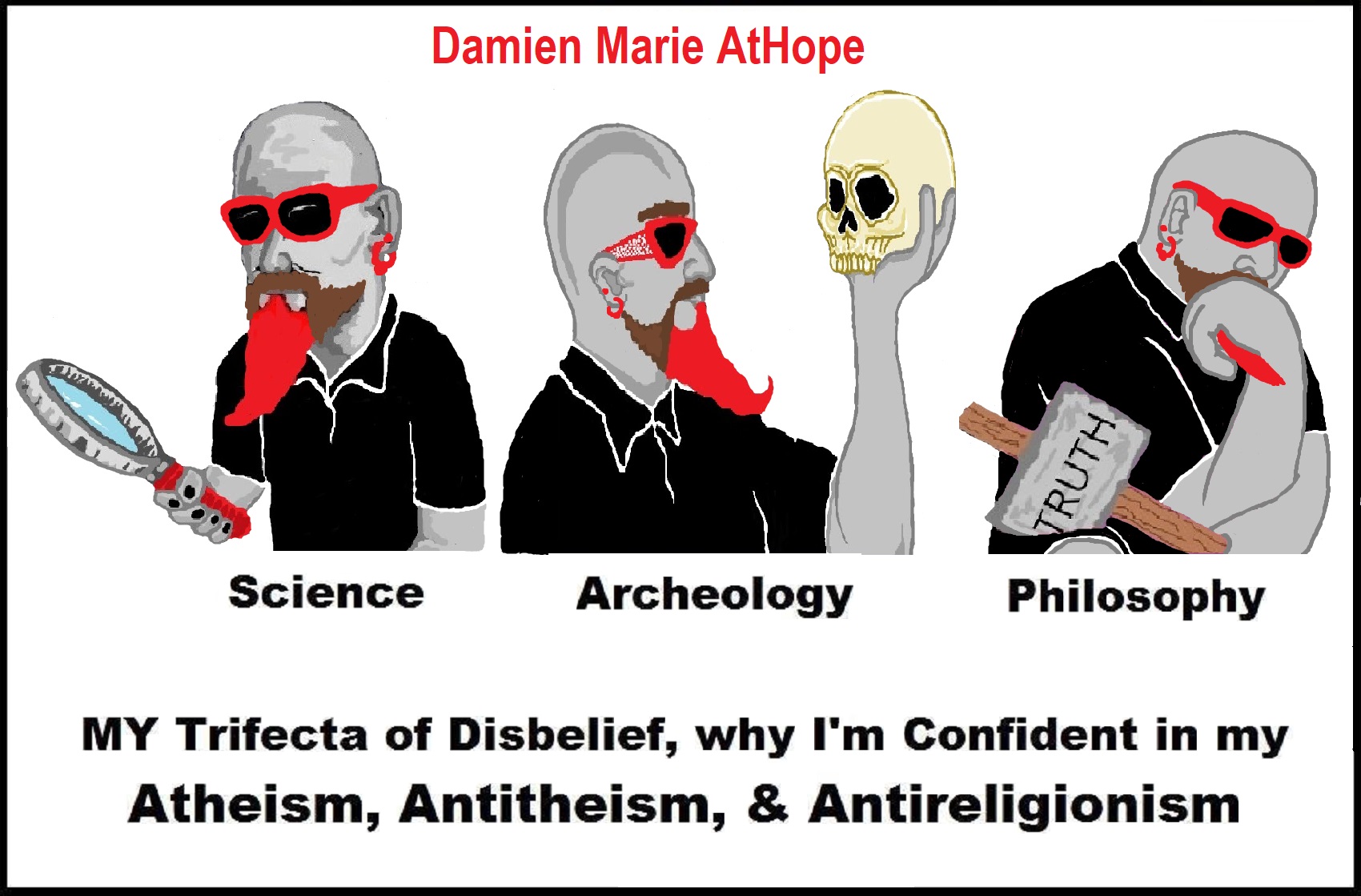
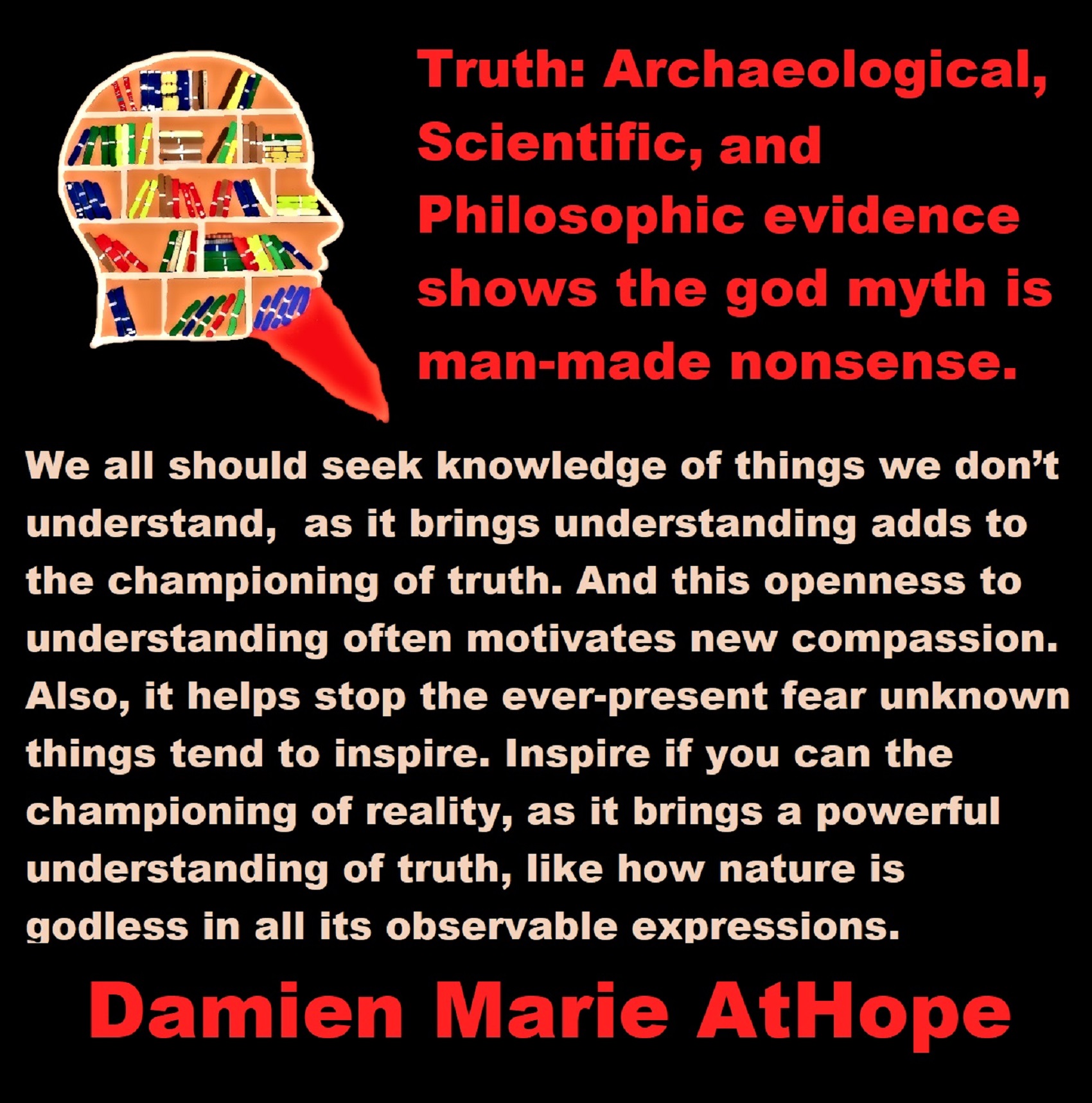
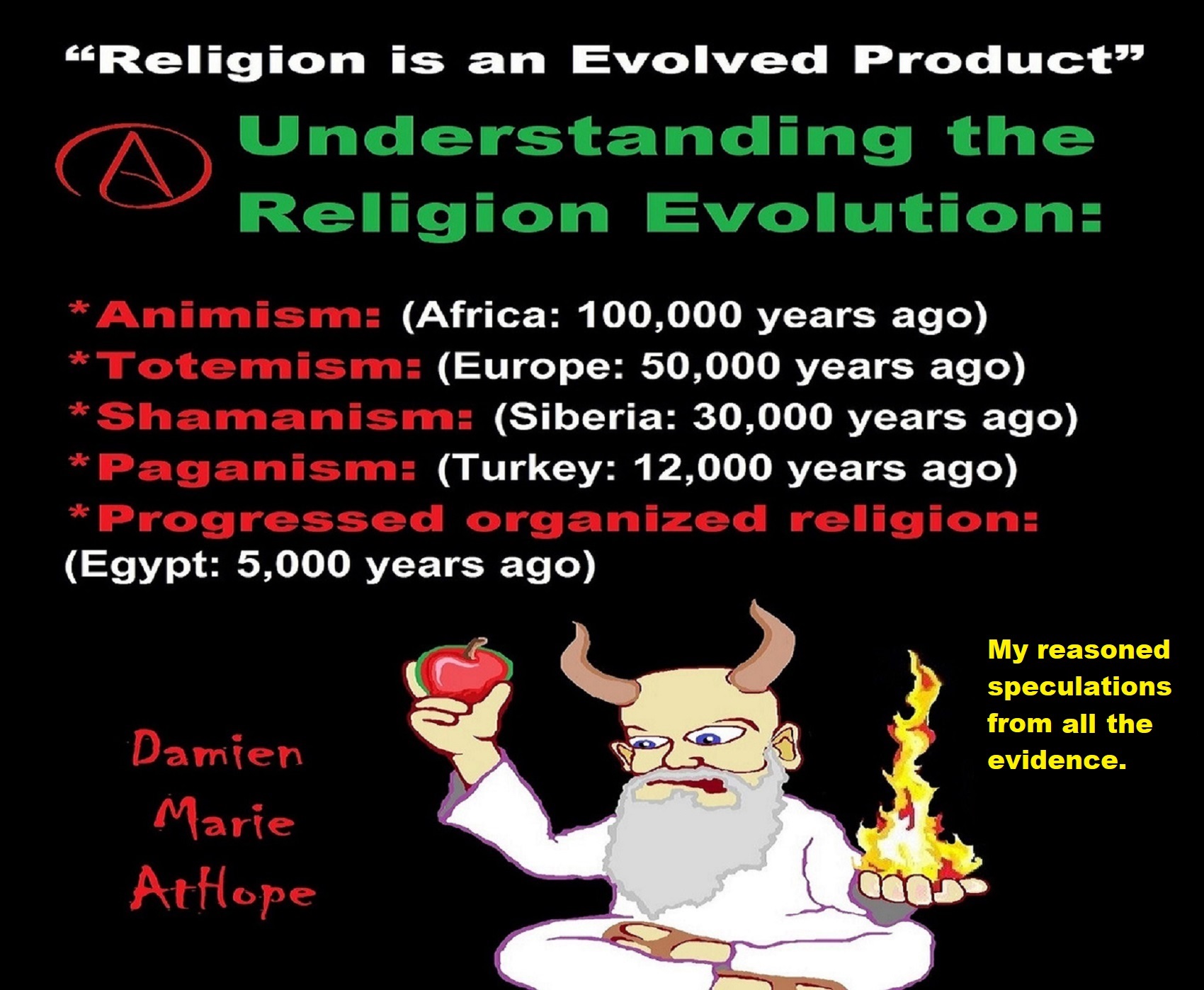
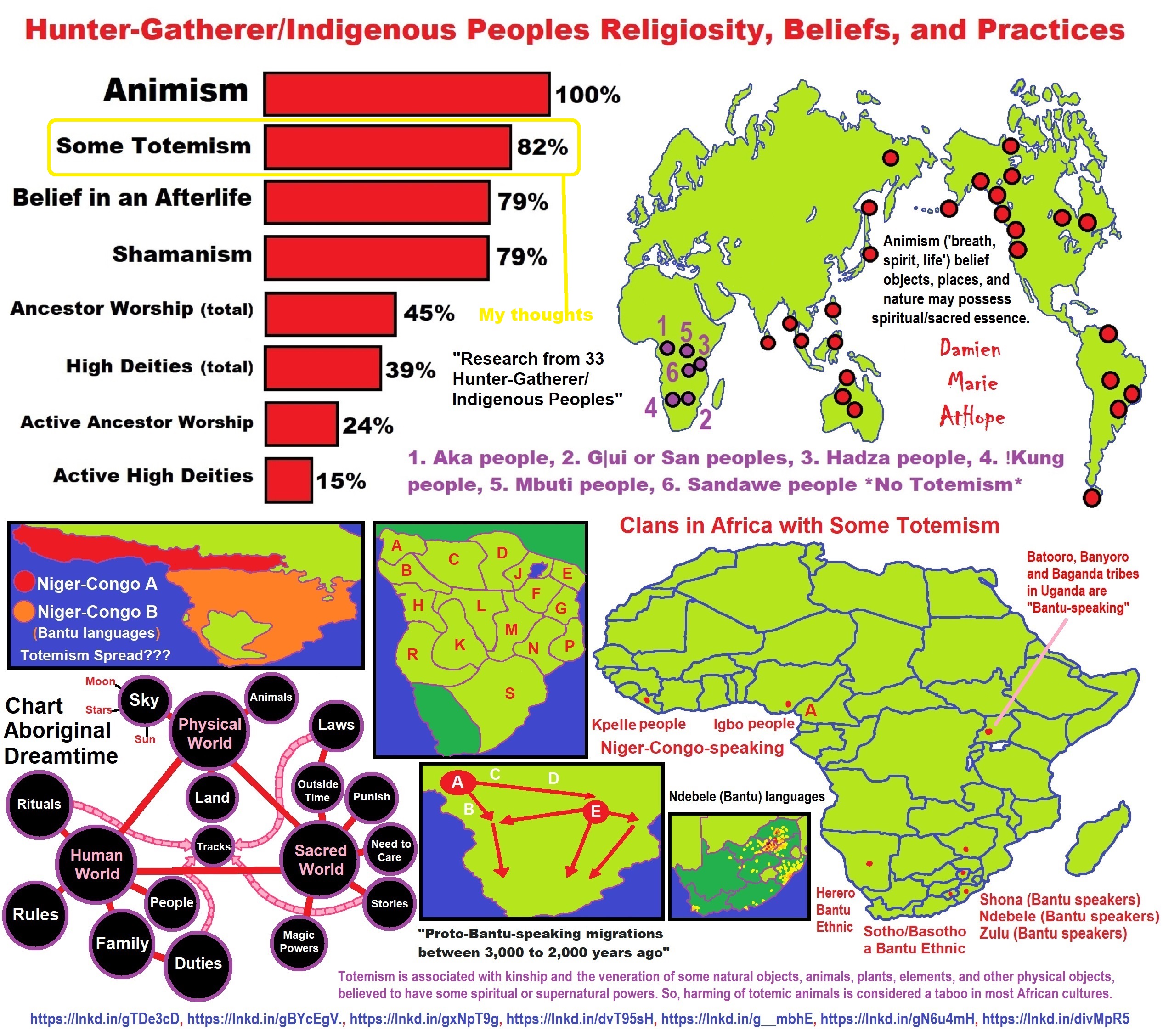
Not all “Religions” or “Religious Persuasions” have a god(s) but
All can be said to believe in some imaginary beings or imaginary things like spirits, afterlives, etc.
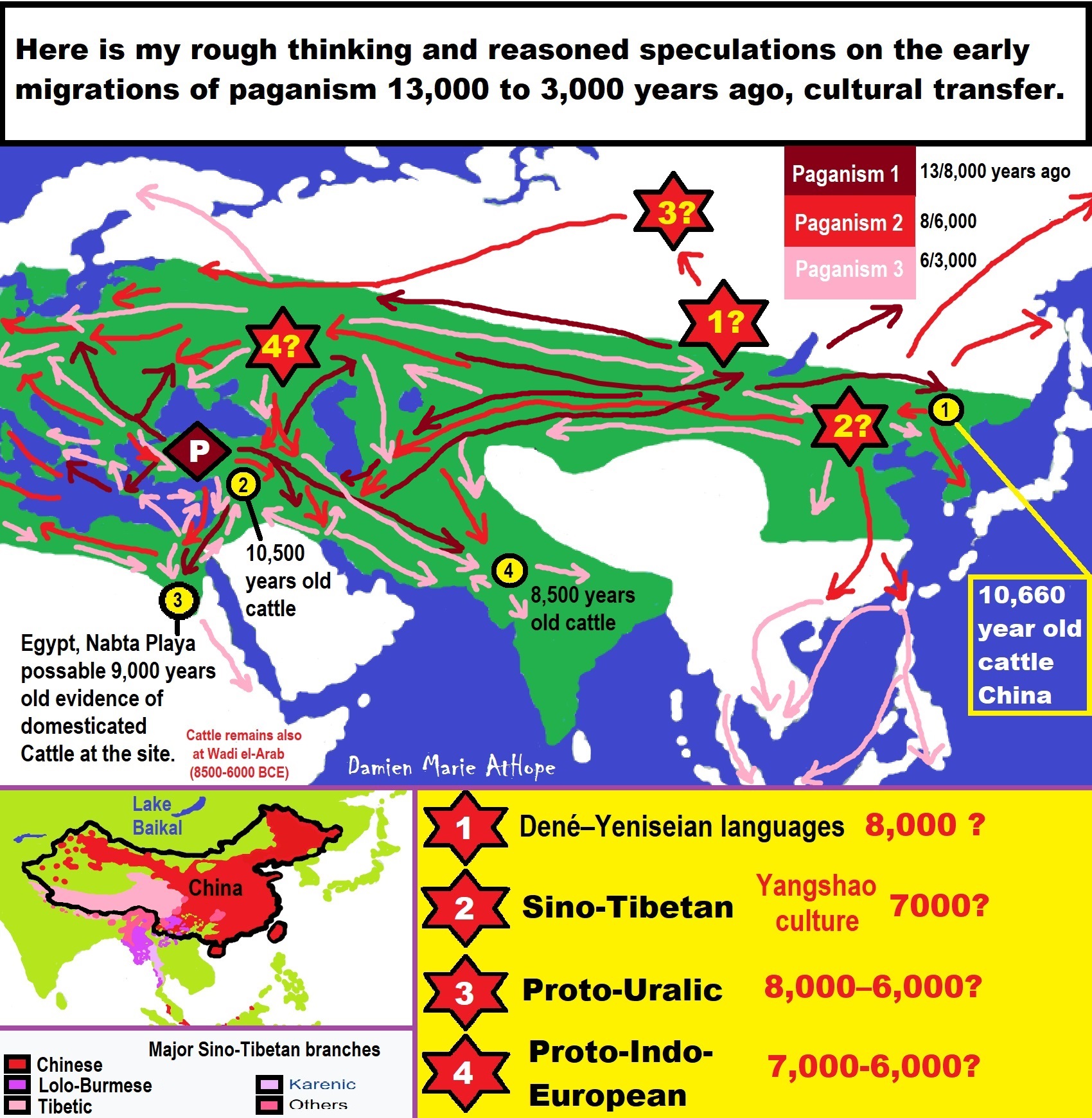
Paganism 12,000-4,000 years old
12,000-7,000 years old: related to (Pre-Capitalism)
7,000-5,000 years old: related to (Capitalism) (World War 0) Elite and their slaves!
5,000 years old: related to (Kings and the Rise of the State)
4,000 years old: related to (First Moralistic gods, then the Origin time of Monotheism)
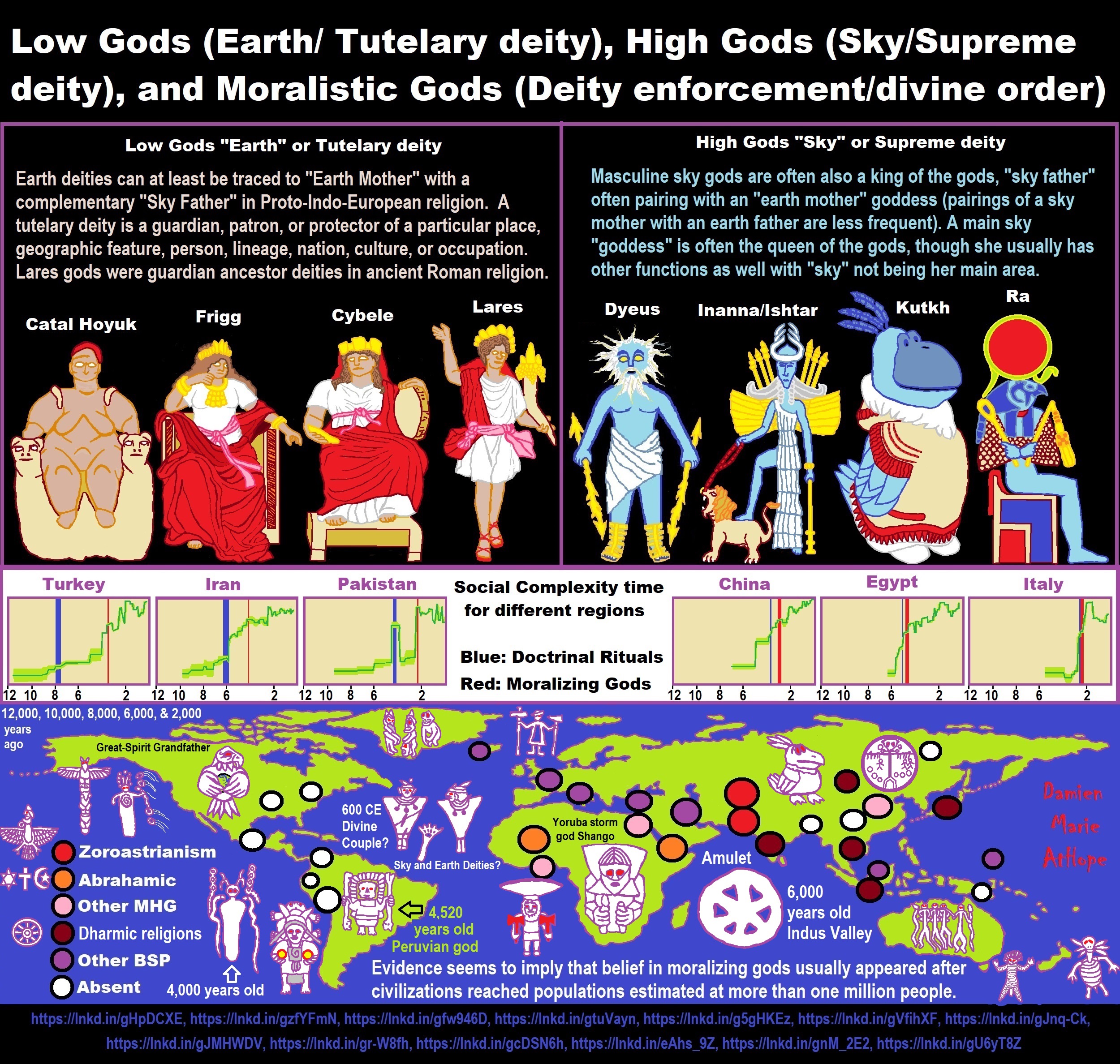
ref, ref, ref, ref, ref, ref, ref, ref, ref, ref, ref, ref, ref, ref, ref, ref, ref, ref, ref, ref, ref
Low Gods “Earth” or Tutelary deity and High Gods “Sky” or Supreme deity
“An Earth goddess is a deification of the Earth. Earth goddesses are often associated with the “chthonic” deities of the underworld. Ki and Ninhursag are Mesopotamian earth goddesses. In Greek mythology, the Earth is personified as Gaia, corresponding to Roman Terra, Indic Prithvi/Bhūmi, etc. traced to an “Earth Mother” complementary to the “Sky Father” in Proto-Indo-European religion. Egyptian mythology exceptionally has a sky goddess and an Earth god.” ref
“A mother goddess is a goddess who represents or is a personification of nature, motherhood, fertility, creation, destruction or who embodies the bounty of the Earth. When equated with the Earth or the natural world, such goddesses are sometimes referred to as Mother Earth or as the Earth Mother. In some religious traditions or movements, Heavenly Mother (also referred to as Mother in Heaven or Sky Mother) is the wife or feminine counterpart of the Sky father or God the Father.” ref
“Any masculine sky god is often also king of the gods, taking the position of patriarch within a pantheon. Such king gods are collectively categorized as “sky father” deities, with a polarity between sky and earth often being expressed by pairing a “sky father” god with an “earth mother” goddess (pairings of a sky mother with an earth father are less frequent). A main sky goddess is often the queen of the gods and may be an air/sky goddess in her own right, though she usually has other functions as well with “sky” not being her main. In antiquity, several sky goddesses in ancient Egypt, Mesopotamia, and the Near East were called Queen of Heaven. Neopagans often apply it with impunity to sky goddesses from other regions who were never associated with the term historically. The sky often has important religious significance. Many religions, both polytheistic and monotheistic, have deities associated with the sky.” ref
“In comparative mythology, sky father is a term for a recurring concept in polytheistic religions of a sky god who is addressed as a “father”, often the father of a pantheon and is often either a reigning or former King of the Gods. The concept of “sky father” may also be taken to include Sun gods with similar characteristics, such as Ra. The concept is complementary to an “earth mother“. “Sky Father” is a direct translation of the Vedic Dyaus Pita, etymologically descended from the same Proto-Indo-European deity name as the Greek Zeûs Pater and Roman Jupiter and Germanic Týr, Tir or Tiwaz, all of which are reflexes of the same Proto-Indo-European deity’s name, *Dyēus Ph₂tḗr. While there are numerous parallels adduced from outside of Indo-European mythology, there are exceptions (e.g. In Egyptian mythology, Nut is the sky mother and Geb is the earth father).” ref
Tutelary deity
“A tutelary (also tutelar) is a deity or spirit who is a guardian, patron, or protector of a particular place, geographic feature, person, lineage, nation, culture, or occupation. The etymology of “tutelary” expresses the concept of safety and thus of guardianship. In late Greek and Roman religion, one type of tutelary deity, the genius, functions as the personal deity or daimon of an individual from birth to death. Another form of personal tutelary spirit is the familiar spirit of European folklore.” ref
“A tutelary (also tutelar) in Korean shamanism, jangseung and sotdae were placed at the edge of villages to frighten off demons. They were also worshiped as deities. Seonangshin is the patron deity of the village in Korean tradition and was believed to embody the Seonangdang. In Philippine animism, Diwata or Lambana are deities or spirits that inhabit sacred places like mountains and mounds and serve as guardians. Such as: Maria Makiling is the deity who guards Mt. Makiling and Maria Cacao and Maria Sinukuan. In Shinto, the spirits, or kami, which give life to human bodies come from nature and return to it after death. Ancestors are therefore themselves tutelaries to be worshiped. And similarly, Native American beliefs such as Tonás, tutelary animal spirit among the Zapotec and Totems, familial or clan spirits among the Ojibwe, can be animals.” ref
“A tutelary (also tutelar) in Austronesian beliefs such as: Atua (gods and spirits of the Polynesian peoples such as the Māori or the Hawaiians), Hanitu (Bunun of Taiwan‘s term for spirit), Hyang (Kawi, Sundanese, Javanese, and Balinese Supreme Being, in ancient Java and Bali mythology and this spiritual entity, can be either divine or ancestral), Kaitiaki (New Zealand Māori term used for the concept of guardianship, for the sky, the sea, and the land), Kawas (mythology) (divided into 6 groups: gods, ancestors, souls of the living, spirits of living things, spirits of lifeless objects, and ghosts), Tiki (Māori mythology, Tiki is the first man created by either Tūmatauenga or Tāne and represents deified ancestors found in most Polynesian cultures). ” ref, ref, ref, ref, ref, ref, ref
Mesopotamian Tutelary Deities can be seen as ones related to City-States
“Historical city-states included Sumerian cities such as Uruk and Ur; Ancient Egyptian city-states, such as Thebes and Memphis; the Phoenician cities (such as Tyre and Sidon); the five Philistine city-states; the Berber city-states of the Garamantes; the city-states of ancient Greece (the poleis such as Athens, Sparta, Thebes, and Corinth); the Roman Republic (which grew from a city-state into a vast empire); the Italian city-states from the Middle Ages to the early modern period, such as Florence, Siena, Ferrara, Milan (which as they grew in power began to dominate neighboring cities) and Genoa and Venice, which became powerful thalassocracies; the Mayan and other cultures of pre-Columbian Mesoamerica (including cities such as Chichen Itza, Tikal, Copán and Monte Albán); the central Asian cities along the Silk Road; the city-states of the Swahili coast; Ragusa; states of the medieval Russian lands such as Novgorod and Pskov; and many others.” ref
“The Uruk period (ca. 4000 to 3100 BCE; also known as Protoliterate period) of Mesopotamia, named after the Sumerian city of Uruk, this period saw the emergence of urban life in Mesopotamia and the Sumerian civilization. City-States like Uruk and others had a patron tutelary City Deity along with a Priest-King.” ref
“Chinese folk religion, both past, and present, includes myriad tutelary deities. Exceptional individuals, highly cultivated sages, and prominent ancestors can be deified and honored after death. Lord Guan is the patron of military personnel and police, while Mazu is the patron of fishermen and sailors. Such as Tu Di Gong (Earth Deity) is the tutelary deity of a locality, and each individual locality has its own Earth Deity and Cheng Huang Gong (City God) is the guardian deity of an individual city, worshipped by local officials and locals since imperial times.” ref
“A tutelary (also tutelar) in Hinduism, personal tutelary deities are known as ishta-devata, while family tutelary deities are known as Kuladevata. Gramadevata are guardian deities of villages. Devas can also be seen as tutelary. Shiva is the patron of yogis and renunciants. City goddesses include: Mumbadevi (Mumbai), Sachchika (Osian); Kuladevis include: Ambika (Porwad), and Mahalakshmi. In NorthEast India Meitei mythology and religion (Sanamahism) of Manipur, there are various types of tutelary deities, among which Lam Lais are the most predominant ones. Tibetan Buddhism has Yidam as a tutelary deity. Dakini is the patron of those who seek knowledge.” ref
“A tutelary (also tutelar) The Greeks also thought deities guarded specific places: for instance, Athena was the patron goddess of the city of Athens. Socrates spoke of hearing the voice of his personal spirit or daimonion:
You have often heard me speak of an oracle or sign which comes to me … . This sign I have had ever since I was a child. The sign is a voice which comes to me and always forbids me to do something which I am going to do, but never commands me to do anything, and this is what stands in the way of my being a politician.” ref
“Tutelary deities who guard and preserve a place or a person are fundamental to ancient Roman religion. The tutelary deity of a man was his Genius, that of a woman her Juno. In the Imperial era, the Genius of the Emperor was a focus of Imperial cult. An emperor might also adopt a major deity as his personal patron or tutelary, as Augustus did Apollo. Precedents for claiming the personal protection of a deity were established in the Republican era, when for instance the Roman dictator Sulla advertised the goddess Victory as his tutelary by holding public games (ludi) in her honor.” ref
“Each town or city had one or more tutelary deities, whose protection was considered particularly vital in time of war and siege. Rome itself was protected by a goddess whose name was to be kept ritually secret on pain of death (for a supposed case, see Quintus Valerius Soranus). The Capitoline Triad of Juno, Jupiter, and Minerva were also tutelaries of Rome. The Italic towns had their own tutelary deities. Juno often had this function, as at the Latin town of Lanuvium and the Etruscan city of Veii, and was often housed in an especially grand temple on the arx (citadel) or other prominent or central location. The tutelary deity of Praeneste was Fortuna, whose oracle was renowned.” ref
“The Roman ritual of evocatio was premised on the belief that a town could be made vulnerable to military defeat if the power of its tutelary deity were diverted outside the city, perhaps by the offer of superior cult at Rome. The depiction of some goddesses such as the Magna Mater (Great Mother, or Cybele) as “tower-crowned” represents their capacity to preserve the city. A town in the provinces might adopt a deity from within the Roman religious sphere to serve as its guardian, or syncretize its own tutelary with such; for instance, a community within the civitas of the Remi in Gaul adopted Apollo as its tutelary, and at the capital of the Remi (present-day Rheims), the tutelary was Mars Camulus.” ref
Household deity (a kind of or related to a Tutelary deity)
“A household deity is a deity or spirit that protects the home, looking after the entire household or certain key members. It has been a common belief in paganism as well as in folklore across many parts of the world. Household deities fit into two types; firstly, a specific deity – typically a goddess – often referred to as a hearth goddess or domestic goddess who is associated with the home and hearth, such as the ancient Greek Hestia.” ref
“The second type of household deities are those that are not one singular deity, but a type, or species of animistic deity, who usually have lesser powers than major deities. This type was common in the religions of antiquity, such as the Lares of ancient Roman religion, the Gashin of Korean shamanism, and Cofgodas of Anglo-Saxon paganism. These survived Christianisation as fairy-like creatures existing in folklore, such as the Anglo-Scottish Brownie and Slavic Domovoy.” ref
“Household deities were usually worshipped not in temples but in the home, where they would be represented by small idols (such as the teraphim of the Bible, often translated as “household gods” in Genesis 31:19 for example), amulets, paintings, or reliefs. They could also be found on domestic objects, such as cosmetic articles in the case of Tawaret. The more prosperous houses might have a small shrine to the household god(s); the lararium served this purpose in the case of the Romans. The gods would be treated as members of the family and invited to join in meals, or be given offerings of food and drink.” ref
“In many religions, both ancient and modern, a god would preside over the home. Certain species, or types, of household deities, existed. An example of this was the Roman Lares. Many European cultures retained house spirits into the modern period. Some examples of these include:
- Brownie (Scotland and England) or Hob (England) / Kobold (Germany) / Goblin / Hobgoblin
- Domovoy (Slavic)
- Nisse (Norwegian or Danish) / Tomte (Swedish) / Tonttu (Finnish)
- Húsvættir (Norse)” ref
“Although the cosmic status of household deities was not as lofty as that of the Twelve Olympians or the Aesir, they were also jealous of their dignity and also had to be appeased with shrines and offerings, however humble. Because of their immediacy they had arguably more influence on the day-to-day affairs of men than the remote gods did. Vestiges of their worship persisted long after Christianity and other major religions extirpated nearly every trace of the major pagan pantheons. Elements of the practice can be seen even today, with Christian accretions, where statues to various saints (such as St. Francis) protect gardens and grottos. Even the gargoyles found on older churches, could be viewed as guardians partitioning a sacred space.” ref
“For centuries, Christianity fought a mop-up war against these lingering minor pagan deities, but they proved tenacious. For example, Martin Luther‘s Tischreden have numerous – quite serious – references to dealing with kobolds. Eventually, rationalism and the Industrial Revolution threatened to erase most of these minor deities, until the advent of romantic nationalism rehabilitated them and embellished them into objects of literary curiosity in the 19th century. Since the 20th century this literature has been mined for characters for role-playing games, video games, and other fantasy personae, not infrequently invested with invented traits and hierarchies somewhat different from their mythological and folkloric roots.” ref
“In contradistinction to both Herbert Spencer and Edward Burnett Tylor, who defended theories of animistic origins of ancestor worship, Émile Durkheim saw its origin in totemism. In reality, this distinction is somewhat academic, since totemism may be regarded as a particularized manifestation of animism, and something of a synthesis of the two positions was attempted by Sigmund Freud. In Freud’s Totem and Taboo, both totem and taboo are outward expressions or manifestations of the same psychological tendency, a concept which is complementary to, or which rather reconciles, the apparent conflict. Freud preferred to emphasize the psychoanalytic implications of the reification of metaphysical forces, but with particular emphasis on its familial nature. This emphasis underscores, rather than weakens, the ancestral component.” ref
“William Edward Hearn, a noted classicist, and jurist, traced the origin of domestic deities from the earliest stages as an expression of animism, a belief system thought to have existed also in the neolithic, and the forerunner of Indo-European religion. In his analysis of the Indo-European household, in Chapter II “The House Spirit”, Section 1, he states:
The belief which guided the conduct of our forefathers was … the spirit rule of dead ancestors.” ref
“In Section 2 he proceeds to elaborate:
It is thus certain that the worship of deceased ancestors is a vera causa, and not a mere hypothesis. …
In the other European nations, the Slavs, the Teutons, and the Kelts, the House Spirit appears with no less distinctness. … [T]he existence of that worship does not admit of doubt. … The House Spirits had a multitude of other names which it is needless here to enumerate, but all of which are more or less expressive of their friendly relations with man. … In [England] … [h]e is the Brownie. … In Scotland this same Brownie is well known. He is usually described as attached to particular families, with whom he has been known to reside for centuries, threshing the corn, cleaning the house, and performing similar household tasks. His favorite gratification was milk and honey.” ref
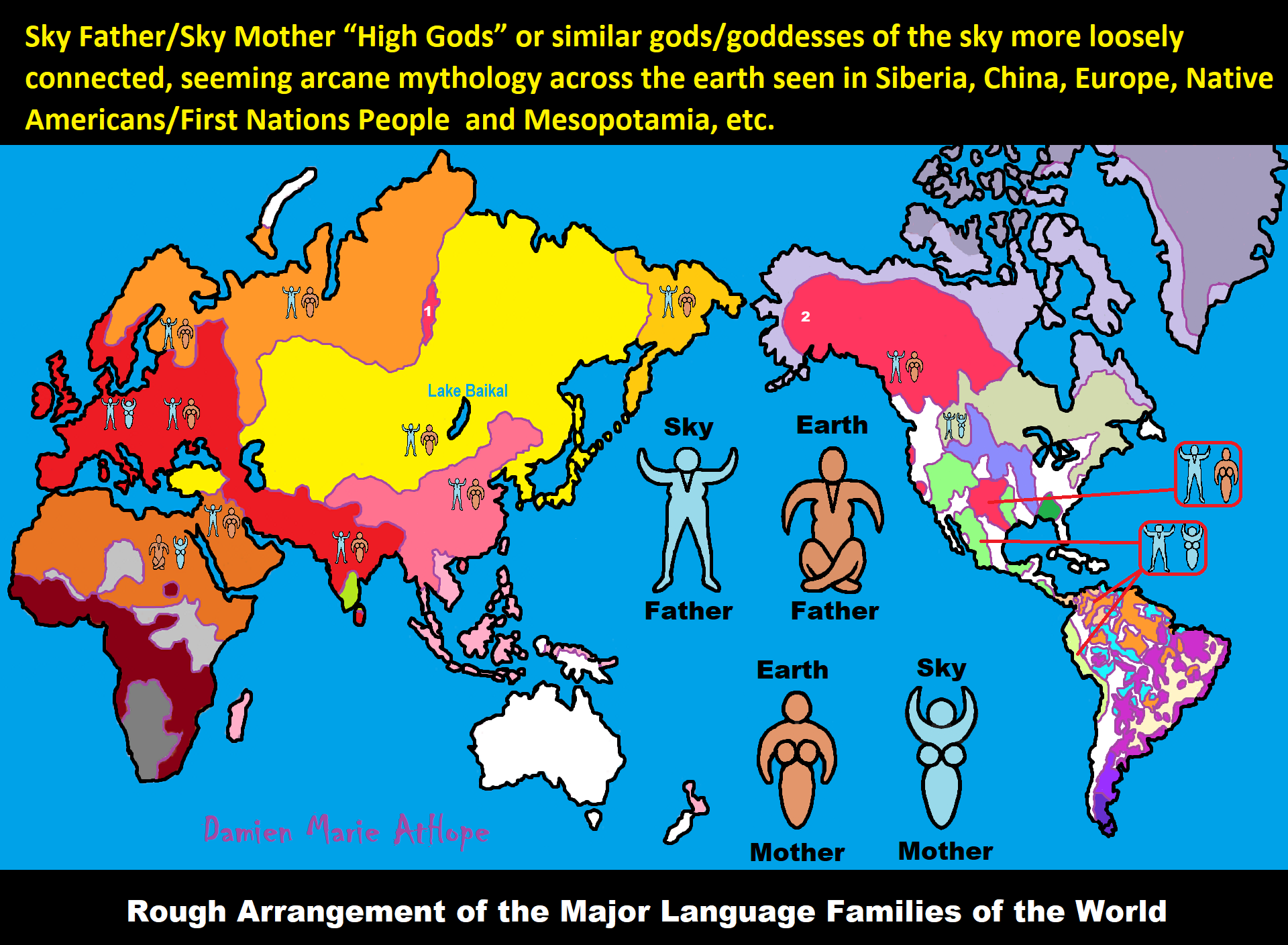
ref, ref, ref, ref, ref, ref, ref, ref, ref, ref, ref, ref, ref, ref, ref, ref, ref
“These ideas are my speculations from the evidence.”
I am still researching the “god‘s origins” all over the world. So you know, it is very complicated but I am smart and willing to look, DEEP, if necessary, which going very deep does seem to be needed here, when trying to actually understand the evolution of gods and goddesses. I am sure of a few things and less sure of others, but even in stuff I am not fully grasping I still am slowly figuring it out, to explain it to others. But as I research more I am understanding things a little better, though I am still working on understanding it all or something close and thus always figuring out more.
Sky Father/Sky God?
“Egyptian: (Nut) Sky Mother and (Geb) Earth Father” (Egypt is different but similar)
Turkic/Mongolic: (Tengri/Tenger Etseg) Sky Father and (Eje/Gazar Eej) Earth Mother *Transeurasian*
Hawaiian: (Wākea) Sky Father and (Papahānaumoku) Earth Mother *Austronesian*
New Zealand/ Māori: (Ranginui) Sky Father and (Papatūānuku) Earth Mother *Austronesian*
Proto-Indo-European: (Dyḗus/Dyḗus ph₂tḗr) Sky Father and (Dʰéǵʰōm/Pleth₂wih₁) Earth Mother
Indo-Aryan: (Dyaus Pita) Sky Father and (Prithvi Mata) Earth Mother *Indo-European*
Italic: (Jupiter) Sky Father and (Juno) Sky Mother *Indo-European*
Etruscan: (Tinia) Sky Father and (Uni) Sky Mother *Tyrsenian/Italy Pre–Indo-European*
Hellenic/Greek: (Zeus) Sky Father and (Hera) Sky Mother who started as an “Earth Goddess” *Indo-European*
Nordic: (Dagr) Sky Father and (Nótt) Sky Mother *Indo-European*
Slavic: (Perun) Sky Father and (Mokosh) Earth Mother *Indo-European*
Illyrian: (Deipaturos) Sky Father and (Messapic Damatura’s “earth-mother” maybe) Earth Mother *Indo-European*
Albanian: (Zojz) Sky Father and (?) *Indo-European*
Baltic: (Perkūnas) Sky Father and (Saulė) Sky Mother *Indo-European*
Germanic: (Týr) Sky Father and (?) *Indo-European*
Colombian-Muisca: (Bochica) Sky Father and (Huythaca) Sky Mother *Chibchan*
Aztec: (Quetzalcoatl) Sky Father and (Xochiquetzal) Sky Mother *Uto-Aztecan*
Incan: (Viracocha) Sky Father and (Mama Runtucaya) Sky Mother *Quechuan*
China: (Tian/Shangdi) Sky Father and (Dì) Earth Mother *Sino-Tibetan*
Sumerian, Assyrian and Babylonian: (An/Anu) Sky Father and (Ki) Earth Mother
Finnish: (Ukko) Sky Father and (Akka) Earth Mother *Finno-Ugric*
Sami: (Horagalles) Sky Father and (Ravdna) Earth Mother *Finno-Ugric*
Puebloan-Zuni: (Ápoyan Ta’chu) Sky Father and (Áwitelin Tsíta) Earth Mother
Puebloan-Hopi: (Tawa) Sky Father and (Kokyangwuti/Spider Woman/Grandmother) Earth Mother *Uto-Aztecan*
Puebloan-Navajo: (Tsohanoai) Sky Father and (Estsanatlehi) Earth Mother *Na-Dene*
ref, ref, ref, ref, ref, ref, ref, ref, ref, ref, ref, ref, ref, ref, ref, ref, ref, ref, ref, ref, ref, ref, ref, ref, ref, ref, ref
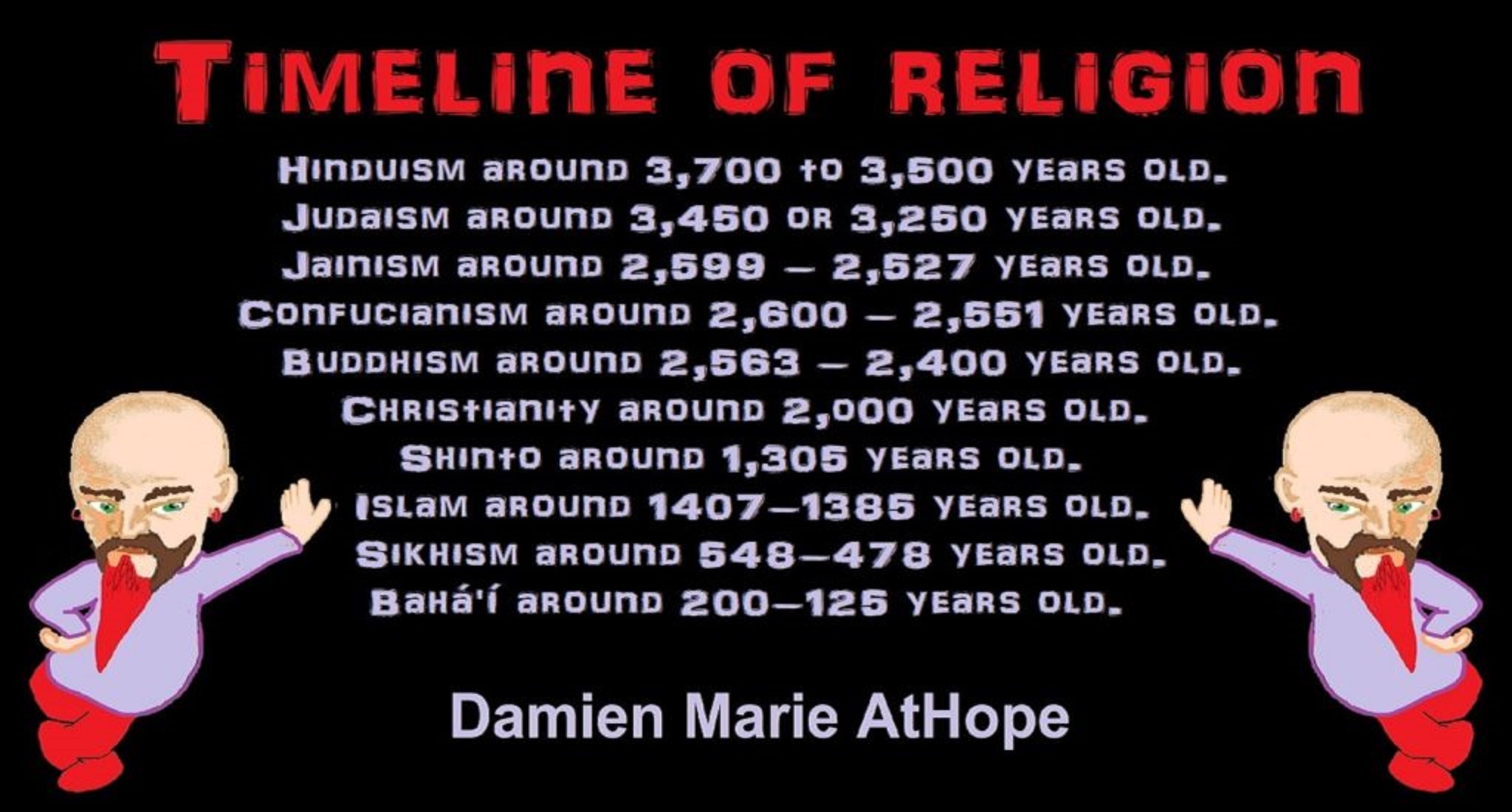
Hinduism around 3,700 to 3,500 years old. ref
Judaism around 3,450 or 3,250 years old. (The first writing in the bible was “Paleo-Hebrew” dated to around 3,000 years ago Khirbet Qeiyafa is the site of an ancient fortress city overlooking the Elah Valley. And many believe the religious Jewish texts were completed around 2,500) ref, ref
Judaism is around 3,450 or 3,250 years old. (“Paleo-Hebrew” 3,000 years ago and Torah 2,500 years ago)
“Judaism is an Abrahamic, its roots as an organized religion in the Middle East during the Bronze Age. Some scholars argue that modern Judaism evolved from Yahwism, the religion of ancient Israel and Judah, by the late 6th century BCE, and is thus considered to be one of the oldest monotheistic religions.” ref
“Yahwism is the name given by modern scholars to the religion of ancient Israel, essentially polytheistic, with a plethora of gods and goddesses. Heading the pantheon was Yahweh, the national god of the Israelite kingdoms of Israel and Judah, with his consort, the goddess Asherah; below them were second-tier gods and goddesses such as Baal, Shamash, Yarikh, Mot, and Astarte, all of whom had their own priests and prophets and numbered royalty among their devotees, and a third and fourth tier of minor divine beings, including the mal’ak, the messengers of the higher gods, who in later times became the angels of Judaism, Christianity and Islam. Yahweh, however, was not the ‘original’ god of Israel “Isra-El”; it is El, the head of the Canaanite pantheon, whose name forms the basis of the name “Israel”, and none of the Old Testament patriarchs, the tribes of Israel, the Judges, or the earliest monarchs, have a Yahwistic theophoric name (i.e., one incorporating the name of Yahweh).” ref
“El is a Northwest Semitic word meaning “god” or “deity“, or referring (as a proper name) to any one of multiple major ancient Near Eastern deities. A rarer form, ‘ila, represents the predicate form in Old Akkadian and in Amorite. The word is derived from the Proto-Semitic *ʔil-, meaning “god”. Specific deities known as ‘El or ‘Il include the supreme god of the ancient Canaanite religion and the supreme god of East Semitic speakers in Mesopotamia’s Early Dynastic Period. ʼĒl is listed at the head of many pantheons. In some Canaanite and Ugaritic sources, ʼĒl played a role as father of the gods, of creation, or both. For example, in the Ugaritic texts, ʾil mlk is understood to mean “ʼĒl the King” but ʾil hd as “the god Hadad“. The Semitic root ʾlh (Arabic ʾilāh, Aramaic ʾAlāh, ʾElāh, Hebrew ʾelōah) may be ʾl with a parasitic h, and ʾl may be an abbreviated form of ʾlh. In Ugaritic the plural form meaning “gods” is ʾilhm, equivalent to Hebrew ʾelōhîm “powers”. In the Hebrew texts this word is interpreted as being semantically singular for “god” by biblical commentators. However the documentary hypothesis for the Old Testament (corresponds to the Jewish Torah) developed originally in the 1870s, identifies these that different authors – the Jahwist, Elohist, Deuteronomist, and the Priestly source – were responsible for editing stories from a polytheistic religion into those of a monotheistic religion. Inconsistencies that arise between monotheism and polytheism in the texts are reflective of this hypothesis.” ref
Jainism around 2,599 – 2,527 years old. ref
Confucianism around 2,600 – 2,551 years old. ref
Buddhism around 2,563/2,480 – 2,483/2,400 years old. ref
Christianity around 2,o00 years old. ref
Shinto around 1,305 years old. ref
Islam around 1407–1385 years old. ref
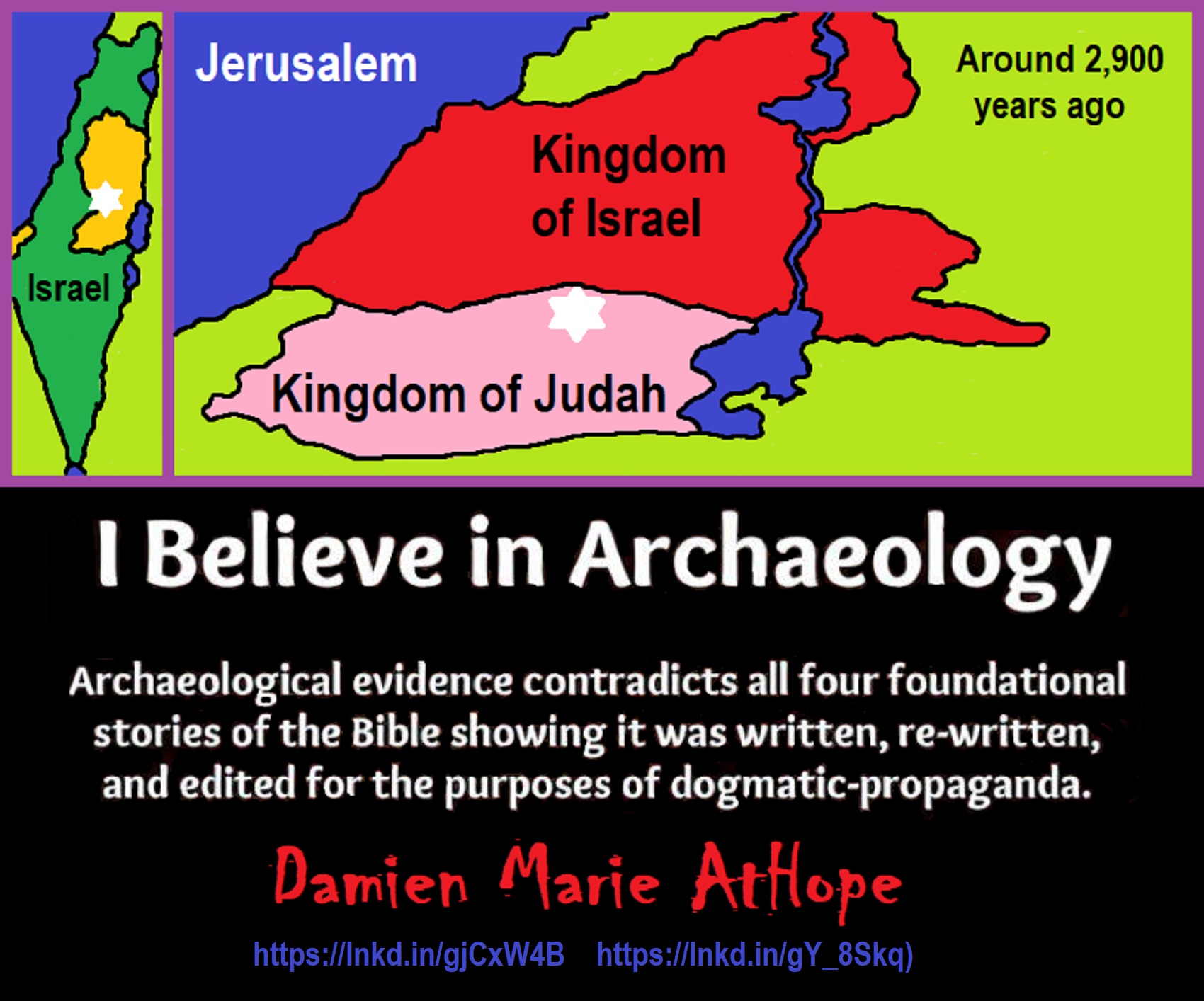
Knowledge to Ponder:
Stars/Astrology:
- Possibly, around 30,000 years ago (in simpler form) to 6,000 years ago, Stars/Astrology are connected to Ancestors, Spirit Animals, and Deities.
- The star also seems to be a possible proto-star for Star of Ishtar, Star of Inanna, or Star of Venus.
- Around 7,000 to 6,000 years ago, Star Constellations/Astrology have connections to the “Kurgan phenomenon” of below-ground “mound” stone/wood burial structures and “Dolmen phenomenon” of above-ground stone burial structures.
- Around 6,500–5,800 years ago, The Northern Levant migrations into Jordon and Israel in the Southern Levant brought new cultural and religious transfer from Turkey and Iran.
- “The Ghassulian Star,” a mysterious 6,000-year-old mural from Jordan may have connections to the European paganstic kurgan/dolmens phenomenon.
“Astrology is a range of divinatory practices, recognized as pseudoscientific since the 18th century, that claim to discern information about human affairs and terrestrial events by studying the apparent positions of celestial objects. Different cultures have employed forms of astrology since at least the 2nd millennium BCE, these practices having originated in calendrical systems used to predict seasonal shifts and to interpret celestial cycles as signs of divine communications. Most, if not all, cultures have attached importance to what they observed in the sky, and some—such as the Hindus, Chinese, and the Maya—developed elaborate systems for predicting terrestrial events from celestial observations. Western astrology, one of the oldest astrological systems still in use, can trace its roots to 19th–17th century BCE Mesopotamia, from where it spread to Ancient Greece, Rome, the Islamicate world and eventually Central and Western Europe. Contemporary Western astrology is often associated with systems of horoscopes that purport to explain aspects of a person’s personality and predict significant events in their lives based on the positions of celestial objects; the majority of professional astrologers rely on such systems.” ref
Around 5,500 years ago, Science evolves, The first evidence of science was 5,500 years ago and was demonstrated by a body of empirical, theoretical, and practical knowledge about the natural world. ref
Around 5,000 years ago, Origin of Logics is a Naturalistic Observation (principles of valid reasoning, inference, & demonstration) ref
Around 4,150 to 4,000 years ago: The earliest surviving versions of the Sumerian Epic of Gilgamesh, which was originally titled “He who Saw the Deep” (Sha naqba īmuru) or “Surpassing All Other Kings” (Shūtur eli sharrī) were written. ref
Hinduism:
- 3,700 years ago or so, the oldest of the Hindu Vedas (scriptures), the Rig Veda was composed.
- 3,500 years ago or so, the Vedic Age began in India after the collapse of the Indus Valley Civilization.
Judaism:
- around 3,000 years ago, the first writing in the bible was “Paleo-Hebrew”
- around 2,500 years ago, many believe the religious Jewish texts were completed
Myths: The bible inspired religion is not just one religion or one myth but a grouping of several religions and myths
- Around 3,450 or 3,250 years ago, according to legend, is the traditionally accepted period in which the Israelite lawgiver, Moses, provided the Ten Commandments.
- Around 2,500 to 2,400 years ago, a collection of ancient religious writings by the Israelites based primarily upon the Hebrew Bible, Tanakh, or Old Testament is the first part of Christianity’s bible.
- Around 2,400 years ago, the most accepted hypothesis is that the canon was formed in stages, first the Pentateuch (Torah).
- Around 2,140 to 2,116 years ago, the Prophets was written during the Hasmonean dynasty, and finally the remaining books.
- Christians traditionally divide the Old Testament into four sections:
- The first five books or Pentateuch (Torah).
- The proposed history books telling the history of the Israelites from their conquest of Canaan to their defeat and exile in Babylon.
- The poetic and proposed “Wisdom books” dealing, in various forms, with questions of good and evil in the world.
- The books of the biblical prophets, warning of the consequences of turning away from God:
- Henotheism:
- Exodus 20:23 “You shall not make other gods besides Me (not saying there are no other gods just not to worship them); gods of silver or gods of gold, you shall not make for yourselves.”
- Polytheism:
- Judges 10:6 “Then the sons of Israel again did evil in the sight of the LORD, served the Baals and the Ashtaroth, the gods of Aram, the gods of Sidon, the gods of Moab, the gods of the sons of Ammon, and the gods of the Philistines; thus they forsook the LORD and did not serve Him.”
- 1 Corinthians 8:5 “For even if there are so-called gods whether in heaven or on earth, as indeed there are many gods and many lords.”
- Monotheism:
- Isaiah 43:10 “You are my witnesses,” declares the LORD, “and my servant whom I have chosen, so that you may know and believe me and understand that I am he. Before me no god was formed, nor will there be one after me.
Around 2,570 to 2,270 Years Ago, there is a confirmation of atheistic doubting as well as atheistic thinking, mainly by Greek philosophers. However, doubting gods is likely as old as the invention of gods and should destroy the thinking that belief in god(s) is the “default belief”. The Greek word is apistos (a “not” and pistos “faithful,”), thus not faithful or faithless because one is unpersuaded and unconvinced by a god(s) claim. Short Definition: unbelieving, unbeliever, or unbelief.
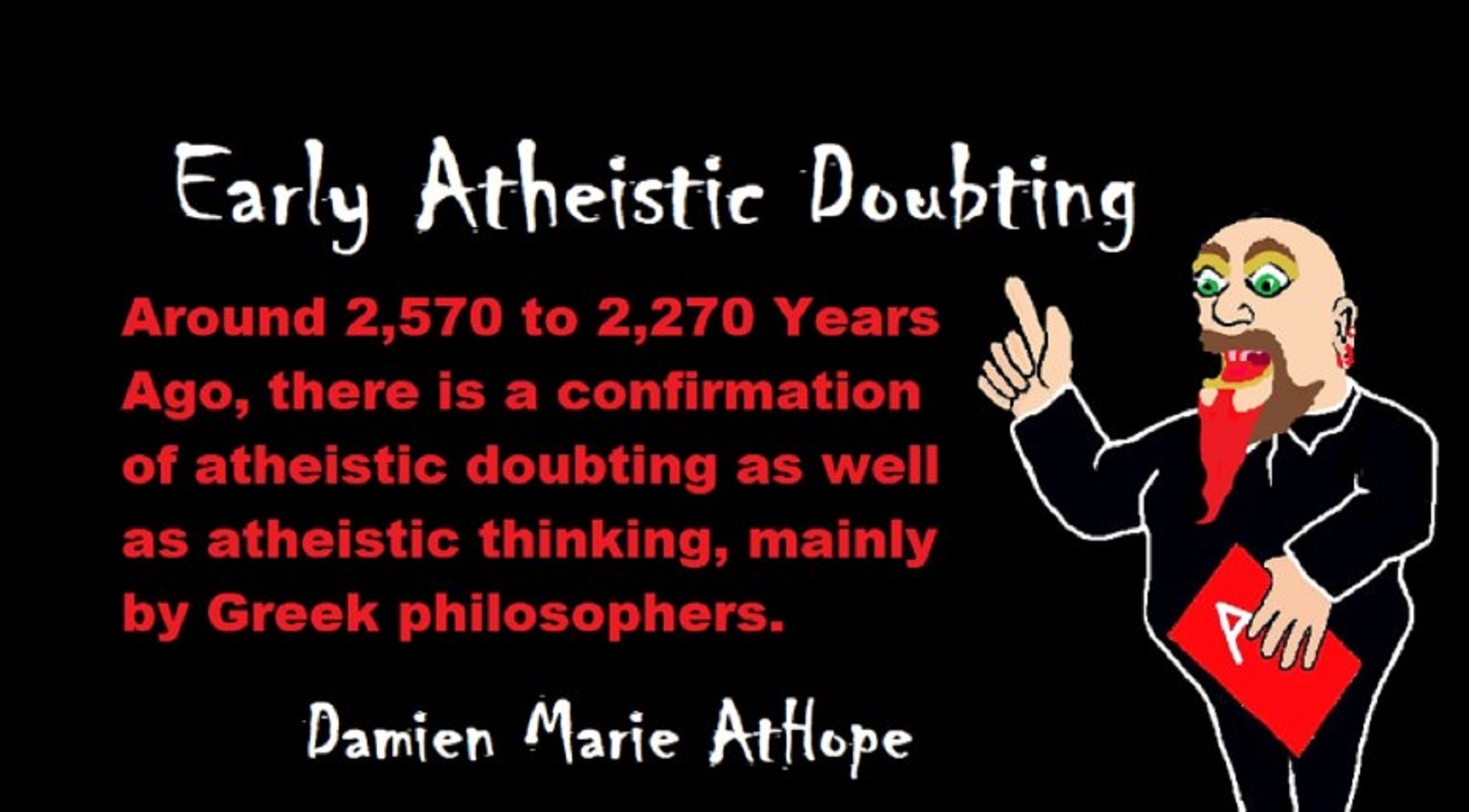
Expressions of Atheistic Thinking:
- Around 2,600 years ago, Ajita Kesakambali, ancient Indian philosopher, who is the first known proponent of Indian materialism. ref
- Around 2,535 to 2,475 years ago, Heraclitus, Greek pre-Socratic philosopher, a native of the Greek city Ephesus, Ionia, on the coast of Anatolia, also known as Asia Minor or modern Turkey. ref
- Around 2,500 to 2,400 years ago, according to The Story of Civilization book series certain African pygmy tribes have no identifiable gods, spirits, or religious beliefs or rituals, and even what burials accrue are without ceremony. ref
- Around 2,490 to 2,430 years ago, Empedocles, Greek pre-Socratic philosopher and a citizen of Agrigentum, a Greek city in Sicily. ref
- Around 2,460 to 2,370 years ago, Democritus, Greek pre-Socratic philosopher considered to be the “father of modern science” possibly had some disbelief amounting to atheism. ref
- Around 2,399 years ago or so, Socrates, a famous Greek philosopher was tried for sinfulness by teaching doubt of state gods. ref
- Around 2,341 to 2,270 years ago, Epicurus, a Greek philosopher known for composing atheistic critics and famously stated, “Is God willing to prevent evil, but not able? Then he is not omnipotent. Is he able, but not willing? Then he is malevolent. Is he both able and willing? Then whence cometh evil? Is he neither able nor willing? Then why call him god?” ref
This last expression by Epicurus, seems to be an expression of Axiological Atheism. To understand and utilize value or actually possess “Value Conscious/Consciousness” to both give a strong moral “axiological” argument (the problem of evil) as well as use it to fortify humanism and positive ethical persuasion of human helping and care responsibilities. Because value-blindness gives rise to sociopathic/psychopathic evil.
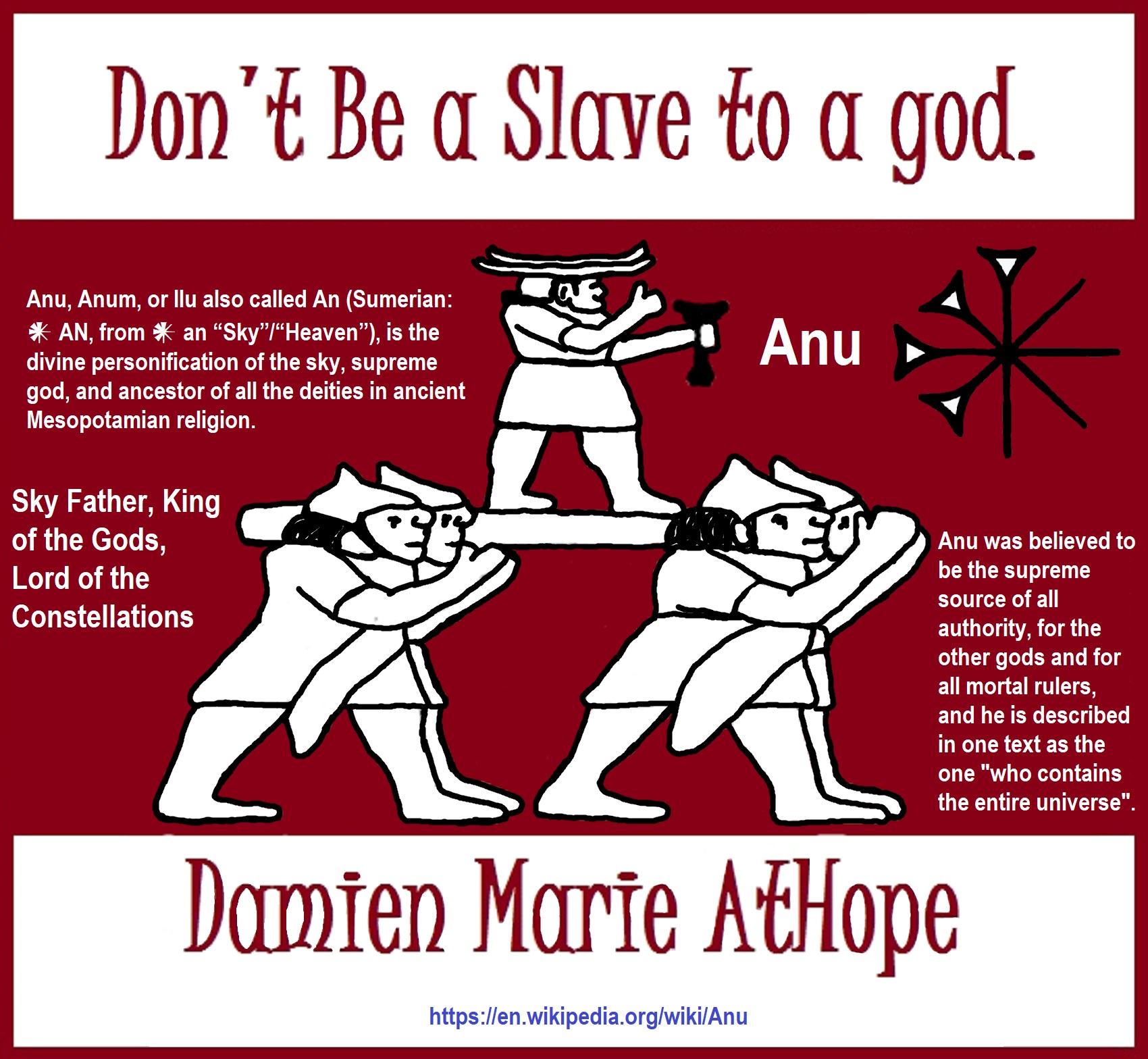
“Theists, there has to be a god, as something can not come from nothing.”
Well, thus something (unknown) happened and then there was something. This does not tell us what the something that may have been involved with something coming from nothing. A supposed first cause, thus something (unknown) happened and then there was something is not an open invitation to claim it as known, neither is it justified to call or label such an unknown as anything, especially an unsubstantiated magical thinking belief born of mythology and religious storytelling.
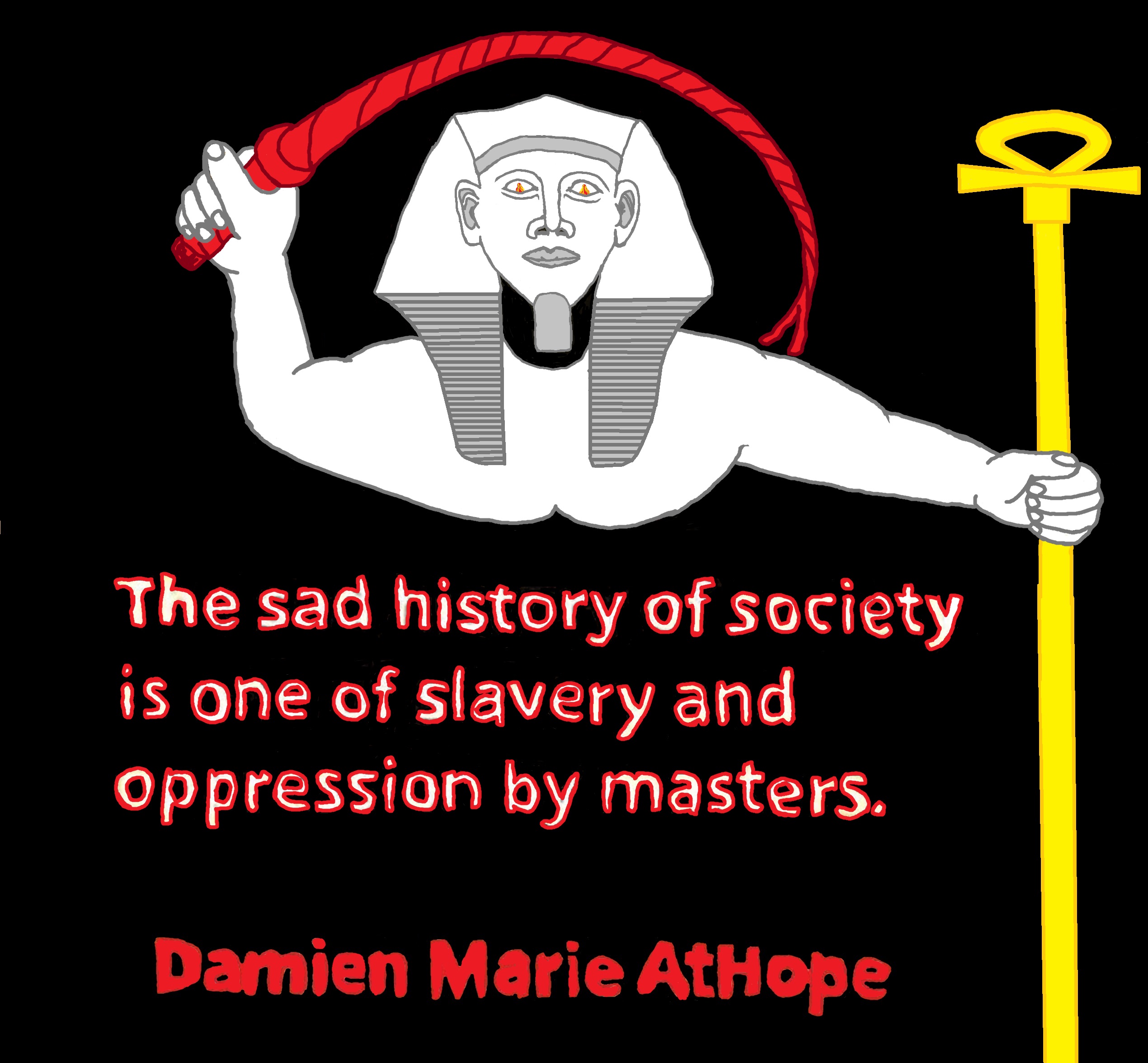
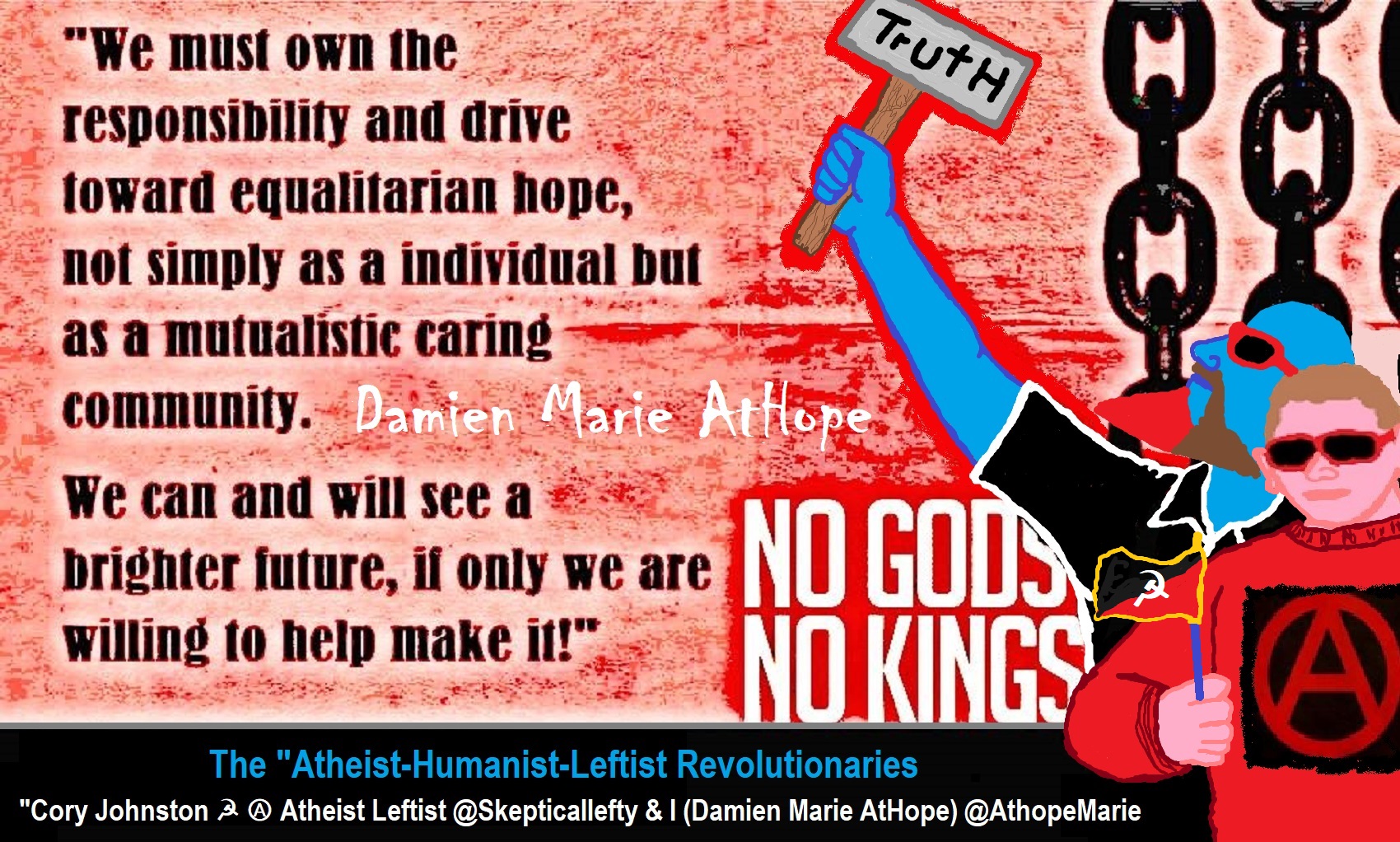
While hallucinogens are associated with shamanism, it is alcohol that is associated with paganism.
The Atheist-Humanist-Leftist Revolutionaries Shows in the prehistory series:
Show two: Pre-animism 300,000 years old and animism 100,000 years old: related to “Anarchism and Socialism”
Show tree: Totemism 50,000 years old: related to “Anarchism and Socialism”
Show four: Shamanism 30,000 years old: related to “Anarchism and Socialism”
Show five: Paganism 12,000 years old: related to “Anarchism and Socialism”
Show six: Emergence of hierarchy, sexism, slavery, and the new male god dominance: Paganism 7,000-5,000 years old: related to “Anarchism and Socialism” (Capitalism) (World War 0) Elite and their slaves!
Prehistory: related to “Anarchism and Socialism” the division of labor, power, rights, and recourses: VIDEO
Pre-animism 300,000 years old and animism 100,000 years old: related to “Anarchism and Socialism”: VIDEO
Totemism 50,000 years old: related to “Anarchism and Socialism”: VIDEO
Shamanism 30,000 years old: related to “Anarchism and Socialism”: VIDEO
Paganism 12,000 years old: related to “Anarchism and Socialism” (Pre-Capitalism): VIDEO
Paganism 7,000-5,000 years old: related to “Anarchism and Socialism” (Capitalism) (World War 0) Elite and their slaves: VIEDO
Paganism 5,000 years old: progressed organized religion and the state: related to “Anarchism and Socialism” (Kings and the Rise of the State): VIEDO
Paganism 4,000 years old: related to “Anarchism and Socialism” (First Moralistic gods, then the Origin time of Monotheism): VIEDO
I do not hate simply because I challenge and expose myths or lies any more than others being thought of as loving simply because of the protection and hiding from challenge their favored myths or lies.
The truth is best championed in the sunlight of challenge.
An archaeologist once said to me “Damien religion and culture are very different”
My response, So are you saying that was always that way, such as would you say Native Americans’ cultures are separate from their religions? And do you think it always was the way you believe?
I had said that religion was a cultural product. That is still how I see it and there are other archaeologists that think close to me as well. Gods too are the myths of cultures that did not understand science or the world around them, seeing magic/supernatural everywhere.
I personally think there is a goddess and not enough evidence to support a male god at Çatalhöyük but if there was both a male and female god and goddess then I know the kind of gods they were like Proto-Indo-European mythology.
This series idea was addressed in, Anarchist Teaching as Free Public Education or Free Education in the Public: VIDEO
Our 12 video series: Organized Oppression: Mesopotamian State Force and the Politics of power (9,000-4,000 years ago), is adapted from: The Complete and Concise History of the Sumerians and Early Bronze Age Mesopotamia (7000-2000 BC): https://www.youtube.com/watch?v=szFjxmY7jQA by “History with Cy“
Show #1: Mesopotamian State Force and the Politics of Power (Samarra, Halaf, Ubaid)
Show #2: Mesopotamian State Force and the Politics of Power
Show #3: Mesopotamian State Force and the Politics of Power (Uruk and the First Cities)
Show #4: Mesopotamian State Force and the Politics of Power (First Kings)
Show #5: Mesopotamian State Force and the Politics of Power (Early Dynastic Period)
Show #6: Mesopotamian State Force and the Politics of Power
Show #7: Mesopotamian State Force and the Politics of Power (Sargon and Akkadian Rule)
Show #9: Mesopotamian State Force and the Politics of Power (Gudea of Lagash and Utu-hegal)
Show #12: Mesopotamian State Force and the Politics of Power (Aftermath and Legacy of Sumer)
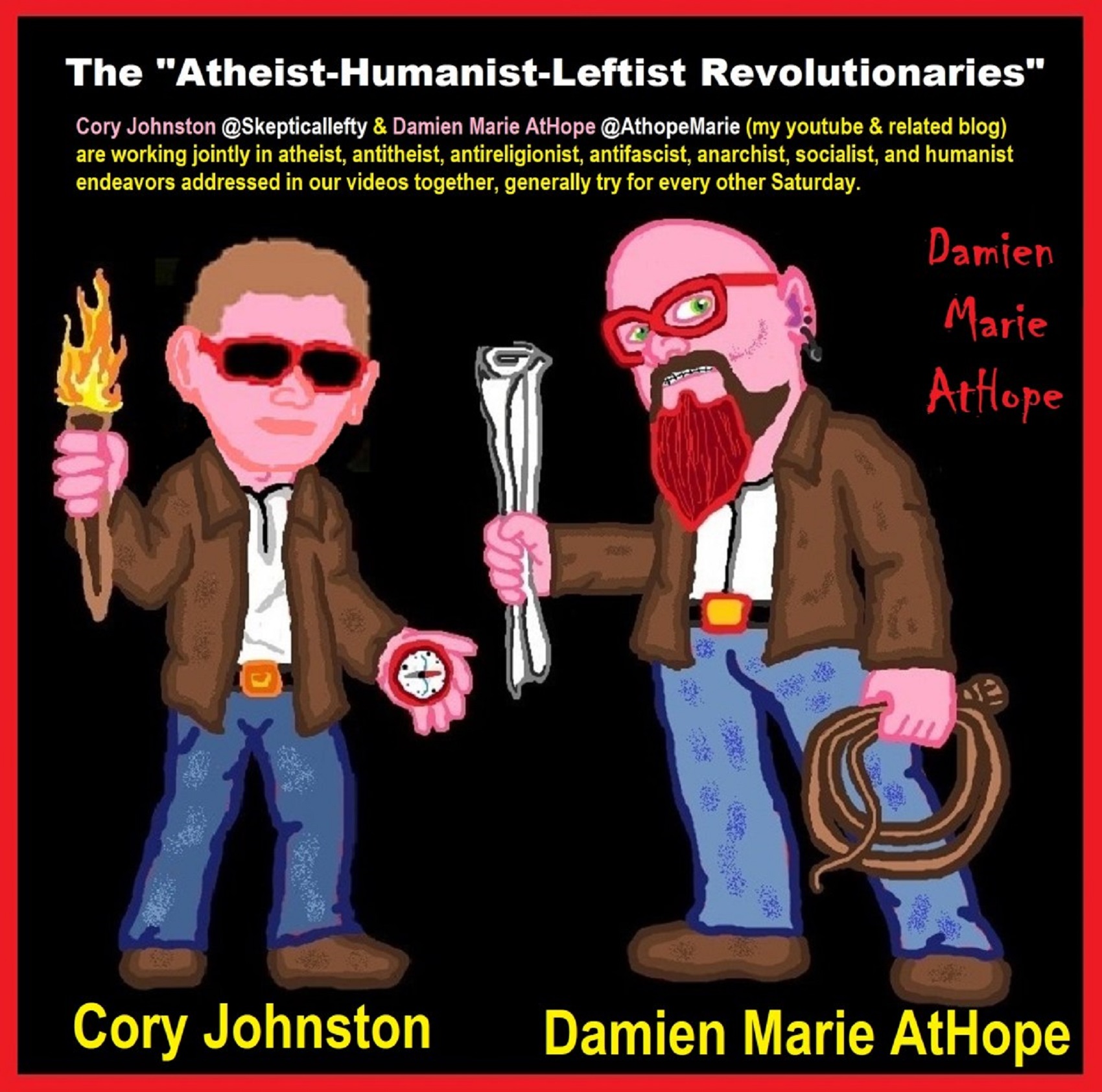
The “Atheist-Humanist-Leftist Revolutionaries”
Cory Johnston ☭ Ⓐ Atheist Leftist @Skepticallefty & I (Damien Marie AtHope) @AthopeMarie (my YouTube & related blog) are working jointly in atheist, antitheist, antireligionist, antifascist, anarchist, socialist, and humanist endeavors in our videos together, generally, every other Saturday.
Why Does Power Bring Responsibility?
Think, how often is it the powerless that start wars, oppress others, or commit genocide? So, I guess the question is to us all, to ask, how can power not carry responsibility in a humanity concept? I know I see the deep ethical responsibility that if there is power their must be a humanistic responsibility of ethical and empathic stewardship of that power. Will I be brave enough to be kind? Will I possess enough courage to be compassionate? Will my valor reach its height of empathy? I as everyone, earns our justified respect by our actions, that are good, ethical, just, protecting, and kind. Do I have enough self-respect to put my love for humanity’s flushing, over being brought down by some of its bad actors? May we all be the ones doing good actions in the world, to help human flourishing.
I create the world I want to live in, striving for flourishing. Which is not a place but a positive potential involvement and promotion; a life of humanist goal precision. To master oneself, also means mastering positive prosocial behaviors needed for human flourishing. I may have lost a god myth as an atheist, but I am happy to tell you, my friend, it is exactly because of that, leaving the mental terrorizer, god belief, that I truly regained my connected ethical as well as kind humanity.
Cory and I will talk about prehistory and theism, addressing the relevance to atheism, anarchism, and socialism.
At the same time as the rise of the male god, 7,000 years ago, there was also the very time there was the rise of violence, war, and clans to kingdoms, then empires, then states. It is all connected back to 7,000 years ago, and it moved across the world.
Cory Johnston: https://damienmarieathope.com/2021/04/cory-johnston-mind-of-a-skeptical-leftist/?v=32aec8db952d
The Mind of a Skeptical Leftist (YouTube)
Cory Johnston: Mind of a Skeptical Leftist @Skepticallefty
The Mind of a Skeptical Leftist By Cory Johnston: “Promoting critical thinking, social justice, and left-wing politics by covering current events and talking to a variety of people. Cory Johnston has been thoughtfully talking to people and attempting to promote critical thinking, social justice, and left-wing politics.” http://anchor.fm/skepticalleft
Cory needs our support. We rise by helping each other.
Cory Johnston ☭ Ⓐ @Skepticallefty Evidence-based atheist leftist (he/him) Producer, host, and co-host of 4 podcasts @skeptarchy @skpoliticspod and @AthopeMarie
Damien Marie AtHope (“At Hope”) Axiological Atheist, Anti-theist, Anti-religionist, Secular Humanist. Rationalist, Writer, Artist, Poet, Philosopher, Advocate, Activist, Psychology, and Armchair Archaeology/Anthropology/Historian.
Damien is interested in: Freedom, Liberty, Justice, Equality, Ethics, Humanism, Science, Atheism, Antiteism, Antireligionism, Ignosticism, Left-Libertarianism, Anarchism, Socialism, Mutualism, Axiology, Metaphysics, LGBTQI, Philosophy, Advocacy, Activism, Mental Health, Psychology, Archaeology, Social Work, Sexual Rights, Marriage Rights, Woman’s Rights, Gender Rights, Child Rights, Secular Rights, Race Equality, Ageism/Disability Equality, Etc. And a far-leftist, “Anarcho-Humanist.”
I am not a good fit in the atheist movement that is mostly pro-capitalist, I am anti-capitalist. Mostly pro-skeptic, I am a rationalist not valuing skepticism. Mostly pro-agnostic, I am anti-agnostic. Mostly limited to anti-Abrahamic religions, I am an anti-religionist.
To me, the “male god” seems to have either emerged or become prominent around 7,000 years ago, whereas the now favored monotheism “male god” is more like 4,000 years ago or so. To me, the “female goddess” seems to have either emerged or become prominent around 11,000-10,000 years ago or so, losing the majority of its once prominence around 2,000 years ago due largely to the now favored monotheism “male god” that grow in prominence after 4,000 years ago or so.
My Thought on the Evolution of Gods?
Animal protector deities from old totems/spirit animal beliefs come first to me, 13,000/12,000 years ago, then women as deities 11,000/10,000 years ago, then male gods around 7,000/8,000 years ago. Moralistic gods around 5,000/4,000 years ago, and monotheistic gods around 4,000/3,000 years ago.
To me, animal gods were likely first related to totemism animals around 13,000 to 12,000 years ago or older. Female as goddesses was next to me, 11,000 to 10,000 years ago or so with the emergence of agriculture. Then male gods come about 8,000 to 7,000 years ago with clan wars. Many monotheism-themed religions started in henotheism, emerging out of polytheism/paganism.
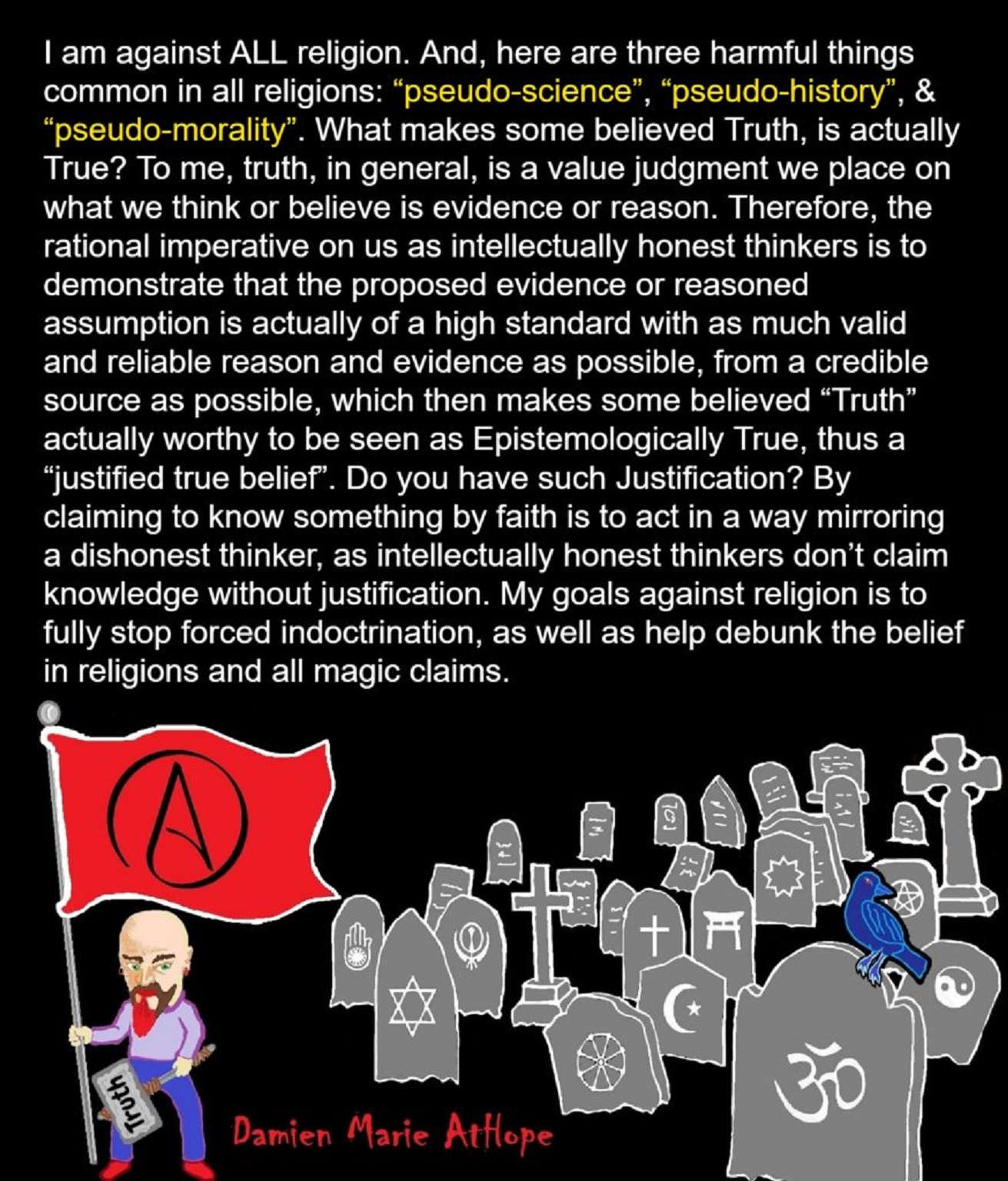

Damien Marie AtHope (Said as “At” “Hope”)/(Autodidact Polymath but not good at math):
Axiological Atheist, Anti-theist, Anti-religionist, Secular Humanist, Rationalist, Writer, Artist, Jeweler, Poet, “autodidact” Philosopher, schooled in Psychology, and “autodidact” Armchair Archaeology/Anthropology/Pre-Historian (Knowledgeable in the range of: 1 million to 5,000/4,000 years ago). I am an anarchist socialist politically. Reasons for or Types of Atheism
My Website, My Blog, & Short-writing or Quotes, My YouTube, Twitter: @AthopeMarie, and My Email: damien.marie.athope@gmail.com

